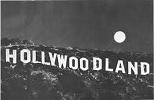






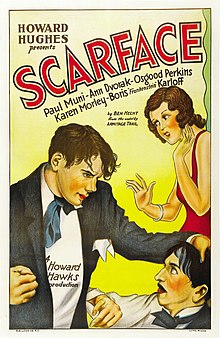


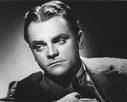
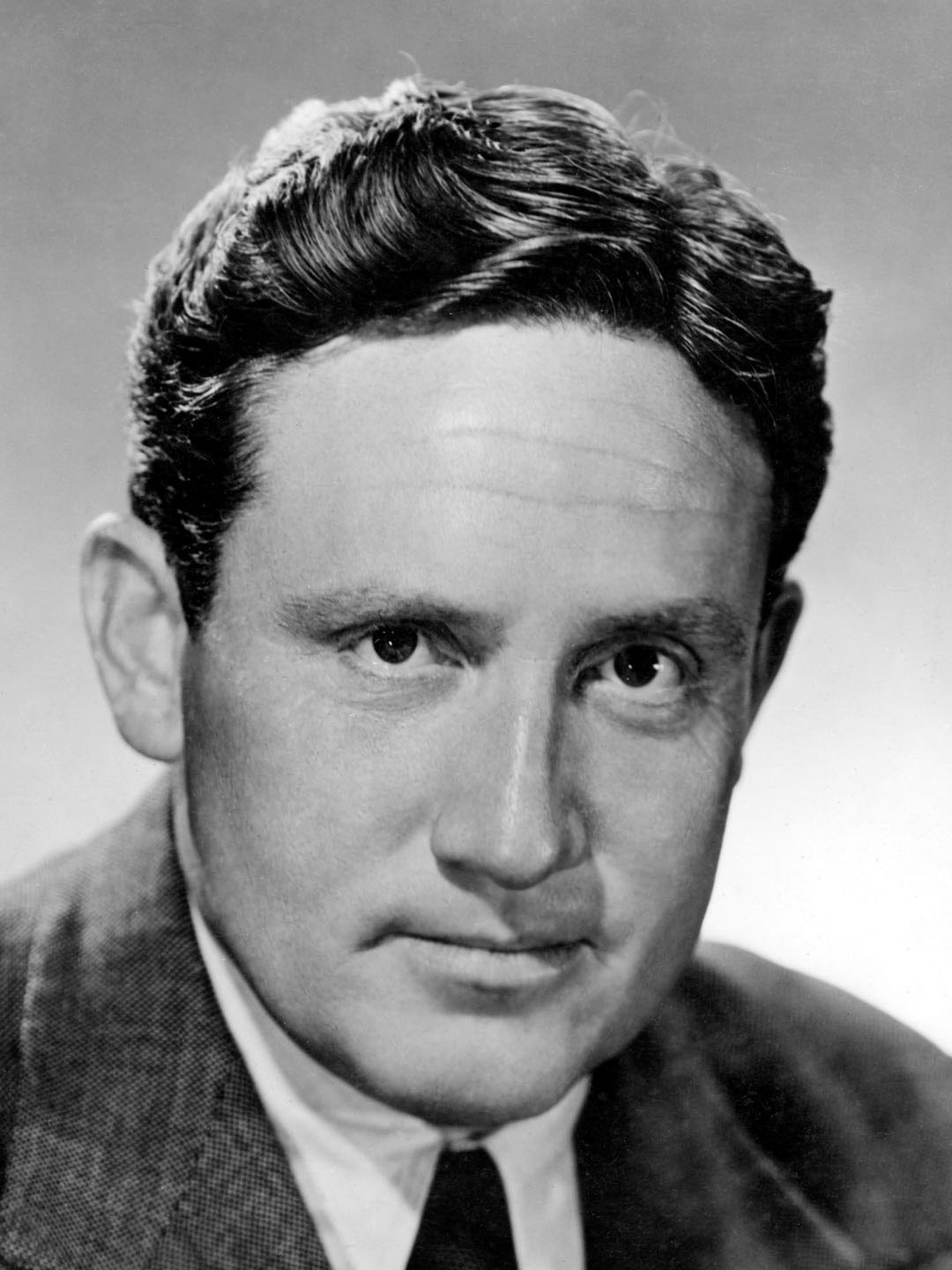



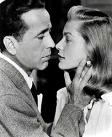

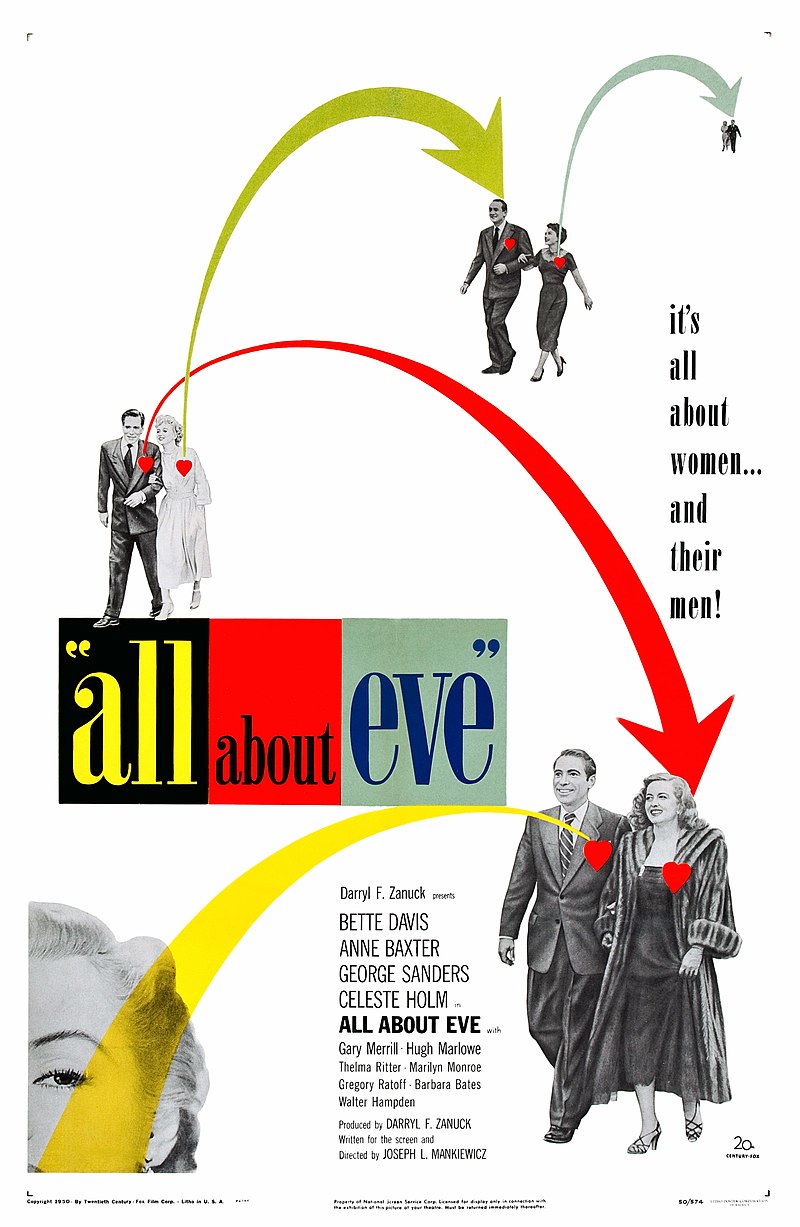


TLW's Hollywoodscope™ (Hollywood Historyscope) |
By T.L. Winslow (TLW), the Historyscoper™ |
© Copyright by T.L. Winslow. All Rights Reserved. |
Original Pub. Date: June 27, 2014. Last Update:June 3, 2025. |
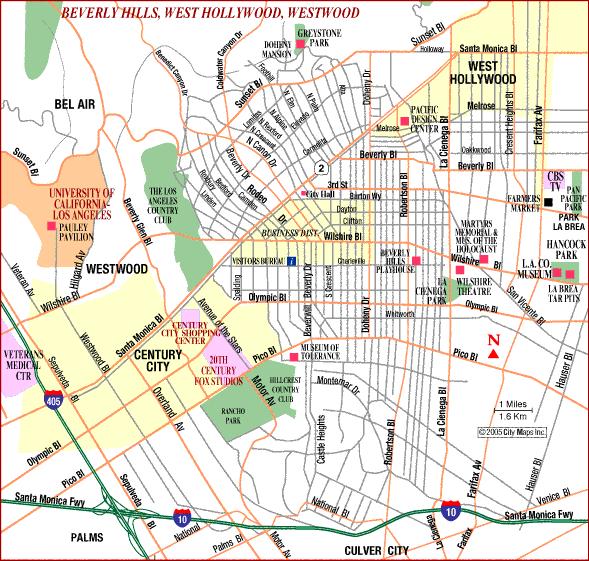


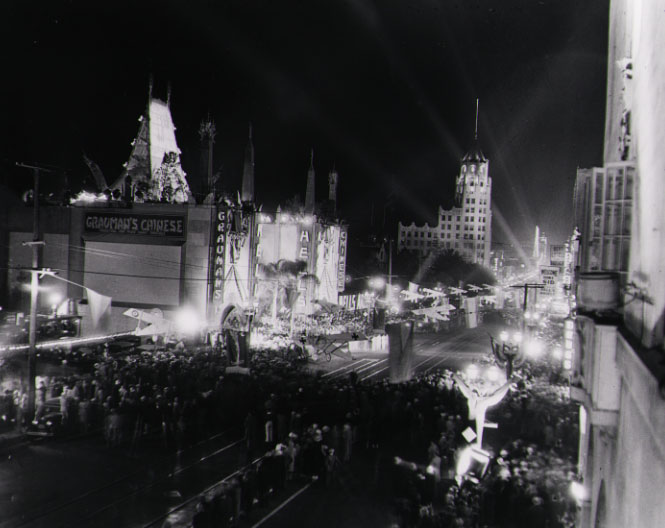
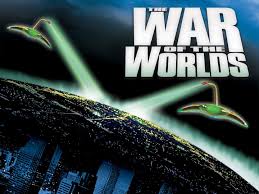

















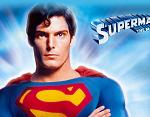

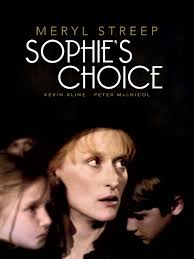

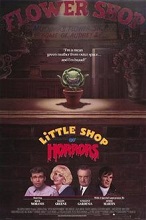







Westerners are not only known as history ignoramuses, but double dumbass history ignoramuses when it comes to Hollywood history. Since I'm the one-and-only Historyscoper (tm), let me quickly bring you up to speed before you dive into my Master Historyscope.
During the long, long Twentieth Century the fabled town of Hollywood, "the Entertainment Capital of the World" AKA Hollyweird, Tinseltown, the Boulevard of Broken Dreams, Illusion City, the Celluloid Babylon rose and fell like Ancient Rome, becoming the center of the U.S. film industry, leaving 10K+ (50K+?) films, many of which have been lost through decay, which is too bad in the Internet Age. A corporate city on America's West Coast devoted to pure amoral profit, entertainment, and art at the same time, it produced many masterpieces along with tons of rubbish, and created its own royalty complete with its own lore full of juicy gossip, influencing the entire world's culture in radiating waves. The modern-day Sodom and Gomorrah and Babylon, by the 1960s the rise of television reduced Hollyweird to a mere shadow of its former self, after which the Internet has taken over with its unlimited amounts of do-it-yourself porn, muting its shock value. But it was always a rabbit for society's norms, pushing the envelope of what's considered decent, and its history is intertwined with America's during the American Century. Today few vestiges of its past glory remain, mainly Paramount Studios and Capitol Records, along with the Hollywood Walk of Fame, but then, with history you can use your mind to see into the past and transcend distance, and since if you don't scope Hollywood you'll never understand 20th century history, let's get started. Good news, it's the easiest and funnest historyscope you'll ever sponge. We won't cover every film produced, just those important to the rise and fall of Hollywood and its galaxy of stars. Yes, it will take a long time and a lot of reading, study, and thinking, but it will make you into a 100-year-old Hollyweird soul, and won't take anywhere near 100 years :) Be sure and watch all the movies before you get to 100. :)

About 60 B.C.E. Roman Epicurean poet-philosopher Titus (Lat. "defender") Lucretius Carus (Lat. "beloved") (-99 to -55) pub. De Rerum Natura (On the Nature of Things), expounding his Epicurean doctrine of the Universe in poetic form, which is later suppressed by the Church; contains the first description of persistence of vision, which later makes motion pictures possible; in 1417 C.E. the long-lost full text is rediscovered in St. Gall Monastery by Italian humanist Giovanni Francesco Poggio Bracciolini (1380-1459).
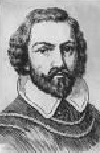
On Sept. 28, 1542 Portuguese navigator Juan Rodriguez Cabrillo (-1543), sent by New Spain viceroy Antonio de Mendoza in search of a northern strait discovers California, and arrives at modern-day San Diego; too bad, colonization is slow, and the first Spanish mission isn't founded until 1769 - why not call it Cabrillofornia?
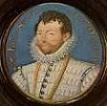
On June 17, 1579 after Sir Francis Drake and his crew get chased by Spaniards up the coast of Calif., seeking escape by the nonexistent Northwest Passage, they land at Drake's Bay 30 mi. NW of modern-day San Francisco (near tall white cliffs), where the friendly Indians think they are gods, and on June 26 offer them their entire country; he accepts, and leaves a brass plate announcing the new English domain of New Albion (N Calif.) "by the grace of God and in the name of her majesty Queen Elizabeth of England"; in 1932 chauffeur William Caldeira finds the plate under some dirt on the shore, but later tosses it on the N shore of the Golden Gate Bridge, where in 1936 San Fran. store clerk Beryle Shinn finds it again while hunting pheasant; it ends up in the U. of Calif.

On Sept. 4, 1781 Spanish gov. of Calif. (1777-82) Felipe de Neve (1724-84) along with the Franciscans found El Pueblo de la Reina de Los Angeles (Town of the Queen of the Angels) (modern pop. 3.9M) from an Indian village named Yangma; 29 of the first 44 Spanish settlers are of African ancestry.

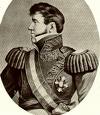

On Aug. 24, 1821 after being sent with an army last year by viceroy (1816-21) Juan Ruiz de Apodaca, 1st Count of Venadito (1754-1835), then deciding to switch sides, Spanish royalist army gen. Agustin (Agustín) de Iturbide (1783-1824) and Indian-Spanish-African mestizo rev. leader Vicente Ramon Guerrero Saldana (Saldaña) (1782-1831) sign the Treaty of Cordoba, recognizing Mexican independence under the Feb. 24 Plan de Iguala (Plan of the Three Guarantees) (Plan Trigarante), ending the Spanish colony of New Spain (founded 1521), with a new green-white-red flag symbolizing "religion, independence and union", meaning an established Roman Catholic Church (white), an independent monarchic govt. with liberal constitution (green), and unity of native Am. and Euro citizens (red for Castile, showing that the Spaniards will be considered more equal than the indigenous browns, which are a mixture of red and green?); too bad, they permit the royalist Spanish to turn their land holdings into hard currency before departing, depleting Mexico of currency, and causing silver church bells and gold altarpieces to be melted down to save the new nation from bankruptcy.

The West is the best? On Jan. 10, 1847 U.S. Brig. Gen. Stephen Watts Kearny (1794-1848), cmdr. of the Army of the West, and Robert F. Stockton enter Los Angeles after winning the Jan. 9 Battle of La Mesa in modern-day Veronon, Calif., and on Jan. 13 Lt. Col. John Fremont and Gen. Andres Pico meet at the Campo de Cahuenga and sign a peace treaty between the U.S. and Mexico; this site is just across Lankersheim Blvd. from the main entrance to Universal Studios in Hollywood, Calif. - how close is this to the Tech Noir Bar on Pico in The Terminator?
Make a run for the border? On Jan. 2, 1848 after the All Mexico idea of annexing Mexico by force is toyed with and dumped (making Pres. Polk reluctant to sign a treaty with Mexico yet), with S.C. Sen. John C. Calhoun uttering the soundbyte: "[W]e have never dreamt of incorporating into our Union any but the Caucasian race - the free white race. To incorporate Mexico would be the very first instance of the kind of incorporating an Indian race; for more than half of the Mexicans are Indians, and the other is composed chiefly of mixed tribes", and John O'Sullivan uttering the soundbyte: "There is no growth in Hispanic America... How would it kick the beam against the simple, solid weight of the two hundred and fifty, or three hundred millions - and American millions - destined to gather beneath the flutter of the stripes and stars, in the fast hastening year of the Lord 1945?", formal peace talks between the proud WASP U.S. and defeated BHRC (Brown Hispanic Roman Catholic) Mexico begin at the village of Guadalupe Hidalgo outside Mexico City, where what's left of the Mexican govt. is holed-up, trapped like brown rats by white wolves?; on Feb. 2 after Nicholas P. Trist engages them in brinksmanship, down-on-its-knees Mexico signs the grossly 1-sided dirty-deal Treaty of Guadalupe Hidalgo, ceding all of Texas above the Rio Grande, plus New Mexico and Calif. (incl. the Nevada region), a total of 529,189 sq. mi. (half of all Mexican territory, incl. the modern states of Calif., Nevada, Utah, and parts of modern Ariz., N.M., Colo., and Wyo.) (the old Aztec homeland of Aztlan?), giving the U.S. a new Am. Southwest and making it a continental power, with a 1,952-mi. 4-state (Texas, N.M., Ariz., Calif.) border with Mexico, while making "reconquista" a perennial Mexican cause, and becoming the first time that the lily-white U.S. actually doesn't want to absorb a people or steal all of their land, preferring to create a border with them racial underclassers safely on the other side, all nicely color-coded for inferiority or separated by language, religion and culture, or both; the rev.-free U.S. has completed its transformation from a cute little agrarian repub. into a continental giant; in return for the land grab the U.S. agrees to pay Mexico $15M ($300M in 2009 dollars, about enough to buy a major league sports team) and assume the claims of U.S. citizens against Mexico up to a $3.75M limit; the treaty is signed days before news of the Calif. gold strike is received; white supremacist gringo (Anglo) disdain for "inferior" Mexicans is firmly implanted, while the continental U.S. is pretty much rounded out (modulo the Gadsden Purchase in 1853); the messy town of Mesilla on the Camino Real N of El Paso is designated as the border of Mexico, causing native Mexicans on the E side of the Rio Grande River to settle there, but they have to move again in 1854 after the Gadsden Purchase gives it to the U.S.; the El Camino Real becomes an extension of the Santa Fe Trail from Mo., and the gringos begin calling it the Chihuahua Trail; Pres. Polk is actually miffed at the terms, since he is eyeing the growing movement that wants to annex all of Mexico, but his fear of Congress' shenanigans causes him to submit the treaty to them, and they ratify it on Mar. 10, ending the Mexican-Am. War (begun 1846); the last Americans leave Veracruz by the end of July, bringing back with them a new taste for cigars (and Mexican senoritas?), although chewing tobacco is still preferred in the South; the Mexican War costs the U.S. 1,721 KIA, 4,102 wounded, and 11,155 dead of disease (total 13,283), at a total cost of $98M; the first successful offensive U.S. war is also the first reported by modern war correspondents, and the first in which West Point graduates play a major role (Robert E. Lee, U.S. Grant, Thomas "Stonewall" Jackson, George B. McClellan, George Pickett, George Meade, Braxton Bragg, et al.); "There will be added to the United States an immense empire, the value of which twenty years hence it would be difficult to calculate" (Polk); "Alas, poor Mexico, so far from God and so close to the United States!" (Mexican pres. Porfirio Diaz).
In the 1850s the English word "Gamine" (from the French word gamine, meaning waif or urchin) is coined, growing by the early 20th cent. to mean a boyish, wide-eyed young woman who is also chic, e.g., Mary Pickford, Lillian Gish, Louise Brooks, Paulette Goddard, and Audrey Hepburn.
In 1853 a lone adobe hut stands in Nopalera, Calif. (Sp. "prickly pear cactus"), site of modern-day Hollywood.

In 1866 German immigrant Adolf Pfannenschmidt from Rinteln founds the town of Pfannenschmidtstadt on the site of Nopalera (founded 1853) in the Cahuenga Valley of the Santa Monica Mts. in warm sunny S Calif. (355 days of sunshine a year), which in 1886 is named Hollywood by Toronto, Canada-born "Father of Hollywood" Hobart Johnson "H.J." Whitley (1847-1931) on a honeymoon with his wife Gigi after he sees a Chinese man carrying wood in a wagon and uttering the soundbyte "I holly wood"; in 1903 it is incorporated as Hollywood, Calif. becoming known for orange groves, joining the city of Los Angeles in 1910 and becoming the HQ of the U.S. film industry.

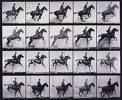
In 1872 the first time-sequence photography of a horse in motion is made by English-born Am. landscape photographer Eadweard James Muybridge (Edward James Muggeridge) (1830-1904) using his zoopraxiscope to win a $25K bet over whether all four hooves ever leave the ground at the same time (yes); he only comes up with a single still shot this year, but shoots a galloping sequence by 1878.

On Oct. 14, 1888 French inventor ("the Father of Cinematography") Louis Aime (Aimé) Augustin Le Prince (1841-90) shoots The Roundhay Garden Scene in the garden of his father-in-law Joseph Whitley in Roundhay Leeds, West Yorkshire, England on a 2.1-in.-wide paper roll from Eastman Kodak, running 10-12 frames per sec. shot through a single-lens combo camera-projector, becoming the oldest surviving motion picture film; on Sept. 16, 1890 before he can demonstrate it in the U.S., Le Prince disappears from a train in Dijon, and Thomas Edison claims credit for the invention; in 1898 his son Adolphe Le Prince testifies in court for his father in a suit brought by Edison against the Am. Mutoscope Co., but is barred from presenting his dad's two cameras as evidence, and Edison wins, but a year later the judgment is overturned.
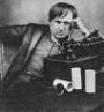




In Oct. 1888 Milan, Ohio-born (pr. MY-lin) Thomas Alva Edison (1847-1931) files a preliminary patent (caveat) for his Kinetoscope (Gr. "kineto" + "scope" = motion + watch) "optical phonograph" motion picture camera, which does "for the Eye what the phonograph does for the Ear", filing a 2nd caveat in Mar. 1889 which first names it; in 1889-90 the first crude Monkeyshines are shot at Edison Labs in N.J. by Scottish-born William Kennedy Laurie Dickson (1860-1935) and William Heise after Dickson decides on celluloid film and selects 35mm as the std. size; on May 20, 1891 the first working prototype is unveiled at the Nat. Federation of Women's Clubs, showing the 3-sec. Dickson Greeting from a small pine box filled with film on rollers and a 1-in. peep show viewer on top; on Feb. 21, 1893 after most of his application is denied based on prior art, Edison receives a patent governing the intermittent movement of film in the Kinetograph; on Mar. 14, 1893 Edison receives patent #493,426 for the exhibition device; on May 9, 1983 the final version is unveiled at the Brooklyn Inst. of Arts and Sciences, showing The Blacksmith Scene; too bad, Edison goes on to try to force every new movie studio to pay him royalties, holding the industry back for years; in 1895 Thomas Edison invents the Kinetophone, which links a Kinetoscope with a cylinder phonograph, making talking movies possible; meanwhile on May 2, 1887 Episcopal priest Hannibal Williston Goodwin (1822-1900) of Newark, N.J. patents celluloid film for use in Bible teaching, and it ends up being used in Edison's Kinetoscope and being stolen by George Eastman; when Goodwin dies in a street accident in 1900 his patent is sold to Ansco, which settles with Eastman Kodak for $5M for patent infringement.

On Feb. 1, 1893 Thomas Edison opens his barn-like Black Maria (pr. ma-RYE-uh) motion picture studio in West Orange, N.J., becoming the first movie studio in the U.S. and world; one of his first films is Two Men Boxing (1891),


In 1894 the Holland Brothers open the first Kinetoscope movie parlor in New York City, selling tickets at 25 cents to see 5 of 10 choices; meanwhile William Dickson of Edison Labs combines sound and film for the first time, producing First Experimental Sound Film (Two Men Dancing) in Sept. 1894 (first synchronized sound film) (first depiction of homosexuality in film?) (Dickson plays the violin, becoming the first film where the dir. appears on film., while Edison Studios produces films featuring famous German strongman Eugen Sandow (1867-1925), plus the Sioux Ghost Dance and Buffalo Dance.


In 1894 former Edison employee Edward Hill Amet (1860-1948) invents the portable Magniscope movie projector, teaming up with Waukegan, Ill. theater mgr. (former Chicago newspaper vendor) George Kirke Spoor (1872-1953) and selling it to several major movie theaters, cranking out a series of war films incl. bathtub naval battles; he ceases production of the Magniscope in 1900 after the release of the Selig Polyscope, selling out to Spoor, who founds the Nat. Film Renting Co., distributing projectors and films to theaters nationwide; employees incl. Donald Joseph Bell (1869-1934) and Albert Summers Howell (1879-1951), who on Feb. 17, 1907 found Bell & Howell Co. in Skokie, Ill., introducing an all-metal camera in 1912 that helps to make 35mm film the industry std., introducing a home movie camera in the 1920s, reaching 500 employees and $1M sales by 1925.


On Feb. 13, 1895 brothers Auguste Lumiere (Lumière) (1862-1954) and Louis Lumiere (Lumière) (1864-1948) of Lyon, France, who with their Haute-Saone, Ormoy-born photographer father Charles-Antoine Lumiere (Lumière) (1840-1911) (Fr. "lumiere" = light) set up a photographic equipment factory in Lyons, France in the 1880s patent the Cinematograph camera-projector combo, one of the first motion picture cameras, using a perforated film, and the first showing movies to an audience instead of an individual viewer like Edison's "peepshow" kinetoscope; their first film Leaving the Lumiere Factory in Lyon (Sortie de l'usine Lumiere de Lyon), the almost first true motion picture debuts at L'Eden Cinema in La Ciotat on Sept. 28, 1895, followed by Paris on Dec. 28, 1895; view it.
On Aug. 28, 1895 Thomas Edison films The Execution of Mary, Queen of Scots.




In Dec. 1895 ex-Edison employee William Kennedy Laurie Dickson (1860-1935) et al. found the Am. Mutoscope and Biograph Co. in N.J. to manufacture the hand-cranked 68mm Rolodex 850 flip-card Mutoscope, patented on Nov. 21, 1894 by Herman Casler (1867-1939), which is used for peep shows; in 1896 Casler invents the 68mm Biograph Projector, getting around Edison's patent by using friction rollers instead of sprockets; the first studio is at 841 Broadway at 13th St. in Manhattan, N.Y., mounted on tracks to catch sunlight; in 1906 they move to 11 East 14th St. near Union Square, becoming the first movie studio relying exclusively on artificial light; in 1899 a letter is printed in the London Times railing against the "vicious demoralising picture shows in the penny-in-the-slot machines. It is hardly possible to exaggerate the corruption of the young that comes from exhibiting under a strong light, nude female figures represented as living and moving, going into and out of baths, sitting as artists' models etc. Similar exhibitions took place at Rhyl in the men's lavatory, but, owing to public denunciation, they have been stopped."

On Apr. 23, 1896 the first commercial moving picture shows are viewed by the U.S. public at Koster and Bial's Music Hall on 34th St. in New York City; on June 26 Vitascope Hall on Canal St. in New Orleans, La. opens, becoming the first movie theater in the U.S.; New Orleans also had the first U.S. opera house in 1796, and also originates jazz; On June 29 the Keith-Albee vaudeville theater circuit stages the first U.S. exhibition of the Lumiere Cinematographe at the Union Square Theatre in New York City; on Oct. 19 the Edisonia Parlors and Vitascope Hall in the basement of the Ellicott Square Bldg. at 305 Main St. in Buffalo, N.Y. becomes the first in Buffalo; Connellsville, Penn.-born electrician Edwin Stanton (Stratton?) Porter (1870-1941) is hired by Raff & Gammon of New York City, agents for the films and projectors of Thomas Edison, then quits to tour with the Projectorscope from the Internat. Film Co. of Kuhn and Webster, visiting the West Indies, South Am., Canada, and back to the U.S., returning to New York in 1898 and working at the Eden Musee in Manhattan, showing Edison films of the Spanish-Am. War before joining Edison Manufacturing Co. in 1899, soon rising to head of the studio, becoming the #1 filmmaker in the U.S. in the 1900s decade.
On Sept. 28, 1896 Pathe Freres (Pathé Frères) film studio is founded in France by the Pathe Brothers Charles, Emile, Theophile, and Jacques, becoming the world's largest film equipment and production co. by the early 1900s; in 1908 they invent the newsreel.


In 1896 Alice Guy (Guy-Blache) (Guy-Blaché) (1873-1968) becomes the first film dir., working for the French production co. of Leon Gaumont (1864-1946) to film The Cabbage Fairy (La Fee aux Choux).

In 1896 William Nicholas Selig (1864-1948) founds Selig Polyscope Co. in Chicago, Ill., starting out making industrial films before moving to Edendale, Calif. in NW Hollywood in 1909.

In 1896 after their 3-man Internat. Novelty Co. fails, causing them to have to get jobs, and New York Evening World reporter Blackton interviews Thomas Edison about his new film projector and is talked into buying $800 worth of equipment from him, American Vitagraph Studios is founded in New York City by English immigrant Albert Edward Smith (1875-1958), newspaper cartoonist James Stuart Blackton (1875-1941), and Ronald A. Reader, joined in 1898 by older wiser English immigrant William T. "Pop" Rock (-1916) (ahead of his time?), showing their first films at Tony Pastor's New 14th St. Theatre on Mar. 23, starting out by filming fun things incl. Niagara Falls at Passaic Falls, N.J., going on to film their first "story picture" The Burglar on the Roof on May 16, 1897, in which Mrs. Olsen, wife of the bldg. janitor (at the corner of Nassau and Beekman Sts. in Lower Manhattan) thinks a fight between a policeman and a burglar is real and hits the burglar with her broom, cracking audiences up; they go on to film news events incl. the Spanish-Am. War, Teddy Roosevelt's charge up San Juan Hill in Cuba, the Boer War, the 1900 Galveston Flood, the 1901 assassination of Pres. McKinley, the 1904 inauguration of Pres. Theodore Roosevelt, the 1906 San Francisco Earthquake, and fake the Battle of Santiago Bay in a water tank with cigar smoke after bragging that they had it but didn't; too bad, they pass-up filming the Wright Brothers at Kitty Hawk on Dec. 14, 1903 after seeing the "fool contraption" and deciding it can't fly; in 1900 they pioneer animation; in 1905 they build the first modern film studio at the corner of E 14th St. and Locust Ave. (near Ave. M) in Flatbush, Brooklyn, N.Y., with profits of $7,975 in 1899 zooming to $120,749 in 1906, becoming the most prolific U.S. film producer by 1908, producing eight films a week from their stock co. of 400 actors incl. Broncho Billy Anderson, Annette Kellerman, Paul Panzer, Florence Lawrence ("the Biograph Girl"), Florence Turner ("the Vitagraph Girl"), Maurice Costello (first matinee idol), Gladys Hulette, and Julia Swayne Gordon; in 1911 they build a 2nd studio in Santa Monica, Calif., later moving to a 29-acre sheep ranch on Prospect St. in Hollywood; on Jan. 28, 1925 after the studio system squeezes them out, they leave the MPAA, and on Apr. 22, 1925 sell out to Warner Brothers for $735K.


On Mar. 17, 1897 (St. Patrick's Day) 30-y.-o. 183-lb. James John "Gentleman Jim" Corbett (1866-1933) loses the heavyweight boxing title by KO in the 14th round in Carson City, Nev. to 34-y.-o. 167-lb. ("Ruby Robert") ("the Freckled Wonder") ("the Cornishman") Robert James "Bob" Fitzsimmons (1863-1917) of Cornwall, England (a hard puncher), who becomes world heavyweight boxing champ #2 (until 1899), and the last British heavyweight boxing champ (until ?); William Aloysius Brady (1863-1950), mgr. of both Corbett and James J. Jeffries produces the 1.5 hour film The Corbett-Fizsimmons Fight (May 22), filmed in Veriscope (a large darkroom with the camerman inside) by Enoch Rector of Parkersburg, W. Va., becoming the longest film released to date, and the world's first feature-length film; Fizsimmons goes on to become the first prof. boxer to win the world middleweight, light heavyweight, and heavyweight boxing titles.
In Aug. 1897 the first motion picture commercial, an ad for Admiral brand cigarettes is made by Thomas Edison's co. from his Black Maria Studio in West Orange, N.J.

In 1897 Georges Melies' After the Ball (Star Film Co.) is released, starring Melies' future wife Jeanne d'Alcy undressing and bathing, with her maid (Jane Brady) helping, becoming the first adult (porno) film?
In 1897 Albert E. Smith's The Humpty Dumpty Circus is filmed, becoming the world's first animated film using the stop-motion technique; released on Nov. 2, 1908.


On Nov. 16, 1900 J. Stuart Blackton's The Enchanted Drawing debuts, becoming the first animated film recorded on std. picture film, causing James Stuart Blackton (1875-1941) to become known as "the Father of American Animation".

On Feb. 23, 1901 Edwin S. Porter's Terrible Teddy, the Grizzly King (Edison Studios) is released, a satire about U.S. vice-pres. Teddy Roosevelt.
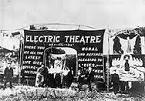
On Apr. 16, 1902 Tex.-born Thomas Lincoln Tally (1861-1945) opens the Electric Theatre in Los Angeles, Calif., the first movie theater in the town; in 1912 he becomes the first in LA to show a color movie.

On July 15, 1902 Edwin S. Porter's and George S. Fleming's Jack and the Beanstalk (Edison Studio) is released, starring Thomas White, featuring a fake waterfall and man-legged cow.


In 1902 the Hollywood Hotel on Highland Ave. and Prospect Ave. in Los Angeles, Calif. opens, owned by Toronto, Canada-born real estate developer Hobart Johnstone "H.J." Whitley (1847-1931) ("the Father of Hollywood"), who incorporates Hollywood next Nov. 14; on Jan. 30, 1904 Hollywood bans liquor except for valid medical purposes; in 1910 it votes for annexation to Los Angeles, renaming Prospect Ave. to Hollywood Blvd.














In 1902 Lubin Manufacturing Co. is founded in Philadelphia, Penn. by Polish Jewish immigrant optometrist Siegmund "Pop" Lubin (Lubszynski) (1851-1923), who started out in 1897 making films with his Cineograph combo camera/projector, using the open air roof of a bldg. in the business district as a studio; the trademark is the Liberty Bell; in 1910 Lubin builds a modern studio called Lubinville on the corner of Indiana Ave. and 20th St., expanding to Jacksonville, Fla., Los Angeles, Calif., and Coronado, Calif.; his stock co. incl. Harry C. "Henry" Myers (1882-1938), Florence Hackett (nee Hart) (1882-1954), Alan Hale Sr. (1892-1950), Oliver "Ollie" "Babe" (Norvell) Hardy (1892-1957) ($5/a day, 3 days a week guaranteed), Arthur Vaughan Johnson (1876-1916), Lottie Briscoe (1883-1950), Florence Lawrence (Florence Annie Bridgwood) (1883-1938), Ethel Clayton (1882-1966), Gladys Brockwell (Lindeman) (1893-1929), Edwin Carewe (Jay Fox) (1883-1940), Ormetta Grace "Ormi" Hawley (1889-1942), Rosemary Theresa Theby (Thebe) (Rose Masing) (1892-1973), and Pearl White (1889-1939); too bad, a fire at his studio in June 1914 destroys the negatives for new unreleased films, and after a losing copyright battle with the Edison Trust causes him to join it, entering a distribution agreement with Vitagraph, Selig, and Essanay Studios, only to see WWI destroy the foreign market, he declares bankruptcy on Sept. 1, 1916 after producing 1K films, and goes back to being an optometrist; meanwhile he stinks himself up by pirating films by Georges Melies et al.

In Jan. 1903 Edwin S. Porter's Life of an American Fireman (Edison Studios) is released, featuring a continuous narrative over seven scenes in nine shots with dissolves.
On Aug. 11, 1903 Subub Surprises the Burglar (Edison Studio) has its premiere, showing a dude in a fold-up Murphy bed being surprised by a burglar, then surprising him when it is revealed to be armored and locked and loaded.
In Aug. 1903 Wallace McCutcheon's The Dude and the Burglars (Am. Mutoscope and Biograph) debuts, about a bashman young man who foils two burglars and rescues his lady.

In Sept. 1903 Hollywood High School at 1521 N. Highland Ave. at the intersection with West Sunset Blvd., opens, going on to graduate movie stars incl. Meredith Baxter, Carol Burnett, Diana Canova, Keith Carradine, Robert Carradine, Marge Champion, Lon Chaney Jr., Warren Christopher, Johnny Crawford, Edward Dmytryk, Linda Evans, Nanette Fabray, Mike Farrell, Laurence Fishburne, Judy Garland, James Garner, Alan Hale Jr., Gloria Grahame, Barbara Hershey, John Huston, Swoosie Kurtz, Alan Ladd, Carole Lombard, Joel McCrea, Ann Miller, Yvette Mimieux, David Nelson, Ricky Nelson, Brandy Norwood, Sarah Jessica Parker, Stefanie Powers, John Ritter, Jason Robards, Ann Robinson, Mickey Rooney, Sharon Tate, Lana Turner, and Tuesday Weld; the mascot is the Sheiks, from the 1921 Rudolph Valentino film "The Sheik".
In Nov. 2, 1903 A.E. Weed's The Flatiron Building on a Windy Day has its premiere, becoming a big hit by Crescent Films; "It is at this [N] corner where one can get a good idea of the prevailing types in hosiery and lingerie."
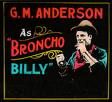

On Dec. 1, 1903 Edwin S. Porter's 13-min. $150 The Great Train Robbery (Edison Studios) (filmed in Dove, N.J.) is released, starring Pine Bluff, Ark.-born Gilbert M. "Broncho Billy" Anderson (Maxwell Henry Aronson) (1880-1971), becoming the first movie with a plot, and the longest film to date, changing the film industry with the introduction of multiple plot lines, editing and cross-cutting, the chase scene, and the Western, becoming the #1 attraction in the first nickelodeon in 1905.

In 1903 Austrian film dir. Joseph Delmont (Josef Pollak) (1873-1935) begins making short Western films for Vitagraph, returning to Vienna in 1910 and going on to pioneer the use of wild beasts in films.



Jewywood starts in Jew York long before moving to Hollyweird? In 1904 New York Jew Marcus Loew (1870-1927) founds the People's Vaudeville Co., a chain of theaters with live vaudeville shows, expanding into 1-reel nickelodeon films; in 1910 he founds Loew's Consolidated Enterprises along with well-fixed Hungarian-born Jewish former fur trader Adolph Zukor (1873-1976), and Russian-born Jewish brothers Joseph Michael Schenck (1878-1961) and Nicholas M. Schenck (1881-1969), then changes its name to Loew's Inc. in 1919 and purchases Metro Pictures Corp. in 1920; Nicholas Schenck goes on to head United Artists, while Joseph Schenck heads MGM.
On Mar. 9, 1905 ?'s Tom, Tom, the Piper's Son (Biograph) is released, starring Frank Marion and Wallace McCutcheon.

On Feb. 27, 1905 Edwin S. Porter's The Seven Ages (Edison Studios) is released, following a couple from childhood through old age, making use of side lighting, closeups, and changing shots within a scene.

In Feb. 1905 Edwin S. Porter's The Kleptomaniac (Edison Studios) is released, starring Aline Boyd as kleptomaniac Mrs. Banker, and Phineas Nairs and Jane Stewart as store detectives.
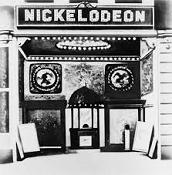

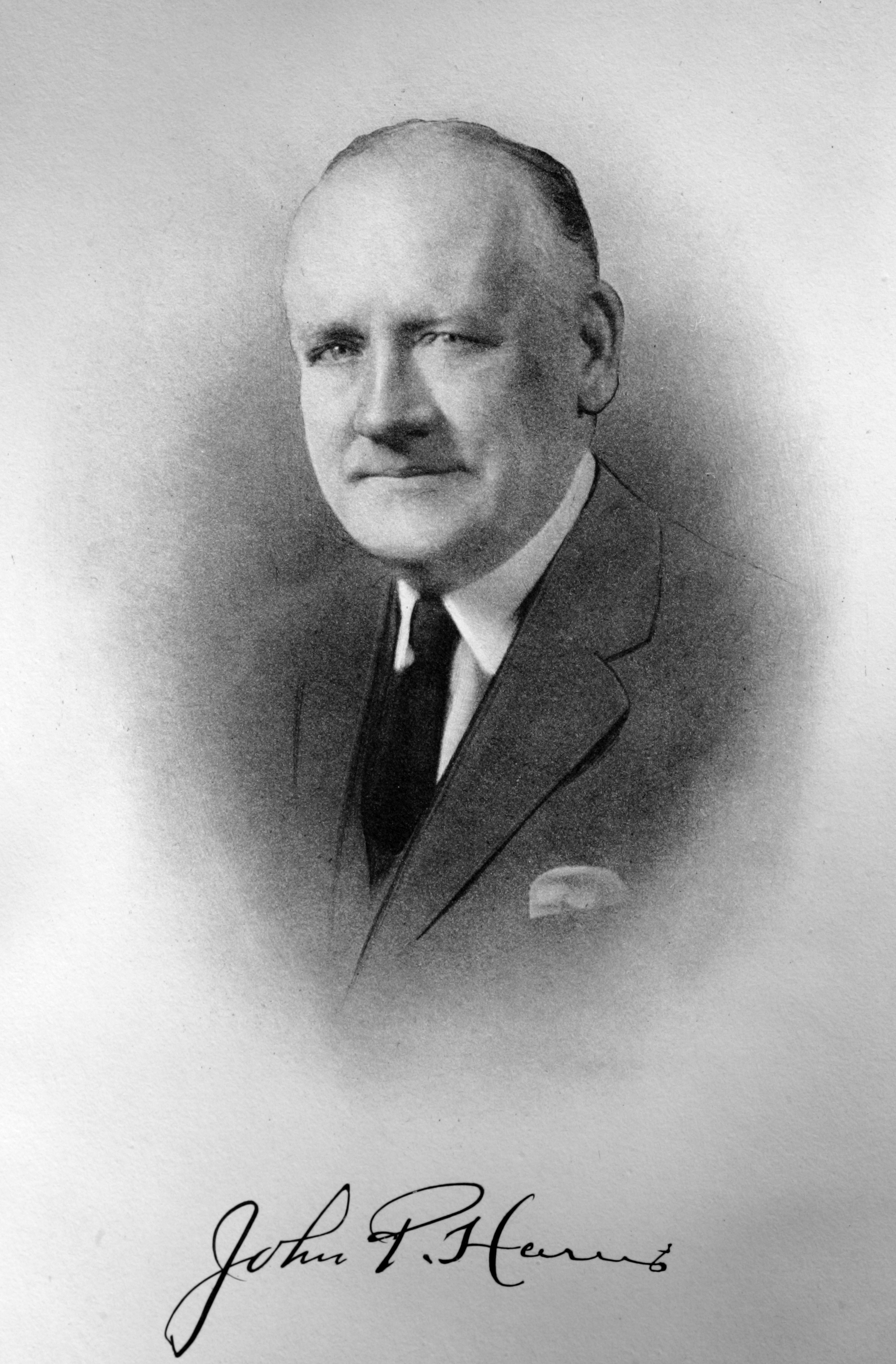
On June 19, 1905 the Nickelodeon (nickel + Odeon, the 18th cent. enclosed theater in Paris, also the Greek word for theater) is opened in a vacant storefront at 433-35 Smithfield St. in Pittsburgh, Penn. by John Paul Harris (1871-1926) (owner of the Harris Comedy and Specialty Co., who showed the first moving picture in Pittsburgh in 1897) and his brother-in-law Harry Harris, becoming the first theater in the world devoted exclusively to moving pictures, open 7 days a week from 8 a.m. to midnight, with customers sitting on folding chairs watching movies shown on a muslin curtain, becoming a big hit, with 450 visitors on day 1 and 1.5K on day 2 lining up to see a 15-min. picture show for 5 cents, launching a nickelodeon boom across the U.S.; by 1907 there are 2.5K nickelodean theaters in the U.S., and 8K in 1908, and by 1910 26M visit them each week, causing all kinds of sex problems with hanky-panky in the darkened theaters.


In Sept. 1905 Edwin S. Porter's and Wallace McCutcheon's The White Caps (Edison Studios) is released, about a KKK-like group, starring Kate Toncray and John R. Cumpson, becoming the film debut of Cincinnati, Ohio-born Arthur Vaughan Johnson (1876-1916), who in 1909 goes to work for Biograph Studios, where he becomes D.W. Griffith's favorite actor, performing with Mary Pickford and Florence Lawrence; in 1911 after being offered the chance to direct, he moves to Lubin Studios, working with Florence Hackett; too bad, bad health causes him to retire in 1915 after acting in 300+ films and directing 26, and on Jan. 17, 1916 he dies of TB.





On Oct. 7, 1905 J. Stuart Blackton's Adventures of Sherlock Holmes; or, Held for Ransom debuts, written by Theodore Liebler Jr. based on "The Sign of the Four" by Arthur Conan Doyle, the first serious Sherlock Holmes film, starring Maurice George Costello (1877-1950), who becomes the first matinee idol, becoming a member of the first-ever motion picture stock co., playing opposite "the Vitagraph Girl" Florence Turner (who has her pay raised to $22 a week, supplemented by seamstress work); Maurice discovers Moses Harry "Moe" Horwitz (b. 1897) of Three Stooges fame when he runs errands for the studio at no charge; his wife (1902-27) Mae Costello (1882-1929) also works for Vitagraph, going on to have daughters Helene Costello (1906-57) and Dolores Costello (1903-79) ("Goddess of the Silent Screen"), who in 1928-35 marries John Barrymore, having son John Drew (Blyth) Barrymore (1932-2004), father of Drew Barrymore (1975-).

On Dec. 16, 1905 weekly entertainment trade mag. Variety begins pub. in New York City by Cortland, N.Y.-born Jew Sime Silverman (1873-1933), going on to coin the term "pix" in 1932; in 1933 Daily Variety begins pub. to cover the motion picture industry in Los Angeles/Hollywood, after which Sime dies of a heart attack on Sept. 23 at the Ambassador Hotel.
In 1905 William N. Selig sends dir. Francis W. Boggs to Los Angeles to film new titles, and after scouting the area out they settle in Sycamore Grove in Highland Park, Calif. in NE Los Angeles, with actors Charlie Chaplin et al. hanging out at the Mount Washington Hotel; by 1910 they move to Edendale.
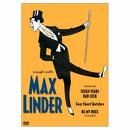
In 1905 French comedian Max Linder (Gabriel-Maximilien Leuvielle) (1883-1925) begins starring in films for Pathe in Louis Gasnier's The Legend of Punching, becoming the first internat. film star with his onscreen persona "Max" in 1909, with fans incl. Tsar Nicholas II and George Bernard Shaw, becoming a dir. of his own films, with a salary of 1M francs a year in 1912, causing Charles Pathe to call him "the Napoleon of the Cinema", giving Maurice Chevalier his start; after serving in WWI in 1914-15 entertaining troops, he is invited to Essanay Studios by George K. Spoor in 1916 at $5K/week to replace Charlie Chaplin (whom he moves in next door to, becoming friends, with Chaplin calling himself his disciple), making three films, all of which bomb, causing the remaining nine to be canceled, throwing him into depression; on Oct. 31, 1925 after bungling a suicide attempt at a hotel in Vienna in early 1924, he commits suicide along with his wife (since 1923) Helene "Jean" Peters (b. 1899) in their room on the 4th floor of the Hotel Baltimore in Paris after watching a theatrical production of "Quo Vadis?", which features a suicide scene by Nero and his servant Acte.

On Feb. 12, 1906 the 8-story luxury Alexandria Hotel at 501 S. Spring St. in Los Angeles, Calif. opens, designed by John B. Parkinson, who builds a 12-story addition in 1911, becoming the most luxurious hotel in Los Angeles until the Biltmore Hotel opens 3 blocks W in 1923, known for gold leaf ceilings and stained-glass Tiffany skylight; in Oct. 1911 Palm Court ("the crystal palm room") opens, becoming the mingling place of Hollywood celebs until the opening of the Biltmore Hotel in 1923, hosting receptions for Pres. Woodrow Wilson in Sept. 1919 and Gen. John J. Pershing in 1920; in Dec. 1919 bandleader ("the Jazz King") Paul Whiteman gets his start there; so many business deals are made in the lobby that the Persian rug there is called the "million-dollar carpet".

In Feb. 1906 Edwin S. Porter's and Wallace McCutcheon's Dream of a Rarebit Fiend (Edison Studios) debuts, based on the comic strip by Winsor McCay about a dude who gorges on a rarebit and begins hallucinating.

On Mar. 24, 1906 Louis Halberstadt's and Viggo Larsen's Professorens Morgenavis (Nordisk Films) debuts, becoming the film debut of Copenhagen, Denmark-born Jean Pierre Hersholt (1886-1956), who emigrates to the U.S. in 1913.
In July 1906 the Western Film Exchange is founded in Milwaukee, Wisc. by John R. Freuler (1872-1958), Harry E. Aitken (1877-1956), and Roy Aitken (1882-1976) to produce and distribute Western films to movie theaters in the midwest U.S.; in fall 1910 after the Motion Picture Patents Co. fails to shut them down, Freuler and Samuel S. Hutchinson found the Am. Film Manufacturing Co. in Chicago, Ill., with the Flying "A" Studios in La Mesa, San Diego County, Calif., run by Allan Dwan, producing 150+ films; in Mar. 1912 Mutual acquires Thanhouser Studios; in July 1912 they found Mutual Film Corp. to combine all their business, which acquires distribution rights for Keystone Studios and Majestic Studios; in Aug. 1912 they establish a branch in Santa Barbara, Calif., becoming one of the largest motion picture studios in the U.S. until it shuts down in 1922 after producing 1.2K films.

On Nov. 10, 1906 J. Stuart Blackton's The Automobile Thieves (Vitagraph) debuts, becoming the film debut of Florence Lawrence (Florence Annie Bridgwood) (1883-1938), who is uncredited by Vitagraph policy to avoid actors attaining celeb status and commanding huge salaries like on the stage; on Dec. 27 she moves to the Edison Manufacturing Co. to play Daniel Boone's daughter in Daniel Boone; or, Pioneer Days in America, at a pay rate of $5/day for 14 days in freezing weather in Bronx Park, where she has to ride a horse; in 1907 she returns to Vitagraph Co. in Brooklyn, then returns to the stage for a 1-year road show, then back to Vitagraph after vowing to "never again lead that gypsy life", only to be wooed to Biograph Studios by D.W. Griffith for a $5/week pay raise on her $20/week salary, where they continue to refuse to credit her, causing her to become known as "the Biograph Girl" by fans; after they find out that they made an offer to Essanay Studios, she and her hubby Harry Solter are fired, and in 1909 they sign up with Carl Laemmle's Independent Moving Pictures Co. of Am. (IMP), which not only gives her a marquee but stages a publicity stunt for her, a street car accident in New York City, after which she makes a publicity appearance in St. Louis, Mo. in Mar. 1910 at which eager fans tear her clothes off; in Mar. 1910 Florence Lawrence and Florence Turner become the first screen actors to have their names publicized by their studio; Lawrence becomes known as "the First Movie Star", "the Girl of a Thousand Faces", "the Biograph Girl", and "the Imp Girl"; after making 50 films in 11 mo. and demanding too high a salary, they go on vacation in Europe, then in 1910 join Lubin Manufacturing Co., advising young Canadian actress Mary Pickford to take her place at IMP, and making 48 films with Arthur V. Johnson; in 1912 they found the Victor Film Co. in Ft. Lee, N.J. with Carl Laemmle, where Lawrence makes $500/week as leading lady, and Solter $200/week as dir. before selling out to Universal Pictures in 1913; too bad, in 1915 she gets into a bad accident during filming of Pawns of Destiny, causing her career to begin tailspinning, reducing her to uncredited bit parts by 1925.

On Dec. 26, 1906 Charles Tait's 60 min. (4K ft.) The Story of the Kelly Gang (J&N Nevin Tait), based on the play "The Kelly Gang" by Arnold Denham debuts at Athenaeum Hall on Collins St. in Melbourne, Australia, followed by the U.K. in Jan. 1908, starring Elizabeth Tait and John Tait, becoming the first full-length feature film.

On June 8, 1907 How to Cure a Cold (Vitagraph) debuts, becoming the film debut of New York City-born 4'10" stage actress Florence Turner (1885-1946) (uncredited), who goes on to become known as "the Vitagraph Girl" in an age of uncredited actors; on June 18, 1910 the New York Dramatic Mirror pub. A Motion Picture Star about her, popularizing the phrase.

In 1907 film titles replace the commentator in movie houses. In 1907 brothers David Horsley (1873-1933) and William Horsley (1870-1956), along with ex-Biograph Studios employee Charles Gorman found Centaur Film Co. in a converted store in Bayonne, N.J., producing three movies a week by 1910.




In 1907 Gilbert M. "Broncho Billy" Anderson (Maxwell Henry Aronson) (1880-1971) and George Kirke Spoor (1872-1953) found Essanay (S&A) Studios (originally Peerless Film Manufacturing Co.) in Chicago, Ill., releasing its first film An Awful Skate, or The Hobo on Rollers on July 31, making a star of the studio janitor Bernard "Ben" Turpin (1869-1940), who allegedly insures his trademark crossed eyes for $25K/$100K; in 1908 it moves to a 72K sq. ft. bldg. at 1333-45 W. Argyle St. in Uptown Chicago; Allan Dwan is hired as a screenwriter, going on to become a famous Hollywood dir.; Louella Parsons is hired as ditto; the studio discovers stars incl. Wallace Beery, Francis Xavier Bushman, and Gloria Swanson; the trademark is an Indian head; in 1915 it begins releasing comedies pairing Ben Turpin with English actor Charlie Chaplin, who soon hikes to Calif.; it goes defunct in 1917.

In 1907 the Kalem Co. (after the initials KLM) is founded in New York City by Chicago film distributor George Kleine, Samuel Long, and Frank J. Marion (sales mgr. at Biograph Studios), joining the Edison Trust and filming outdoors because of the lack of a studio, run by dir. Sidney Olcott (1873-1949), who is lured away from Biograph with the offer of $10 per picture, with a min. of one picture per week; in Feb. his first film The Sleigh Belle debuts, becoming a hit; on Dec. 7 Ben Hur debuts, becoming a hit, causing Olcott to be promoted to pres. and awarded one share of stock; in 1910 under Olcott Kalem Studios becomes the first to travel outside the U.S. to film on location, going to Ireland and making 12+ films, followed by Palestine in 1912, where he makes From the Manger to the Cross; or, Jesus of Nazareth (debuts Oct. 3 in London), starring Robert Henderson-Bland as Jesus, Percy Dyer as Boy Jesus, Alice Hollister as Mary Magdalene, and Gene Gauntier as the Virgin Mary, becoming the first 5-reel film, doing $1M box office on a $35K budget, making him the film industry's #1 dir.; in 1910 a studio for Western films is founded in Verdugo Canyon in Glendale, Calif., and another one on the grounds of the Roseland Hotel near Jacksonville, Fla.; in 1911 another studio is founded in Santa Monica, Calif., closing in Oct. 1913 when they take over the Essanay Studios property at 1425 Fleming St. in Hollywood, Calif.; too bad, despite making them big bucks, the chintzy studio owners won't raise his $150/week salary, and after cashing in his share for $350 he resigns, joining Famous Players-Lasky in 1915, followed by Paramount, after which Kalem Studios tanks and sells out to Vitagraph Studios in 1916 after making 1.5K movies; in 1911 after the estate of "Ben-Hur" author Lew Wallace sues for copyright infringement, they settle out of court for $25K, waking up film studios to the need to obtain rights to stories before filming.

On Jan. 16, 1908 J. Searle Dawley's Rescued from an Eagle's Nest (Edison) debuts, featuring an eagle carrying away a baby, becoming the film debut of Shelby County, Ala.-born stage actor Henry Brazeale Walthall (1878-1936); D.W. Griffith plays Father, and becomes a virtual father to Walthall, giving him an unheard-of salary of $175/week at Biograph; because of his distinguished voice, the talkie era boosts his fading career before dying of influenza on June 7, 1936.

On Feb. 15, 1908 Francis W. Boggs' The Count of Monte Cristo (Selig Polyscope Co.) debuts, based on the 1844 Alexandre Dumas pere novel, becoming the first motion picture to be made in the greater Los Angeles area (Laguna and Venice) (West Coast), becoming the film debut of Marietta, Ohio-born stage actor Hobart Van Zandt Bosworth (1867-1943) (direct descendant of Miles Standish, John Alden, and Priscilla Alden, and the Van Zandt family, first Dutch settlers to land in the New World) as Edmond Dantes; after a long career on the stage he contracted TB, which robbed him of his voice, making silent films an ideal career choice, as long as they film outdoors, and convinced Selig to move to Los Angeles; Bosworth goes on to become known as "the Dean of Hollywood", writing 112 scenarios and acting in 84 films before starting Hobart Bosworth Productions Co. in 1913, then surviving the talkie era working for B-movie studios.

On Mar. 7, 1908 Otis Turner's Dr. Jekyll and Mr. Hyde (Selig Polyscope Co.) debuts, written by George F. Fish based on the 1886 Robert Louis Stevenson novel (first film adapation), starring Hobart Bosworth as Dr. Jekyll/Mr. Hyde, becoming the film debut of Lebanon, Penn.-born former newspaper secy. Betty Harte (Daisy Mae Light) (1882-1965), who goes on to appear in 108 films by 1916; Richard Mansfield, who created the Jekyll/Hyde role in the theater in 1887 dies on Aug. 30, 1907, 7 mo. before the film's release.

On June 6, 1908 J. Stuart Blackton's Romeo and Juliet (Vitagraph) becomes the film debut of Broadway stage actress Gladys Hulette (1896-1991), who endures the stigma better because she's uncredited, with the soundbyte: "The picture heroes were mostly Coney Island life savers."

On July 11, 1908 Francis W. Boggs' The Spirit of '76 (Selig Polyscope Co.) debuts, starring Betty Harte as a Yankee girl who hides her soldier beau Hobart Bosworth from British Redcoats occupying her plantation; the film debut of Crystal City, Mo.-born Paul William "Tom" Santschi (1880-1931), who goes on to appear in 245 films by 1931, and direct 28 films in 1914-16.
On Nov. 3, 1908 J. Stuart Blackton's and Charles Kent's Antony and Cleopatra debuts, the first known film version, starring Florence Lawrence and Betty Kent as Cleopatra, William V. Ranous and William Phillips as Octavian, and Charles Chapman as Mark Antony.


On Nov. 13, 1908 D.W. Griffith's The Guerrilla (Am. Mutoscope and Biograph) debuts, starring Arthur V. Johnson and Dorothy West, becoming the film debut of Harry C. "Harry" Myers (1882-1938), who marries actress Rosemary Theresa Theby (Thebe) (Rose Masing) (1892-1973), becoming a comedy team.
On Dec. 18, 1908 D.W. Griffith's An Awful Moment debuts, starring George Gebhardt, Marion Leonard, Harry Solter, and Florence Lawrence.
In Dec. 1908 the Motion Picture Patents Co. (Edison Trust) is founded to force patent royalties out of the "Big Ten Studios" incl. Vitagraph, Melies, Pathe, and Selig, causing movie studios to move W to Calif. to make it harder to enforce them, relying on the lax enforcement of the 9th Circuit Court of Appeals in San Francisco; in Sept. 1910 the Gen. Film Co. is formed by Edison to monopolize U.S. film distribution, becoming known as the Edison Trust; in Sept. 1913 the patents run out, and on Oct. 1, 1915 a U.S. federal court rules in U.S. v. Motion Picture Patents Co. that they went "far beyond what is necessary to protect the use of patents or the monopoly which went with them", constituting an illegal restraint of trade under the 1890 U.S. Sherman Antitrust Act, and after the appeal is dismissed the co. folds in 1918; before the fall of the Edison Trust, films are distributed by two methods, the States Rights Method, where a copy of a film is sold to a salesman at 10 cents a foot, who then makes as much money as he can until it falls apart, and the Road Show Method, where it's featured in a theater with advertising and reserved seating, and the producer collects the gate.

In 1909 after working with William Selig in Chicago, Ill., Calif.-born Francis W. Boggs (1870-1911) returns to Calif. and opens a studio in Edendale in a bungalow in NW Los Angeles as a satellite for Selig, filming In the Sultan's Power, becoming the first motion picture made completely in Los Angeles; the great Calif. weather allows for more outdoor shooting days, eventually causing the U.S. movie industry to be concentrated there.

On Mar. 23, 1909 George D. Baker's Cohen's Dream of Coney Island (Vitagraph) debuts, becoming the film debut of pudgy comic actor John Bunny (1863-1915), who teams up with skinny English-born Flora Finch (1867-1940) for 160 "Bunnygraphs" (Bunnyfinchgraphs) until his untimely death on Apr. 26, 1915.

On May 12, 1909 Broncho Billy Anderson's Mr. Flip (Essanay) debuts, featuring the first instance of a comedian (Ben Turpin) being hit in the face with a pie.



On May 21, 1909 Fred J. Balshofer's Disinherited Son's Loyalty (Bison Motion Pictures) debuts, written by Adam Kessel, starring Adam Kessel and Charles Bauman, becoming the first film released by Bison Motion Pictures Co. (Bison-101 Ranch Co.), whose studio is run by dir. Thomas H. Ince, which folds in 1917 after 620 films; they are a part of New York Motion Picture Co., founded this year by Jewish financier Charles O. Baumann (1874-1931) and actor-writer Adam Kessel (Jr.) (1866-1946), which distributes Bison films under the brand name 101-Bison along with Domino (comedies) and Broncho (westerns) (until June 1912); starting in 1911 Kay-Bee (Kessel-Baumann) films are filmed at the Miller Brothers 101 Ranch Wild West Show and released under the name World Famous Features; they have a troupe of 300 cowboys and cowgirls, 200 Indians, 600 horses and other livestock incl. steers and bison.

On June 17, 1909 Francis W. Boggs' In the Sultan's Power (Selig Studio) debuts, starring Hobart Bosworth, Betty Harte, Frank Montgomery, and Tom Santschi, becoming the first motion picture made completely in Los Angeles; the film debut of Sherman, Tex.-born Stella Adams (1883-1961), who survives the talkie era poorly, appearing in films until 1936.

On July 1, 1909 Francis W. Boggs' in Ben's Kid debuts, starring Tom Santschi and Harry Todd, becoming the film debut of 260+-lb. Roscoe "Fatty" Arbuckle (1887-1933).
On Aug. 13, 1909 Fred J. Balshofer's The Yiddisher Cowboy (Bison Motion Pictures) debuts; refilmed in 1911.

On Sept. 8, 1909 Thomas Ricketts' Justified (Essanay) debuts, starring J.H. Gilmour, becoming the film debut of Champaign, Ill.-born stage actress Ethel Clayton (1882-1966), who goes on appear in 180 films before the talkies shut her career down.



On Oct. 21, 1909 Francis W. Boggs' and Otis Turner's The Cowboy Millionaire (IMP) debuts, starring Mac Barnes, becoming the film debut of Mix Run, Penn.-born Thomas Edwin (Hezikiah) "Tom" Mix (1880-1940), who makes 336 films between 1910-36, shooting about 40 films in Canon (Cañon) City, Colo. with the Selig Polyscope Co. in 1911-12; in 1917 his sorrel Tony the Wonder Horse (1899-1942), debuts in "The Heart of Texas Ryan"; also the film debut of Springfield, Mo.-born William Davis Garwood Jr. (1884-1950), who goes on to star in 150 films; also the film debut of Boston, Mass.-born William Stowell (1885-1919).

On Nov. 12, 1909 ?'s A Man with Three Wives (Edison) debuts, becoming the film debut of New York City-born Sarah Blanche Sweet (1896-1986), who later becomes the main rival of Mary Pickford.
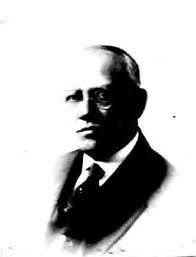

In 1909 Independent Moving Pictures Co. (IMP) is founded at 11th Ave. and 53rd St. in New York City by German-born Jew Carl Laemmle (Karl Lämmle) (1867-1939), releasing their first film Hiawatha on Oct. 25, based on the 1855 Henry Wadsworth Longfellow poem, dir. by William V. Ranous, starring uncredited Gladys Hulette; St. Louis, Mo.-born William King Baggot (1879-1948) debuts as a silent film actor at IMP Studios, going on to write scripts and direct and become a major star, becoming one of the first two film stars along with Canadian-born Florence Lawrence to be given a billing, marquis, and advertising promotion, becoming known as "the Most Photographed Man in the World", and "the Man Whose Face is As Familiar as the Man in the Moon", appearing in 269+ films by 1947, writing 18 screenplays, and directing 45 films in 1912-28.

In 1909 the first newsreels are shown in a Paris theater by French photographer Charles Pathe (Pathé) (1863-1957); they are introduced into U.S. theaters in 1910.
In 1909 after getting fed-up with the assembly-line process for cranking out films for nickelodeons, Edwin S. Porter leaves Edison Studios to found a co. to manufacture Simplex movie projectors; in 1910 he founds Defender Film Co., which lasts only one year and 26 films.

In 1909 Toronto, Ont., Canada-born stage actress Mary Pickford (Gladys Mary Smith) (1892-1979) finds herself out of work on Broadway and signs up with D.W. Griffith's Biograph Co., impressing him so much that she soon increases her pay from $5 to $8 a week, and appears in 51 films this year, then moves to Calif. next year, where she still isn't listed in the credits but featured on sandwich boards outside the nickelodeons as "the Girl with the Golden Curls", "Blondilocks", and "the Biograph Girl", becoming the first Hollywood movie star, and the first to make $1M/year.



In 1909 English Jew Joseph Duveen (1869-1939) goes into the art-dealing biz with Edwin Thanhouser (1865-1956), going on to get rich by buying art from Euro artistocrats and selling it to U.S. robber baron millionaires, incl. J.P. Morgan, Henry Clay Frick, Andrew Mellon, John D. Rockefeller, Henry E. Huntington, and William Randolph Hearst, later building the Duveen Gallery of the British Museum to house the Elgin Marbles (which he damages via restoration work), and getting a knighthood and baronage from the happy English royal family for helping the balance of trade long before the Beatles; meanwhile this year Thanhouser and his wife Gertrude Homan Thanhouser (1882-1951) found the Thanhouser Co. motion picture studio in New Rochelle, N.Y., going on to make a star of Florence M.L. La Badie (1888-1917), who is invited to Biograph by Mary Pickford this year, and jumps ship in 1911; too bad, CEO (1912-4) Charles Jackson Hite (1876-1914) dies in an auto accident, causing the co. to go into a tailspin, and La Badie dies in another auto accident on Oct. 13, 1917 weeks after she quits, after which the co. goes out of biz. in 1918.

In 1910 sleepy Hollywood is annexed by Los Angeles to secure the reliable water supply, allowing movie theaters, which had been banned to open; there are at least 10 movie cos. operating in LA; by 1921 80%+ of the world's film industry is concentrated in LA.

On Jan. 7, 1910 Sidney Olcott's The Deacon's Daughter (Kalem Studios) debuts, becoming the film debut of "the Madonna of the Screen" Alice Joyce (1890-1955).

On Feb. 5, 1910 Eugene Mullin's and Charles Kent's Twelfth Night (Vitagraph) is released, based on the Shakespeare play, starring Julia Swayne Gordon as Olivia, Charles Kent as Malvolio, Edith Storey as Sebastian, Tefft Johnson as Orsino, and Florence Turner as Viola, becoming the film debut of San Rafael, Calif.-born Marin Sais (1890-1971) as Maria.

On Mar. 10, 1910 D.W. Griffith's In Old California (Biograph) debuts, about the Mexican era of Calif., becoming the first movie filmed in Hollywood, Calif.; too bad, it is lost, causing Cecil B. DeMille's "The Squaw Man" (1914) to get credit, but on May 6, 2004 after it is rediscovered a monument is erected to it at 1713 Vine St. at Hollywood Blvd.


On Mar. 18, 1910 J. Searle Dawley's Frankenstein by Edison Studios debuts, becoming the first film version of the 1818 Mary Shelley novel, starring Augustus Phillips as Dr. Frankenstein, Mary Claire Fuller (1888-1973) as his fiancee, and Charles Ogle as the monster; Fuller goes on to become a top film star, but in 1916 starts to tank, and by 1917 is kaput, ending up having two nervous breakdowns and living in a hospital for the last 25 years of her life.









On July 2, 1910 the Vitagraph Studios Bldg. in Flatbush, Brooklyn, N.Y. burns down, along with most of its film negatives, causing them to rebuild, and found a 2nd studio in Calif.; meanwhile new stars Norma Talmadage (1893-1957) and Anita Stewart (1895-1961) join the studio straight from Erasmus H.S. in Flatbush, followed by Wallace "Wally" Reid (1891-1923) in 1911, Fred Thomson (1890-1928) and Clara Kimball Young (1890-1960) in 1912, Jane Novak (1896-1990) in 1913, Antonio Moreno (1887-1967) in 1914, and Alice Joyce (1890-1955) in 1916; Jean the Vitagraph Dog also becomes a star.

On July 22, 1910 George D. Baker's Davy Jones and Captain Bragg (Vitagraph) debuts, starring William Shea, John Bunny, and Flora Finch, becoming the film debut of Brooklyn, N.Y.-born fat comedic actor Hughie Mack (1884-1927), who appears in 195 films by 1928.
On Aug. 25, 1910 D.W. Griffith's Wilful Peggy (Biograph) is released, written by Frank E. Woods, starring Mary Pickford as Peggy, Clara T. Bracy as her mother, and Henry B. Walthall as the Lord, who vies with his nephew for her.

In Oct. 1910 after moving from France to the U.S., Alice Guy and her hubby (since 1907) Herbert Blache (Blaché) (1882-1953) found the Solax Co. which begins producing films in Flushing, N.Y., moving in 1912 to Fort Lee, N.J., cranking out films starring Lionel Barrymore, Ethel Barrymore, Claire Whitney, Olga Petrova, and Billy Quirk.

On Nov. 1, 1910 Harry MacRae Webster's A Fortunate Misfortune (Essanay Studios) debuts, becoming the dir. debut of Harry McRae Webster, husband (1905-) of St. Louis, Mo.-born stage actress Lottie Briscoe (1883-1950), who joined Essanay Studios with him in 1909, and stars in 94+ films with Arthur V. Johnson; too bad, he is sued in the early 1920s for unauthorized use of nude models; Briscoe's career also ends in the early 1920s when she becomes homebound.

In 1910 Francis W. Boggs' Pride of the Range debuts, starring Tom Mix, becoming the film debut of Western actor Edmund Richard "Hoot" Gibson (1892-1962).

In 1910 James Young Deer's Ridin' Romance (Pathe) debuts, becoming the film debut of Kingfisher Creek, Okla.-born rodeo star John Hartford "Jack" Hoxie (1885-1965) under the stage name Hart Hoxie, which he discards in 1919 after 35 films, marrying his co-star Marin Sais in 1920-7, causing her to become known as "the Queen of the B-Movie Oaters"; in 1920 he helps his Nez Perce, Idaho-born half-brother Al Hoxie (Alton J. Stone) (1901-82) get into the movies as his double.

In 1910 young Londoner William Pratt, who bucked his parents who want him to become a diplomat and went to Canada, ending up a farmhand responds to an ad placed by a theatrical agent named Kelly in Billboard, goes to Hollywood, and adopts the screen name Boris Karloff (1887-1969).
On Feb. 2, 1911 D.W. Griffith's Three Sisters (Biograph) debuts, starring Mary Pickford, Marion Sunshine, and Vivian Prescott as Mary, Florence, and Adele; Kate Bruce plays their mother.

On Feb. 21, 1911 William J. Humphrey's A Tale of Two Cities (Gen. Film Co.) debuts, based on the 1859 Charles Dickens novel, starring Maurice Costello, Florence Turner, John Bunny, Norma Talmadge, William J. Humphrey, and Mabel Normand, becoming the film debut of Australian-born (at sea) vaudeville star Lydia Yeamans Titus (1857-1929), who was once presented with a gold bar pin by Edward VII with the opening notes of her signature song Sally in Our Alley etched in diamonds; she goes on to appear in 130+ films by 1930.

On Mar. 10, 1911 Francesco Bertolini's, Adolfo Padovan's, and Giuseppe De Liguoro's 2 hr 45 min. L'Inferno (Helios) debuts at Teatro Mercadante in Naples, Italy, based on the engravings for Dante's "Divine Comedy" by Gustave Dore, becoming the first full-length Italian feature film, becoming an internat. hit, making $2M in the U.S. (first feature film screened in the U.S.) on a 100K lira budget, the length allowing theater operators to charge extra.

On Mar. 16, 1911 Franklyn Barrett's The Christian (West's Pictures in Australia) debuts, based on the Hall Caine novel, starring Bert Bailey, Rutland Beckett, Lily Bryer, Max Clifton, Marie D'Alton, Fred Kehoe, Edmund Duggan, and Eugenie Duggan, becoming the film debut of English actor George Ellsworthy "Roy" Redgrave (1873-1922) (descendant of Rob Roy?), who founds the 4-generation Redgrave acting dynasty; father of Sir Michael Redgrave (1908-85), who is the father of Vanessa Redgrave (1937-), Lynn Redgrave (1943-), and Corin Redgrave (1939-2010); grandfather (via Vanessa) of Joely Richardson (1965-) and Natasha Richardson (1963-2009); grandfather (via Corin) of Jemma Redgrave (1965-).

On Apr. 22, 1911 South African-born English Shakespearean actor Basil Rathbone (1892-1967) makes his stage debut at the Theatre Royal in Ipswich as Hortenso in Shakespeare's "The Taming of the Shrew", followed by New York City next year, and London in 1914, his favorite role being Romeo; his film career doesn't begin until 1925.

On June 6, 1911 R.E. Baker's His Friend's Wife (Gen. Film Co.) debuts, starring Lottie Briscoe and Dorothy Phillips, becoming the film debut of Francis Xavier Bushman (1883-1966).

On June 9, 1911 Van Dyke Brooke's The Sacrifice debuts, starring Maurice Costello, Florence Turner, and Harry T. Morey, becoming the film debut of Rosemary Theresa Theby (Thebe) (Rose Masing) (1892-1973).
On June 19, 1911 Allan Dwan's The Yiddisher Cowboy (Am. Film Manufacturing Co.) debuts, starring J. Warren Kerrigan as Jewish salesman Ikey Rosenthal, who is offered a job punching cows in Wyo., using his paycheck to set up a pawn shop and acquiring all the other cowboys' guns; also stars Pauline Bush.

On June 29, 1911 D.W. Griffith's Fighting Blood (Biograph) debuts, starring George Nichols, Kate Bruce, Robert Harron, Francis J. Grandon, and Florence La Badie, becoming the film debut of Philly-born stage actor Lionel Barrymore (Lionel Herbert Blythe) (1878-1954), elder brother of Ethel Barrymore and John Barrymore; too bad, by the late 1920s he develops arthritis (caused by syphilis?), causing him to become a morphine addict, and breaks his hip, which never heals, putting him in a wheelchair.

On Sept. 11, 1911 Divided Interests (Lubin) debuts, starring Arthur V. Johnson, Jennie Nelson, and Leslie Nelson, becoming the film debut of Buffalo, N.Y.-born Florence Hackett (nee Hart) (1882-1954), who goes on to star in numerous films with Johnson until his 1916 death, some of which feature her sons Albert Hackett and Raymond Hackett; an allegation that she got Johnson to leave Maude Vaughan (nee Webb) to marry her is never documented.

On Oct. 17, 1911 Theodore Marston's David Copperfield (Thanhouser Film Corp.) debuts, based on the 1850 Charles Dickens novel, starring Flora Foster and Ed Genung as David Copperfield, Anna Seer as David's mother, and Marie Eline and Florence La Badie as Em'ly; the film debut of Memphis, Tenn.-born stage actress Maude Fealy (Maude Mary Hawk) (1883-1971), who makes 17 more films for Thanhouser by 1917, then retires from films, running an acting school with her actor mother Margaret Fealy (1865-1955) until 1931, then appearing in minor roles until 1958.

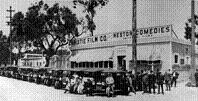
On Oct. 26, 1911 after moving from Bayonne, N.J. to flee Edison's process servers, Centaur Film Co. founders David Horsley (1873-1933), William Horsley (1870-1956), and Alfred Ernest "Al" Christie (1881-1951) shoot their first (unnamed) film in the orchards of H.J. Whitley's estate in Hollywood; on Oct. 27 Hollywood pioneer film dir. Francis W. Boggs (b. 1870) is killed by a berserk employee on the lot of Edendale; the same day the Horsleys and Christie found Nestor Studios in the Blondeau Tavern Bldg. at Gower Gulch (corner of Sunset Blvd. and Gower St.) (rent: $40/mo.), becoming the first movie studio and first film stage in Hollywood, merging next May 20 with other small studios to form Universal Studios while its employees flee from Edison's process servers and the mgt. makes its stand; they finance their move from the success of their weekly (since early July) 1-reel Mutt and Jeff comedies based on the 1907 comic strip by Bud Fisher, starring Lincoln clone Sam D. Drane as A. Mutt, and Gus "Shorty" Alexander as Jeff, becoming popular enough to finance their move to Hollywood; in fall they quit intercutting titles and pictures, and pioneer the use of subtitles, advertising them as "talking pictures"; in 1912 after Bud Duncan replaces Alexander for two films, the serial ends, and in 1916 Fisher licenses Barre Studio to produce an animated series, that lasts for 300 episodes until 1927, distributed by Fox Film Corp.; Nestor Studios is demolished in 1936 to build the CBS Columbia Square bldg. at 6121 Sunset Blvd., home of CBS in 1938-2007.

On Nov. 18, 1911 Joseph A. Golden's The Reporter (Pathe Freres) debuts, starring Pearl White and Gwendolyn Pates, becoming the film debut of Irish-born Am. stage actor Jack W. Johnston (1876-1946), who goes from leading man with Mabel Taliaferro and Norma Talmadge to supporting actor to unbilled bit part actor by the talkie era, working to the end.

On Dec. 11, 1911 Sidney Olcott's Molly Pitcher debuts, becoming the film debut of Swedish-born blonde-blue model Anna Quirentia Nilsson (1888-1974), 1907's "most beautiful woman in America", being named Hollywood's most popular woman in 1926 and getting a record 30K fan letters a month in 1928, becoming the first Swedish-born actress to get a star on the Hollywood Walk of Fame; too bad, after Joseph P. Kennedy hires her to work at RKO Radio Pictures in 1928, she is paralyzed for a year after being thrown by a horse in 1929, and her thick accent dooms her when sound films arrive.
On Dec. 12, 1911 William J. Humphrey's The Military Air-Scout (Vitagraph Co. of Am.) debuts, starring Earle Williams as Lt. Wentworth, Edith Storey as Marie Arthur, and Alec B. Francis as Marie's father Cmdr. Arthur; on Sept. 30 U.S. Army Signal Corps. pilot Lt. Henry Harley "Hap" Arnold (1886-1950) becomes the first movie stuntman in his Army biplane.


On Dec. 21, 1911 Colin Campbell's Brown of Harvard (Selig) debuts, based on the play by Rida Johnson Young, starring Edgar W. Wynn as Tom Brown, Charles Clary as Gerald Thorne, and George L. Cox as Wilfred Kenyon; the film debut of Monterey County, Calif.-born Edgar Livingston Kennedy (1890-1948) (as Claxton Madden), who becomes known as "King of the Slow Burn"; refilmed in 1926.

On Dec. 25, 1911 Tom Ricketts' The Best Man Wins debuts, starring Harold Lockwood, Dorothy and Alice Davenport, Russell Bassett, Gordon Sackville, and Victoria Forde (1896-1964), future wife of Tom Mix, becoming the first movie produced in Hollywood.

In 1911 William F. Haddock's The Immortal Alamo, debuts, starring Francis Ford and Edith Storey, launching the white is right myth of the 1836 Battle of the Alamo; the film debut of Fanny Midgley (1879-1932); too bad, all prints are later lost.
In 1911 Edwin S. Porter founds Rex Motion Picture Co.; his first film is A Heroine of '76 (Feb. 16, 1911), starring Lois Weber, Phillips Smalley, and Gordon Sackville; in 1912 he sells out and becomes chief dir. of the new Famous Players Film Co.; Rex folds in 1917 after 554 films.

In 1911 Florenz Ziegfield Jr. signs Hungarian-born twin cabaret act Rosie Dolly (1892-1970) (Rozsika Deutsch) and Jenny Dolly (Janka Deutsch) (1892-1941) (AKA the Dolly Sisters), who go their separate ways in 1913, and make their film debuts in 1915, appearing in their only film together in "The Million Dollar Dollies" in 1918.
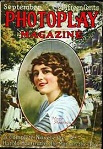
In 1911 Photoplay silent film fan mag. is founded in Chicago, Ill., reaching 204K circ. by 1918; in 1934 it is acquired by Mcfadden Pubs.


On Jan. 1, 1912 Colin Campbell's Cinderella (Selig Studios) debuts, written by Campbell based on the Brothers Grimm story, becoming the film debut of Mabel "Nell" Taliaferro (1887-1979), ister of actress Edith Taliaferro (1894-1958); Mabel goes on to become known as "the Sweetheart of Am. Movies".

On Feb. 6, 1912 Pat Powers' The Nurse (Powers Picture Plays) debuts, starring Shreveport, La.-born Mary Miles Minter (Juliet Reilly) (1902-84), who goes on to star in 50+ silent films by 1923.

On Mar. 14, 1912 D.W. Griffith's Iola's Promise (Biograph) debuts, starring Mary Pickford, Alfred Pagent, and Frank Evans, become the film debut of Madrid, Spain-born Antonio "Tony" Moreno (Antonio Garrido Monteagudo) (1887-1967), who goes on to become known as "the Latin Lover" and become the rival of Rudolph Valentino.

On Apr. 17, 1912 Arthur Hotaling's The Lovers' Signal (Lubin) debuts, becoming the film debut of Eldon Raymond McKee (1892-1984) as Jack Dawson in his first of 173 films by 1935.

On Apr. 30, 1912 German-born Jewish-Am. film producer Carl Laemmle (1867-1939) et al. found Universal Studios (originally Universal Film Manufacturing Co.). in New York City; on Aug. 15 they lease the Providencia Ranch in the San Fernando Valley; in Mar. 14 they spend $165K to buy a 230-acre ranch in N Hollywood, Calif. across the road from where Mexican Gen. Andre Pico and U.S. Col. John Fremont signed the 1847 Treaty of Cahuenga, which becomes known as Universal City, world's largest movie studio, "the entertainment center of the world", which officially opens on Mar. 15, 1915 at a ceremony attended by 15K; the initial pop. has 500 residents incl. 75 Indians living in tepees on the backlot; the first film completed is "Damon and Pythias" (1914) starring William Worthington and Herbert Rowlinson.


On May 8, 1912 well-fixed Hungarian-born Jewish former fur trader Adolph Zukor (1873-1976) in partnership with the Frohman brothers founds Famous Players Film Co. on 26th St. in New York City as the U.S. distribution co. for the French film "Les Amours de la Reine Elisabeth" starring Sarah Bernhardt, and goes on to attract Mary Pickford, who starts with a filmed version of her Broadway play "A Good Little Devil" at $500 a week, which is a bomb, although she becomes hotter than ever with fans; next year Zukor gets financial backing from New York City impresarios the Frohman Brothers, and starts his rise; in 1915 they establish Famous Players Fiction Studios at 5300 Melrose Ave. in Hollywood, their first film starring Mary Pickford; on June 28, 1916 Zukor partners with Jesse L. Lasky, changing the name to Famous Players-Lasky Corp.; in 1919-22 Cecil B. DeMille becomes dir.; in 1920-1 they build the 5-acre Kaufman Astoria Studios in Astoria, New York City close to the Broadway theater district; on Dec. 3, 2013 it opens as New York City's only studio backlot (34.8K sq. ft.).
On May 20, 1912 H.A. Spanuth's Oliver Twist (Gen. Film Co.), debuts, based on the 1838 Charles Dickens novel, starring Nat C. Goodwin as Fagin, Vinnie Burns as Oliver Twist, Charley Rogers as the Artful Dodger, and Mortimer Martine as Bill Sykes, becoming the first feature-length U.S. film (5 reels); in 1917 H.A. Spanuth forms Commonwealth Pictures Corp., which folds in 1920 after 26 films.
In June 1912 New York Motion Picture Co. (founded 1909) signs a merger deal with Universal, then later the same year backs out for a deal with Mutual Film Corp., releasing their last 101-Bison film on Oct. 25 after settling a lawsuit by relinquishing their trademarks on Bison and 101-Bison to Universal, then moving from Edendale to Santa Monica, Calif. after turning the studio over to Keystone, cranking out Broncho films weekly under dir. Francis Ford, along with Kay-Bee films.








On July 4, 1912 Keystone Studios in Edendale, Calif. is founded by Canadian-born Irish Roman Catholic Biograph actor-dir. (failed opera singer) ("the King of Comedy") Mack Sennett (Mikall Sinnott) (1880-1960) (who plays Sherlock Holmes 11x in 1911-13), with $2.5K backing from Charles O. Baumann (1874-1931) and Adam Kessel (Jr.) (1866-1946) of the New York Motion Picture Co. (founded 1909), producing silent comedies starring the Keystone Kops (Cops) until 1917, starring Oxford Street, er, Ford Sterling (George Ford Stich Jr.) (1883-1939) as Chief Teeheezel, "Slow Burn" Edward Kennedy, and Russian-born Hank Mann (David William Lieberman) (1888-1971), originator of the idea; its films are distributed by Mutual Film Corp. until 1915, when it merges with Triangle Film Corp. of Thomas Harper Ince, D.W. Griffith, and Mack Sennett, whose studios go on to form those of Sony Pictures; in 1915 the Sennett Bathing Beauties are founded; in 1917 Sennett quits and forms his own co.; Ince builds a new studio that later becomes the site of Culver Studios; Keystone goes defunct in 1935.

On July 11, 1912 D.W. Griffith's Man's Genesis (Biograph) debuts, starring W. Crystie Miller as Grandfather, Robert Harron as Weakhands, Wilfred Lucas as Bruteforce, and Mae Marsh as Lillywhite.

On July 26, 1912 Charles Brabin's What Happened to Mary? debuts, written by Horace G. Plympton, becoming the first movie serial, consisting of 12 monthly 1-reel episodes starring Mary Fuller as Mary; the dir. debut of English-born Charles Brabin (1882-1957), who goes on to marry silent-screen vamp Theda Bara in 1921, becoming a rare successful Hollywood marriage that lasts until her 1955 death from cancer.



On Sept. 9, 1912 D.W. Griffith's An Unseen Enemy (Biograph) debuts, becoming the film debut for Springfield, Ohio-born Gish sisters Lillian Gish (de Guiche) (1893-1993) and Dorothy Elizabeth Gish (1898-1968), childhood friends of Mary Pickford, who introduced them to Griffith.

On Oct. 11, 1912 Alice Guy's A Fool and His Money (Solax) debuts, starring James Russell as Sam Jones, becoming the first film with an all-African-Am. cast.

On Nov. 7, 1912 ?'s The Honor of the Family (Universal) debuts, becoming the film debut of Colorado Springs, Colo.-born "Man of a Thousand Faces" Leonidas Frank "Lon" Chaney Sr. (1883-1930), who abandoned his theater career after his wife Cleva attempted suicide and ruined her singing voice, divorcing him; after failing to get a pay raise, he leaves Universal in 1919.

On Dec. 5, 1912 D.W. Griffith's The New York Hat debuts, starring $175/week Biograph star Mary Pickford, who decides to return to Broadway, and stars next year in David Belsco's "A Good Little Devil" for $200/week; she then decides that films are funner, and returns to Calif. next year, getting a pay raise to $300/week.

In 1912 Yakov Protazanov's and Elizaveta Thiman's Departure of a Grand Old Man (Thiemann and Reinhardt) debuts, becoming the film debut of English-born Olga Petrova (Muriel Harding) (1884-1977), who emigrates to the U.S. and debuts in Alice Guy's The Tigress (Dec. 7, 1914) (Popular Plays and Players Inc.) as Stella, going on to appear in 20+ films before leaving the film industry in 1918 to go to Broadway.

In 1912 ?'s Apartment No. 13 debuts, becoming the film debut of Russian-born Billy (Billie) West (Roy B. Weissburg) (1892-1975), who goes on to become a Charlie Chaplin imitator ("the Faux Charlot") in 1917 co-starring with Oliver Hardy, becoming a producer in 1922 and creating his own persona with a straw hat and pencil mustache, turning into a dir. in 1924.
In 1912 the Marx Brothers bring their singing act to the Opera House in Nacogdoches, Tex., and are interrupted by a runaway mule, which causes the audience to leave to watch as better entertainment, causing them to switch to insulting the audience,which draws laughs, changing their act permanently to comedy, after which Groucho Marx likes to bring up the town any time anybody mentions Tex.

On Jan. 7, 1913 Charles Farley's The Romance of the Utah Pioneers (Bison Motion Pictures) debuts, becoming the film debut of Lafayette, Ind.-born Louise Fazenda (1895-1962), who goes on to appear in almost 300 films, specializing in comedy, and marrying Warner Bros. producer Hal B. Wallis in 1927, becoming known for her kindly acts of charity.
On Jan. 31, 1913 Ralph Ince's How Fatty Made Good (Vitagraph) debuts, starring Hughie Mack as Fatty, Lucille Lee Stewart as Lucy, and Richard Rosson as Zeb.

On Feb. 18, 1913 Edwin S. Porter's and Hugh Ford's The Prisoner of Zenda (Famous Players) debuts, their first full length feature film, based on the 1894 Anthony Hope novel, starring has-been Canadian stage actor James Keteltas Hackett (1869-1926), who reluctantly interviews Adolph Zukor wearing a fur-collared coat with frayed sleeves, carrying a gold-headed cane.


On Apr. 4, 1913 ?'s A Wolf Among Lambs (Essanay) debuts, becoming the film debut of San Francisco, Calif.-born stage actor Allen Holubar (1888-1923), who married Baltimore, Md.-born actress ("Kid Nazimova") Dorothy Phillips (Dorothy Gwendolyn Strible) (1889-1980), in 1912, and appears in 38 films by 1917, then directs 33 films until his untimely 1923 death from gallstone surgery and pneumonia.
On Apr. 18, 1913 Arthur V. Johnson's The Power of the Cross (Lubin) debuts, starring Johnson as Rev. Paul Damer, Florence Hackett as Iris Temple, Charles Brandt as her father Rev. John Temple, and Lottie Briscoe as Mary Grey; "Never part with your cross; it was your father's."

On July 10, 1913 Edwin S. Porter's A Good Little Devil (Famous Players) debuts, based on the Austin Strong play based on the Maurice Rostand play "Un Bon Petit Diable", becoming the feature film debut of Mary Pickford as Juliet; David Belasco plays himself, Ernest Truex plays Charles MacLance, Edward Connelly plays Old Nick Sr., Wilda Bennett plays Queen Mab, and Arthur Hill plays Rab the Dog; too bad, it bombs.

On July 15, 1913 Lucius J. Henderson's Tannhauser (Tannhäuser) (Thanhouser Film Corp.), debuts, based on the Richard Wagner opera, starring James Cruze as Tannhauser, Marguerite Snow as Princess Elisabeth, Florence La Badie as Venus, and William Russell as Wolfram.

On July 17, 1913 Mack Sennett's A Noise from the Deep debuts, starring Fatty Arbuckle, and featuring up-and-coming star Mabel Normand (1892-1930), who becomes the first person to throw a cream pie on film.
In Aug. 1913 Augustus E. Thomas' Arizona debuts, starring Robert Broderick, Cyril Scott, and Gail Kane, becoming the first film released by All Star Feature Film Corp., which releases its last of 12 films "Garden of Lies" on July 12, 1915.

On Sept. 10, 1913 J. Searle Dawley's In the Bishop's Carriage debuts, based on the 1910 Miriam Michelson novel and filmed on the East Coast, starring Mary Pickford and English actor Robert House Peters Sr. (1880-1967), who next year becomes one of the first film actors to permanently settle in Los Angeles, going on to become known as "the Star of a Thousand Emotions" only to get phased-out in the late 1920s when the talkies arrive.

On Nov. 10, 1913 J. Searle Dawley's Caprice (Famous Players Film Co.) debuts, starring Mary Pickford as Mercy Baxter, Owen Moore as Jack Henderson, Ernest Truex as Wally Hendeson, and Ogden Crane as Jim Baxter.

In Nov. 1913 D.W. Griffith's The Battle at (of) Elderbush Gulch (Biograph) debuts, starring Mae Marsh, Lillian Gish, and Lionel Barrymore fighting red savages, becoming the first-ever use of irising (circular masking) by camerman G.W. Bitzer.

In Dec. 1913 Walroth, London-born vaudeville actor Charles Spencer "Charlie" Chaplin (1889-1977) arrives at Keystone Studios in Los Angeles suburb Edendale, and begins his amazing film career with a $150/week contract.

In 1913 King Vidor's Hurricane in Galveston debuts, becoming the dir. debut of Galveston, Tex.-born King Wallis Vidor (1894-1982), who receives five best dir. Oscar nominations during the next 70 years.


In 1913 George Loane Tucker's Traffic in Souls (Universal Studios) debuts, about white slavery, filmed on location in Manhattan and Ellis Island, starring Walter Long, shocking the U.S. and resulting in white slavery being added to the list of banned topics under the Hays Code, making Chicago, Ill.-born dir. George Loane Tucker (1880-1921) into the "first of the immortals".



Here cum da Jooz to take over Hollywood? In 1913 San Francisco, Calif.-born Jesse Louis Lasky (1880-1958) (known for his rimless glasses), Arthur S. Friend (atty.), Cecil Blount DeMille (1881-1959), and his brother-in-law Samuel Goldwyn (Goldfish) (Szmuel Gelbfisz) (1879-1974) found Jesse L. Lasky Feature Play Co. with $26.5K, which on June 28, 1916 becomes Famous Players-Lasky Corp.

On Jan. 14, 1914 J. Searle Dawley's An American Citizen (Famous Players Film Co.) debuts, becoming the film debut of Philly-born stage actor ("the Great Profile") John Barrymore (John Sidney "Jack" Blyth) (1882-1942).

On Jan. 15, 1914 Robert Z. Leonard's Michael Arnold and Doctor Lynn (Rex Motion Picture Co.) debuts, starring Robert Z. Leonard as Michael Arnold, and Joseph Singleton as Dr. Lynn, becoming the film debut of Philly-born Edna Mayo (Lane) (1895-1970) (as Michael's wife), who appears in 22 films in 1914-15, four in 1916, and one ("Hearts of Love") in 1918, then retires in San Francisco, Calif.

On Jan. 15, 1914 Oscar Apfel's and William C. de Mille's The Only Son (Jesse L. Lasky Feature Play Co.) debuts, becoming the dir. debut of accomplished playwright William Churchill de Mille (1878-1955), elder brother of Cecil B. DeMille (who changed his name to look better on a marquis).

On Feb. 2, 1914 Henry Lehrman's Making a Living (Doing His Best, A Busted Johnny, Troubles, Take My Picture) (Mack Sennett) debuts, becoming the film debut of Charlie Chaplin as lady-charming swindler Edgar English, who is chased by the Keystone Kops.

On Feb. 7, 1914 Henry Lehrman's Kid Auto Races at Venice (Max Sennett) debuts, introducing the Little Tramp char. of Charlie Chaplin in a baby cart race in Venice, Calif.
On Feb. 7, 1914 Ralph W. Ince's A Million Dollar Bid (Vitagraph) (copyrighted Nov. 26, 1913), debuts, shown in the new Vitagraph Theatre on Broadway, complete with a Wurlitzer organ, starring Anita Stewart as Agnes Belgradin, Charles Kent as Sidney Belgradin, and Julia Swayne Gordon as Mrs. Belgradin, bucking conventional wisdom that theater goers won't sit still for more than an hour, giving them five reels, becoming a hit, upping the ante in the movie biz; too bad, after rival movie exhibitors boycott Vitagraph, they sell it in 1916, and it becomes the Criterion Theatre, after which in 1920 Paramount-Famous Players buys it, making it a reserved-seat theater showing only Paramount releases until 1926, when the flagship Paramount Theatre opens in Times Square.

On Feb. 9, 1914 Henry Lehrman's Mabel's Strange Predicament (Max Sennett) debuts, starring Mabel Normand and Charlie Chaplin, becoming the first film in which he portrays the Little Tramp, but released two days after "Kid Auto Races at Venice".

On Feb. 10, 1914 Edwin S. Porter's Hearts Adrift debuts, starring Mary Pickford; a big hit, she becomes the first actress to have her name put above the title on movie marquees, and asks for and get a pay raise to $1K a week, the first of many, rising to $2K a week in 1915 plus 50% of the profits.


On Feb. 15, 1914 Cecil B. DeMille's The Squaw Man debuts, becoming DeMille's first Hollywood film, produced by Jesse L. Lasky Feature Play Co. based on the 1905 Edwin Milton Royle play, and filmed in Flagstaff, Ariz. until a range war chases them to Hollywood, where they rent a barn at the corner of Vine St. and Selma St. for $75/mo.; stars Hampton Beach, N.H.-born former stage actor Dustin Lancy Farnum (1874-1929) (brother of William Farnum) as British Capt. James Wynnegate, who takes the rap for his cousin's embezzlement and heads to the Am. West as Jim Carston to work on a cattle ranch; the first motion picture made in Hollywood by a you-know-what (Jew), already starting the master plan in motion by featuring a mixed marriage between an English nobleman and an Am. Indian?; okay, Mayer's father is Episcopalian, and he was raised as one, but his mother is a converted Sephardic Jew, and we all know how they love to fake it?; a big hit, the studio hires new stars incl. Blanche Sweet, Wallace Reid, and Ina Claire, followed in 1915 by opera star Geraldine Farrar, who signs a 3-picture deal for $20K incl. a house, servants, chaffeur-driven limo, and private railway carriage for trips to New York City; Dustin Hoffman's mother names him after a mag. that features Dusty Farnum on the cover.

On Mar. 8, 1914 D.W. Griffith's 61-min. Judith of Bethulia debuts, based on the Bible Book of Judith, starring Blanche Sweet as Judith, who disguises herself as a harem girl and seduces Nebuchadnezzar's general Holofernes (Henry B. Walthall), cutting his er, head off with a sword and returning as a hero; the first feature-length film from Biograph, with a budget of $36K; too bad, Griffith has a falling-out with the mgt. over the making of more feature-length films, leaving and taking his entire stock co. with him, causing Biograph to delay the release of this 1913 film until now to avoid paying him profit-sharing.

On Mar. 9, 1914 Henry Lehrman's The Tango Tangle (Max Sennett) debuts, starring Charles Chaplin as a tipsy hoofer, Fatty Arbuckle as the clarinetist, and Ford Sterling as the bandleader.

On Mar. 16, 1914 Vitagraph's The Christian (Vitagraph) debuts, written by Eugene Mullin based on the Hall Caine novel, an 8-reeler starring Earle Williams as Brother John Storm, James Morrison as Brother Paul, and Edith Storey as Glory Quayle, which Vitagraph exhibits after leasing the Harris Theatre on 42nd St. in New York City; its success pisses-off other movie theater owners, causing them to promise not to trod into their turf anymore.

On Mar. 20, 1914 Edwin S. Porter's Tess of the Storm Country (Famous Players Film Co.), based on the 1909 novel by Grace Miller White is released five weeks after "Hearts Adrift", making Mary Pickford (playing Tessibel Skinner) the most popular actress in the U.S. and world; also stars Harold Lockwood as Frederick Graves, Olive Carey as Teola Graves, David Hartford as Daddy Skinner, Louise Dunlap as Old Mother Moll, and William Walters as Elias Graves; refilmed in 1922 starring Mary Pickford, in 1932 starring Janet Gaynor, and in 1960 starring Diane Baker.

On Mar. 25, 1914 Colin Campbell's The Spoilers (Gen. Film Co.) debuts, based on the 1906 novel by Rex Beach, starring Tom Santschi and Boston, Mass.-born stage actor William Farnum (1876-1953) (brother of Dusty Farnum), who engage in a fight for a full reel, going on to coach Gary Cooper and William Boyd for the 1930 remake; Farnum goes on to become a top Hollywood star, earning $10K/week.

On Mar. 31, 1914 Eclectic Film Co.'s The Perils of Pauline (Pathe) debuts, a 20-episode serial (410 min.) starring Green Ridge, Mo.-born Pearl Fay White (1889-1938) (one of the few actresses to add years [8] to her age to avoid Mary Pickford type child roles) as Pauline, whose wealthy guardian Mr. Marvin has left her inheritance in care of his secy. Mr. Koerner, which she can receive only after marrying, which she doesn't want to do quite yet, featuring non-cliffhangers where she gets in one but gets rescued, but causes the idea of a real cliffhanger to catch on?; Ingham Run Trestle in New Hope, Penn. is featured in the most famous scene; Milton Berle (Mendel Berlinger) (1908-2002) makes his movie debut as a baby thrown off a train and rescued by Pearl White; French distributor Pathe recuts it for home movie use with printed captions in French, which get hilariously mistranslated back into English, e.g., "What is that tic-tac I can hear" (time bomb).

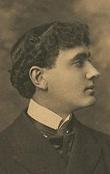
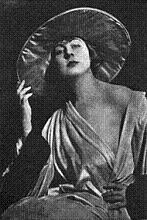

On Apr. 12, 1914 Pierre of the Plains (All Star Feature Film Corp.) debuts, based on the novel "Pierre and His People" by Gilbert Parker and the hit 1908 Broadway play; the film debut of Edgar Selwyn (1875-1944) and Dorothy Dalton (1893-1972), who starred in the Broadway production with ex-hubby Lew Cody (Côté) (1884-1934); refilmed in 1918 as "Heart of the Wilds", and in 1942; in 1924 Dalton marries Arthur Hammerstein, son of Oscar Hammerstein I, and slacks off from film work.

On Apr. 18, 1914 Mack Sennett's Mabel at the Wheel (A Hot Finish) (Keystone) debuts, starring Charlie Chaplin, Mabel Normand, and Harry McCoy, becoming the film debut (uncredited) of comedian Charley Chase (Charles Joseph Parrott) (1893-1940), known for his dapper mustache and flustered embarrassed expression; during filming Chaplin quarrels with Normand, causing Sennett to almost fire him, but after receiving a telegram from New York City asking for more Chaplin films he smooths things over.


On Apr. 21, 1914 Arthur Hotaling's Outwitting Dad (Lubin) debuts, becoming the film debut of 6'1" 300 lb. comedian Oliver "Ollie" "Babe" (Norvell) Hardy (1892-1957) as Reggie Kewp, and the dir. debut of Arthur Douglas Hotaling (1873-1938), who directs 113 films by 1928; his wife (since Aug. 1902) Mae Hotely (1872-1954) creates her stage name as a play on his.

On May 4, 1914 Charlie Chaplin's Caught in the Rain (Mack Sennett) debuts, becoming Chaplin's dir. debut after he offers to pay $1.5K if the film bombs, and is a hit, after which he directs almost every film he appears in at Keystone, approx. 1 per week, later calling this the most exciting time of his career.


On May 8, 1914 Independence, Kan.-born West Coast movie theater owner William Wadsworth Hodkinson (1881-1971) merges 11 film rental bureaus to create Paramount Pictures, the first U.S.-wide feature film distributor, introducing block booking, forcing exhibitors to buy a bundled package containing movies from his partners incl. Adolph Zukor's Famous Players, Jesse L. Lasky's Feature Play Co. et al., charging movie producers 35%, launching the Hodkinson System of Movie Distribution, which takes over the industry, making him into "the Man Who Invented Hollywood"; in 1914 he designs the Paramount logo by doodling 9,712-ft. Ben Lomond Mt. in Utah on a napkin; in 1916 he sells out to Famous Players-Lasky and forms Superpictures Inc. in Nov. 1916; in 1929 he leaves the motion picture business and goes into airplane manufacturing until he's forced out of business in 1936.

On June 15, 1914 ?'s The Baited Trap (IMP) debuts, based on a story by Monte M. Katterjohn, starring King Baggot, Arline Pretty, and Frank Smith, becoming the film debut of Garrett, Ind.-born John Bowers (John E. Bowersox) (1885-1936) (as Blondie), who goes on to become one of the top leading men and star in 94 films, marrying Marguerite De La Motte in 1924-36; too bad, he can't make the cut in the talkie era, and drowns after renting a 16 ft. sloop and sailing to Santa Catalina Island hoping to beg old friend Henry Hathaway for a part in "Souls at Sea", finding that it has been cast, then never returning and washing up on shore, serving as inspiration for the char. of Norman Maine in "A Star is Born".

On July 17, 1914 Frank Powell's The Stain (Pathe) debuts, starring Frank Powell and Edward Jose, becoming the film debut of Cincinnati, Ohio-born half-Jewish (Polish Jewish father, Swiss mother) Theda Bara (Theodosia Burr Goodman) (1885-1955), who goes on to specialize in femme fatale roles, earning the nickname "The Vamp" (vampire), appearing in 40+ films by 1926.
On Aug. 4, 1914 - Nov. 11, 1918 the horrific World War I causes 15M deaths and 39M military casualties, and destroys the Old Order of white formerly Christian Europe; Charlie Chaplin is eligible to be called up for war duty by both the U.S. and Britain, but never is.

On Sept. 7, 1914 Cecil B. DeMille's The Virginian (Jesse Lasky Feature Plays) debuts, based on the 1902 novel by Owen Wister, starring Dustin Farnum as the Virginian, with Jack W. Johnston (uncredited) playing his friend Steve, who is lynched for cattle rustling, becoming DeMille's first hit.


On Oct. 5, 1914 Augustus E. Thomas' The Nightingale (All Star Feature Film Corp.) debuts, starring accomplished stage actress Ethel Barrymore (Ethel Mae Blythe) (1879-1959) (sister of John Barrymore) (known for the soundbyte "That's all there is, there isn't any more") (who turned down a marriage proposal from Winston Churchill in 1898) in her film debut as Isola Franti, "the Nightingale", also becoming the film debut of tall, dark, and handsome leading man Conway Tearle (1878-1938), who has been a leading romance man on the stage since 1905.

On Oct. 26, 1914 John H. Pratt's Shore Acres (All Star Feature Film Corp.) debuts, based on the James A. Herne play, becoming the film debut of New York City-born "Fairy Soap Girl" child star Margherita "Madge" Evans (1909-81) (as Mildred), who goes on to become the perennial nice girl in 1930s films.


On Nov. 7, 1914 J.P. McGowan's and James Davis' The Hazards of Helen film series (Kalem Studios) debuts, based on the novel by John Russell Corvell and the play by W. Scorr Darling, starring Helen Holmes (1892-1950), "the Original Railroad Girl", who does her own stunts for 26 episodes until marrying dir. McGowan and leaving to set up their own film co., after which Elsie McLeod substitutes in episodes 27-49, followed by Hoot Gibson's wife (1913-20) Helen Gibson (Rose August Wenger) (1892-1977) (first Am. prof. stunt woman) for a total of 119 12-min. episodes (Feb. 24, 1917) (23.8 hours).

On Nov. 23, 1914 Otis Turner's Damon and Pythias debuts, written by Ruth Ann Baldwin based on a story by Edward Bulwer-Lytton, strring William Worthington as Damon, Herbert Rawlinson as Pythias, and Cleo Madison as Hermione, becoming the first film released from Universal Studios; Frank Lloyd plays Dionysius.

On Nov. 26, 1914 Thomas N. Heffron's Aristocracy (Famous Players Film Co.) debuts, based on a play by Bronson Howard, starring Marguerite Skirvin and Edna Mayo, becoming the film debut of London, England born veteran stage actor Tyrone Power Sr. (Frederick Tyrone Edmond Power) (1869-1931) as Jefferson Stockton.

On Dec. 7, 1914 Cecil B. DeMille's and Oscar Apfel's The Ghost Breaker (Jesse L. Lasky Feature Play Co.) debuts, becoming the film debut of London-born H.B. Warner (Henry Byron Charles Stewart Warner-Lickfold) (1875-1958), who later stars as Jesus Christ in DeMille's 1927 "King of Kings".



On Dec. 21, 1914 Henry Lehrman's Tillie's Punctured Romance (Max Sennett) debuts, becoming the first feature length (6-reel) comedy film, starring Charlie Chaplin as a city slicker who talks chunky wealthy farmer's daughter Tillie Banks, played by Coburg, Ont., Canada-born "Ugly Duckling" Marie Dressler (Leila Marie Koerber) (1868-1934) in her feature film debut (who was hired first, then hires him) into eloping to get her daddy's dough; also stars Mabel Normand; does ? on a $200K budget; after his request to raise his salary to $1K a week is refused, Chaplin accepts an offer from Essanay Film Manufacturing Co. in Chicago, Ill. for $1,250 a week plus a $10K signing bonus, and arrives in Dec., forming a stock co. incl. Billy Armstrong, Bud Jamison, Paddy McGuire, and Leo White, and discovering his leading lady Edna Purviance (1895-1958) in a cafe, going on to appear with her in 35 films in the next eight years, while hooking up romantically until 1917.

In Dec. 1914 Bray Productions is founded by John Randolph Bray (1879-1978) to crank out silent animation series, starting with Colonel Heeza Liar (a spoof of Teddy Roosevelt) (1913-17, 1922-4), animated by Walter Lantz, hiring the Fleischer Brothers in 1916, becoming the #1 animation studio in the U.S. until WWI, then going out of the entertainment biz in 1928, leaving an educational branch that lasts until 1963.
In 1914 Henry Lehrman's A Thief Catcher (Max Sennett), debuts, the 3rd film from Keystone, a 10-min. comedy starring Charlie Chaplin as one of two Keystone Cops; not discovered until 2010.
In 1914 the city of Beverly Hills, Calif. 5 mi. W of Hollyood is incorporated by a group of investors who search for oil and find water instead; it goes on to become a rich town for Hollywood stars et al., known for the posh zip code 90210, the rich Rodeo Drive shopping district, and the Beverly Hills Oil Field.
In 1914 the $1M Strand Theatre in New York City is opened by Mitchel Henry Mark (1868-1918), becoming the first movie palace in the U.S. ("making the average citizen feel like royalty"), spurring imitators.
In 1914 Reliance-Majestic Studios at 4516 Sunset Blvd. in Hollywood, Calif. is built, becoming the home of D.W. Griffith and the Mutual Film Corp., later changing its name to Fine Arts Studios, Griffith Studio, and Griffith Artcraft Studio; in 1927 it is acquired by Tiffany Pictures, which goes bankrupt in 1932, after which it is renamed Talisman Studios and rented out to Monogram Pictures et al.
By 1915 most U.S. films are made in Los Angeles.

On Jan. 2, 1915 Hal Roach's Willie Runs the Park debuts, starring Harold Lloyd as Will E. Work, Jane Novak as the Pretty Girl, and Roy Stewart as Willie's rival, becoming the debut of Elmira, N.Y.-born producer-dir. (former extra) Harold Eugene "Hal" Roach Sr. (1892-1992), who moves from downtown Los Angeles to Culver City, Calif., going on to produce films with Lloyd (who changes his character to Lonesome Luke and becomes his top money-maker until his 1923 departure), Will Rogers, Max Davidson, Our Gang, Charley Chase, Harry Langdon, Thelma Todd, ZaSu Pitts, Patsy Kelly, and Laurel and Hardy; in 1925 his main rival Mack Sennett steals his head dir. F. Richard Jones; Pathe Exchange distributes his films until 1927, followed by MGM until May 1928, followed by United Artists; in 1929 he begins releasing talkie shorts; in 1940-3 he produces 40-50-min. featurettes (streamliners) to be shown with double-features; in June 1942 he joins the U.S. Signal Corps, and converts his studio to crank out 400 military training films starring Ronald Reagan, Alan Ladd et al.; in 1947 he resumes theatrical films, hiring Harold Lloyd co-star Bebe Daniels as an assoc. producer, becoming the first producer with an all-color production schedule, making four streamliners in Cinecolor; too bad, they lose money, causing him to convert his studio to TV, with his son Hal Roach Jr. as producer; in 1955 he sells out to his son, who drives it into bankruptcy, causing it to be shut down in 1961.

On Jan. 20, 1915 Lois Weber's Hypocrites debuts, a bold indictment of political corruption, big business, and the Church launches the dir. career of Penn.-born former Christian street-corner evangelist Lois Weber (1881-1939), who has a flair for outdoor scenes and double exposure sequences, becoming Universal Studios' highest-paid dir. by 1916; nude scenes of uncredited Margaret Edwards (1877-1929) as Naked Truth cause riots in New York, causing it to be banned in Ohio and Boston, making it more popular?; too bad, her career tanks in the 1920s and she dies broke.


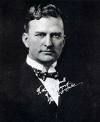
In Jan. 1915 Reginald C. Barker's The Italian is released, becoming a hit for Canadian-born dir. Reginald C. Barker (1886-1945), starring George Beban (1873-1928) in his film debut as Italian immigrant Pietro "Beppo" Donnetti; producer Thomas Harper Ince (1880-1924) steals the credit for the film.







In Jan. 1915 Metro Pictures Corp. is founded to distribute Solax films by Richard A. Rowland (1880-1947) and Louis Burt Mayer (1884-1957), who leaves to go solo in 1918; its biggest stars are Viola Dana (Virginia Flugrath) (1897-1987), and the romantic teams of Francis Xavier Bushman (1883-1966) and Beverly Bayne (Pearl Beverly Bain) (1894-1982), and Harold A. Lockwood (1887-1918) and May Allison (1890-1989); in 1920 Rowland sells out to Marcus Loew, becoming an exec at Fox Film Corp.; on Apr. 16, 1924 Metro merges with Goldwyn Pictures and Louis B. Mayer Pictures to become Metro-Goldwyn-Mayer (MGM).

On Feb. 4, 1915 Charles Avery's Hogan, the Porter (The New Bellhop) (Keystone Film Co.) stars Charles Murray as Hogan, becoming the film debut of Australian stage actress Annie Mae Busch (1891-1946), who begins an affair with Keystone Studio chief Mack Sennett, whose fiancee Mabel Normand walks in on them hooking up, splitting with him after Busch hits her on the head with a vase; Busch goes on to become known as "the Versatile Vamp", sailing high until she walks out on her contract at MGM in 1926 and suffers a nervous breakdown, but makes a comeback in 1927, starting a long association with Laurel and Hardy, playing various roles incl. Hardy's wife; "The ever-popular Mae Bush" (Jackie Gleason).
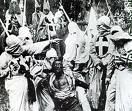

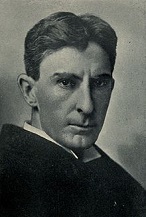











On Feb. 8, 1915 D.W. Griffith's The Birth of a Nation (The Klansman), based on the 1905 novel "The Clansman" by Shelby, N.C.-born white supremacist Thomas Frederick Dixon Jr. (1864-1946) debuts in Los Angeles, Calif., becoming the first movie sequel (to "The Avenging Conscience", 1914) and the highest-grossing film of the silent film era, grossing $10M on a $110K budget; first film produced with its own score, by composer Joseph Carl Breil; by technically brilliant but incurably white supremacist Ky.-born dir. D.W. Griffith (1875-1948) and cinematographer G.W. Bitzer (1872-1944); stars Griffith's Ala.-born favorite Henry Brazeale Walthall (1878-1936) as Confed. veteran Col. Ben Cameron (known as "the little colonel" because of his shrimpy height), who rounds-up the KKK, making him a major star; also stars Lillian Gish (who steals the role from Blanche Sweet) as Elsie Stoneman, causing Sweet to leave for Paramount; also stars London-born former opera singer-dir. George William "Donald" Crisp (1882-1974) (Griffith's asst. since 1912) as Gen. Ulysses S. Grant, who goes on to serve in WWI and WWII and become a Hollywood dir. and power broker as chmn. of the Bank of Am. in the 1930s and 1940s, approving loans while getting rich from real estate, allowing him to become a top char. actor without worrying about money, appearing in 400 films; the film incenses Am. banana-eating, er, blacks, but amoral Russian-born capitalistic Jew Louis Burt Mayer (1884-1957) turns $50K into $500K by investing in it; William Beaudine (1892-1970) is asst. dir.; future dir. Raoul Walsh (1887-1980) plays John Wilkes Booth; Griffith's fellow Kentuckian Nellie Conley (Madame Sul-Te-Wan) (1873-1959) plays several minor roles in the film, becoming Hollywood's first important black performer; too bad, Griffith fires her for "inciting blacks to protest the film's showing in the Los Angeles area", but she successfully sues to be rehired; slender handsome Winfield, Kan.-born Eugene William Pallette (1889-1954) plays a Union soldier, going on to act in several silent films then balloon up to 300 lbs., signing with Hal Roach Studios in 1927 and becoming even more popular; Pres. Wilson, known for resegregating the military and firing all black postal workers calls the film "Like writing history with lightning, and it's all true", stoking a revival of the Ku Klux Klan that Dixon disassociates himself from because he is pro-Jewish and pro-Roman Catholic; Dixon uses his profits to buy an orange grove in Hollywood that he uses to found its first movie studio.
On Feb. 23, 1915 the U.S. Supreme (WHite) Court rules 9-0 in Mutual Film Corp. v. Industrial Commission of Ohio that motion pictures are commercial speech not protected by the First Amendment, allowing the Puritans to clamp down via obscenity laws; on May 26, 1952 the court reverses itself in Joseph Burstyn Inc. v. Wilson.
 On Apr. 16, 1915 Fred E. Wright's Graustark
(Essanay Studios) debuts, based on George Barr McCutcheon's Graustark novels about a fictionary country in E Europe with capital at
Edelweiss, starring Francis X. Bushman as Grenfall Lorry, and Beverly Bayne as Princess Yetive; remade in 1923 and 1925.
On Apr. 16, 1915 Fred E. Wright's Graustark
(Essanay Studios) debuts, based on George Barr McCutcheon's Graustark novels about a fictionary country in E Europe with capital at
Edelweiss, starring Francis X. Bushman as Grenfall Lorry, and Beverly Bayne as Princess Yetive; remade in 1923 and 1925.

On June 10, 1915 Am. film dir. Edwin Stanton Porter (1870-1941) and Am. cinematographer William E. Waddell demonstrate stereoscopic red-green anaglyph (requiring red and green spectacles to view) 3-D Movies at the Astor Theater in New York City, showing their short film Niagara Falls, which features dancing girls; too bad, they never follow it up, and Porter leaves Famous Players and the film business in 1916 after 250+ films, going back to manufacturing Simplex projectors as pres. of the Precision Machine Co. in 1917-25.

In summer 1915 English-born teenie aspiring entertainer Leslie Townes "Bob" Hope (1903-2003) wins a Charlie Chaplin imitation contest in Luna Park in Cleveland, Ohio.
On Aug. 2, 1915 Lawrence B. McGill's Sealed Valley (Metro Pictures Corp.) debuts, based on the novel by Hulbert Footner, starring Dorothy Donnelly as NW Am. Indian maiden Nahnya Crossfox, and Jack W. Johnston as Dr. Cowdray; it is filmed on location near Saranac Lake, N.Y., with Catamount Mountain dynamited to cause a rockslide.

On Sept. 19, 1915 Edwin Middleton's Pool Sharks (The Pool Shark) debuts, written by Fields, becoming the 2nd film of Darby, Penn.-born alcoholic dog-and-children-hating W.C. Fields (William Claude Dukenfield) (1880-1946) as a pool shark, featuring a stop-motion scene; his 1st film, dir. by Ed Wynn as part of the Ziegfield Follies of 1915 is lost.

On Oct. 29, 1915 Robert Ellis', John Mackin's, and Hamilton Smith's The Ventures of Marguerite (Vitagraph) debuts, starring Marguerite Gabrielle Courtot (1897-19836) as an heiress who loves beautiful clothes and adventures while being chased by schemers and gangsters trying to get their hands on her dough; first of 16 episodes; in 1923 she marries Raymond McKee, staying married for life.

On Oct. 31, 1915 Cecil B. DeMille's Carmen (Famous Players-Lasky) debuts, starring famed Melrose, Mass.-born opera singer Geraldine Farrar (1882-1967) in her film debut; Wallace Reid plays Don Jose; Pedro de Cordoba plays Escamillo; Farrar made her U.S. debut on Nov. 26, 1906 at the Metropolitan Opera in New York City in Romeo et Juliette, later going into silent movies and developing fanatical fans known as Gerryflappers while engaging in a 7-year affair with Arturo Toscanini et al., becoming the silent era Liz Taylor; in 1915 Toscanini abruptly resigns from the Metropolitan Opera after she gives him an ultimatum; on Feb. 8, 1916 she marries silent film actor Lou Tellegen, who cheats on her, leading to a divorce in 1923 after she retires in 1922; in 1934 Tellegen commits suicide in Hollywood, and Farrar replies "Why should that interest me?"



On Nov. 1, 1915 Hal Roach's Giving Them Fits debuts, a comedy featuring the new team of eyeglasses-wearing Harold Lloyd (1893-1971) (known for doing his own stunts, losing his right thumb and index finger in 1919) and Bebe Daniels (1901-71), who begin a romance and become known as "the Boy and the Girl", appearing in a series of 2-real "Lonesome Luke" comedies; Australian-born Harry "Snub" Pollard (1889-1962) (known for his upside-down Kaiser Wilhelm II mustache) also stars.

On Nov. 7, 1915 Christy Cabanne's The Lamb debuts, co-written by D.W. Griffith, becoming the film debut of Douglas Fairbanks Sr. (Douglas Elton Ullman) (1883-1939) as bungling loser Gerald.

On Nov. 14, 1915 The Coward (Triangle Kay-Bee Enterprise Distributing Corp.) debuts, becoming the film debut of Dubuque, Iowa-born Broadway star Frank Keenan (1858-1929) as Col. Jefferson Beverly Winslow; also stars Charles Ray as Frank Winslow, and Gertrude Claire as Mrs. Elizabeth Winslow.

On Nov. 14, 1915 John Emerson's Old Heidelberg (Fine Arts Film Co.) debuts, starring Wallace Reid, Dorothy Gish, and Karl Formes, becoming the film debut of Vienna, Austria-born Erich von Stroheim (Erich Oswald Stroheim) (1885-1957) as Lutz, who blossoms into a dir. after WWI.

On Nov. 14, 1915 Charles Avery's A Submarine Pirate (Mack Sennett) debuts, starring Charlie Chaplin's illegitimate half-brother Sydney John "Syd" Chaplin (Hill) (1885-1965), Wesley Ruggles, Glen Cavender, and Phyllis Allen, with an uncredited appearance by Harold Lloyd.

On Nov. 19, 1915 Al Christie's Wanted: A Leading Lady (Nestor Film Co.) stars Eddie Lyons and Lee Moran, becoming the film debut of Beaver, Utah-born Eleanor Lucime "Betty" Compson (1897-1974) as the Leading Lady, who goes on to make dozens of shorts for Al Christie before graduating to features in mid-1918, becoming a star in "The Miracle Man" (1919) as Rose, then founding her own production co. in 1920, doing well in the talkie era and making her last film in 1948, then retiring to help her 3rd husband Silvius Jack Gall run Ashtrays Unlimited.

On Nov. 23, 1915 Larry Semon's The Baby and the Boss (Thanhouser Film Corp.) debuts, starring Daniel Keleher, Boyd Marshall, and Helen Badgley, becoming the dir. debut of West Point, Miss.-born former cartoonist Lawrence "Larry" Semon (1889-1928) (former writer-dir.-producer for Hughie Mack's films at Vitagraph), who breaks into acting next year, becoming known for his white-painted face, derby hat, overalls, wide smile, and propensity for causing chaos, working with Stan Laurel and Oliver Hardy before they team up; too bad, as he becomes popular he demands overexpensive sets incl. exploding barns, auto wrecks, even permanent log cabins, causing Vitagraph to force him to become a producer, ending up filing for bankruptcy in 1928 then suffering a nervous breakdown and dying of TB and pneumonia on Oct. 8, 1928 in a sanatorium in Victorville, Calif.

On Dec. 24, 1915 Frank Borzage's The Pitch o' Chance debuts, becoming the dir. debut of Italian immigrant Frank Borzage (1894-1962), who develops a knack for films about young lovers facing adversity; meanwhile on June 7, 1916 he marries actress Lorena B. "Rena" Rogers (1900-66), who turns out to like lots of women too, causing him to have affairs with Mary Pickford, Joan Crawford, Marion Davies, Hedy Lamarr, and Lupe Velez until their 1941 divorce.

On Dec. 31, 1915 Henry W. Savage's Excuse Me debuts, based on the Rupert Hughes play, starring George F. Marion, Geraldine O'Brien, and Vivian Blackburn, becoming the film debut of stage actor Harrison Ford (1884-1957) (as Lt. Harry Mallory), who can't make it in the talkie era, and retires in 1932; too bad, on Sept. 13, 1951 he is hit by a car while walking in Los Angeles, Calif., and never fully recovers, dying on Dec. 2, 1957.
In Dec. 1915 after making 14 films for them, Charlie Chaplin's contract with Essanay Studios lapses after Chaplinitis spreads worldwide, making him the first internat. film star, complete with merchandise, after which he requests a $150K signing bonus from his next studio, which is accepted by Mutual Film Corp., along with a $10K/week salary (ends June 1917); in Mar. 1916 he opens his own studio in Los Angeles, Calif., adding Albert Austin and Eric Campbell to his stock co., later Henry Bergman; Chaplin later calls his time with Mutual the happiest time of his career.
In 1915 Wally Van's The Fates of Flora Fourflush; or, The Massive Ten Billion Dollar Vitagraph Mystery Sequel debuts, starring Clara Kimball Young in Vitagraph's first serial.

In 1915 ?'s The Hypocrites (Victor Film Co.) debuts, becoming the film debut of Pittsburgh, Penn.-born Lois Wilson (1894-1988), who won the first Miss Alabama pageant in Birmingham this year and gave up a career as a school teacher to move to Hollywood, and goes on to appear in 150 films, specializing in the "soft, marrying kind of woman", who never marries in real life.



In 1915 the Vim Comedy Co. is founded by Russian-born Louis Burstein (1878-1923) (after he founds Wizard Film Co. this year and cranks out eight films) and Polish-born Mark M. Dintenfass (1872-1933) after they buy Lubin's struggling Jacksonville, Fla. facilities, cranking out hundreds of 2-reel comedies starring Oliver Hardy, Ethel Marie Burton, Walter Stull, Billy Ruge, Kate Price, and the husband-wife teams of Henry C. Myers and Rosemary Theby, and Billy Bletcher and Arline Roberts; too bad, it goes out of biz in 1917 when Hardy discovers that Burstein and Dintenfass are stealing from the payroll, and it is acquired by the King Bee Studios of Burstein, which folds in 1918 after producing 25 films, after which he founds Burston Films Inc., which produces six films before folding in 1922.

On Jan. 2, 1916 Thomas H. Ince's Peggy (Kay-Bee Pictures) debuts, becoming the film debut of Washington, D.C.-born stage actress Mary William Ethelbert Appleton "Billie" Burke (1884-1970) (as Peggy Cameron), wife (since 1914) of Ziegfeld Follies founder Florenz Ziegfield Jr.; after snubbing film for the stage, the 1929 Stock Market Crash wipes out her family's savings, causing her to have to make a Hollywood comeback in 1932 in George Cukor's "A Bill of Divorcement", playing Katherine Hepburn's mother; too bad, after years as a renowned Broadway beauty, she has to become a film comedian to stay employed, uttering the soundbyte: "Oh, that sad and bewildering moment when you are no longer the cherished darling, but must turn the corner and try to be funny."

On Jan. 3, 1916 Arthur Berthelet's The Misleading Lady (Essanay) debuts, based on the play by Paul Dickey and Charles W. Goddard, starring Henry B. Walthall, Edna Mayo, and Sidney Ainsworth, becoming the film debut of stage actor Edward Arnold (Gunther Edward Arnold Schneider) (1890-1956), who leaves film to return to the stage in 1919, and returns to film in 1932, going on to appear in 150+ films, gaining more work as he gains weight.

On Feb. 10, 1916 Frederick Thomson's 5-reel Nearly a King debuts, starring John Barrymore and his first wife Katherine Corri Harris (screen debut), becoming the screen debut of Adolphe Jean Menjou (1890-1963).


On Feb. 16, 1916 Paul Powell's Acquitted (Triangle Film Corp.) debuts, written by Roy Somerville and Tod Browning based on a story by Mary Roberts Rinehart becomes the film debut of innocent wholesome Midland, Tex.-born Bessie Love (Juanita Horton) (1898-1986) as Helen Carter, making a star of Canadian-born stage actor Wilfred Lucas (1871-1940) as John Carter; "No single performance in the records of active photography has surpassed his visualization of the humble book-keeper in 'Acquitted'" (Photoplay)
On Feb. 27, 1916 after Essanay in Calif. won't give him a $500K contract, his half-brother Sydney Chaplin negotiates for Charlie Chaplin in New York City a $10K/week plus $150K signing bonus with Mutual, causing Charlie to hire him as his business mgr. and give him half of the signing bonus, going on to make several films, later calling it "the happiest period of my career".

On Mar. 5, 1916 George Melford's To Have and to Hold (Famous Players-Lasky/Paramount) debuts, written by Margaret Trumbell based on the 1900 bestselling novel by Mary Johnston, starring Wallace Reid, becoming the film debut of Mae Murray (1889-1965), "the Girl with the Bee-Stung Lips", who becomes known for her elaborate lipstick ritual, giant ego, and hammy overacting, and goes on to become the prototype of Hollywood starlets, becoming so successful she starts her own production co. with dir. John Stahl, and utters the soundbyte "Once you become a star, you're always a star"; she accidentally drops a donut into a cup of coffee in Lindy's Restaurant, starting a craze; too bad, when talkies arrive her voice stinks, and she ends up broke by 1933 and homeless in St. Louis, Mo. at age 75, uttering the soundbyte: "We were like dragonflies. We seemed to be suspended effortlessly in the air, but in reality, our wings were beating very, very fast."

On Apr. 8, 1916 Earl Metcalfe's A Wise Waiter (Lubin) debuts, becoming the film debut of Australian comic actor Billy Bevan (William Bevan Harris) (1887-1957), who becomes known for his derby hat and crooked mustache, later working with Mack Sennett, originating the "snapping oyster in a bowl" routine in "Wandering Willies" (1926), which is later copied by the Three Stooges.
On Apr. 21, 1916 the Rialto Theatre in Times Square in New York City at Broadway and W. 42nd St. opens on the site of the vaudeville Victoria Theatre, becoming the first movie palace in Times Square, billed as "the Original Temple of the Motion Picture", showing five films daily, with sound provided by an orchestra, singers, and an organ.

In Apr. 1916 Ashley Miller's The High Cost of Living (J.R. Bray Studios) debuts, becoming the film debut of Corinne Mae Griffith (1894-1979), who moves to Vitagraph Studios then First Nat. Pictures, and becomes known as "the Orchid Lady of the Screen", becoming one of their most popular stars until the advent of talkies exposes her nasal voice, after which she pub. 11 books incl. two bestsellers and makes a bundle in real estate.


On May 22, 1916 Oscar Apfel's Battle of Hearts debuts, written by Frances Marion, starring William Farnum, becoming the film debut of Hedda Hopper (Elda Furry) (1885-1966), who goes on to appear in 120+ movies, usually playing a society woman wearing large flamboyant hats, becoming known as "Queen of the Quickies", finally phasing into a new career in 1937 of gossip columnist in Los Angeles, attacking Charlie Chaplin and getting him denied permission to reenter the U.S. in 1952, getting kicked in the ass by Spencer Tracy at Ciro's, her chair pulled out from under her by Joseph Cotten, sued by Michael Wilding for libel, called a "ferret" by ZaSu Pitts, and sent a skunk by Joan Bennett, which Hopper says is "beautifully behaved", giving it to James Mason.

In May 1916 Phillips Smalley's and Lois Weber's Where Are My Children? (The Illborn) (Universal) debuts, based on the 1915 Margaret Sanger case, starring Tyrone Power Sr. as DA Richard Walton, who prosecutes a physician for killing a client while performing an abortion, discovering that his wife helped procure clients; also stars Helen Riaume and Marie Walcamp; the film debut of Pittsburgh, Penn.-born 5'3" blonde-blue stage actress Mary MacLaren (MacDonald) (1896-1985) as Walton's maid (uncredited), who appears in 136 films by 1949.

On June 11, 1916 John Emerson's and Christy Cabanne's The Mystery of the Leaping Fish debuts, written by Tod Browning, starring Douglas Fairbanks Sr. as Coke Ennyday, a cocaine-loving parody of Sherlock Holmes, who uses a "scientific periscope" to spy on visitors outside his door, and has a sign on the wall reading "EATS, DRINKS, SLEEPS, and DOPE"; Bessie Love plays the Little Fish Blower; Alma Rubens plays Fairbanks' female accomplice; a sign of the decadence behind the scenes in Hollyweird?

On June 26, 1916 Lois Weber's Shoes (Universal) debuts, written by Stella Wynne Herron based on the Jane Addams novel, starring Mary MacLaren as Eva Meyer, who must support her father (Harry Griffith), mother (Mattie Witting), three brothers on $3 a week, ending up selling her body for a pair of you know what; parodied in "The Unshod Maiden' (1932).

On July 30, 1916 Allan Dwan's The Half Breed debuts, a Western based on a Bret Harte story, starring Douglas Fairbanks Sr. as outcast Lo Dorman, making a star of Alma Rubens (Alma Genevieve Reubens) (1897-1931) as Teresa; too bad, in 1924 she becomes addicted to morphine, fighting addiction until her premature death of pneumonia on Jan. 22, 1931.






On Sept. 5, 1916 D.W. Griffith's Intolerance: Love's Struggle Through the Ages (A Sun-Play of the Ages) debuts, containing four soporific stories showing how hate and intolerance battle love and charity, with a mother rocking a cradle to mark the passing of time, incl. the Babylonian Story, the Judean Story, the French Story, and the Modern Story ("The Mother and Law"), becoming his most expensive film, with a lavish Babylon set complete with giant white elephants using 3K extras paid $2 a day, and 7.5K horses; Lillian Gish plays Eternal Motherhood; Mae Marsh plays the Dear One; Robert Harron plays the boy; Douglas Fairbanks plays a drunken soldier with a monkey; Billy Bitzer is the cameraman; a harem scene with full nudity is cut; too bad, it flops after $2.5M spent in production, causing Triangle Film Corp. to be put up for sale in 1918, with Gene Fowler calling it "the greatest commercial anticlimax in film history"; "the only film fugue"; asst. dirs. Erich von Stroheim, Tod Browning, and Woody Van Dyke go on to their own careers; the lavishly produced Babylon Story, starring Constance Talmadge (1897-1973) as the Mountain Girl and Alfred Paget as Belshazzar is released separately in 1919 in an attempt to recoup some of the losses, and makes her a star, causing her to become an item with her sisters Norma Talmadge (1893-1957) and Natalie Talmadge (1896-1969), who also appear in the film, and all go on to get wealthy until the advent of talkies, when they all retire (1929); the film debut of Mildred Harris (1901-44) and Carol Dempster (1901-91) as harem girls; Dempster becomes one of Griffith's favorites, getting casted in almost all his films in the 1920s, pissing-off rivals Mae Marsh and Lillian Gish; in the early 1920s she hooks up with Griffith after he gets estranged from his wife Linda Arvidson, then stars in several feature films until 1926, marrying rich banker Edwin S. Larson in 1929; the Babylon set is later declared a fire hazard by the LA Fire Dept. and demolished.
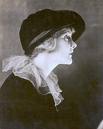
On Nov. 19, 1916 W. Eugene Moore's The World and the Woman debuts, a Thanhouser film starring newbie Jeanne Eagels (1890-1929) as a street ho who turns into a faith healer, making her a star, with David Belasco uttering the soundbyte "Thousands of girls have come to me, but never such a girl as Jeanne Eagels, with the air of a Duse, the voice of an earl's daughter, and the mien of a tired, starved little alley cat"; too bad, her overworking habits cause her to become a substance abuser, and she ends up dying in 1929 of an OD of heroin, chloral hydrate, and alcohol.
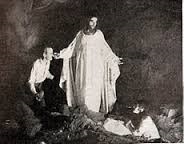
In 1916 Thomas Harper Ince's Civilization is released, a silent epic about the timely topic of the horrors of war; a famous scene shows Christ walking through body-ridden battlefields.


In 1916 Colin Campbell's Gloria's Romance (George Kleine) debuts, a serial written by Rupert Hughes starring Billie Burke, becoming the film debut of New York City-born Richard Semler "Dick" Barthelmess (1895-1963) after his mother's English student Alla Nazimova opens doors for him.
On Jan. 8, 1917 Joe De Grasse's The Piper's Price (Universal Pictures) debuts, becoming the first in 14 films by 1919 co-starring Lon Chaney Sr., William Stowell, and Dorothy Phillips, who alternate roles, occasionally joined by Claire DuBrey.

On Feb. 11, 1917 The Gunfighter, produced by Thomas H. Ince, debuts, making Newburgh, N.Y.-born actor-dir. William Surrey Hart (1864-1946) (a silent film actor since 1914, usually billed as "William S. Hart") a cowboy hero, starring in 27 films in 1917-24, each of which grosses $500K+.
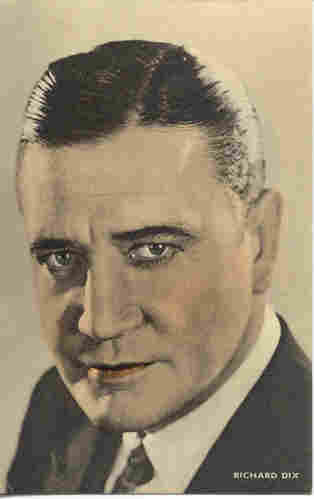
On Feb. 12, 1917 Christy Cabanne's One of Many debuts, starring Frances Nelson, Niles Welch, and Mary Mersch, becoming the film debut of manly actor Richard Dix (Ernst Carlton Brimmer) (1893-1949).

On Mar. 1, 1917 after moving to Calif. in July 1914 and becoming the asst. of his actor-dir. brother Francis Ford at Universal Pictures, John Ford's The Tornado debuts, starring Ford, Peter Gerald, and Jean Hathaway, becoming the dir. debut of Cape Elizabeth, Maine-born John "Jack" "Pappy" "Coach" Ford (John Martin Feeney) (Sean Aloysius O'Feeney or O'Fearna) (1894-1973), who goes on to direct 140+ films and become the king of directors; his movies always slip in bits of his Irish heritage, such as U.S. cavalry men singing "The Bold Fenian Men".

I'm just a kid, I can do my part, they just think I'm cute, I just smile and I'm outta there? On Apr. 24, 1917 the U.S. begins selling Liberty Bonds, starting with $5B at 3.5%, then $3B more at 4% on Oct. 1, then $3B more at 4.5% next Apr. 5, and finally $6B more at 4.35% next Sept. 18, eventually raising $17B to help pay its $30B war debt; "America's Sweetheart", "Little Mary", "The Girl With the Curls" (first Hollywood movie star) Mary Pickford (Gladys Mary Smith) (1892-1979), Charles Spencer "Charlie" Chaplin (1889-1977), Douglas Fairbanks Sr. (1883-1939), and Marie Dressler (Leila Marie Koerber) (1868-1934) tour the U.S. promoting Liberty Bonds, starting in Washington, D.C., then Wall Street, where 50K show up; Pickford auctions one of her golden curls for $15K, and raises $5M worth of bonds in a single speech in Chicago, Ill., and is christened the U.S. Navy's "Little Sister", while the U.S. Army makes her an honorary col. and names two cannons after her; the Aviation Section of the U.S. Army Signal Corps creates an elite group of Army pilots assigned to the Liberty Bond campaign, touring the country putting on airshows then offering free rides in their Curtis J4 "Jenny" airplanes to anybody who buys one; in 1918 Chaplin releases the propaganda film The Bond.

On Apr. 25, 1917 to compete against Paramount Pictures, First National Film Corp. of Am. (originally First Nat. Exhibitors' Circuit) is founded by Thomas Lincoln Tally (1861-1945), James Dixon Williams (1877-1934) et al. by merging 26 of the biggest first-run cinema chains in the U.S., growing to 600 houses incl. 200+ first-run houses; they start out by signing the first $1M film contracts with Mary Pickford and Charlie Chaplin, causing Paramount to invest $10M in their own theater chain and secretly negotiate a merger, causing Pickford and Chaplin to bolt and start their own studio United Artists, and First Nat. to back out of the merger; in 1919 they change their name to Associated First Nat. Pictures Inc., with the subsidiary Associated First Nat. Theatres Inc. consisting of 5K independent theater owners; in 1924 after Paramount tries a hostile takeover, buying member firms, it changes its name to First Nat. Pictures Inc., producing its own films in a studio in Burbank, Calif. in 1926; in Sept. 1928 Warner Bros. acquires them to produce comedies, dramas, and crime stories; in July 1936 First Nat. Pictures Inc. is merged with Warner Bros. Pictures; in 1941-58 most Warner Bros. films feature the trademark "A Warner Bros.-First National Picture".
On June 17, 1917 after declining a contract renewal with Mutual for 12 films for $1M to form Charlie Chaplin Productions, and declining a matching offer from Famous Players-Lasky and their massive Paramount distribution network, Charlie signs an 8-film (no set release schedule) $1.25M distribution contract with the First Nat. Exhibitors' Circuit for $1.25M ($125K per 2-reel film, plus $115K for each additional reel, making 3+-reel films economically feasible, along with a 30% distribution fee, and a 50-50 split of the profits), allowing Charlie to build his own studio off Sunset Blvd. on five acres, which is completed in Jan. 1918, becoming his own independent filmmaker; too bad, First Nat. begins secret negotiations for a $40M merger with Paramount to create a monopoly, becoming standoffish with Charlie.

On July 23, 1917 Perry N. Vekroff's Richard the Brazen (Vitagraph) debuts, starring Harry T. Morey, William Frederic, and Alice Joyce, becoming the film debut of Agnes Ayres (Agnes Eyre Henkel) (1898-1940), who was discovered by Joyce and plays her sister.

On Sept. 30, 1917 Alfred J. Goulding's By the Sad Sea Waves debuts, starring Harold Clayton Lloyd Sr. (1893-1971) as a hero who saves a man from drowning, only to find out it's the wrong man; the dir. debut of Melbourne, Australia-born Alfred John "Alf" Goulding (1885-1972), who gets Lloyd to wear his trademark eyeglasses.

On Nov. 17, 1917 Marshall Neilan's The Little Princess, debuts, based on the 1905 Frances Hodgson Burnett novel, starring Mary Pickford as Sara Crewe, becoming the film debut of ZaSu Pitts (1894-1963) (ZaSu = Eliza + Susan) as Becky.

On Dec. 23, 1917 George W. Lederer's Runaway Romany debuts, becoming the film debut of Lederer's sister-in-law Marion Davies (Marion Cecilia Douras) (1897-1965), who is also the screenwriter; she goes on to star in three films next year, becoming nouveaux riche and hooking up with newspaper magnate William Randolph Hearst as his live-in lover for over 30 years.
In 1917 English wigmaker George Westmore (1879-1931) establishes the first film makeup dept. in Hollywood, which becomes a dynasty.

On Jan. 21, 1918 Marshall Neilan's Stella Maris debuts, based on the 1913 William J. Lock novel, tragedy starring Mary Pickford as a crippled girl who is cared for by rich Lady Eleanor and Sir Oliver Blount (Ida Waterman and Herbert Standing), and poor orphan Unity Blake (Pickford), who both fall in love with the married John Risca (Conway Tearle).

On Jan. 26, 1918 William Desmond Taylor's The Spirit of '17 (Jesse L. Lasky Feature Play Co.) debuts, written by Julia Crawford Ivers based on a story by Judge Willis Brown, starring Jack Pickford, Clarence Geldart, and Edythe Chapman, becoming the film debut of Pittsburgh, Penn.-born 5'8" actress ("the American Beauty") Katherine Agnew MacDonald (1891-1956) as Flora Edwards, who in 1920 founds Katherine MacDonald Pictures, and in 1920 signs with First Nat., making $50K a picture, engaging in a public feud with her sister Mary MacLaren and stirring gossip of an affair with Pres. Woodrow Wilson; in 1928 she marries Fleischmann's Yeast heir Christian Rasmus Holmes (1898-1944), then successfully sues for divorce in 1931, claiming he fired at her with a pistol through a locked door after locking her in a cage and burning her with cigarettes.

On Jan. 27, 1918 Scott Sidney's Tarzan of the Apes debuts, based on the 1912 Edgar Rice Burroughs novel and more faithful to the book than later screen versions, starring Elmo Lincoln (1889-1952), as the first screen Tarzan, who kills a lion onscreen that went beserk; Colo.-born Enid Markey (1984-1981) plays Jane, later playing Barney Fife's landlady in "The Andy Griffith Show", and Grandma Pyle in "Gomer Pyle, U.S.M.C."

In Feb. 1918 the Million Dollar Theater in Los Angeles, Calif. is opened by Sidney Patrick "Sid" Grauman (1879-1950), becoming the first movie palace on the U.S. West Coast.

On Mar. 10, 1918 William Nigh's My Four Years in Germany (Warner Bros.) debuts, an anti-German propaganda flick starring Halbert Brown as U.S. ambassador James W. Gerard, Willard Dashiell as Sir Edward Goschen, Louis Dean as Kaiser Wilhelm II, Earl Schenck as the crown prince of Germany, George Ridell as Field Marshal von Hindenburg, and Frank Stone as Prince Henry of Prussia, becoming the film debut of Cophenhagen, Denmark-born actor-comedian Karl Dane (Rasmus Karl Therkelsen Gottlieb) (1886-1934) as German Chancellor von Bethmann-Hollweg; does $500K box office on a $50K budget.


On Mar. 12, 1918 D.W. Griffith's Hearts of the World (Paramount) debuts, a WWI propaganda movie filmed on location near the Western Front and in Britain to move the U.S. public off their neutral position by portrayals of German brutality, starring Lillian Gish as the Girl (Marie Stephenson), Dorothy Gish as the Little Disturber, Adolph Lestina as the Grandfather, and Josephine Crowell as the Mother; Lillian Gish later utters the soundbytes: "'Hearts of the World' enjoyed great success until the Armistice when people lost interest in war films. The film inflamed audiences. Its depiction of German brutality bordered on the absurd. Whenever a German came near me, he beat me or kicked me"; "I don't believe that Mr. Griffith every forgave himself for making 'Hearts of the World.' 'War is the villain,' he repeated, 'not any particular people.'"


On Mar. 19, 1918 Rupert Julian's The Kaiser, the Beast of Berlin (Renowned Pictures Corp.) debuts, an anti-German WWI propaganda film starring Rupert Julian as the Kaiser, along with Elmo Lincoln, Nigel De Brulier, and Lon Chaney, portraying the evil greedy Kaiser's soldiers as resisting him, and forecasting the war's end.

On Apr. 14, 1918 Charlie Chaplin's A Dog's Life (his first film for First Nat. Pictures) debuts, starring Charlie Chaplin and Edna Purviance, along with Scraps the Dog, billed as "His first million dollar picture."

On May 21, 1918 the documentary Pershing's Crusaders by the Committee on Public Info. debuts, becoming the film debut of Boston, Mass.-born Lillian Roth (Rutstein) (1910-80) (as an extra), who tours with her sister Ann Roth as the Roth Kids, meeting Pres. Wilson and riding in his limo, and goes on to become a star in the late 1920s and early 1930s; it is followed by "America's Answer" (1918).

On Sept. 22, 1918 Hobart Henley's Laughing Bill Hyde (Rex Beach Pictures Co.) debuts, based on the Rex Beach novel, starring Anna Lehr as Ponotah, and Clarence Oliver as Dr. Evan Thomas, becoming the film debut of Oologah, Okla.-born part-Cherokee humorist ("Oklahoma's Favorite Son") William Penn Adair "Will" Rogers (1879-1935) (as Bill Hyde), who rises to become the top-paid Hollywood star of the mid-1930s until he dies in a plane crash on Aug. 15, 1935 in Point Barrow, Alaska.

On Oct. 20, 1918 Charlie Chaplin's Shoulder Arms! (First Nat. Pictures) debuts, his 2nd film with First Nat., starring Charlie Chaplin as a boot camp private, Syd Chaplin as his comrade, and Edna Purviance as a French girl who helps him capture the kaiser (Syd) and the crown prince (Jack Wilson); Chaplin's shortest film, and most popular so far.

On Oct. 23, 1918 after thinking that he made her pregnant, 29-y.-o. Charlie Chaplin marries 16-y.-o. Cheyenne, Wyo.-born Mildred Harris (1901-44), who played a harem girl in D.W. Griffith's "Intolerance" (1915); on Oct. 25 Louis B. Mayer signs a contract with her to star as "Mrs. Charles Chaplin", pissing-off Charlie, who wasn't consulted; after her child "the Little Mouse" dies at age three days in July 1919, their marriage skids, and he begins hooking up with Alla Nazimova, causing a publicity scandal and divorce proceedings; on Apr. 8, 1920 Chaplin decks Mayer at the Alexandria Hotel, saying "I only did what any man would have done"?; in Nov. 1920 Harris receives a $100K settlement plus some community property, and continues acting.

On Nov. 8, 1918 Eugen Illes' Mania: Die Geschichte einer Zigarettenarbeiterin (PAGU) (UFA) debuts in Germany, starring Polish beauty Pola Negri (Barbara Apolonia Chalupec) (1897-1987), whose dark penetrating eyes cause her to be noticed by Hollywood after a series of UFA films for producer Ernst Lubitsch; watch trailer; view clip; view clip.

On Nov. 10, 1918 Harley Knoles' Little Women debuts, based on the 1868 Louisa May Alcott novel, starring Isabel Lamon as Meg, Dorothy Bernard as Jo, Lillian Hall as Beth, and Florence Flinn as Amy, and is the film debut for handsome blonde-blue actor Conrad Nagel (1897-1970), who plays Laurie Laurence.

On Dec. 16, 1918 Joseph Gleason's The Beloved Imposter (Vitagraph) debuts, starring Gladys Leslie, Huntley Gordon, Denton Vane, Julia Hurley, Frances Miller, and Gwen Williams, becoming the film debut of Lynn, Mass.-born James Neil Hamilton (1899-1984).
On Dec. 22, 1918 Allen Holubar's The Heart of Humanity (Universal Pictures), a ripoff of D.W. Griffiths' "Hearts of the World" produced by Carl Laemmle is an anti-German propaganda film starring Dorothy Phillips as Nanette, William Stowell as John Patricia, and Erich von Stroheim as the nasty Hun Eric von Eberhard, who attempts to rape her then throws a crying baby out of the window; too bad, on Nov. 24, 1919 Stowell is killed in the Belgian Congo while scouting filming locations by a runaway locomotive engine, which crashes into his railway car.

On ?, 1918 Jesse L. Lasky's The Cruise of the Make-Believes debuts, becoming the film debut of 17-y.-o. German-Am. Lila "Cuddles" Lee (Augusta Wilhelmena Fredericka Appel) (1901-73), who rises to leading lady and stars in a zillion silent flicks.

In 1918 after United Artists rejects his buy offer, San Francisco, Calif.-born newspaper magnate William Randolph Hearst (1863-1951) founds Cosmopolitan Productions in New York City along with Adolph Zukor of Paramount to film pictures based on stories in Cosmopolitan mag., Harpers Bazaar, and Good Housekeeping, moving to Hollywood in 1923 after the bldg. at 126th St. and 2nd Ave. burns down, going on to overpromote the career of his lover actress Marion Davies, who appears in 29 silent and 17 talkie films from the co. while living with him at Hearst Castle in Santa Monica, Calif., and St. Donat's Castle in Wales, throwing parties for Charlie Chaplin, Douglas Fairbanks, John F. Kennedy et al.; in 1923-34 production is handled by MGM until they cast Norma Shearer in her parts, causing him to switch to Warner Bros.; the co. folds in 1938 after she retires in 1937; she was good in comedic roles, but he kept forcing her into dramatic roles, hampering her acceptance?; he lives with her as a wife, while his real wife won't give him a divorce; in the late 1930s Hearst almost goes bankrupt, causing her to bail him out with a $1M check; Hearst dies on Aug. 14, 1951, and she inherits 51% of his fortune, becoming a philanthropist, endowing the Mattel Children's Hospital at UCLA with $1.9M in 1952, and the Marion Davies Foundation; she's the basis of Susan Alexander in "Citizen Kane" (1941)?

In 1918 after moving in from Pittsburgh, Penn., Warner Brothers Studios on Sunset Blvd. in Hollywood is founded by Polish-born Jewish brothers Harry Morris (Hirsch Moses) Warner (Wonsal) (1881-1958), Albert "Abe" Warner (Wonsal) (1884-1967), Samuel Louis "Sam" Warner (Wonsal) (1887-1927), and Jacob Leonard "Jack" "J.L." Warner (Wonsal) (1892-1978); by the 1930s it becomes known for friendly connections with FDR, and movies filled with dark city streets.

On Jan. 21, 1919 Erich von Stroheim's Blind Husbands (The Pinnacle) (Universal) debuts, becoming Stroheim's dir. debut, starring Stroheim, Sam De Grasse, Francelia Billington, and Gibson Gowland.

On Jan. 26, 1919 Cecil B. DeMille's Don't Change Your Husband (Paramount) debuts, starring 5'0" Gloria May Josephine Swanson (1899-1983) (fresh from Mack Sennett Keystone comedies) as Leila Porter, becoming her first romantic lead.

In Jan. 1919 after the Chaplin brothers Charlie and Sydney, along with Mary Pickford and her lover Douglas Fairbanks Sr. hire a sexy female spy and learn of plans to merge First Nat. and Paramount and cap actor salaries and squeeze out independent production cos., and Pickford, Fairbanks, and dir. D.W. Griffith hold a meeting at the Palm Court at the Alexandria Hotel in Los Angeles to plan it, they hold a press conference the night before the start of the First Nat. Exhibitors Circuit convention at the Alexandria Hotel and announce that they are going to form their own United Artists distribution co. to compete with them, rocking Hollywood; although they intended the announcement as a bluff, the fanfare causes them to go through with it, and on Feb. 5 4-artist United Artists film distribution co. is founded by Charlie Chaplin Mary Pickford, Douglas Fairbanks Sr., dir. D.W. Griffith, and atty. (former U.S. treasury secy.) William Gibbs McAdoo (who replaces cowboy star William S. Hart, who helped originate the idea then dropped out), pioneering the independent distribution of films, attracting independent producers and renting temporarily unbooked theaters; Metro Pictures head Richard A. Rowland utters the soundbyte: "The inmates are taking over the asylum"; meanwhile Sydney Chaplin signs a $1M contract with Famous Players-Lasky, but appears in only one film, "King, Queen, Joker" (1921); in 1919-20 United Artists sets up the Pickford-Fairbanks Studio on Santa Monica Blvd. in Los Angeles, Calif., after which Pickford becomes the most powerful woman in Hollywood history; too bad, studio boss Charlie Chaplin still has six films to make for First Nat., hindering his availability at United Artists, and he only makes two short films for them in 1919, both forgettable, "Sunnyside" and "A Day's Pleasure", pissing them off and causing them to accuse him of slacking, which he responds to by producing his great 6-reel film "The Kid" in 1921.

On Apr. 28, 1919 Eddie Lyons' and Lee Moran's The Expert Eloper (Universal) debuts, becoming the film debut of 255 lb. actress-comedian Babe London (Jean Glover) (1901-80).




On May 4, 1919 Albert Capellani's The Red Lantern debuts, based on the Edith Wherry novel, starring Russian-born "Woman of 1000 Moods" Alla Nazimova (Alia Nasimoff) (Mariam Edez Adelaida Leventon) (1879-1945) (lover of Charlie Chaplin, and inventor of the term "sewing circle" for lesbians) as Mahlee and Blanche Sackville, and Noah Beery as Dr. Sam Wang; the debut of vamp Mercedes Dagmar Godowsky (1897-1975), sister of Leo Godowsky Jr., who invents Kodachrome film in the 1930s, and Anna May (Liu Tsong) Wong (1905-61), who becomes the first Chinese-Am. movie star.

On June 8, 1919 Carl Harbaugh's The Other Man's Wife debuts, starring Ellen Cassiday, Stuart Holmes, and Ned Hay, becoming the film debut of Bronx, N.Y.-born ethnic Jewish actor George Albert "Georgie" Jessel (1898-1981), known for the comedy skit "Phone Call from Mama".


On July 27, 1919 Henry Kolker's The Woman Michael Married debuts, based on a novel by Annette Kellerman, starring Elizabeth Barry "Bessie" Barriscale (1884-1965) (cousin of the Taliaferro sisters), who goes on a world tour with her actor-dir. hubby Howard C. Hickman (1880-1949), selling their house in Los Angeles to Jackie Coogan in 1922 for $45K.

On Aug. 29, 1919 George Loane Tucker's The Miracle Man (Paramount Pictures) debuts, based on the 1914 George M. Cohan play about faith healing scam artists, based on the Frank L. Packard novel set in 1919 New England, starring Lon Chaney Sr. as the Frog, Thomas Meighan as gang boss Tom Burke, and Betty Compson as con artist Rose; does $3M box office on a $126K budget, making stars of the actors esp. Chaney; remade in 1932.



The say it ain't so Joe Black Sox scandal stinks up America's sport? On Oct. 1, 1919 the Sixteenth (16th) World Series is changed to a best-of-9 format; on Oct. 9 the Cincinnati Reds (NL) (mgr. Pat Moran) defeat the Chicago White Sox (AL) (mgr. Kid Gleason) 5-3; White Sox pitcher Red Faber is injured and can't play; in 1920 after team owners discover $100K worth of hanky-panky between White Sox players and gamblers led by Jewish organized crime kingpin Arnold Rothstein (1882-1928), and appoint former U.S. district Judge (Ill.) Kenesaw Mountain Landis (1866-1944) as the first baseball commissioner, the White Sox Scandal begins, with eight players ("Eight Men Out"), Edward Victor "Eddie" Cicotte (1884-1969) (pitcher), Oscar Emil "Happy" Felsch (1891-1964) (CF), Charles Arnold "Chick" Gandil (1888-1970) (1B), Joseph Jefferson "Shoeless Joe" Jackson (1889-1951) (LF) ("Shoeless Joe of Hannibal, Mo" - 1958 film "Damn Yankees") (only player to hit a homer in the series), Charles August "Swede" Risberg (1894-1975) (SS), George Daniel "Buck" Weaver (1890-1956) (3B), Claude Preston "Lefty" Williams (1893-1959) (pitcher), and utility player Frederick William "Fred" McMullin (1891-1952) accused of conspiring to throw the series, and all banned from baseball for life by Landis, causing the team to switch to wearing black sox; Jackson has a career .356 batting avg., and bats .375 during the series, and his home WS jersey is lost; the same year horse racing stinks itself up with race fixing and drugging, but 3-y.-o. Man O'War's career gives the sport a hero as good as Babe Ruth?
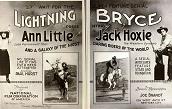
On Oct. 15, 1919 Paul Hurst's Lightning Bryce (Nat. Film Corp.) debuts, written by Joe Brandt and filmed in Bronson Canyon, starring Jack Hoxie as gold prospector Sky "Lightning" Bryce, Ann Little as Kate Arnold, and Paul Hurst as Powder Solvang.

On Nov. 23, 1919 Male and Female (Paramount) debuts, based on the 1902 play "The Admirable Crichton" by J.M. Barrie, starring Gloria Swanson as Lady Mary Lasenby, who titillates viewers in an elaborating bathing scene, and poses as the Lion Bride for Gabriel von Max with a real lion; does $1.25M box office on a $169K budget. By 1921 Swanson becomes a big movie star, going on to work for dir. Sam Wood and become Hollywood's first clothes horse, spending $50K for gowns, $25K for fur coats, $5K for headdresses, $10K for lingerie, and $6K for perfume yearly while making up to $900K a year at Paramount; she drives a leopard-upholstered Lancia.


On Dec. 28, 1919 Victor Fleming's When the Clouds Roll By (Douglas Fairbanks Pictures) debuts, starring Douglas Fairbanks Sr. as New York City waterfront resident Daniel Boone Brown, who is tormented by sadistic pshrink Dr. Ulrich Metz (Herbert Grimwood); Babe London plays an uncredited switchboard operator; the dir. debut of Pasadena, Calif.-born Victor Lonzo "Vic" Fleming (1889-1949).


In 1919 New York City-born Jewish brothers Harry Cohn (1891-1958) former streetcar conductor) and Jack Cohn, and atty. Joe Brandt (1867-1939) found CBC (Cohn-Brandt-Cohn) Productions on Gower St. in Hollywood, cranking out low budget B-films, causing it to become known as Corned Beef and Cabbage, and Gower St. to become known as Poverty Row as more B-film studios locate there; it grows into Columbia Pictures in 1924, going public in 1926.
In 1919 Omaha, Neb.-born costume rental co. owner Morris R. Schlank (1879-1932) founds Morris R. Schlank Productions on Poverty Row in Hollywood, cranking out B-movies starring comedians Hank Mann and Bobby Ray, giving work to has-been actors and dirs. incl. Francis Ford, Ben F. Wilson, and Al Hoxie; it folds in 1932 after he has a heart attack while vacationing in Murietta Hot Springs, Calif.
In 1920 U.S. film production begins moving from the East Coast to Hollywood, with an avg. of 800 film releases in the 1920s-30s; in 1925 total capital investment is $2B; by 1929 there are 20 studios in Hollywood.


On Mar. 2, 1920 Mary Pickford divorces her estranged Irish-born alcoholic actor hubby (since 1911) Owen Moore (1886-1939) and on Mar. 28 marries her longtime beau Douglas Fairbanks Sr. (Douglas Elton Ullman) (1883-1939) (whose love codeword is "by the clock"); too bad, their Euro honeymoon turns into a nightmare when she is mobbed in London by fans who want to touch her curls and trample her, followed by another riot in Paris, where she is locked in a meat cage for protection; her return to Hollywood is marked by crowds meeting them along the way at every railway station, after which the couple becomes known as "Hollywood royalty", with foreign dignitaries at the White House routinely requesting an audience with them at their 4-story 6-bedroom 25-room mock-Tudor Pickfair Mansion at 1143 Summit Dr. in San Ysidro Canyon in Beverly Hills, which Fairbanks purchased for her in 1919, becoming known as "a gathering place only slightly less important than the White House... and much more fun." (Life mag.).

On Mar. 28, 1920 John S. Robertson's Dr. Jekyll and Mr. Hyde (Famous Players-Lasky) (Paramount) debuts, written by Clara Beranger based on the 1886 novella "The Strange Case of Dr. Jekyll and Mr. Hyde" by Robert Louis Stevenson , starring John Barrymore as Dr. Henry Jekyll/Mr. Edward Hyde, Brandon Hurst as Sir George Carewe, Martha Mansfield as his daughter Jekyll's fiancee) Millicent, Nita Naldi as Italian exotic dancer Gina, and Louis Wolheim as the music hall owner; watch film.

On May 30, 1920 Chester Withey's Romance (United Artists) debuts, based on the 1913 Edward Sheldon play, starring St. Joseph, Mich.-born Doris Keane (1881-1945) as opera singer Madame Cavallini, and her hubby (1918-25), St. Osyth, Essex, England-born Basil Sydney (1894-1968) in his film debut as Bishop Armstrong; he goes on to appear in 50+ films.

In July 1920 English actor Archibald Alexander Leach (Cary Grant) (1904-86) first comes to the U.S. as a member of the Bob Pender vaudeville comedians aboard the HMS Olympic, sister ship of HMS Titanic, meeting newlyweds Douglas Fairbanks Sr. and Mary Pickford, causing him to want a suntan like big Doug; Charlie Chaplin returns to England on the same ship next Aug.; Pender's show plays 426 perf. on Broadway, and Leach stays behind when it returns to England, taking odd jobs; his mother Elsie was committed to a mental institution in the spring of 1914, and he doesn't see her again until 1940, finding out that she didn't recognize him in the movies. In 1922 he gets a job as a stiltwalker at Coney Island in N.Y. In 1932 he buys a car and drives from New York to Hollywood, then signs a contract with Paramount with the stage name Cary Grant, going on to make over 70 films with the most beautiful actresses of his day.

On Aug. 30, 1920 Erich von Stroheim's The Devil's Pass Key (Passkey) (Universal Pictures) debuts (Stroheim's 2nd film), starring Sam De Grasse as Warren Goodright, whose Am. playwright wife Grace (Una Trevelyn) has overspent in Paris and owes dressmaker Renee Malot (Maude George) money, causing him to suggest that she contact U.S. Army Capt. Rex Strong (Clyde Fillmore) for a loan, but he wants sex in return, which she refuses, causing Malot to attempt to blackmail her.

On Sept. 3, 1920 D.W. Griffith's Way Down East (United Artists) debuts, the big box office draw of the year, based on the play by Lottie Blair Parker, starring Lillian Gish (de Guiche) (1893-1993) as innocent New England country girl Anna Moore, who must face life with a child born out of wedlock; she ends up in a blizzard, stranded on an ice floe headed toward a waterfall until saved by farmer's son David Bartlett, played by Richard Barthelmess, who makes an honest woman of her; does $2M box office on a $700K budget.

On Sept. 10, 1920 "Everybody's Sweetheart" silent film actress Olive Thomas (Oliveretta Elaine Duffy) (b. 1894) ("the most beautiful girl in the world"), wife of boozing womanizing Canadian actor Jack Pickford (1896-1933) (brother of Mary Pickford) dies of mercury poisoning in Neuilly-sur-Seine, France four days after accidentally taking a large dose of his syphilis pills; her last film "Everybody's Sweetheart" is released a week after her death, becoming a box-office smash; later her ghost is regularly seen in the New Amsterdam Theater in New York City; producer David Selznick adds the middle initial "O" to his name as a tribute; the scandal of her death sets off an entire decade of Hollywood scandals?
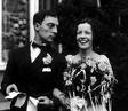

On Oct. 18, 1920 Herbert Blache's The Saphead debuts, based on the play "The New Henrietta" by Winchell Smith, based on the novel by Victor Mapes, becoming the film debut of Joseph Frank "Buster" Keaton (1895-1966) as rich playboy Bertie "the Lamb" Van Alstyne. On May 31, 1921 after not seeing each other for two years and exchanging no love letters, after which she sends him a letter in Jan. saying "I am alone now with Mother. If you still care for me just send for me", silent film star Joseph Frank "Buster" Keaton (1895-1966) marries silent film actress Natalie Talmadge (1896-1969), sister of his producer Joseph Schenck's wife Norma Talmadge; too bad, after spending his dough like water for fancy homes and clothes, and giving him two sons James (b. 1922) and Robert (b. 1924) she stops having sex with him, causing him to begin seeking other dames, which she uses as an excuse for bitter divorce in 1932, taking the rest of his fortune along with the sons, and he becomes an alcoholic, selling his lavish $300K 10K sq. ft. Beverly Hills Italian villa The General (built 1926) (used in the 1972 film "The Godfather") in the 1933; "I took a lot of pratfalls to build that dump."

In Oct. 1920 A.E. Coleby's The Call of the Night (I.B. Davidson) debuts, becoming the film debut of English-born (not Irish) former heavyweight boxer (who defeated Jack Johnson in an exhibition match) (Protestant not Catholic) Victor Andrew de Bier Everleigh McLaglen (1886-1959) as disowned gambler Alf Truscott, who becomes a you-guessed-it boxer; in 1925 he moves to Hollywood, gaining a rep for playing Irish drunks.

On Dec. 19, 1920 Edward Sedgwick's Fantomas (Fox) debuts, starring Edward Roseman as Fantomas, becoming the dir. debut of Galveston, Tex.-born comedian Edward "Ed" "Junior" Sedgwick (1889-1953), who goes on to make films for baseball lovers, signing with MGM in 1928 to be with fellow baseball buff Buster Keaton, then moving to Hal Roach Studios in 1936 before returning to MGM and ending up warming a desk with Keaton.
In 1920 Humphrey Bogart becomes mgr. of the touring play "The Ruined Lady" for $50 a week, and out of boredom gets one line to speak, causing him to want to become an actor, becoming known for rumors of well-endowed sexual equipment.
In 1921 Sunset Blvd. in Hollywood, Calif. begins a major expansion to the W, ending at Sullivan Canyon near Santa Monica, turning the sleepy desert oasis into the U.S. entertainment capital.


On Jan. 1, 1921 the Ambassador Hotel at 3400 Wiltshire Blvd. in Los Angeles, Calif. opens, designed by Pasadena architect Myron Hunt (1868-1952), becoming a favorite spot for Hollywood celebs, Academy Award ceremonies, and U.S. presidents from Hoover to Nixon, who all groove on the Cocoanut Grove Nightclub, which has a big fire on Nov. 28, 1942 that kills 492, and goes on to become the hotel where RFK is killed on June 6, 1968.


On Jan. 21, 1921 Charlie Chaplin's The Kid debuts, written by Chaplin in his dir. debut, starring John Leslie "Jackie" Coogan (1914-84) as John the Kid, combining comedy with pathos in a winning combo; does $2.5M box office on a $250K budget, becoming the #2 grossing film of 1921; after his parents squander his earnings, Coogan gets Calif. to pass the Calif. Child Actor's (Coogan) Act in 1939.

On Jan. 23, 1921 William C. de Mille's Midsummer Madness (Famous Players-Lasky) debuts, starring Jack Holt, Conrad Nagel, Lois Wilson, and Lila Lee, becoming the film debut of Passaic, N.J.-born Ethel Wales (1878-1952), wife of Mary Pickford's business mgr. Wellington E. Wales (1886-1954), who goes on to appear in 130+ films over 30 years.


On Feb. 6, 1921 Albert Austin's On a Summer Day (Mack Sennett) debuts, a comedy starring Kalla Pasha and Harriet Hammond, becoming the film debut of Mammoth, Utah-born Marion Mack (Joey Marion McCreery) (1902-89) as Farmerette (using her real name); also the film debut of Scottish-born Andrew Allan "Andy" Clyde (1892-1967), who continues on into the TV age as Cully Wilson in "Lassie" and George MacMichael in "The Real McCoys".

On Feb. 27, 1921 Lois Weber's What's Worth While? (Famous Players-Lasky) debuts, starring Claire Windsor as Phoebe Jay Morrison, Arthur Stuart Hull as Mr. Morrison, and Mona Lisa as Sophia, becoming the film debut of Brooklyn, N.Y.-born "Cobra" stage idol Louis Calhern (Carl Henry Vogt) (1895-1956), who leaves film in 1923, then returns in 1931 after they go talkie, continuing on the stage at the same time.

On Mar. 5, 1921 Allan Dwan's A Perfect Crime (Allan Dwan Productions) debuts, based on a story by Carl Clausen, starring Monte Blue, Jacqueline Logan, and Stanton Heck, becoming the screen debut of Carole Lombard (Jane Alice Peters) (1908-42), born into a wealthy family in Ft. Wayne, Ind., who was discovered by Dwan while playing baseball at Virgil Junior H.S.; too bad, after Fox Film Corp. signs her in Oct. 1924 at age 16, they drop her after an auto accident leaves a scar on her face, causing her to switch to Pathe in Sept. 1927-Mar. 1929, moving to Fox and Parmount by 1930, marrying William Powell in 1931-3, followed by Clark Gable in 1939, after which she is killed on Jan. 16, 1942 in an airplane crash on Mt. Potosi, Nev. while returning from a WWII war bond tour.

On Mar. 6, 1921 N.Y. passes a movie censorship law, causing William Aloysius Brady (1863-1950), pres. of the Nat. Assoc. of the Motion Picture Industry (1915-22) to go on a U.S. tour to protest movie censorship, causing the industry to turn to self-censorship next year to forestall govt. intervention.


On Mar. 6, 1921 Rex Ingram's The Four Horsemen of the Apocalypse debuts, based on the Vicente Blasco-Ibanez novel about a South Am. playboy who becomes a hero in France during WWI, starring Alice Terry, becoming the big break for gaucho pants-wearing tango-dancing Latin lover Rudolph Valentino (Rodolfo Alfonzo Raffaelo Pierre Filibert Guglielmi d'Antonguolla di Valentina) (1895-1926) (as Julio Desnoyers) after screenwriter June Mathis (1889-1927) insists on playing with, er, on him playing the lead (a platonic affair, with him calling her "Little Mother"?); the film is the #1 hit of 1921, grossing $4.5M, establishing Valentino as Hollyweird's first male sex symbol, with his lithe body, dark features, and killer gaze, and making Mathis the most powerful woman in Hollywood; Valentino continues with George Melford's The Sheik (Oct. 20), based on the novel by Edith Maude Hull, playing Arab chieftain Sheik Ahmed, who abducts English Lady Diana (Agnes Ayres) only to reveal his true identity as a British aristocrat; does $1.5M box office on a $200K budget.

On Mar. 6, 1921 Robert Z. Leonard's The Gilded Lily (Famous Players-Lasky) debuts, starring Mae Murray as Broadway cabaret star Lillian Drake, who gives it all up for Creighton Howard (Lowell Sherman); the film debut of Hillsdale, Mich.-born stage actor Jason Nelson Robards Sr. (1892-1963) as Frank Thompson.

On Mar. 6, 1921 Theodore Reed's The Nut (Douglas Fairbanks Pictures) debuts, starring Douglas Fairbanks as Charlie Jackson, and Marguerite De La Motte as Estrell Wynn, becoming the film debut of Barbara La Marr (Reatha Dale Watson) (1896-1926) ("the Girl Who Is Too Beautiful") as Claudine Dupree; she goes on to appear in 30+ films and write seven screenplays; too bad, she gets addicted to cocaine and heroin, is dropped by MGM, picked up by First Nat. Pictures, then makes three films before dying of TB and nephritis on Jan. 30, 1926.


On Apr. 10, 1921 J. Gordon Edwards' The Queen of Sheba debuts, making a star out of actress Betty Blythe (1893-1972), who supplements her acting talent with skimpy costumes showing her bare breasts; Fritz Leiber plays King Solomon; 1920s petting parties for teenies all now want "Shebas"; nobody knows that the real Sheba was black?


On Aug. 21, 1921 Henry Kolker's Disraeli debuts, based on the play by Louis N. Parker, starring English actor George Arliss (George Augustus Andrews) (1868-1946) as Benjamin Disraeli, and his wife Florence Arliss (1871-1950) as his wife Lady Beaconsfield; remade as a talkie in 1929.

On Sept. 4, 1921 Lois Weber's and Phillips Smalley's The Blot (Lois Weber Productions) debuts, starring Philip Hubbard as starving Prof. Andrew Theodore Griggs, Margaret McWade as his wife, Claire Windsor as his daughter Amelia, and Louis Calhern as his pupil Phil West, who calls his inadequate salary a "blot on the present day civilization".


The first O.J. case in Hollyweird? On Sept. 10, 1921 Keystone Kops movie star Roscoe "Fatty" Arbuckle (1887-1933) is charged with murder over the Sept. 9 (Labor Day) death of 26-y.-o. alcoholic rising actress Virginia Rappe (b. 1895) (whose smiling face in a sunbonnet appeared on the sheet music cover of "Let Me Call You Sweetheart"), who dies of peritonitis from a burst bladder after going into a bathroom in his suite in San Francisco's St. Francis Hotel during a celebration of his new $3M 5-year Paramount contract; accused of bursting her bladder with his big prick, or with a jagged piece of ice, or a Coke bottle, the big iced-Coke-guzzling prick is acquitted after three trials, and later evidence suggests she was drunk and tried a self-induced abortion, but his career is ruined with all the bad publicity, which sells zillions of papers for Randolph Hearst's San Francisco Examiner, and gets him blacklisted; he later makes a comeback as a film producer under the name William B. Goodrich (Will B. Good), but dies suddenly before pulling himself out of, er, debt; San Francisco chief of police Daniel J. O'Brien, father of actor George O'Brien ordered Arbuckle's arrest.

On Sept. 15, 1921 Alfred E. Grace's Little Lord Fauntleroy debuts, based on the 1886 book by Frances Hodgson Burnett, starring Mary Pickford as sissy-dressing Cedric Errol and his mother Widow Errol; Claude Gillingwater plays softhearted meanie the Earl of Dorincourt.

On Oct. 23, 1921 George Fitzmaurice's Experience (Famous Players-Lasky) debuts, based on the 1914 play by George V. Hobart, starring Richard Barthelmess and Nita Naldi as Youth and Temptation, becoming the film debut of openly lesbian Jewish Ziegfeld Follies performer Lilyan Tashman (1896-1934) (as Pleasure), who in 1925 marries openly gay actor Edmund Downlow, er, Lowe; her husky contralto voice allows her to survive into the talkie era, making 66 films.

On Nov. 1, 1921 William C. de Mille's Miss Lulu Bett (Famous Players-Lasky) debuts, based on the 1920 novel and play by Zona Gale, starring Lois Wilson as Lulu Bett, Ethel Wales as Grandma Bett, and Theodore Roberts, Helen Ferguson, Mabel Van Buren, Mae Giraci, and Clarence Burton as Dwight, Diana, Ina, Monona, and Ninian Deacon.
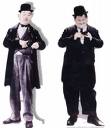
On Dec. 1, 1921 Jess Robbins' The Lucky Dog debuts, becoming the screen debut of the comedy team of Laurel and Hardy, consisting of thin ever-whimpering English-born Stan Laurel (Arthur Stanley Jefferson) (1890-1965) and fat ever-pompous Atlanta, Ga.-born Oliver "Ollie" "Babe" (Norvell) Hardy (1892-1957); in this first film they act separately.

On Dec. 29, 1921 D.W. Griffith's Orphans of the Storm debuts on the novels by Adolphe d'Ennery and Eugene Cormon about two orphan sisters in the French Rev., starring Lillian Gish and Dorothy Gish, becoming the breakthrough role for 6'3" Indianapolis, Ind.-born Monte Blue (Gerard Montgomery Bluefeather) (1887-1963) (half-French, half-Cherokee/Osage father) (who debuted as an extra in "The Birth of a Nation" in 1915) as plays Danton.


On Dec. 31, 1921 Henry King's Tol'able David (Inspiration Pictures) debuts, written by Edmund Goulding based on the story by Joseph Hergesheimer, starring Richard Barthelmess "tol'able" (not yet a man) David Kinemon, who takes his brother's place as mailman for a W. Va. mountain community and suffers the mean Hatburn brothers; Gladys Hulette plays his babe Esther Hatburn, Walter P. Lewis plays Iscah Haburn, Ralph Yearsley plays Saul "Little Buzzard" Hatburn, and Forrest Robinson plays Grandpa Hatburn; the film debut of Scottish-born Ernest Torrence (Torrance-Thomson) (1878-1933) as Luke Hatburn; refilmed as a talkie in 1930.
In 1921 Mary Pickford founds the Motion Picture Relief Fund for needy actors with funds left over from her war bond work, with Joseph Schenck (1878-1961) as pres. and her as vice-pres.; in 1932 she creates a payroll deduction program for studio workers (0.5%) which allows the fund to build the Motion Picture Country House and Hospital in 1940 (closes in 2009), which later houses Stanley Kramer and DeForest Kelley; in 1971 it becomes the Motion Picture Relief Fund.

On Jan. 11, 1922 Erich von Stroheim's Foolish Wives debuts, starring Stroheim as fake Count Wladislaw Sergius Karamzin, who tries to seduce Miss DuPont (Helen Hughes), wife of U.S. envoy to Monaco Andrew J. Hughes (Rudolph Christians) to get her money; billed by Universal Pictures as "the first real million dollar picture"; the uncredited debut of producer Irving Thalberg; too bad, the studio cuts the film down from 10 hours to 117 min.

On Jan. 14, 1922 after the Fatty Arbuckle scandal, U.S. postmaster gen. #46 (since ?, 1921) William Harrison "Will" Hays (1879-1954) (known for working with other Repubs. to wreck the League of Nations) resigns to become pres. of the new Motion Picture Producers and Distributors of Am., formed by the "Big Three" studios MGM, First National, and Famous Players-Lasky, taking office on Mar. 6 with a $100K/year salary, helping the film industry's six major Hollywood studios police themselves to forestall govt. censorship, but with no formal code.



On Feb. 1, 1922 Irish-born Hollywood movie dir. (head of Paramount subsidiary Famous Players-Lasky and dir. of the Screen Directors' Guild) William Desmond Taylor (William Cunningham Deane-Tanner) (b. 1872) (who vanished from his home in New York City on Oct. 23, 1908, leaving a wife and daughter, moving to Hollywood and changing his name) is murdered in his bungalow apt. on Alvarado St. in the Westlake district of Los Angeles, Calif., with his body discovered the next morning by his black servant Henry Peavey, laying on his back on the floor of his study, with his large lucky diamond ring still on his finger and two .38 bullets in his heart, causing him to run down the street crying "Dey've kilt Massa!"; he is later found out to have been carrying on simultaneous affairs with Mabel Normand (who rushed to the bungalow to search for love letters before the police got there, along with Famous Players-Lasky gen. mgr. Charles Eyton, and Paramount boss Adolph Zukor?), Mary Miles Minter (Juliet Reilly) (1902-84) and her manipulative actress mother Charlotte Shelby (1877-1957), and to have a cache of porno and locked closet full of women's underwear tagged with initials and dates, incl. one embroidered MMM, causing Minter's rep as a virgin to tank and her career to skid; it is also found out that he visited queer dens that served drugs, and that Normand spent $2K a mo. for cocaine, forcing her to retire; the case is never solved, but the lurid revelations of hanky-panky, drugs, and bisexuality spur the growing movement to clean up Hollywood, ending in the 1930 Code of Decency; gossip pins the murder on Shelby, ruining Minter's career, causing her to retire in 1923, after which she and her mother go to fat.

On Feb. 13, 1922 Sidney Franklin's Smilin' Through (First Nat. Pictures)) debuts, based on the 1919 Jane Cowl play and produced by Joseph M. Schenck, starring Norma Talmadge as Kathleen/Moonyeen in her biggest box-office smash; Harrison Ford (1884-1957) stars as Kenneth/Jeremiah Wayne, and Wyndham Standing plays John Carteret; the film debut of Canadian-born Edwin Eugene "Gene" Lockhart (1891-1957); does $1M box office; remade in 1932 and 1941 by MGM.

In Mar. 1922 Edward F. Cline's Cops (First Nat.) debuts, filmed during the Kafaka-esque rape-murder trial of his mentor Fatty Arbuckle, starring Buster Keaton, who flees hundreds LAPD cops in a Kafka-esque nightmare; the film ends with the title "The End" written on a tombstone with Keaton's pork pie hat propped on it; "A roar from the riot squad."

On May 28, 1922 Emile Chautard's The Glory of Clementina debuts, starring Pauline Frederick, George Cowl, Edward Martindel, Lincoln Plumer, Edward Hearn, Jean Calhoun, and Clarence Wilson, becoming the film debut of Evansville, Ind.-born Louise Dresser (Louise Josephine Kerlin) (1878-1965) (friend of Buster Keaton since his childhood days, and friend of songwriter Paul Dresser, whose name she adopts) as Lena Fontaine.

On July 11, 1922 the Hollywood Bowl (cap. 17,376) at 2301 N Highland Ave. S of the Hollywood Hills behind the famous Hollywood sign opens, with seating on wooden benches on the hillsides of Bolton Canyon, becoming the summer home of the Los Angeles Philharmonic; the debut performance is conducted by Alfred Hertz; in 1927 Frank Lloyd Wright builds a pyramidal shell to improve the acoustics, replacing it with a fiberglass shell in 1928.

On Aug. 5, 1922 Fred Niblo's Blood and Sand debuts, written by June Mathis based on the 1909 Vicente Blasco-Ibanez novel, starring "every woman's dream", "Latin Lover" "Dark Lover" Rudolph Valentino as illiterate Spanish peasant bullfighter Juan Gallardo, who cheats on his virtuous wife Carmen (Lila Lee) with seductive vamp widow Dona Sol (Nita Naldi); Rouben Mamoulian remakes it in sound and technicolor in 1941 starring Tyrone Power, Linda Darnell (wife), and Rita Hayworth (vamp); Naldi and Valentino co-star in two more films, "A Sainted Devil" (1924), "Cobra" (1925).




On Sept. 11, 1922 Rex Ingram's The Prisoner of Zenda debuts, based on the 1894 Anthony Hope novel and 1896 play by Hope and Edward Rose, starring Lewis Shepard Stone (1879-1953) and Alice Terry (1899-1987), who marries dir. Rex Ingram (Reginald Ingram Montgomery Hitchcock) (1892-1950) for the rest of his life.

On Sept. 14, 1922 Robert G. Vignola's When Knighthood Was in Flower (Paramount) (12 reels) debuts, based on the novel by Charles Major and play by Paul Kester, starring Marion Davies as Mary Tudor, Lyn Harding as Henry VIII, Teresa Maxwell-Conover as Queen Catherine, and Forrest Stanley as Charles Brandon; the $1.8M budget makes it the most expensive picture made to date; refilmed in 1953 as "The Sword and the Rose".

On Oct. 18, 1922 Allan Dwan's Robin Hood (Douglas Fairbanks Pictures) debuts, starring swashbuckler Douglas Fairbanks Sr. (1883-1939) as the Earl of Huntington, who fights to save good King Richard Lionheart's throne from the bad Sheriff of Nottingham; debuts on Oct. 18 at the Egyptian Theater in Los Angeles, Calif., becoming their first-ever silent film premiere; does $1M box office.
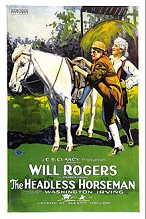
On Nov. 5, 1922 Edward D. Venturini's The Headless Horseman (Sleepy Hollow Corp.) debuts, produced by Carl Stearns Clancy, based on the 1820 Washington Irving story "The Legend of Sleepy Hollow" set in 1790, starring Will Rogers as Ichabod Crane, Lois Meredith as Katrina Van Tessel, and Ben Hendricks Jr. as Abraham Van Brunt AKA Brom Bones, becoming the first B&W panchromatic feature film; watch video.

On Nov. 10, 1922 Tom Forman's Shadows (Preferred Pictures Corp.) debuts, starring Walter Long as fisherman Daniel Gibbson, Harrison Ford as John Malden, Marguerite De La Motte as Sympathy Gibbs, and Lon Chaney Sr. as mysterious Chinaman Yen Sin.

On Nov. 19, 1922 E. Mason Hopper's Brothers Under the Skin (Goldwyn Pictures) debuts, starring Pat O'Malley, Helene Chadwick, Norman Kerry, and Claire Windsor, becoming the film debut (uncredited) of William "Billy" Haines (Charles William Haines) (1900-73), an open gay who in 1926 hooks up with James "Jimmie" Shields and becomes brothers under the skin, staying with him for life ("the happiest married couple in Hollywood" - Joan Crawford); with the studio covering for him, he becomes a top star from 1928-32; too bad, in 1933 he is arrested in a YMCA doing the wild thing with a sailor, causing Louis B. Mayer to give him an ultimatum to engage in a sham "lavender" marriage or be fired, and he chooses the latter, becoming a top interior designer with his gay bud Shields.


On Dec. 10, 1922 William A. Seiter's The Beautiful and the Damned (Warner Bros.) debuts, based on the 1922 F. Scott Fitzgerald novel, starring Kenneth Harlan (1895-1967) and Marie Prevost (Marie Bickford Dunn) (1898-1937), who marry on the set for publicity, which backfires when Prevost's secret first hubby Sonny Gerke materializes, causing Jack Warner to get the secret marriage annulled so that the marriage can go through in 1924; too bad, in 1926 their contract is not renewed, driving Prevost to alcoholism, and they separate in 1927; after he career spirals downward, compounded by obesity, she is finally found dead in her seedy apt. on Cahuega Blvd. on Jan. 23, 1937 of acute alcoholism, with her barking dachshund consuming body parts to survive; her estate is valued at $300, and a promissory note to Joan Crawford is found, causing the Hollywood community to create the Motion Picture Country House in San Fernando Valley, Calif. in 1942, followed by the Motion Picture House in 1948, later extended to TV stars.
In 1922 Charlie Chaplin (Chaplain?) (known in Hollywood for being well-endowed) auditions for a role as Jesus Christ, with the soundbyte: "I want to play the role of Jesus. I'm a logical choice. I look the part. I'm a Jew. And I'm a comedian... And I'm an atheist, so I'd be able to look at the character objectively."

In 1922 Am. actor John Barrymore (John Sidney "Jack" Blyth) (1882-1942), "the Great Profile" achieves stardom playing Hamlet in New York City this year and in England in 1925 before leaving the stage to return to Hollywood in 1926.

In 1922 the Wampas Baby Stars promotional campaign is founded by the Western Assoc. of Motion Picture Advertisers (until 1934, except 1930 and 1933), honoring 13 hot new starlets at the Wampas Frolic each year (15 in 1932); 150 stars are eventually honored, some who get hot and most not, incl. Bessie Love (1898-1986) (1922), Jacqueline Medura Logan (1904-83) (1922), Evelyn Brent (1899-1975) (1923), Jobyna Ralston (1899-1967) (1923), Clara Bow (1905-65) (1924), Janet Gaynor (1906-84) (1926), June Collyer (1906-68) (1928), Jean Arthur (1900-91) (1929), Loretta Young (1913-2000) (1929), Joan Blondell (1906-79) (1931), Eleanor Holm (1913-2004) (1932), Gloria Stuart (1910-2010) (1932), Marian Shockley (1911-81) (1932), Ginger Rogers (1911-95) (1932), and Judith Arlen (Laurette Rutherford) (1914-68) (1934).

In 1922 Hal Roach's Our Gang debuts, a series showing cute children sans acting lessons or racism; it converts to sound in Apr. 1929; in 1938 it is acquired by MGM, which ends production in 1944 after 220 shorts featuring 41 child actors; in 1955 the 80 talkie versions are syndicated for TV under the title "The Little Rascals"; early stars incl. Ernie "Sunshine Sammy" Morrison, Allen "Farina" Hoskins, Jackie Condon, Mickey Daniels, Joe Cobb, and Pete the Pup, a pit bull terrier with a ring around his eye; in 1929 new actors are added incl. Jackie Cooper, Norman "Chubby" Chaney, Dorothy DeBorba, Matthew "Stymie" Beard, and Donald Haines; June Marlowe plays teacher Miss Crabtree; in 1931 George "Spanky" McFarland joins, becoming the top star; in 1935 Carl "Alfalfa" Switzer and his brother Harold Switzer join, along with Darla Hood and Eugene "Porky" Lee; in 1939 Robert Blake (Mickey Gubitosi), Janet Burston, and Bill "Froggy" Laughlin join; by May 2014 only Robert Blake, Sidney Kibrick, Jean Darling, Marianne Edwards, Dickie Moore, Jerry Tucker, Lassie Lou Ahern, Mildred Kornman, and Leonard Landy are still living.
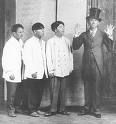
In 1922 Am. vaudeville performer Ted Healy (1896-1937) (real name Clarence Ernst Nash) hires old friend Moe Howard (Horwitz) (1897-1975) for his act as a stooge (a shill pretending to be an audience member who comes onstage, with Healy as the straight man), and next year hires Moe's older brother Shemp Howard (Horwitz) (1895-1955), then Larry Fine (Louis Feinberg) (1902-75) in 1925, and Moe's younger brother Jerome "Curly" Howard (Horwitz) (1903-52) in 1932, forming the act later known as the Three Stooges (all Jewish, nyuk nyuk). In 1934 The Three Stooges begin performing in a series of 190 immortal shorts for Columbia Pictures with Archie Gottler's Woman Haters; too bad, they are played for real stooges in their stingy contract that gives them no residuals; they also make 25 long films; Moe Howard (Moses Horwitz) (1897-1975) and Larry Fine (Louis Feinberg) (1911-74) star in all 215 of them, "Nyuk nyuk nyuk", "Woo woo woo", "Why, soitenly" Curly Howard (Jerome Lester Horwitz) (1903-52) in 118, Shemp Howard (Samuel Horwitz) (1895-1955) in 79, Joe Besser (1907-88) in 15, and Curly-Joe DeRita (1909-93) in 13; after Curley suffers the one of a series of strokes on May 6, 1946, short #100 Hold That Lion, released July 17, 1947 is the only one featuring Curly, Moe, and Shemp.

In 1922 Alfred Hitchcock's Number 13 (Mrs. Peabody) is the dir. debut of London-born Alfred Joseph Hitchcock (1899-1980); too bad, the budget falls through, and it is never finished; Hitchcock goes on to direct 50+ films over six decades, becoming the #1 film director of all time?; he becomes known for cameo appearances in his own films, innovative movement of the camera, innovative editing, icy blonde female chars., twist endings, and Freudian sexual overtones, becoming known as "the Master of Suspense".


In 1922 Chelsea, Mass.-born Herbert Thomas Kalmus (1881-1963) develops Technicolor, the first commercially successful color process for motion pictures; he names it in tribute to his alma mater MIT; in 1934-49 ex-wife (1902-22) Natalie Kalmus (1882-1965) appears as "color supervisor" on virtually every Technicolor film, becoming unpopular on sets for trying to make them make colors more bland while they're unable to fire her.
On Jan. 18, 1923 Am. silent film actor-dir. Wallace Reid (b. 1891) dies in a padded cell, addicted to morphine, causing his widow Florence to blame it on his "Bohemian friends", announcing her next film "Human Wreckage" (secretly backed by Will Hayes) to warn of the dangers of drug addiction, further stinking Hollyweird's image up.

In Feb. 1923 Rex Ingram's Scaramouche debuts, based on the 1921 novel by Rafael Sabatini, starring Rudolph Valentino's Mexican-born rival for the title of Latin Lover Ramon Novarro (Jose Ramon Gil Samaniego (1899-1968) as Andre-Louis Moreau, a fugitive during the French Rev. who hides out in a commedia dell'arte troupe while romancing Aline de Kercadiou (Alice Terry); does $1M box office, making Novarro a star - can you dance the fandango?

On Mar. 16, 1923 James Cruze's The Covered Wagon (Parmount) debuts, based on the novel by Emerson Hough about pioneers traveling from Kan. to Ore. and battling the elements and pesky Injuns, starring J. Warren Kerrigan as Will Banion, and Lois Wilson as his wife Molly; Alan Hale Sr. plays the villain Sam Woodhull; Ernest Torrence plays William Jackson; Ethel Wales plays Mrs. Wingate; "From now on whenever the audience sees me they'll look around for a covered wagon" (Wilson); does $3.5M box office on a $782K budget; the first epic film not dir. by D.W. Griffith?; "The cowards never started. The weak died on the way."
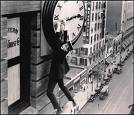
On Apr. 1, 1923 Hal Roach's Safety Last! debuts, starring Harold Lloyd, who hangs from skyscrapers and clock hands above moving traffic.

On May 21, 1923 D.W. Griffith's The White Rose (United Artists) debuts, starring Mae Marsh, Carol Dempster, Lucille La Verne, and Ivor Novello, becoming the breakthrough role for Neil Hamilton as John White.

On Aug. 19, 1923 J. Gordon Edwards' The Silent Command debuts, based on a story by Rufus King, becoming the film debut of Edmund Lowe (1890-1971) as Capt. Decatur.

On Sept. 2, 1923 Fred C. Newmeyer's Why Worry? debuts, starring Harold Lloyd as rich hypochondriac businessman Harold Van Pelham, who sails to the tropics for his health, and is the film debut of Mary Pickford clone Jobyna Ralston (1899-1967) as his nurse, who goes on to star with him in six more films.


On Sept. 5, 1923 Henry King's The White Sister (Metro Pictures) debuts, based on the 1909 novel by Francis Marion Crawford stars Lillian Gish as Angela Chiaromonte, making a star of English actor Ronald Charles Colman (1891-1958) as Capt. Giovanni Severini, who goes on to thrive in the talkie era with his cool cultured voice.

On Sept. 22, 1923 Wallace Worsley's The Hunchback of Notre Dame (Universal Pictures) debuts, based on the 1831 Victor Hugo novel, starring Patsy Ruth Miller as Esmeralda, Norman Kerry as Capt. Phoebus, Winifred Byrson as Fleur de Lys, Nigel De Brulier as Claude Frollo, Tully Marshall as Louis XI, and Ernest Torrence as King of the Beggars Clopin Trouillefou, making a star of "Man of a Thousand Faces" Leonidas Frank "Lon" Chaney Sr. (1883-1930) as Quasimodo; launches Universal's School of Horror; does $3M box office on a $1.25M budget; watch film; view video.

On Sept. 26, 1923 Charlie Chaplin's A Woman of Paris: A Drama of Fate debuts, starring Edna Purviance as Marie St. Clair, and Carl Miller as her beau Jean Millet, who stands her up at a railway station and later after reconciling kills himself; Adolphe Menjou plays her well-dressed in-between lover Pierre Revel, causing him to be voted Best Dressed Man in America 9x; "What ever happened to Marie St. Clair?"; the only film dir. by Chaplin in which he doesn't act.
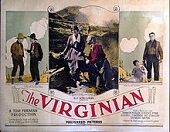
On Sept. 30, 1923 Tom Forman's The Virginian (B.P. Schulberg) (Preferred Pictures) debuts, based on the 1902 Owen Wister novel and the 1904 play, starring Kenneth Harlan as the Virginian, and Russell Simpson as Trampas; in 1929 it is refilmed as a talkie starring Gary Cooper and Walter Huston.
On Oct. 16, 1923 after his Laugh-O-Gram venture in Kansas City, Mo. ends in bankruptcy, Chicago Academy of Fine Arts grad. (former Red Cross Model T ambulance driver in WWI) Walter Elias "Walt" Disney (1901-66) founds Disney Bros. Cartoon Studios in Hollywood, Calif. with his brother Roy O. Disney; his first major contract, Alice in Cartoonland, combines a living actress with animated cartoon figures, becoming the first of the "Alice Comedies" (ends 1927); in Jan. 1926 the name is changed to Walt Disney Studio.

On Nov. 23, 1923 Cecil B. De Mille's The Ten Commandments (Paramount) debuts, written by Jeanie MacPherson and filmed in 2-strip Technicolor in the freezing Guadalupe-Nipomo Dunes on the coast of C Calif., starring Theodore Roberts as Moses, and Charles de Rochefort as Rameses the Magnificent, and featuring the parting of the Red Sea; the expensive set is lost to the sand until 2014, when the 15-ft. sphinx is rediscovered; first of a Bible trilogy incl. "The King of Kings" (1927), "The Sign of the Cross" (1932); does $4.2M box office on a $1.5M budget, launching the Hollywood Biblical Epic genre.

On Nov. 25, 1923 John Griffith Wray's Anna Christie (First Nat. Pictures) debuts, the first film version of the 1921 Eugene O'Neill play, starring Blanche Sweet as ex-ho Anna Christie, who struggles to turn her life around with beau Matt Burke (William Russell).

On Nov. 29, 1923 emerging silent screen superstar Martha Mansfield (nee Ehrlich) (b. 1899) leaves the set of the big budget film "The Warrens of Virginia" in San Antonio, Tex. and sits in a car, after which a match ignites her U.S. Civil War costume, burning her to death; her leading man Wilfred Lytell saves her face and neck by throwing his overcoat over her; her chauffeur suffers serious burns to his hands while trying to remove her burning clothes; she dies on Nov. 30; she is edited down from the film to promote Rosemary Hill as the female lead.

In 1923 Polish femme fatale vamp actress Pola Negri (1894-1987) moves to Hollywood, going on to please audiences with her exotic style while privately pleasuring Charles Chaplin, Rudolph Valentino and other actors, getting rich and living in a palace in Los Angeles modelled after the White House; too bad, the advent of talkies exposes her thick Polish accent, and the 1934 Hays Code bans her main moves of "scenes of passion" and "excessive and lustful kissing", killing her career; "They went from Pola to Polaroid" (Negri).
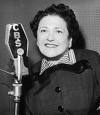
In 1923 Freeport, Ill.-born Jewish journalist Louella "Lolly" Parsons (Louella Rose Oettinger) (1881-72) begins writing a movie gossip column for the Hearst newspapers (until 1964), becoming #1 until Hedda Hopper goes into the gossip biz in 1937.

In 1923 the town of Lankershim, Calif. changes its name to North Hollywood; the $21K 45-ft.-tall 350-ft.-long all-caps Hollywoodland Sign on Mt. Lee overlooking Los Angeles, Calif. is built to promote real estate development in Beachwood Canyon, with letters 45 ft. tall and 30 ft. wide, lighted by 4K light bulbs; in 1949 the Hollywood Chamber of Commerce has the sign rebuilt with the last four letters and lightbulbs removed; it is restored in 1978.

On Mar. 9, 1924 Spencer Gordon Bennet's The Atonement of Gosta Berling (Gosta Berlings Saga) debuts, based on the novel by Selma Lagerlof about alcoholic ex-priest Berling (Lars Hanson) falling for married Countess Elizabeth Dolina, played by Swedish actress Greta Garbo (Gustaffson) (1905-90), giving her enough success to be invited to the U.S. On May 18, 1925 G.W. Pabst's The Joyless Street (Die Freudlosse Gasse) debuts, starring Greta Garbo in her first major role in dismal middle-class Austria during the economic crisis, emoting to a lovely piano score; produced by Mikhail Salkind.



On Mar. 18, 1924 Raoul Walsh's The Thief of Bagdad: An Arabian Nights Fantasy debuts, the ultimate SFX thrill ride of the decade, based on "The 1001 Arabian Nights", starring shirtless hunk Douglas Fairbanks Sr. as Ahmed the Thief, who is smitten with beautiful princess Julianne Johnston, and takes on Mongol Prince Cham Shang of Ho Sho and his slave Anna May Wong, the Valley of Fire, the Valley of the Monsters, the Cavern of the Enchanted Trees, the Old Man of the Midnight Sea, and the Abode of the Winged Horse; set designed by William Cameron Menzies; does $1.5M on a $1.14M budget; future British Lt. Col. "Mad Jack" Churchill (1906-96) has a small role using his bow and arrow and playing his bagpipe, going on to go into battle in WWII with a longbow and sword; "What I want I take, my reward is here, Paradise is a fool's dream and Allah is a myth."
On Apr. 17, 1924 Metro-Goldwyn-Mayer (MGM) Studios) is founded by Marcus Loew from a merger of Metro Pictures, Goldwyn Pictures, and Louis B. Mayer Pictures.
On July 15, 1924 Bruce M. Mitchell's The Hellion (Sunset Productions) debuts, starring Marin Sais, featuring Boris Karloff as the Outlaw.


On July 31, 1924 George A. Cooper's The Eleventh Commandment debuts, based on the Brandon Fleming play, starring Fay Compton, Stewart Rome, and Lillian Hall-Davis, becoming the film debut of English stage actor Brian Aherne (William Brian de Lacy Aherne) (1902-86) (as Norman Barchester), who goes on to become a leading man in Hollywood in the 1930s-1950s, marrying Joan Fontaine in 1939-45.

On Nov. 9, 1924 Victor Sjostrom's He Who Gets Slapped, debuts, based on a 1914 play by Leonid Andreyev about a scientist whose discoveries are stolen, causing him to end up in a circus is the first produced by MGM, starring new moustached romantic leading man John Gilbert (1895-1936), "the Great Lover of the Silent Screen" as circus daredevil rider Bezano; co-stars Lon Chaney Sr, and Norma Shearer as scientist-turned-clown Paul Beaumont (who gets slapped in his act) and bareback rider Consuelo; Gilbert later has a sizzling romance with Greta Garbo and becomes a case of talkie transition failure.


On Nov. 16, 1924 (his birthday) Newport, R.I.-born "Civilization" filmmaker (inventor of the detailed shooting script and the assembly line system of filmmaking, founding Inceville in Palisades Highlands) Thomas Harper Ince (b. 1880) takes sick mysteriously aboard Oneida, the yacht of newspaper magnate William Randolph Hearst (1863-1951) among a bevy of Hollywood stars, then dies three days later at his home in Beverly Hills, Calif., after which Hearst takes great pains to cover up the facts (that he might have shot him and/or that he died on the ship?); in 1996 Patty Hearst pub. a novel about it titled "Murder at San Simeon"; subject of the 2001 film "The Cat's Meow".

On Nov. 24, 1924 after making her pregnant, 35-y.-o. Charlie Chaplin marries 16-y.-o. Lita Grey (Lillita "Lolita" McMurray) (1908-95) (2nd wife) in a highly-publicized event in Empalme, Sonora, Mexico where they run from reporters; they first met at Kitty's Come-On Inn in 1915 where her scheming mother Nana McMurray worked as a waitress, and he kept his eye on her as she grew up, watching her role as an angel in "The Kid", then getting her a role as a dance hall girl in The Gold Rush, putting her name on Edna Purviance's dressing room door and filming tons of unusable scenes because she can't act or take direction; her stage name comes from a grey angora cat Charlie gave her; after the marriage Nana moves in along with the whole McMurray clan; they have son Charles Chaplin Jr. on June 28, 1925, and 2nd son Sydney Earle Chaplin on Mar. 30, 1926; on Dec. 1, 1926 (night) Charlie returns home to find a drunken circus, kicking the whole McMurray clan out, and Lita files for divorce on Jan. 10, 1927, demanding $1M, causing a bitter court battle that turns Charlie's hair white, featuring salacious newspaper accounts of him demanding fellatio, saying "all married people do it" that paint him as a pervert and her as a saint; to prevent the names of five actresses he allegedly hooked up with (incl. Marion Davies) from being revealed, he settles out of court, and on Aug. 22, 1927 Lita is awarded $625K, after which Chaplin returns to work on "The Circus", which had been interrupted for a year, dying his hair black.

On Dec. 4, 1924 Erich von Stroheim's Greed debuts, based on the 1899 Frank Norris novel "McTeague", starring Gibson Gowland as San Francisco dentist Dr. John McTeague, and comedy actress ZaSu Pitts in her first major tragic role as McTeague's wife Trina Sieppe, who wins $5K in a lottery and won't spend it even when they live in poverty, turning him into an alcoholic then a murderer who flees to Death Valley (filmed on location), and Jean Hersholt as McTeague's frienemy Marcus Schouler; earns kudos from critics but flops at the box office after the 8-hour flick is cut down to 2.5 hours on the orders of MGM boss Irving Thalberg, losing the rest; does $275K box office on a $666K budget; greatest film ever made?

On Dec. 29, 1924 Herbert Brenon's Peter Pan (Famous Players-Lasky) debuts, the first film adaptation of the J.M. Barrie play, starring Elizabeth Ada "Betty" Bronson (1906-71), who wins the role over Gloria Swanson and Mary Pickford because of her ballet training and because Barrie personally picks her for her glorious swan song but doesn't want to marry her, then fades quick as a movie star; also stars Ernest Torrence as Captain Hook, Mary Brian as Wendy, and Virginia Browne Faire as Tinker Bell; Anna May Wong play Indian princess Tiger Lily.





In 1924 European-born Jewish immigrants Louis Burt Mayer (1884-1957), Marcus Loew (1870-1927) and Samuel Goldwyn (Goldfish) (Szmuel Gelbfisz) (1879-1974) found Metro Goldwyn Mayer (MGM) Pictures to produce motion pictures, becoming known as Hollywood's greatest studio, where "The Wizard of Oz" (1939) is shot on Lot 15; in 1986 it is sold to Columbia Pictures; in 1928 its logo becomes Leo the Lion (1919-36),, who is buried in Gillette, N.J. CBS Film Sales, named after founders Cohn-Brandt-Cohn is renamed to Columbia Pictures; the company icon "Our Lady of Columbia" debuts clad in a flag and holding a torch; the flag is changed to a cape in 1941.



In 1924 MCA (Music Corp. of America) is founded by Jules C. Stein (1896-1981) et al. as a music booking agency in Chicago, Ill., going on to book big bands incl. King Oliver and Jelly Roll Morton, and becoming the world's largest talent agency by the late 1930s, moving to Beverly Hills in 1939 and gaining the nickname "The Octopus", triggering endless monopoly investigations by the U.S. Dept. of Justice; in 1936 Lewis Robert "Lew" Wasserman (1913-2002) joins it, rising to head in 1948 and becoming famous for taking down the Hollywood studio system, causing him to be known as the Pope of Hollywood.

On Feb. 16, 1925 Edward F. Cline's The Rag Man (MGM) debuts, written by Willard Mack, starring Jackie Coogan as runaway orphan Tim Kelly, Max Davison as junk man Max Ginsberg, and Lydia Yeamans Titus as Mrs. Malloy; Robert Edeson and Ethel Wales play Mr. and Mrs. Bernard.




On Mar. 30, 1925 Paul Bern's The Dressmaker from Paris (Paramount) debuts, a romantic comedy written by Howard Hawks and Adelaide Heilbron starring Leatrice Joy, Ernest Torrence, Allan Forrest, Lawrence Gray, and Mildred Harris, becoming the film debut of jet-black-hair Olive Borden (1906-47) (distant relative of Lizzie Borden) as an uncredited mannequin, who is named a Wampas Baby Star this year along with cousin Natalie Joyce (1902-92), and is signed by Fox, earning $1.5K a week and becoming known as "the Joy Girl", starring with 11 films for them, co-starring in two of them with boyfriend George O'Brien until Fox cuts her salary in 1927, causing her to walk out, after which her career slides, and she ends up in skid row in Los Angeles; the first film for costume designer Travis Banton (1894-1958) (who got his break when Mary Pickford picked one of his dresses for her wedding to Douglas Fairbanks Sr.), who goes on to become the chief designer at Paramount until his asst. Edith Head (Edith Claire Posener) (1897-1981) gets him fired (forced resignation) for alcoholism in 1938 and takes his place, going on to win a record eight Oscars after the new category of costume designer is created in 1948; in 1967 she leaves Paramount after 43 years, working with Alfred Hitchcock and TV studios.
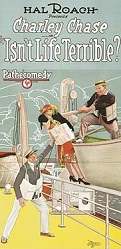

On July 15, 1925 Leo McCarey's Isn't Life Terrible? (Pathe) debuts, starring Charley Chase, Oliver Hardy, and Fay Wray, featuring an outdoor staircase in Silver Lake, Los Angeles, Calif., becoming the dir. debut of Thomas Leo McCarey (1898-1959), who teams Stan Laurel with Oliver Hardy at Hal Roach Studio, and creates Cary Grant's onscreen persona based on his own mannerisms and physical resemblance, latter going into Roman Catholic-oriented films incl. "Going My Way" (1944), and "The Bells of St. Mary's" (1945); "I only know I like my characters to walk in clouds, I like a little bit of the fairy tale. As long as I'm there behind the camera lens, I'll let somebody else photograph the ugliness of the world."

On Aug. 2, 1925 D.W. Griffith's Sally of the Sawdust (Paramount/United Artists) debuts, based on the 1923 musical "Poppy" by Dorothy Donnelly, starring Carol Dempster as Sally, who marries a circus performer, causing her wealthy father Judge Foster (Erville Alderson) to disown her; W.C. Fields plays her friend Prof. Eustace McGargle; Alfred Lunt plays her beau Peyton Lennox.

On Aug. 15, 1925 Edward Ludwig's So Long Bill debuts, starring newlyweds Billy West and Ethelyn Gibson, becoming the film debut of Granville G. "Grant" Withers (1905-59), who systematically gets downgraded from leading man to B-movies to TV char. actor until he commits suicide.

On Aug. 26, 1925 Erich von Stroheim's The Merry Widow debuts, starring Robert Z. Leonard's wife (1918-25) Mae Murray (Marie Adrienne Koenig) (1889-1965) in her best role as dancer Sally O'Hara, who falls in love with Prince Danilo of Monteblanco, but whose daddy Nikita I forbids him to marry; too bad, her career falls flat with the arrival of talkies, after which she continues her star act, attending parties and insisting that the dance floor be cleared so that she can waltz solo to the you know what theme, driving a canary yellow Pierce-Arrow and white Rolls-Royce with borzoi until her money runs out.

On Sept. 4, 1925 James Cruze's Pony Express debuts, starring Betty Compson, Ricardo Cortez, and Wallace Beery, becoming the first starring role for George Bancroft (1882-1956), who works his way up to the top by the end of the decade then begins a long slide in the 1930s.

On Sept. 6, 1925 Rupert Julian's The Phantom of the Opera (Universal Pictures) debuts at the Astor Theater in New York, based on the 1910 Gaston Leroux novel, starring Lon Chaney Sr. (whose self-devised makeup is kept a secret until the premiere) as mad disfigured opera lover Erik, who lives in the sewers of Paris to haunt the Paris Opera House and kills to further the career of I-just-want-your-extra-time-and-your-kiss soprano Christine Daae (Mary Philbin), featuring a 2-color "Bal Masque" sequence; does $2M box office; the set becomes the first built with steel girders set in concrete, and is not dismantled until 2014, by which time it is part of Universal Studios Sound Stage 28.

On Oct. 11, 1925 Edward Sedgwick's Lorraine of the Lions debuts, written by Isadore Bernstein, starring Patsy Ruth Miller, becoming the film debut of Lynn, Mass.-born Walter Andrew Brennan (1894-1974), who goes on to win a record three acting Oscars (best supporting actor in 1936, 1938, and 1940).

On Nov. 5, 1925 King Vidor's The Big Parade (Vidor's masterpiece) debuts, written by Harry Behn based on the 1924 Laurence Stallings novel "Plumes" about the U.S. Army WWI Rainbow Div. in France, starring John Gilbert and Renee Adoree as lovers James Apperson and Melisande, who are torn apart by WWI, becoming the #2 highest grossing silent film, and highest grossing MGM film until "Gone With the Wind" in 1939; does $6M box office on a $382K budget.

On Nov. 30, 1925 Joseph Henabery's Cobra debuts, based on the 1924 play by Martin Brown, starring Rudolph Valentino as Italian Count Rodrigo Torriani, who has a weakness for cobras (women), incl. Elise (Nita Naldi) and Mary Drake (Gertrude Olmstead); he takes to driving a custom-built Voisin touring car with coiled-cobra radiator cap.
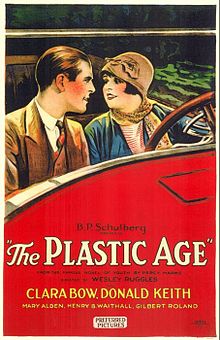

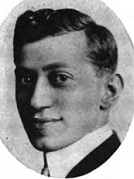
On Dec. 15, 1925 Wesley Ruggles' The Plastic Age (Preferred Pictures) debuts, based on the 1924 Percy Marks novel, starring Brooklyn, N.Y.-born Clara Gordon Bow (1905-65) as Cynthia Day, Donald Keith as Hugh Carver, and Gilbert Roland as Carl Peters at fast-living (smoking, drinking, petting) Sanford College, becoming Bow's film debut and first hit, launching her career; causes Paramount Pictures CEO Adolph Zukor to propose to Preferred Pictures founder (1919) B.P. (Benjamin Percival) Schulberg (1892-1957) a merger to get her talent, which is done on Nov. 25, with Schulberg given a job as assoc. producer with control over Bow.
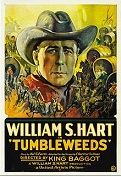
On Dec. 27, 1925 King Baggot's Tumbleweeds (United Artists) debuts, produced by and starring William S. Hart as drifter (tumbleweed) Don Carver, depicting the 1893 Okla. Cherokee Strip Land Rush, influencing the 1931 film "Cimarron"; co-stars Barbara Bedford as Carver's babe Molly Lassiter.

On Dec. 30, 1925 Fred Niblo's Ben-Hur: A Tale of the Christ debuts, based on the 1880 Lew Wallace novel, starring Ramon Novarro in revealing costumes along with "a cast of 125,000"; it costs an outrageous $4M to make, eaturing an exciting chariot race, and is a box office hit, doing $10.7M box office, but loses $698K while helping make MGM a major studio; Francis X. Bushman plays Messala; William Wyler is an asst. dir., and remakes it in 1959 starring Charlton Heston, refilming the chariot race shot-for-shot; "The picture every Christian ought to see."

In 1925 French astronomer Henri Chretien (Chrétien) (1879-1956) invents the CinemaScope process for creating widescreen films using special Hypergonar anamorphic lenses, which is adapted by 20th Cent. Fox in 1952.
In 1925 the Motion Picture Theatre Owners of Am. and the Independent Producers' Assoc. declare war on the "Big Three" film trust of MGM, Paramount, and First National.

On Jan. 15, 1926 Millard Webb's The Sea Beast (Warner Bros.) debuts, a twist on the 1851 Herman Melville novel, starring John Barrymore as Capt. Ahab, and George O'Hara as his half-brother Derek, who pushes him overboard while facing Moby Dick, causing him to lose his leg and his babe, becoming the breakthrough role for Dolores Costello (1903-79), "the Goddess of the Silver Screen" (1926 Wampas Baby Star) as minister's daughter Esther Wiscasset; after teaming again with Barrymore in "When a Man Loves" (1927), she marries him in 1928, overcoming a lisp to survive the talkies, only to retire in 1931 to devote time to her family, then divorcing over his alcoholism in 1935; too bad, early film makeup ruins her complexion, hampering her comeback in 1936, and she retires after appearing in Michael Curtiz' "This is the Army" (1943).

On Jan. 31, 1926 Frank Tuttle's The American Venus debuts, starring blonde babe Esther Ralston (1902-94) as Mary Gray, gaining her star status; too bad, she rejects the casting couch advances of Louis B. Mayer in 1932, and is farmed out to B-movies.

On Feb. 7, 1926 Howard Hawks' The Road to Glory (Fox) debuts, becoming the major film debut of dir. Howard Winchester Hawks (1896-1977), who was born to a wealthy paper mill family in Ind.

On Feb. 8, 1926 Ricardo Cortez's Torrent (MGM) debuts, based on a novel by Vicente Blasco-Ibanez, becoming Greta Garbo's first U.S. film as Leonora Moreno ("La Brunna").

On Feb. 14, 1926 Marshall Neilan's The Skyrocket debuts, written by Benjamin Glazer based on the 1925 novel by Adel Rogers St. Johns, becoming the film debut of Berkley, Va.-born Peggy Hopkins Joyce (Marguerite "Peggy" Upton) (1893-1957) as ex-Ziegfeld Follies showgirl Sharon Kimm in a parody of her notorious career of marrying millionaires and getting big bucks out of them; too bad, it flops, and she only appears in one more film, "International House" (1933), and goes on to have six hubbies and acquire the Portuguese Diamond along with tons of bling before dying on June 12, 1957 of no-surprise throat cancer; "True love was a heavy diamond bracelet, preferably one that arrived with its price tag intact."
On Mar. 14, 1926 Edward F. Cline's Spanking Breezes (The Peace Boat) (Mack Sennett) debuts, starring Alice Day as Alice Grimes, Danny O'Shea as her hubby, and Roger Moore as her brother Joe Young.

On Mar. 19, 1926 Frank Tuttle's Love 'Em and Leave 'Em debuts, Evelyn Brent and Lawrence Gray, but Louise Brooks (1906-85) makes her movie debut and steals the show with the Black Bottom shimmy dance, and her bob hairdo becomes a craze; too bad, sexually-liberated Brooks ends up ruining her career by quitting Paramount in 1928 to go to Germany to make experimental films with G.W. Pabst after they try to strongarm her with the new talkies into a ripoff contract, and when she returns she ends up blacklisted in Hollywood, but later gets even as her image of queen of the silent era is cemented?

On May 2, 1926 Jack Conway's Brown of Harvard (MGM) debuts, based on the play by Rida Johnson Young, starring William Haines as Harvard U. student Tom Brown, who vies with shy studious Bob McAndrew (Ralph Bushman) for the love of beautiful professor's daughter Mary Abbott (Mary Brian); Jack Pickford plays Tom's gay, er, roommate Jim Doolittle.

On Aug. 6, 1926 Alan Crosland's Don Juan (Warner Bros.) debuts, starring John Barrymore doing his own er, sword fighting in the 16th cent., kissing a record 191 women onscreen, becoming the first movie to use Warner Brothers' Vitaphone sound-on-disc movie system; does $1.26M box office on a $790K budget; co-star Mary Astor hooks up with him offscreen.

On Aug. 23, 1926 Italian-Am. "The Sheik" film star ("the Latin Lover") Rudolph Valentino (Rodolfo Alfonzo Raffaelo Pierre Filibert Guglielmi d'Antonguolla di Valentina) (b. 1895) painfully dies in New York City of septicemia from a perforated ulcer after finishing the film "The Son of the Sheik"; he dies broke after lavish movie-star style spending and failed marriages to butch dyke lesbians Jean Acker and Natacha Rambova, lovers of Alla Nazimova; a July 18 Chicago Tribune article ridiculing him for putting pink powder on his face causes him to utter the soundbyte: "And now do I act like a pink powder puff?"; 100K line up trying to see his candlelit body at Campbell's Funeral Home in New York City, flanked by phony Fascist Black Shirt guards and a phony wreath reading "From Benito"; actress Pola Negri makes a big scene, claiming they were about to marry, paying for a large floral arrangement for his coffin which spells out her name, then following his train from New York City to Los Angeles, posing for photographers at every chance in a chic black mourning dress, causing Tallulah Bankhead to diss her as a publicity hound - the good die young, the bad are Polaroided?

On Sept. 19, 1926 Buster Keaton's Battling Butler (MGM) debuts, based on the 1923 Ballard MacDonald play, starring Keaton as Alfred, whose father sends him to the mountains to make a man of him, where he meets mountain girl Sally O'Neill and masquerades as a boxer to win her; Francis McDonald is his stunt double.

On Sept. 28, 1926 J.P. McGowan's Crossed Signals (Morris R. Schlank Productions) debuts, written by George Saxton, starring Helen Holmes as Middletown railway station mgr. Helen Wainwright, who is framed by counterfeiting gang member George Harvey (William Lowery), giving work to federal agent Jack McDermott (Henry Victor) and his partner Overland Ike (Georgie Chapman).

On Oct. 10, 1926 Fred Niblo's The Temptress debuts, starring Greta Garbo as a gorgeous mankiller, whose victims incl. Antonio Moreno, Lionel Barrymore, and Roy D'Arcy.

On Oct. 14, 1926 Henry King's The Winning of Barbara Worth debuts, based on the novel by Harold Bell Wright, becoming the official film debut of Helena, Mont.-born stoic understated Gary (Frank James) Cooper (1901-61) as Abe Lee, an engineer building an irrigation system for a SW Am. desert community while vying for the affections of rancher's daughter Vilma Banky (Barbara Lee) with cowboy Willard Holmes (Ronald Colman).
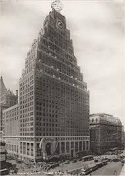
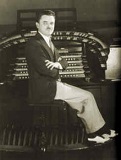
On Nov. 19, 1926 the Paramount Theatre (cap. 3,664) at 1501 Broadway in Manhattan, N.Y. in the Times Square district opens as the HQ of Paramount Pictures, with founder Adolph Zukor maintaining his office there until 1976; the opening features the stage show "God Gave Me 20 Cents", featuring Mayor Jimmy Walker and Thomas Edison; the theater houses a large Wurlitzer organ for silent films, featuring organist ("Poet of the Organ") Jesse Crawford (1895-1962) until 1933.


On Nov. 23, 1926 Raoul Walsh's What Price Glory debuts, based on the 1924 play by Maxwell Anderson and Laurence Stallings, starring Edmund Dantes Lowe (1890-1971) as WWI Sgt. Quirt, and Victor McLaglen as Capt. Flagg, who vie for the affections of French babe Charmaine de la Cognac, played by Mexican actress Dolores del Rio (María de los Dolores Asúnsolo López-Negrete) (1905-83), who becomes the first internat. female Latin-Am. star; remade in 1952 starring James Cagney.

On Dec. 1, 1926 Michael Curtiz' The Third Degree (Warner Bros.) debuts, based on the 1909 play by Charles Klein, starring Dolores Costello, Louise Dresser, Rockliffe Fellowes, and Jason Robards Sr., becoming the first U.S. film of Hungarian dir. Michael Curtiz (Kertesz Kaminer Mano) (1886-1962) after 50+ films in Europe, going on to direct 100+ in the U.S.

On Dec. 25, 1926 Clarence Brown's Flesh and the Devil debuts, based on Hermann Sudermann's 1894 novel"The Undying Past", starring John Gilbert and Lars Hanson as two childhood friends in Germany who grow up to be soldiers, after which Leo von Harden (Gilbert) falls for Felicitas (Greta Garbo), wife of a powerful count, causing him to kill him in a duel and get sent to Africa for three years, during which time Ulrich von Eltz (Lars) marries Felicitas, so that when he returns he's torn between the you know what and the you know what; Gilbert and Garbo begin a legendary offscreen affair, but she jilts him at the altar; even worse, on Sept. 8 Gilbert allegedly flies off the handle and attacks King Vidor at his wedding, causing his career to become shaky; does $1.261M box office on a $372.6K budget.

On Dec. 31, 1926 Buster Keaton's The General debuts, based on "The Great Locomotive Chase" by William Pittenger, starring Keaton as train engineer Johnnie Gray, who sets out to win the Civil War all by himself in order to woo his babe Annabelle Lee (Marion Mack); does $1M box office on a $750K budget.
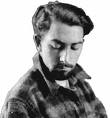

In 1926 Jewish-Am. caricaturist Al Hirschfeld (1903-2003) has his first caricature (of Sacha Guitry) pub. by the New York Herald Tribune, switching to the New York Times in 1928 starting with Harry Lauder, going on to crank out caricatures of Broadway and Hollywood stars until it becomes a sought-after status symbol; after his daughter Nina is born in 1945, he hides her name in every caricature, causing pilot candidates to be screened by the DOD by having to find it in 20 sec.

In 1926 the Brown Derby restaurant at 3427 Wilshire Blvd. in Los Angeles, Calif. across the street from the Ambassador Hotel opens, founded by Wilson Mizner and Herbert K. Somborn, with funding by Jack Warner; in 1937 it moves to 3377 Wilshire Blvd. at Alexandria Ave. 1 block N of the Ambassador Hotel; in 1975 it is sold, and in 1980 replaced by the Brown Derby Plaza; meanwhile on Feb. 14, 1929 the Hollywood Brown Derby at 1628 North Vine St. opens, becoming a regular haunt for Louella Parsons and Hedda Hopper, and the place where Clark Gable proposes to Carole Lombard; Cobb Salad is allegedly invented there by owner Bob Cobb; too bad, it is destroyed by a fire in 1987.

In 1926 the National Enquirer (originally the New York Evening Enquirer) is founded by William Griffin (protege of William Randolph Hearst); in 1942 it is indicted by a grand jury for sedition for undermining U.S. troop morale, the charges later dropped; in 1952 it is purchased for $75K by New York newspaperman Generoso Paul "Gene" Pope Jr. (1927-88) using a loan from mob boss Frank Costello, becoming a lurid tabloid filled with sex and violence, changing its name to The National Enquirer in 1957; in 1967 it drops the violence and gore and concentrates on celebs, the occult, and UFOs, being sold from supermarket checkout lanes; in 1975 the HQ moves to Lantana, Fla., followed in 1989 by Boca Raton, Fla.
In 1927 the Golden Age of Hollywood begins (ends 1963), known for a recognizable visual-sound style and mode of production, incl. continuity editing, the "invisible" style where the camera and sound recording equipment never call attention to themselves.

On Feb. 15, 1927 Clarence G. Badger's silent It (Paramount Pictures) debuts, based on an Elinor Glyn novel (who makes an appearance), making a superstar of Clara Gordon Bow (1905-65) as the It Girl, a dept. store clerk going after her rich playboy boss Gary Cooper; she takes to driving a red Kissel convertible with matching Chow dogs.
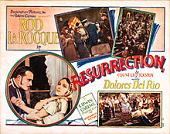
On Mar. 19, 1927 Edwin Carewe's Resurrection debuts, based on the 1899 Leo Tolstoy novel, starring Dolores del Rio (Maria de los Dolores Asunsolo y Lopez Negrete) (1905-83), 2nd cousin of Ramon Navarro.

On Mar. 26, 1927 Dorothy Arzner's Fashions for Women (Paramount Pictures) debuts, becoming the dir. debut of Dorothy Emma Arzner (1897-1979), an open lesbian who dresses in men's suits and ties, and goes on to dir. Clara Bowe's first talkie "The Wild Party", creating the boom mike for it, launching the careers of Katharine Hepburn, Rosalind Russell, Sylvia Sidney, and Lucille Ball, and becoming the first woman admitted to the Directors Guild of Am. in 1936.
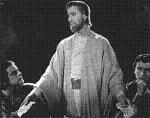
On Apr. 19, 1927 Cecil B. De Mille's The King of Kings debuts, reverently starring London-born H.B. Warner (Henry Byron Charles Stewart Warner-Lickfold) (1875-1958), as Jesus Christ, Dorothy Cumming as Mary, Ernest Torrence as Peter, Joseph Schildkraut as Judas, and Jacqueline Logan as Mary Magdalene; watch film.


On May 6, 1927 Frank Borzage's 7th Heaven (Fox) debuts, written by Benjamin Glazer based on the 1922 Broadway play by Austin Strong is a romance starring Germantown, Penn.-born Janet Gaynor (Laura Augusta Gainor) (1906-84) as Paris ho Diane, and Walpole, Mass.-born Charles Farrell (1901-90) as Chico, a street cleaner who saves her life by claiming that she's his wife, after which they climb you know how many flights of stairs together; Gladys Brockwell plays Nana; does $2.5M box office (13th highest grossing silent film in history), after which Gaynor and Farrell co-star in a dozen films, surviving the talkie era; features the song Diane by Erno Rapee and Lew Pollack; remade in 1937 by Henry King starring Simon Simon and James Stewart.
On May 11, 1927 the Academy of Motion Picture Arts and Sciences is founded - the world is set to become too small for the decadent exhibitionist West and the murderous but modest Muslims to share?


On May 15, 1927 Joseph C. Boyle's Broadway Nights debuts, starring Lois Wilson and Sam Hardy, becoming the film debuts of Barbara Stanwyck (Ruby Catherine Stevens) (1907-90) and Ann Sothern (Harriette Arlene Lake) (1909-2001) as fan dancers.


On May 18, 1927 $1M Grauman's Chinese Theater at 6925 Hollywood Blvd. in Los Angeles, Calif., built by failed Alaska gold prospector Sidney Patrick "Sid" "Little Sunshine" Grauman (1879-1950) opens, the first of the Fox chain, with 2.2K seats; the first film shown is the debut of Cecil B. De Mille's King of Kings at $2 a ticket; Hollywood actress Norma Talmadge (1893-1957) accidentally stumbles onto a freshly laid sidewalk outside the new theater, and press agents soon turn it into a distinction and a tradition to leave one's handprints and footprints, along with a signature, followed by her sister Constance Talmadge (five footprints in her slab), Mary Pickford, and Douglas Fairbanks Sr.
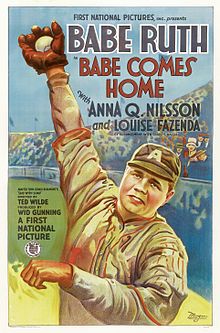
On May 22, 1927 Ted Wilde's Babe Comes Home (First Nat. Pictures) debuts, starring Babe Ruth as star Angels baseball player Babe Dugan, who pisses-off his laundress Vernie (Anna Q. Nilsson) with his tobacco juice-spitting dirtiness until they hook up and she reforms him, but when it makes his game suffer she throws him a plug of chewing tobacco and he hits a homer; 3-y.-o. Helen Parrish (1924-59) plays Babe's daughter, and goes on to star in "Our Gang" comedy shorts.
In May 1927 Studio City (originally Laurelwood) is founded in the San Fernando Valley near Los Angeles, Calif. on a triangular lot bisected by the Los Angeles River by film producer Mack Sennett; in 1933 he declares bankruptcy and sells it to Mascot Pictures, which in 1935 merges with Monogram Pictures and Consolidated Film Corp. to form Republic Pictures, becoming Republic Studios, producing B-Westerns starring Gene Autry, Roy Rogers, John Wayne et al.; in the 1950s Republic leases space to Revue Productions (founded in 1943 by MCA), which produces "Leave It To Beaver" et al. before moving to Universal City; meanwhile Four Star Productions leases space to produce "The Rifleman", "Dick Powell's Zane Grey Theater", "The Big Valley" et al.; Republic Pictures ceases film production, leasing the lot to CBS-TV, producing "Gunsmoke", "Rawhide", "My Three Sons", "Gilligan's Island", and "The Wild Wild West"; in Feb. 1967 CBS-TV purchases the lot for $9.5M, renaming it CBS Studio Center; in 1970 it rents space to the new MTM Enterprises; meanwhile in 1927 the Sherman Oaks neighborhood in Los Angeles, Calif. is founded W of Studio City, which ends bordered on the N by Valley Village, on the E by Universal City and Toluca Lake, on the S by Hollywood Hills West, and on the SW by Beverly Crest.

On June 25, 1927 Victor Fleming's The Way of All Flesh (Zukor-Lasky) debuts, based on a story by Perley Poor Sheehan (not the Samuel Butler novel), starring Emil Jannings as Milwaukee bank clerk August Schiller, who is bushwhacked by a blonde seductress on a train to Chicago and robbed of $1K in securities, destroying his life.

On July 24, 1927 D.W. Griffith's Topsy and Eva (Feature Productions) debuts, based on the Harriet Beecher Stowe novel and Catherine Chisholm Cushing play, starring Rosetta Duncan as Topsy, sister Vivian Duncan as Eva, Gibson Gowland as Simon Legree, and Noble Johnson as Uncle Tom, becoming the film debut of Danish-born Swedish pretty boy actor Nils Anton Alfhild Asther (1897-1981), who marries Vivian Duncan in 1930, becoming a leading man and growing a thin mustache to keep from looking too effeminate, becoming known as "the male Greta Garbo".

On July 31, 1927 Frank Capra's For the Love of Mike (Hell's Kitchen) debuts, starring Ben Lyon as Mike, who started out as a baby boy found abandoned in a tenement and raised by three men, Herman Schultz (Ford Sterling), Abraham Katz (George Sidney), and Patrick O'Malley (Hugh Cameron); the film debut of Claudette Colbert (Emilie "Lily" Claudette Chouchoin) (1903-96) (pr. "show-shwa"); too bad, the film is lost.

On Aug. 12, 1927 William A. Wellman's Wings debuts, starring Clara Bow as Mary Preston, who is fought over by WWI Air Corpsmen Jack Powell (Charles "Buddy" Rogers) and David Armstrong (Richard Arlen); Gary Cooper plays Cadet White; features harrowing dogfight scenes shot at Kelly Field in San Antonio, Tex., with 300 pilots and hundreds of extras, raising the bar for aviation flicks; winner of the first best picture Oscar; the first film to show two men kissing (fraternally), and one of the first widely-distributed films to incl. nudity; does ? box office on a $2M budget.

On Aug. 20, 1927 Josef von Sternberg's Underworld (Paying the Penalty) (Paramount) debuts, written by Ben Hecht, starring George Bancroft as gangster Bull Weed, based on Chicago gangster Terrible Tommy O'Connor, becoming a surprise hit, launching the gangster movie genre.

On Sept. 9, 1927 Paul Leni's The Cat and the Canary (Universal Pictures) debuts, based on the 1922 John Willard black comedy play, starring Laura La Plante as Annabelle West, Forrest Stanley as Charlie Wilder, and Creighton Hale as Paul Jones in a comedy horror flick about millionaire Cyrus West, whose greedy relatives descend on him like "cats around a canary" when his will is read 20 years later and Annabelle and the other heirs spend the night in his haunted mansion on the Hudson River; Lucien Littlefield plays Dr. Ira Lazar, who has to decide that Annabelle is sane to inherit the fortune; refilmed in 1939 starring Bob Hope; watch movie.

On Sept. 23, 1927 Lewis Milestone's Two Arabian Knights (United Artists) debuts, starring William Boyd as Pvt. W. Daingerfield Phelps III, and Louis Wolheim as Sgt. Peter O'Gaffney, who escape from a German WWI POW camp and vie for the affections of Arab babe Mirza (Mary Astor).

On Sept. 25, 1927 Millard Webb's silent B&W film The Drop Kick (First Nat. Pictures) debuts, based on the story "Glitter" by Katherine Brush, starring Richard Barthelmess as college football player Jack Hamill, Barbara Kent as Cecily Graves, and Hedda "nobody's interested in sweetness and light" Hopper as Mrs. Hamill, becoming the cameo debut of actor ("The Duke") Marion Mitchell (Robert) Morrison (John Wayne) (1907-79), who got his start throwing leaves into a fan for dir. John Ford and once mistakenly barged into the camera to sweep them up, causing Ford to see his potential?
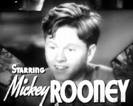
On Sept. 27, 1927 Albert Herman's Mickey's Circus debuts, a ripoff of the "Tonnerville Trolley" comic strip about Mickey McGuire, starring 7-y.-o. Mickey Rooney (Joseph Yule Jr.) (1920-2014), who goes on to star in 77 sequels until 1936, and legally changes his name to Mickey McGuire to avoid having to pay the comic strip writers any royalties; he changes it to Mickey Rooney in 1932 when they won't let him keep it, modifying his mother's suggestion of Mickey Looney.


On Sept. 27, 1927 Friedrich Wilhelm Murnau's Sunrise: A Song of Two Humans (Fox) debuts, based on the short story "Die Reise nach Tilsit" by Hermann Sudermann, about young farm wife Indre (Janet Gaynor), whose hubby Anses (George O'Brien) is put up to drowning her by city vamp Woman From the City (Margaret Livingston), then chickens out after disturbing her, but reconciles, only to get in a storm on the way back, where she falls overboard, causing him to try to strangle the mistress, but is saved by the villagers, who bring him his unharmed wife, who embraces him as the Sun rises; the first Hollywood flick for German dir. Friedrich Wilhelm Murnau (1888-1931), and one of the first with a music-SFX soundtrack recorded in the Fox Movietone system; wins the first-ever Oscar for unique and artistic production.

On Oct. 6, 1927 Richard O. Fleischer's The Jazz Singer debuts, based on the play "Day of Atonement" by Samson Raphaelson, becoming the first talking picture (talkie), produced by Warner Brothers in the Vitaphone sound-on-disc process, starring Lithuanian-born Jewish actor Al Jolson (Asa Yoelson) (1886-1950) (first openly Jewish U.S. actor) in black face, inaugurating the era of the Hollywood "talkie" at Warner's Theater on Broadway, and making $3M in profit on a $500K investment, after which the Hollywood Big Five Studios (Warner Bros., MGM, Famous Players, RKO, Fox) try to block the growth of talkies, causing maverick Warner Bros. to churn out 12 of them in 1928 alone; the Jazz Singer's name is Jack Robin, and the first words ever spoken onscreen are "Wait a minute, wait a minute, you ain't heard nothing yet" (reel #2); the part was turned down by George Jessel (star of the 1925 stage production) over money, relegating his movie career to the dumps; Jolson did it for less money and backed the movie financially, becoming known as "the World's Greatest Entertainer"; Eddie Cantor also turned it down; adding sound to movies revolutionizes the industry, and puts Am. Federation of Musicians members out of work, helped by a rush to hire English actors for their clearer diction; features the song Blue Skies; "No closer approach to resurrection has ever been made by science" (Prof. M. Pupin); "Men and women whose names were known throughout the land disappeared as though they had been lost at sea" (Jack Warner); "They made me sound as if I'd been castrated" (Tallulah Bankhead); "Talkies didn't do more to the industry than turn it upside down, shake the entire bag of tricks from its pocket, and advance Warner Brothers from last place to first in the league" (Variety); remade in 1980 starring Neil Diamond in a real woofer?
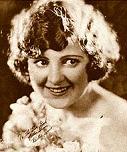
On Oct. 9, 1927 Richard Wallace's American Beauty debuts, based on a short story by Wallace Irwin, starring Billie Dove (Bertha Bohny) (1903-97) as Millicent Howard, giving her the nickname "American Beauty" and making a fan of Howard Hughes, whom she romances for three years while he casts her in his films.

On Oct. 9, 1927 Allan Dwan's East Side, West Side debuts, based on the Felix Riesenberg novel and featuring extensive footage of the New York City waterfront, starring George O'Brien as Johnn Breen, becoming the film debut of June Collyer (Dorothea Heermance) (1906-68) as Josephine.

On Nov. 21, 1927 F. Richard Jones' The Gaucho debuts, set in Argentina, starring Douglas Fairbanks Sr., becoming the film debut of Mexican actress ("the Mexican Spitfire") ("the Hot Pepper") Lupe Velez (Vélez) (Maria Guadelupe Villalobos Velez) (1908-44), who goes on to marry Tarzan actor Johnny Weismuller in 1933-9.
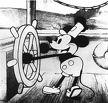

On May 15, 1928 Walt Disney's animated Plane Crazy (B&W) debuts, becoming the film debut of Mickey Mouse (voice of Disney) along with his skirt-wearing girlfriend Minnie Mouse (voice of Marcellite Garner and Thelma Boardman); on Nov. 18 after almost going bankrupt, seeing the success of "The Jazz Singer", and staking everything on it, the 3rd Mickey Mouse cartoon Steamboat Willie (B&W) debuts at the Colony Theater in New York City, with Walt as the voice of Mickey, becoming the first one with sound, making this date Mickey's birthday; next year the first of 75 Silly Symphony cartoons appear (until 1939); as Mickey Mouse becomes a hit, other hit characters incl. Donald Duck are spun-off.

On May 20, 1928 Edwin Carewe's Ramona (first United Artists film with synchronized score and sound effects) debuts, starring Dolores del Rio as mixed-race discriminated-against Ramona, and Warner Baxter as Alessandro; written by Carewe's older brother Finis Fox based on the 1884 Helen Hunt Jackson novel; after getting lost and found, it is shown at the Billy Wilder Theater at UCLA on Mar. 29, 2014.
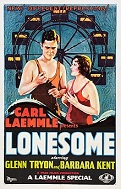
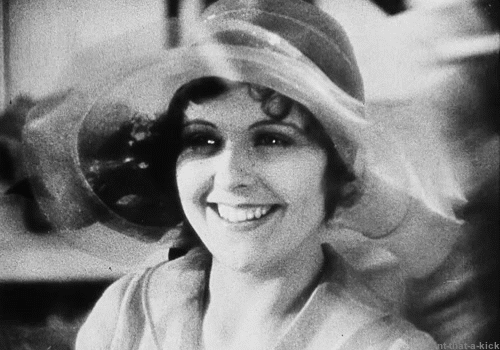
On June 20, 1928 Paul Fejos' Lonesome (Universal Pictures) debuts, a part-talkie dramedy starring Barbara Kent (Cloutman) (1907-2011) (1925 Miss Hollywood) as telephone operator Mary, and Glenn Tryon as factory worker Jim, who meet on the beach at Coney Island and fall in love, only to become separated with only each other's first name and a small photo to help them reunite; Kent flashes a magnificent smile?; remade in 1935 as "The Affair of Susan".


On July 28, 1928 Bryan Foy's The Lights of New York by Warner Bros. debuts, becoming "the first all-talking picture" ("The Jazz Singer" was a part-talkie), starring Helene Costello (1906-57) (1927 Wampas Baby Star) (sister of Dolores Costello), Cullen Landis, and Eugene Pallette; does $1M box office on a $23K budget, causing every studio in Hollywood to go all-talkie; too bad, Costello refuses to star as leading lady opposite Rin Tin Tin, causing Warner Bros. to cancel her contract, and her $3K/week career begins a downhill slide, compounded by a weak voice, drug and alcohol addictions, and three divorces.

On Aug. 4, 1928 Fred Niblo's The Mysterious Lady (MGM) debuts, starring Conrad Nagel as Austrian Capt. Karl von Raden in WWI, who is seduced by Russian spy Tania Fedorova (Greta Garbo), who betrays her mother country; Nagel's uncle Edward Connelly plays the head of the Austrian secret service Col. Eric von Raden; does $1.1M box office on a $336,973 budget.
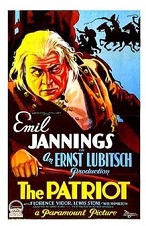
On Aug. 17, 1928 Ernst Lubitsch's The Patriot (Aug. 17) (Paramount Pictures), based on the novel by Alfred Neumann debuts, starring Emil Jannings as Tsar Paul I, Florence Vidor as Countess Ostermann, and Lewis Stone as Count Pahlen; features a synchronized soundtrack and isolated talking sequences; does ? box office on a $1M budget; too bad, it is lost.
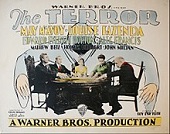
On Sept. 6, 1928 Roy Del Ruth's The Terror (Warner Bros. Pictures) debuts, written by Harvey Gates based on the play by Edgar Wallace about an English country inn where the guests incl. Mary McAvoy, Louise Fazenda, and Alex B. Francis are menaced by a slasher called The Terror, becoming the second "all-talking" motion picture released by Warner Bros. after "Lights of New York", and first all-talking horror film, made using the Vitaphone sound-on-disc system; does $1.22M U.S. and $243K foreign box office on a $163K budget; refilmed in 1934 as "Return of the Terror"; view video.


On Sept. 1, 1928 Harry Beaumont's Our Dancing Daughters debuts, based on a story by Josephine Lovett, starring Joan Crawford, Dorothy Sebastian, Anita Page, and Johnny Mack Brown, becoming the first film score for songwriter Richard A. Whiting (1891-1938), who goes on to write one almost every year until his premature death in 1938.

On Sept. 16, 1928 Josef von Sternberg's silent The Docks of New York (Paramount) debuts, written by Jules Furthman based on the story "The Dock Walloper" by John Monk Saunders, starring George Bancroft as super-strong ship stoker Bill, who saves beautiful ho Mae (Betty Compson) from drowning and marries her the same night, then reneges, then jumps ship to reclaim her.



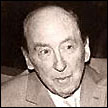

On Oct. 1, 1928 Hangar 1, the first modern air terminal in Los Angeles, Calif., constructed on Mines Field (later part of LAX) opens. On Oct. 23, 1928 RKO (Radio-Keith-Orpheum) Pictures is founded (until Jan. 31, 1957) after the Booking Offices of Am. controlled by Joseph Patrick Kennedy Sr. (1888-1969) merge with the Keith-Albee-Orpheum theater chain under control of RCA and its chief David Sarnoff in an attempt to create a monopoly, er, market for RCA's Photophone sound-on-film technology, going on to create a string of Fred Astaire-Ginger Rogers musicals in the 1930s, plus super hits "King Kong" and "Citizen Kane"; too bad, on Aug. 9 1929 their main rival, Greek-born Alexander Pantages (1867-1936), who dominates the theater biz W of the Mississippi River is accused of rape in Los Angeles by 17-y.-o. vaudeville dancer Eunice Irene Pringle (1912-96), who after a sensational trial gets him railroaded to a 50-year prison sentence, after which he hires expensive defense attys. Harold Lee "Jerry" Giesler (1886-1962) (later known for defending Errol Flynn on rape charges) and Jake W. Ehrlich (1900-71), who get him acquitted at a new trial, but the publicity ruins him financially, causing him to sell his chain to RKO at a bargain price, after which he claims that RKO and Kennedy paid Pringle to frame him; by the mid-1940s investor Floyd Bostwick Odlum (1892-1976) (who makes his move next year, correctly anticipating the 1929 Stock Market Crash to sell out in advance and later buy less fortunate cos. at bargain prices, becoming one of the 10 wealthiest people in the U.S.) gains control, followed by Howard Hughes.


On Oct. 6, 1928 Erich von Stroheim's The Wedding March (Paramount) debuts, starring Stroheim as Prince Nicki von Wildeliebe-Rauffenburg in 1914 Vienna, who falls in love with beautiful inkeeper's daughter Mitzi Schrammell (Fay Wray), but is forced to marry Cecilia Schweisser (ZaSu Pitts) for her money; Matthew Betz plays Nicki's rival Schani Eberle the butcher; Maude George plays Nicki's mother Princess Maria; Anton Vaverka plays emperor Franz Josef; expensive long orgy scenes are cut by the studio; the 4-hour film is cut into two parts; too bad, the 2nd part "The Honeymoon" is lost in a fire in France in 1957.



On Nov. 10, 1928 W.S. Van Dyke's White Shadows in the South Seas debuts, based on the Frederick O'Brien novel, starring hot new Mexican bombshell Raquel Torres (1908-87) and Monte Blue (1887-1963) in a biracial love story in the South Pacific; the first MGM film to synchronize music, dialogue, and special effects, winning a Best Cinematography Oscar, and the first in which the MGM Lion (Leo) roars, invented by Jewish-Am. lyricist Howard Dietz (1896-1983), who models it after his alma mater Columbia U., and later composes "That's Entertainment"; the original Leo the Lion dies in ? and is buried in Gillette, N.J.

On Nov. 20, 1928 King Vidor's Show People (MGM) debuts, about Hollywood, starring William Haines as Billy Boone, and Marion Davies (in her best role) as Peggy Pepper, with cameos by Charlie Chaplin, Douglas Fairbanks Jr., William S. Hart, and John Gilbert.
On Dec. 2, 1928 (first Sun. after Thanksgiving) the first annual Hollywood Christmas (Santa) Parade (Santa Claus Lane Parade) is held in Hollywood, Los Angeles, Calif. along a 3-5mi. stretch on Hollywood Blvd. and Sunset Blvd.; in 1942-44 it is suspended due to WWII; in 1946 George Autry rides his horse in the parade.

On Dec. 15, 1928 Clarence Brown's A Woman of Affairs debuts, starring Greta Garbo and John Gilbert, advertised by MGM as "Garbo and Gilbert in Love".




On Dec. 25, 1928 Irving Cummings' and Raoul Walsh's In Old Arizona (Fox) debuts, based on the Cisco Kid story "The Cabellero's Way" by O. Henry, becoming the first major Western talkie, and the first talkie filmed outdoors, incl. location shooting in Bryce Canyon Nat. Park, Zion Nat. Park, the San Fernando Mission, and the Mojave Desert, starring Warner Leroy Baxter (1889-1951), who sings My Tonia, launching the singing cowboy genre; also stars Edmund Lowe as his rival; the film debut of LA-born stage actress Dorothy Burgess (1907-61) (niece of Fay Bainter) as the Mexican minx; Walsh was set to star as the Cisco Kid instead of Baxter, but a jackrabbit jumped through his windshield costing him an eye, after which he wears a patch; does $1.3M box office.

In 1928 Conn. girl Katharine Houghton Hepburn (1907-2003) graduates from Bryn Mawr College, gets a bit part in the Broadway play "Night Hostess", and marries college chum Ludlow Ogden Smith (1899-1979) of Philly, insisting that he change his name to "S. Ludlow Ogden" to not appear so ordinary (or to avoid the name Kate Smith); they divorce in 1934.
In 1928 the Hollywood Women's Press Club is founded by Louella Parons as a luncheon club for women's mag. and newspaper journalists, admitting publicists in 1941, followed by screenwriters et al., and men in the late 1970s; in 1941 it begins awarding the Golden Apple Award to actors who are easy to work with, later the Sour Apple Award for difficult actors; it closes in 2001.

On Feb. 1, 1929 Harry Beaumont's Broadway Melody of 1929 (MGM) debuts, becoming the first MGM musical and the first all-talking musical in Hollywood, based on a story by Edmund Goulding, starring Anita Page and Bessie Love as Queenie and Harriet Mahoney, who come to Broadway and meet Eddie Kerns (Charles King), who gets them into one of Francis Zanfield's shows and vies for Harriet's affections with upper-class Jock Warriner (Kenneth Thomson); features a Technicolor sequence; does $3M box office; the first talkie to win a best picture Academy Award.

On Mar. 9, 1929 Robert Milton's The Dummy debuts, starring Ruth Chatterton, becoming the credited film debut of Fredric March (Ernst Frederick McIntyre Bickel) (1897-1975),

On Mar. 31, 1929 Frank Lloyd's The Divine Lady (First Nat. Pictures) is a non-talkie sound film about the love affair of British Adm. Horatio Nelson (Victor Varconi) and Lady Emma Hamilton/Hart (Corinne Griffith); features the theme song Lady Divine by Richard Kountz and Nathaniel "Nat" Shilkret.

On Apr. 12, 1929 Sam Taylor's Coquette (United Artists) debuts, the first talkie starring Mary Pickford, co-starring Johnny Mack Brown, John St. Polis, and Matt Moore, which shocks her audience when she appears with her famous curls turned into a bob after she cut her hair for her mother's 1928 death, making front page news; after it does $1.4M box office, she garners a best actress Oscar, but the public never really accepts the girl without the curls, and she retires from acting in 1933.





Whatsa matter with the clothes I'm wearing, can't you tell your tie's too wide? On May 16, 1929 (Thur.) the first Oscars are presented at the First (1st) Academy Awards at the Hollywood Roosevelt Hotel, hosted by Douglas Fairbanks Sr., awarding the best picture Oscar for 1927-8 to Paramount's Wings, best actor to Swiss actor Emil Jannings (1884-1950) for The Way of All Flesh, best actress to Janet Gaynor (Laura Augusta Gainor) (1906-84) for 7th Heaven (youngest until ?) (only to win for a year's body of work), and best dir. to both Frank Borzage (1894-1962) for 7th Heaven and Lewis Milestone (Milstein) (1895-1980) for Two Arabian Knights; to be eligible, a film must premiere in Los Angeles County, run for at least a week, and charge for admission.


On June 8, 1929 Bayard Veiller's The Trial of Mary Dugan debuts, becoming the talkie film debut of Norma Shearer (1902-83), wife of MGM head (1925-36) Irving Thalberg (1899-1936), who goes on to several Oscar-nominated roles despite her cross-eyed stare.



In summer 1929 Hungarian-born Jewish movie mogul William Fox (Wilhelm Fuchs) (Wilmos Fried) (1879-1952) of Fox Film Corp. arranges to buy the MGM holdings of the late Marcus Loew (d. 1927), pissing-off MGM studio bosses Louis B. Mayer and Irving Thalberg, but since they aren't stockholders they get the U.S. Justice Dept. to sue him for antitrust violations; too bad, Fox has a bad car accident in the summer, and the Oct. stock market crash wipes him out, ending the merger deal, and he goes into a tailspin, losing control of his corp. via hostile takeover in 1930, after which the govt. hounds him into bankruptcy, and he goofs bigtime by attempting to bribe judge John Warren Davis (1867-1945) and committing perjury at a 1936 bankruptcy hearing, getting him 6 mo. in priz and ending his career, while Fox Film Corp. merges with Twentieth Century Pictures on May 31, 1935 to form 20th Century Fox; meanwhile Davis is indicted in Mar. 1939 and steps down from the bench, but his trial results in a hung jury - so much for Jews working together against non-Jews and helping each other out?

On Aug. 3, 1929 Robert Florey's and Joseph Santley's The Cocoanuts debuts, introducing the Marx Brothers (Groucho, Chico, Harpo, Zeppo), with Groucho playing Mr. Hammer, mgr. of Hotel de Cocoanut; before performing on screen, self-taught harpist Harpo is polished by Am. harpist Mildred Dilling (1894-1982).



On Sept. 15, 1929 Luther Reed's Rio Rita debuts, an RKO musical comedy based on the 1927 Florenz Ziegfeld musical, starring Bebe Daniels (1901-71) and John Boles (1895-1969), along with the comedy team of Bert Wheeler (1895-1968) and Robert Woolsey (1888-1938); the last part is filmed in Technicolor; a big success, they all become stars, and Dorothy Lee (Marjorie Elizabeth Millsap) (1911-99) later co-stars with Wheeler and Woolsey, who become the biggest stars for RKO, and the biggest Hollywood team until Fred Astaire and Ginger Rogers.

On Sept. 28, 1929 Lionel Barrymore's His Glorious Night debuts, becoming John Gilbert's first talkie; too bad, his high-pitched voice makes audiences giggle, causing critics to label it a shriekie, dooming his $10K-a-week MGM career, although it later turns out to be a technical glitch (not his real voice) (done deliberately on orders of Louis B. Mayer to get rid of him?); his overdone lovemaking with Catherine Dale Owen also draws laughs, later getting parodied in "Singing' in the Rain" (1953) in the fake movie "The Dueling Cavalier"; too bad, after breaking up with Greta Garbo and marrying Broadway actress Ina Claire, he is returning by ship in the Atlantic when Black Tuesday hits, wiping him out, and he becomes an alcoholic, drinking himself to death in 1936.
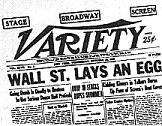
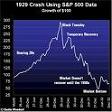


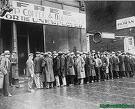

On Oct. 24, 1929 (Thurs.) Black Thursday is the beginning of the U.S. stock market crash, with 12,894,650 shares traded; the real fun starts next Tues. On Oct. 28 (Mon.) Black Monday sees 9M shares traded as prices continue to fall. Down on the corner, out in the street? Black Tuesday drops a bomb on the world? On Oct. 29 (Tues.) after a small temporary drop on Mar. 26, followed by a "golden summer" when the NYSE sets a record on Sept. 19 (Thur.), the huge WWI war debt finally catches up with the world as Black Tuesday descends upon the New York Stock Exchange, which crashes as 16M shares are traded, causing thousands of investors to be wiped out amid panic selling, leading the Fed to begin tightening credit, followed by a worldwide Great Depression; stock prices reach their lowest point on Nov. 13 (Wed.), falling from an avg. of 311.90 in Sept. to 164.43; industrial avgs. fall from 469.49 to 220.95 (a total of $30B in listed stock value wiped out in the NYSE); the Oct. 30 issue of Variety carries the title "Wall Street Lays An Egg"; part of the blame for the panic goes to the slowness of mechanical stock tickers; Jewish financier Bernard Mannes Baruch (1870-1965) brings Winston Churchill to personally view the NYSE on Oct. 24, fueling the speculations of conspiracy theorists, esp. after Baruch later becomes the person to coin the term "Cold War"?; gasoline, which costs 21.4 cents a gal. this year in the U.S. begins its own crash, not recovering to this level until 1947, after which it holds at 27 cents from 1949-52; Pres. Hoover attempts to take a leadership role with business and labor to smooth the nation over "rough spots", but fails to ask Congress for major legislation, allowing the latter to put the blame on him later, even though they proposed no new legislation either?

On Nov. 1, 1929 Alfred E. Green's Disraeli (Warner Bros.) debuts, a talkie based on the 1911 play by Louis N. Parker, starring London, England-born George Arliss (George Augustus Andrews) (1868-1946), "first Gentleman of the Screen" as British PM Benjamin Disraeli, who tries to start WWI, er, buy the Suez Canal in 1874 from the khedive of Egypt; George Arliss becomes the first actor to win an Oscar for playing a real person, after which he testifies in court that he's the world's greatest living actor.

On Nov. 9, 1929 Victor Fleming's B&W The Virginian (Paramount Pictures) debuts, a sound remake of the 1923 silent film, Gary Cooper as the Virginian, and Walter Huston as Trampas; first talkie for Fleming and Cooper; filmed mostly outdoors using blimped (soundproofed) cameras; features the song "Bury Me Not on the Lone Prairie", sung by Richard Arlen; Cooper's favorite film; "If you wanna call me that, smile" (Cooper); score composed by Karl Hajos, with mainly natural background sounds not always synchronized to the action.


On Nov. 19, 1929 Ernst Lubitsch's The Love Parade debuts, becoming Lubitsch's first talkie, a musical starring French sensation Maurice Chevalier (1888-1972) and Am. soprano Jeanette MacDonald (1903-65) as Queen Louise and Count Alfred of Sylvania, becoming a big hit and giving his dir. career new life, and launching MacDonald's career, who goes on to introduce opera to Am. audiences.
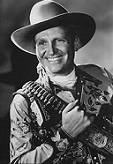
In 1929 "Oklahoma's yodeling cowboy" Orvon Grover "Gene" Autry (1907-98) (born in Tioga, Tex.) is discovered by Will Rogers, going on to wow America's hick chicks as "the Singing Cowboy", appearing in 93 films, always the mighty white, honest, brave, straight-shooting hero, with the theme song "Back in the Saddle Again", cranking out Christmas songs incl. "Rudolph the Red-Nosed Reindeer", "Frosty the Snowman", and "Here Comes Santa Claus".
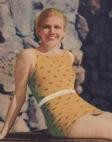
In 1929 Edward H. Griffith's Paris Bound, debuts, based on the 1927 Philip Barry play stars Fredric March as Jim Hutton, becoming the film debut of blonde actress Ann Harding (1902-81) as Mary Hutton, who gets signed by RKO as the answer to MGM superstar Norma Shearer.

In 1929 Erich von Stroheim's Queen Kelly debuts, starring Gloria Swanson as convent student Kitty Kallen, who throws her underwear at horndog Prince Wolfram (Walter Byron), causing him to kidnap her, after which his betrothed Queen Regina V (Seena Owen) has him thrown in prison, after which Kelly moves to German East Africa to live with her aunt, and marries repulsive Jan, leaving him to run her aunt's brothel; too bad, Swanson and financier Joseph P. Kennedy fire Stroheim for cost overruns and too much sex, and an alternate ending is filmed showing Kelly dying in despair, after which Wolfram visits her corpse in the chapel; the film is only released in Europe and South Am.; an extract appears in "Sunset Boulevard" (1950); it is shown on U.S. TV in the 1960s.
In 1929 just as he is to begin a 2nd film for British Internat. Pictures, "Mumming Birds", Charlie Chaplin's half-brother Sydney Chaplin is accused of biting off the nipple of actress Molly Wright in a sexual assault, after which BIP settles out of court, conceding the truth of Wright's claims, after which Sydney leaves England for France, fleeing the tax collector, and in 1930 declares bankruptcy, his film career kaput.





On Feb. 14, 1930 Dashiell Hammett (1894-1961) pub. The Maltese Falcon, which he wrote in a couple of days in San Francisco, where he lived since 1921; "Sam Spade's jaw was long and bony, his chin a jutting V under the more flexible V of his mouth" (first line); Burritt Alley, where Miles Archer is murdered is one block away from Monroe St., one of the 8-10 places he lived; on Dec. 6, 1994 the Maltese Falcon statue is auctioned for $398,590; on Nov. 25, 2013 it is auctioned to Las Vegas hotel magnate Steve Wynn for $4.1M. On Oct. 3, 1941 John Huston's The Maltese Falcon (Warner Bros.) debuts, based on the 1930 Dashiell Hammett novel, starring Humphrey Bogart (after George Raft turns it down) as San Francisco detective Sam Spade ("the Blond Satan"), who ends every dictation to his secy. Effie with "Period. End of Report"; "In 1539 the Knight Templars of Malta paid tribute to Charles V of Spain by sending him a Golden Falcon encrusted from beak to claw with rarest jewels, but pirates seized the galley carrying this priceless token, and the fate of the Maltese Falcon remains a mystery to this day"; Spade's partner Miles Archer (a bit part played by Walter Huston, who also plays Capt. Jacobi) was "done in by Brigid O'Shaughnessy" (played by Mary Astor after Geraldine Fitzgerald loses the part in a clash with Jack Warner, becoming the first of several films with Bogart) in Burritt Alley; Peter Lorre plays gay bud Joel Cairo; Elisha Cook Jr. plays Wilmer Cook; Gladys George plays Archer's wife Iva; John Hamilton plays DA Bryan; Lee Patrick plays Effie Perine; Barton MacLane plays Det. Lt. Dundy; Ward Bond plays Det. Tom Polhaus; the dir. debut of Nevada, Mo.-born former artist John Marcellus Huston (1906-87), who goes on to dir. 37 films over 46 years, garnering 15 Oscar nominations and two wins; Ward Bond plays Det. Tom Polhaus; the talkies film debut of English actor Sidney Hughes Greenstreet (1879-1954) as "the Fat Man" Kaspar Gutman (who inspires the name of the A-bomb dropped on Nagasaki), who says "I distrust a man that says when. If he's got to be careful not to drink too much it's because he's not to be trusted when he does"; Bogey utters the soundbytes: "When you're slapped, you'll take it and like it"; "It's the stuff dreams are made of"; "The cheaper the crook, the gaudier the patter"; "We didn't exactly believe your story, Miss O'Shaugnessy, we believed your 200 dollars"; "You're a good man, sister" (to Effie); "Don't be too sure I'm as crooked as I'm supposed to be."

On Feb. 21, 1930 Clarence Brown's Anna Christie debuts, becoming Garbo's first talkie, advertised with the slogan "Garbo talks"; based on an Eugene O'Neill play, she plays an ex-ho who finds love with sailor Charles Bickford; her first line is: "Gimme visky, ginger ale on the side. And don't be stingy, baby."

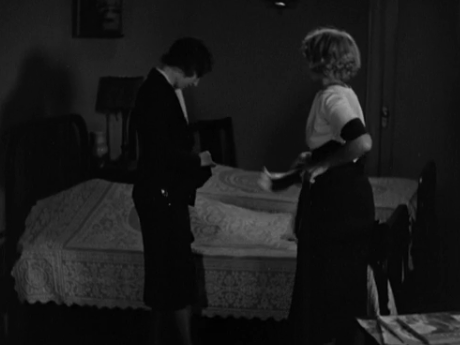
On Mar. 7, 1930 Howard Higgin's The Painted Desert debuts, becoming the first major film role of big-eared William Clark Gable (1901-60), who plays villain Rance Brett opposite good guy William Boyd (as Bill Boyd/Holbrook); Gable bursts into film this year, appearing in Harry Beaumont's Dance, Fools, Dance (Feb. 21), Harry Beaumont's Laughing Sinners (May 30), Clarence Brown's A Free Soul (June 20), and William Wellman's Night Nurse (Aug. 8), Robert Z. Leonard's Susan Lenox: Her Fall and Rise (Oct. 10) (with Greta Garbo), and Clarence Brown's Possessed (Nov. 21) (with Joan Crawford).
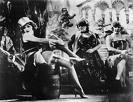



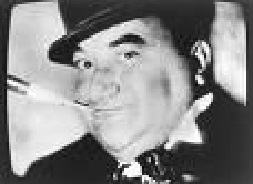

On Apr. 1, 1930 Josef von Sternberg's The Blue Angel (first major German sound film) debuts, making a star of Marlene Dietrich (1901-92), who first sings her signature song Falling in Love Again (Can't Help It) by Friedrich Hollaender (1896-1976), causing her to be discovered by Hollywood, forming Marlene's Sewing Circle of lesbian lovers incl. Claudette Colbert, Lili Damita et al., and wearing "man drag" offscreen, causing a nat. vogue for women to wear slacks; also stars Hans Philipp August Albers (1891-1960) (#1 male movie star in Germany in 1930-45) as big-mouth strongman Mazeppa, and features obese Berlin-born German-Jewish actor Kurt Gerron (1897-1944), famous for singing "Mack the Knife" in Bertolt Brecht's "Threepenny Opera"; too bad, after the war begins he is captured by the Nazis in Amsterdam and sent to the Theresienstadt Ghetto in Czech., where he is forced to make the 1944 Nazi propaganda film The Fuhrer Gives a City to the Jews, after which he is sent to Auschwitz and murdered? (he said send me some Academy Awards, not send me to Auschwitz?); Dietrich's Austrian-born Jewish Svengali Josef (Jonas) (von) Sternberg (1894-1969) goes on to incl. a scene of Dietrich in man drag in each of their films, causing Vanity Fair to comment: "Sternberg traded his open style for fancy plan, chiefly upon the legs in silk, and buttocks in lace, of Dietrich, of whom he has made a paramount slut. By his own token, Sternberg is a man of meditation as well as a man of action: but instead of contemplating the navel of Buddha, his umbilical perseverance is fixed on the navel of Venus", after which his wife Risa Royce Sternberg files for divorce, blaming Dietrich for "alienating the affections of my husband"; after she loses him, Dietrich mutters to some cameramen who are lighting her improperly, "Where are you, Joe?"
On Apr. 3, 1930 the Second (2nd) Academy Awards at the Cocoanut Grove Nightclub in the Ambassador Hotel in Los Angeles awards the best picture Oscar for 1928-9 to MGM's Broadway Melody, best actor to Warner Baxter for In Old Arizona, best actress to Mary Pickford for Coquette, and best dir. to Frank Lloyd for The Divine Lady (first without a best picture nomination until ?); there are seven different films honored in seven categories, a first; Jeanne Eagels (1890-1927) beomes the first posth. nominee for The Letter, but loses to Pickford.
On Apr. 18, 1930 George W. Hill's The Secret Six debuts, starring Ralph Bellamy as a bootlegger who recruits Wallace Beery to join his gang, which is masterminded by crooked criminal lawyer Lewis Stone, until Berry takes it over and grows fat, after which a secret group of six masked businessmen rat him out and get him sent to the chair with the help of newspapermen Clark Gable and Johnny Mack Brown; meanwhile Jean Harlow proves she can act as she is torn between her love of Brown and financial dependence on her boss Beery; first of six movies she makes with Clark Gable for MGM, ending with "Saratoga" in 1937, released 1 mo. after her untimely blonde bombshell death.

On Apr. 19, 1930 Robert Z. Leonard's The Divorcee debuts, based on the novel "Ex-Wife" by Ursula Parrott, starring Chester Morris as a hubby who cheats on his wife Norma Shearer, who decides to "settle the account" by cheating with Robert Montgomery; Joan Crawford never forgives her for stealing the part; Shearer becomes a feminist pioneer for making it acceptable to be a non-virgin single onscreen?; she decides to cut down her film exposure, saving herself for her hubby (head of MGM since 1924) Irving Thalberg's top projects.

On Apr. 19, 1930 John Murray Anderson's King of Jazz debuts, starring Paul Whiteman and His Orchestra, and featuring the Rhythm Boys, incl. Harry Lillis "Bing" Crosby (Scan. "by the cross") (1903-77), who changed his first name to Bing after the comic strip "The Bingville Bugle".
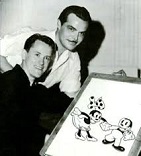

On Apr. 19, 1930 Hugh Harman (1903-82) and Rudolf Carl "Rudy" Ising (1903-92) of Warner Bros. release Sinkin' in the Bathtub (B&W), which features Bosko, the Talk-Ink Kid, becoming the first in the animated Looney Tunes/Merrie Melodies series (ends 1969), which launches hit chars. incl. Beans the Cat (1935), Porky Pig (1935), Daffy Duck (1937-), Bugs Bunny (1940), Elmer Fudd (1940), Tweety (1942) and Sylvester (1945), Pepe Le Pew (1945), Yosemite Sam (1945), Foghorn Leghorn (1946), Marvin the Martian (1948), Wile E. Coyote and the Road Runner (1949), Granny (1950), Speedy Gonzales (1953), Witch Hazel (1954), and the Tasmanian Devil (1954); color is introduced in 1942; the name Looney Tunes is inspired by Walt Disney's "Silly Symphonies"; too bad, Harman and Ising leave Warner Bros. in 1933, and they hire new dirs. incl. Tex Avery, Friz Feleng, Bob Clampett, and Chuck Jones; the main voice actor is Mel Blanc; in 1942-64 Looney Tunes and Merrie Melodies are the most popular animated shorts in movie theaters; the last release is "Injun Trouble" (1969); in 1960 they begin to air on TV, starting with "The Bugs Bunny Show" (1960-2000), "The Porky Pig Show" (1964-7),, "The Road Runner Show" (1966-73), "The Merrie Melodies Show" (1972), "Merrie Melodies Starring Bugs Bunny & Friends" (1990-4), "Tiny Toon Adventures" (1990-5), "Taz-Mania" (1991-5), "The Plucky Duck Show" (1992), "The Sylvester & Tweety Mysteries" (1995-2002), "Bugs 'n' Daffy" (1995-8), "Baby Looney Tunes" (2001-5), "Duck Dodgers" (2003-5), "Loonatics Unleashed" (2005-7), "The Looney Tunes Show" (2011-14), and "New Looney Tunes" (2015-).

A most remarkable man who coulda been a contender against Hitler? On Apr. 21, 1930 Lewis Milestone's All Quiet on the Western Front (B&W) (Universal Pictures) debuts, written by Maxwell Anderson based on the 1929 novel by flamboyant-living, Lancia convertible driver Erich Maria Remarque (later called "the king of Hollywood"), starring Lew Ayres as Paul Baumer, Louis Wolheim as Kat Katczinsky, John Wray as Himmelstoss, Arnold Lucy as Prof. Kantorek, and Slim Summerville as Tjaden; the final scene shows Paul reaching out to touch a butterfly before he is killed by a sniper; after she is replaced by Beryl Mercer as Paul's mother for making previewers laugh, ZaSu Pitts goes into B-comedy, defining the fretful, flustered, worrisome spinster, and often teaming with Thelma Todd; features 2K+ extras on battlefields set up on a 930-acre ranch in Irvine, Calif., and costs Universal Pictures $1.25M, but is a major hit, and Photoplay names it picture of the year; Variety tells the League of Nations to "buy up the master-print, reproduce it in every language, to be shown to every nation every year until the word 'war' is taken out of the dictionaries"; it pisses-off the Nazis so much that they ban it in Germany (until 1952); Remarque is forced to leave Germany, and is stripped of German citizenship in June 1938; it is rereleased in the U.S. in 1939 following the German invasion of Poland, right before which Remarque escapes the Gestapo, travels the backroads through France, sails on a Panamanian passport aboard the Queen Mary, and arrives in New York City as a lit. celeb, and predicts WWII, touting FDR as the world's only hope and becoming a conscientious objector.


On June 14, 1930 George W. Hill's The Big House debuts, written by Frances Marion (Marion Benson Owens) (1888-1973) (a woman, not John Wayne), about a prison breakout, starring Wallace Beery (1885-1949) as violent career criminal Machine Gun Butch Schmidt, becoming his sound film breakthrough and making him the world's highest paid actor within two years; also features Robert Montgomery as Kent Marlowe, Chester Morris as John Morgan, Lewis Stone as warden James Adams, and Leila Hyams as Kent's sister Anne Marlowe.

On July 12, 1930 Jack Conway's The Unholy Three (MGM), a remake of the silent 1925 hit debuts, starring Lon Chaney Sr. in his only talking picture, where he quells rumors that he is a mute by using five different voices, playing ventriloquist scam artist Prof. Echo, who masquerades as kindly old lady parrot shop owner Mrs. O'Grady, who frames an innocent man (Elliott Nugent as Hector McDonald) on his crimes then uses his skills to help him in court because his pickpocket and fake granddaughter Rosie O'Grady (Lila Lee) is in love with him; German Doll Family midget Harry Earles plays fake baby Tweedle Dee; Ivan Linlow plays Hercules; Chaney dies of er, throat cancer 1 mo. after the film's release.
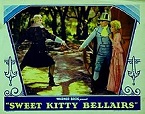
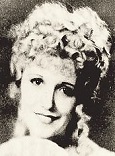
On Aug. 9, 1930 Alfred E. Green's B&W Sweet Kitty Belairs (Warner Bros.) debuts, a lavish Technicolor musical based on the 1900 novel "The Bath Comedy" by Agnes and Egerton Castle, the 1903 play by David Belasco, the 1903 silent film starring Henrietta Crosman, and the 1916 silent film starring Mae Murray, starring Claudia Dell (Smith) (1910-77) in her debut film role as a famous flirt in Bath, England, who decalres "In spite of my thirty or forty affairs, I've lot not a bit of my virtue", Walter Pigeon as Lord Varney, and Ernest Torrence as Sir Jasper Standish, who vie for her love too bad, after the Depression kills the popularity of musicals, Warner Bros. drops Dell in 1931 along with most of its musical stars; view clip.

On Aug. 23, 1930 Victor Heerman's B&W Animal Crackers (Paramount Pictures), debuts, the 2nd of 13 Marx Brothers comedies, filmed in Paramount's Astoria Studios in Astoria, Queens, N.*Y. stars Groucho as renowled African explorer Capt. Geoffrey T. Spauling, based on a real army officer arrested a few years earlier for selling cocaine in Hollywood), Chico (signor Emanuel Ravelli), Harpo (The Prof.) and Zeppo (Horatio Jamison), along with Lillian Roth (Arabella Rittenhouse) and Margaret Dumont (Mrs. Rittenhouse), and Robert Grieg, who plays Hives the Butler; becomes a classic for lines such as "You go Uruguay and I'll go mine", "One morning I shot an elephant in my pajamas. How he got into my pajamas I'll never know", "Africa is God's country - and He can have it"; "Ever since I met you, I've swept you off my feet"; "You mind if I don't smoke?"; "There's always one thing I've always wanted to do before I quit: retire"; Margaret Dumont (Daisy Juliette Baker) (1882-1965), granddaughter of "Br'er Rabbit" author Joel Chandler Harris is the usual butt of the jokes, becoming known as the "fifth Marx brother"; Groucho sings Hooray for Captain Spaulding, which later (1950s) becomes the theme of his TV show "You Bet Your Life"; censors cut the line "I think I'll try and make her".

On Sept. 3, 1930 The Hollywood Reporter begins pub. by Nashville, Tenn.-born William Richard "Billy" Wilkerson (1890-1962), becoming Hollywood's first daily entertainment trade newspaper; Wilkerson goes on to found the Cafe Trocadero in 1934, and the Flamingo Hotel in 1945, and discover Lana Turner in Jan. 1937.

On Sept. 30, 1930 George Cukor's A Bill of Divorcement (RKO) debuts, based on the play by Clemence Dane about reaction to a 1920s British law allowing insanity as a grounds for a woman to divorce her hubby, starring John Barrymore as mental hospital escapee Hilary Fairfield, becoming the film debut of Katharine Houghton Hepburn (1907-2003) as his wife Sydney Fairfield, a role which she snags after being discovered in the Broadway play "The Warrior's Husband", then demanding a pay raise from $80 to $1.5K per week plus having John Barrymore and George Cukor at her side, after which Cukor talks David O. Selznick into it; "Everyone thought I was bold and fearless and even arrogant, but inside I was always quaking"; David Manners plays Sydney's fiancee Kit Humphreys; Paul Cavanagh plays Meg's fiancee Gray Meredith; silent film star Billie Burke makes her comeback as Sydney's mother Margaret "Meg" Fairfield, suffering the death of hubby Florenz Ziegfield Jr. during filming; does $531K box office on a $250K budget.
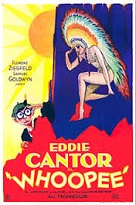
On Sept. 30, 1930 Thornton Freeland's Whoopee! (Samuel Goldwyn Productions) (United Artists) debuts, based on the 1928 Ziegfield stage show based on the 1923 play "The Nervous Wreck" by Owen Davis, making a star of Eddie "Banjo Eyes" Cantor (Edward Israel Iskowitz) (1892-1964) as Henry Williams, who sings Makin' Whoopee; features the Goldwyn Girls, incl. Virginia Bruce, Claire Dodd, Paulette Goddard, Betty Grable, and Ann Sothern; does $2.655M box office on a $1.3M budget.

On Oct. 11, 1930 John G. Adolfi's Sinners' Holiday debuts, based on a play by Marie Baumer, starring Grant Withers, becoming the film debut of James "Jimmy" Cagney (1899-1986).


On Oct. 12, 1930 John Ford's Up the River (Fox) debuts, starring Spencer Bonaventure Tracy (1900-67) in his feature film debut as convict St. Louis, and Humphrey DeForest Bogart (1899-1957) in his feature film debut as fellow convict Steve, becoming their only film together.

On Oct. 31, 1930 Ludwig Berger's Playboy of Paris debuts, based on the 1911 play "The Little Cafe" by Tristan Bernard, a comedy film starring Maurice Chavalier and O.P. Heggie, becoming the film debut of no-not-John-Wayne Frances Marion Dee (1909-2004).

On Nov. 1, 1930 Raoul Walsh's The Big Trail debuts, becoming John Wayne's first Western; in future Westerns he always uses the six-gun from this film.
On Nov. 5, 1930 the Third (3rd) Academy Awards at the Ambassador Hotel in Los Angeles (the only time two ceremonies are held the same year, to standardize the interval between awards) (first to make sound films eligible in all categories) awards the best picture Oscar for 1929-30 to Universal's All Quiet on the Western Front along with best dir. to Lewis Milestone, best actor to George Arliss for Disraeli, and best actress to Norma Shearer for The Divorcee; Frances Marion becomes the first female to win an Oscar for best adapted screenplay for The Big House.

On Nov. 15, 1930 Howard Hughes' Hell's Angels (United Artists) debuts, a WWI aviation flick on which aviation-loving studio owner Hughes spends $3.8M and loses a bundle making a star of blonde bombshell Jean Harlow (Harlean Harlow Carpenter) (1911-37) (who replaced Swedish actress Greta Nissen when sound was added); wins an Oscar for best cinematography; Hughes fires dirs. Howard Hawks and Luther Reed to put himself in the dir.'s chair, takes three years to make it, costing three pilots their lives, and has the B&W film tinted and 2-colored to keep up with the Joneses.


On Nov. 15, 1930 John B. Blystone's Tol'able David (Columbia) debuts, a remake of the 1921 silent film, starring Richard "Dick" Cromwell (LeRoy Melvin Radabaugh) (1910-60) as David Kinemon after he wins an audition over thousands of hopefuls, and Harry Cohn gives him his screen name and a $75/week salary; Joan Peers plays his babe Esther Hatburn, Noah Beery plays Luke Hatburn, Henry B. Walthall plays Amos Hatburn, and John Carradine (under alias Peter Richmond) plays Buzzard Hatburn; the film debut of Greenwich Village, N.Y.-born ("the Voice") ("Bard of the Boulevard") John (Richmond Reed) Carradine (1906-88) (AKA John Peter Richmond), who got his nose broken in jail, creating "the look that would become world famous", and started out as a set designer for Cecil B. DeMille, later doing voiceovers with his trademark baritone voice.

On Dec. 22, 1930 George Cukor's and Cyril Gardner's The Royal Family of Broadway debuts, based on the 1927 play by Edna Ferber and George S. Kaufman about the Barrymore family, becoming the breakthrough role for Fredric March (Ernst Frederick McIntyre Bickel) (1897-1975), who plays Tony Cavendish.
In 1930 the Goldwyn Girls, a musical stock co. of female dancers is founded by Samuel Goldwyn, incl. Lucille Ball, Virginia Bruce, Paulette Goddard, Betty Grable, Virginia Grey, June Kirby, Virginia Mayo, Joi Lansing, Barbara Pepper, Marjorie Reynolds, Pat Sheehan, Ann Sothern, Larri Thomas, and Jane Wyman; they first appear in "Whoopee!" (1930); they last appear in "Guys and Dolls" (1955) as the Hot Box Girls.


In 1930 after Roman Catholic Jesuit Father Daniel Aloysius Lord (1888-1955) presents it to him, cute, innocent, decent-looking bat-eared former U.S. postmaster gen. (1921-2) and Harding campaign mgr. William Harrison "Will" Hays (1879-1954), head of the Motion Picture Producers and Distributors of Am. (founded 1922) (later the Motion Picture Assoc. of Am.) establishes the Motion Picture Production (Hays) Code (Code of Decency) for Hollywood films, which rules for four decades (until 1967), banning nudity, sex acts, or "pointed profanity", along with criticism of religion, law, or letting the bad guy win; too bad, it doesn't stop Hollyweird from filming what they want, only making them pass a cutting room censorship process that sometimes slips, causing the Roman Catholic Nat. (Catholic) Legion of Decency to be formed in 1933 by Cincinnati archbishop John T. McNicholas to label films as taboo for good Roman Catholics, only making them more popular?; it begins to be enforced seriously in 1934, then abandoned in 1968 in favor of the MPAA Film Rating System - cuminating in Deep Throat?


On Jan. 9, 1931 Mervyn LeRoy's Little Caesar, (Warner Bros.) debuts, based on the 1929 W.R. Burnett novel, becoming the grandfather of the modern gangster film, becoming the breakthrough role for Romanian-born Edward Goldenberg Robinson (Emanuel Goldenberg) (1893-1973) as small-time Chicago gangster Caesar Enrico "Rico" Bandello, who utters the immortal soundbyte "Mother of mercy, is this the end of Rico?"; first film by Chicago, Ill.-born Warner Bros. production head Harold Brent "Hal" Wallis (1898-1986), husband (since 1927) of actress Louise Fazenda, followed in 1966-86 by Martha Hyer, who quits in 1944 after clashing with Jack Warner over "Casablanca", going independent and hiring Ayn Rand, Lillian Hellman et al. as screenwriters, scoring hits with Dean Martin-Jerry Lewis comedies and Elvis Presley movies, along with True Grit (1969) and Rooster Cogburn (1975).

On Jan. 26, 1931 Wesley Ruggles' B&W Western Cimarron (RKO Radio Pictures) debuts, based on the 1929 Edna Ferber novel, starring Richard Dix and Irene Dunne as Kan. newspaperman Yancey and wife Sabra Cravat, who move to Okla. during the 1893 land rush, and print the Okla. Wigwam until he deserts her; costs $1.5M and requires 5K extras; becomes the first Western to win a Best Picture Oscar, and one of only two won by RKO; does $1.383M box office on a $1.433M budget.

On Jan. 30, 1931 Charlie Chaplin's City Lights debuts, becoming Chaplin's last silent film; the Little Tramp falls in love with a blind flower girl (Virginia Cherrill) and helps her get money for a sight-restoration operation, forming a turbulent friendship with an alcoholic millionaire (Harry Myers); Florence Lee plays her grandmother; former Keystone Cop Hank Mann plays Chaplin's boxing opponent; does $5M box office on a $1.5M budget.
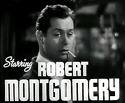
On Jan. 31, 1931 Clarence Brown's Inspiration debuts, based on the 1884 Alphonse Daudet novel "Sappho", starring Greta Garbo, and Robert Montgomery (1904-81) (father of "Samantha in Bewitched" actress Elizabeth Montgomery), launching his star career.


On Feb. 12, 1931 Tod Browning's Dracula (Universal Pictures) debuts, based on the 1898 Bram Stoker novel, launching Hungarian-born Bela Lugosi (1882-1957) into film immortality, with trademark accent and the immortal soundbyte: "Listen to them, children of the night - what music they make"; also makes a star of dir. Tod Browning (Charles Albert Browning Jr.) (1880-1962); too bad, all of the Dracula stuff is censored by the govt. of Transylvania (Romania) until 1992; view clip.

On Mar. 5, 1931 Jack Raymond's The Speckled Band (British and Dominions Film Corp.) debuts, the first sound version of the Arthur Conan Doyle story, starring Canadian-born Raymond Hart Massey (1896-1983) as Sherlock Holmes, and Athole Stewart as Dr. Watson.
On Mar. 11, 1931 German film dir. Friedrich Wilhelm Murnau (b. 1888) dies in Santa Barbara, Calif. in a car crash a week before the debut of his film "Tabu"; rumors spread that he was giving a beejay to his handsome 14-y.-o. Filipino driver Garcia Stevenson in his Packard, causing the crash; only 11 people attend his funeral, incl. Greta Garbo, but not incl. his stars Janet Gaynor and Charlie Farrell; Greta Garbo commissions a death mask of him, which she keeps on her desk in Hollywood.

On Mar. 29, 1931 Hobart Henley's The Bad Sister debuts, based on the 1913 Booth Tarkington novel "The Flirt", starring Conrad Nagel, Sidney Fox, Humphrey Bogart, and ZaSu Pitts, becoming the film debut of Ruth Elizabeth "Bette" Davis (1908-89), who immediately gets relegated by studio execs to B-movies; in one scene she has to change a diaper and sees male genitals for the first time in her life, turning red?; she attends the debut in San Bernardino, Calif. with her mother, and leaves crying?
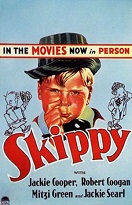
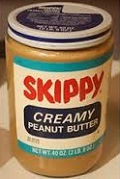
On Apr. 5, 1931 Norman Taurog's Skippy (Paramount Pictures) debuts, based on the comic strip by Percy Crosby, starring Taurog's 9-y.-o. nephew John "Jackie" Cooper Jr. (1922-2011), who becomes the youngest person to be nominated for a best actor Oscar (until ?); his brother Robert Coogan plays his friend Sooky, who stars in the 1931 sequel; the film becomes the first nominated for a best picture Oscar that's based on a comic or graphic novel (until ?). In 1932 Skippy brand peanut butter is introduced by Rosefield Packing Co. Ltd. of Alameda, Calif., owned by Joseph Louis Rosefield (1882-1958), who developed a hydrogenation method in 1922 that made mass-production of peanut butter possible and licensed it to Peter Pan of Chicago in 1923 while selling his own Luncheon Brand in Calif., and suddenly decides to rename it after the hit 1931 flick "Skippy" starring Jackie Cooper, trademarking the name next year and pissing-off Percy Lee Crosby (1891-1964), creator of the "Skippy" comic strip (1923-45), who trademarked the name in 1925 and has Rosenfield's trademark invalidated next year, which doesn't stop attempts to restore the trademark lasting until ?, starting with Rosenfield getting his trademark restored in 1947 after Crosby is involuntarily institutionalized and the 1946 U.S. Lanham Act is passed; in 1955 Best Foods acquires the brand; in 2013 Hormel Foods buys the brand from Uniliver.


On Apr. 23, 1931 William A. Wellman's The Public Enemy (Warner Bros.) debuts, based on the novel "Beer and Blood: Enemies of the Public" by Kubec Glasmon and John Bright, becoming the 7th film and breakthrough role for former vaudeville dancer-comedian James Francis Cagney Jr. (1899-1986) (known for his athletic moves and for revealing a "touch of the gutter" while using his face and hands) as gangster Tom Powers, youngest of three brothers incl. Matt (Edward Woods) (middle) and Mike (Donald Cook) (oldest); Cagney pushes a grapefruit into co-star Mae Clarke's face at the breakfast table, becoming a famous scene; Woods was cast as Tom and Cagney as Matt until Darryl F. Zanuck saw the dailies and switched them, although they forget to switch their childhood counterparts; also stars Jean Harlow as Gwen Allen, Joan Blondell as Mamie, Leslie Fenton as Nails Nathan (based on real-life gangster Samuel "Nails" Morton), Beryl Mercer as Ma Powers, Robert Emmett O'Connor as Paddy Ryan, and Murray Kinnell as Putty Nose; starts with a disclaimer that exposing how organized crime operates is a public service; "I ain't so tough" (Cagney at the end).

On May 30, 1931 Harry Beaumont's Laughing Sinners (MGM) debuts, based on the play "Torch Song" by Kenyon Nicholson, starring Joan Crawford as Ivy Stevens, who falls for prissy salesman Howard Palmer (Neil Hamilton), then tries to commit suicide after he leaves her, causing Carl Loomis (Clark Gable) (2nd of eight Crawford-Gable films) to talk her into joining the Salvation Army, after which he comes back and she falls for him again; does $765K box office on a $338K budget; Hamilton is billed above Gable, and is ready to grow a mustache and make it permanent, when too bad, he allegedly insults a studio bigshot, and is banned from A-level films, causing his career to spiral downward, eventually making a comeback with TV, culminating in the plum role of Comissioner Gordon in all 120 episodes of "Batman".
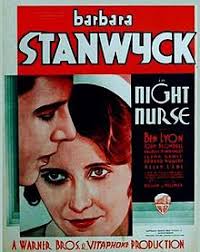
On Aug. 8, 1931 William A. Wellman's B&W Night Nurse) (Warner Bros.) debuts, based on the 1930 novel by Mrs. Fulton Oursler (under the alias Dora Macy), starring Barbara Stanwyck as night nurse Lora Hart, who takes care of the Ritchie children, discovering that they are being slowly starved to death by drug addict Dr. Milton Ranger (Ralf Harolde) and family chauffeur Nick (Clark Gable); Joan Blondell plays nurse B. Maloney; features a scene showing Stanwyck and Blondell in their lingerie, making it more popular?; watch clip.

On Sept. 19, 1931 Norman McLeod's Monkey Business debuts, the Marx Brothers' 3rd film, co-written by Brooklyn-born Sidney Joseph Perelman (1904-79); features funny lines incl. "Look at me: I worked my way up from nothing to a state of extreme poverty"; "Do you suppose I could buy back my introduction to you?"
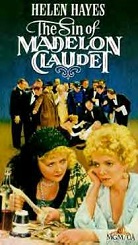
On Oct. 24, 1931 Edgar Selwyn's The Sin of Madelon Claudet (MGM) debuts, written by Charles MacArthur and Ben Hecht based on the play "The Lullaby" by Edward Knoblock, starring Helen Hayes as a wrongly imprisoned high society woman who becomes a thief and ho to put her illegitimate son Lawrence (Robert Young) through medical school.

On Oct. 31, 1931 Frank Capra's Platinum Blonde debuts, starring Clark Gable, solidifying actress Jean Harlow (1911-37) as America's new sex symbol.
On Nov. 18, 1931 the Fourth (4th) Academy Awards awards the best picture Oscar for 1930-1 to RKO Radio's Cimarron (the first Western to win), best actor to Lionel Barrymore for A Free Soul, best actress to Marie Dressler for Min and Bill, and best dir. to Norman Taurog for Skippy.


On Nov. 21, 1931 James Whale's Frankenstein (Universal Pictures), based on the 1818 Mary Wollstonecraft Shelly novel and dir. by gay sockhusker James Whale (1889-1957) (sperm whale?) makes a monster star of English actor Boris Karloff (1887-1969) (makeup by Jack Pierce); English actor Colin Clive (1900-37) (descendant of Baron Robert Clive, founder of the British Indian Empire) plays Dr. Henry Frankenstein (in the novel it was Dr. Victor Frankenstein); Am. actor Dwight Frye (1899-1943) ("the Man with the Thousand-Watt Stare") plays hunchbacked lab asst. Fritz; does $12M box office on a $262K budget; "The monster was the best friend I ever had" (Karloff); "It's alive! It's alive!" (Clive); "When I was nine I played the demon king in Cinderella and it launched me on a long and happy life of being a monster" (Karloff); "His eyes mirrored the suffering we needed" (producer Carl Laemmle Jr.); "His face fascinated me. I made drawings of his head, adding sharp bony ridges where I imagined the skull might have joined" (James Whale); Frankenstein sideshows become the rage in the U.K. and U.S.

In 1931 New York City lesbian poet-playwright Mercedes de Acosta (1893-1968) begins an affair with Greta Garbo, which lasts until next year, after which Acosta pants after her unsuccessfully for years while tongues wag, causing her to have letters to her sealed until 10 years after her death.

On Jan. 2, 1932 Clarence Brown's Emma (MGM) debuts, starring Marie Dressler as housekeeper Emma, who looks after a houseful of grown spoiled children, and finds that rich inventor father Frederick Smith (Jean Hersholt) has left her all in his will, causing them to turn on her, except Ronnie, played by Richard Cromwell, Dressler's personal friend from his days running an art shop in Hollywood, who insists that he be cast; also stars Myrna Loy as Countess Isabelle "Izzy" Smith Marlin; makes a profit of $898K.

On Feb. 12, 1932 Josef von Sternberg's Shanghai Express debuts, based on a story by Harry Hervey, starring Marlene Dietrich as Shanghai Lilly, who reunites with ex-lover Clive Brook aboard a slow-moving train through China, making Hollywood stars of Dietrich and Sternberg; "It took more than one man to change my name to Shanghai Lily."
On Feb. 20, 1932 John G. Adolfi's The Man Who Played God debuts, based on the 1914 play "The Silent Voice" by Jules Eckert Goodman, who adapted it from a story by Gouverneur Morris, starring George Arliss as lip-reader Montgomery Royale, Violet Heming as his babe Mildred Miller, and bleached blonde Bette Davis as his other babe Grace Blair, doing so good that Jack Warner signs her to a 5-year $400/week contract, staying with Warner Bros. for 18 years.


On Mar. 15, 1932 Berthold Viertel's and Fred Zinnemann's The Wiser Sex (original title "The Weaker Sex") (Paramount Pictures) debuts, based on the 1916 Clyde Fitch play "The Woman in the Case", starring Claudette Colbert, Melvyn Douglas, Lilyan Tashman, Ross Alexander, and William "Stage" Boyd, becoming the film debut of Niagara Falls, N.Y.-born Stanislas Pascal Franchot Tone (1905-68), son of Carborundum Co. pres. Frank Jerome Tone.

On Mar. 25, 1932 W.S. Van Dyke's Tarzan the Ape Man (MGM) debuts, based on the Edgar Rice Burroughs books, making a star of Romanian-born Olympic swimming champ Peter John "Johnny" (Janos) (Johann Peter) Weissmuller (Weißmüller) (1904-84), becoming the first of 12 Tarzan films; Tarzan's distinctive call is first heard in this film, created by sound recordist Douglas Shearer from an Austrian yodel sped-up and played backwards; Maureen O'Sullivan plays Jane Parker.



On Apr. 9, 1932 Howard Hawks' Scarface: The Shame of a Nation (United Artists) debuts, written by Ben Hecht based on the 1929 Al Capone novel by Armitage Trail stars Paul Muni as Antonio "Tony" Camonte, Ann Dvorak as Francesca "Cesca" Camonte, Osgood Perkins as Camonte's lt. John "Johnny" Lovo, and parts-hair-in-middle George Raft (Ranf) (1901-80) as coin-flipping Guino "Little Boy" Rinaldo, playing the role so well that the public believes he's a real-life gangster, causing him to become one of the top Hollywood celebs of the decade whether he earned it or not?; does $600K box office on an $800K budget; after being invited to a party at Hawks' house by "Poppy" actress Karen Morley and stealing the show by dancing with George Raft, MGM releases from her chorus girl contract and Hawks gets her mother Anna Lehr's permission to petition the Superior Court to work as a minor, becoming the film debut of 20-y.-o. New York City-born Ann Dvorak (pr. VOR-SHAK) (nee Anna McKim) (1911-79), who is billed 2nd after Muni and becomes a star, dubbed "Hollywood’s New Cinderella", causing Warner Bros. to buy her contract from Howard Hughes, who holds it back from release by censors because of the suggestion of incest between Capone and his sister, causing it to be recut by Hughes without Hawks' approval, causing two versions of the film to be released at the same time; Raft goes on to become a friend of Bugsy Siegel, Meyer Lansky, and other Mafiosi, and give Tallulah Bankhead a bad case of gonorrhea, causing her to get a hysterectomy and utter the soundbyte: "Don't think this has taught me a lesson."

On May 28, 1932 Mervyn Le Roy's Two Seconds (First Nat. Pictures), debuts, based on the Elliott Lester play about how long it takes a condemned prisoner to die in the electric chair, starring Edward G. Robinson as John Allen, and Vivienne Osborne as Shirley Day, becoming the film debut of Pitman, N.J.-born good singer Preston S. Foster (1900-70) as Bud Clark.

On June 2, 1932 George Cukor's What Price Hollywood? (RKO Pathe) debuts, based on a story by Adela Rogers St. Johns about the "real" Hollywood, starring Constance Bennett as "America's Pal" Mary Evans, and Lowell Sherman as dir. Max Carey, who commits suicide after she leaves him for playboy Lonny Borden (Neil Hamilton), ruining her career; puts Cukor on the A-list of Hollywood dirs.; does $571K box office on a $416K budget.

On June 4, 1932 Roy Mack's Pie, Pie Blackbird (Warner Bros.) debuts, starring "Black Garbo" Nina Mae McKinney (1912-67), along with the jazz band of Eubie Blake and Noble Sissle, becoming the debut of the sensational tap-dancing Nicholas Brothers Fayard Nicholas (1914-2006) and Harold Nicholas (1921-2000); it incl. It Takes a Blackbird to Make the Sweetest Pie.
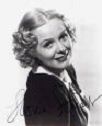
On June 4, 1932 Archie L. Mayo's Street of Women debuts, becoming the film debut of Calif.-born blonde babe Gloria Stuart (1910-2010).


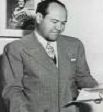
On July 2, 1932 German-Am. Jewish MGM studio exec Paul Bern (Levy) (b. 1889) marries glamorous actress Jean Harlow, then on Sept. 5 commits suicide, found naked and shot in the head in their secluded driveway on Easton Dr. in Beverly Hills, Calif. with a note saying "Last night was only a comedy", becoming a big scandal for MGM when she refuses to talk, and his former common-law wife Dorothy Millette (b. 1886) commits suicide on Sept. 7 by jumping in the Sacramento River after taking her shoes and jacket off; the official story is suicide because of sexual impotence; mob-connected MGM vice-pres. Edgar Joseph "Eddie" Mannix (1891-1963) (who is later implicated in the death of George Reeves but is not charged) becomes a suspect but is never charged; she wouldn't let the animal perform perverted sex on her so he ended it?; he was impotent, so that's why he ended it?; murdered by Millette?; a studio coverup, with the suicide note really being an earlier makeup note?
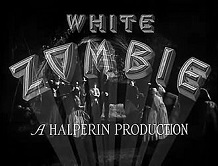
On July 28, 1932 Victor Halperin's White Zombie (United Artists) debuts, based on William Seabrook's 1929 novel "The Magic Island and set in Haiti, starring Bela Lugosi as voodoo master Murder Legendre preying on Madeleine Short Parker (Madge Bellamy) in the first feature length zombie film; the sequel is "Revolt of the Zombies" (1936); "With these zombie eyes he rendered her powerless. With this zombie grip he made her perform his every desire."

On Aug. 3, 1932 Michael Curtiz' B&W Doctor X (First Nat. Pictures) (Warner Bros.) debuts, based on the 1931 play "The Terror" by Howard W. Comstock and Allen C. Miller, a horror film starring Lionel Atwill as Dr. Jerry Xavier, Scream Queen Fay Wray as his daughter Joan Xavier, Lee Tracy as Daily World reporter Lee Taylor, and Preston Foster as surgeon slash cannibal monster Dr. Wells; does $594K box office on a $224K budget.


On Aug. 10, 1932 Norman Z. MacLeod's Horse Feathers (Paramount) debuts, starring the Marx Brothers (Groucho as Prof. Wagsdorff) and co-written by S.J. Perelman, co-starring "Ice Cream Blonde" Thelma Todd (1905-35); contains the lines: "Why don't you bore a hole in yourself and let the sap run out?"; "The dean is furious. He's waxing wroth. - Is Roth out there too? Tell Roth to wax the dean for a while"; "You've got the brain of a 4-year-old boy, and I bet he was glad to get rid of it"; "I'd flog you like a horse but I haven't got a horse"; the movie climaxes with them winning a football game by taking the ball into the end zone on a horse-drawn garbage wagon.

On Sept. 11, 1932 Edmund Goulding's B&W Grand Hotel (MGM) debuts, written by William A. Drake based on the 1929 novel "Menschen im Hotel" by Viki Baum, featuring an all-star cast in a hotel where "People coming, going. Nothing ever happens" (Lewis Stone); world-weary ballerina Grusinskaya (Greta Garbo) delivers the immortal soundbyte "I vant to be alone" to Baron von Gaigern (John Barrymore); leggy Joan Crawford plays stenographer Flaemmchen, Wallace Beery plays Gen. Dir. Preysing, Lionel Barrymore plays Otto Kringelein, Lewis Stone plays disabled WWI vet Dr. Otternschlag; does $2.594M box office on a $750K budget.

On Sept. 16, 1932 (Fri.) after her RKO film "Thirteen Cousins" (debuts Oct. 14) (playing Hazel Cousins) receives poor test screenings, 24-y.-o. Welsh-born blonde-blue actress Millicent Lilian "Peg" Entwistle (b. 1908), ex-wife of actor Robert Keith (father of actor Brian Keith) jumps to her death from the last letter of the white HOLLYWOODLAND sign overlooking Hollywood on Mt. Lee (built in 1923 to advertise a real estate development); her suicide note says "I am afraid, I am a coward. I am sorry for everything. If I had done this a long time ago, it would have saved a lot of pain. P.E."; in 1949 the last four letters are taken down; on Sept. 20 a letter arrives from the Beverly Hills Playhouse offering her the lead role in a production in which her char. commits suicide in the final act.

On Oct. 20, 1932 James Whale's The Old Dark House (Universal Pictures) debuts, based on the 1927 J.B. Priestley novel "Benighted", a horror comedy film about the haunted Welsh mansion of the Femm family incl. Horace, Rebecca, and Saul, starring Boris Karloff as mute alcoholic butler Morgan, Malvin Douglas as Roger Penderel, Charles Laughton as Sir William Porterhouse, Lilian Bond as Gladys DuCane Perkins, Raymond Massey as Philip Waverton, and Gloria Stuart as his wife Margaret; it's a flop in the U.S. but a big hit in England; Elspeth Dudgeon (billed as John Dudgeon) is the only actor who looks old enough to play the 102-y.-o. Femm family patriarch Sir Roderick Femm.

On Oct. 21, 1932 Lewis Milestone's Rain (United Artists) debuts, based on the play by John Colton, set in the South Seas and filmed on Santa Catalina Island, starring Joan Crawford as ho Sadie Thompson, and Walter Huston as conflicted missionary Alfred Davidson, who wants to reform her while trying to restrain his hormones, and finally takes her, then commits suicide on the beach; panned by critics and a box office flop.

On Oct. 21, 1932 Christy Cabanne's The Red-Haired Alibi debuts, based on the Wilson Collison novel, introducing super-cute, big-smiling, precocious, multi-talented, blonde-blue, living doll child prodigy Shirley Jane Temple (1928-2014), whose mother always makes sure her hair has 56 curls, after which she takes over the Hollywood scene, giving depressed Americans a pick-up while rescuing Hollywood financially, becoming the top U.S. box office draw in 1935-8; in 1934 her daddy George Temple gets vanity license plate 6T423, 6 standing for her age, T for Temple, and 423 for her birthday.

On Oct. 21, 1932 Ernst Lubitsch's Trouble in Paradise (Paramount Pictures) debuts, a romantic comedy from Paramount that slips in before the Production Code and ends up banned in 1935-68, starring Miriam Hopkins as a beautiful pickpocket, and Herbert Marshall as a master thief, who has to decide between her and perfume manufacturer Kay Francis; "Marriage is a beautiful mistake which two people make together"; in 1932-6 Kay Francis (1905-68) becomes a top Warner Bros. star, and one of the highest-paid persons in the U.S. by 1935, co-starring frequently with William Powell, and becoming known as a clothes horse and for her inability to pronounce the letter r ("Wavishing Kay Fwancis"); too bad, she gets too big for her expensive panties and ends up getting shuttled to B-movies (programmers).

On Oct. 28, 1932 William A. Seiter's Hot Saturday debuts, starring Cary Grant and Randolph Scott (Crane) (1898-1987), who end up living in the same house for 12 years of hot Saturdays, causing gay bud rumors.
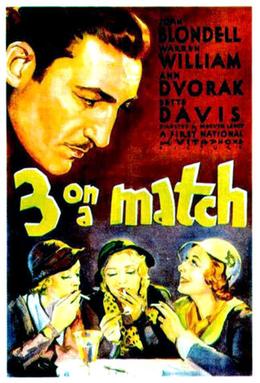
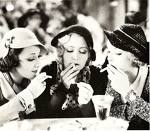
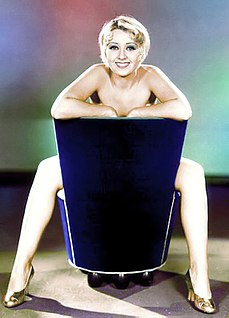
Female Hollywood actors begin to fight for their liberation, albeit at first leaning on a hubby? On Oct. 29, 1932 Mervyn LeRoy's B&W Three on a Match (Warner Bros.) debuts, starring Joan Blondell as Mary Keaton, Bette Davis as Ruth Westcott, and Ann Dvorak as Vivian Revere Kirkwood, childhood friends who grow up, reuinite, and share a match, believing the Crimean War superstition that the last one to light their cig will be the first to die; Warren William plays Vivian's successful atty. hubby Robert Kirkwood, who bores her, causing her to flee for cocaine and hot sex with gambler Michael Loftus (Lyle Talbot), along with her son Robert Jr., who is kidnapped by the gang of boss Ace (Edward Arnold), who has Michael killed for balking at murdering him, after which Vivian saves him by hiding him under the bed and writing a message on her nightgown with lipstick before jumping out of a 4th-story window and croaking to fulfill the superstition; Bette Davis plays babysitter Ruth Westcott; Humphrey Bogart plays Harve, in his first gangster role, slapping Vivian around; Dvorak (pr. vor-shak) (last principal actor to be cast), after finding out that she was paid the same as the little boy who played her son, and influenced by freelance-loving new \ (Mar. 17) English actor hubby Leslie Fenton (1902-78) (her co-star in "The Strange Love of Molly Louvain") walks out of her contract to go on an 8-mo. Euro honeymoon, and when she returns she completes her contract on permanent suspension, no longer given starring roles and increasingly bad scripts, after which she freelances and sues the studio in 1936, becoming the first Hollywood rebel until James Cagney and Bette Davis later that year, going on to become an aspiring pansophist, pub. an 18-vol. world history and work for the WWII British war effort as an ambulance driver et al.; released during the Little Lindbergh kidnapping scandal, the film almost gets banned by censors until Jason Joy of the Studio Relations Committee talks them out of it; a risque publicity photo of Blondell also pisses-off the censors, who later ban it under the Hays Code.

On Oct. 30, 1932 Archie L. Mayo's Night After Night debuts, based on the short story "Single Night" by Louis Bromfield, becoming the screen debut of Mary Jane "Mae" West (1893-1980) after abandoning Broadway and its censors and getting a $5K a week contract with Paramount, playing Maudie Triplett (based on Texas Guinan, who is not allowed to act because she's too old), moll of gangster Joe Anton, played by George Raft (Ranft) (1901-80), in his first leading role; after insisting on rewriting her scenes to add her trademark brand of risque humor, Raft comments "She stole everything but the cameras"; "Goodness, what beautiful diamonds you are wearing" (coat check girl); "Goodness had nothing to do with it, dearie" (Mae West); by the end of the decade West is the highest paid woman in Hollywood and the entire U.S.; she once turns a $16K real estate investment into $5M; Raft and West die within two days of each other in 1980 and their corpses wind up in the same morgue at the same time.

On Nov. 10, 1932 Mervyn LeRoy's I Am a Fugitive from a Chain Gang (Warner Bros.) debuts, written by Howard J. Green and Brown Holmes based on the autobio. by Robert Elliott Burns, starring Paul Muni as wrongfully convicted chain gang convict Sgt. James Allen, who escapes to Chicago, sets up a successful construction firm, then is blackmailed by his boarding house owner Marie Woods (Glenda Farrell) into marrying him, after which he falls for Helen Vinson, and is betrayed to the authorities when he asks for a divorce, uttering the parting line: "I steal" in response to Helen's question: "How do you live?"; Preston Foster plays Pete.
On Nov. 18, 1932 the Fifth (5th) Academy Awards awards the best picture Oscar for 1931-2 to MGM's Grand Hotel, best actor to Fredric March for Dr. Jekyll and Mr. Hyde along with Wallace Beery for The Champ, best actress to Helen Hayes for The Sin of Madelon Claudet, and best dir. to Frank Borzage for Bad Girl; Frances Marion receives an Oscar for best story for The Champ.

On Dec. 17, 1932 Henry Koster's The Adventure of Thea Roland debuts, becoming the dir. debut of German-born Jew Henry Koster (Hermann Kosterlitz) (1905-88), who after his next film is forced by the Nazis to flee Germany, going on to become a leading dir. in Hollywood.
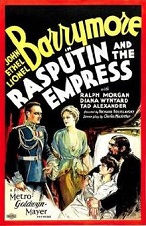
On Dec. 23, 1932 Richard Boleslawski's Rasputin and the Empress (MGM) debuts, starring Lionel Barrymore as Rasputin, Ethel Barrymore as Tsarina Alexandra, and John Barrymore as Prince Chegodieff; does $1.379M box office on a $1.022 budget; too bad, inaccurate portrayals result in a lawsuit and the all persons fictitious disclaimer, which becomes a Hollywood std.; watch video.
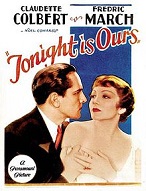
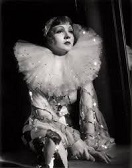
On Jan. 21, 1933 Stuart Walker's B&W Tonight is Ours (Paramount Pictures) debuts, a remake of the 1927 film written by Edwin Justus Mayer based on the Noel Coward play "The Queen Was in the Parlour", starring Claudette Colbert as Princess Nadya, and Fredric March as Sabien Pastal; Colbert stuns with a Harlequin costume; view clip.

On Jan. 26, 1933 Benjamin Stoloff's Joe Palooka debuts, based on the Ham Fisher comic strip, starring Manhattan, N.Y.-born James Francis "Jimmy" "the Schnozzola" Durante (1893-1980) as boxing mgr. Knobby Walsh (Junior), who sings his theme song Inka Dinka Doo; also stars Lupe Velez.

On Mar. 2, 1933 Merian C. Cooper's and Ernest B. Schoedsack's King Kong: The Eighth Wonder of the World debuts, starring a 50-ft. monster ape (brought to life by Willis O'Brien) brought from Skull Island by Carl Denham (Robert Armstrong) and John Driscoll (Bruce Cabot) to New York City on Capt. Englehorn's ship Venture; Kong kidnaps Ann Darrow, played by "Queen of Screams" Fay Wray (1907-2004), and is shot down from the top of the Empire State Bldg. by four biplanes; Denham speaks the epitaph "It wasn't the airplanes, it was beauty killed the beast"; Edgar Wallace goes to Hollywood to work on the film, but dies before it is completed; freelance actor Cabot goes on to a long career as a supporting actor, losing the role of the Ringo Kid in "Stagecoach" (1939) to John Wayne, which launches Wayne's superstar career, after which they become friends; brings in $1.85M on a $672K budget.
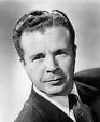



On Mar. 9, 1933 Lloyd Bacon's 42nd Street (Mar. 9) (produced by Darryl F. Zanuck) debuts, based on the 1932 novel by Bradford Ropes, starring Dick Powell (1904-63) and Ruby Keeler (1909-93), along with Warner Baxter, Bebe Daniels, and Ginger Rogers in a backstage movie musical choreographed by genius Busby Berkeley (1895-1976) that resurrects the movie musical genre and saves Warner Brothers from bankruptcy in the depths of the Great Depression; it boosts FDR and his New Deal, and the 42nd St. Special publicity train that starts in Denver, Colo. arrives in Washington, D.C. on Mar. 4, his inauguration day; Bacon becomes dir. after Mervyn LeRoy gets sick; at the end Powell and Keeler lower a screen reading "Asbestos"; incl. the songs Shuffle Off to Buffalo, Young and Healthy, and 42nd Street (finale) ("Come and meet those dancing feet/ On the avenue I'm taking you to/ 42nd Street"), by Al Dubin and Harry Warren (Salvatore Antonio Guarana) (1893-1981), the first U.S. composer to compose primarily for films, who joins Warner Brothers and goes on to write scores for 33 musicals (incl. 18 with Berkeley), then moves to 20th Cent. Fox in 1940, then MGM in 1944, followed by Paramount in the early 1950s.

On Mar. 15, 1933 Charles Chauvel's In the Wake of the Bounty (Australia's first sound feature) debuts, becoming the film debut of Tasmanian-born actor Errol Leslie Flynn (1909-59) as Fletcher Christian, wearing a blonde wig.

On Mar. 27, 1933 Arthur Hoerl's The Shadow Laughs debuts, based on a 1931 story by Walter B. Gibson, starring Hal Skelly, Rose Hobart, and Harry T. Morey, becoming the film debut of closet gay Latin lover Cesar Julio Romero Jr. (1907-94), son of Cuban nat. hero Jose Marti's daughter Maria Mantilla.
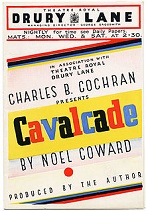
On Apr. 15, 1933 Frank Lloyd's Cavalcade (Fox Film Corp.) debuts, based on the 1931 Noel Coward play, tracing the lives of the British Marryot family (who like to celebate each New Year with a midnight toqst) from Queen Victoria to the Great Depression; does $4.5M box office on a $1.18M budget.

On May 27, 1933 Mervyn LeRoy's Gold Diggers of 1933 debuts, about the Broadway musical business struggling during the Depression; yet another Busby Berkeley-choreographed musical, a sequel to 1929's "Gold Diggers of Broadway", based on a play by Avery Hopwood; stars Dick Powell as rich Boston scion Robert Treat Bradford AKA Brad Roberts, who sneaks to New York City to become a songwriter and performer, and Ruby Keeler as his performer babe Polly Parker, who Brad's family thinks is a you know what; Warren William plays Brad's snooty brother J. Lawrence Bradford; Guy Kibbee plays lawyer Faneuil H. "Fanny" Peabody; also stars Ginger Rogers, Joan Blondell, and Aline MacMahon as gold diggers Fay, Carol, and Trixie ("Another look with those bedroom eyes and I'll break your leg"); Ned Sparks plays ever-broke producer Barney Hopkins, producing "Forgotten Melody"; features Billy Barty playing a child who looks up a girl's dress and raises the curtain on naked showgirls, also Powell using a can opener to get Keeler out of an iron maiden, all pissing-off the Catholic Legion of Decency, which ramps up pressure for enforcing the 1930 Production Code, getting it done by next year; the opening features Ginger Rogers introducing the song Were in the Money, by Harry Warren (1893-1981) and Al Dubin in a showy musical with girls dressed up like you know what, singing the chorus in Pig Latin ("We're in the money, we're in the money, we've got a lot of what it takes to get along/ We're in the money, the sky is sunny, Old Man Depression, you are through doing us wrong"); also features the songs Pettin' in the Park, The Shadow Waltz, and Remember My Forgotten Man (about the downtrodden men of the Great Depression).

On May 27, 1933 A. Edward Sutherland's International House debuts, set in the Internat. House Hotel in Wuhu, China (200 mi. from Shanghai), starring W.C. Fields as Prof. Henry R. Quail, and Peggy Hopkins Joyce as herself; a W.C. Fields punchline about Joyce sitting on her pussy upsets the Hays Office, which begins censoring films next year.
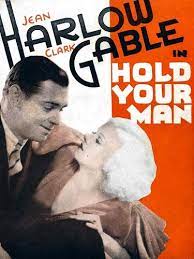
On June 30, 1933 Sam Wood's B&W Hold Your Man (MGM) debuts, starring Clark Gable and Jean Harlow (3rd of 6 films together) as small-time con man Eddie Hall and hot chick Ruby Adams, who meet by accident when he lets himself into her apt. to elude police, and end up falling in love, until he kills one of her admirers and flees again, leaving her to take the rap and get sentenced to a reformatory for two years, ending up in the same common room as Eddie's ex-babe Gypsy Angecon, who become enemies; when Gypsy is released she tells Eddie that Ruby is pregnant with his child, causing him to visit her under an alias and being found out, marrying her at the last minute before the police catch him; later he is released from prison, and reunites with Ruby along with their young son; does $1,073,000 box office on a $266K budget; Harlow sings the theme song Hold Your Man.

On July 1, 1933 Alfred E. Green's Baby Face (Warner Bros.) debuts, written by Darryl F. Zanuck under the alias Mark Canfield, about young woman Lily Powers (Barbara Stanwyck) leaving Erie, Penn. for the Big Apple and sleeping to the top using her womanly wiles while quoting Nietzsche; banned by the New York censorship board, causing Warner Bros. to recall it and cut 5 min. to pass the censors, becoming an excuse to impose the 1934 Hays Code; the full-length version is discovered in 2005 in the nitrate vault of Wright-Patterson AFB in Dayton, Ohio.
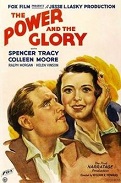
On Aug. 16, 1933 William K. Howard's The Power and the Glory (Fox Film Corp.) debuts, based on the life of C.W. Post, founder of Gen. Foods, who starts at the bottom and works his way up; written by Preston Sturges (first script) on speculation, becoming the first spec script in Hollywood history, purchased by Fox for $17.5K plus profit sharing, gaining him mucho publicity; stars Spencer Tracy as Tom Garner, Ralph Morgan as his best friend Henry, and Colleen Moore as Sally Garner; "The first motion picture in which narratage was used as a method of telling a dramatic story" (bronze plaque erected by the studio at the theater in New York City that hosts the world premiere); does $563K box office, becoming an inspiration for "Citizen Kane" (1941); view clip.
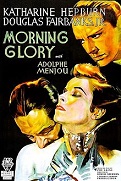
On Aug. 18, 1933 Lowell Sherman's Morning Glory (RKO Radio Pictures) debuts, written by Howard J. Green based on a play by Zoe Akins, starring Katharine Hepburn as small town aspiring stage actress Eva Lovelace, who finds love and fame in the big city with Joseph Sheridan (Douglas Fairbanks Jr.) and Louis Easton (Adolphe Menjou), netting her a best actress Oscar in her 2nd year in Hollywood; Hepburn's 3rd film; does $582K box office on a $239K budget.

On Oct. 6, 1933 Wesley Ruggles' I'm No Angel debuts, Mae West's 3rd film, and 2nd film with Cary Grant, who plays a playboy to her circus floozy with a maid named Beulah; having a life-long fantasy of being a lion tamer, she refuses a stunt double and goes into a lion cage armed only with a whip; "A story about a gal who lost her reputation - and never missed it"; "Beulah, peel me a grape"; the advent of motion picture ratings causes her to begin using double entendres, incl. the famous soundbyte, "Is that a pistol in your pocket or are you happy to see me?"


On Oct. 7, 1933 Raoul Walsh's The Bowery (20th Cent. Pictures) debuts, based on the novel by Michael L. Simmons about the Bowery in the Gay Nineties, "the Livest Mile on the Face of the Globe", starring Wallace Beery as saloon owner Chuck Connors, and George Raft as rival saloon owner Steve Brodie, first man to jump off the Brooklyn Bridge (who gets in a great fight scene with Raft), along with Jackie Cooper as Swipes McGurk, Fay Wray as Lucy Calhoun, and Pert Kelton as Trixie Odbray; the film debut (uncredited) of Jamestown, N.Y.-born Lucille Desiree Ball (1911-89), who is picked to be a Goldwyn Girl this year, and ends up under contract to RKO, where she becomes known as "Queen of the Bs" for her many small parts, moving to MGM after marrying Desi Arnaz in Nov. 1940, and ending up with her own TV show "I Love Lucy" (1951), which rockets her to the top with her own studio Desilu Productions; she dyes her hair red with expensive henna donated by a Saudi sheik.

On Oct. 10, 1933 Robert N. Bradbury's Riders of Destiny (Monogram Pictures) debuts, a Western musical starring John Wayne as Singin' Sandy Saunders (2nd singing cowboy after Ken Maynard in 1929), who wears a black 10-gal. hat, and whose voice is dubbed by the dir.'s son, becoming Wayne's first pairing with George "Gabby" Hayes.
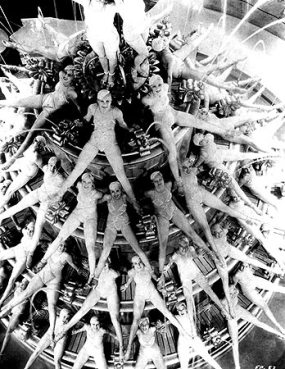
On Oct. 21, 1933 Lloyd Bacon's Footlight Parade debuts, starring James Cagney as Chester Kent, who creates live prologues for talkies; also stars Dick Powell as Scotty Blair, and Ruby Keeler as Bea; Busby Berkeley dance routines feature a 20K gal./min waterfall; filmed before the 1934 Hays Code, it has multiple references to prostitution, and features the super-sexy women-are-for-you-know-what number By a Waterfall, staged on a special soundstage constructed by Warner Bros. for Busby Berkeley, one of the largest ever built; "You've laid yourself wide open for a crack, we'll let it go."
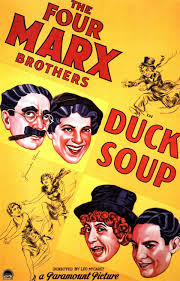
On Nov. 17, 1933 Leo McCarey's Duck Soup (Paramount) debuts, the last Marx Brothers comedy to feature Zeppo, and the 5th and last released by Paramount after mediocre box office; features "King of the Slow Burn" comedic actor Edgar Livingston Kennedy (1890-1948) as a lemonade vendor; contains the lines: "Take a card. You can keep it. I've got fifty-one left"; "What is it that has four pairs of pants, lives in Philadelphia, and it never rains but it pours?"; "My husband is dead. - I'll bet he's just using that as an excuse"; "This is a gala day for you. - That's plenty. I don't think I could manage more than one gal a day."


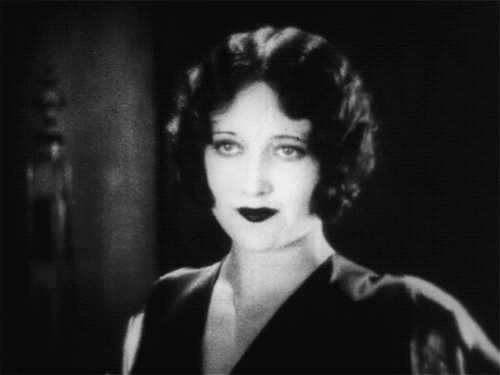
On Nov. 24, 1933 Robert Z. Leonard's Dancing Lady (MGM) debuts, becoming the film debut of Fred Astaire (Frederick Austerlitz) (1899-1987), and the first of nine onscreen pairings of Clark Gable and Joan Crawford (1905-77); also stars Franchot Tone, May Robson, Winnie Lightner, and Ted Healy and the Three Stooges (Moe, Larry, and Curly); does $2.4M box office on a $923K budget; features the songs Heigh Ho, and The Gang's All Here.
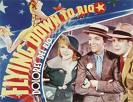




On Dec. 29, 1933 Thornton Freeland's and George Nicholls Jr.'s Flying Down to Rio (RKO Radio Pictures) (B&W with color-tinted sequence) debuts, starring Dolores Del Rio (first major actress to wear a 2-piece bathing suit onscren) as Belinha De Rezende, and Gene Raymond as Roger Bond, making a Hollywood star of "Can't act - can't sing - balding - dances a little" Fred Astaire (Frederick Austerlitz) (1899-1987) in his first onscreen pairing with Ginger Rogers (Virginia Katherine McMath) (1911-95) as Fred Ayres and Honey Hale, becoming their first of nine RKO musicals and one at MGM; does $1.545M box office on a $462K budget; Astaire-Rogers musicals incl. Mark Sandrich's The Gay Divorcee (1934), William A. Seiter's Roberta (1935), Mark Sandrich's Top Hat (1935), Follow the Fleet (1936), George Stevens' Swing Time (1936), Mark Sandrich's Shall We Dance? (1937), Mark Sandrich's Carefree (1938), H.C. Potter's The Story of Vernon and Irene Castle (1939), and Charles Walters' The Barkleys of Broadway (1949); "Fred gave Ginger class, while Ginger gave Fred sex appeal."

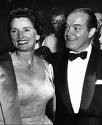
In 1933 English-born Am. comedian Leslie Townes "Bob" Hope (1903-2003) meets Bronx-raised bar singer Dolores Reade (DeFina) (1909-2011) after seeing her sing "Did You Ever See a Dream Walking" at the Vogue Club in New York City; they marry on Feb. 19, 1934, and end up in the longest star marriage in Hollywood history (until ?).
In 1934 the Hays (Motion Picture Production) Code, adopted by the Motion Picture Assoc. of Am. (MPAA) in 1930 and backed by the Legion of Decency ends years of leniency in U.S. movies and institutes official film censorship in Hollywood, which becomes a challenge to bring down, causing it to come down perhaps too fast in the 1960s; "Pointed profanity (this incl. the words God, Lord, Jesus, Christ - unless used reverently - Hell, S.O.B., damn, Gawd), or every other profane or vulgar expression however used, is forbidden"; "The inanities blessed by the Hays Office are more genuinely corrupting than any pornography (Joseph Wood Kruch); "The Hays Office warned us that we couldn't show the heroine as a prostitute. We had to put a sewing machine in her apartment, so in that way she was not a whore but a seamstress" (Fritz Lang, about the 1940 film "Man Hunt").

On Feb. 22, 1934 Frank Capra's It Happened One Night debuts, based on the story "Night Bus" by Samuel Hopkins Adams, becoming the first of the 1930s screwball comedies, and the first movie to win best picture, dir., actor, actress, and screenplay at the Oscars ("One Flew Over the Cuckoo's Nest" in 1975 and "The Silence of the Lambs" in 1991); stars Claudette Colbert as spoiled heiress Ellie Andrew, who stops passing cars by showing her legs, and Clark Gable as newspaper reporter Pete Warne, who meets her on a bus and ends up you know what, appearing sans undershirt, causing U.S. sales of undershirts to plummet; does $2.5M box office on a $325K budget; Clark Gable ended up in the flick after refusing to play opposite Joan Crawford in a soap opera type film, causing Louis B. Mayer to punish him by loaning him to Columbia Pictures; after it becomes a hit, Mayer gets Gable back and keeps him; watch trailer; watch video.

On Feb. 23, 1934 Wesley Ruggles' Bolero (Paramount) debuts, named after Maurice Ravel's 1928 musical composition, a musical starring George Raft as Am. dancer Raoul DeBaere, who tries to become king of the European nightclub circuit; Carole Lombard plays Helen Hathaway; features a fan dance by Sally Rand.

On Mar. 10, 1934 Gus Meins' and Charley Rogers' Babes in Toyland (Hal Roach Studios), based on the 1903 Victor Herbert operetta is a musical comedy starring Stan Laurel and Oliver Hardy as Stannie Dum and Ollie Dee, who live in a shoe with Mother and Little Bo Peep, Mickey Mouse et al., and fight off villainous mortgage holder Silas Barnaby (Henry Brandon).
On Mar. 16, 1934 the Sixth (6th) Academy Awards awards the best picture Oscar for 1932-3 to Fox's Cavalcade along with best dir. to Frank Lloyd, best actor to Charles Laughton for The Private Life of Henry VIII, and best actress to Katharine Hepburn for Morning Glory.

On Apr. 13, 1934 Al Christie's Hotel Anchovy debuts, introducing the Ritz Brothers; in 1937 they get their own starring Fox series, starting with "Life Begins in College"; too bad, they walk out in 1939, move to Universal Pictures, and bomb, making their last film "Never a Dull Moment" in 1943.
On Apr. 23, 1934 after starting a scandal by courting her while she's still married and getting her a Mexican divorce 10 days earlier, actor George Jessel marries actress Norma Talmadge; they divorce on Aug. 11, 1939, after which he causes another scandal by breaking into her house and firing a pistol at her new lover.

On May 3, 1934 Howard Hawks' Twentieth Century (Columbia Pictures) debuts, based on the 1932 Ben Hecht-Charles MacArthur Broadway play set on the 20th Century Limited train en route from Chicago to New York City, a screwball comedy starring John Barrymore as Broadway impresario Oscar "O.J." Jaffe, Carole Lombard as his discovery Lily Garland AKA Mildred Plotka, Walter Connolly as Oliver Webb, and Roscoe Karns as Owen O'Malley; launches the screwball comedy genre along with "It Happened One Night" (1934).
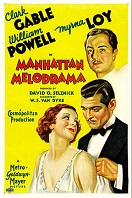
On May 4, 1934 Woodbridge S. Van Dyke's B&W Manhattan Melodrama (MGM) debuts, based on a story by Arthur Caesar, starring Clark Gable and William Powell as childhood pals Edward J. "Blackie" Gallagher and Jim Wade, who grow up to become a casino owner and a district atty., who prosecutes him for murder and gets him a death sentence on the chair, which helps him become governor; Myrna Loy plays Powell's babe Eleanor Packer; Leo Carrillo plays Father Joe; does $1.233M box office on a $355K budget.
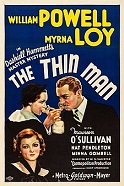
On May 23, 1934 Woodbridge S. Van Dyke's B&W The Thin Man (MGM) debuts, based on the 1932 Dashiell Hammett novel, starring William Horatio Powell (1892-1984) and Myrna Loy (Myrna Adele Williams) (1905-93) as married sleuths Nick and Nora Charles (Charalambides), along with their wire-haired terrier Asta; Edward Ellis plays the Thin Man, inventor Clyde Miller Wynant; Maureen O'Sullivan plays Dorothy Wynant; Caesar Romero plays villain Chris Jorgenson; based on Hammett's relationship with Lillian Hellman after he moves to Los Angeles; spawns five sequels, After the Thin Man (1936), Another Thin Man (1939) (introducing Nick Jr.), Shadow of the Thin Man (1941), The Thin Man Goes Home (1944), and Song of the Thin Man (1947).

On June 28, 1934 John Cromwell's Of Human Bondage debuts, based on the 1915 W. Somerset Maugham novel, starring Leslie Howard as club-footed medical student Philip Carey, and Bette Davis as his cruel babe Mildred Rogers, a ho who comes down with syphilis; too bad, the Hays Office forces Mildred to be changed to a waitress who comes down with TB, and be cheating on Carey's friend instead of being a ho, threatening a $25K fine; after sensational reviews come out, Davis' struggling career skyrockets, and she becomes a star; does $592K box office on a $403K budget.



On July 22, 1934 (eve.) (his birthday) after being named the first Public Enemy No. 1, and despite a painful but ineffective plastic surgery, John Dillinger (b. 1903) is killed (assassinated?) by 19 FBI agents and a bunch of local cops outside the Biograph Theater in Chicago, Ill. after being betrayed by the "Woman in Red" Anna Sage (1892-1969) (actually wearing an orange skirt) (a Romanian madame facing deportation on a morals charge, who is deported anyway); fans dip handkerchiefs in his blood at the death scene; he is buried under 5 ft. of cement and steel to deter souvenir seekers in Crown Point, Ind., in the same cemetery as Pres. Benjamin Harrison; he had just seen the 1934 movie Manhattan Melodrama, starring William Powell, Clark Gable, and Myrna Loy; future Conn. Dem. Sen. (1959-71) Thomas Joseph Dodd (1907-71) participates in the trap as an FBI special agent.

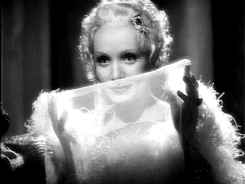

On Sept. 15, 1934 Josef von Sternberg's The Scarlet Empress (Paramount) debuts, written by Eleanor McGeary based on her diary, starring Marlene Dietrich as Catherine II the Great, Louise Dresser as Empress Elizabeth, Shalom "Sam" Jaffe (1891-1984) in his film debut as halfwit Grand Duke Peter (Tsar Peter III), and John Davis Lodge as Count Alexei.
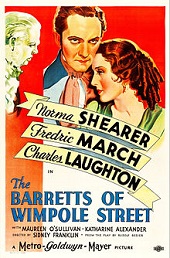
On Sept. 21, 1934 Sidney Franklin's The Barretts of Wimple Street (MGM) debuts, produced by Irving Thalberg based on the 1930 play by Rudolf Besier, starring Norma Shearer and Fredric March as courting English poets and lovers Elizabeth "Ba" Barrett and Robert Browning, and Charles Laughton as their stern father Edward Barrett; does $1.258M domestic and $1.085M foreign box office on an $820K budget.

On Sept. 28, 1934 John Ford's Judge Priest (Fox) debuts, based on the works of Irvin S. Cobb, set in post-reconstruction Ky., starring Will Rogers as Judge William "Billy" Priest, Tom Brown as Jerome Priest, Anita Louise as Ellie May Gillespie, and Henry B. Walthall as Rev. Ashby Brand, reviving his career.

On Nov. 9, 1934 William K. Howard's Evelyn Prentice debuts, starring William Powell, Myrna Loy, and Una Merkel, becoming the film debut of Catherine Rosalind Russell (1907-76).
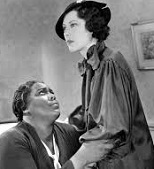
On Nov. 26, 1934 John M. Stahl's B&W Imitation of Life (Universal Pictures) debuts, based on the 1933 Fannie Hurst novel, starring Claudette Colbert as white widow Beatrice "Bea" Pullman, who takes in black housekeeper Delilah Johnson (Louise Beavers), whose daughter Peola (Fredi Washington) has a light complexion and passes as white, and dates Stephen Archer (Warren William), causing her to end up treating her mother like merde; Rochelle Hudson plays Bea's daughter Jesse Pullman; remade in 1959 with Lana Turner.
In 1934 Columbia Pictures launches its Short Subject Dept., cranking out 529 films produced by Jules White by 1957 incl. the Three Stooges, Buster Keaton, Charley Chase, Andy Clyde, Hugh Herbert, and Harry Langdon, then releasing almost 400 to TV.

In 1934 Filley, Neb.-born Robert Taylor (Spangler Arlington Brugh) (1911-69) signs with MGM Studios for a measly $35 week, becoming the lowest paid contract actor in Hollywood; he stays with them 25 years - his 21st cent. replacement Hugh Jackman doesn't work that cheap?

On Jan. 11, 1935 Henry Hathaway's The Lives of a Bengal Lancer (Paramount) debuts, based on the 1930 novel by Maj. Francis Yeats-Brown, starring Gary Cooper as Lt. Alan McGregor, Franchot Tone as Lt. Forsythe, and Richard Cromwell as Lt. Donald Stone, three 41st British Lancers fighting a native revolt in British India led by Mohammed Khan (Douglass Dumbrille); Sir Guy Standing plays Donald's father Col. Tom Stone; one of Hollywood's most rousing adventure flicks; "We have ways of making men talk" (Mohammed Khan).
On Feb. 27, 1935 the Seventh (7th) Academy Awards awards the best picture Oscar for 1934 to Columbia's It Happened One Night, along with best actor and actress to Clark Gable and Claudette Colbert, and best dir. to Frank Capra, becoming the first sweep.

On Mar. 15, 1935 Busby Berkeley's Gold Diggers of 1935 debuts, #3 in the Gold Diggers Series (Berkeley's dir. debut), set in the Wentworth Plaza Hotel on Lake Waxapahachie in New England, a musical starring Dick Powell, Gloria Stuart, and Adolphe Menjou as Nikoleff ("To show that I'm fair I will give him 15% of the fourth third"); features the songs I'm Goin' Shopping with You, and Lullaby of Broadway by Harry Warren (1893-1981) and Al Dubin (sung by Wini Shaw), which wins the 1936 Oscar for best song, and is used as background music for the 1935 Bette Davis film "Special Agent", and also appears in "G Men".
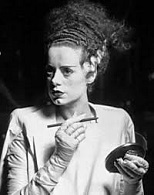
On Apr. 19, 1935 James Whale's Bride of Frankenstein (Apr. 19) (Universal Pictures) debuts, a sequel to the 1931 film, starring Boris Karloff as the monster, and Lewisham, London-born Elsa Lanchester (1902-86) as his mate as well as Mary Shelley; Colin Clive plays Henry Frankenstein, and Ernest Thesiger plays Dr. Septimus Pretorius; the music score is by Polish-born Am. composer Franz Waxman (1906-67); does $2M box office on a $397K budget.


In Apr. 1935 after discovering her tell-all diary detailing her arduous affair with everhard "You Can't Take It With You", "Animal Crackers", "The Man Who Came to Dinner", "Dinner at Eight", "Stage Door" playwright-dir.-producer-critic (Jewish) ("the Great Collaborator") George Simon Kaufman (1889-1961) ("we shared our fourth climax at dawn"), Dr. Franklyn Thorpe, husband of actress Mary Astor (Lucille Vascincellos Langhanke) (1906-87) (former mistress of John Barrymore) files for divorce, demanding custody of their daughter Marilyn; on July 15 she countersues to retain custody, resulting in a sensational trial where the diary is entered as evidence by him, but after it is revealed that he had affairs with Busby Berkeley showgirls to get even, she wins, and the judge orders the diary destroyed as "pornography", boosting her career.

On May 9, 1935 John Ford's The Informer (RKO) debuts, based on a Liam O'Flaherty novel about the 1922 Sinn Fein Revolt, starring Victor McLaglen as Dublin man Gypo Nolan, who informs on an IRA friend for a £20 reward and drinks the money away in grief instead of fleeing to the U.S. (passage £10), and is killed during capture; also stars Heather Angel, Margot Grahame, Preston Foster, and Wallace Ford; filmed in three weeks on a shoestring budget, it uses silences and music in a novel way, giving Ford a worldwide rep.; MacLaglen wins a best actor Oscar.

On June 15, 1935 Ray Enright's Alibi Ike debuts, #3 in Joe E. Brown's Baseball Comedy Trilogy ("Elmer the Great", "Fireman Save My Child"), becoming the major film debut of Tokyo-born Olivia Mary de Havilland (1916-2016).

On June 28, 1935 Russian dir. Rouben Mamoulian's Becky Sharp debuts, based on the 1847 William Makepeace Thackeray novel "Vanity Fair", starring Cedric Hardwicke (U.K.) and Miriam Hopkins (U.S.),, becoming the first feature film to use Technicolor, featuring sets designed by Robert Edmond Jones; Thelma Catherine Ryan (Mrs. Pat Nixon) is an extra.

On July 12, 1935 Tim Whelan's The Murder Man debuts, becoming the first MGM film for Spencer Tracy as New York City newspaper reporter Steve Grey, and the film debut of Indiana, Penn.-born James Maitland "Jimmy" Stewart (1908-97) (known for his drawl and ability to talk naturally, interrupting a conversation to get a thought out) as reporter Shorty; does $546K box office on a $167K budget.


On Aug. 2, 1935 Victor Fleming's The Farmer Takes a Wife debuts, based on the 1934 Broadway play based on the 1929 novel "Rome Haul" by Walter D. Edmonds, becoming the film debut of Henry Jaynes "Hank" Fonda (1905-82), who goes on to appear in 100+ films. On Dec. 25, 1931 Fonda marries his first wife and co-star Margaret Brooke Sullavan (1909-1960) (until 1933); she ends up commiting suicide by OD after four marriages.
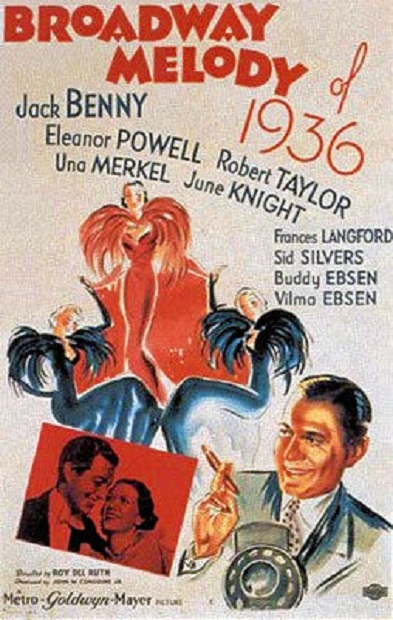

On Sept. 20, 1935 Roy Del Ruth's Broadway Melody of 1936 (MGM) debuts, based on a Moss Hart story, starring leggy tap-dancing singing wet dream babe Eleanor Powell (1912-82) in her first leading role as aspiring Broadway star Irene Foster, who tries to convince Robert Gordon (Robert Taylor) to let her star in his new musical, who is too busy with rich widow Lillian Bright who's backing his show, and resorting to impersonating a French dancer invented by gossip columnist Bert Keeler (Jack Benny); ends with the musical number Broadway Rhythm by Nacio Herb Brown; the film debut of Buddy Ebsen as Ted Burke; Ebsen's sister Vilma plays Sally Burke; also features the song "You Are My Lucky Star" by Brown; Powell's voice is dubbed by Marjorie Lane; a big hit, Powell goes on to make more films and rescue MGM from looming bankruptcy; does $2.87M box office incl. $1.655M in the U.S. and Canada and $1.216M elsewhere on a $1.06M budget.

On Aug. 29, 1935 Mark Sandrich's Top Hat (RKO Radio Pictures) debuts, with music and lyrics by Irving Berlin. set in the Thackeray Club in London (founded 1864) , starring Fred Astaire as fake Horace Hardwick (Room 404), whose "No Strings" Big White Set hotel room dance disturbs sleeping beauty (Ginger Rogers) (Room 304), who dates him and begins suspecting that he's a married layboy, er, playboy when she meets Horace's wife Helen Broderick; first movie musical written specifically for Astaire and Rogers; also stars "everybody's fussy uncle" Edward Everett Horton as the real Hardwick, ""We are Bates" Eric Blores as the butler, and Erik Rhodes as Ginger's effete Italian dressmaker beau Bedini, causing protests by the Italian govt.; features the numbers Top Hat, White Tie and Tails, I'm in Heaven (in which Ginger wears her famous white feathered dress, which spilled feathers on his tails, causing an offscreen argument), Isn't It a Lovely Day (to Be Caught in the Rain)?, and Cheek to Cheek, which loses best song Oscar to "Lullaby of Broadway", but goes #1 on Your Hit Parade and is named the #1 song of 1935; does $3.2M box office on a $609K budget; most successful Astaire-Rogers film, and Astaire's #2 most successful film after "Easter Parade" (1948).
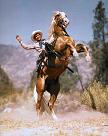
On Sept. 7, 1935 William H. Terhune's Slightly Static debuts, becoming the film debut of "King of Cowboys" Roy Rogers (Leonard Franklin Slye) (1911-98), who sings with the Sons of the Pioneers.

On Oct. 15, 1935 eager to go independent, former RKO-Radio Pictures head (1931) and MGM studio head (since 1933) David O. Selznick (1902-65) forms Selznick Internat. Pictures on $3M in capital, of which he contributes zilch, and moves into the Mount Vernonesque Thomas Ince Studio on Washington Blvd. in Culver City, Calif., and signs up United Artists as his distributor, going on to make string of hits culiminating with #1 of all time "Gone With the Wind" in 1939.

On Oct. 18, 1935 Merian C. Cooper's and Ernest B. Schoedsack's The Last Days of Pompeii (RKO) debuts, loosely based on the 1834 Edward Bulwer-Lytton novel set in the time of Christ, starring Preston Foster as Roman blacksmith Marcus, whose wife and child are killed, causing him to become a successful gladiator, then travelling to Judea to see its "greatest man", meeting Pontius Pilate (Basil Rathbone) before ending up you know where you know when; David Holt and John Wood plays Marcus' adopted son Flavius; Alan Hale Sr. plays servant Burbix; Ward Bond plays gladiator Murmex of Carthage; does $980K box office on a $818K budget after a 1949 re-release.
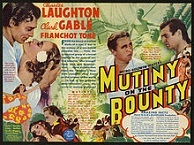
On Nov. 8, 1935 Frank Lloyd's Mutiny on the Bounty (MGM) debuts, based on the 1932 Charles Bernard Nordhoff and James Norman Hall novel, starring Charles Laughton as the definitive sadistic Capt. Bligh, with fetching Clark Gable as lusty mutiny leader Fletcher Christian, and Franchot Tone as framed midshipman Roger Byam; first time that three stars from the same film are best actor Oscar nominees (until ?); also features Donald Crisp as Burkitt, catching a shark and getting flogged; does $4.5M box office on a $2M budget.

On Nov. 15, 1935 George Stevens' Annie Oakley (RKO Pictures) debuts, starring Barbara Stanwyck as Annie, Preston Foster as her sharpshooter beau Toby Walker, Melvyn Douglas as Jeff Hogarth, Moroni Olsen as Buffalo Bill Cody, and Chief Thunderbird as Sitting Bull; does $620K box office on a $354K budget.
On Dec. 16, 1935 Am. "Ice Cream Blonde" actress Thelma Todd (b. 1905) is found dead in Pacific Palisades, Calif. in her open Packard convertible in the garage of her dir. lover Roland West ("The Bat Whispers", "The Monsters") and his wife Jewel Carmen, dressed in an evening gown and mink coat spotted with blood; a grand jury rules carbon monoxide poisoning, but her atty. claims she was murdered on orders of Lucky Luciano, but after pressure from producer Hal Roach there is no 2nd inquest; she was really murdered by West?; she leaves the unfinished film "The Bohemian Girl"; West never directs another film.

On Dec. 25, 1935 Clarence Brown's Anna Karenina (B&W) debuts, based on the 1873 Leo Tolstoy novel, starring Greta Garbo again as sad married Anna, who is willing to give up all to be with cavalry officer Vronsky (Fredric March); a remake of the 1927 Greta Garbo and John Gilbert silent film "Love"; a happy ending is made for the U.S. vers., while the European vers. stays true to the novel's suicide ending.
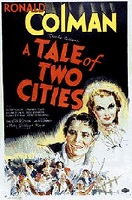
On Dec. 27, 1935 Jack Conway's A Tale of Two Cities (MGM) debuts, based on the 1859 Charles Dickens novel, starring Ronald Colman as Sydney Carton, Donald Woods as Charles Darnay, Elizabeth Allan as Lucie Manette, Basil Rathbone as Marquis de St. Evremonde, Blanche Yurka as Madame Theresa Defarge, and Edna May Oliver as Miss Pross; does $1.1M domestic and $1.18M foreign box office on a $1.2M budget.

On Dec. 28, 1935 Michael Curtiz' Captain Blood (Warner Bros.) debuts, based on the 1922 novel by Rafael Sabatini, making a superstar of unknown swashbuckling Tasmanian actor Errol Flynn (after the role is turned down by Robert Donat, Leslie Howard, Frederic March et al.) as Irish physician Dr. Peter Blood, who is unjustly convicted of treason by Judge Jeffreys of the Bloody Assizes in 1685 during the Monmouth Rebellion in the reign of James II, and escapes from slavery in Port Royal, Jamaica, turning pirate until William III takes over in 1688, allowing him to clear his name and get the girl and becomes gov. of Jamaica to boot; the screen debut of Olivia Mary de Havilland (1916-2016) (as Arabella Bishop, daughter of the gov. of Jamaica, played by Guy Atwill), who is stuck on him and he flirts with offscreen although he's married to actress Lily Demeter, friend of boss Jack Warner; also stars Basil Rathbone as fellow pirate captain Levasseur, whom Blood kills in a swordfight although he's the better swordsman in real life.

In 1935 Kodak introduces Kodachrome, the first multi-layered color film, developed by Leopold Godowsky Jr. (1900-83) (whose father Leopold Godowsky Sr. was a violinist and good friend of Albert Einstein) and Leopold Mannes (1899-1964); next spring it is introduced in 8mm movie film size, followed by 35mm size in Aug.-Sept., 1936; it is discontinued in 2009.
On Jan. 25, 1936 the White Mayfair Ball in Hollywood is attended by Clark Gable and Carole Lombard, who had made a film together with no sparks, but who strike it up at the ball, ending in a fight; the next day Gable awakes to a flock of doves released in his hotel room by Lombard's request; on Feb. 14 she has a Model-T painted with big red hearts delivered to him at the MGM lot, with a note attached to the steering wheel reading "You're driving me crazy!"; he then picks her up for a date wearing an expensive gown in the Model-T.

On Feb. 8, 1936 Archie L. Mayo's Petrified Forest (Warner Bros.) (not to be confused with "The Painted Desert") debuts, based on the 1935 Robert Emmet Sherwood play, set in a desert BBQ hamburger-beer joint in Black Mesa, Ariz. ("tipping is un-American - keep your change"), featuring young single poetry-loving (amateur artist) Bourges, France-born waitress (with the Bette Davis Eyes) Gabrielle "Gabby" Maple (Bette Davis) ("If we got to France you could show me everything"), who ditches big burly college-football-playing (#42) gas pumper Balls, er, Boze Hertzlinger (Dick Foran) for sensitive pipe-smoking hitchhiking failed English novelist Alan Squier (Leslie Howard) ("I belong to a vanishing race - I am one of the intellectuals") ("born in 1901... too late for the Great War, and too soon for the New Order") before they are taken hostage by fugitive killer Duke Mantee (Humphrey Bogart) (Okla. license plate #3T-808) (who arrived at the studio last Oct. 26 in a taxi, advertising that he didn't have a car, and goes onscreen sans makeup, with a real 2-day stubble, gaining audience traction from the recent escape of John Dillinger) and his 3-man gang, and get into survival of the fittest mode, making Bogart's struggling career take off, stereotyped as a gangster, a role which up till now he thought he wasn't right for until big clout star Howard refused to make the film without him; the air conditioning on the sound stage blows the sand around, making everybody sick; "A killer always holds his chin in."
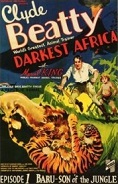
On Feb. 15, 1936 B. Reeves Eason's and Joseph Kane's Darkest Africa (original title Dark Continent) (later King of Jungleland) debuts as the first serial of 66 produced by Republic Pictures (1935-59) formed by Consolidated Film Laboratories from a merger of Mascot Pictures et al., based on the Mascot serisl "The Lost Jungle", starring Clyde Beatty as a big game hunter and "world's greatest animal trainer", who goes on safari in E Africa and encounters loincloth-wearing boy Baru Tremaine (Manuel King), who leads him to the lost city of Joba, King Solomon's sacred city of the Golden Bat; Ray "Crash" Corrigan plays Baru's pet ape Bonga.

On Feb. 19, 1936 Henry Hathaway's The Trail of the Lonesome Pine debuts, starring Fred MacMurray, Henry Fonda, and Sylvia Sidney, becoming the first Technicolor movie filmed outdoors.

On Feb. 20, 1936 William Cameron Menzies' Things to Come debuts, based on the 1933 H.G. Wells novel "The Shape of Things to Come", starring Raymond Massey and Margaretta Scott as John and Rowena Cabal in an optimistic prediction of a future world being rebuilt in 1970-2036 after a long war in 1940; music by English composer Sir Arthur Bliss; a flop, causing studios to shun expensive futuristic flicks until the 1950s; "If we're no more than animals, we must snatch at our little scraps of happiness and live and suffer and pass, mattering no morethan all the other animals do or have done. It is that, or this? All the universe, or nothingness Which shall it be?"

On Feb. ?, 1936 William Dieterle's The Story of Louis Pasteur debuts, starring Ukrainian-born Paul Muni (Meshilem Meier "Moony" Weisenfreund) (1895-1967) and Josephine Hutchinson as Louis and Marie Pasteur.
On Mar. 5, 1936 the Eighth (8th) Academy Awards awards the best picture Oscar for 1935 to MGM's Mutiny on the Bounty, best actor to Victor McLaglen for The Informer, best actress to Bette Davis for Dangerous, and best dir. to John Ford for The Informer, whose screenwriter Dudley Nichols (1895-1960) becomes the first to refuse an Oscar (due to a Screen Writers Guild strike) (next time George C. Scott on Apr. 15, 1971).

On Apr. 12, 1936 Frank Capra's Mr. Deeds Goes to Town debuts, based on Clarence Budington Kelland's play "Opera Hut", starring Gary Cooper as Vt. tuba player Longfellow Deeds, "the pride of Mandrake Falls", who inherits $20M and donates it to the poor after falling in money-can't-buy-love with beautiful bleached blonde reporter Jean Arthur (1900-91), who has been using him to feed articles to the press to make him look ridiculous, after which she falls in love with him and rescues him from an insanity hearing, where he is accused of being "pixillated", walking in the rain and talking to himself, etc.; Arthur becomes a big star and goes on to star in three more Capra films - wonder how much she worked for?

On Apr. 6, 1936 Frederick Stephani's Flash Gordon debuts, a serial film based on the Alex Raymond comic, starring Olympic gold medal swimming athlete Clarence Linden "Buster" Crabbe II (1908-83) as Flash Gordon, Jean Rogers (Eleanor Dorothy Lovegren) (1916-91) as his babe Dale Arden, Frank Connolly Shannon (1874-1959) as Dr. Alexis Zarkov, and Charles B. Middleton (1874-1949) as bad guy Emperor Ming the Merciless; followed by "Flash Gordon's Trip to Mars" (1938) and "Flash Gordon Conquers the Universe" (1940).



On July 1, 1936 Norman Taurog's Rhythm on the Range debuts, starring Bing Crosby singing I'm an Old Cowhand from the Rio Grande, becoming the first Hollywood song hit of Johnny Mercer (1909-76), and the first hit movie of beautiful blonde actress ("the New Garbo") Frances Farmer (1913-70), who made headlines in high school for winning $100 in a writing contest sponsored by Scholastic Mag. with the brainy essay "God Dies", and just returned from a free trip to the Soviet Union that she had won from the leftist newspaper "The Voice of Action", causing rumors that she is a smart atheistic Commie instead of a dumb blonde, only making her more popular?
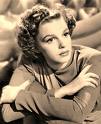
On Oct. 23, 1936 David Butler's Pigskin (Harmony) Parade debuts, starring Jack Haley as Texas State U. football coach Winters, who saves the struggling team with Ark. hillbilly Stuart Erwin, the best passer of all time; the feature film debut of Judy Garland (Frances Ethel Gumm) (1922-69) from Grand Rapids, Mich., who is named by George Jessel after Carole Lombard's char. Lily Garland in the 1934 film Twentieth Century, and by Frances after a popular Rudy Vallee song; lesbian actress Patsy Kelly plays Haley's wife Bessie; features Garland singing The Balboa.

On Nov. 6, 1936 William Wyler's and Howard Hawks' Come and Get It (Samuel Goldwyn Productions) debuts, written by Jane Murfin and Jules Furthman based on the 1935 Edna Ferber novel, starring Edward Arnold as forest-wasting lumber king Barney Glasgow, who battles his son Richard (Joel McCrea) for the love of Lotta Morgan (Frances Farmer), who portrays her own mother Lotta Morgan, wife of Swan Bostrom (Walter Brennan), causing critics to rave; too bad, Farmer refuses to be cast on her looks alone or to go along with the studio system, and starts bucking, leaving for the East Coast in 1937 to do summer stock, hooking up with Clifford Odets and having an affair while he is married to Luise Rainer, then returning to Hollywood after he dumps her.

On Nov. 6, 1936 Mark Sandrich's A Woman Rebels debuts, based on the novel "Portrait of a Rebel" by Netta Syrett, starring Katharine Hepburn as Victorian mores rebel Pamela Thistlewait, becoming the film debut of Walters, Okla.-born Emmett Evan "Van" Heflin Jr. (1910-71) as Lord Gerald Waring Gaythorne, who becomes MGM's leading man in B-movies; the final film of David Manners; does $583K box office poison, er, on a $574K budget.

On Nov. 25, 1936 Henry King's Lloyd's of London debuts, set during the Napoleonic Wars, starring Madeleine Carroll and Guy Standing, becoming the first starring role for Tyrone Edmund "Ty" Power Jr. (1914-58) as Jonathan Blake.

On Dec. 20, 1936 Henry Koster's Three Smart Girls debuts about three you know whats (Barbara Read, Nan Grey, Deanna Durbin) who try to bring their divorced parents Charles Winninger and Nella Walker back together, becoming the film debut of 14-y.-o. Canadian-born soprano Deanna (Edna Mae) Durbin (1921-2013), which makes her a star and rescues Universal Studios from bankruptcy, spawning two sequels; Berlin-born dir. Henry Koster doesn't speak English, but the money causes Hollywood to give him a pass.

On Dec. 24, 1936 William Thiele's The Jungle Princess debuts, starring Ray Milland and Ray Mala, becoming the film debut of New Orleans, La.-born Dorothy Lamour (Mary Leta Dorothy Slaton) (1914-96), who becomes known as "the Sarong Queen".
In 1936 after feeling sorry for silent film stars who couldn't make it in talkies, Louis B. Mayer of MGM begins giving small parts to them for $75 a week, incl. Florence Turner (1885-1946), "the Vitagraph Girl", and Florence Lawrence (1886-1938), "the Biograph Girl", "the Imp Girl", "the Girl of a Thousand Faces", who commits suicide with ant poison on Dec. 28, 1938.

In 1936 Rondo Hatton (1894-1946), whose grotesque acromegalic face makes him the perfect horror star is invited to Hollywood by dir. Henry King, and goes on to a short distinguished career freaking viewers out.

On Jan. 1, 1937 George Cukor's Camille debuts, based on the 1852 Alexandre Dumas fil novel, starring Greta Garbo and Robert Taylor in a unique magic moment on film.


On Mar. 2, 1937 Frank Capra's Lost Horizon debuts, a lavish $2M pic filmed on the most expensive Hollywood set to date, despite sunny Southern Calif. weather, almost bankrupting Columbia Pictures, based on the 1933 James Hilton novel about not-for-the-lame Shangri-La, Tibet, "where the snow never melts away", starring Ronald Colman as English "Man of the East" Robert "Bob" Conway, Jane Wyatt as his babe Sondra Bizet, H.B. Warner as Chang (after Henry B. Walthall dies of influenza), Sam Jaffe as the 200+-y.-o. High Lama AKA Father Perro, Thomas Mitchell as plumber Henry Barnard, Edward Everett Horton as archeologist Lovey Lovett ("You expect to be knighted for finding that soup bone?"), and Margo as mixed-up Maria, who longs to escape to civilization with her lover John Howard; Eddie Albert's future wife (1945) Margo plays Maria; musical score by Ukrainian-born composer Dimitri Tiomkin (1894-1979), who goes on to reach the heights in his profession, incl. "Mr. Smith Goes to Washington" (1939), "It's a Wonderful Life" (1946), "High Noon" (1952), "I Confess" (1953), and "The High and the Mighty" (1954); too bad, its WWII reissue cuts 24 of the original 132 min. to tone down the pacifist message - perfect escapist fantasy between the two world wars?
On Mar. 4, 1937 the Ninth (9th) Academy Awards awards the best picture Oscar for 1936 to MGM's The Great Ziegfeld, along with best actress to Luise Rainer; best actor goes to Paul Muni for The Story of Louis Pasteur; best supporting actor (1st time awarded) goes to Walter Brennan for Come and Get It, best supporting actress (1st time awarded) goes to Gale Sondergard for Anthony Adverse, and best dir. goes to Frank Capra for Mr. Deeds Goes to Town.

On Mar. 23, 1937 Frank Tuttle's Waikiki Wedding (Paramount Pictures) debuts, starring Bing Crosby as PR man Tony Marvin, who is tasked with selling Hawaii despite comments mae by local beauty queen Georgia Smith (Shirley Ross); it features the hit song Sweet Leilani (Hawaiian "heavenly garland of flowers"), composed by Harry Owens, which wins the best song Oscar for 1937.

On Apr. 27, 1937 William A. Wellman's A Star is Born (Apr. 27) (Selznick Internat. Pictures) stars Janet Gaynor as shy girl Esther Victoria Blodgett AKA Vicki Lester, who is helped by declining actor Norman Maine (Fredric March) to become a star singing "Evergreen", with tragic consequences to the latter; does $4.36M box office on a $1.17M budget; based on the true story of silent film star Wallace Reid, who died of a morphine OD in 1923 at age 31; also based on the stories of actors Jack Gilbert and John Bowers?; refilmed in 1954.
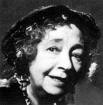
On Apr. 30, 1937 Richard Thorpe's Night Must Fall debuts, becoming the Hollywood film debut of stage actress Dame May Whitty (1865-1948) as crochety old Mrs. Branson, who hires charming young Danny (Robert Montgomery) as her live-in companion, who hooks up with her niece Olivia Grayne (Rosalind Russell) despite suspecting him of being a criminal.

On May 8, 1937 William Keighley's The Prince and the Pauper debuts, based on the 1882 Mark Twain novel, starring twins William J. "Billy" and Robert J. "Bob" Mauch as London slum boy Tom Canty and Prince Edward VI, along with Errol Flynn (who gets star billing) as nobleman Miles Hendon, and Claude Rains as Edward Seymour, 1st Earl of Hertford, lord protector of England in 1547-9.
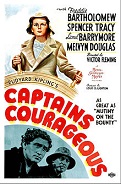
On May 11, 1937 Victor Fleming's B&W Captains Courageous (MGM), based on the 1897 Rudyard Kipling novel debuts, starring Freddie Bartholomew as spoiled kid Harvey Cheyne Jr., who is washed off a transatlantic steamship and rescued by Portuguese-Am. fisherman Manuel (Spencer Tracy), and made to join the crew of the fishing trawler "We're Here" by Capt. Disko Troop (Lionel Barrymore); music by Franz Waxman; does $3.1M box office on a $1.6M budget.
On June 7, 1937 Am. platinum blonde movie star Jean Harlow (b. 1911) dies in Los Angeles, Calif. of renal failure and cerebral edema while filming Saratoga; at her funeral "Iron Butterfly" Jeanette MacDonald sings Rudolf Friml's 1924 Indian Love Call, which she sang in the 1936 Nelson Eddy movie Rose Marie; Harlow's next movie was to have been In Old Chicago - the good leave a pretty corpse?

On July 23, 1937 Jack Conway's Saratoga (B&W) debuts, starring Clark Gable as a bookie, and Jean Harlow as a poor horse breeder's daughter; Harlow dies during filming and Mary Dees stands in; released 1 mo. after her death, the hype makes it a big moneymaker.

On Aug. 6, 1937 Sidney Franklin's The Good Earth debuts, based on the 1931 Pearl S. Buck novel about farmer Wang (Paul Muni) in old China, winning Luise Rainer the 2nd of her back-to-back best actress Oscars for her portrayal of self-sacrificing O-Lan; the last MGM film produced by Irving Thalberg, who dies before release, and is dedicated to his memory, being the only credit he ever took; "O-Lan, you are the Earth" (Paul Muni as Wang to Luise Rainer, after she dies).

On Aug. 20, 1937 Roy Del Ruth's Broadway Melody of 1938 debuts, starring Robert Taylor as Broadway producer Stephan "Steve" Raleigh, and Eleanor Powell as his leading lady Sally Lee, whom the backer's wife Caroline Whipple (Binnie Barnes) doesn't like, causing her to ask ex-vaudevillians Sonny Ledford and Peter Trot (George Murphy and Buddy Ebsen) to help her win a horse race to get the needed money; features new sensation Judy Garland as Betty Clayton singing Dear Mr. Gable, You Made Me Love You to a picture of Clark Gable.
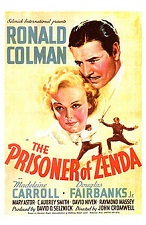
On Sept. 2, 1937 John Cromwell's The Prisoner of Zenda (Selznick Internat. Pictures) (United Artists) debuts, based on the 1894 Anthony Hope novel, starring Ronald Colman as Maj. Rudolf Rassendyll/King Rudolf V, Madeleine Carroll as Princess Flavia, Douglas Fairbanks Jr. as Rupert of Hentzau, former English cricket champ C. Aubrey Smith as Col. Zapt, David Niven as Capt. Fritz von Tarlenheim, and Mary Astor as Antoinette de Mauban, with score by Alfred Newman, who receives the first of 45 Oscar nominations for original music score.


On Oct. 9, 1937 Mervin LeRoy's They Won't Forget debuts, based on a Ward Greene novel, starring Wallace-Idaho-born sexy blonde Lana (Julia Jean) Turner (1921-95) as a well-dressed teenager raped and murdered on Confederate Day, gaining her fame as "the Sweater Girl"; she was discovered in Jan. 1937 by Hollywood Reporter founder William Wilkerson at the Top Hat Cafe at 6750 Sunset Blvd. at the corner of Sunset Blvd. and McCadden Pl. after she ditched typing class at Hollywood High School across the street, and referred to Zeppo Marx; the soda jerk is Manuel Hernandez, who serves her another on the 1st anniv.; in ? Top Hat Cafe closes, allowing Schwab's Drug Store at 8025 Sunset Blvd. to appropriate the legend to the hilt, changing Wilkerson to dir. Mervyn Le Roy until it closes in 1983; in 1942-4 she marries actor Joseph Stephen Crane (1916-85), who quits after three films and runs the successful Luau Restaurant on Rodeo Drive in Beverly Hills, Calif. until 1978.

On Oct. 15, 1937 Allan Dwan's Heidi (20th Cent. Fox) debuts, based on the 1880 story by Johanna Spyri, starring Shirley Temple as young orphan Heidi, and Jean Hersholt as her grandfather Adolph Kramer.

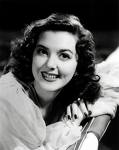
On Dec. 10, 1937 George B. Seitz's You're Only Young Once debuts, the 2nd Andy Hardy movie starring Mickey Rooney, replacing Lionel Barrymore with Lewis Shepard Stone (1879-1953) (who went gray at age 20) as his dad Judge James Hardy, and featuring Therese Ann Rutherford (1920-) as Andy's "sophisticated" babe Polly Benedict for the first of 12x (until 1942).
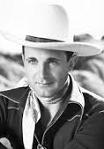

In 1937 B-movie Western actor Ray "Crash" Corrigan (Raymond Benard) (1902-76) goes on a hunting trip in Simi Valley, Calif. with Clark Gable, and decides to purchase land in the foothills of the Santa Susana Mts. in E Ventura County, which becomes Corriganville Movie Ranch, an outdoor set for films incl. "Drums of Fu Manchu" (1939) and "Fort Apache" (1948), and TV series incl. "The Lone Ranger" (1949-57), "The Cisco Kid" (1950-6), "The Adventures of Rin Tin Tin" (1954-9), "Sky King" (1951-9), Circus Boy" (1958-60), and "Star Trek" (1966-9); in 1944 he opens it up to paying visitors, reaching 1M attendance a year; in 1966 he sells it to Bob Hope, who turns it into Hopetown.


In 1937-8 Mo.-born muralist Thomas Hart Benton (1889-1975) paints Hollywood (56"x84") after it is commissioned by Life mag., which refuses to run it because of the nudity.

On Jan. 6, 1938 Henry King's In Old Chicago debuts, based on a story by Niven Busch about the Great Chicago Fire of 1871, starring Alice Brady as Mrs. O'Leary, and Tyrone Power and Don Ameche as her sons Dion and Jack; Alice Faye plays Belle Fawcett, boosting her career.

On Feb. 1, 1938 Norman Taurog's Mad About Music (Universal Pictures) debuts, starring Deanna Durbin as Gloria Harkinson, a girl at an exclusive music school who invents an exciting father, and is forced to prove his existence, hooking English composer Richard Todd (Herbert Marshall) into the job at a train station; also features suspicous schoolmate Helen Parrish, and goes on to form a Shirley Temple/Jane Withers team with Durbin.


On Feb. 11, 1938 Mitchell Leisen's The Big Broadcast of 1938 (Paramount) debuts, about a ship that runs on power from radio broadcasts, starring W.C. Fields as T. Frothingill "T.F." Bellows, Martha Raye as Martha Bellows, and Dorothy Lamour as Dorothy Wyndham, becoming the feature film debut of English-born Leslie Townes "Bob" Hope (1903-2003) as Buzz Fielding, who becomes a star with his own theme song Thanks for the Memory (not memories), composed by Ralph Rainger with lyrics by Leo Robin, and sung with Omaha, Neb.-born Shirley Ross (Bernice Gaunt) (1913-75), whose career peaks as his begins to skyrocket.

On Feb. 18, 1938 Howard Hawks' Bringing Up Baby debuts, starring Cary Grant as paleontologist David Huxley, who has a series of adventures with heiress Susan Vance (Katharine Hepburn) and her pet Leopard, uttering the soundbyte "Susan, Susan, Susan", which comedian Larry Storch later turns into "Judy, Judy, Judy"; Grant first uses the term "gay" in the context of homosexuality - he ought to know?; does $1.1M box office on a $1.1M budget, causing Hepburn to be labelled as box office poison, but after it begins to be shown on TV in the 1950s it beomes a classic.

On Mar. 10, 1938 William Wyler's Jezebel (B&W) debuts, based on the 1933 play by Owen Davis Sr., rushed into production to ace-out "Gone With the Wind", starring Bette Davis as New Orleans belle Julie Marsdon, who wears a shocking red dress to the ball, and wins a best actress Oscar, while Fay Bainter wins best supporting actress; also stars Henry Fonda and George Brent.
On Mar. 10, 1938 the Tenth (10th) Academy Awards awards the picture Oscar for 1937 to Warner Bros.' The Life of Emile Zola, best actor to Spencer Tracy for Captains Courageous, best actress to Luise Rainer (2nd time in a row) for The Good Earth, and best dir. to Leo McCarey for the screwball comedy The Awful Truth (first onscreen pairing of Cary Grant and Irene Dunne); George Bernard Shaw wins an Oscar for adapting his "loverly" play "Pygmalion" for My Fair Lady.

On May 14, 1938 William Curtiz' and William Keighley's The Adventures of Robin Hood (MGM) debuts, costing $2M and becoming a giant hit ($4M box office), starring Errol Flynn as Robin, Earl of Locksley, Olivia de Havilland as Maid Marian FitzWalter (whom Flynn is courting offscreen despite being married to Lily Demeter, causing her to utter the soundbyte that after trying to turn him on in repeated kissing scenes "he had a little trouble with his tights"), Patric Knowles as Will Scarlet, Alan Hale Sr. as Little John, Eugene Pallette as Friar Truck, Basil Rathbone as Sir Guy of Gisbourne (who loses a swordfight to Flynn, despite being the better swordsman in real life), Claude Rains as Prince John, and Melville Cooper as the Sheriff of Nottingham; "the best-loved bandit of all time"; golden palomino trick horse Trigger (1932-65) makes his movie debut under the name Golden Cloud, after which he is purchased by Roy Rogers, who grooves on his 150 tricks and how he can walk 50 ft. on his hind legs, and uses him in his films and TV series along with his wife Dale Evans, who rides a buckskin quarterhorse named Buttermilk.
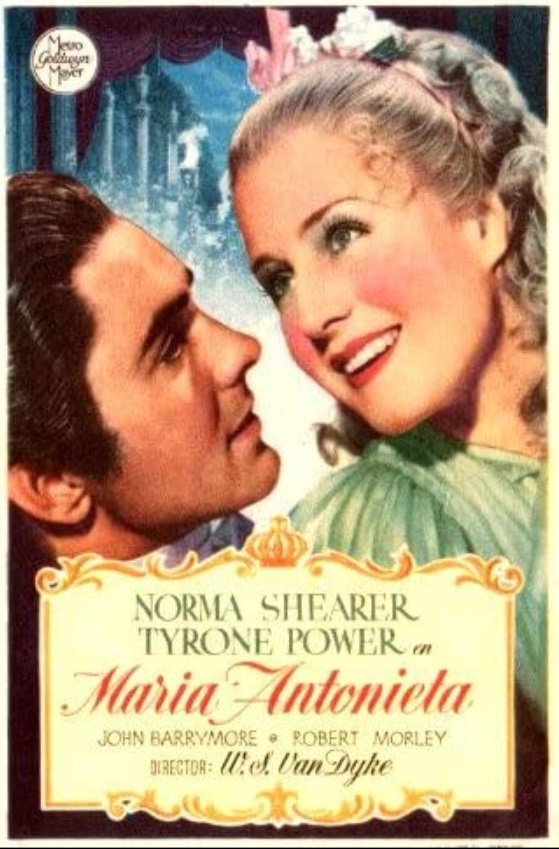
On July 8, 1938 W.S. Van Dyke II's Marie Antoinette (MGM), debuts, based on the 1932 Stefan Zweig novel; a lavish production starring Norma Shearer, who is portrayed as innocent of all charges ("Think of it, I shall be queen of France"); Tyrone Power plays her beau Count Axel von Fersen the Younger; John Barrymore plays able aging Louis XV, and Robert Morley (his film debut) plays his dull pudgy klutz grandson Louis XVI ("I've been brought very low, but I've had the love of the finest woman in the world"), who mends his son's toy soldier Old Gen. Pulverschmecken before being guillotined; also stars Anita Louise, Joseph Schildkraut as plotting Duc d'Orleans, Gladys George, and Henry Stephenson; last project of Irving Thalberg (d. 1936), which is taken up by his widow Norma Shearer; does $2.956M box office on a $2.926M budget.

On Aug. 5, 1938 John Cromwell's Algiers (United Artists) (Walter Wanger) debuts, starring Charles Boyer as French jewel thief Pepe Le Moko, who hides out in the Cashbah with brainy heady Austrian-Am. babe Hedy Lamarr (Hedwig Eva Maria Kisler) (1913-2000), in her film debut as his sultry beautiful rich girl Gaby, making her an instant star; does $951K box office on a $692K budget; he never says "Come with me to the Cashbah"?

On Oct. 29, 1938 William Keighley's Brother Rat (Warner Bros.) debuts, based on the 1936 play by Fred Finklehoff and John Cherry Monks Jr. about Virginia Military Inst. students, starring Priscilla Lane, Wayne Morris, and Ronald Reagan, who meets Jane Wyman on the set before getting married; the title is what first year students are called; the film debut of Rock Island, Ill.-born Eddie Albert (Edward Albert Heimberger) (1906-2005) as Bing Edwards; followed by "Brother Rat and a Baby" (1940).

On Nov. 11, 1938 Frank Lloyd's If I Were King debuts, based on the 1901 novel-play of Justin Huntly McCarthy, starring Ronald Colman as medieval poet Francois Villon, C.V. France as Father Villon, Ellen Drew as Villon's babe Huguette, Frances Dee as his other babe Katherine DeVaucelles, and Basil Rathbone as good-natured joke-loving Louis XI of France in Burgundian-sieged Paris, who decides to both punish and reward Villon by making him grand constable with 7 days to order himself hanged.

On Nov. 24, 1938 Michael Curtiz' Angels with Dirty Faces (Warner Bros.) debuts, based on a story by Rowland Brown, starring James Cagney playing against type as reformed hood Rocky Sullivan, who twitchingly tries in vain to save the Dead End Kids (Billy Halop as Soapy, Bobby Jordan as Swing, Leo Gorcey as Bim, Gabriel Dell as Patsy, Huntz Hall as Crab, Bernard Pnesly as Hunky et al.) from priz, ending in a famous long walk to the chair; Pat O'Brien plays Father Jerry Connolly; Humphrey Bogart plays Jim Frazier; Ann Sheridan plays Laury Martin; George Bancroft plays Mac Keefer; Errol Flynn is introduced to the Bloody Mary on the lot by Ann Sheridan, turning him onto vodka, which he injects into oranges to avoid detection.
On Dec. 23, 1938 Wicked Witch of the West Margaret Hamilton's costume catches fire while filming a 2nd unused take of her fiery exit from Munchkinland in The Wizard of Oz; it takes six weeks to recuperate, after which she won't work with fire on the set.
On Jan. 26, 1939 filming begins on Gone With the Wind after Warner Bros. queen Bette Davis turns down the part of Scarlett O'Hara because Errol Flynn would co-star as Rhett Butler, and former box office queen Katharine Hepburn is labelled box office poison and turned down, causing her to respond, "Not everyone is lucky enough to understand how delicious it is to suffer"; Norma Shearer is selected then dumped after negative audience reaction to her famous cross-eyed stare.
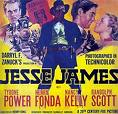
On Jan. 27, 1939 Henry King's Jesse James (20th Cent. Fox) debuts, written by Nunnally Johnson, starring Tyrone Power as Jesse, and Henry Fonda as his brother Frank, portraying them as Robin Hoods forced into crime by a mean railroad co. that evicts them from their family farm, "notorious for its historical inaccuracy"; after a horse falls to its death down a rocky slope onscreen, the Am. Humane Assoc. begins monitoring Hollywood filmmaking.
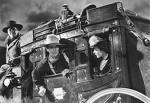
On Feb. 2, 1939 John Ford's B&W Stagecoach (United Artists) debuts, produced by Walter Wanger based on the short story "Stage to Lordsburg" by Ernest Haycox, about seven passengers riding through Geronimo's Apache territory in 1884 sans the usual cavalry escort, becoming the first pairing of B-actor John Wayne and dictatorial dir. "Coach" Ford since their split five years earlier when Wayne went off to another dir. and Ford stopped talking to him, becoming payback time for Ford as he constantly ridicules Wayne off-camera; after his suggestion of fellow unknown Lloyd Nolan is turned down, Wayne stars as escaped prisoner Henry the Ringo Kid (Malpais Bill in the short story), and steals the movie, joining the A-list and changing the course of the Hollywood Western, taking it out of the kiddie matinee league with the help of stuntman Enos Edward "Yakima" Canutt (1895-1986), who jumps the two lead horses, gets shot 2x, takes a prone dirt ride under the horses and coach, yet is seen getting up, and does it again dressed as Ringo, but doesn't get shot; the score features 17 Am. folk songs; the stagecoach has six horses, and the drivers speed them up by throwing rocks at them; also stars Claire Trevor as Wayne's looker babe with great gams Miss Dallas, Louise Platt as Capt. Richard Mallory's pregnant wife Lucy, Berton Churchill as embezzling banker Ellwood H. Gatewood ("what this country needs is a businessman for president"), Thomas Mitchell as alcoholic Dr. Josiah Boone, who sobers up with hot coffee and cold water in the face to deliver Mrs. Mallory's baby, John Carradine as proud Southern gambler Hatfield, Donald Meek as timid whiskey salesman Mr. Peacock from Kansas City, Kan., Andy Devine as driver Buck, who is betrothed to Julietta from Chihuahua, before Mexicans were called illegal aliens ("all aboard for Dry Fork, Apache Wells, Lee's Ferry, and Lordsburg") ("Bessie, Brownie, Bill, sweethearts"), and George Bancroft as shotgun guard Marshal Curley, who is bringing Ringo back to prison for a reward of $500 in gold; also features Tim Holt as the lt., and Tom Tyler as Lourdsburg bully Luke Plummer; photographers Bert Glennon and Ray Binger immortalize Monument Valley in Utah-Ariz.; the climax is the perfect Am. white racism message as self-appointed protector Hatfield gets ready to shoot "angel in the jungle" Mrs. Mallory rather than let filthy red savages get their hands on her, but the party is saved at the last sec. by the lily-white civilized bugle-blowing U.S. Cavalry ("Can you hear it, it's a bugle, they're blowing the charge" - Mrs. Mallory), after which Ringo kills Plummer and rides off with Dallas to his ranch on the other side of the border; "Well they're saved from the blessings of civilization" - "Doc, I'll buy you a drink" - "Just one" (Doc and Curley) (ending).
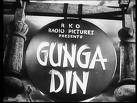
On Feb. 17, 1939 George Stevens' Gunga Din (RKO Radio Pictures) (pr. deen) debuts, based on the 1890 Rudyard Kipling poem about an Indian water boy (Sam Jaffe) who saves the friendship of three veteran British sergeants (Cary Grant as Sgt. Archibald Cutter, Victor McLaglen as Sgt. Mac MacChesney, Douglas Fairbanks Jr. as Sgt. Thomas "Tommy" Ballantine); William Faulkner (uncredited) contributes to the adaptation of the poem; does $2.807M box office on a $1.915M budget.
On Feb. 23, 1939 the 11th Academy Awards awards the best picture Oscar for 1938 to Columbia's You Can't Take It With You along with best dir. to Frank Capra, best actor to Spencer Tracy for Boys Town, best actress to Bette Davis for Jezebel, best supporting actress to Fay Bainter for Jezebel, and best supporting actor to Walter Brennan (his 2nd) for Kentucky; child stars Deanna Durbin and Mickey Rooney get a special Oscar; Fay Bainter becomes the first performer to be nominated for best actress ("White Banners") and best supporting actress ("Jezebel").

On Apr. 14, 1939 Irving Cummings' The Story of Alexander Graham Bell debuts, starring Felix "Don" Ameche (Amici) (1904-93) in the title role as the inventor of the telephone, spawning the phrase "I'll get you on the Ameche".

On May 5, 1939 Cecil B. De Mille's Union Pacific debuts, based on the novel "Trouble Shooter" by Earnest Haycox, starring Barbara Stanwyck and Joel McCrea doing biz after the 1862 Pacific Railroad Act; combines with "Stagecoach" to transform Westerns from B to A fare.

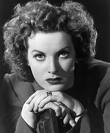
On May 15, 1939 Alfred Hitchcock's Jamaica Inn (Mayflower Pictures), debuts, based on the 1936 Daphne du Maurier novel (first of three, followed by "Rebecca", and "The Birds"), set in 1820 Cornwall on the edge of Bodmin Moor, starring ridiculously-overdressed Charles Laughton as justice of the peace Squire Sir Humphrey Pengallan; film debut of fiery-eyed Irish redhead Maureen O'Hara (FitzSimons) (1920-) as Irish orphan Mary, who moves in with Aunt Patience (Marie Ney) and Uncle Joss (Leslie Banks) at you know where, then discovers it's the HQ of a nest of pirates who lure ships to wreck on the Cornish coast and kill the crew and steal their cargo, and tries to save escaping whistleblowing pirate Jon Trehearne (Robert Newton) by bringing him to Pengallan, only to discover that Jon is actually a secret govt. agent, and later, that Pengallan is the secret pirate leader; Emlyn Williams plays pirate Harry the Pedlar; does $3.7M box office despite critics panning it because it changes the original plot to make a ham of Laughton, which caused du Maurier to almost refuse to grant film rights; Hitchcock's last British film before he moves to Hollywood in Mar. to work for David O. Selznick, taking O'Hara with him to make "The Hunchback of Notre Dame", which makes her a star.

On June 22, 1939 Edwin L. Marin's Maisie (MGM) debuts, based on the 1935 novel "Dark Dame" by Wilson Collison, making a star of Valley City, N.D.-born Ann Sothern (Harriette Arlene Lake) (1909-2001) after the rights were originally purchased for Jean Harlow, who died prematurely in 1937; followed by nine sequels (until 1947).
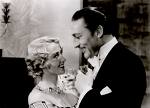

On July 13, 1939 James Whale's The Man in the Iron Mask debuts, starring John Barrymore lookalike (in profile) Warren William (1894-1948) as D'Artagnan, Louis Hayward as the royal twins Louis XIV (bad) and Philippe (good), Joan Bennett as Princess Maria Theresa, and Joseph Schildkraut as mean Nicolas Fouquet; the film debut of Basil Rathbone lookalike Peter Wilton Cushing (1913-94), who goes on to fame as Baron Frankenstein and Sherlock Holmes, while William goes on to fame as Perry Mason; too bad, Cushing's scenes are cut from the final film.



On Aug. 25, 1939 the MGM musical The Wizard of Oz, starring Judy Garland as Dorothy debuts at Grauman's Chinese Theater in Hollywood; it opens in New York City on Aug. 18; on Aug. 25 is is released in theaters nationwide; dir. by Victor Fleming and King Vidor (uncredited), written by Noel Langley based on the 1900 L. Frank Baum novel, it's the ultimate Am. morality play, starring singing sensation "Dorothy" Judy Garland (1922-69) (salary $500/week) (originally offered to Deanna Durbin and Shirley Temple), "Wicked Witch of the West" Margaret Hamilton (1902-85) (after Gale Sondergaard turns it down when they dump the idea of a slinky glamorous witch), "Scarecrow" Ray Bolger (1904-87) ("The sum of the square roots of any two sides of an isosceles triangle is equal to the square root of the remaining side"), "Tin Man" Jack Haley (1898-1979) (after Buddy Ebsen becomes allergic to the makeup), "Cowardly Lion" Bert Lahr (1895-1967), "Glinda the Good Witch" Billie Burke (1884-1970), and champagne-loving "Wizard of Oz/Prof. Marvel" Frank Morgan (1890-1949), plus a cast of midget supporting "Munchkin" actors (who also double as Flying Monkeys), incl. Jerry Maren (Gerard Marenghi) (1920-) as the Lollipop Guild member in green who gives Dorothy a lollipop, and Meinhardt Raabe (1915-) as the Munchkin coroner, who says of the Wicked Witch of the East, "She's not only pretty dead, she's definitely most sincerely dead"; score is by Herbert Stothart (1885-1949); Dorothy's dog Toto is a Cairn terrier; a 35-ft. muslin stocking is used to create the tornado; pure asbestos is used as snow in the poppy field; "Well Toto, we're not in Kansas anymore" (Dorothy); "I'll get you, my pretty, and your little dog too" (Wicked Witch of the West); "Follow the Yellow Brick Road" (Munchkins); features the songs We're Off to See the Wizard, the Wonderful Wizard of Oz, Ding, Dong, the Witch is Dead, and Somewhere Over the Rainbow, written by Jewish-as-a-kosher-pickle Edgar Yipsel "Yip" Harburg (1896-1981), a lifelong Socialist who ends up on the Hollywood blacklist from 1951-62, which is voted in 2001 as the best movie theme song of all time. Watch video; Watch video.

On Sept. 1, 1939 George Cukor's B&W The Women debuts, written by Anita Loos and Jane Murfin based on the 1936 Clare Boothe Luce play (after toning it down for the Production Code) about hot women in glamorous Manhattan apts. of high society who end up in Reno, Nev. getting divorces stars Norma Shearer as wealthy Mary Haines, who is unaware that her hubby is cheating on her with store girl Crystal Allen (Joan Crawford); the entire cast of 130+ speaking roles is female incl. Rosalind Russell, Mary Boland, Paulette Goddard, Joan Fontaine, Hedda Hopper, and Butterfly McQueen; features a 6-min. fashion parade filmed in Technicolor featuring outre designs by Adrian; does $2.27M box office on a $1.688M budget.



On Sept. 1, 1939 - Sept. 2, 1945 the horrific $3.5T World War II resulted in 24M military and 49M civilian deaths, and featured the low point of the Jewish Holocaust (Shoah) by the German Nazis, I guess it was the Jews' fault for not ransoming themselves to go to Israel before they could round them up for the camps. The whole experience turned Jews from lovers into fighters, ramping up the Zionist movement with full world sympathy and support by new world superpower U.S., which had its own guilt trip because on Nov. 24, 1942 Budapest-born Am. Zionist leader Rabbi Stephen Samuel Wise (1874-1949) announced in a press conference in Washington, D.C. that he was authorized by the U.S. State Dept. to confirm that the Nazis had murdered 2M Jews as part of a plan to exterminate all Jews in Europe; too bad, the nat. newspapers didn't consider it front page news, and the U.S. govt. did nada. After the war ended and Americans toured the concentration camps in horror, Polish-born Jewish scholar Raphael Lemkin (1900-59), who single-handedly led an unsuccessful campaign to get the League of Nations to give internat. protections against genocide starting in 1933 finally got what he wanted after his own people got it, namely the Dec. 9, 1948 U.N. Convention on the Prevention and Punishment of the Crime of Genocide (Gen. Assembly Resolution 260), which didn't come in force until Jan. 12, 1951, and which the U.S. still didn't ratify until 1988.


On Sept. 5, 1939 Rouben Mamoulian's Golden Boy debuts, based on the 1937 Clifford Odets play, making a star of William Holden (1918-81), who plays boxer Joe Bonaparte, whose father (Lee J. Cobb) wants him to pursue music instead, but whose babe Lorna Moon (Barbara Stanwyck) keeps him in the ring; Adolphe Menjou plays his mgr. Tom Moody; Beatrice Blinn plays his sister Anna; "You tell me, Miss Moon!"

On Oct. 17, 1939 Frank Capra's Mr. Smith Goes to Washington (B&W) (Columbia Pictures) debuts, starring James Stewart as plain-speaking Yankee Jefferson Smith, who goes to Washington to fight for a nat. boys' camp; also stars Jean Arthur as Clarissa Saunders, Claude Rains as Sen. Joseph Harrison Paine, and Edward Arnold as corrupt state political boss Jim Taylor; does $9M box office on a $1.5M budget.

On Nov. 3, 1939 Ricardo Cortez's Heaven With a Barbed Wire Fence debuts, becoming the Hollywood film debut of Canadian-born Gwyllyn Samuel Newton "Glenn" Ford (1916-2006) (formerly Tallulah Bankhead's stage mgr. in New York City), who plays opposite Jean Rogers as a New York City store clerk and an illegal immigrant; Cortez tells him he will never amount to anything.
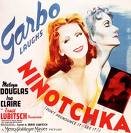

On Nov. 9, 1939 Ernst Lubitsch's Ninotchka (MGM) debuts, co-written by Austrian Jewish immigrant Billy Wilder (1906-2002) stars Greta Garbo as monotone-droning Soviet Commie agent Sgt. Nina Yakushova "Ninotchka" Ivanoff, who is sent to Paris and seduced by "extinct" handsome 6'2" 180 lb. capitalist Comte Leon d'Agoult (Melvyn Douglas), going for jokes, champagne, kissing, and silly expensive hats in an update of the country bumpkin in the big city plot; Ina Claire plays the grand duchess; "Garbo Laughs!"; "I never dreamed I could feel this way about a sergeant"; "If we had known, we would have greeted you with flowers - Don't make an issue of my womanhood" (to Alexander Granach as Kopalski).

On Nov. 11, 1939 Michael Curtiz' The Private Lives of Elizabeth and Essex debuts (original title "The Knight and the Lady"), starring Bette Davis as old fart Queen Elizabeth I, and Errol Flynn as her handsome young hunk beau Robert Devereux, Earl of Essex, who engage in one of the weirdest love-hate power play relationships ever seen, and end with one of the silliest gag-me-with-a-spoon dialogues in movie history; Vincent Price plays a miscast Sir Walter Raleigh; Henry Stephenson plays Lord Burghley; Henry Daniell plays Sir Robert Cecil; succulent Olivia de Havilland plays Lady Penelope Gray, who loves Essex but can't woo him away from the dried-up old queen; Alan Hale plays convincing brogue-spewing Hugh O'Neill, Earl of Tyrone; Davis starts out believing that Flynn can't act, acing him out for top billing with a compromise title; a scene where Davis slaps Flynn too hard starts a feud that lasts for years, preventing them from acting together again, although she later admits that he is a good actor; "I would not have taken that from the king your father, much less would I accept it from a king in petticoats."

On Nov. 16, 1933 George Cukor's Little Women (RKO) debuts, based on the 1868 Louisa May Alcott novel, starring Katharine Hepburn as Jo, Joan Bennett as Amy, Frances Dee as Meg, Jean Parker as Beth, Edna May Oliver as Aunt March, Spring Byington as Marmee, Samuel S. Hinds as Mr. March, and a couple more johns, breaking box office records; does $2M box office on a $424K budget.






On Dec. 13-15, 1939 (Wed.-Fri.) the Hollywood blockbuster film Gone With the Wind has its world premiere in Atlanta, Ga., with Dec. 15 proclaimed a state holiday by Dem. Ga. gov. #56 (1937-41) Eurith Dickinson "Ed" Rivers (1895-1967), with 1M coming to see the Dec. 15 premiere at Lowe's Grand Theatre after 300K line the streets for 7 mi. to watch the procession of stars from the airport; Leslie Howard and Victor Fleming don't attend; Hattie McDaniel and the other black actors refuse to attend to protest Jim Crow laws; 10-y.-o. Martin Luther King Jr. (b. 1929) sings with his church choir; on Dec. 15, 1939 Victor Fleming's epic tear-jerking 231-min. Gone With the Wind (MGM) (Selznick Internat. Pictures) debuts, based on the Margaret Mitchell novel, acclaimed as the greatest movie of all time; writer Sidney Coe Howard is assisted by novelist F. Scott Fitzgerald and producer David O. Selznick; set designer William Cameron Menzies and cinematographer Ernest Haller make it one of the most beautiful films ever produced; the MGM back lot sets of "King Kong" and "The Garden of Allah" are burned down to simulate the burning of Atlanta; English actress Vivien Leigh (1913-67) plays sassy Southern belle Scarlett O'Hara ("Fiddle-dee-dee! War, war, war! This war talk's spoiling all the fun at every party this spring. I get so bored I could scream. Besides, there isn't going to be any war. If either of you boys say war just once again, I'll go in the house and slam the door," Clark Gable (1901-60) plays the devilish ho-loving courtier Rhett Butler, Leslie Howard (1893-1943) plays Scarlett's unrequited love Ashley Wilkes, who marries his house-garden-and kitchen cousin Melanie (Gr. "black"), played by Olivia de Havilland (1916-2020), while the South goes to war and ends up you know what; even the black actors shine, despite their demeaning roles, with Hattie McDaniel (1895-1952) playing Scarlett's loving motherly Mamie ("Miss Scarlett, you forgot your shawl"), and Thelma "Butterfly" McQueen (1911-95) playing the superstitious ignorant Sissy ("I don't know nothing about birthin' babies"); David O. Selznick is fined $5K for obscenity when Gable changes "Frankly my dear, I don't care" to "Frankly my dear, I don't give a damn"; Thomas Mitchell (1892-1962) plays Scarlett's Irish dad, who goes bonkers on his plantation Tara after it becomes you know what; future Superman George Reeves (1914-59) gets a part as a courtin' fool; 5-y.-o. Eleanore Cammack "Cammie" King Conlon (1934-2010) plays the daughter Bonnie Blue Butler, and retires after playing the voice of the young deer Faline in "Bambi" (1942); the novel causes the name Melanie to catch on, but not Scarlett?; Greta Garbo later brags about seducing Hattie McDaniel?; Vienna-born composer Maximilian Raoul "Max" Steiner (1888-1971) composes the score, going on to compose 300+ scores incl. "Casablanca" (1942) and "Life with Father" (1947), becoming known as "the Father of Film Music"; too bad, in June 2020 HBO Max temporarily pulls the film from circulation, citing its racial stereotypes esp. the portrayal of contented slaves.
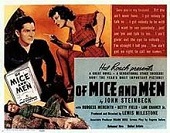
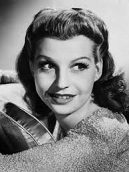
On Dec. 30, 1939 Lewis Milestone's Of Mice and Men (Dec. 30) (Hal Roach Studios) (United Artists) debuts, based on the 1937 play about Dustbowl Calif.; after fleeing Weed, Calif. to Soledad, Calif. after he is accused of rape for grabbing a woman's dress, big strong retarded Lennie Small (Lon Chaney Jr. in his first major film role), who likes to pet rabbits accidentally kills Mae (Betty Field in her breakthrough role), wife of ranch owner's son Curley (Bob Steele) while trying to stroke her hair, causing a lynch mob to come for him, after which his pal George Milton (Burgess Meredith) shoots him in the head to give him a quick death; musical score by Aaron Copland; breakthrough role for stage actress Betty Field (1913-73); filmed in 1992 starring John Malkovich and Gary Sinise.

On Dec. 31, 1939 William Dieterle's The Hunchback of Notre Dame (RKO Radio Pictures) debuts, based on the 1831 Victor Hugo novel about backward superstitious late 15th cent. France, starring Charles Laughton as Quasimodo the Bellringer, who gives an unforgettable pathetic perf. in his love for unattainable Gypsy girl Esmeralda (Maureen O'Hara); Henry Davenport plays French king (1461-83) Louis XI, Cedric Hardwick plays bad guy Frollo, and Edmond O'Brien plays Emeralda's beau Gringoire; does $3.2M box office on a $1.8M budget.

On Jan. 11, 1940 Howard Hawks' His Girl Friday debuts, based on the play "The Front Page" by Ben Hecht and Charles MacArthur, starring Cary Grant as newspaper ed. Walter Burns, who tries to prevent his fast-talking reporter ex-wife Hildy Johnson (Rosalind Russell) from marrying hunk Bruce Baldwin (Ralph Bellamy) and leaving the biz to move in with him and his mother in Albany.

On Jan. 12, 1940 Ernst Lubitsch's B&W The Shop Around the Corner (MGM) debuts, written by Samson Raphaelson based on the 1937 play "Parfumerie" by Miklos Laszlo, starring James Stewart and Margaret Sullavan in their 3rd of four screen pairings as feuding Budapest gift shop workers Alfred Kralik and Klara Novak, who each have secret pen pal lovers but don't know it's each other; Frank Morgan plays the soft-hearted shop owner Hugo Matuschek; the shop is on Balta St. just around the corner from Andrassy St.; also stars Joseph Schildkraut; remade in 1949 as the musical "The Good Old Summertime", and in 1998 as "You've Got Mail" with Tom Hanks and Meg Ryan.

On Jan. 19, 1940 Jules White's You Nazty Spy! (Columbia) debuts, the Three Stooges' first anti-Hitler film, playing wallpaper hangers recruited for a mission to Moronica (between Jug O' Salvia, Staywayoff, and Woo-Woo, across the Hot Sea from Great Mitten); Curly plays Field Marshal Curly Gallstone, Larry plays Minister of Propaganda Larry Pebble, and Moe plays Dictator Moe Hailstone; "A poppaganda marries a mommaganda, and they raise a lot of little goslings"; "Our motto shall be Moronica for Morons."

On Jan. 24, 1940 John Ford's B&W The Grapes of Wrath (20th Cent. Fox) debuts, written by Nunnally Johnson based on the 1939 John Steinbeck novel, starring Henry Fonda as Tom Joad, Jane Darwell as Ma Joad, Russell Simpson as Pa Joad, Charley Grapewin as Grandpa Joad, John Carradine as Jim Casy, Dorris Bowdon as Rosasharn et al. as the Okie Joad family migrating to Calif. to get away from the Dust Bowl, only to be treated like merde and go Socialist; it ends with Tom Joad (Fonda) uttering the soundbyte: "I'll be all around in the dark. I'll be everywhere. Wherever you can look, wherever there's a fight, so hungry people can eat, I'll be there. Wherever there's a cop beatin' up a guy, I'll be there. I'll be in the way guys yell when they're mad. I'll be in the way kids laugh when they're hungry and they know supper's ready, and when people are eatin' the stuff they raise and livin' in the houses they build, I'll be there, too", after which Ma Joad (Jane Darwell) utters the soundbyte: "Can't lick us. Can't wipe us out. We'll go on forever 'cause we're the people"; does $2.5M box office on an $800K budget; watch trailer.

On Feb. 12, 1940 John Cromwell's Abe Lincoln in Illinois debuts, based on the 1938 Robert Emmet Sherwood play, starring Raymond Massey as Abe, Ruth Gordon (screen debut) as Mary Todd Lincoln, Gene Lockhart as Stephen Douglas, and Mary Howard as Ann Rutledge.
On Feb. 29, 1940 the 12th Academy Awards in Los Angeles are hosted for the 1st time by Bob Hope (first of 18x); the best picture Oscar for 1939 goes to MGM's Gone With the Wind, along with best actress to Vivien Leigh, best supporting actress to Hattie McDaniel (first black actress to win, and first to be allowed at the AA ceremony, although seated near the kitchen), and best dir. to Victor Fleming; Clark Gable is passed over for the best actor award, which goes to Robert Donat for Goodbye Mr. Chips; best supporting actor goes to Thomas Mitchell for Stagecoach (who also plays Scarlett O'Hara's crazy pa Gerald in GWTW); Sidney Coe Howard wins a posth. award for the screenplay for "Gone With the Wind".

On Mar. 22, 1940 Victor Schertzinger's Road to Singapore debuts, based on the Frank Butler script "The Road to Mandalay", originally written for Burns and Allen and dug up out of the dustbin for Bob Hope and Bing Crosby after they first meet in New York City in 1932 and play two farmers meeting on the street in a vaudeville routine, which is seen by a Paramount big wig, who orders them to star in a feature film, after which they make it a hit with their great ad-libs; "Sarong Queen" Dorothy Lamour stars as the love interest (in love with one but won't say which); box office success leads to six sequels: Road to Zanzibar (1941), Road to Morocco (1942), Road to Utopia (1946), Road to Rio (1947) (the year's highest grossing movie), Road to Bali (1953) (first in color), and Road to Hong Kong (1962) - no road to Timbuktu?

On Apr. 19, 1940 Henry Hathaway's Johnny Apollo (20th Cent. Fox) debuts, starring Tyrone Power as Johnny Apollo AKA Bob Cain Jr., who resorts to crime to buy a pardon for his embezzler father Bob "Pop" Cain (Edward Arnold); Lloyd Nolan plays gangster Mickey Dwyer, Dorothy Lamour plays his moll Lucky Dubarry, and Charley Grapewin plays Judge Brennan; the film debut of Anthony Caruso (1916-2003) as a henchman; "I'm leaving town"; "Where?"; "As far as 20 bucks and a mink coat will take me."
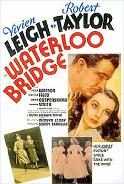
On May 17, 1940 Mervyn LeRoy's Waterloo Bridge (MGM) debuts, a remake of the 1931 film based on the 1930 Robert E. Sherwood play, starring Vivien Leigh in her first role after Scarlett O'Hara as a ballet dancer romancing English soldier Robert Taylor until he's listed as dead, causing her to go ho until he returns and they start over on the same tear-jerking bridge, the one with the best view in London; Maria Ouspenskaya plays tyrannical ballet troupe mistress Madame Olga.

On June 28, 1940 H. Bruce Humberstone's Lucky Cisco Kid (20th Cent. Fox) debuts, based on the O. Henry short stories, starring Cesar Romero, becoming the film debut of Covington County, Miss.-born Carver Dana Andrews (1909-92) as Sgt. Dunn.
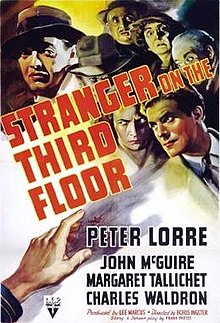
On Aug. 16, 1940 Boris Ingster's Stranger on the Third Floor (RKO Radio Pictures) debuts, starring Peter Lorre as the Stranger, and John McGuire as framed murderer Mike Ward, who sends his babe Jane (Margaret Tallchief, new wife of dir. William Wyler) to desperately search for him to clear him; regarded as the first true film noir; does ? box office on a $171K budget.
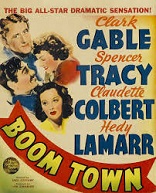
On Aug. 30, 1940 Jack Conway's B&W Boom Town (MGM) debuts, starring Clark Gable and Spencer Tracy as broke feuding friend oil wildcatters Big John McMasters and Square John Sand, and Claudette Colbert and Hedy Lamarr as their babes Elizabeth "Betsy" Bartlett McMasters and Karen Vanmeer; does $5M box office on a $1.6M budget; "I'm your girl, you can lick me all you want if it helps."

On Sept. 20, 1940 William Wyler's The Westerner (United Artists) debuts, starring Walter Brennan as hanging Judge Roy Bean of Vinegaroon, Tex., Gary Cooper as drifter Cole Harden, Forrest Tucker as Wade Harper, Paul Hurst as Chickenfoot, Dana Andrews as Hod Johnson, and Lilian Bond as Lily Langtry.
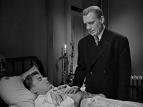
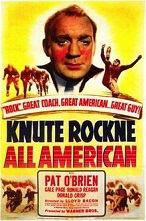


On Oct. 4, 1940 Lloyd Bacon's and William K. Howard's Knute Rockne: All American (Warner Bros.) debuts, becoming the major film debut of Ronald Wilson Reagan (1911-2004), and his signature performance as Notre Dame U. football star "The Gipper" George Gipp (1895-1920), who dies in hospital room #23; Pat O'Brien plays Notre Dame coach Knute Rockne, uttering the immortal soundbyte: "Tell the boys to win one for the Gipper", which is deleted from the TV airing of the film after the Gipp family files a lawsuit. On Jan. 26, 1940 Hollywood actor Ronald Wilson Reagan (1911-2004) marries actress Jane Wyman (Sarah Jane Mayfield) (1917-2007) (until June 28, 1948) in Wee Kirk o' the Heather Church in Forest Lawn, Calif.; they have one adopted son, Michael (b. 1945) and two daughters, Christine (born and died on June 26, 1947), and Maureen Reagan (1941-2001).


On Oct. 11, 1940 Irving Cummings' Down Argentine Way debuts, starring Don Ameche as a suave Argentine horse breeder, making a star of Elizabeth Ruth "Betty" Grable (1916-73), who is touted as having the most beautiful legs in Hollywood (thigh 18.5", calf 12", ankle 7.5"), which her studio insures with Lloyds of London for $1M; first U.S. film of Brazilian samba singer Carmen Miranda (1909-55), who likes to wear fruit on her head while singing.

On Oct. 15, 1940 Charlie Chaplin's The Great Dictator (United Artists) debuts, becoming Chaplin's first all-dialogue film, playing duel roles as a Jewish barber with amnesia who is mistaken for Adenoid Hynkel, dictator of Tomania, effectively ridiculing Herr Hitler so much that he bans it in Germany; the world is a giant balloon to play with?; Jack Oakie plays Benzino Napaloni of Bacteria; Chaplin works so hard at using his mustache as a prop that he never appears with one onscreen again?; does $5M box office on a $2M budget; features the Globe Dance Scene.

On Oct. 31, 1940 the $1.6M art deco Hollywood Palladium at 6215 Sunset Blvd. between Argyle and El Centro Aves. in Los Angeles, Calif., built on the original Paramount Pictures lot by Norman Chandler opens, featuring a 11.2K sq. ft. kidney-shaped maplewood dance floor (cap. 4K), designed by Hoover Dam and LA Times Bldg. architect Gordon Kaufmann, hosting a dance featuring Tommy Dorsey and His Orchestra and vocalist Frank Sinatra attended by Lana Turner and her hubby Artie Shaw; during WWII it hosts radio broadcasts by Betty Grable; in 1961 it becomes the home of the Lawrence Welk Show.

On Nov. 13, 1940 Walt Disney's animated 124-min. $2.28M Fantasia debuts, becoming the first commercial film released in stereo, mixing cartoons, abstract art, and classical music, conducted by Leopold Stokowski (1882-1977), incl. Paul Dukas' 1897 The Sorcerer's Apprentice starring Mickey Mouse (in his comeback after being eclipsed by Donald Duck), Amilcare Ponchielli's 1876 Dance of the Hours starring ballet-dancing Hyacinth Hippo, J.S. Bach's 1707 Toccata and Fugue in D Minor, Peter Tchaikovsky's 1892 Nutcracker Suite, Modest Mussorgsky's 1886 Night on Bald Mountain, and Igor Stravinsky's 1913 The Rite of Spring, which chucks the composer's pagan rite stuff and uses it to ilustrate the drawing room, er, Darwinian history of the Earth up to the extinction of the dinosaurs; Ben Ali Gator; the 1941 release uses the Fantasound system, using a separate film for the sound with four double-width optical sountracks; Deems Taylor (1885-1966) is the film's MC; too bad, despite being a landmark work, it opens in only 14 theaters because of the needed special equipment, and flops with classical music-hating audiences, almost bankrupting Disney, after which it is cut down to 81 min. in 1942 to try to make a buck; the Hewlett-Packard Co. scores its first big sale when Disney buys their audio oscillators for creating SFX.


On Nov. 15, 1940 A. Edward Sutherland's One Night in the Tropics (Universal Pictures) debuts, based on the 1914 novel "Love Insurance" by Earl Derr Biggers, becoming the film debut of the N.J.-born comedy team of William Alexander "Bud" Abbott (1895-1974) and Lou Costello (1906-59), who are supposed to have minor roles but steal the show with five classic routines, incl. Who's On First?; they were discovered by dir. Henry Koster at a nightclub in New York City; female lead Mary Jeanette "Peggy" Moran (1918-2002) becomes Koster's 2nd wife in 1942, making him promise her that he will put her in every film he makes, which he ends up doing by using a sculptured head, usually on a piano, desk, or mantelpiece (a Grecian bust in a villa in "The Robe"); by 1942 Abbott and Costello become the most popular and highest paid actors in Hollywood.

On Dec. 1, 1940 George Cukor's The Philadelphia Story debuts, based on the Philip Barry play, starring Katharine Hepburn, Cary Grant, and James Stewart in a comedy love triangle about a woman who divorces a man (Grant) then finds him irresistible despite the advances of another man (Stewart); music by Franz Waxman; Hepburn had revived her Broadway career with it and was advised by her "lustiest" lover Howard Hughes to buy the rights so they'd have to cast her in the lead; remade in 1956 as "High Society"; Grant donates his fee to the British war effort, and establishes his screen persona, sticking with it in future movies, saying "Well, who else could I portray? I can't portray Bing Crosy. I'm Cary Grant. I'm myself in that role."

On Dec. 5, 1940 Michael Powell's The Thief of Bagdad debuts, produced by Alexander Korda, starring John Justin as Ahmad, Conrad Veidt as evil grand vizier Jaffar, Sabu as Abu the Thief, and Rex Ingram as the cool giant black Genie.
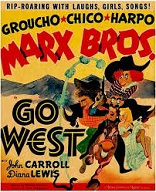
On Dec. 6, 1940 Edward Buzzell's B&W Go West (MGM) debuts, another Marx Brothers vehicle, starring Groucho as S. Quentin Quale, and Chico and Harpo as Joe and Rusty Panello, co-starring John Carroll as Terry Turner and Diana Lewis as Eve Wilson; "I was gonna thrash them within an inch of their lives but I didn't have a tape measure" (Groucho); "Time wounds all heels" (Groucho).
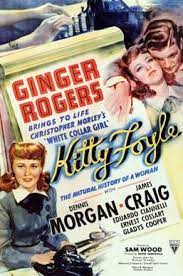
On Dec. 27, 1940 Sam Wood's Kitty Foyle: The Natural History of a Woman (RKO Radio Pictures) debuts, based on the 1939 Christopher Morley novel, starring Ginger Rogers as a hardworking white collar page-boy-with-victory-curls-wearing girl from Philly who falls for rich married socialite Wynnewood "Wyn" Strafford VI (Dennis Morgan) and debates running away to South Am. with him after he leaves his wife and young son; meanwhile her finance, poor physician Mark Elsen (James Craig) waits in the wings; Odette Myrtil plays Kitty's friend Delphine Detaille; does $2.385M box office ona $738K budget.
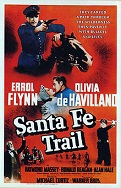
On Dec. 28, 1940 Michael Curtiz'Santa Fe Trail (Warner Bros.) debuts, filmed at the Lasky Movie Ranch in Simi Hills, Calif., starring Ronald Reagan as Gen. George Armstrong Custer, and Errol Flynn as Gen. J.E.B. Stuart chasing charismatic Bible-thumping abolitionist John Brown (Raymond Massey) in a moose-hockey version of U.S. history; Olivia de Havilland plays Stuart's and Custer's babe Kit Carson Holliday.

In 1940 young aspiring actor Eldred Gregory Peck (1916-2003) poses in men's clothing for the Montgomery Ward catalog.
On Jan. 31, 1941 Arthur Lubin's Buck Privates debuts, starring Bud Abbott and Lou Costello as Slicker Smith and Herbie Brown, and featuring the hot Andrews Sisters to draw audiences.

On Jan. 31, 1941 Alfred Hitchcock's B&W Mr. and Mrs. Smith (RKO Radio Pictures) debuts, starring Robert Montgomery and Carole Lombard in a screwball comedy about David and Ann Krausheimer Smith, who are married three years until a technicality voids the marriage; refilmed in 2005 starring Brad Pitt and Angelina Jolie.
On Feb. 27, 1941 the 13th Academy Awards (first with sealed envelopes and the phrase "May I have the envelope, please?") awards the best picture Oscar for 1940 to United Artists' Rebecca, best actor to James Stewart for The Philadelphia Story, best actress to Ginger Rogers for Kitty Foyle, best dir. to John Ford and best supporting actress to Jane Darwell for The Grapes of Wrath; Walter Brennan wins his 3rd best supporting actor Oscar for The Westerner ("Come and Get It", 1936; "Kentucky", 1938).


On May 1, 1941 Orson Welles' Citizen Kane (Mercury Productions) debuts, becoming the dir. debut of Orson Welles (1915-85); co-written by Herman J. Mankiewicz based on the life of William Randolph Hearst incl. his push to defeat Socialist Upton Sinclair in the 1934 Calif. gov. race; about Charles Foster Kane, his gloomy Xanadu estate, and his rise from idealistic newspaperman to ruthless Caesar, his dying word being "Rosebud" as a glass snow globe drops and smashes, causing reporter Jerry Thompson (William Alland) to try to find out what it means; considered by many critics to be the best movie ever made, the real Hearst gets pissed-off at it and prohibits its mention in any of his newspapers; gains nine Oscar nominations, but only wins for best screenplay; launches the careers of the Mercury Players, incl. Joseph Cotten, Agnes Moorehead, Ruth Warrick, and Ray Collins; "I guess Rosebud is just a piece in a jigsaw puzzle... a missing piece" (William Allandon); "There but for the grace of God goes God" (Herman Mankiewicz about Welles); after he loses his favorite sled Rosebud, he gets the Crusader.

On May 3, 1941 Frank Capra's Meet John Doe (Warner Bros.), debuts, written by Robert Riskin, starring Gary Cooper as unemployed baseball pitcher Long John Willoughby, who agrees to impersonate nonexistent John Doe and claim to be planning to commit suicide on the city hall steps to protest unemploment in the Depression for struggling reporter Ann Mitchell (Barbara Stanwyck) in return for getting his bad throwing arm fixed, posing in a hotel room for ghostwritten articles to build the paper's circulation; too bad, the public goes crazy and launches John Doe Clubs everywhere, forcing him to play along with a plot to put unscrupulous fatcat D.B. Norton (Edward Arnold) into the White House; "I protest against the condition of civilization"; also stars Spring Byington as Ann's mother, and Walter Brennan as John's Helot-hating bum friend the Colonel.

On May 30, 1941 Rouben Mamoulian's Blood and Sand (Fox) debuts, a remake of his 1922 silent Rudolph Valentino film, starring Tyrone Power as lusty bullfighter Juan Gallardo, who forsakes bulls for broads, and makes a star of "Hollywood Love Goddess" Rita Hayworth (Margarita Carmen Cansino) (1918-87), who plays Dona Sola des Muire, getting the role because bottle blonde Carole Landis refuses to dye her hair red, going on to become a top starlet known for her dancing ability, marrying Orson Welles in 1943-8 and Prince Aly Khan in 1949-53.

On Aug. 12, 1941 Victor Fleming's Dr. Jekyll and Mr. Hyde debuts, a remake of the 1931 film based on the 1886 Robert Louis Stevenson novella, starring Spencer Tracy babing it up with Ingrid Bergman and Lana Turner; music by Franz Waxman.


On Aug. 21, 1941 William Wyler's The Little Foxes debuts, based on the 1939 Lillian Hellman play, starring Bette Davis in the Tallulah Bankhead role as Regina Giddens, along with Herbert Marshall as Horace Giddens, and Teresa Wright as Alexandra Giddens, becoming the film debut of Irish stage actress Patricia Collinge (1892-1974), who also starred in the play as Birdie Hubbard; after finding out that Warner Bros. (whom she tried to free herself from in 1937 unsuccessfully) was paid $385K for her appearance, she haggles them into upping her $3K a week salary.

The beginning of the PC Police? On Sept. 11, 1941 American hero Charles Augustus Lindbergh (1902-74) gives a speech in Des Moines, Iowa, charging that "the British, the Jews and the Roosevelt administration" are trying to drag the U.S. into WWII, saying "Instead of agitation for war the Jewish groups in this country should be opposing it in every possible way, for they will be among the first to feel its consequences... Their greatest danger to this country lies in their large ownership and influence in our motion pictures, our press, our radio, and our government"; the media backlash causes him to go on the defensive and deny that he is anti-Semitic, hampering his efforts to keep the U.S. out of the war.

On Sept. 13, 1941 Lloyd Bacon's Navy Blues (Warner Bros.) debuts, starring Ann Sheridan, Jack Oakie, Martha Raye, Jack Haley, Herbert Anderson, and Jack Carson, becoming the film debut of Brooklyn, N.Y.-born John Herbert "Jackie" Gleason (1916-87), who appears in several films before making it big with his TV show "The Honeymooners" in 1951.

On Sept. 27, 1941 Howard Hawks' Sergeant York debuts, starring Gary Cooper as backward naive Bible-thumping Tenn. hillbilly Alvin C. York, who gets drafted into WWI and becomes a hero, while his babe Gracie Williams (Joan Leslie) waits for him back home; Walter Brennan plays pastor Rosier Pile; Margaret Wycherly plays his mother; the real York wouldn't let any other actor play him.

On Oct. 28, 1941 John Ford's How Green Was My Valley debuts, based on the 1939 Richard Llewellyn novel, starring Walter Pidgeon, Maureen O'Hara, Donald Crisp, and Anna Lee, spanning 50 years in the life of a Victorian S Welsh mining family, shot in a fake Welsh valley set up in Calif.; the screen debut of 13-y.-o. Roddy McDowall (1928-98).


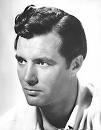
On Oct. 29, 1941 William Dieterle's The Devil and Daniel Webster (All That Money Can Buy) debuts, based on the 1937 Stephen Vincent Benet novel (who stole it from Goethe's Faust), starring hunk James Craig (1912-85) as N.H. farmer Jabez Stone, who despite being graced with beautiful pious wife Mary Stone (Anne Shirley) and Bible-thumping Ma (Jane Darwell) sells his soul to Mr. Scratch, played by Walter Huston (1884-1950) for seven years of good luck and fortune, and is saved by Daniel Webster (Edward Arnold); Simone Simon plays devilish temptress Belle Dee.
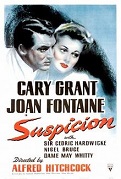
On Nov. 14, 1941 Alfred Hitchcock's Suspicion (RKO Radio Pictures) debuts, based on the 1932 Francis Iles novel "Before the fact" is a suspense thriller about dowdy heiress Lina McLaidlaw Aysgarth (Joan Fontaine), who is seduced by killer hunk Johnnie (Cary Grant) into eloping, then finds out that he is a sponger and may be the other type of killer and have her on his list for her life insurance; RKO messes up the ending with its insistence that their main man not "really" be a killer, leaving his guilt up in the air with her legs?; music by Franz Waxman; does $4.5M box office on a $1.1M budget.

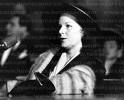
On Dec. 2, 1941 Howard Hawks' Ball of Fire (a morphing of "The Wizard of Oz") debuts, about eight zany professors, incl. Oscar Homolka as Prof. Gurkakoff, Richard Haydn as Prof. Oddly, and too-young-to-be-one Gary Cooper as Bertram Potts, an English prof. studying to write an encyclopedia article on modern slang, and Barbara Stanwyck as Katherine "Sugarpuss" O'Shea, a tempting gang moll using his Totten Foundation house as a hideout; while sexually-naive bookworm Potts studies phrases such as "drum boogie", "killer diller", "hoiti toiti", "slap happy", "bim buggy", "shove in your clutch", "shout the sherbert to me Herbert", "what's buzzin', cousin?", "what's boolin', shug?"; "crabapple Annie", "mankika", and "mahaha", they fall in love, and now all he has to do is beat her gangster beau Joe Lilac (Dana Andrews) in a fistfight; co-stars "Queen of the Mafia" Virginia "Sugar" Hill (1916-66), who is escorted to the premiere by her beau Bugsy Siegel, whose friend George Raft testifies on his behalf this year to get him off bookmaking charges; features Drum Boogie, composed and performed by Gene Krupa, with Stanwyck's singing dubbed by Martha Tilton; too bad, the comedy is overshadowed by the tragedy of the entire post-WWI gen. about to march to WWII?
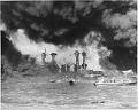
On Dec. 7, 1941 the Japanese Attack on Pearl Harbor plunges the U.S. into WWII, silencing the isolationists.

On Dec. 12, 1941 George Waggner's The Wolf Man (Universal Pictures) debuts, starring Lon Chaney Jr. (Creighton Till Chaney) (1906-73), who is bitten by werewolf Bela Lugosi, and becomes one; features Maria Ouspenskaya as a gypsy; the plants on the Universal set have no roots?; "Night monster with the blood lust of a savage beast!"
On Dec. 25, 1941 Lewis Seiler's You're in the Army Now debuts, starring Regis Toomey and Jane Wyman (Mrs. Ronald Reagan) in the longest screen kiss (185 sec.) until ?.
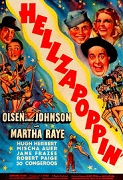
On Dec. 26, 1941 H.C. Potter's Hellzapoppin' (Universal Pictures) debuts,, based on the hit 1938 musical comedy "Helzapoppin" by the comedy team John Sigvard "Ole" Olsen (1892-1963) and Harold Ogden "Chic" Johnson (1891-1962), starring Martha Raye as Betty Johnson, Shemp Howard as Louie, and Mischa Auer as Pepi; features a great Lindy Hop Dance Scene.

On Dec. 26, 1941 Mitchell Leisen's I Wanted Wings debuts, about three Army Air Corps recruits (Ray Milland, William Holden, Tom Cassidy), becoming the breakthrough hit for blonde actress Veronica Lake (1922-73) (known for her peekaboo hairdo), who later utters the soundbyte "I never did cheesecake, I just used my hair"; her look is created by Paris-born fashion designer Oleg Cassini.

In Dec. 1941 Preston Sturges' Sullivan's Travels (Paramount) debuts, written by Preston Sturges, a satire starring Joel McCrea as film dir. John L. Sullivan, who wants to make a socially relevant drama called "O Brother, Where Art Thou?", and ends up making a comedy; also stars Veronica Lake, who is credited as "The Girl".

In 1941 Scripps Howard journalist (1933-44) and Hearst syndicate journalist (1944-62) Westbrook Pegler (1894-1969) becomes the first journalist to win the Pulitzer Prize for journalism for exposing racketeering in Hollywood, esp. William Morris "Willie" Bioff (1900-55).



In 1941 Ga.-born "Jeepers, Creepers", "Fools Rush In" songwriter John Herndon "Johnny" Mercer (1909-76) begins an affair with 19-y.-o. Judy Garland (1922-69), who is engaged to British-born "The Stripper" composer David Rose (1910-90, causing the latter to marry her faster on July 28; they divorce in 1944 after she has an abortion to avoid having children.
In 1941 Mary Pickford, Charlie Chaplin, Walt Disney, Orson Welles, Samuel Goldwyn, David O. Selznick, Alexander Korda, and Walter Wanger found the Society of Independent Motion Picture Producers.

On Jan. 1, 1942 Herbert Kline's Five Were Chosen debuts, written by Budd Schulberg, becoming the film debut of classy Mexican hunk Ricardo Montalban (Ricardo Gonzalo Pedro Montalban Merino) (1920-2009).

On Jan. 19, 1942 George Stevens' Woman of the Year debuts, written by Ring Lardner Jr. and Michael Kanin, starring Spencer Tracy and Katharine Hepburn as married rival journalists Sam Craig and Tess Harding (based on Dorothy Thompson), becoming the first of 10 films pairing married Irish Catholic alcoholic Tracy and women's libber Scottish Protestant slut, er, actress of the cent. Hepburn, whose offscreen romance beats out their onscreen acting for fan appeal; they stay together until his death in 1967 even though he never divorces his wife; she gets the part by wearing 4-in. heels to bully Louis B. Mayer into freeing her from making "The Yearling"?; Hepburn's role is based on Dorothy Thompson.


On Jan. 24, 1942 Victor L. Schertzinger's The Fleet's In (his final film before an unexpected heart attack) debuts, starring William Holden and Dorothy Lamour, making a star of Betty Hutton (1921-2007), who steals the show with a frilly costume with bunny ears and crotch exposure

On Jan. 29, 1942 John Cromwell's Son of Fury: The Story of Benjamin Blake debuts, based on the Edison Marshall novel, starring Tyrone Power as Benjamin Blake, who is cheated out of his estate by his uncle and goes to the South Seas to make his fortune; also stars Gene Tierney as Eve, and Frances Farmer as Isabel Blake; too bad, Farmer is fired by Paramount for alcoholism, and gets a divorce from hubby (since 1936) Leif Erickson, beginning her epic downhill slide to the nuthouse.
On Feb. 26, 1942 the 14th Academy Awards awards the best picture Oscar for 1941 to 20th Century-Fox's How Green Was My Valley along with best dir. to John Ford (born Sean Aloysius O'Fearna) and best supporting actor to Donald Crisp; best actor goes to Gary Cooper for Sergeant York, best actress to Joan Fontaine for Suspicion (only actor to win for a performance in an Alfred Hitchcock film) (her sister Olivia de Havilland was also nominated for Hold Back the Dawn, a first - next in ?), and best supporting actress to Mary Astor for The Great Lie.

On Apr. 18, 1942 Sam Wood's Kings Row debuts, based on the 1940 Harry Bellamann novel, starring childhood friends Ann Sheridan and Ronald Reagan growing up in a macabre Southern town while depending on pshrink Parris Mitchell (Robert Cummings); held for a year before release.

On May 13, 1942 Frank Tuttle's This Gun for Hire debuts, based on the Graham Greene novel "A Gun for Sale", starring Alan Ladd (1913-64) as hired killer Raven, and Veronica Lake as Ellen in their first of seven movies together (only time he plays the villain?); #7 is Saigon (1948).

On June 6, 1942 Michael Curtiz' Yankee Doodle Dandy debuts, a jingoistic musical starring James Cagney as recently deceased born-on-the-4th-of-July George M. Cohan (1878-1942), rapping and dancing on a Hollywood sound stage, incl. a number as a singing-dancing polio-free FDR; does $11.8M box office; features the jingoistic songs Yankee Doodle, Give My Regards to Broadway ("Remember me to Herald Square, give my regards to Broadway"), Harrigan, Mary's a Grand Old Name, You're a Grand Old Flag, and Over There (with Frances Langford); "My mother thanks you. My father thanks you. My sister thanks you. And I thank you."
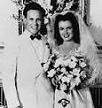
On June 19, 1942 after meeting him at age 15, Norma Jeane Baker (b. 1926) marries James Edward "Jim" Dougherty (1921-2005), who works with Robert Mitchum in a defense plant, and next year joins the U.S. Merchant Marine, heading for Santa Catalina Island, where she joins him, then heading overseas in 1944 while she works for the Radioplane Co. in Burbank, Calif., which features her in some war propaganda photos that are pub. in the Aug. 2, 1945 issue of Yank, the Army Weekly, becoming her start as a model; after getting ideas about going bigtime, she divorces him on Sept. 13, 1946; in 1947 he joins the Los Angeles Police Dept. and marries Patricia Scoman.
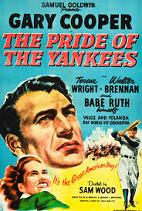
On July 14, 1942 Sam Wood's B&W The Pride of the Yankees: The Life of Lou Gehrig (RKO) debuts, based on a story by Paul Gallico, starring Gary Cooper as New York Yankees "Bronx Bombers" first baseman Lou "Iron Horse" Gehrig, who died on June 2, 1941 of ALS after playing 2,130 straight games; features Babe Ruth, Bob Meusel, Mark Koenig, Bill Dickey, and sportscaster Bill Stern playing themselves; Teresa Wright plays his babe Eleanor; Gene Collins play 8-y.-o. sick kid Billy, who is promised two homers in a single World Series game by Gehrig; last line "People all say that I've had a bad break, but today, today I consider myself the luckiest man on the face of the Earth."
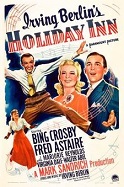
On Aug. 4, 1942 Mark Sandrich's Holiday Inn (Paramount Pictures) debuts, starring Bing Crosby and Fred Astaire as rival song-and-dance men Jim Hardy and Ted Hanover, who woo the same women (Marjorie Reynolds, Virginia Dale) while working to turn a Conn. farm into an entertainment inn only open on holidays 15 days a year; a vehicle for the 12 Irving Berlin songs incl. "Easter Parade", "White Christmas", and "Be Careful, It's My Heart"; Astaire performs the Firecracker Dance; Crosby stinks himself up in blackface in Abraham; does $3.75M box office; remade in 1954 as guess what "White Christmas"?


On Sept. ?, 1942 Norman Z. McLeod's Panama Hattie debuts, a MGM musical based on the 1940 Cole Porter musical, starring Red Skelton as Red, and Ann Sothern as Hattie; the major studio film debuts of "Bronze Venus" Lena Mary Calhoun Horne (1917-2010) and comic actor John Lee Morgan Beauregard "Rags" Ragland (1905-46), who goes on to star in MGM comedies with Abbott and Costello, Judy Garland, Frank Sinatra, Lucille Ball, and Red Skelton before his sudden tragic death from alcoholism.


On Oct. 19, 1942 (night) brainy and beautiful but alcoholic blonde Hollywood starlet Frances Farmer (1913-70) is arrested by police in Santa Monica, Calif. for driving while intoxicated with her headlights on in a wartime blackout zone, jailed overnight, fined $500 and given a 180-day suspended sentence; too bad, next Jan. she fails to pay the last $250 of the fine and is also charged with dislocating the jaw of a hairdresser on the set, and is arrested in bed and/or the bathroom at the Knickerbocker Hotel in Hollywood (nude?), and resists arrest, signing "Cocksucker" as her occupation at the police station, then chews out the pigs in court, and throws an inkwell at Judge Hickson, getting a 180-day contempt sentence, after which she resists arrest again, and is dragged away while being denied an atty., shouting "Have you ever had a broken heart?"; after her mother Lillian V. Farmer has her committed, she is put in the psycho ward of L.A. Gen. Hospital, diagnosed with paranoid schizophrenia, and given daily insulin shock therapy without her family's consent, walking away from the hospital 9 mo. later; her mother then gets legal guardianship and moves her into her home in Seattle, Wash., but after they fight she has her committed to the hellhole Western State Hospital in Steilacoom, Wash., where she is given electroshock, more insulin, and freezing water hydrotherapy, and released in summer of 1944 after her will appears to be broken, soon getting arrested for vagrancy in Antioch, Calif., and recommitted in May 1945, staying until Mar. 23, 1950 after allegedly being given a secret prefontal lobotomy, during all of which time the studios pub. fake reports of her upcoming appearances in various films to sell tickets; in 1953 she finally has her competency restored by a judge, and gets a second chance, and is never recommitted, but the jury is still out on what they did to her? On Oct. 13, 1958 after she is released from the psycho wards of Western State Hospital in Wash. state in 1950 after five years, and tells Modern Screen mag. "I blame nobody for my fall... I think I have won the fight to control myself", actress Frances Farmer (1913-70) begins hosting Frances Farmer Presents on NBC-TV in color (until Sept. 1964), showcasing vintage films and becoming the #1 show in its time slot throughout most of its run, after which her career fizzles, helped by her alcoholism and drunk driving arrests.

On Nov. 26, 1942 Michael Curtiz' Casablanca (Warner Bros.) debuts, based on the unproduced stage play "Everybody Comes to Ricks" by Murrayy Burnett and Joan Alison, starring Humphrey Bogart as Rick Blaine (age 37, brown eyes), and Ingrid Bergman as hot Swedish blonde Ilsa Lund, romancing it up at Rick's Cafe Americain in Morocco during WWII; often considered the best film ever made, changing Bogie from 1-note gangster roles to sensitive romantic roles filled with immortal 1-liners; Peter Lorre plays Ugarte, who killed two German couriers to obtain precious letters of transit (free passes through Nazi-controlled Europe and neutral Portugal), and after he tries to sell them to the highest bidder, and Rick's rival Signor Ferrari (Sydney Greenstreet) tips him off, Vichy French Capt. Louis Renault (Claude Rains) (who always loses to Rick at chess) arrests Ugarte, but Rick hides the letters for him, after which his old flame Ilsa and her Czech resistance leader hubby Victor Laszlo (Paul Henried) (for whom she left Rick in Paris) reenter Rick's life, complicating it and causing him to waffle then give the letters to them so they can escape to the U.S. together instead of requiring her to stay with him, uttering the soundbyte "Maybe not today, maybe not tomorrow, but soon and for the rest of her life" she'd regret not going with her hubby, after which Rick shoots Nazi Maj. Heinrich Strasser (Conrad Veidt), and Renault saves Rick's life by telling the police to "round up the usual suspects", after which they go off together to join the Free French in Brazzaville, with Rick uttering the closing soundbyte: "Louis, I think this is the beginning of a beautiful friendship"; "Here's looking at you, kid" was originally "Here's good luck to you, kid"; Rick and Ilse met for the last time in Paris in La Belle Aurore saloon, where black pianist Sam (Dooley Wilson) (did I mention black?) played "As Time Goes By", so for old time's sake Ilse says to Sam "Play it, Sam", later turned into the catchphrase "Play it again, Sam"; "Of all the gin joints in all the towns in all the world, she walks into mine" (Rick); "It doesn't take much to see that the problems of three little people don't amount to a hill of beans in this crazy world" (Rick); "I stick my neck out for nobody" (Rick); Rick to Strasser: "Your business is politics, mine is running a saloon"; Jack Warner wanted George Raft to play Rick, but producer Hal Wallis won out; does $3.7M box office on an $878K budget; there was no offscreen Bogey-Bergman romance?
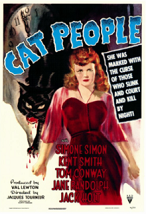

On Dec. 6, 1942 Jacques Tourneur's B&W Cat People (RKO Radio Pictures) debuts, written by DeWitt Bodeen based on producer Val Lewton's short story "The Bagheeta", starring Simone Simon as young Serbian babe Irena Dubrovna of New York City, who believes herself to be a descendant of a race of people who turn into cats when sexually aroused or deeply angered; Kent Smith plays her new hubby Oliver Reed, and Jane Randolph his asst. Alice Moore, who wants him; Tom Conway plays pshrink Dr. Louis Judd; does $8M box office on a $134K budget; the first film produced by Yalta, Russia-born novelist Val Lewton (Vladimir Ivanovich Hofschneider) (1904-51) for financially-ailing RKO Radio Pictures, with a limit of $150K budget and a time limit of 75 min. per film, going on to produce "I Walked With a Zombie" (1943), "The Leopard Man" (1943), "The Body Snatcher" (1945), "Isle of the Dead" (1945), "Bedlam" (1946), helping to turn them around before RKO head Charles Koerner dies in 1946 and he is fired, moving to Paramount, MGM, Universal, and Columbia before dying of a heart attack on Mar. 14, 1951, becoming the subject of the Kirk Douglas film "The Bad and the Beautiful" (1952); watch movie; view video; view clip; view clip; view video.

In 1942 Embassy Pictures Corp. (later AVCO Embassy Pictures, Embassy Film Assocs.) is founded by Joseph Edward Levine (1905-87) to distribute foreign films in the U.S., going ont o distribute the Steve Reeves "Hercules" films and "Godzila" before making a $30M deal in 1963 with Paramount Pictures to produce their own films, going on to produce "The Capetbaggers" (1964) "Nevada Smith" (1966), "The Graduate" (1967), "The Lion in Winter" (1968), and "The Producers" (1968); in 1968 it is acquired by Avco for $40M, going on to produce low budget genre films incl. "The Manitou" (1978), "Phantasm" (1979), "The Fog" (1979), "Scanners" (1981), "Time Bandits" (1981), and "The Howling" (1981) before going defunct in 1986.




In 1942 songwriter John Herndon "Johnny" Mercer (1909-76), songwriter-film producer George Gard "Buddy" DeSylva (1895-1950), and record store owner Glen Wallichs (1910-71) found Capitol Records (originally Liberty Records) in Los Angeles, Calif., becoming the first record company on the U.S. West Coast.

In 1942 Greek-born Spyros P. Skouros (1893-1971) becomes pres. of 20th Cent. Fox; by the 1950s he also controls Nat. Theaters, Fox West Coast Theaters, United Artists Theater Circuit, Skouras Theaters, Magna Corp. and Todd A-O, becoming richer than the Jewish theater owners, incl. the Schencks, Warners, or Schuberts; he later signs Marilyn Monroe, introduces CinemaScope in 1953, and oversees the production of film classics incl. "The Robe", "The King and I", "The Seven Year Itch", and "The Hustler"; too bad, after the expensive film "Cleopatra" flops, he is replaced by Darryl F. Zanuck, a non-Jew also.
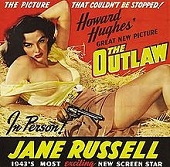
On Feb. 5, 1943 Howard Hughes' B&W The Outlaw (United Artists) debuts, starring Jack Buetel as Billy the Kid, Thomas Mitchell as Pat Garrett, Walter Huston as Doc Holliday, and is the debut and breakthrough role for Ernestine Jane Geraldine Russell (1921-2011) as Rio McDonald, who lounges seductively in the hay for publicity shots; does $5M box office.

In Feb. 1943 after an expensive divorce to 1st wife Lily Demeter that leaves him bitter for life, and being accused of statutory rape of underage girls Betty Hansen and Peggy Satterlee last Nov., and being cleared by a grand jury but prosecuted anyway, hiring atty. Jerry Giesler, and getting backing from the American Boys' Club for the Defense of Errol Flynn (ABCDEF), whose members incl. William F. Buckley Jr., Australian-born actor Errol Leslie Flynn (1909-59) is cleared at a 4-week trial by a jury of 9 women and 3 men, causing the phrase "in like Flynn" to become popular; although he is devastated personally, he continues to be popular at the box office; a political persecution because his boss Jack Warner didn't pay the usual protection money to city hall?; Flynn meets 19-y.-o. Roman Catholic future wife Nora Eddington working a cigarette-candy counter at the courthouse, and marries her after making her pregnant.
On Mar. 4, 1943 the 15th Academy Awards awards the best picture Oscar for 1942 to MGM's Allied war effort-supporting Mrs. Miniver, along with best dir. to William Wyler, best actress to Greer Garson (who gives a record 5 min. 30 sec. speech), and best supporting actress to Teresa Wright; best actor goes to James Cagney for Yankee Doodle Dandy, and best supporting actor to Van Heflin for Johnny Eager.
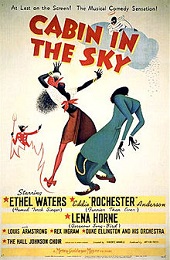
On Apr. 9, 1943 Vincente Minelli's Cabin in the Sky (MGM), based on the 1940 Lynn Root play debuts, an MGM musical starring the cream of black performers of the day, incl. Ethel Waters as Petunia Jackson, Eddie "Rochester" Anderson as Little Joe Jackson, and Lena Horne as Georgia Brown, who is edited so she can be taken out for theaters in states which ban black performers, becoming her only leading role in an MGM musical; also features Louis Armstrong and Duke Ellington; does $1.95M box office on a $679K budget.

On May 8, 1943 William A. Wellman's The Ox-Bow Incident (20th Cent. Fox) debuts, based on the 1940 Walter Van Tilburg Clark novel, set in 1885 Bridger's Wells, Nev. sees sleeping men Donald Martin (Dana Andrews), Juan Martinez (Anthony Quinn), and Alva Hardwick (Francis Ford, brother of dir. John Ford) lynched in Ox-Bow Canyon by a posse led by Maj. Tetley (Frank Conroy), and incl. Gil Carter (Henry Fonda) and Art Croft (Harry Morgan), who later learn that they were innocent; does $750K box office on a $565K budget.

On May 22, 1943 Michael Curtiz' Mission to Moscow debuts, a "$2M love letter to Stalin" by Warner Brothers, written by Howard Koch based on the 1941 bestseller by U.S. ambassador Joseph Edward Davies, starring Walter Huston as Davies, who snuggles up to Stalin and sees the Soviet Union as a bastion of freedom and civilization against the German Huns, and even falls for the 1937 Moscow Trials; made at the request of FDR to whip up support for the war effort, it is a box office bomb and loses $600K despite a $250K ad budget, becoming a cause celebre for HUAC, which targets it in 1947, grilling Jack Warner and blacklisting Koch.

On May 26, 1943 Harold D. Schuster's My Friend Flicka (20th Cent. Fox) debuts, based on the 1941 Mary O'Hara novel, starring Roddy McDowall as 10-y.-o. Wyo. rancher's son Ken McLaughlin, who nurses his 1-y.-o. colt filly back to health after being cut by barbed wire; the father Rob McLaughlin (Preston Foster) shoots his gun, but only to ward off a mountain lion, and the filly recovers.
On June 7, 1943 after an impression of one of her legs is placed in cement in front of Grauman's Chinese Theater in Feb., Life mag. pub. an issue profiling Hollywood star Betty Grable (b. 1916), calling her legs "a major Hollywood landmark", to which she replies: "They are fine for pushing the foot pedals in my car."
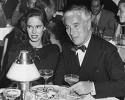
On June 16, 1943 54-y.-o. Charlie Chaplin (1889-1977) marries his 4th wife, 18-y.-o. aspiring actress Oona O'Neill (1926-91) in Carpenteria, Calf., pissing-off her daddy playwright Eugene O'Neill for marrying a grave robber only 6 mo. younger than him, causing him to quit speaking to her for life - guess what he says while doing the wild thing?
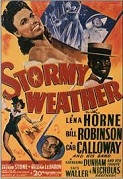
On July 21, 1943 Andrew L. Stone's Stormy Weather debuts, a 20th Cent. Fox musical written by Frederic J. Jackson and Ted Koehler, starring Cab Calloway and His Cotton Club Orchestra, and "Bronze Venus" Lena Horne as Selina Rogers, who woos black dancer Bill Williamson (Bill Robinson), based on Bill "Bojangles" Robinson; features performances by Katherine Dunham and Her Troupe, Fats Waller, The Nicholas Brothers, The Tramp Band, and Dooley Wilson; incl. Stormy Weather by Lena Horne, and the Jumpin' Jive Sequence, which Fred Astaire calls "The greatest movie musical number he had ever seen."

On Aug. 14, 1943 Michael Curtiz' This is the Army debuts, starring future Calif. sen. George Murphy, future Calif. gov. Ronald Reagan, and Joan Leslie in a tribute to the U.S. soldier in WWII based on music and a play by Irving Berlin (1888-1989), who also acts, along with every extra in Hollywood?
On Aug. 23, 1943 actress Olivia de Havilland files a lawsuit against Warner Bros. for their abuse of the 1872 Calif. Civil Code that forces actors to work far longer than specified in their contracts by legal tricks, resulting in a unanimous decision (the De Havilland Law) in her favor on Dec. 8, 1844 that the studios can't hold an actor to a contract beyond seven calendar years, weakening their hold on their careers.
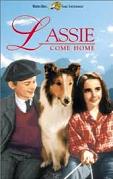


On Oct. 7, 1943 Fred M. Wilcox's Lassie Come Home (MGM) debuts, based on the 1940 Eric Knight novel, starring Roddy McDowall as Joe Carraclough, Elizabeth Taylor as Priscilla, Donald Crisp and Elsa Lanchester as Mr. and Mrs. Carraclough, and Nigel Bruce as the Duke of Rudling; does $4.5M box office on a $666K budget; the first of seven films (1943-51) about the smart collie (Lassie, not Liz), played by Rudd's Rough Collie Pal (1940-58), owned by Engle, N.M.-born trainer Ruddell Bird "Rud" Weatherwax (1907-85); Lassie, Lassie Jr., and Tommy Rettig star in the TV version in 1954-7.

On Dec. 21, 1943 Henry King's The Song of Bernadette debuts, based on the 1942 Franz Werfel novel, starring Jennifer Jones (Phyllis Lee Isley) (1919-2009) as lucky 1858 Roman Catholic babe St. Bernadette Soubirous, who is visited by the Virgin Mary, causing Lourdes, France to become a big Catholic tourist destination; during filming she hooks up with producer David O. Selznick even though she's married to actor Robert Walker.

On Dec. 24, 1943 Busby Berkeley's The Gang's All Here (20th Cent. Fox) debuts, making a star of Portuguese-born Carmen Miranda (1909-55) after she wears a fruit hat, heavy on the phallic bananas, singing The Lady in the Tutti Frutti Hat.

On Jan. 1, 1944 Tim Whelan's Higher and Higher debuts, based on the 1940 Broadway musical by Joshua Logan and Gladys Hurlbut, starring Michele Morgan and Jack Haley, becoming the feature film debut of Am. "New York, New York", "My Way" singer-actor ("Ol' Blue Eyes") ("the Chairman of the Board") ("the Wop") Francis Albert "Frank" Sinatra (1915-98); does $2M box office on a $600K budget.
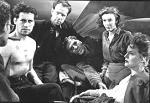
On Jan. 11, 1944 Alfred Hitchcock's B&W Lifeboat (20th Cent. Fox) debuts, based on a John Steinbeck story is the ultimate talking heads movie, starring Tallulah Bankhead (first film appearance since "Faithless" in 1932), William Bendix, John Hodiak, Canada Lee, Walter Slezak, Hume Cronyn, Henry Hull and Mary Anderson; "As for now I'm skipper, and anybody who don't like it can get out and swim."

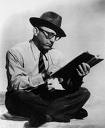
On Jan. 28, 1944 Robert Siodmak's Phantom Lady debuts, produced by Universal's first woman exec. Joan Harrison (1907-94) (former asst. of Alfred Hitchcock) stars Alan Curtis as Scott Henderson, whose wife is murdered while he is out with a mysterious woman wearing a hat he picks up in a bar, who disappears, causing his alibi to fail, after which his faithful secy. Carol "Kansas" Richman (Ella Raines) races to save him; first of a string of film noirs by German-born Jewish-Am. dir. Robert Siodmak (1900-73).


On Mar. 27, 1944 Elliott Nugent's Up in Arms debuts, becoming the film debut of Danny Kaye (David Daniel Kaminsky) (1911-87) as New York City elevator operator Danny Weems, who gets drafted; up-and-coming singer-actress Dinah (Frances Rose) Shore (1916-94) plays his babe nurse Lt. Virginia Merrill.
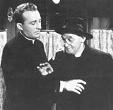
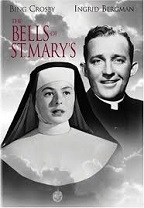
On May 3, 1944 Leo McCarey's B&W Going My Way (Paramount Pictures) debuts, based on a story by McCarey, starring Bing Crosby as singing priest Father Charles Francis Patrick "Chuck" O'Malley of St. Dominic's in New York City, for which he wins a best actor Oscar, with Bob Hope saying that any man with four kids who can play a priest deserves to win; Barry Fitzgerald plays Father Fitzgibbon; the film is nominated for nine Oscars, and wins seven; highest-grossing film of 1944 and the decade; after WWII Crosby and McCarey present a copy of the film to Pope Pius XII at the Vatican; features the song Swinging on a Star by Johnny Burke and Jimmy Van Heusen. On Dec. 6, 1945 Leo McCarey's The Bells of St. Mary's (RKO Radio Pictures) debuts, starring Bing Crosby reprising his role as Father O'Malley, and Ingrid Bergman as Sister Mary Benedict, who engage in friendly non-sexual rivalry to build up a big city Roman Catholic school; does $8M box office on a $1.3M budget (#1 grossing film of 1945); Michael Corleone and his wife Kay are watching it when the rival Tattaglia mob hits his daddy Don Vito "the Godfather" Corleone.
On Mar. 2, 1944 the 16th Academy Awards awards the best picture Oscar for 1943 to Warner Bros.' Casablanca, along with best dir. to Michael Curtiz; best actor goes to Paul Lukas for Watch on the Rhine, best actress to Jennifer Jones for The Song of Bernadette (beating her friend Ingrid Bergman in For Whom the Bell Tolls, who tells her not to apologize, with the soundbyte "Your Bernardette was better than my Maria"), best supporting actor to Charles Coburn for The More the Merrier, and best supporting actress to Katina Paxinou for For Whom the Bell Tolls.
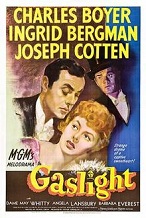

On May 4, 1944 George Cukor's Gaslight (MGM) debuts, a remake of the 1940 British film based on the 1938 Patrick Hamilton play, sarring Charles Boyer, Ingrid Bergman, and Joseph Cotten, becoming the film debut of London-born Angela Brigid Lansbury (1925-) as a tarty maid; does $4.6M box office on a $2M budget.

On July 24, 1944 Fred Zinnemann's The Seventh Cross debuts, based on the 1942 Anna Seghers novel, starring Spencer Tracy as the last of seven men who escaped from a Nazi concentration camp and got caught and put to death on a cross by the cruel commandant, and how he beats the odds and escapes to wooden shoe country; the first film to feature married actors (1942-94) Hume Blake Cronyn (1911-2003) and Jessica Alice Tandy (1909-94); does $3.57M box office on a $1.34M budget.
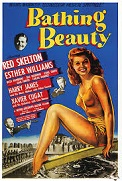
In July 1944 George Sidney's Bathing Beauty (original title "Mr. Co-Ed") debuts, starring Red Skelton as songwriter Steve Elliott, becoming the first "aquamusical" starring swimmer-actress Esther Jane Williams (1921-2013), who plays his college swimming instructor babe Caroline Brooks; in 1945-9 she has a film in the top-20 each year.

On Sept. 6, 1944 Billy Wilder's Double Indemnity debuts, based on the 1936 James M. Cain novel, starring Fred MacMurray (1908-91) (after George Raft turns it down) as insurance salesman Walter Neff, who lets his client's wife Phyllis Dietrichson (Barbara Stanwyck) talk him into killing him to get the you know what, causing insurance analyst Barton Keyes (Edward G. Robinson) to get on his case; "We were talking about automobile insurance, only you were thinking about murder."
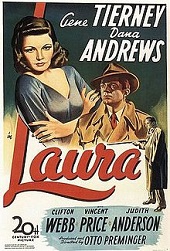
On Oct. 11, 1944 Otto Preminger's B&W Laura (20th Cent. Fox) debuts, written by Ring Lardner Jr. et al. based on the 1942 novel by Vera Caspary, a classic film noir starring Gene Eliza Tierney (1920-91) (with 28 costume changes) as New York City society beauty Laura Hunt, who is murdered with a shotgun in her Park Ave. apt. (featuring a large portrait of her), bringing in detective Mark McPherson (Dana Andews), who questions critic Waldo Lydecker (Clifton Webb) and her playboy fiancee Shelby Carpenter (Vincent Price), until she suddenly reappears, becoming the main suspect for the murder of model Diane Redfern; original dir. Rouben Mamoulian and star Jennifer Jones are dumped when the budget is upped.
On Oct. 18, 1944 the Hollywood Committee, led by Louis B. Mayer and David O. Selznick holds the Hollywood for Dewey Rally at the Los Angeles Coliseum for 93K supporters of Repub. pres. candidate Thomas E. Dewey and Calif. gov. Earl Warren, emceed by Lionel Barrymore, featuring celebs Don Ameche, Eddie Arnold, William Bendix, George Burns, Gracie Burns, Gary Cooper, Walt Disney, Irene Dunne, Clark Gable, Cary Grant, Hedda Hopper, Fred MacMurray, Raymond Massey, Adolphe Menjou, Ray Milland, George Murphy, Walter Pidgeon, William Powell, Ginger Rogers, Randolph Scott, and Barbara Stanwyck; most of the other Hollywood celebs are Democrats.
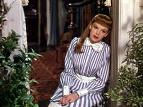
On Nov. 28, 1944 Vincente Minnelli's Meet Me in St. Louis (MGM) debuts, becoming the first Hollywood musical with songs that advance the story line, written by Fred Finklehoffe and Irving Brecher based on the book by Sally Benson about the 1904 St. Louis World's Fair; stars Judy Garland as Esther Smith, Margaret O'Brien as Tootie Smith, Lucille Bremer as Rose Smith, Joan Carroll as Agnes Smith, four marriageable sisters whose daddy Alonzo Smith (Leon Ames) and mommy Anna (Mary Astor) are about to move them to New York City despite their love entanglements; Minnelli meets future wife Garland on the set, marrying in 1945-51; does $6.5M box office on a $1.9M budget; incl. the 1904 song Meet Me in St. Louis by Kerry Mills and Andrew B. Sterling, plus new songs by Hugh Martin (1914-) and Ralph Blane (1914-95), \ incl. The Trolley Song, Have Yourself a Merry Little Christmas, The Boy (Girl) Next Door.
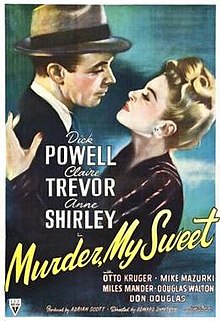
On Dec. 9, 1944 Edward Dmytryk's Murder, My Sweet (RKO Pictures) debuts, based on the 1940 Raymond Chandler novel "Farewell, My Lovely" (title changed to promote Powell's segue from a musical comedy actor to a serious actor)) , starring Dick Powell as hardboiled PI Philip Marlowe, along with hot babes Helen Grayle/Velma Valento (Claire Trevor) and Ann Grayle (Anne Shirley) (his budding love); does ? box office on a $400K budget; one of the first film noirs along with "Double Indemnity" (1944).
On Dec. 13, 1944 Mexican "Laughing Boy" actress Lupe Velez (b. 1908) dies in Beverly Hills, Calif. via suicide with Seconal in her bedroom on North Rodeo Drive while pregnant with an illegitimate child by Harald Ramond (Maresch); her funeral in Glendale, Calif. is attended by 4K; her 2nd funeral in Mexico City is attended by thousands more incl. ex-hubby Johnny Weismuller; the real father is Gary Cooper?
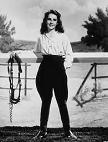
On Dec. 14, 1944 Clarence Brown's National Velvet debuts, based on the 1935 Enid Bagnold novel, featuring 12-y.-o. 2-legged filly Elizabeth Rosemond "Liz" Taylor (1932-2011) in her first starring role as Velvet Brown alongside oversexed shrimp Mickey Rooney - eying her velvet?

On Dec. 22, 1944 George Cukor's Winged Victory debuts, based on the Moss Hart play, starring Don Taylor, Lon McCallister, Mark Daniels, Don Taylor, Edmond O'Brien, and Barry Nelson as friends going through training in the USAF; the film debut of Judy Holliday (Judith Tuvim) (1921-65).

On Jan. 18, 1945 Charles Vidor's A Song to Remember debuts, a bio. of Franz Liszt (1811-86), played by Stephen Bekassy, with Merle Oberon as George Sand; makes a star of brainy blonde "tall cool drink of water" Dutch actress Nina Foch (1928-2008), who plays Constantia.

On Feb. 28, 1945 Elia Kazan's A Tree Grows in Brooklyn debuts, becoming the dir. debut of Turkish-born Elia Kazan (Elias Kazancioglu) (1909-2003), based on the 1943 novel by Betty Smith about the Nolans in a 1900s tenement, starring Dorothy McGuire as Katie Nolan, James Dunn as Johnny Nolan the Brooklyn Thrush, Joan Blondell as Sissy Edwards, and Lloyd Nolan as Officer McShane.
On Mar. 15, 1945 the 17th Academy Awards awards the best picture Oscar for 1944 to Paramount's Going My Way, along with best dir. to Leo McCarey, best actor to Bing Crosby (1903-77), and best supporting actor to Barry Fitzgerald; Ingrid Bergman gets best actress for Gaslight (she was passed over for "Casablanca" the previous year), and Ethel Barrymore gets best supporting actress for None But the Lonely Heart.

On Apr. 17, 1945 Charles Lamont's Salome, Where She Danced debuts, produced by Walter Wanger based on the story of Lola Montez, "an Arabian Nights story in a Western setting", becoming the breakthrough role for Canadian-born beauty queen Yvonne De Carlo (Margaret Yvonne Middleton) (1922-2007); does $2.6M box office on a $1.16M budget.

On May 21, 1945 after actor Humphrey DeForest Bogart (1899-1957) divorces loud jealous Mayo Methot (married 1938) on Mayo, er, May 10, he marries his 4th wife, hot young actress Lauren Bacall (Betty Joan Perske) (1924-2014), whom he does four films with; they have son Stephen Humphrey Bogart (1949-) and daughter Leslie Howard Bogart (1952-), who is named after British actor Leslie Howard, who did him a big favor in 1936 by refusing to appear in "The Petrified Forest" unless he was signed too.


On May 25, 1945 Vincente Minnelli's The Clock (MGM) debuts, produced by Arthur Freed, starring Judy Garland in her first non-singing dramatic role as Alice Mayberry, and Robert Hudson Walker (1918-51) as GI Joe Allen on 48-hour leave in New York City, who meet at Penn Station then meet again for their first date under the Beaux Arts clock in the Astor Hotel in Times Square at 1515 Broadway (built 1904, demolished 1967), and rush to get married before his leave is up; the Big Apple is recreated on an elaborate MGM set in Culver City, spending $66K to duplicate Penn Station; meanwhile the studio feeds Garland prescription drugs to control her weight and pep her up, while Walker's wife Jennifer Jones (Phyllis Lee Isley) (1919-2009) dumps him for producer David O. Selznick (1902-65) and files for divorce in Apr., causing him to become alcoholic and die an early death after a failed 5-mo. marriage to John Ford's daughter Barbara in July 1948; after marrying Selznick in 1949, he dies in 1965, freaking her out, along with their daughter Mary Jennifer Selznick (1954-76), who commits suicide by jumping from a 22nd-story window in Los Angeles; Garland doesn't do another dramatic role until "Judgment at Nuremberg" (1961), and also dies an early death.

On July 14, 1945 George Sidney's Anchors Aweigh debuts, starring Frank Sinatra as Seaman First Class Clarence "Brooklyn" Doolittle, and Gene Kelly as Gunner's Mate 2nd Class Joseph "Joe" Brady, who go on a 4-day shore leave in Hollywood, meeting aspiring singer Susan Abbott (Kathryn Graham); Kelly dances with Jerry the cartoon mouse; does $7.5M box office on a $2.6M budget.

On Aug. 29, 1945 Walter Lang's State Fair (20th Cent. Fox) debuts, an adaptation of the 1933 Rodgers and Hammerstein musical, starring Jeanne Crain, Dana Andrews, Vivian Blaine, Fay Bainter, and Charles Winninger; remade in 1962 starring Pat Boone and Ann-Margret; Blue Boy wins grand champion boar; features the songs It's a Grand Night for Singing, and It Might as Well Be Spring.
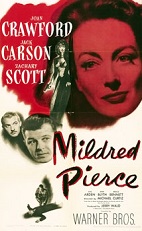
On Sept. 28, 1945 Michael Curtiz' B&W Mildred Pierce (Warner Bros.) debuts, based on the 1941 John M. Cain novel, starring Joan Crawford (first for Warner Bros. after leaving MGM) as a Southern Calif. housewife whose hubby leaves her during the Depression, forcing her to scramble to open a successful wafffle and restaurant chain while juggling beaus incl. Wally Fay (Jack Carson), Bert Pierce (Bruce Bennett), and Monte Beragon (Zachary Scott), only to be undone by her pianist daughter Veda (Ann Blyth); does $5.6M box office on a $1.45M budget; "Father, Wally, Monte, you have what you need"; refilmed in 2011 starring Kate Winslet.

On Nov. 16, 1945 Billy Wilder's The Lost Weekend debuts, written by Charles Brackett, starring Welsh-born Ray Milland (Reginald Alfred John Truscott-Jones) (1907-86) as alcoholic Don Birnam, who is in denial in an acclaimed brave performance; also stars Jane Wyman as Helen St. James; "How daring can the screen dare to be?" - is that tea really whiskey?
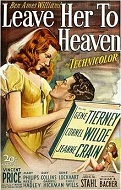
On Dec. 19, 1945 John M. Stahl's Leave Her to Heaven (20th Cent. Fox) debuts, written by Jo Swerling based on the Ben Ames Williams novel (title taken from Shakespeare's "Hamlet", Act 1 Scene 5), a Technicolor film noir starring Gene Tierney as super-jealous wife Ellen Berent, Cornel Wilde as her novelist hubby Richard Harland (who lives in the remote island home Back of the Moon), Jeanne Crain as her adoptive sister Ruth, and Vincent Price as her ex-fiance Russell Quinton; does $5M box office, becoming Fox's highest-grossing picture of the decade.
In 1945 Humphrey Bogart and Lauren Bacall appear with Charles Boyer on the cover of Chess Review mag.; Bogie is MC at the Pan Am. Chess Congress in Los Angeles, and tells Silver Screen that chess is one of the most important things to him; other chess-playing Hollywood actors are Lew Ayres, John Barrymore, Jose Ferrer, Katharine Hepburn, Louis Jourdan, and John Wayne.
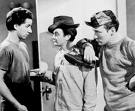
On Jan. 12, 1946 Phil Karlson's Live Wires debuts, starring the Bowery Boys (formerly the East Side Kids), incl. Leo Bernard Gorcey (1917-69) as Terrence Aloysius "Slip" Mahoney, and Henry Richard "Huntz" Hall (1919-99) as Horace Debussy "Sach" Jones; they continue to make sequels through 1958.

On Feb. 14, 1946 Charles Vidor's B&W Gilda (Columbia Pictures) debuts, a film noir starring Glenn Ford as small-time hood Johnny Farrell, and Rita Hayworth as femme fatale Gilda Mundson Farrell, who performs a 1-glove striptease in black satin, made more sexy by cinematographer Rudolph Mate and the wardrobe by Jean Louis; features the dance numbers Put the Blame on Mame and Amado Mio.

On May 1, 1946 Ernst Lubitsch's B&W Cluny Brown (20th Cent. Fox) debuts, based on a novel by Margery Sharp, starring Jennifer Jones as uninhibited Cluny Brown, whose plumber uncle sends her to work as a servant in an English country estate, where she hooks up with Czech refugee writer Adam Belinski (Charles Boyer), who tries to keep her from marrying dull pharmacist Jonathan W. Wilson (Richard Haydn); score by Cyril J. Mockridge; "Well, shall we have a go at it?" (Jones, before unclogging a sink); "I understand. If I feel like feeding the squirrels to the nuts, this isn't the place for it" (Jones); does $1M box office.
On Mar. 7, 1946 the 18th Academy Awards awards the best picture Oscar for 1945 to Paramount's The Lost Weekend, along with best dir. to Billy Wilder and best actor to Ray Milland, best actress to Joan Crawford for Mildred Pierce, best supporting actor to James Dunn for A Tree Groes in Brooklyn, and best supporting actress to Anne Revere for National Velvet; Crawford feigns illness and misses the awards ceremony on the radio then ushers the press into her bedroom to accept, after which she soon divorces actor hubby (since 1942) Phillip Terry (Frederick Henry Kormann) (1909-93), launching the Woman Best Actress Curse (Bette Davis, Halle Berry, Kate Winslet, Sandra Bullock).

In Mar. 1946 19-y.-o. Jewish "Jersey kid trying to make it as a comic" Jerry Lewis (Joseph Levitch) (1926-) meets 28-y.-o. small-time Steubenville, Ohio Italian-Am. Roman Catholic singer ("King of Cool") Dean Martin (Dino Paul Crocetti) (1917-95), who becomes Lewis' big brother that he always wished he had - the original Midnight Cowboy? On July 24, 1946 they make their first formal appearance together in a nightclub in Atlantic City, N.J.; they break up exactly 10 years later.

On May 2, 1946 Tay Garnett's The Postman Always Rings Twice debuts, based on the 1934 James M. Cain novel, starring Lana Turner as Cora Smith, and John Garfield as drifter Frank Chambers, who murder her hubby then suffer the consequences.

On Aug. 28, 1946 Robert Siodmak's The Killers debuts, based on a short story by Ernest Hemingway, becoming the film debut of "Mr. Muscles and Teeth" Burt Stephen Lancaster (1913-94) as ex-boxer "The Swede", who is murdered by the mob, causing insurance investigator Jim Reardon (Edmond O'Brien) to get even with crime boss Big Jim Colfax (Albert Dekker) and femme fatale Kitty Collins (Ava Gardner); Sam Levene plays police detective Lt. Sam Lubinsky; Miklos Rosza's musical score is later used on TV's "Dragnet".

On Oct. 10, 1946 Alfred E. Green's The Jolson Story debuts, starring Larry Parks (1914-75), who is nominated for an Oscar, rejuvenating the career of Al Jolson (1886-1950), who dubs the vocals even though he is too old to play himself onscreen; the sequel "Jolson Sings Again" (1949) is another hit; too bad, Parks is forced to testify before HUAC in 1951, and admits to being a Communist, ruining his career even though he names names.
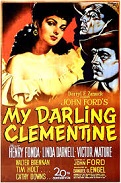
On Dec. 3, 1946 John Ford's B&W My Darling Clementine (20th Cent. Fox) debuts, based on the 1931 Stuart N. Lake novel "Wyatt Earp, Frontier Marshal" about the Oct. 26, 1881 Gunfight at the O.K. Corral, starring Henry Fonda as Wyatt Earp, Victor Mature as Doc Holliday, Walter Brennan as Old Man Clanton, Tom Holt as Virgil Earp, Ward Bond as Morgan Earp, Tim Holt as Virgil Earp, and John Ireland as Billy Clanton; features the 1884 Percy Montrose song Oh My Darling, Clementine; Linda Darnell plays Holliday's babe Chihuahua; favorite movie of Col. Potter in "M*A*S*H".

On Dec. 21, 1946 Frank Capra's B&W It's A Wonderful Life (RKO) debuts, the ideal postwar escapist white Am. flick, based on the story "The Greatest Gift" by Philip Van Doren Stern, starring James Stewart as George Bailey, Donna Reed as Mary Hatch Bailey, and Lionel Barrymore as mean old Henry F. Potter in Bedford Falls persecutes George for mismanagement of $8K, causing him to attempt suicide on Christmas Eve, only to be rescued by his guardian angel Clarence Odbody (Henry Travers), who shows him what the world would have been like if he never lived; Ward Bond plays Bert the cop; Thomas Mitchell plays Uncle Billy; Todd Karns plays brother Harry; score by Dimitri Tiomkin; debuts on Dec. 21 after a Dec. 20 preview for charity at the Globe Theatre in New York City; does $3.3M box office on a $3.18M budget; voted most inspirational film of all time by Americans in 2006; watch trailer; view clip; view clip; view clip; view clip.

On July 24, 1946 Lewis Milestone's The Strange Love of Martha Ivers (Paramount) debuts, based on the short story "Love Lies Bleeding" by Jack Patrick, becoming the film debut of dirt-poor Amsterdam, N.Y.-born Kirk Douglas (Issur "Isador" "Izzy" Danielovitch Demsky) (1916-2020)as D.A. Walter O'Neil, wimpy husband of Iverstown-owning Martha Smith Ivers (Barbara Stanwyck), who with Sam Masterson (Van Heflin) share a childhood secret about the murder of Aunt Ivers; Douglas becomes known for his prominent cleft chin and son-of-a-bitch roles.


On Nov. 12, 1946 Walt Disney's Song of the South (RKO Radio Pictures) (dir. by Harve Foster and Wilfred Jackson) debuts, based on the Joel Chandler Harris Uncle Remus stories, becoming Disney's first film with some live action, starring James Baskett (1904-48) as Uncle Remus, who is awarded an honorary Oscar; also stars child actor Bobby Driscoll (1937-68) as Johnny; the first African-Am. best actor Oscar winner is Sidney Poitier in 1964; incl. the (racially degrading?) hit song Zip-a-Dee-Doo-Dah; too bad, it later draws the ire of the PC police.
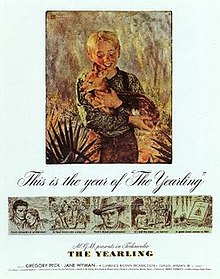
On Dec. 18, 1946 Clarence Brown's The Yearling (Dec. 18) (MGM) debuts, based on the 1938 Marjorie Kinnan Rawlings novel, starring Gregory Peck and Jane Wyman as Ezra "Penny" and Ora Baxter in post-Civil War Fla., and Claude Jarman Jr. as their fawn-loving son Jody, who wins a special Oscar as outstanding child actor; does $7.6M box office on a $3.88M budget, making only $451K profit; MGM's most successful movie of 1946; spawns beloved pet movies incl. "Old Yeller" and "Kes".

In 1946 after being fired from "Army Wives" (1944) by dir. Otto Preminger for refusing to sit next to black actor Clarence Muse in a kitchen scene, then filming his final film "Suspense", 300 lb. Winfield, Kan.-born "Fiar Tuck" actor Eugene William Pallette (1889-1954) becomes convinced that there will be a "world blow-up" by atomic bombs, building a "mountain fortress" on a 3.5K acre ranch near Imnaha, Ore., complete with a herd of prize cattle, a canning plant, and lumber mill; in 1948 when the atomic war fails to materialize, he returns to Los Angeles, but never acts in another movie.

What happens in Hollyweird stays in Hollyweird? On Jan. 15, 1947 in Los Angeles, Calif. the mutilated remains of 22-y.-o. aspiring actress Elizabeth Short (b. 1924) (known as the Black Dahlia for her dark outfits) are found dumped in a vacant lot in the residential L.A. neighborhood of Leimert Park; she had been hung upside down and tortured, her body cut in half, and her face carved into a hideous rictus; the case is never solved, even though the perp sends the girl's birth certificate and address book, with one page ripped out, to the police; later Steve Hodel claims it was his L.A. cop father?
In Jan. 1947 the first official meeting of the Los Angeles (Beverly Hills) Friars Club, organized by Milton Berle is held at the Savoy Hotel in Beverly Hills to roast and embarrass its celeb members for fun, attended by Al Jolson (1886-1950), Bing Crosby (1903-77), Jack Benny, George Burns, George Raft, George Jessel, Robert Taylor, Jonie Taps, Harry Cohn, and Abbott & Costello; founding member George Jessel, known for the 1921 hit song The Toastmaster goes on to receive the title "Toastmaster General of the United States"; members eventually incl. Frank Sinatra, Dean Martin, and Jerry Lewis, the Marx Brothers, Sammy Davis Jr., Billy Crystal, and Johnny Carson.

On Jan. 31, 1947 Arthur Dreifuss' Follow That Music (RKO) debuts, written by Russ Green, starring Gene Krupa, Nan Leslie, and Red Rodney, becoming the film debut of Chicago, Ill.-born Navy vet Jason Nelson Robards Jr. (1922-2000), who marries Lauren Bacall in 1961-9, and struggles with alcoholism.
On Mar. 13, 1947 the 19th Academy Awards awards the best picture Oscar for 1946 to Goldwyn-RKO Radio's The Best Years of Our Lives, along with best dir. to William Wyler, best actor to Fredric March, and best supporting actor to Harold Russell; best actress goes to Olivia de Havilland for To Each His Own, and best supporting actress to Anne Baxter for The Razor's Edge.

On Mar. 21, 1947 Chester Erskine's The Egg and I debuts, based on the 1945 Betty MacDonald memoir, starring Fred MacMurray and Claudette Colbert, and introduces Marjorie Main and Percy Kilbride as the colorful hillbillies Ma and Pa Kettle (with 13 children); the film debut of ever-childless Marilyn Monroe (Norma Jean Baker) (1926-62) as an extra; nine sequels are made through 1957.

In Mar. 1947 Stuart Heisler's Smash-Up: The Story of a Woman (A Woman Destroyed) (Universal) debuts, loosely based on the life of Bing Crosby's first wife Dixie Lee stars Lee Bowman as rising singer Ken Conway, and Susan Hayward as nightclub singer Angie Evans, who goes alcoholic after giving up her career for him; Eddie Albert plays piano player Steve Anderson; Ethel Wales appears in an uncredited part; does $2.3M box office on a $1.36M budget after losing $112K on its initial release.

On May 2, 1947 George Seaton's B&W Miracle on 34th Street (The Big Heart) (20th Cent. Fox) debuts, based on a story by Valentine Davies, starring English actor Edmund Gwenn (Kellaway) (1877-1959) as Kris Kringle, who is hired by Macy's and faces the cynical boss' daughter Doris Walker (Maureen O'Hara), while her believing daughter Susan, played by Natalie Wood (Natasha Nikolaevna Zakharenko) (1938-81) also acts as matchmaker for Fred Gailey (John Payne); scenes of the real thing in the film popularize Macy's Christmas Parade; the house at the end is located at 24 Derby Rd., Port Washington, N.Y.; Kringle proves his sanity by stating that J.Q. Adams' vice-pres. was Daniel D. Tompkins, when it was really John C. Calhoun (Tompkins served under James Monroe); refilmed in 1994.



On June 20, 1947 (midnight) blue-eyed Benjamin "Bugsy" Siegel (b. 1906), founder of the Flamingo Hotel in Las Vegas (friend of actor George Raft) is murdered with three shots to the head from the garden while reading a newspaper in the living room of the Beverly Hills, Calif. Spanish-Moorish mansion of his bobbing babe ("Queen of the Mafia") Virginia "Sugar" Hill (1916-66) at 810 Linden Dr. (probable hit by the mob, who suspect him of using her as a courier for loot embezzled from the Flamingo Hotel) 10 days after she leaves on a trip to Paris with a wealthy French boy; when she hears the news she faints.
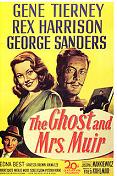
On June 26, 1947 Joseph L. Mankiewicz's The Ghost and Mrs. Muir (20th Cent. Fox) debuts, based on the 1945 novel by R.A. Dick, starring Gene Tierney as widow Lucy Muir, who moves to the seaside English village of Whitecliff and lives in Gull Cottage with her daughter Anna (Natalie Wood) and maid Martha (Edna Best), where she is visited by ghost Capt. Daniel Gregg, played by Rex Harrison, who dictates his memoirs to her while falling in love.
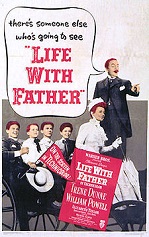
On Aug. 14, 1947 Michael Curtiz' Life with Father (Warner Bros.) debuts, based on the 1935 autobio. of Clarence Day Jr., starring William Powell as Father Clarence Day Sr., and Irene Dunne as his Methodist wife Vinnie, who's forever trying to get him baptized; also stars Elizabeth Taylor as Mary Skinner; all the boys in the family are redheads; does $6.455M box office on a $4.7M budget.

On Aug. 27, 1947 Henry Hathaway's Kiss of Death debuts, written by Ben Hecht (1894-1964) and Charles Lederer based on a story by Eleazer Lipsky, starring Victor Mature as ex-con Nick Bianco, and Richard Weedt Widmark (1914-2008) in his film debut as Tommy Udo, who has a creepy laugh and pushes wheelchair-bound Mildred Dunnock down a flight of stairs, getting nominated for a best supporting actor Oscar and ending up typecast as a villain in film noirs.

In Oct. 1947 screenwriter Ring Lardner Jr. (1915-2000) refuses to tell the whacked-out House Un-Am. Activities Committee (HUAC), under chmn. (R-N.J.) (1936-50) John Parnell Thomas (1895-1970) if he had ever been a member of the Communist Party, and is indicted for contempt of Congresst for taking the Fifth Amendment, along with the other members of the Hollywood Ten, incl. Alvah Cecil Bessie (1904-85) (Jewish), Herbert J. Biberman (1900-71) (Jewish), Lester Cole (1904-85), Canadian-born dir. Edward Dmytryk (1908-99) (Jewish) (member since 1944), John Howard Lawson (1894-1977) (Jewish) (head of the Hollywood div. of the Am. Communist Party) Albert Maltz (1908-85) (Jewish), Samuel Ornitz (1890-1957) (Jewish), Robert Adrian Scott (1912-73), and screenwriter Dalton Trumbo (1905-76) (member since 1943), and given 1-year prison sentences in Danbury Prison in Conn. and Mill Point Prison in W. Va., served in 1950 after losing their appeals, after which many of them set up a colony in Mexico; Cole, Lawson and Ornitz founded the Writers Guild of Am. in 1933; the Hollywood Blacklist begins, ruining many careers; Dmytryk moves to England and directs two films before getting into financial problems and returning to turn rat; Bertolt Brecht testifies in front of it then returns to Europe; next year John Parnell Thomas is indicted for padding congressional payrolls, takes the Fifth Amendment at his own trial, and is convicted of fraud and given an 18-mo. sentence, resigning from the House on Jan. 2, 1950, and ending up in Danbury Prison with Lester Cole and Ring Lardner Jr. before being pardoned on Dec. 24, 1952 by Pres. Truman; meanwhile the 3-ring circus atmosphere embarrasses HUAC into leaving Hollywood alone until 1951? On Dec. 3 the Waldorf Statement is issued by Motion Picture Assoc. of Am. pres. Eric Allen Johnston (1896-1963) after a closed meeting of 48 film execs in New York City's Waldorf-Astoria Hotel, cutting the Hollywood Ten loose and promising to keep Commies out of Hollyweird, although they don't make an official blacklist for fear of lawsuits; since most of the execs are 1st or 2nd gen. Jewish immigrants who love the U.S. for letting them thrive in a sea of goyim, they decide to play it Yankee Doodle all the way? - you can buss up and clean up, but can't cover up that bald spot?

On Nov. 11, 1947 Elia Kazan's Gentleman's Agreement (B&W) debuts, written by Moss Hart based on the 1946 Laura Z. Hobson novel, starring Gregory Peck as nat. mag. writer Phil Green in New York City, who pretends to be Jewish to write an article on anti-Semitism, experiencing its bitterness in Hollywood's first major attack on it; too bad, it never mentions the Holocaust; also stars Dorothy McGuire as Peck's babe Cathy, Celeste Holm as fashion ed. Ann Detry, John Garfield as Peck's Jewish buddy, and cute little Dean Stockwell as Peck's son; closet Jew Garfield comes out in the film, which draws the attention of HUAC; top money-maker of 1948 - Hitler out of the way, each decade Jew-dominated Hollyweird attempts to tell stupid goy American masses what to think, and only those who sell out to the Jewish moguls can get a job there, or is it just natural progress?

On Dec. 25, 1947 Henry King's Captain from Castile (20th Century Fox) debuts, based on the 1945 novel by Samuel Shellabarger, starring Tyrone Power as 1518 Castilian nobleman Pedro De Vargas, who flees the wrath of Spanish Inquisition chief Diego de Silva (John Sutton) to Mexico and joins Hernan Cortez (Cesar Romero) in his expedition to Mexico to take on Montezuma in scenes filmed near the Paricutin Volcano using 19.5K extras; the film debuts of Elizabeth Jean Peters (1926-2000) (future wife of Howard Hughes in 1957-71), who plays peasant girl Catana Perez, and Mohawk actor Jay Silverheels (1912-80), who plays runaway Aztec slave Coatl, and goes on to play Tonto in the TV series "The Lone Ranger" (1949-57).
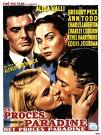
On Dec. 29, 1947 Alfred Hitchcock's B&W The Paradine Case (Vanguard Films) debuts, produced and written by David O. Selznick based on the novel by Robert Smythe Hitchens starring Gregory Peck as defense atty. Anthony Keane, who defends Mrs. Maddalena Anna Paradine (Alida Valli) on murder charges and falls for her, Ann Todd as his wife Gay, Charles Laughton as Judge Lord Thomas Horfield, Charles Coburn as Sir Simon Flaquer, and Joan Tetzel as his daughter Judy; the film debut of Louis Jourdan (Louis Robert Gendre) (1921-2015) as valet Andre Latour; costs $4.258M to make, and is a box office flop; Hitchcock's last film with Selznick.

On Dec. 31, 1947 Cincinnati, Ohio-born "King of Cowboys" Roy Rogers (Leonard Franklin Slye) (1911-98) (rider of Trigger) marries Tex.-born Dale Evans (Lucille Wood Smith) (Frances Octavia Smith) (1912-2001) (rider of Buttermilk) in Davis, Okla. (his 2nd marriage), admitting that her "teenage brother" Tommy is really her son Tom Fox Jr.; their only child Robin Elizabeth dies of Down Syndrome shortly before her 2nd birthday, causing Evans to write the bestseller Angel Unaware; they become a rare model of marital fidelity and until death do us part in Hollyweird.

In 1947 Ukrainian-born Am. tailor Nudie Cohn (1902-84) sets up a shop at 5015 Lankersheim Blvd. in North Hollywood, Calif., going on to produce expensive Western-style Nudie Suits for country music stars, featuring rhinestones and appliques; singer Porter Wagoner eventually buys 60+ of them, also Roy Rogers, Elvis Presley, and ZZ Top.
In 1947 leftist Dem. Ronald Wilson Reagan (1911-2004) succeeds Robert Montgomery as pres. of the Screen Actors Guild (SAG) (until 1952; 1959-60).

On Jan. 6, 1948 John Huston's The Treasure of the Sierra Madre (Warner Bros.) debuts, based on the 1927 B. Traven novel and shot in Durango and Tampico, Mexico for a wallet-busting $2.5M , starring Humphrey Bogart (after Edward G. Robinson is turned down) and Tim Holt as losers Fred C. Dobbs and Bob Curtin in 1920s Mexico, who hook up with old timer gold prospector Howard (John Huston's father Walter Huston) to find the you know what, and cross paths with banditos, whose leader Gold Hat (Alfonso Bedoya) utters the soundbyte "We don't need no stinkin' badges" (actually, "I don't have to show you any stinkin' badges"); Robert Blake plays the boy lottery ticket seller who gets a glass of water in his face; John Huston plays White Suit, from whom Bogart keeps begging pesos; Barton McClain plays a cheating work boss; "Mrs. Mildred Pierce" Bruce Bennett plays hustling gold digger Cody; Tim Holt's father Jack Holt has a bit part in a saloon; the film typecasts Tim Holt in Western roles; "Oomph Girl" Ann Sheridan has a street walk-by part; real gold dust is too heavy to blow away in the wind?
On Mar. 20, 1948 the 20th Academy Awards awards the best picture Oscar for 1947 to 20th Century-Fox's Gentleman's Agreement, along with best dir. to Elia Kazan and best supporting actress to Celeste Holm; best actor goes to ? for A Double Life, best actress to Loretta Young for The Farmer's Daughter, and best supporting actor to Edmund Gwenn for Miracle on 34th Street (who utters the soundbyte "Now I know there is a Santa Claus").
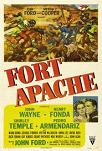

On Mar. 27, 1948 John Ford's Fort Apache (RKO Radio Pictures) debuts, the first of Ford's "Cavalry Trilogy" ("She Wore a Yellow Ribbon" in 1949, "Rio Grande" in 1950) based on stories by James Warner Bellah (1899-1976), starring John Guess Who Wayne as Capt. Kirby York, and Henry Fonda as fanatical Lt. Col. Owen Thursday, who tries to crush the Apaches under Cochise and ends up in a Custer-like massacre instead, only to have the Army cover it up and portray the dope as a hero; Ward Bond and John Agar play Sgt. Maj. Michael O'Rourke and his son Lt. Michael Shannon O'Rourke; Victor McLaglen plays Sgt. Festus Mulcahy; Miguel Inclan plays Cochise; has a small role for Agar's wife (1945-50), over-the-hill child actress Shirley Temple as Philadelphia Thursday; does $3M box office on a $2.1M budget.

On May 3, 1948 the U.S. Supreme Court ends the monopolistic Hollywood studio system in its U.S. v. Paramount Pictures Inc. decision; meanwhile Isidore "Dore" Schary (1905-80) of RKO Pictures (who helped draft the 1947 Waldorf Statement) becomes chief of production at MGM, ending up in a war with founder Louis B. Mayer for wanting the films to have a liberal New Deal message, and in 1951 Mayer is ousted and Schary becomes pres. (until 1956).
On June 20, 1948 after he sees the horrors of a Communist-backed Hollywood union strike and flops and becomes a conservative political activist, Ronald Reagan's wife (since 1940) Jane Wyman divorces him.

On June 25, 1948 Michael Curtiz' Romance on the High Seas debuts, a romantic comedy co-starring Jack Carson is the major film debut of Cincinnati, Ohio-born "Sentimental Journey" singer Doris Day (Doris Mary Ann Keppelhoff) (1922-) as Georgia Garrett, who sings the hit song It's Magic.

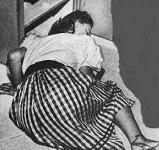


On July 4, 1948 fading rumored pregnant Hollywood actress Carole Landis (b. 1919) commits suicide with Secanol in her Pacific Palisades, Calif. home after her married lover, English actor Rex Harrison (1908-90) won't leave his wife for her, causing Fox to cancel his contract, ruining his Hollywood career until his 1956 Broadway hit "My Fair Lady"; in 1962 he marries Welsh actress Rachel Roberts (1927-80), who divorces him in 1971 then ODs on sleeping pills in 1980 when he won't take her back.

On Aug. 23, 1948 Charles Vidor's The Loves of Carmen debuts, based on the 1845 novel by Prosper Merimee and produced by Rita Hayworth's Beckworth Corp., starring her as the Gypsy Carmen, and Glenn Ford as her doomed lover, becoming Columbia's biggest moneymaker for the year.
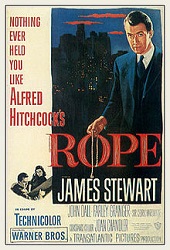
On Aug. 28, 1948 Alfred Hitchcock's Rope (Transatlantic Pictures) (MGM) Warner Bros.) debuts, written by Hume Cronyn and Arthur Laurents based on the 1929 Patrick Hamilton play based on the Leopold and Loeb case, starring Jimmy Stewart (after first choice Cary Grant is unavailable) as Rupert Cadell, who figures out the secret in the trunk owned by New York intellectuals Brandon Shaw (John Dall) and Phillip Morgan (Farley Granger); Dick Hogan plays murder victim David Kentley.


On Aug. 31, 1948 (night) Hollywood actor Robert Charles Durman Mitchum (1917-97) is arrested in the Hollywood cottage of blonde starlet Lila Leeds (who is engaged to Lana Turner's ex-hubby Stephen Crane) for possession of marijuana, causing his Sept. 1 appearance on the steps of city hall in Los Angeles to address a gathering for Nat. Youth Week to be canceled; he serves 2-mo. in jail, the publicity boosting his career, and Howard Hughes of RKO buys his contract from David O. Selznick for $200K.
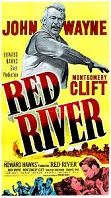

On Sept. 30, 1948 Howard Hawks' B&W Red River (United Artists) debuts, starring John Wayne as a reprehensible, obsessive father on a cattle drive, and Edward Montgomery Clift (1921-66) in his film debut as his son; Hawks' main rival John Ford sees the film and realizes for the first time that his boy Wayne can actually act, and beefs-up his roles?; does $9M box office on a $2.7M budget.


On Nov. 4, 1948 Anatole Litvak's The Snake Pit debuts, based on the 1946 novel by Mary Jane Ward, starring Olivia de Havilland as Virginia Stuart Cunningham, who finds herself in an insane asylum, where Dr. Mark Kirk (Leo Glenn) tries to help her; children under 16 not admitted.

On Nov. 11, 1948 Victor Fleming's Joan of Arc (RKO) (Fleming's last film) debuts, based on the Maxwell Anderson play "Joan of Lorraine", starring Ingrid Bergman as Joan of Arc, and Puerto Rican actor Jose Ferrer (Jose Vicente Ferrer de Otero y Cintron) (1912-92) in his film debut as the dauphin; Fleming hooks up with Bergman during filming, and when they break up he has a heart attack on Jan. 6, 1949; does $5.8M box office on a $4.7M budget.
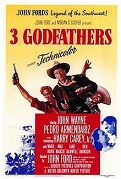
On Dec. 1, 1948 John Ford's 3 Godfathers (MGM) debuts, produced by Merian C. Cooper and filmed in Death Valley, Calif., a color remake of the 1936 film based on the 1913 Peter B. Kyne novel about modern Biblical Three Wise Men Wild West bank robbers Robert Marmaduke Hightower (John Wayne), William Kearney the Abilene Kid (Harry Carey Jr.) (his film debut), and Pedro (Pedro Armendariz), who try to take orphaned infant Robert William Pedro across the desert on foot while being chased by the posse of Sheriff Perley "Buck" Sweet (Ward Bond); does $2.8M box office on a $1.2M budget.

On Dec. 24, 1948 Norman Z. McLeod's Paleface debuts, starring 5'7" 38D-24-36 Ernestine Jane Geraldine Russell (1921-2011) as Calamity Jane, and Bob Hope as quack dentist Painless Potter, who sings the 1947 Jay Livingston-Ray Evans song Buttons and Bows, which becomes his biggest-selling hit, even though Dinah Shore upstages him in the charts.

On Jan. 12, 1949 Robert Siodmak's Criss Cross (B&W) debuts, based on a a novel by Don Tracy, a film noir starring Burt Lancaster as armored car truck driver Steve Thompson, who vies for babe Ann (Yvonne DeCarlo) with mobster Slim Dundee (Dan Duryea) by having his own truck heisted; the screen debut of Tony Curtis (Bernard Schwartz) (1925-2010), who dances with DeCarlo in the Round-Up Bar to "Jungle Fantasy", performed by Esy Morales and His Rhumba Band; producer Mark Hellinger dies suddenly during production.

On Feb. 22, 1949 Nicholas Ray's Knock on Any Door debuts, based on the Willard Motley novel, a courtroom film noir starring Humphrey Bogart as atty. Andrew Morton, and becoming the film debut of hunk John Derek (Derek Delevan Harris) (1926-98) as young slum dweller Nick Romano, who is accused of killing a cop, and relies on the society-is-to-blame defense, with Bogart telling him "You look great, but kid, that's not enough", and Derek utters the immortal soundbyte "Live fast, die young, and leave a good-looking corpse"; Derek goes on to marry three lookalike actress blonde bimbos, Ursula Andress (1957-66), Linda Evans (1968-74), and Bo Derek (1976-98).
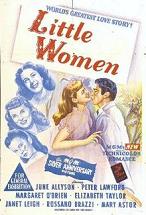
On Mar. 19, 1949 Mervyn LeRoy's Little Women (MGM) debuts, a color remake of the 1933 George Cukor film based on the 1868 Louisa May Alcott novel, starring June Allyson as Jo, who sells her long auburn tresses, Margaret O'Brien as Beth, who loses her baby to scarlet fever, Janet Leigh as Meg, and Elizabeth Taylor as Amy, another adult role, albeit a little one; Mary Astor plays Marmee, Lucile Watson plays Aunt March, and Peter Lawford plays Theodore Laurence "Laurie"; final film of C. Aubrey Smith; does $5.9M box office on a $2.8M budget.
On Mar. 24, 1949 the 21st Academy Awards awards the best picture Oscar for 1948 to Rank-Two-Cities-UI's Hamlet, along with best actor to Laurence Olivier; best actress goes to Jane Wyman for Johnny Belinda, best dir. goes to John Huston and best supporting actor to his father Walter Huston for Treasure of the Sierra Madre, and best supporting actress to Claire Trevor for Key Largo.

On May 27, 1949 photographer Tom Kelly takes nude pics of Marilyn Monroe in front of a red velvet backdrop for the Golden Years Calendar; she is paid $50, which she uses to get back an impounded car, becoming the first Hollywood star to pose nude for photos; the calendar becomes a big hit; meanwhile she rises to fame, and after an attempted coverup, the studio publicly acknowledges it's her on Mar. 13, 1952, and she explains "I was broke and needed the money... Besides, I'm not ashamed of it. I've done nothing wrong"; Hugh Hefner then uses it as the centerfold for his first Playboy issue in Dec. 1953.


On June 9, 1949 Edward Buzzell's Neptune's Daughter (MGM) debuts, a Technicolor musical romantic comedy starring Esther Williams, Red Skelton, and Ricardo Montalban, becoming the first pairing of Williams and Montalban, and one of the first films to depict a television being used; does $5.77M box office on a $2.2M budget; features the song Baby, It's Cold Outside (written in 1944 by Frank Loesser), becoming a Christmas standard; too bad, it is seen at a church social in Greeley, Colo. by Egyptian Islamist Sayyid Qutb (1906-66), freaking him out with the lewdness of Am. women, after which he moves back to Egypt and joins the Muslim Brotherhood, working to restore Sharia, spawning al-Qaida; in Dec. 2018 Am. PC police get the song banned from radio stations for its alleged suggestion of date rape, although it really glorifies the empowerment of women even before the arrival of the birth control pill? Watch video; watch video.

On July 2, 1949 King Vidor's The Fountainhead debuts, written by Ayn Rand based on her 1943 novel, starring Gary Cooper as lone wolf architect Howard Roarke, struggling against collectivism with his babe Dominique Francon, played by Ky.-born actress Patsy Louise "Patricia" Neal (1926-2010), who has an abortion in 1950 after her affair with Gary Cooper is found out by his wife Veronica, after which she feels guilty and becomes a pro-life activist; too bad, Rayn's overblown dialogue stinks it up?
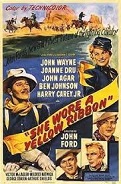
On July 26, 1949 John Ford's She Wore a Yellow Ribbon (RKO Radio Pictures) debuts, starring John Wayne as over-the-hill Capt. Nathan Cutting Brittles of C Troop, who shuns retirement to help the undermanned cavalry outpost of Ft. Starke make a stand against the Cheyenne and Arapaho Indians after the Battle of the Little Big Horn, first pow-wowing with old chief Pony-That-Walks (Chief John Big Tree) and trading remarks on how only young testosterone-soaked idiots like war and it the responsibility of wise old farts to stop them but they can't; also stars John Agar as Lt. Flint Cohill, Ben Johnson as Sgt. Tyree, Harry Carey Jr. as Lt. Ross Pennell, Victor McLaglen as Sgt. Quincannon, George O'Brien as Maj. Allshard, and Joanne Dru as Cohill's babe Olivia Dandridge; does $2.7M box office.
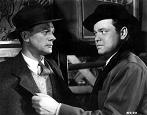
On Sept. 2, 1949 Carol Reed's The Third Man debuts, written by Graham Greene, starring Joseph Cotten as Am. writer ?, Orson Welles as blackmarket drug dealer Harry Lime, and Vienna itself, with a great Risenrad (Ferris wheel) sequence and another great underground sewer sequence; "In these days, old man, nobody thinks in terms of human beings. Goverments don't, so why should we? They talk of the people and the proletariat, and I talk of the mugs. It's the same thing. They have their five year plans and so have I"; "In Italy for thirty years under the Borgias they had warfare, terror, murder, bloodshed. They produced Michelangelo, Leonardo da Vinci, and the Renaissance. In Switzerland they had brotherly love, five hundred years of democracy and peace, and what did they produce? The cuckoo clock."
On Sept. 20, 1949 Sophia Loren enters the Queen of the Sea beauty pageant in Naples on her 15th birthday, and is picked for the court even though not making queen, but it causes her mother to take her to Rome to begin a film career.


On Nov. 8, 1949 Robert Rossen's All the King's Men debuts, based on the 1946 Robert Penn Warren novel, starring big burly Broderick Crawford (1911-86) (first customer to try the new Moscow Mule drink at the Cock 'N' Bull bar in Hollywood) as ruthless politico Huey Long, er, Willy Stark, and is the first major role for Mercedes McCambridge (1916-2004), who plays his cunning aide Sadie Burke; John Derek plays Crawford's son Tom Stark; curmudgeonly Will Wright plays corrupt city official Dolph Pillsbury.

On Nov. 9, 1949 William Wellman's Battleground (MGM) debuts, becoming the first major film about WWII released after the war, about the 327th Glider Infantry Regiment, 101st Airborne Div. at the Siege of Bastogne during the Battle of the Bulge in World War II, starring Van Johnson, John Hodiak, Ricardo Montalban, George Murphy, and James Allen Whitmore Jr. (1921-2009) in his film debut (after Spencer Tracy turns it down), who get real and show fear.

On Dec. 21, 1949 Cecil B. DeMille's Samson and Delilah (Paramount Pictures) debuts, starring Italian-Am. hunk Victor John Mature (1913-99) and brainy heady Austrian-Am. babe Hedy Lamarr (Hedwig Eva Maria Kisler) (1913-2000), who score a hit but end up defining the loser trend of stupid Hollywood movies in the 1950s?; does $25.6M box office on a $3M budget; she wears an 18-ft. train dress consisting of 1.9K peacock feathers personally collected for 10 years by DeMille on his ranch.

In 1949 recently divorced (from Jane Wyman) (June 26, 1940 to June 28, 1948) B-actor and Screen Actors Guild pres. (1947-52, 1959-60) Ronald Wilson Reagan (1911-2004) is approached by rich B-actress Nancy Davis (Anne Frances Robbins) (1921-) to clear her name of being on a list of Communists (mistaken identity), and since he's also on the rebound, they fall in love and yadda yadda yadda, on Mar. 4, 1952 they marry, which causes her to retire from films; "I don't know if it was exactly love at first sight, but it was pretty close" (Nancy).



On Feb. 2, 1950 the acting career of screen star Ingrid Bergman (1915-82), who has been married to Dr. Aron Peter Lindstrom (1907-2000) since 1937, with daughter Friedel Pia Lindstrom (1938-), goes south after she lets her contract with retiring David O. Selznick lapse in 1948 and began working in Italy with Italian playboy dir. Roberto Rossellini (1906-77), then began an affair with him during the making of the film Stromboli in 1949, leaving her family to live with him in Italy, then having his illegitimate son Roberto Ingmar Rossellini (1950-), followed by twin daughters Isabella Rossellini (1952-) and Ingrid Rossellini (1952-); on Mar. 14 U.S. Sen. (D-Colo.) (1937-55) Edwin Carl "Big Ed" Johnson (1884-1970) (former Colo. gov. in 1933-7) delivers a 1-hour speech from the U.S. Senate floor, calling her a "free-love cultist", a "powerful influence of evil", "an assault upon the institution of marriage", and "Hollywood's apostle of degradation", which fuels a public reaction against this phony virginal Joan of Arc; she gets a quicky Mexican divorce from Lindstrom, followed by a marriage to Rosselini by proxy in Juarez, and doesn't return to the Puritan-run U.S. until 1957.
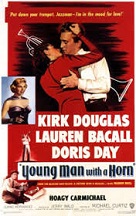
On Feb. 9, 1950 Michael Curtiz's Young Man with a Horn (Warner Bros.) debuts, based on the 1938 novel by Dorothy Baker about jazz trumpeter Bix Beiderbecke, starring Kurt Douglas as horn player Rick Martin, who spirals down toward alcoholism, Doris Day as his babe Jo Jordan, and Lauren Bacall as her friend (closet lez?) Amy North.
On Mar. 23, 1950 the 22nd Academy Awards awards the best picture Oscar for 1949 to Rossen-Columbia's All the King's Men, along with best actor to Broderick Crawford and best supporting actress to Mercedes McCambridge; best actress goes to Olivia de Havilland for The Heiress, best supporting actor to Dean Jagger for Twelve O'Clock High, and best dir. to Joseph L. Mankewicz for A Letter to Three Wives.


On May 17, 1950 George Sidney's Annie Get Your Gun (MGM) debuts, based on the 1946 Rodgers and Hammerstein musical, starring Betty Hutton as Annie Oakley, and Howard Clifford Keel (1919-2004) as Frank Butler in his film debut; Louis Calhern (who replaced Frank Morgan after he died of a heart attack during filming) plays Buffalo Bill Cody, J. Carrol Naish plays Sitting Bull, Edward Arnold plays Pawnee Bill, and Keenan Wynn plays Charlie Davenport; Judy Garland was the first Annie, but had to pull out because of her health; does $7.7M box office on a $3.7M budget; incl. the songs There's No Business Like Show Business, Doin' What Comes Natur'lly, Anything You Can Do, You Can't Get a Man With a Gun.
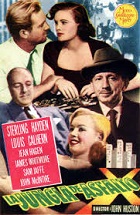
On May 23, 1950 John Huston's B&W The Asphalt Jungle (MGM) debuts, based on the 1949 W.R. Burnett novel about a $1M jewel heist in the Am. Midwest (Cincinnati?), starring Sam Jaffe as mastermind Erwin "Doc" Riedenschndier, Marc Lawrence as bookie Cobby, Louis Calhern as criminal lawyer Alonzo Emmerich, Anthony Caruso as safecracker Louie Ciavelli, James Whitmore as getaway river Gus Minissi, Sterling Hayden as gangster Dix Handley, and Jean Hagen as Hayden's babe Doll Conovan; Marilyn Monroe has a small uncredited part as Angela Phinlay; does $1.077M box office in the U.S.-Canada and $1.060M foreign on a $1.232M budget, making a profit of only $40K.
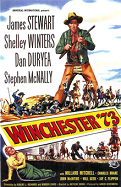
On June 7, 1950 Anthony Mann's Winchester '73 (Universal Pictures) debuts, starring James Stewart as Lin McAdam, who with his friend Rankie "High-Spade" Wilson (Millard Mitchell) chase outlaw Dutch Henry Brown (Stephen McNally) to Dodge City, Kan., where McAdam beats Brown in a shooting competition, winning a "One of One Thousand Winchester 1873 rifle, which Brown steals, resulting in a long chase, after which McAdam kills Brown in Tascosa, Tex. and it is revealed that they're really brothers; also features Shelley Winters and Dan Duryea; Tony Curtis plays a cavalry trooper; Rock Hudson plays an Injun.
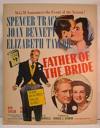
On June 16, 1950 Vincente Minnelli's Father of the Bride debuts, based on the 1949 Edward Streeter novel, starring Spencer Tracy and Elizabeth Taylor; the sequel is Father's Little Dividend (1951).
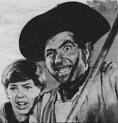
On June 22, 1950 Byron Haskin's Treasure Island (Walt Disney Productions) (RKO Radio Pictures) debuts, based on the 1883 Robert Louis Stevenson novel and filmed by Disney in England using profits made previously in England which the govt. wouldn't let them take to the U.S. (their first live action film), starring child star Bobby Discroll as Jim Hawkins, Robert Newton as Long John Silver (who originates the pseudo-Cornish pirate accent and "arrrgh, matey" that everybody copies), Basil Sydney as Capt. Smollett, and Walter Fitzgerald as Squire Trelawney.

On June 23, 1950 Henry King's Western The Gunfighter (20th Cent. Fox) debuts, written by Nunnally Johnson based on a story by William Bowers and Andre de Toth, starring Gregory Peck as over-the-hill gunslinger Jimmy Ringo, who keeps trying to quit while every young Tom, Dick, and Harry or Skip Homeier (as Hunt Bromley) wants a piece of him, finally getting gunned down in the back and telling the sheriff the other guy drew first, while telling the new king of the hill that he's the new It, and he'll be waiting for him in Hell?; Helen Westcott plays Ringo's wife Peggy Walsh.
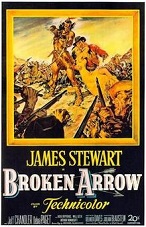
On July 20, 1950 Delmer Daves' Broken Arrow (20th Cent. Fox) debuts, filmed near Flagstaff, Ariz., the first major Hollywood Western since WWII to side with the Indians, based on the 1947 novel "Blood Brother" by Elliott Arnold, starring James Stewart as mailman Tom Jeffords, who walks into the camp of Cochise (Jeff Chandler) and negotiates safe passage to Tucson; Debra Paget plays Indian babe Sonseeahray (Morningstar); Basil Ruysdael plays "Christian Gen." Oliver Otis Howard; Jay "Tonto" Silverheels plays Geronimo; Will Geer plays rancher Ben Slade; real Apaches from the local rez are used as extras.

On Aug. 4, 1950 Billy Wilder's Sunset Boulevard debuts, based on the story "A Can of Beans" by Charles Brackett, starring aging silent film queen Gloria Swanson as aging silent film queen Norma Desmond, who hires young hack screeenwriter Joseph C. "Joe" Gillis (William Holden) to move into her mansion and engineer her comeback to those people "out there in the dark", uttering the soundbytes "All right, Mr. DeMille, I'm ready for my closeup", and "I'm big. It's the pictures that got small"; has-been dir. Erich von Stroheim plays has-been dir. Maximillian "Max" von Mayerling, who states that Erich von Stroheim used to be one of the three great dirs. of the silent film era along with D.W. Griffith and Cecil B. DeMille; music by Franz Waxman; does $5M box office on a $1.75M budget.

On Oct. 13, 1950 Joseph L. Mankiewicz's All About Eve (20th Cent. Fox) de4buts, based on Mary Orr's story "The Wisdom of Eve" (based on the life of Tallulah Bankhead), starring Anne Baxter as Eve Harrington, a Hollywood climber who uses aging Margo Channing (Bette Davis) as a ladder, stealing her beau (Gary Merrill), her friends (Celeste Holm, Hugh Marlowe), and her career; new kid on the block (model mag. covergirl) Marilyn Monroe (dress size 16, about 12 in modern sizes) has a small part, paying her dues; does $8.4M box office on a $1.4M budget; "Fasten your seat belts, it's going to be a bumpy night."
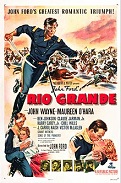
On Nov. 15, 1950 John Ford's B&W Rio Grande (Republic Pictures) debuts, last in Ford's Cavalry Trilogy, starring John Wayne as Lt. Col. Kirby Yorke, an ex-Civil War cavalry cmdr. on the Mexican border of Tex. campaigning against Apaches while dealing with unhappy wife Kathleen (Maureen O'Hara) and a new recruit, his son Trooper Jeferson Yorke (Claude Jarman Jr.); Ben Johnson plays Trooper Travis Tyree, who is running from the law; features folk songs sung by the Sons of the Pioneers incl. "Festus Haggen in Gunsmoke" Ken Curtis; studio pres. Herbert Yates forces Ford to make this film before "The Quiet Man", only to see the latter go #1; does $2.25M box office; "John Ford's greatest romantic triumph".

On Nov. 16, 1950 Michael Gordon's B&@ Cyrano de Bergerac debuts, produced by Stanley Kramer, the first screen version of the 1897 Edmond Rostand play, starring Jose Ferrer, who wins his first and only Oscar; musical score is by Dimitri Tiomkin.

On Dec. 4, 1950 Henry Koster's Harvey (Universal Pictures) debuts, based on the 1944 Mary Cole Chase play, starring James Stewart as Elwood P. Dowd, who tags along with an invisible 6'3-1/2" "pooka" (rabbit) friend named Harvey; Josephine Hull plays his sister Veta Louise Simmons; Cecil Kellaway plays nuthouse dir. Dr. Chumley ("Have you ever been to Akron?"); 6'3.5" Stewart, who looks up at him in the flick later says Harvey's really 6'8"; does $2.6M box office; "My mother told me, she said, Elwood, to make it in this world you either have to be oh so clever or oh so pleasant. Well, for years I was clever. I recommend pleasant."

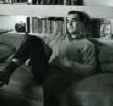
In 1950 James Byron Dean (1931-55), "the first American teenager" makes his film acting debut in a Pepsi Cola TV movie commercial with Nick Adams; his first movie role is in Hal Walker's Sailor Beware (1952), in which he has three lines. In 1952 Am. actor James Byron Dean (1931-55) is helped by gay roommate (future TV scriptwriter) William Edwin "Bill" Bast (1931-2015) to write a letter to the U.S. Draft Board declaring that he is a "practicing homosexual", winning him a draft exemption. In 1953 the Porsche Spider debuts at the Paris Auto Show, becoming the favorite of actor James Dean.

In 1950 hot singer Tab Hunter (Arthur Andrew Kelm) (1931-) is arrested at a gay party, which is covered up by his agent Henry Wilson (1911-78) until 1955, when Confidential mag. threatens to expose his other client Rock Hudson, and he throws them Hunter instead.

In 1950 William Wellman's The Happy Years debuts, becoming the film debut of too-handsome Robert John Wagner Jr. (1930-); too bad, it loses $1.096M, getting him off to a limping start.

On Mar. 23, 1951 Stanley Donen's Royal Wedding debuts, about a brother-sister dance team (Fred Astaire, Jane Powell) who go to London for the royal wedding of Princess Elizabeth is memorable for Astaire's incredible Dancing on the Ceiling and Walls Scene (the trick: a set inside a huge rotating drum); Alan Jay Lerner's first screenplay.
On Mar. 29, 1951 the 23rd Academy Awards awards the best picture Oscar for 1950 to 20th Century-Fox's All About Eve, along with best dir. to Joseph L. Mankiewicz and best supporting actor to George Sanders; best actor goes to Jose Ferrer for Cyrano de Bergerac, best actress to Judy Holliday for Born Yesterday, and best supporting actress to Josephine Hull for Harvey.


On May 16, 1951 Henry Hathaway's You're in the Navy Now debuts, starring Gary Cooper and Jane Greer, becoming the film debuts of Lee Marvin (1924-87) and Charles Bronson (Charles Dennis Buchinsky) (1921-2003).
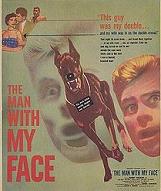
On June 14, 1951 The Man With My Face (United Artists) debuts, based on the 1948 novel by Samuel Woolley Taylor, set in Puerto Rico, becoming the first (only) film noir shot there; stars Barry Nelson as Charles "Chick" Graham, who finds that a bank robber named Albert "Bert" Rand has taken his place with the help of his wife Cora (Lynn Ainley), and hires a Doberman attack dog specialist to kill him.
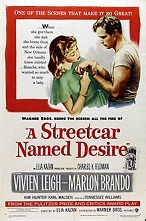
On Sept. 18, 1951 Elia Kazan's B&W A Streetcar Named Desire (Sept. 18) (Warner Bros.) debuts, based on the 1947 Tennessee Williams play, starring Vivien Leigh as alcoholic fading Southern belle Blanche DuBois from Auriol, Miss., who suddenly moves in with her sister Stella Kowalski (Kim Hunter) on Elysian Fields Ave. in the French Quarter of New Orleans after taking the streetcar route named Desire, where she fights with Stella's abusive hubby Stanley Kowalski (Marlon Brando), who tries to find out her dirty laundry, climaxing when he is left alone with her when Stella goes to the hospital to have a baby, and rapes her, causing her to have a breakdown and gets committed to a mental institution, where she utters the line "I have always depended on the kindness of strangers" (she seduced a 17-y.-o. boy at the school where she taught English and got fired, and her hubby committed suicide); Brando utters the immortal line "Hey, Stella! Don't ever leave me baby!"; Karl Malden plays Blanche's beau Harold "Mitch" Mitchell, who is proud of his 207 lb. 6' 1.5" in. athletic physique and likes her to punch him in the belly, but is also an old buddy of Stanley, who turns him against her; the flick boosts Brando's career, even though he is the odd man out and doesn't win an Oscar like the others; during filming, David Niven sees Brando making out with Laurence Olivier in the swimming pool of Vivien Leigh's mansion?; does $8M box office on a $1.8M budget; watch trailer; view clip.

On Sept. 28, 1951 Frederick de Cordova's Bedtime for Bonzo debuts, later becomes Ronald Reagan's bugaboo performance when he begins running for office; followed by Bonzo Goes to College (1952); the chimpanzee Jiggs (1934-), who prefers Milwaukee's Best brand beer becomes a star and lives to the ripe old age of at least 56.

On Sept. 28, 1951 Robert Wise's The Day the Earth Stood Still debuts, based on the 1940 story "Farewell to the Master" by Harry Bates, morphing the Christ story into an extra-terrestrial, played by too-cool Michael Rennie as Klaatu, who comes to Earth to save it from nukes, winning the pop. over, only to be murdered by the govt. while his robot Gort watches; the soundbyte "Klaatu barada Nikto" gains sci-fi immortality; remade in 2008 starring Keanu Reeves as Klaatu.



On Oct. 4, 1951 Vincente Minnelli's An American in Paris, debuts, written by Alan Jay Lerner with music by George Gershwin, starring Eugene Curran (Gael. "hero") "Gene" Kelly (1912-96) as Am. expatriate painter Jerry Mulligan, Oscar Levant as his concert pianist friend Adam Cook, and Leslie Claire Margaret Caron (1931-) as Kelly's babe Lise Bouvier, whom he leaves his paramour patron Milo Roberts (Nina Foch) for, but who is attached to singer Henri Baurel (Georges Guetary) for saving her family in WWII; features the songs S Wonderful and Our Love is Here to Stay, and climaxes with the $500K 18-min. ballet, setting a record for longest movie dance number (until ?).


On Nov. 8, 1951 Mervyn LeRoy's Quo Vadis (Lat. "Where are you going?") (MGM) debuts, based on the 1896 novel about Nero by Henryk Siekiewicz, starring Robert Taylor, Deborah Kerr, and Peter Ustinov, and is the major film debut of Rome-born Sophia Loren (Sofia Costanza Brigida Villani Scicolone) (1934-), who has an uncredited role with her mother as extras playing Deborah Kerr's Lygian slaves; she then gets work as slave girls and maidens in B-films, saying "I'm not ashamed of my bare-bottomed beginnings", after which Italian producer Geoffredo Lombardo, friend of Calo Ponti gives her a stage name after Swedish actress Marta Toren; does $21M box office on a $7.6M budget.
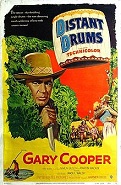
On Dec. 25, 1951 Raoul Walsh's Distant Drums (Warner Bros.) debuts, starring Gary Cooper as Capt. Quincy Wyatt, who leads U.S. soldiers against pesky Seminoles in 19th cent. Fla.; features the short agonizing bloodcurdling Wilhelm Scream, voiced by Sheb Wooley, which is reused in "The Charge at Feather River" (1953) for Pvt. Wilhelm (Ralph Brooke), followed by many other Warner Bros. productions, after which Ben Burtt (1948-) makes it his signature sound effect in the "Star Wars" and "Indiana Jones" films, after which it is picked up by Richard L. Anderson for "Raiders of the Lost Ark" (1981), "Poltergeist" (1982), "Batman Returns" (1992), "Planet of the Apes" (2001), and many more.

In 1951 Ukrainian-born Jewish-Am. actor Israel "Lee" Strasberg (1901-82) becomes dir. of the Actor's Studio, spawning a gen. of top Hollywood actors incl. Elia Kazan, James Dean, Montgomery Clift, Marlon Brando, Anne Bancroft, Dustin Hoffman, Paul Newman, Robert De Niro, and Al Pacino.

On Jan. 10, 1952 Cecil B. DeMille's The Greatest Show on Earth (Paramount Pictures) debuts, starring Charlton Heston as Ringling Bros and Barnum & Bailey Circus ringmaster Brad Braden, Cornel Wilde as the Great Sebastian, a trapeze artist with a claw hand, Betty Hutton as trapeze rival Holly, and James Stewart as Buttons, a clown on the run who never removes his makeup; also stars Dorothy Lamour as Phyllis and Gloria Grahame as Angel; the real 1.4K-man RB&B&B Circus troup appears in the film, incl. 60 railroad cars and hundreds of animals; "We bring you the circus - that Pied Piper whose magic tunes lead children of all ages into a tinseled and spun-candied world of reckless beauty and mounting laughter; whirling thrills; of rhythm, excitement and grace; of daring, enflaring and dance; of high-stepping horses and high-flying stars." (DeMille); does $36M box office on a $4M budget.
On Mar. 20, 1952 the 24th Academy Awards awards the best picture Oscar for 1951 to MGM's An American in Paris (first color pick since 1939's "Gone With the Wind"); best actor goes to Humphrey Bogart for The African Queen; best actress, supporting actor, and supporting actress go to Vivien Leigh, Karl Malden, and Kim Hunter for A Streetcar Named Desire; best dir. goes to George Stevens for A Place in the Sun.





On Mar. 27, 1952 Stanley Donen's and Gene Kelly's Singin' in the Rain (MGM), the greatest musical ever made debuts, written by lifelong Jewish screenwriting partners (not married) Adolph Green (1914-2002) and Betty Comden (Basya Cohen) (1917-2006), about a silent movie co. transitioning to sound stars Eugene Curran (Gael. "hero") "Gene" Kelly (1912-96) as Don Lockwood, Donald David Dixon Ronald O'Connor (1925-2003) as Cosmo Brown the piano player, and Mary Frances "Debbie" Reynolds (1932-2016) as Kathy Selden, making her a star; features the sensational Singin' in the Rain Scene starring Gene Kelly and Brick Sullivan (as the policeman); takes 1.5 years to make because Kelly has to teach Reynolds how to dance; O'Connor sings a memorable version of Make 'Em Laugh; does $7.2M box office on a $2.65M budget.

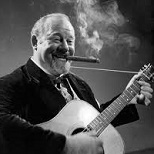
In Mar. 1952 after refusing to do so in Jan., then seeing his sure-thing 12-nomination film "A Streetcar Named Desire" get snubbed as a warning, Greek-Am. "theme of the damaged male" movie dir. Elia Kazan (1909-2003) (a Communist Party member in 1934-6, who broke with it and claims to detest it) names eight names before the House Un-American Activities Committee (HUAC), incl. Clifford Odets and Paula Strasberg, drawing intense fire from his colleagues even though the names had been named before, causing him (at the urging of wife Molly Day Thatcher Kazan) to take out a wordy self-serving newspaper ad in the New York Times two days later defending his actions and calling for others to name names, which only increases bitter feelings and makes him the outcast Hollywood celebrity rat fink; his bosom buddy Arthur Miller doesn't speak to him again for 10 years, while attacking him through his plays, causing him to counterattack through his films; meanwhile Marilyn Monroe, who was Kazan's mistress when she met the unhappily married Miller in 1951 waits in the wings for his inevitable divorce?; later allegations that he got a $500K contract from a major studio as a payoff for finking prove untrue?; meanwhile Santa Claus clone Burl Ives (1909-95) is dragged before whacked-out HUAC, and names fellow folk singer Peter Seeger to save his own career, after which they don't reunite onstage for 41 years - there's nothing wrong with a little confidence in your line of work?
On May 26, 1952 the U.S. Supreme (Vinson) Court unanimously rules in Joseph Burstyn Inc. v. Wilson (AKA the Miracle Decision) that motion pictures are protected by the First Amendment, overturning its Feb. 23, 1915 decision in Mutual Film Corp. v. Industrial Commission of Ohio, putting a damper on Puritanical censorship.

On June 6, 1952 John Ford's The Quiet Man (Argosy Pictures) (Republic Pictures) debuts, written by Frank S. Nugent based on a 1933 short story by Maurice Walsh and filmed on location in W Ireland in County Galway and County Mayo, starring John Wayne as Yankee boxing champ Trooper Sean Thornton, who quits after killing a man in the ring, and Maureen O'Hara as Red Head Mary Kate Danaher, who is matched in marriage to him, and gets "dragged by the black roots of her red hair", and has a great kissing scene in the cottage in the storm with the big stud, along with a great comic fight scene with her brother Squire Will "Red" Danaher (Victor McLaglen); also stars Barry Fitzgerald as whiskey-loving leprechaun-like Michaleen Oge Flynn, Mildred Natwick as Widow Sarah Tillane, and Ward Bond as Father Peter Lonergan; makes Ashford Castle in County Mayo, former country seat of the Guinness family (where the cast stays) into a tourist trap; does $3.2M box office on a $1.75M budget; watch trailer.



On July 24, 1952 Fred Zinnemann's High Noon (United Artists) debuts, based on the story "The Tin Star" by John W. Cunningham, about Hadleyville town marshal Will Kane (Gary Cooper) facing four prof. killers alone while his wife Amy Fowler Kane, played by Grace Patricia Kelly (1929-82) (film debut) melts down and the gutless townfolk do nothing; the action runs from 10:30 a.m. to 12:15 p.m; the theme song The Ballad of High Noon (Do Not Forsake Me, Oh My Darlin'), sung by Tex Ritter (1905-74) is composed by Ukrainian-born Dimitri Tiomkin (1894-1979) and Ned Washington (1901-76); Tiomkin becomes the first composer to receive two Oscars (score and song) for the same dramatic film; does $12M box office on a $730K budget.
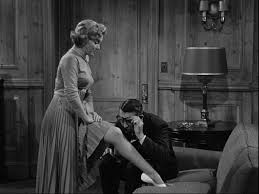
On Sept. 2, 1952 Howard Hawks' Monkey Business debuts (not to be confused with the 1931 Marx Brothers film), starring Cary Grant as absent-minded chemist Dr. Barnaby Fulton, who develops an elixir of youth for his boss Oliver Oxly (Charles Coburn), and a monkey steals it and puts it into the water cooler; after Fulton drinks some, he turns into a hot teenie, going after his boss's secy. Lois Laurel (Marilyn Monroe), after which Fulton's wife Edwina (Ginger Rogers) drinks some, etc.

On Oct. 16, 1952 Charles Chaplin's Limelight debuts, starring Chaplin as failing comedian Calvero, and Claire Bloom as fading ballet dancer Terry; also features Buster Keaton; incl. the song Eternally (Terry's Theme); too bad, while attending the London debut, Chaplin is accused of "Communist sympathies" by J. Edgar Hoover and barred from reentering the U.S., after which he relocates to Vevey, Switzerland to avoid English taxes, sending his wife Oona back to the U.S. to close out his assets and sew $1K bills into the lining of her mink coat, after which she renounces U.S. citizenship.

In Dec. 1952 after seeing the high ratings of the Kefauver hearings on organized crime, the 25-cent conservative quarterly Hollywood gossip mag. Confidential ("Tells the Facts and Names the Names") begins pub. by Bronx, N.Y.-born girlie mag. publisher ("the King of Leer" - Humphrey Bogart) Robert Harrison (1905-78), becoming known for outing Rock Hudson and Liberace as "Lavender Lads", accusing Bing Crosby of wife-beating, publicizing Robert Mitchum's marijuana smoking, and exposing interracial affairs of celebs using a network of spies, reaching 4M circ. and spawning numerous lawsuits, causing Groucho Marx to pub. the soundbyte: "If you don't stop printing scandalous articles about me, I'll be forced to cancel my subscription"; on Nov. 12, 1957 after a big show trial Harrison announces that it will quit publishing stories about the private lives of Hollywood stars in exchange for a $5K plea bargain, and in May 1958 he sells out; it goes on to inspire a flock of new scandal mags. incl. Blast, Exclusive, Hush-Hush, Inside, The Lowdown, Naked Truth, On the Q.T., Private Affairs, Rave, Revealed, Side Street, Uncensored, and Whisper; it ceases pub. in 1978.
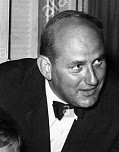
In 1952 Filmways (Pictures) is founded in Sonoma County, Calif. by Martin Ransohoff (1927-) and Edwin Kasper, going on to produce CBS-TV's "rural comedies" incl. "Mister Ed", "The Beverly Hillbillies", "Petticoat Junction", and "Green Acres", along with films incl. "The Sandpiper", "The Cincinnati Kid", "Ice Station Zebra", "Dressed to Kill" and "Blow Out", helping launch the careers of actresses Tuesday Weld, Ann-Margret, and Sharon Tate; by 1963 it makes $13M a year; in 1983 it is acquired by Orion Pictures, becoming Orion TV Productions.
The year that Hollywood grapples with the new threat of TV by introducing gimmicks?
On Jan. 20, 1953 Marilyn Monroe wannabe Mamie Van Doren (1931-) signs with Universal Studios, changing her name from Joan Lucille Olander to jive with Ike's wife Mamie Eisenhower along with the brainy Van Doren brothers Carl and Mark, and going on to marry bandleader Ray Anthony in 1955-61; too bad, when Charles Van Doren stinks himself up in the 1957 Game Show Scandal, it backfires, and Universal dumps her in 1959, which turns out good when she doesn't end up dead by 40 like other sex symbols and ages gracefully?

On Feb. 18, 1953 Arch Oboler's Bwana Devil debuts in New York City, becoming the movie that starts the 3-D fad of the 1950s; audiences are given Polaroid viewers.
On Mar. 19, 1953 the 25th Academy Awards (televised for the first time) in Los Angeles, hosted by Bob Hope awards the best picture Oscar for 1952 to Cecil B. De Mille-Paramount's The Greatest Show on Earth; best actor goes to Gary Cooper for High Noon, best actress to Shirley Booth for Come Back, Little Sheba, best supporting actor to Anthony Quinn for Viva Zapata!, best supporting actress to Gloria Grahame for The Bad and the Beautiful, and best dir. to John Ford for The Quiet Man.
On Mar. 20, 1953 Giovanni Roccardi's Africa Under the Seas (Africa Sotto i Mari) debuts, giving Sophia Loren a seminude swimming scene which almost drowns her since she can't swim, but brings her to the attention of atty.-producer Carlo Ponti (1912-2007), the early mgr. of Gina Lollobrigida, who changes her stage name from Lazzaro to Loren, ramps up her career, and marries her in 1957 after she stars in 57 European features.

On Apr. 16, 1953 Jean Negulesco's Titanic (20th Cent. Fox) debuts, written by Charles Brackett et al., starring Clifton Webb and Barbara Stanwyck as estranged First Class couple Richard Ward, a whimp, and Julia Sturges, a manly woman who secretly takes her two children Annette and Norman to raise them in her hometown of Mackinack, Mich., only to have him follow her; features young hunk Robert John Wagner Jr. (1930-) as Purdue tennis player Gifford Rogers; ends in a restaging of the big sinking, complete with historically inaccurate exploding boilers, frightening the movie public and rekindling interest in the new 1950s era version of Jaws?; does $2.25M box office on a $1.8M budget.


On Apr. 17, 1953 Gerald Mayer's Bright Road debuts, based on a story by Mary Elizabeth Vroman about 11-y.-o. C.T. Young (Philip Herburn), who saves his class from a swarm of bees, starring Dorothy Jean Dandridge (1922-66), and is the first major film for singer-actor Harold George "Harry" Belafonte (Belafonete) Jr. (1927-), "the King of Calypso"; the only white actor is Robert Horton.

On Apr. 23, 1953 George Stevens' Shane (Paramount Pictures) debuts, written by A.B. Guthrie Jr. based on the 1949 Jack Schaefer novel set in 1889 Wyo., and filmed in beautiful Jackson Hole, Wyo.; stars Alan Ladd as buckskin-wearing good guy gunfighter Shane, Van Heflin and Jean Arthur (last film performance) as married homesteaders Joe and Marian Starrett, and Jack Palance as bad guy ("lowdown Yankee liar") Jack Wilson in the finest Western movie ever made?; Emile Meyer plays ruthless cattle baron Rufus Ryker; Elisha Cook Jr. plays Ala. ex-Confederate homesteader Frank "Stonewall" Torrey: Brandon De Wilde (1942-72) plays the cute boy Joey, who at the end of the movie hauntingly cries "Shane, come back! Come back, Shane!"; the jury's still out on whether Shane dies of his wounds.

On May 29, 1953 Billy Wilder's Stalag 17 debuts, based on the play by Donald Bevan and Edmund Trzcinski about Xmas 1944, starring William Holden as J.J. Sefton, an Am. POW in Stalag XVII-B, Barracks Four on the Danube River who is framed as a Nazi mole by real mole Price, played by Peter Graves (Arness) (Aurness) (1926-2010) (brother of James Arness), and gets even; the film is filled with great supporting actors incl Gil Stratton as narrator Clarence Harvey "Cookie" Cook, Austrian Jewish film dir. ? as camp cmdr. Von Scherbach, German-born Sig Ruman as German Sgt. Schulz, Robert Strauss as Stanislas "Animal" Kasava, Don Taylor as rich Lt. James Dunbar, Robinson Stone as shellshocked Joey, and Harvey Lembeck as Harry Shapiro; music by Franz Waxman.

On June 4, 1953 Joseph L. Mankiewicz's Julius Caesar (MGM) debuts, based on the Shakespeare play with musical score by Mikos Rozsa and an all-star cast incl. Marlon Brando as Mark Antony, James Mason as Brutus, John Gielgud as Cassius, Louis Calhern as Caesar, Edmond O'Brien as Casca, Greer Garson as Calpurnia, and Deborah Kerr as Portia; does $3.9M box office on a $2M budget.
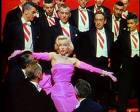
On June 18, 1953 Howard Hawks' Gentlemen Prefer Blondes debuts, based on the Joseph Fields play based on the 1926 Anita Loos novel, starring Marilyn Monroe and Jane Russell as Lorelei Lee and Dorothy Shaw, two show-biz girls from Little Rock trying to make it big in Paris; obscure actor George Winslow is in the credits as Henry Spofford III; by the end of the decade Little Rock shows how they really really really prefer blondes, even if they aren't gentlemen like Sir Francis "Piggy" Beekman (Charles Coburn)?
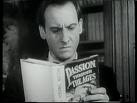
On July 1, 1953 Roy Rowland's The 5,000 Fingers of Dr. T debuts, Dr. Seuss' only non-animated movie, a musical featuring hot Hans Conried (1917-82) (one of six films he makes this year) as the evil Dr. Terwilliger, who lives in a zany castle and forces hundreds of boys incl. Tommy Rettig to take piano lessons on a 500-player (5K-finger) piano among bizarre stairways leading nowhere and doors that open to blank walls in a Moebius strip of hallways; "T stands for Tremendous Terrific Tuneful and entertainmenT (spelled backwards)"; features the songs Do-Mi-Do Duds, Elevator to the Dungeon, Dungeon of Scratchy Violins, and Happy Fingers - TLW's favorite childhood flick that explains his pansophist obsession and typing skills, and why he took up the sax instead of the piano?
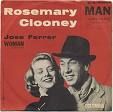
On July 13, 1953 Princeton-educated Puerto Rican actor-dir. Jose Ferrer (1912-92) marries Am. singer Rosemary Clooney (1928-2008); they divorce in 1961, get married again in 1964, then divorce again in 1967.

On Aug. 5, 1953 Fred Zinnemann's From Here to Eternity (Columbia Pictures) debuts, based on the 1951 James Jones novel about army soldiers at the Schofield Barracks in Honolulu in 1941 before the Pearl Harbor attack, starring Montgomery Clift as Pvt. Robert E. Lee "Prew" Pruitt (who quit the bugle corps after blinding a fellow soldier while boxing), Frank Sinatra (who takes a pay cut from $150K per picture at MGM to $8K at Columbia) as his best friend Pvt. Angelo Maggio, and Burt Lancaster as 1st Sgt. Milton Warden, who makes hot love on the beach at Halona Cove with the captain's wife Karen Holmes (Deborah Kerr); Ernest Borgnine plays SSGt. James R. "Fatso" Judson; Donna Reed stars as Alma "Lorene" Burke; Eli Wallach was originally cast as Maggio, but Sinatra used his gangland connections to get the part, causing Wallach to claim he turned it down on his own to appear in a Tennessee Williams play, after which Sinatra greets him with "Hello, you crazy actor"; Tyrone Power and his wife Linda Christian were offered the leading roles that went to Montgomery Clift and Donna Reed; a surprise Oscar revives Sinatra's flagging career; does $30.5M box office on a $2.5M budget.

On Aug. 5, 1953 William Keighley's The Master of Ballantrae debuts, based on the 1889 Robert Louis Stevenson novel, becoming Errol Flynn's last movie with Warner Bros., who dismisses all their big stars to lower overhead because of competition from TV; Flynn goes on to star with Bruce Cabot in the expensive independent CinemaScope film "The Story of William Tell", which is never released after his Italian backers pull out and Cabot sues him, and the IRS goes after him after his business mgr. fails to pay his income taxes and absconds with his last million, ruining him financially just when his big screen career becomes kaput, and an alcohol and morphine addiction ruins his looks.
On Aug. 7, 1953 Vincente Minnelli's The Band Wagon debuts (#2 MGM musical after "Singin' in the Rain"?), written by Adolph Green and Betty Comden based on a 1931 George S. Kaufman play starring Fred Astaire (1899-1987) and his sister Adele stars Fred Astaire as Tony Hunger, an aging musical star who hopes a pretentious retelling of "Faust" will restart his career, and long-legged Cyd Charisse (1922-2008) (whose legs were insured for $5M in 1952) as (did I say?) long-legged ballerina Gabrielle Gerard, who rubs, er, clashes with him; also stars Jack Buchanan as Jeffrey Cordova, Nanette Fabray as Lily Marton, and Oscar Levant as Lester Marton; music by Arthur Schwartz, lyrics by Howard Dietz; features the songs "That's Entertainment", "Triplets", "By Myself", "Shine on Your Shoes", and the (did I say?) long-legged dance routines Girl Hunt Ballet, and Dancing in the Dark, choreographed by Michael Kidd; does $3.5M box office on a $2.87M budget.

On Aug. 13, 1953 Byron Haskin's The War of the Worlds (Paramount Pictures) debuts, based on the 1898 H.G. Wells novel, starring looks-good-in-glasses Gene Barry (Eugene Klass) (1919-2009) as geiger counter-toting Dr. Clayton Forrester, and Ann Robinson as librarian Sylvia Van Buren, with great George Pal SFX; the Martians are into the number 3, and conquer the Earth with swanlike flying saucer machines sprouting rattlesnake-like heat ray pods in six days, the same it took for Jehovah to create it, until they are defeated by Earth bacteria after the remnant of faithful Earthlings pray to him; the last decade in which Hollyweird can get away with ennobling rather than cheapening the Christian belief in Armageddon?

On Aug. 27, 1953 William Wyler's Roman Holiday (Paramount Pictures) debuts, based on a story by Ian McLellan Hunter (a front for blacklisted Dalton Trumbo), becoming the first starring role for Brussels-born Audrey Hepburn (Edda Kathleen van Heemstra Hepburn-Ruston) (1929-93) as Princess Ann, who plays "average Jane" and falls in love with handsome reporter Joe Bradley (Gregory Peck); Eddie Albert plays photographer Irving Radovich; too bad, Hunter accepts the best story Oscar while Trumbo has to hide; Trumbo is awarded a posth. Oscar in 1993; does $12M box office on a $1.5M budget; watch trailer.
On Sept. 12, 1953 Mass.-born "Judge Hardy" actor Lewis Stone (b. 1879) dies in Beverly Hills, Calif. of a heart attack while chasing rock-throwing kids off his lawn.


On Sept. 16, 1953 Henry Koster's The Robe (20th Cent. Fox) debuts, based on the 1942 novel by Lutheran minister Lloyd Cassel Douglas, becoming the first movie filmed in the widescreen CinemaScope process of Henri Chretien (1879-1956); stars chicken-legged Richard Burton as Roman tribune Marcellus Gallio, who commands the Roman soldier detail that crucifies Jesus of Nazreth (Donald C. Klune) and wins his robe in a dice game then later repents and turns Christian, Victor Mature as his Christian slave Demetrius, Richard Boone as Pontius Pilate, Jean Simmons as Diana, miscast Richard Boone as Pontius Pilate, Ernest Thesiger as Tiberius, Michael Ansara as Judas, and Jay Robinson as Caligula in a role acted so well that he later has to see a pshrink; the only movie given 8 stars by the New York Daily News, 4 for the film and 4 for the process (4 is the usual max); the wide, wide color screen saves the industry, which was losing customers because of the new boob tube (TV), although many claim it almost kills the art; "It's fine if you want a system that shows a boa constrictor to better advantage than a man" (George Stevens); "The worst shape ever devised" (Rouben Mamoulian); "It is a formula for a funeral, or for snakes, but not for human beings" (Fritz Lang); "It wrecked the art of film for a decade" (Leon Shamroy); watch trailer.
Onu Sept. 25, 1953 George Cukor's The Actress (B&W) debuts, based on the autobio. play "Years Ago" by Ruth Gordon, starring Jean Simmons as Ruth Gordon Jones, who sends a fan letter to leading lady Hazel Dawn and is encouraged to become an actress, pissing-off her seaman father Clinton Jones (Spencer Tracy), after which her audition is a bust and daddy helps her go back to school; the film debut of Anthony Perkins (1932-92).
On Oct. 14, 1953 Fritz Lang's The Big Heat debuts, a film noir starring Glenn Ford as homicide detective Sgt. David "Dave" Bannion, who finds out that the alleged suicide of cop Tom Duncan is something else, and ends up resigning to take on the crime syndicate of Mike Lagana (Alexander Scourby) and his underling Vince Stone (Lee Marvin), who throws scalding hot coffee in his babe Debbie Marsh's (Gloria Grahame) face; Duncan's widow is sitting on Tom's tell-all diary and using it to blackmail Lagana until Debbie kills her and it's released to the press, bringing on the you know what.
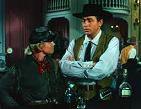
On Nov. 4, 1953 David Butler's Calamity Jane (Warner Bros.), debuts, their response to MGM's "Annie Get Your Gun" (1950), starring Doris Day as Calamity Jane and Howard Keel as Wild Bill Hickock; features the #1 hit song Secret Love.

On Nov. 26, 1953 George Sidney's Kiss Me Kate debuts, a 3-D MGM adaptation of the 1948 Cole Porter Broadway musical based on Shakespeare's "The Taming of the Shrew", with songs by Cole Porter, starring ex-marrieds Fred Graham (Howard Keel) and Lili Vanessi (Kathryn Grayson) playing Petruchio and Kate, with Ann Miller as Lois Lane playing Bianca; does $3.1M box office on a $1.98M budget; incl. the songs Where is the Life That Late I Led, Brush Up Your Shakespeare, Too Darn Hot.

On Dec. 23, 1953 Curtis Bernhardt's Miss Sadie Thompson debuts, based on a short story by W. Somerset Maugham (filmed in 1928 starring Gloria Thompson and in 1932 as "Rain" starring Joan Crawford), a 3-D musical drama starring Rita Hayworth, Aldo Ray, and Jose Ferrer; incl. the "filthy" dance scene The Heat is On, causing it to be banned in several states, making it more popular?

On Dec. 30, 1953 Laslo Benedek's The Wild One (Columbia Pictures) debuts, produced by Stanley Kramer, starring Marlon Brando as Johnny, the Triumph-riding leader (pres.) of the Black Rebels Motorcycle Club (B.R.M.C.), which terrorizes the quiet midwestern town of Wrightsville; the rival gang is led by Chino (Lee Marvin); based on a real incident in Calif., the Am. Motorcyclist Assoc. rally on July 4th weekend, 1947 in Hollister, Calif.; banned in Britain for 12 years.


In Dec. 1953 after raising $8K from 45 investors, incl. $1K from his mother, sexually-starved hetero sexist Chicago failed cartoonist Hugh Hefner (1926-), inspired by the Betty Grable pinups begins pub. Playboy mag. (50 cents) with a Nude Calendar Pinup of Marilyn Monroe (photographed in 1949); the original name for the mag. was "Stag Party"; "What did you have on during the photo session?" - "The radio"; initial run: 70K copies; intial investment: $10K; he got the idea while working on a kids mag.?; he goes on to evolve his hedonistic women-as-sex-objects-with-no-consequences "Playboy Philosophy", and adds interviews with and contributions by prominent writers John Steinbeck, Ray Bradbury, Kurt Vonnegut Jr., Saul Bellow, et al. in an attempt to help readers justify purchases because "they only want to read the articles"; cause or effect, necklines plunge and big mammaries become in among female U.S. entertainers?


On ?, 1953 Ed Wood's Glen or Glenda?, debuts, based on the life of transsexual Christine Jorgensen, starring dir. Ed Davis Wood Jr. (1924-78) displaying his real-life fetish, when he prefers to be called Shirley and wear angora sweaters; shot in four days for $26K; "If you want to know me, see 'Glen or Glenda'." (Wood)

On Jan. 14, 1954 after starting out with a spaghetti dinner on their first date, Marilyn Monroe marries baseball player ("the Yankee Clipper") ("Joltin' Joe") Joseph Paul "Joe" DiMaggio (1914-99) (known for his massive Louisville Slugger?); it lasts only 9 mo., but he carries a torch for her for life - take a powder, dollface?


On Jan. 15, 1954 George Cukor's It Should Happen to You (original title "A Name for Herself") debuts, becoming the film debuts of John Uhler "Jack" Lemmon III (1925-2001) as New York photographer Pete Sheppard, and blonde Lucille Ball clone Judy Holliday (Judith Tuvim) (1921-65) (who was cleared in 1952 by the Senate Internal Security Committee for Communist connections) as Gladys Glover, who wants to make a name for herself, and takes her $1K savings to pay for a big sign with her name on it in Columbus Circle, after which her life begins to get better immediately, ending up being chased by handsome Evan Adams III (Peter Lawford) and becoming a local celeb before giving it all up for love.
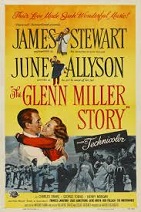

On Feb. 10, 1954 Anthony Mann's The Glenn Miller Story debuts, starring James Stewart and June Allyson, filmed at the U. of Colo. in Boulder, which he attended in 1923-4, and the Trocadero Ballroom at Elitch Gardens in Denver, where he played; C.U. later houses a Glenn Miller Archive; the debut of Cleveland, Ohio-born composer-arranger Enrico Nicola "Henry" Mancini (1924-94).
On Feb. 10, 1954 Harry Keller's Phantom Stallion (Republic Pictures), the last Rex Allen Arizona Cowboy film (first in 1950), co-starring Slim Pickens as Slim is the last singing Western.

On Feb. 12, 1954 Jack Arnold's Creature from the Black Lagoon (Universal Pictures) debuts, based on a Maurice Zimm Story, a 3-D horror film starring Ricou Browning as the Gill Man, an Amazon fish monster who likes science coeds in bathing suits (Julie Adams); spawns "Revenge of the Creature" (1955) and "The Creature Walks Among Us" (1956); does $1.3M box office, single-handedly rescuing Universal Studios from bankruptcy.
On Mar. 25, 1954 the 26th Academy Awards awards the best picture Oscar for 1953 to Columbia's From Here to Eternity, along with best dir. to Fred Zinnemann, best supporting actor to Frank Sinatra (on his 1st wife Nancy's birthday), and best supporting actress to Donna Reed; best actor goes to William Holden for Stalag 17, and best actress to Audrey Hepburn for Roman Holiday.

0n Apr. 2, 1954 Am. Internat. Pictures (AIP) is founded in Los Angeles, Calif. by James Harvey Nicholson (1916-72) and Samuel Zachary Arkoff (1918-2001) to package independent low-budget B films as double features for teenagers, mainly by Roger Corman and Alex Gordon, using the ARKOFF Formula (Action, Revolution, Killing, Oratory, Fantasy, Fornication), pioneering the use of focus groups; in 1960 Corman begins directing films based on stories by Edgar Allan Poe, starting with "House of Usher" (1960), followed by "The Pit and the Pendulum" (1961), "The Premature Burial" (1962), "Tales of Terror" (1962), "The Raven" (1963), "The Haunted Palace" (1963), "The Masque of the Red Death" (1964), and "The Tomb of Ligeia" (1965); in 1963 AIP releases "Beach Party" starring Annette Funicello and Frankie Avalon, launching a series ending with #7 "The Ghost in the Invisible Bikini" (1966); in 1979 AIP is acquired by Filmways Inc., becoming Filmways Pictures.
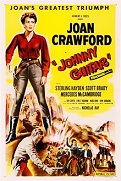
On May 7, 1954 Nicholas Ray's Johnny Guitar (Republic Pictures) debuts, starring Joan Crawford as Vienna, "Gun-Queen of the Arizona Frontier", Sterling Hayden as Johnny "Guitar" Logan, and Mercedes McCambridge as Emma Small in a Western with sensibilities that impresses Francois Truffaut; does $2.5M box office; the Johnny Guitar Theme is by Peggy Lee; watch trailer.

On July 3, 1954 William A. Wellman's The High and the Mighty debuts, becoming a big CinemaScope hit for John Wayne's Batjac Productions (founded 1952) (originally Batjack until Wayne is too cheap to pay $700 to correct the stationery) based on the novel by Ernest K. Gann stars John Wayne (after Spencer Tracy turns it down) as aging Topac Airlines pilot "Whistling Dan" Roman, who is demoted to co-pilot after a tragedy in South Am., until a routine 12 hr. 16 min. Honolulu to San Francisco run with 3,050 gal. of fuel goes bad, launching the danger-in-the-sky genre, and inspiring Baby Boomers to become pilots and stewardesses; Robert Stack plays the pilot, who loses his nerve so that Wayne can become a hero; also features Claire Trevor (who helped make him a star in "Stagecoach"), Laraine Day, Jan Sterling, David Brian, Phil Harris, Robert Newton, Paul Fix as hypochondriac Mr. Briscoe, and Sidney Blackmer as jealous gun-toting liver pill salesman Humphrey Agnew; film debut of William Campbell; "So long, so long you ancient pelican"; does $8.5M box office on a $1.47M budget; music by Dimitri Tiomkin incl. the whistling The High and the Mighty Theme; watch trailer.
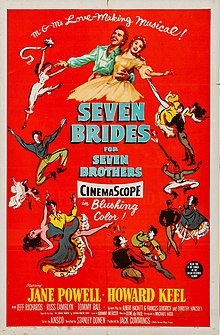
On July 15, 1954 Stanley Donen's musical Seven Brides for Seven Brothers (MGM) debuts, based on the Roman legend of the Rape of the Sabine Women and Stephen Vincent Benet's "The Sobbin' Woman" features choreography by Michael Kidd incl. the barn-raising and the axe dance; H oward Keel plays Adam, and Jane Powell plays Molly in 1850 Ore.; does $9.4M box office on a $2.5M budget.

On July 28, 1954 Elia Kazan's On the Waterfront (original title "A Stone in the River Hudson") (a Sam Spiegel production) debuts, written by Kazan's new bosom buddy (like him, a HUAC "friendly witness") Budd Schulberg (1914-2009) (son of Paramount Pictures head B.P. Schulberg and Sam Jaffe's sister Adeline) after original screenplay author Arthur Miller is blacklisted, based on a series of 24 New York Sun articles in 1949 by Malcolm Johnson (1904-76), and filmed on location in run-down Hoboken, N.J.; stars Marlon Brando Jr. (1924-2004) as Terry Malloy (based on whistleblower longshoreman Anthony DiVicenzo), an ex-fighter who "coulda been a contender" but was forced to take a dive, and decides to rat fink on mob corruption on the docks (pushing people off roofs, etc.), pissing-off union boss Johnny Friendly (Lee J. Cobb) (based on real-life mobster Albert Anastasia and Internat. Longshoremen's Assoc. boss Michael Clemente); meanwhile his crooked lawyer brother Charley "the Gent" Malloy (Rod Steiger) and Father Barry (Karl Malden), who is based on real-life waterfront priest Father John M. Corridan (1911-84) are caught in the middle; the film is a big hit and garners eight Oscar nominations, although it is an obvious attempt by Kazan to justify his 1952 rat-finking to HUAC?; does $9.6M box office on a $910K budget; boxer Roger Donoghue (1930-2006) is Brando's trainer, and gives him the contender line; Brando originally returned the script to Kazan unread, causing him to almost give the part to Frank Sinatra; dir. Robert Siodmak (1900-73) collaborates with Schulberg on the script, but is not credited, and sues, receiving $100K; Brando goes on to be nominated for five Best Actor Oscars in the 1950s (the most), winning one.


On Sept. 29, 1954 George Cukor's A Star is Born (a musical remake of the 1937 film) stars Judy Garland as the rising star, and James Mason as the falling star; greatest Hollywood musical of all time?; her hubby (1952-65) Michael Sidney "Sid" Luft (1915-2005) helps get the funding, but when it fails to recover production costs despite good reviews and good box office, she doesn't get the Oscar; Groucho Marx calls it "the greatest robbery since Brinks"; incl. the Born in a Trunk sequence and The Man That Got Away.
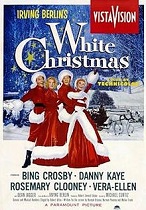
On Oct. 14, 1954 Michael Curtiz' White Christmas (Paramount Pictures) ($30M box office, highest-grossing film of 1954) debuts, a musical film loaded with Irving Berlin songs sung by Bing Crosby (1903-77) (as Bob Wallace), Danny Kaye (1913-87) (as Phil Davis), Rosemary Clooney (as Betty Haynes), and Vera-Ellen (as Judy Haynes) in a financially unstable Vermont inn for charity, incl. White Christmas; Donald O'Connor contracts an illness from Francis the Mule, giving Kaye the part.

On Dec. 20, 1954 Victor Saville's The Silver Chalice (Warner Bros.) (Saville's last film), debuts, a lame and bloated CinemaScope spectacle of the days of Nero based on the 1952 novel by Thomas B. Costain with music by Franz Waxman, starring cute blued-eyed Paul Newman (1925-2008) in his screen debut as toga-wearing Greek sculptor Basil, who fashions Christ's Last Supper cup, plus a bust from a vision; Jack Palance plays Simon Magus the Magician, who tries to jump off a tower and fly to prove himself Christ's rival, but ends up road kill; Lorne Greene's screen debut; the movie embarrasses Newman so much that he takes out an ad in Variety to apologize in 1966 before it is broadcast on TV, calling it "the worst motion picture produced during the 1950s", handing out noisemakers to guests at a private screening.

On Feb. 15, 1955 John Ireland's and Edward Sampson's The Fast and the Furious (B&W) debuts, the first release from AIP, starring Frank Webster as an escaped murderer who kidnaps coffee shop babe Connie Adair (Dorothy Malone) and joins a cross-border sports car race to elude police; does $250K box office on a $50K budget.

On Mar. 9, 1955 Elia Kazan's East of Eden (Warner Bros.) debuts, based on the 1952 John Steinbeck novel ripping off the Biblical Cain and Abel story set in Monterey and Salinas, Calif. in 1917, becoming "new Marlon Brando" James Dean's first starring role as angst-ridden adolescent Caleb "Cal" (Cain) searching for love and acceptance from his ho mother Kate (Eve) (Jo Van Fleet), and his Bible-thumping daddy Adam Trask (Adam) (Raymond Massey), ending up taking it out on his brother Aron (Abel) (Richard Davalos); does $5M box office; Julie Harris plays Aron's babe Catie (Eve); the only one of Dean's three films to be released during his lifetime, making him a teen star.
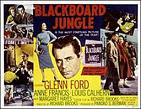
On Mar. 25, 1955 Richard Brooks' Blackboard Jungle debuts, starring no-stretch Glenn Ford as a square English teacher in a violent U.S. inner-city school; causes the song Rock Around the Clock by Bill Haley and the Comets (released on Apr. 14, 1954) to finally take off, becoming a watershed event that earns Haley the title of Father of Rock and Roll after it becomes the first million-selling record in both Britain and Germany, and he becomes the first major Am. rock singer to tour Europe, although he is soon eclipsed by Elvis the Pelvis.
On Mar. 25, 1955 the 27th Academy Awards awards the best picture Oscar for 1954 to Columbia's (Horizon-American Corp.) On the Waterfront, along with best actor to Marlon Brando, best supporting actress to Eva Marie Saint, and best dir. to Elia Kazan, which he claims vindicates him for his 1952 rat-finking to HUAC; best actress goes to Grace Kelly for The Country Girl, and best supporting actor to Edmond O'Brien for The Barefoot Contessa; Dorothy Dandridge becomes the first black nominated for a best actress Oscar for Carmen Jones, and during the awards ceremony Brando kisses her, shocking many attendees; Grace Kelly wears an ice-blue gown designed by Edith Head cut from a bolt of $4K French satin with matching evening coat.
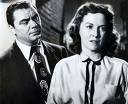

On Apr. 11, 1955 Delbert Mann's Marty debuts, based on the teleplay by Paddy Chayefsky (1923-81), starring Ernest Borgnine (Ermes Effron Borgnino) (1917-2012) in his best career role as shy bachelor Marty Piletti, who finds love with spinster schoolteacher Clara (Betsy Blair); film dir. debut of Kan.-born Delbert Martin Mann Jr. (1920-2007), who fizzles out in the 1960s and goes back to TV, directing the infamous 1968 "Heidi" made-for-TV movie that preempts Monday Night Football; becomes the first transfer from TV to win a best picture Oscar; too bad, best actor Borgnine ends up sliding into the B-movie morass, going so low as to portray an over-the-hill wrestler in "Magnum: P.I." by the 1980s.

On May 18, 1955 Robert Aldrich's B&W Kiss Me Deadly debuts, a film noir based on the 1952 Mickey Spillane novel, starring Ralph Meeker (Rathgeber) (1920-88) as Mike Hammer, who hooks up with sexy blonde Lily Carver (Gaby Rodgers) and chases a mysterious valise that turns out to contain an A-bomb; the film debuts of Cloris Leachman (1926-) as hitchhiker Christina (who dies early), and Maxine Cooper (Gomberg) (1924-2009) as Hammer's secy. Velda Wakeman, known for the soundbyte "The great whatsit"; a big hit, it grosses over $1M worldwide, drawing the condemnation of the Kefauver Commission as "designed to ruin young viewers"; Steven Spielberg steals his melting head scene for "Raiders of the Lost Ark" from the film?; George Lucas steals his Star Wars char. Guido from Nick the car repairman (Nick Dennis)?


On June 3, 1955 Billy Wilder's The Seven Year Itch debuts, based on the 1952 George Axelrod play, starring Marilyn Monroe as "the Girl", not-so-innocently luring her married downstairs neighbor Richard Sherman (Tom Ewell), and featuring the famous Blown Skirt Scene ("the shot heard around the world") (the movie premiere marquee featuring it is banned by the Am. Legion of Decency) using a steam grating in front of a throng of roped-off fans at 52nd St. and Lexington Ave. in New York City while her hubby Joe DiMaggio watches, and when the crew as a prank makes her skirt go over her head, exposing her entire body, while uttering the soundbyte "Isn't it delicious?", the "Delicatessen remarks" from the onlookers (Norman Mailer) cause him to blow his top, walk off the set, and later hit her?; she was supposed to be on the way to see the movie "Creature from the Black Lagoon", and feels sorry for the monster - I would have just done her pastrami harder with my salami?

On July 3, 1955 Jacques Tourneur's Wichita (Allied Artists Pictures) debuts, starring Joel McCrea as Wyatt Earp, who reluctantly accepts the job of town marshal then demands all guns be surrendered; Peter Graves plays Morgan Earp; does $2.4M box office.

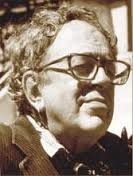
On July 26, 1955 Charles Laughton's The Night of the Hunter (United Artists) debuts, a film noir based on a true story and written by James Agee based on the 1953 Davis Grubb novel, starring Robert Mitchum as psychotic serial-killer Rev. Harry Powell, who marries lonely widow Willa Harper (Shelley Winters) to find $10K stashed by her executed hubby; Laughton's only dir. effort, influencing dirs. Jim Jarmusch, Spike Lee, David Lynch, Terrence Malick, Martin Scorsese, and the Coen brothers for its lyrical expressionistic style; #2 movie of all time after "Citizen Kane", according to Cahiers du Cinema.

On Aug. 3, 1955 Alfred Hitchcock's To Catch a Thief debuts, based on the David Dodge novel, starring Car Crash, er, Cary Grant as reformed jewel thief "The Cat", who falls in love with wealthy Am. woman Grace Kelly, after which a rash of jewel thefts occur; Kelly meets future hubby Prince Rainer during shooting in Monaco - to catch a prince?

On Sept. 30, 1955 Am. "East of Eden", "Rebel Without a Cause", "Giant" 3-film superstar actor James Dean (b. 1931) is killed in Cholame (Paso Robles), Calif. in a a high speed 2-car crash in his $7K Porsche Spyder 550 ("130" painted on the side, "Little Bastard" on the rear) on Route 66 with Donald Turnipseed (1932-95), who is driving a Ford, and claims he never saw him; Dean's passenger Rolf Weutherich (1927-81) (a German Porsche mechanic) recovers, then is later killed in a car accident; Dean leaves pet Siamese cat Marcus, given to him by Liz Taylor; on ? he filmed his last scene in "Giant" as an old fart who passes out while being lionized at a Tex. oilmens' convention; at the time of his death only "East of Eden" has been released; on Sept. 23 Dean lunched with English actor Alec Guinness at the Villa Capri in San Diego, and Guinness told him "Please never get in - if you do, you will be dead within a week"; Dean just signed the first-ever $1M Hollywood movie contract ($100K/film x 10 films); buried in Fairmont, Ind. - an entire generation lost in a Star Wars daydream?

On Oct. 3, 1955 Alfred Hitchcock's The Trouble with Harry debuts, based on the 1950 Jack Trevor Story novel about residents of a Vermont village dealing with a corpse becomes the film debut of Shirley MacLaine (Shirley Maclean Beaty) (1934-) (sister of Warren Beatty), and Bernard Herrmann's first musical score for Hitchcock.



On Oct. 11, 1955 Fred Zinnemann's Oklahoma! debuts, based on the 1943 musical by Aaron Copland (1900-90) and Jerome Robbins (1918-98), becoming the film debut of Shirley Mae Jones (1934-) as Laurey; Gordon MacRae plays Curley, Rod Steiger plays Jud Fry, Eddie Albert plays Ali Hakim, Gene Nelson plays Will Parker, and Gloria Grahame plays Ado Annie; the first film to use the Todd-AO process, invented by Michael "Mike" Todd (Avrom Hirsch Goldbogen) (1909-58), the 3rd of Elizabeth Taylor's seven husbands; on July 8, 1958 the Oklahoma! Soundtrack (#1 in the U.S.) receives the first-ever gold album from the Recording Industry of Am., and on Apr. 1, 1992 it is certified 2x multi-platinum.

On Oct. 27, 1955 Nicholas Ray's Rebel Without a Cause (CinemaScope) debuts, written by Stewart Stern and Irving Shulman, with title taken from Robert M. Lindner's 1944 book "Rebel Without a Cause: The Hypnoanalysis of a Criminal Psychopath", starring James "Torreador" Dean in his 2nd of three films as desk-kicking mooing new-to-town outsider Dawson H.S. student Jim Stark, crying father-kissing Natalie Wood (in her first post-child actor film) as Judy, and Sal Mineo as disturbed puppy-shooter John "Plato" Crawford (first gay teenager in a Hollywood film), who turns into a kookaboo with a gun, creating the rebel concept for the U.S. teenager; all three meet with tragic ends in real life; Jim "Mr. Magoo" Backus plays Dean's inept henpecked apron-wearing father; Corey Allen plays gangleader Buzz; Edward C. Platt plays tough-tender juvenile officer ?; also features Nick Adams; no rock music is used in the film; the prudish 1934 Hays Code rules the film; for the first three days the film is shot in B&W until they switch to color-only CinemaScope; the switchblades used in Dean's big knife fight are supplied by the police after being confiscated from hoodlums and dulled; "You're tearing me apart" (Dean); after scenes are filmed at Griffith Observatory on Mt. Hollywood, a memorial to Dean is later erected there; the use of an ice pick in the film causes sales to skyrocket?; bi dir. Ray has an affair with Wood and Dean at the same time?
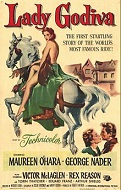
On Nov. 2, 1955 Arthur Lubin's Lady Godiva of Coventry (Universal-Internat.) debuts, starring Maureen O'Hara as Saxon Lady Godiva, George Nader as her hubby Lord Leofric, Rex Reason as Harold, Torin Thatcher as Lord Godwin, and Alec Harford as Peeping Tom the Tailor, who dies 8 mo. before the film's release; watch movie.

On Nov. 9, 1955 Hollyweird star Cock Suck, er, Rock Hard, er, Rock Hudson (Roy Harold Scherer Jr.) (1925-85) marries his agent's secy. Phyllis Lucille Gates (1926-2006) to counter press reports of his homosexuality; they divorce in 1958, and after she dies it is revealed that she was a lesbian who knew he was gay and married him for his money - no sex in the office?

In Nov. 1955 Joshua Logan's Picnic (Columbia) debuts, based on the 1953 William Inge play, starring William Holden (his last film with Columbia, for a miserable $30K fee instead of his usual $250K freelance fee) as hunky freight train bum Hal Carter (his shirt sleeves always rolled up), who stops in a lily-white Kan. town to beg employment from his old college fraternity brother Alan Benson (Cliff Robertson), whose father Mr. Benson (Raymond Bailey) owns grain silos, and ends up turning on every repressed woman in town, esp. 19-y.-o. Alan's babe Marjorie "Madge" Owens, played by Marilyn Pauline "Kim" Novak (1933-) (who becomes a star), breaking their hearts and turning everybody against him; also stars Susan Strasberg (daughter of Lee Strasberg) as Millie Owens (who likes to memorize Shakespeare sonnets), Betty Field as Flo Owens, and Rosalind Russell as Rosemary; Arthur O'Connell plays store owner Howard Bevens; Nick Adams plays Bomber the paperboy, while dating Natalie Wood and palling with James Dean and Elvis Presley.
In Dec. 1955 Douglas Sirk's Written on the Wind debuts, based on the Robert Wilder novel, a channeling of the 1970s TV series "Dallas", starring Lauren Bacall, Rock Hudson, Dorothy Malone, Robert Stack et al., reveling in the deadly sin side of the Am. Dream.
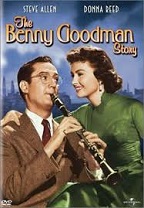
On Feb. 2, 1956 Valentine Davies' The Benny Goodman Story (Universal) debuts, starring Steve Allen as Benny Goodman, and Donnad Reed as his goy babe Alice Hammond, whom his Jewish mother (Berta Gersten) doesn't want in the family until he makes it to Carnegie Hall in 1938; Sammy Davis Sr. plays Fletcher Henderson; features appearances by Lionel Hampton, Kid Ory, Gene Krupa, Harry James et al.; "Bagels and caviar don't mix."

On Feb. 21, 1956 Dick Powell's The Conqueror debuts, a bomb written by Oscar Millard and produced by Howard Hughes, starring miscast John Wayne as Genghis Khan, along with Susan Hayward, Agnes Moorehead, Pedro Armendariz, and Chief Tahachee; filmed near St. George, SE Utah, 137 mi. downwind of the U.S. govt. Nevada Test Site, 91 of 220 crew members later come down with cancers, incl. Dick Powell (who croaks of lymphoma on Jan. 2, 1963), Hayward, who croaks of brain cancer on Mar. 14, 1975, Moorhead, who croaks of uterine cancer on Apr. 30, 1974, and 6-pack-a-day Wayne, who gets lung cancer in 1964 and croaks of stomach cancer on June 11, 1979, but blames smoking alone.

On Mar. 13, 1956 John Ford's The Searchers (Cornelius Vanderbilt Whitney) debuts, based on the 1954 Alan Le May novel, starring John Wayne as white racist Tex. Civil War vet Ethan Edwards, who searches for his Indian-kidnapped niece Debbie (Natalie Wood) and almost kills her to keep her from bearing half-breed kids; also stars Jeffrey Hunter as Martin Pawley, Ward Bond as Rev. Samuel Johnson Clayton, Vera Miles as Laurie Jorgensen, Lana Wood as young Debbie Edwards, and Ken Curtis as Charlie McCorry; the greatest Western of all time, and the classic study of the white Am. psyche?; Wayne's line "That'll be the day" (said 4x) is used by Buddy Holly as a song title.

On Mar. 15, 1956 Fred M. Wilcox's Forbidden Planet debuts, based on Shakespeare's "The Tempest" set in the year 2200 C.E. on Altair-4, starring Walter Pidgeon as Krell-haunted Dr. Edward Morbius, Anne Francis as his tempting virginal daughter Altaira, Leslie Nielsen as mister lucky Cmdr. John J. Adams, and Robby the Robot as himself; it is later looted blind by Gene Roddenberry for his "Star Trek" series, who also steals the pure-white Daniel Boone (Fess Parker) and brilliant educated halfbreed sidekick Mingo (Ed Ames) for his Capt. Kirk and Spock?

On Mar. 21, 1956 Fred F. Sears' Rock Around the Clock debuts, starring Bill Haley and His Comets in a raucous celebration of rock and roll, bringing it to the attention of white America with white musicians, causing a riot in London in Sept. after a young audience of 3K Teddy Boys view it and go on a rampage; that doesn't stop greed machine Hollywood from releasing five more rock and roll movies this year, incl. Fred F. Sears' Don't Knock the Rock (featuring Bill Haley and the Comets singing "Calling All Comets" and "Rip It Up") and Robert D. Webb's Love Me Tender (Nov. 15) (film debut of Elvis Presley).
On Mar. 21, 1956 the 28th Academy Awards awards the best picture Oscar for 1955 to United Artists' (Hecht and Lancaster) Marty, along with best dir. to Delbert Mann, and best actor to Ernest Borgnine; best actress goes to Anna Magnani for The Rose Tattoo, best supporting actor to Jack Lemmon for Mister Roberts, and best supporting actress to Jo Van Fleet for East of Eden.

On Apr. 19, 1956 after been seen with fashion designer Oleg Cassini and actor Jean-Paul Aumont, and being arranged to meet him on the French Riviera for a publicity stunt while filming the film To Catch a Thief, then seeing him only 3x, devout Roman Catholic Am. actress Grace Patricia Kelly (1929-82) marries prince (since 1949) Rainier Grimaldi III (1923-2005) of Central Park-sized tax haven Monaco, becoming Her Serene Highness Princess Grace of Monaco and ending her short but star-studded acting career; she wears a silk taffeta and antique lace gown by Hollywood designer Helen Rose (1904-85); her rose lace shoes have a hidden copper penny for luck; the groom first spends hours with her daddy, a Philly contractor, politician, and nat. sculling champ before asking for her hand, and is told, "You fadder was a rebel and you'll be one too, and leave my daughter a widdah, so I cannaugh give ya my permission", (oops, that was Sir William Wallace in the movie "Braveheart", strike that), "I certainly hoped he wouldn't run around the way some princes do, and I told him that if he did, he'd lose a mighty fine girl"; Monte Carlo casino king Aristotle Onassis says "I am mad with joy", and gives the Monaco Red Cross 1M francs; on Apr. 12 the American Export liner Constitution puts her on her beau's white yacht Deo Juvante II off the French coast, accompanied by 80 wedding guests, 24 columnists, four trunks, 20 hatboxes, 36 pieces of luggage, and her black French poodle Oliver while Onassis' private squadron bombards them with red and white carnations, and cannon fire 21-gun salutes from the shore, while 1.5K reporters line the dock; ashore the couple drives in the prince's green Chrysler Imperial; Euro royalty snubs the wedding, and Randolph Churchill explains that "I don't come here to meet vulgar people like the Kellys"; hotel king Conrad Hilton represents Pres. Eisenhower, Somerset Maugham leads the literati, and Agha Khan and ex-King Farouk I of Egypt attend the wedding at St. Nicholas Cathedral, where pickpockets make off with $150K; her wedding gifts incl. $250K worth of diamonds; in Aug. it is announced that she is preggers, and the New York Daily Mirror runs the headline "Monaco Weather Forecast: A Little Rainier in February"; the prince takes the princess' advice and begins reducing the dependence of Monaco on gambling revenue, from 95% of total revenue this year to 3% by his death; every Sun. the couple cooks pancakes for their kiddies?
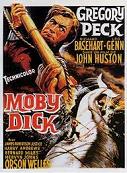
On June 27, 1956 John Huston's Moby Dick (Warner Bros.) debuts, written by Huston and Ray Bradbury based on the 1851 Herman Melville novel and shot on location in Youghal, County Cork, Ireland, starring Gregory Peck (after Walter Huston dies in 1950) as Capt. Ahab, Richard Basehart as Ishmael, Leo Genn as Starbuck, and Friedrich von Ledebur as Queequeg; does $5.2M box office on a $4.5M budget; "I'll follow him around the Horn, and around the Norway maelstrom, and around perdition's flames before I give him up"; "From Hell's heart I stab at thee; for hate's sake I spit my last breath at thee, ye damned whale"; ripped-off by "Star Trek II: The Wrath of Khan" (1982).

On June 29, 1956 Walter Lang's The King and I debuts, based on the 1944 Margaret Landon novel "Anna and the King of Siam" and adapted from the Rodgers and Hammerstein play Deborah Kerr as the English governess, and Yuliy Borisovich "Yul" Brynner (Taidje Khan) (1920-85) as the king; Marni Nixon dubs Kerr's voice.

On June 29, 1956 Marilyn Monroe (too beautiful to stay home studying but smart enough to admire it in others?) goes for brainy nerd writer (U. of Mich. grad) Arthur Asher Miller (1925-2005) and marries him in White Plains, N.Y. after converting to Judaism and getting her name legally changed to Marilyn Monroe; the headline reads "Egghead Weds Hourglass"; they divorce in 1962 - the Mismatch of the Century, or the original Shakespeare in Love?



On July 3, 1956 Robert Wise's Somebody Up There Likes Me debuts, based on his autobio. stars 2nd-time's-the-charm Paul Newman (after first choice James Dean is killed) (his 2nd film after the stinker "The Silver Chalice') as New York City-raised boxer Rocky Graziano (real name Thomas Rocco Barbella) (named after a wine brand), who starts out as a street punk and works his way up to Ft. Leavenworth until he's discovered and wins the middleweight title; Pier Angeli plays his wife Norma; the screen debuts of Terence Steven "Steve" McQueen (1930-80) and Robbert Loggia (1930-)

On July 17, 1956 Charles Waters' High Society (MGM), a remake of "The Philadelphia Story" set at the Newport Jazz Festival debuts, starring Grace Kelly as about-to-be-remarried divorcee Tracy Amantha Lord, and Bing Crosby and Frank Sinatra as the ex C.K. Dexter-Haven and the fiance Mike Connor; features jazz by Louis Armstrong and a score by Cole Porter, incl. his last major hit True Love; in 2006 Kelly's son Prince Albert II of Monaco (b. 1958) attends a 50th anniv. showing - and finds his true love, true love?
On July 24, 1956 after escalating ego problems, Jerry Lewis and Dean Martin end their partnership with a late night perf. at the Copacabana in Manhattan, N.Y., 10 years to the day after they make their first formal appearance at an Atlantic City nightclub, and do not speak to each other again for 20 years; "I walked out into the hallway and thought my heart would break" (Lewis); Lewis' career plateaus out by 1964, and is finished by 1974, while Martin's career sails on until his 1995 death?

On Aug. 31, 1956 Joshua Logan's Bus Stop (20th Cent. Fox) debuts, based on the 1955 William Inge play, starring Marilyn Monroe as Ozarks hillbilly dance hall girl Cherie, who is picked up in Phoenix, Ariz. and rough wooed by Mont. cowboy Beauregard Decker (Don Murray) and his friend Virgil Blessing (Arthur O'Connell) at a you know what; Robert Bray plays bus driver Carl, who woos Grace's Diner owner Grace (Betty Field); Hope Lange plays Elma Duckworth; does $7.27M box office on a $2.2M budget.

On Oct. 5, 1956 Cecil B. De Mille's The Ten Commandments debuts, his last film, a remake of his 1923 silent film, starring booming-voice Charlton "Charlie the Talking Horse" Heston as Moses, Yul Brynner as Pharaoh, beauty queen Yvonne De Carlo as Moses' wife Sephora, and Heston's son Fraser as baby Moses; the great scene of the Red Sea parting fills theaters, doing $122.7M box office on a $13M budget; Debra Paget is chosen for the part of Lilia after De Mille tells her "I feel the hand of God has been on you", causing her to become a born-again Christian in the 1970s; "Moses, you splendid, stubborn, admirable fool."

On Oct. 10, 1956 George Stevens' Giant debuts, based on the 1952 Edna Ferber novel, starring Rock Hudson, Elizabeth Taylor, and James Dean as feuding Tex. oil tycoons Jordan "Bick" Benedict, Leslie Lynnton, and Jett Rink.


On Oct. 17, 1956 Mike Todd's Around the World in Eighty Days (United Artists) debuts, written by Marx Brothers writer S.J. Perelman based on the 1872 Jules Verne novel, becoming the greatest box office sensation since the arrival of TV, lasting three years in theaters and grossing $25M in the U.S. and $42M worldwide; features a cast of 40+ stars, incl. David Niven as Phileas Fogg, and Cantinflas as his valet Passepartout; 10K extras are used in the bullfighting scene filmed near Madrid, and 6K buffalo are used in a stampede; Todd coins the word "cameo" after there are 42 of them in this flick; the U.S. debut of Mexican actor Cantinflas (Fortino Mario Alfonso Moreno Reyes) (1911-93), who becomes the world's highest-paid actor; John Farrow (1904-63), father of actress Mia Farrow by wife Maureen O'Sullivan wins an Oscar for the script; the theme song Around the World (#13 in the U.S.) is sung by Harold Adamson and Victor Young, and is speeded-up in the big 1958 hit "The Chipmunk Song".

On Oct. 20, 1956 Mervyn LeRoy's Toward the Unknown (Brink of Hell) debuts, written by "Twelve O'Clock" High" novelist Beirne Lay Jr., starring William Holden as USAF Maj. Lincoln Bond, who becomes a Korean War POW for 14 months and cracks, signing a confession before returning to Edwards AFB in Calif. as a test pilot, where Brig. Gen. Banner (Lloyd Nolan) doesn't trust him to fly supersonic jets; the film debut of part-Cherokee James Garner (James Scott Bumgarner) (1928-2014) as Maj. Joe Craven.
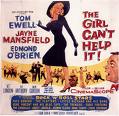

On Dec. 1, 1956 Frank Tashlin's The Girl Can't Help It
(20th Cent. Fox) debuts, based on the 1955 novel "Do Re Mi" by Garson Kanin, a musical comedy with score by Bobby Troup starring
Jayne Mansfield (1933-67) in her first starring role as a no-talent mobster moll, along with Tom Ewell,
Edmond O'Brien, Henry Jones, and Julie London, mixing-in a subplot about teenagers and their rock & roll music, featuring the title song performed by
Little Richard, with Ray Anthony performing "Big Band Boogie", Eddie Cochran performing "Twenty Flight Rock", also Gene Vincent and His Bluecaps, and the Platters,
turning on young Brits incl. John Lennon, and Paul McCartney, who gets an invite to join the Quarrymen after performing "Twenty Flight Rock" for him;
Julie London sings

On Dec. 13, 1956 Anatole Litvak's Anastasia debuts, starring Ingrid Bergman as a babe with amnesia, and Yul Brynner as a White Russian gen. trying to use her in a scam to impersonate the Romanoff Dynasty heiress to get his hands on millions of rubles deposited in a bank by the dead tsar; the movie gets good when she really believes she is the heiress, and so does Helen Hayes, and the audience?
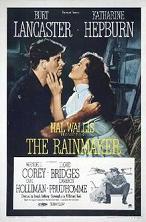
On Dec. 13, 1956 Joseph Anthony's The Rainmaker (Dec. 13) (Paramount Pictures) debuts, based on the play by N. Richard Nash, starring Burt Lancaster as itinerant huckster Bill Starbuck, who woos lonely tomboy ranch girl Lizzy Curry (Katharine Hepburn) while playing off her brothers Noah (Lloyd Bridges) and Jimmy (Earl Holliman).

On Dec. 18, 1956 Elia Kazan's Baby Doll debuts, based on "27 Wagons Full of Cotton" by Tennessee Williams, starring blonde sex bomb Carroll Baker (1931-) as Baby Doll Meighan, wife of slow-witted middle-aged Miss. cotton gin owner Archie Lee Meighan (Karl Malden), who torches Sicilian competitor Silva Vacarro's (Eli Wallach) cotton gin amid steamy sexual tension, all sans a single filmed kiss.

On Dec. 26, 1956 Vincente Minnelli's Lust for Life debuts, based on the 1934 Irving Stone novel and produced by John Houseman, starring Kirk Douglas as tortured if-it's-not-broke-why-fix-it ear-lopping artist Vincent Van Gogh; Anthony Quinn plays his fellow artist-lover Paul Gaugin.

On Jan. 26, 1957 after a whirlwind romance Elizabeth Taylor divorces Michael Wilding and converts to Judaism, and on Feb. 2 marries producer Michael "Mike" Todd (1907-58), who is 24 years older (her happiest marriage?); Eddie Fisher is best man at the wedding.
On Mar. 27, 1957 the 29th Academy Awards gives the best picture Oscar for 1956 to United Artists' (Michael Todd Co.) Around the World in Eighty Days, best actor to Yul Brynner for The King and I (while fooling around with Marlene Dietrich?), best actress to Ingrid Bergman for Anastasia, best supporting actor to Anthony Quinn for Lust for Life, best supporting actress to Dorothy Malone for Written on the Wind, and best dir. to George Stevens for Giant.

In Mar. 1957 James Ivory's Venice: Theme and Variations debuts, becoming the dir. debut of James Ivory (1928-).

On Apr. 13, 1957 Sidney Lumet's Twelve Angry Men debuts, based on the 1954 TV play by Reginald Rose (written for "Studio One"), featuring a great ensemble "American melting pot" cast (Henry Fonda, Lee J. Cobb, E.G. Marshall, Martin Balsam, Jack Klugman, Robert Webber, Ed Begley Sr., John Fielder, Jack Warden, George Voskovec, Edward Binns, Joseph Sweeney) in a jury room drama, where Juror #8 (Fonda) makes a stand and turns the other 11 toward the poor Hispanic suspect's (John Savoca) innocence; feature film debut of dir. Sidney Lumet (1924-), and whiny-voiced actor John Fiedler (1925-2005).

On May 28, 1957 Elia Kazan's A Face in the Crowd debuts, starring Andy Griffith as drifter Larry "Lonesome" Rhodes, who is discovered by producer Marcia Jeffries (Patricial Neal) in small town NE Ark., and becomes a nat. TV star, and gets too big for his britches, followed by a great fall as his off-mike utterances belitting his audience are fed back live; country comedian Rod Brasfield plays Griffith's sidekick Beanie; the film debut of Lee Ann Remick (1935-91) as Griffith's wife.

On June 13, 1957 Laurence Olivier's The Prince and the Showgirl (Warner Bros.) debuts, based on Terence Rattigan's 1953 play "The Sleeping Prince", starringLaurence Olivier as Charles, Prince Regent of Carpathia, and Marilyn Monroe as Am. showgirl Elsie Marina in 1910 London, complete with a Sylvester the Cat cartoon ("Greedy for Tweedy"), a newsreel, and coming attractions for "Spirit of St. Louis"; Sybil Thorndike plays the dowager queen; Monroe clearly didn't do anything for Olivier?; does $4.3M box office.

On July 10, 1957 Stanley Kramer's The Pride and the Passion debuts, based on the 1933 C.S. Forester novel "The Gun", set during the Peninsular War, starring Cary Grant as British Navy Capt. Anthony Trumbull, who is sent to beat French forces to a giant abandoned Spanish cannon, obtaining the help of French-hating guerrilla leader Miguel (a miscast Frank Sinatra), who makes him transport it first to relieve Avila from mean French Gen. Jouvet (Theodore Bikel) while they fight for bitchin' babe Juana (Sophia Loren); score by George Antheil, his last major work and the only one to be preserved on a commercial soundtrack; does $8.75M ($5.5M?) on a $2.5M ($3.7M?) budget; Grant and Loren fall in love during filming, even though he's married to actress Betsy Drake, but she dumps him for producer Carlo Ponti, causing him to shower her with flowers and phone calls when she visits Los Angeles while he's filming "An Affair to Remember", and after she jilts him again he begins taking prescription LSD with his wife's approval.

On July 19, 1957 Gene Fowler Jr.'s I Was a Teenage Werewolf (AIP) debuts, co-written by Herman Cohen, starring Michael Landon as Rockdale H.S. teenie Tony Rivers, and Whit Bissell as pshrink Alfred Brandon; does $2M box office on a $123K budget.
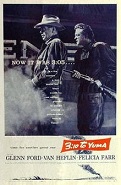
On Aug. 7, 1957 Delmer Daves' B&W Western 3:10 to Yuma (Columbia Pictures) debuts, based on the 1953 story by Elmore Leonard, starring Glenn Flord as 1880s Ariz. outlaw Ben Wade, and Van Heflin as rancher Dan Evans, who is talked into taking him to the you know what so he can be tried in Yuma; Felicia Farr plays barmaid Emmy; theme song by Dmitri Tiomkin and Ned Washington; remade in 2007 by James Mangold starring Russell Crowe and Christian Bale.

On Aug. 17 1957, Richard Quine's Operation Mad Ball, debuts, about bored GIs throwing a party and inviting the nurses only to find out they are officers, starring Jack Lemmon and Kathryn Grant, becoming the film debut of mustachioed comedian Ernest Edward "Ernie" Kovacs (1919-62).

On Aug. 29, 1957 George Abbott's The Pajama Game debuts, based on the Richard Bisell novel "7-1/2 Cents", starring Doris Day and John Raitt (father of Bonnie Raitt), a comedy about Sleeptite Pajama Factory workers demanding a 7.5-cent an hour pay raise.
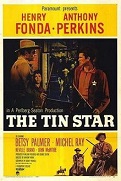
On Oct. 23, 1957 Anthony Mann's Western The Tin Star (Paramount Pictures) debuts, starring Henry Fonda as ex-sheriff bounty hunter Morg Hickman, who schools greenhorn sheriff Ben Owens (Anthony Perkins); "A decent man doesn't want to kill, but if you're going to shoot, shoot to kill."

On Oct. 25, 1957 George Sidney's Pal Joey debuts, based on the 1939 John O'Hara novel, starring Frank Sinatra as womanizing singer Joey Evans (who likes to call women "mice") in San Francisco, who goes after rich widow Vera Simpson (Rita Hayworth) to fund his Chez Joey nightclub, while also going after bombshell blonde singer Linda English (Kim Novak).

On Oct. 25, 1957 Stanley Kubrick's Paths of Glory debuts, a WWI anti-war drama based on the 1935 Humphrey Cobb novel, starring Kirk Douglas as French Col. Dax, Ralph Meeker as Cpl. Philippe Paris, and Adolphe Menjou as Maj. Gen. George Broulard.

On Dec. 11, 1957 Mark Robson's Peyton Place debuts, based on the 1956 Grace Metalious novel, starring Lana Turner as Constance MacKenzie, Hope Lange as Selena Cross, Arthur Kennedy as Lucas Cross, Lee Philips as Michael Rossi, and Diane Varsi as Allison MacKenzie; music by Franz Waxman.

On Dec. 25, 1957 Robert Stevenson's Old Yeller debuts, based on the 1956 Fred Gipson novel, becoming Disney's first boy-dog film, starring 15-y.-o. Tommy Kirk, Fess Parker, Dorothy McGuire et al., who fall in love with a dog and have to put him down when he contracts rabies from a wolf, after which his daddy Jim gives him a horse; Old Yeller is played by yellow Mastador (Lab-Mastiff mix) Spike, trained by Frank Weatherwax.
On Dec. 28, 1957 after falling in love on a small boat, Hollywood stars Natalie Wood and Robert Wagner marry despite Wood's mother Maria protesting; they separate in June 1961 and divorce in Apr. 1962, after which Wood marries British producer Richard Gregson on May 30, 1969, and has his daughter Natasha Gregson on Sept. 29, 1970, then separate in Aug. 1971, and divorce in Apr. 1972, after which she remarries Wagner on July 16, 1972, and has his daughter Courtney Wagner on Mar. 9, 1974; she dies in Isthmus Cove in Santa Catalina Island while on another boat (the yacht Splendour) with him on Nov. 29, 1981.
In Dec. 1957 Desilu Productions, founded in 1950 by Lucille Ball and Desi Arnaz buys the RKO (Radio-Keith-Orpheum) (originally the FBO, Film Booking Office) Hollywood movie studios from Gen. Tire and Rubber for $6M, causing its public stock to jump from $10 to $29 a share next year.


In 1957 London-born Australian novelist Nevil Shute (Nevil Shute Norway) (1899-1960) pub. On the Beach, about the aftereffects of an atomic war in 1963 in Melbourne, Australia, where the residents succomb to radiation poisoning and commit govt.-sponsored suicide; filmed in 1959. On Dec. 17, 1959 Stanley Kramer's B&W On the Beach debuts, starring Gregory Peck, Ava Gardner, and Fred Astaire; does $2.2M box office on a $2.9M budget.

On Mar. 22, 1958 twin-engine Lockheed Lodestar aircraft the Lucky Liz, headed to New York City from Los Angeles for a Friars club dinner in his honor explodes in midair near Grants, N.M. and crashes, killing "Around the World in Eighty Days" producer Michael "Mike" Todd (b. 1909) (husband of Elizabeth Taylor), pilot Bill Verner, co-pilot Tom Barclay, and screenwriter Art Cohn, who was writing the bio. "The Nine Lives of Mike Todd"; Liz suffers from bronchitis so her doctor forbid her to go on the flight; Todd's best friend Eddie Fisher rushes to console widow Taylor, and ends up dumping his wife Debbie Reynolds for her; Kirk Douglas, Joe E. Lewis, and Joseph Mankiewicz also begged off because of bad weather?
On Mar. 26, 1958 the 30th Academy Awards awards the best picture Oscar for 1957 to Columbia's (Horizon Films) The Bridge on the River Kwai, along with best actor to Alec Guinness, and best dir. to David Lean; best actress goes to Joanne Woodward for The Three Faces of Eve, best supporting actor and best supporting actress to Red Buttons and Miyoshi Umeki for Sayonara; the first Oscar is awarded for best foreign language film, causing a flurry of subtitled films in theaters.
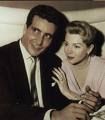

On Apr. 4, 1958 Cheryl Christina Crane (1943-), daughter of actress Lana Turner and Stephen Crane stabs Lana's Italian mobster beau John "Johnny Stomp" Stampanato Jr. (b. 1925) (known for his foot-long Oscar) to death after overhearing him threaten her for trying to break up with him; since he had previously pointed a gun at future James Bond 007 actor Sean Connery (who took it from him, beat him, and kicked him off the set), it is ruled justifiable homicide, but she is sent to a home for problem girls, and after they lick her problems she becomes a lesbian; the publicity helps Lana's career.

On May 15, 1958 Vincente Minnelli's Gigi, written by Alan Jay Lerner based on the 1944 Colette novel debuts, starring Leslie Caron as the courtesan of wealthy Gaston (Louis Jordan), who prefers her to his wife, although he also snacks at Eva Gabor's vapid Y; Maurice Chevalier plays Gaston's uncle, and Hermione Gingold plays Gigi's grandmother; one of the first MGM films to be shot on location, it becomes MGM's last great musical, and last produced by Arthur Freed; music by Frederick Loewe and Andre Previn; wins all nine of its Oscar nominations; Chevalier sings "Thank Heaven for Little Girls"; Sir Cecil Beaton (1904-80) wins an Oscar for costume design; does $13.2M box office on a $3.3M budget.


In Aug. 1958 the first eight of 1,558 stars are installed on the Hollywood Walk of Fame at Hollywood Blvd. and Vine St., incl. Olive Borden, Ronald Colman, Louise Fazenda, Preston Foster, Burt Lancaster, Edward Sedgwick, Ernest Torrence, and Joanne Woodward (first to pose with her star); after a lawsuit by Charles Chaplin Jr. seeking damages for the exclusion of his father is dismissed, official groundbreaking takes place on Feb. 8, 1960, and on Mar. 28 the first permanent star, for dir. Stanley Kramer is completed; Chaplin finally gets his star in 1972; in 1978 Mickey Mouse becomes the first animated char. to receive a star; Oscar winners' stars are placed near the Dolby Theatre, and the rest in front of Grauman's Chinese Theatre; in 1993 the Four Ladies of Hollywood Gazebo (Hollywood and La Brea Gateway) at the confluence of Hollywood Blvd., Marshfield Way, and N La Brea Ave. is commissioned, and dedicated on Feb. 1, 1994.

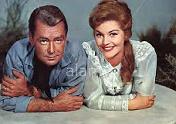
On Sept. 3, 1958 Delmer Daves' The Badlanders debuts, based on the novel "The Asphalt Jungle" by W.R. Burnett, starring Alan Ladd and Ernest Borgnine, making a star of hot recently-divorced Claire Kelly (Claire Ann Green) (1934-98) as Ada Winton; in 1959 Kelly is called "the screen's most exciting discovery since Rita Hayworth", preferring wealthy playboys and once calling Prince Aly Khan "gauche" and Elvis Presley "a mere child" before marrying wealthy banking heir Robert Alan Kenaston Jr. (-1995) (son of actress Billie Dove), followed by wealthy Robert Murphy.

On Sept. 20, 1958 Richard Brooks' Cat on a Hot Tin Roof (MGM) debuts, based on the 1955 Tennessee Williams play, starring Elizabeth Taylor as Margaret "Maggie the Cat" Pollitt, Burl Ives as dying Harvey "Big Daddy" Pollitt, and Paul Newman as her alcoholic ex-football player skirt chaser hubby Brick Pollitt; "Mendacity is a system that we live in" (Brick); does $11.28M box office on a $2.35M budget.


On Sept. 27, 1958 Stanley Kramer's The Defiant Ones debuts, starring Sidney LO. Poitier (1927-2022), who becomes the first black Hollywood actor to achieve leading man status and be accepted by a white audience for his performance chained to Tony Curtis; it takes six more years for him to earn an Oscar.

On Oct. 1, 1958 William Wyler's The Big Country (United Artists) debuts, a sprawling Western saga based on the 1958 Donald Hamilton novel, starring Gregory Peck as retired sea Capt. James McKay, who heads west to marry Patricia Terrill (Carroll Baker) on the ranch of her daddy Maj. Terrill (Charles Bickford), then clashes with ranch foreman Steve Leech (Charlton Heston) and joins in a water rights feud with neighbor Rufus Hannassey (Burl Ives); meanwhile Patricia's best friend Julie Maragon (Jean Simmons) owns the Big Muddy, a ranch with the key source of water, allowing her to play peacemaker; Chuck Connors plays eldest son Buck Hannessey, who lusts after Julie; Mexican actor Alfonso Bedoya (Gold Hat in "The Treasure of the Sierra Madre") plays Ramon Guiteras, and dies after filming; a favorite of Ike because it's all really a fable about the Cold War, and how diplomacy beats mutually-assured destruction (MAD)?
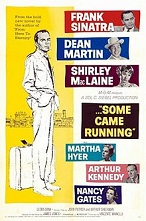
On Dec. 18, 1958 Vincente Minnelli's Some Came Running (MGM) debuts, based on the 1957 James Jones novel and filmed in Mason, Ind., starring Frank Sinatra as Army veteran Dave Hirsh, who returns to his home town of Parkman, Ind. after his writing career tanks, hooking up with gambler Bama Dillert (Dean Martin) and loose woman Ginny Moorehead (Shirley MacLaine); does $6.3M box office on a $3.1M budget.

On Dec. 27, 1958 Morton DaCosta's Auntie Mame (Warner Bros.) debuts, based on the 1955 novel by Patrick Dennis, starring Rosalind Russell as Mame Dennis, Jan Handzlik and Roger Smith as Patrick Dennis, Forrest Tucker as Beauregard Jackson Pickett Burnside, and Coral Browne as Vera Charles.

On Mar. 18, 1959 Howard Hawks' Rio Bravo (Warner Bros.) debuts, shot in Tucson, Ariz., starring John Wayne as Presidio County, Tex. sheriff John T. Chance, Dean Martin as his drunken deputy Dude, John Russell and Claude Akins as ranchers Nathan and Joe Burdette, Ward Bond as wagon train boss Pat Wheeler, Walter Brennan as gimpy deputy Stumpy, Angie Dickinson as Feathers, and Ricky Nelson as Colorado Ryan, who performs the song "Get Along Home, Cindy".

On Mar. 29, 1959 Billy Wilder's Some Like It Hot (Mirisch Co.) (United Artists) debuts, starring Tony Curtis and Jack Lemmon as cross-dressing musicians Joe/Josephine and Jerry/Gerald/Daphne, who hook up with ukelele player Sugar "Kane" Kowalczyk (Marilyn Monroe) on a train in 1929 Chicago while fleeing the mob after witnessing the 1929 St. Valentine's Day Massacre; greatest Am. comedy of all time?; Joe E. Brown plays Osgood Fielding III, who is in love with Daphne, causing her to remove his wig and admit, " I'm a man", to which he replies: "Well, nobody's perfect"; does $40M box office on a $2.9M budget.
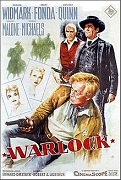
On Apr. 1, 1959 Edward Dmytryk's Warlock (The Man with the Golden Colts) (20th Cent. Fox) debuts, a Western based on the 1958 novel by Oakley Hall about a town called Warlock in early 1880s Utah (really Tombstone, Ariz.), which Hollywood Ten member Dmytryk turns into a commentary on the witch-hunting of HUAC, starring Richard Widmark, Henry Fonda, Anthony Quinn, and DeForest Kelley.
On Apr. 6, 1959 the 31st Academy Awards awards the best picture Oscar for 1958 to MGM's (Arthur Freed Productions) Gigi, along with best dir. to Vincente Minnelli; best actor goes to David Niven for Separate Tables, best actress to Susan Hayward for I Want to Live, best supporting actor to Burl Ives for The Big Country, and best supporting actress to Wendy Hiller for Separate Tables.
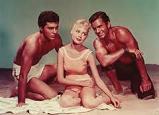
On Apr. 10, 1959 Paul Wendkos' Gidget ("girl midget") (Columbia Pictures) debuts, based on the 1957 Frederick Kohner novel "Gidget, the Little Girl with Big Ideas" about summer surfing, starring Sandra Dee (Alexandra Zuck) (1942-2005) as 17-y.-o. Frances Lawrence AKA Gidget,who chases surfer Moondoggie (James Darren), mainstreaming the white Southern Calif. surfing culture and becoming so popular that it spawns two movie sequels, two TV sequels, and a TV series starring Sally Field, who uses surfboards designed by Dale Velzy; the Gidget Theme is performed by The Four Preps from Hollywood High School in Calif., incl. Bruce Belland (1936-), Ed Cobb (1938-99), Glen Larson (1937-), and Marv Ingram (Marvin Inabnett), who have a #2 U.S. hit in 1958 with 26 Miles (Santa Catalina), and a #13 U.S. hit in 1960 with Down By the Station; Gidget Goes Hawaiian (1961) stars Deborah Walley, with James Darren continuing as her beau Moondoggie, and has a bit part for "Jeopardy!" announcer Johnny Gilbert; Gidget Goes to Rome (1963) stars Cindy Carol and James Darren; Philadelphia, Penn.-born James Darren (James William Ercolani) (1936-) goes on to score with hit singles Goodbye, Cruel World (#3 in the U.S.), composed by Noel Regney (1922-2002) and Gloria Shayne Baker (1923-2008), which sells 1M copies, followed by Her Royal Majesty (1962) (#6 in the U.S.).

On Apr. 17, 1959 Douglas Sirk's Imitation of Life debuts, starring blonde white Lana Turner as Lora Meredith, whose black housekeeper Annie Johnson (Juanita Moore) looks after her daughter Susie (Terry Burnham/Sandra Dee), while her own daughter Sarah Jane (Karin Dicker/Susan Kohner) passes for white, and is beaten by beau Frankie (Troy Donahue) when he finds out, all the rejection finally getting to Annie, who dies of a broken heart, after which her wayward daughter begs forgiveness at her funeral, woo woo woo; the film signals the end of white supremacy in America in a sea of white guilt?

On May 30, 1959 Vincent Sherman's The Young Philadelphians (Warner Bros.) (B&W) debuts, based on the 1956 Richard P. Powell novel, starring Paul Newman as rising atty. Anthony Judson Lawrence, Barbara Rush as his fiancee Joan Dickinson, and Robert Vaughn as his self-pitying murder client-friend Chester A. "Chet" Gwynn.
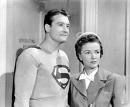


On June 16, 1959 Am. "Superman" actor George Reeves (Besselo) (b. 1914) dies in Beverly Hills, Calif. from a bullet to the temple; officially ruled suicide; really a mob hit ordered by Hollywood studio exec Joseph Edgar Allen "Eddie" Mannix (1891-1963), who had been playing around with a Japanese woman while Reeves was doing it with his wife Toni, with a mutual understanding because they're all Roman Catholics who can't divorce, until early in the year Reeves broke up with Toni and became engaged to socialite Leonore Lemmon (1923-89), devastating her?; buried in his grey Clark Kent suit; beginning of an "untimely death for Superman actor" trend?


On July 1, 1959 Otto Preminger's Anatomy of a Murder debuts, based on the John D. Voelker novel, starring James Stewart and George C. Scott as defense and prosecuting attys. battling over a murder case in a small town in N Mich.; best courtroom drama ever made?; makes a star of Lee Ann Remick (1935-91), who won the role of Laura Manion after Lana Turner was fired.

On July 22, 1959 Edward D. Wood Jr.'s Plan 9 from Outer Space (original title "Grave Robbers from Outer Space") debuts, starring Gregory Walcott, Tor Johnson, Maila "Vampira" Nurmi, Mona McKinnon, and Bela Lugosi; so bad it's good?; enjoys a resurgence in 1980 when Michael Medved and Harry Medved call it the "worst movie ever made".


On July 28, 1959 Alfred Hitchcock's North by Northwest (MGM) debuts, starring Cary Grant (after Jimmy Stewart is dumped when "Vertigo" flops at the box office) as Madison Ave. ad exec Roger O. Thornhill, who is taken for a govt. spy and has to flee across country with babe Eve Kendall (Eva Marie Saint); Leo G. Carroll plays the Professor, and James Mason plays real spy Phillip Vandamm; does $9.8M box office on a $4.3M budget; the film debut of Bruce MacLeish Dern (1936-) in an uncredited role.

On Oct. 7, 1959 Michael Gordon's Pillow Talk debuts, becoming the first of three pairings of Doris Day and Rock Hudson as interior decorator Jan Morrow and playboy Broadway composer Brad Allen, who get into a feud over the use of a party line, and end up getting married, with four pillows (pink, blue, pink, blue) appearing on the screen to indicate their children; she never knew he was gay?; does $18.75M box office, reviving Hudson's career.
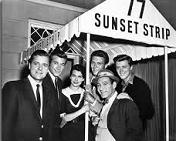
On Oct. 10, 1959 (Sat.) the detective series 77 Sunset Strip (B&W) debuts on ABC-TV for 205 episodes (until Feb. 7, 1964), starring Efrem Zimbalist Jr. (1918-) as ex-secret agent detective Stuart "Stu" Bailey, Roger LaVerne Smith (1932-) (who marries Ann-Margaret in 1967 after Myasthenia gravis ends his acting career in 1965, becoming her mgr.) as his ex-secret agent partner Jeff Spencer, who operate out of a posh office in West Hollywood, Calif. between La Cienega Blvd. and Alta Loma Rd. on the S side of the Strip next door to Dino's Lodge; Jacqueline Beer plays the French switchboard operator; Edd "Kookie" Byrnes (Edward Byrne Breitenberger) (1933-) as Dino's hair-combing parking attendant Gerald Lloyd "Kookie" Kookson III, who popularizes the expressions "ginchy" and "piling up Zs"; features the 77 Sunset Strip Theme by Mack David and Jerry Livingston; in May 1960 Kookie becomes a partner of the detective firm, and Robert Logan becomes the parking lot attendant.
On Oct. 14, 1959 Tasmanian-born Am. "The Adventures of Robin Hood", "Captain Blood" actor Errol Flynn (b. 1909) dies in Vancouver, B.C., Canada of a heart attack; he dies broke and in failing health on a trip with his 16-y.-o. betrothed babe Beverly Aadland (1943-) to sell his yacht Zaca; three weeks earlier his longtime co-star Olivia de Havilland sees their old flick "The Adventures of Robin Hood", and almost writes him to see it to cheer him up, but doesn't; "I'll live this half of my life, I don't care about the other half"; "Women won't let me stay single, and I won't let myself stay married"; "I've had a hell of a lot of fun, and I've enjoyed every minute of it"; "I had an insatiable desire to run through the world, and not be hemmed in by anybody"; "If I have any genius, it's a genius for living"; "I have a zest for living, yet twice the urge to die"; "Who could live with himself believing himself to be a symbol of sex and nothing more?"; "Old Errol died laughing - can you beat that?" (Tony Britton to Trevor Howard).

On Nov. 18, 1959William Wyler's Ben-Hur (MGM) debuts, written by Karl Tunberg based on the 1880 Lew Wallace novel , starring Charlton Heston (after Rock Hudson and Paul Newman turn down the part, and Kirk Douglas is passed-over, pissing him off so much that he decides to star in his own costume drama, which becomes "Spartacus") as Judah Ben-Hur, who gets betrayed by Roman soldier Messala, played by dimpled Irish-born Stephen Boyd (1931-77), ending up as a slave, then fighting his way back up the food chain, defeating Messala, only to throw it all away for Christ; wins a record 11 Oscars; as Boyd's char. is dragged behind his chariot in the fabulous Roman chariot race (cut down 260-to-1 for dramatic effect), the camera cuts away, then a dummy is run over by another chariot, starting rumors that his stunt double was killed during filming; Gore Vidal is an uncredited screenwriter.
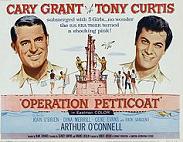
On Dec. 5, 1959 Blake Edwards' Operation Petticoat (Universal Pictures) debuts, a comedy film starring Cary Grant (as Lt. Cmdr. Matthew T. "Matt" Sherman) and Tony Curtis (as Lt. JG Nicholas "Nick" Holden) aboard the WWI sub USS Sea Tiger, which is being sent to the scrapyard with five female Army nurses aboard incl. Dina Merrill, Virginia Gregg, Madlyn Rhue, nad Marion Ross, causing ridiculous situations; does $6.8M box office (#3 in 1960).

On Dec. 22, 1959 Joseph L. Mankiewicz's Suddenly Last Summer debuts, adapted by Gore Vidal from the Tennessee Williams play, starring Katharine Hepburn as rich New Orleans matron Violet Venable, who summons Dr. John Cukrowicz (Montgomery Clift) (who remains half-recovered from his May 1956 auto accident near Taylor's home and can only work a few hours a day) to lobotomize her niece Catherine Holly (Elizabeth Taylor), who went nuts after her gay pedophile cousin Sebastian was killed and eaten by Euro boys after he made passes at them; since Clift is really gay and he and Taylor get too much attention, Hepburn spits in Mankiewicz's face after her work wraps?

On ?, 1959 Budd Boetticher's Ride Lonesome debuts, starring Randolph Scott and Karen Steele, becoming the film debut of James Coburn Jr. (1928-2002).
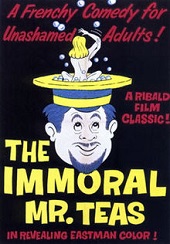

In 1959 Russ Meyer's The Immoral Mr. Teas debuts, about a straw hat-wearing voyeur, launching the career of soft porno producer-dir. Russell Albion "Russ" Meyer (1922-2004) after it grosses $1M on a $24K budget, giving him the title "King of the Nudies"; his films become known for satire and fixation on big breasts; watch movie.

In 1959 gay Satanist (Thelemite) filmmaker Kenneth Anger (Kenneth Wilbur Anglemeyer) (1927-) pub. Hollywood Babylon in France, full of salacious gossip about Hollywood stars to the 1950s, becoming a hit despite its lack of documentation for many wild claims; U.S. ed. pub. in 1965, then banned after 10 days and not repub. until 1975; full of "mental telepathy, mostly" (Kevin Brownlow); claims that Clara Bow slept with the entire USC football team incl. John Wayne, and that Raymon Novarro died with a black lead Arc Deco dildo rammed down his throat that was a gift from his gay bud Rudolph Valentino; the sequel "Hollywood Babylon II" is pub. in 1984; "A gossip gourmet's delight" (Rex Reed); "If a book such as this can be said to have charm, it lies in the fact that here is a book without one single redeeming merit." (New York Times).
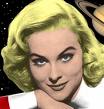
On Jan. 2, 1960 Vincent Sherman's Ice Palace debuts, based on the 1958 Edna Ferber novel about Alaska's road to statehood, starring Richard Burton as Zeb Kennedy, Thor Storm as Robert Ryan, and Carolyn Jones as Bridie Ballantyne; blonde-blue newbie Diane McBain (1941-) (billed as Hollywood's next Marilyn Monroe) makes her feature film debut as Christine Storm.

On Mar. 9, 1960 Walter Lang's Can-Can (20th Cent. Fox) (Todd AO) debuts, based on the 1952 Broadway musical, starring Frank Sinatra as Francois, Shirley MacLaine as Simone, Louis Jordan as Philippe, Maurice Chevalier as Paul, and Bombay, India-born Juliet Anne Prowse (1936-96) (film debut) as Claudine; #2 grossing film of 1960 after "Ben-Hur"; does $4.2M box office on a $5M budget; in Sept. 1959 after watching Juliet Prowse dancing on the movie set of Can-Can, he calls the dancers "immoral", "depraved", and "pornographic" saying "A person's face is more beautiful than their ass"; on Sept. 19 he is barred from Disneyland, and throws a tantrum, uttering the soundbyte "Is there an epidemic there? Have gangsters taken over the place?"
On Apr. 4, 1960 the 32nd Academy Awards awards the best picture Oscar for 1959 to MGM's Ben-Hur, along with 10 other Oscars, incl. best actor to Charlton Heston, best supporting actor to Hugh Griffith, and best dir. to William Wyler; best actress goes to Simone Signoret for Room at the Top (first French actress to win), and best supporting actress to Shelley Winters for The Diary of Anne Frank.
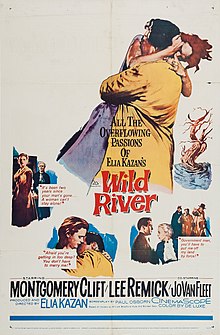
On May 28, 1960 Elia Kazan's Wild River (Mar. 26) (20th Cent. Fox), based on novels by Borden Deal and William Bradford Huie stars Montgomery Clift as whimpy but persistent TVA admin. Chuck Glover, who trieds to convince stubborn widow Ella Garth (Jo Van Fleet) to vacate her lifelong island home on Tennessee River before the new dam is completed, and hooks up with 21-y.-o. widowed wild ride (Ella's granddaughter) Carol Garth Baldwin (Lee Remick), putting him into conflict with her suitor Walter Clark (Frank Overton), and bully R.J. Bailey (Albert Salmi), who doesn't want his farm workers leaving for the TVA's better wages of $5/day, which are given equally to African-Am. workers; the screen debut of Bruce Dern as Jack Roper; despite the need to fight the pain from his May 12, 1956 automobile accident, Clift agrees to stay off the pills and booze during filming; does ? box office on a $1.6M budget.

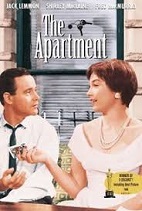


On June 15, 1960 Billy Wilder's The Apartment (The Mirisch Co.) (United Artists) debuts, a classic film about the price paid to climb the corporate ladder, starring Jack Lemmon as lowly insurance clerk C.C. "Bud" Baxter, who loans his apt. to his bosses, then learns that Mr. Sheldrake (Fred MacMurray) is using it for an affair with his dream girl Fran Kubelik (Shirley MacLaine); does $24.6M box office on a $3M budget; the first million-selling movie theme hit for the Juilliard-trained Am. pianists Arthur Ferrante (1921-2009) and Louis Milton Teicher (1924-2008), who follow it with "The Apartment" (1960), "Tonight" (1961), and "Midnight Cowboy" (1969), causing them to become known as "the Movie Theme Team"; features a magical floating water tap, a home decoration that catches on and ends up duplicated on a large scale around the world incl. Menorca, Spain; watch video; watch video; watch video.


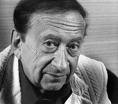
On June 16, 1960 Alfred Hitchcock's Psycho (Paramount Pictures) (his last B&W film) debuts,, based on the 1959 novel by horror writer Robert Bloch (1917-94) based on an actual murder, starring Anthony Perkins as bird-taxidermy-loving momma's boy Norman Bates (based on real-life serial killer Ed Gein), owner of the 12-room Bates Motel (15 mi. from Fairvale), where fleeing (Fri., Dec. 11) Phoenix, Ariz. thief Marie Samuels, er, Marion Crane (Janet Leigh) (license plate #NFB-418) (who stole $40K from 'her real estate employer of 10 years) checks into room #1 and receives a bloody shower death at the hands of a mad slasher grandma in the classic Psycho Shower Scene; first Hollywood film to show a flushing toilet; Bernard Hermann's scary music uses only strings; "She's as harmless as one of those stuffed birds" (Norman); also stars John Gavin as Leigh's beau Sam, Vera Miles as her sister Lila, and Martin Balsam as detective Arbogast; theater owners are told not to allow seating after the movie begins; shot on a low budget in only 1 mo.; uses chocolate sauce for blood in the 45-sec. 78-frame 70-camera-setup shower scene, which occurs 30 min. into the film, and changes the horror movie genre forever; a double is used for Perkins to make it harder to guess who it is; "A boy's best friend is his mother"; when an angry father writes to Hitchcock that his daughter quit bathing after the 1954 French film "Les Diaboliques", and now won't shower, he replies "Send her to the dry cleaners"; NYT film critic Bosley Crowther calls the film "a blot on an otherwise honorable career."

On June 22, 1960 Roger Corman's House of Usher (AIP) debuts, based on the Edgar Allan Poe story "The Fall of the House of Usher", starring Mark Damon as Philip Winthrop, who visits the Usher Mansion to see his babe Madeline Usher (Myrna Fahey), and discovers that she and her brother Roderick (Vincent Price) have a mysterious illness based on a family curse; causes Corman to go into the Poe movie biz, incl. "The Pit and the Pendulum" (1961), "The Premature Burial" (1962), "Tales of Terror" (1962), "The Raven" (1963), "The Haunted Palace" (1963), "The Masque of the Red Death" (1964), "The Tomb of Ligeia" (1965).

On June 29, 1960 Richard Brooks' Elmer Gantry (United Arists) debuts, based on the 1926 Sinclair Lewis novel, starring Burt Lancaster as a smooth-talking ever-smiling small-town Southern evangelist phony who talks his way into a travelling congregation and the bed of Sister Sharon Falconer (Jean Simmons), and jukes the elders into taking on big city Zenith in the state of Winnemac (pop. 361K) while being watched by agnostic reporter Jim Lefferts (Arthur Kennedy), and dumps girlfriend Lulu Baines (Shirley Jones), causing her to turn into a ho then frame him for revenge, causing the crowd to pelt him with garbage, after which the tent burns down and takes Sharon with it, causing him to quit, quoting the Bible verse "When I was a child, I understood as a child and spake as a child. When I became a man I put away childish things" (1 Cor. 13:11); features a bunch of old-time gospel songs incl. Do You Believe?, Shall We Gather at the River, Stand up for Jesus. Onward Christian Soldiers, and I'm on My Way; Listen; the real fun is watching Bible-thumping Gantry manage to condemn Biblical Creation with faint praise?; does $5.2M box office on a $3M budget. Elmer Gantry (United Artists) debuts, based on the 1926 Sinclair Lewis novel, starring Burt Lancaster as a smooth-talking ever-smiling small-town Southern evangelist phony who talks his way into a travelling congregation and the bed of Sister Sharon Falconer (Jean Simmons), and jukes the elders into taking on big city Zenith in the state of Winnemac (pop. 361K) while being watched by agnostic reporter Jim Lefferts (Arthur Kennedy), and dumps girlfriend Lulu Baines (Shirley Jones), causing her to turn into a ho then frame him for revenge, causing the crowd to pelt him with garbage, after which the tent burns down and takes Sharon with it, causing him to quit, quoting the Bible verse "When I was a child, I understood as a child and spake as a child. When I became a man I put away childish things" (1 Cor. 13:11); the real fun is watching Bible-thumping Gantry manage to condemn Biblical Creation with faint praise?; does $5.2M box office on a $3M budget.

On Aug. 17, 1960 George Pal's The Time Machine (MGM), debuts, based on the 1895 H.G. Wells novel, starring Rod Taylor as Wells, who travels forward to the year 802,701, watching humans destroy their own civilization and their descendants degenerate into the deep-dwelling cannibalistic Morlocks and the surface-dwelling food animal Eloi; Alan Young plays David/James Filby, and Yevette Mimieux plays Weena the Eloi, who is worth going back, er, forward for; does $2.61M box office on a $829K budget.


On Oct. 7, 1960 (Shoe Day Minus Five) the Hollywood film Spartacus (Universal Internat.) debuts, breaking the Hollywood Blacklist by giving open credit to blacklisted Hollywood Ten (1947) screenwriter Dalton Trumbo (1905-76), based on the 1951 Howard Fast novel about the Servile Revolt of 73-71 B.C.E., with a cast of 10.5K, starring Kirk Douglas (the exec. producer, who raised the $12M production cost, and had to talk Olivier out of the part) as the Thracian slave gladiator, Laurence Olivier as Sen. Marcus Licinius Crassus (richest man in Rome), Charles Laughton as Sen. Sempronius Gracchus, Tony Curtis as snail-hating literate Sicilian slave Antoninus, Jean Simmons as Spartacus' babe Varinia, Peter Ustinov as gladiator school owner Lentulus Batiatus, John Dall as Graccus' protege Marcus Publius Glabrus, Nina Foch as her black buck-loving sister Helena, Herbert Lom as Cilician pirate Tigranes Levantus, Woody Strode as Ethopian gladiator Draba, Charles McGraw as gladiator trainer Marcellus, and John Gavin as Julius Caesar; musical score by Alex North; the battle scenes were filmed outside Madrid, using 8K Spanish infantrymen; "When just one man says no I won't, Rome begins to fear"; "My taste includes both snails and oysters"; "When a free man dies, he loses the pleasure of life. A slave loses his pain. Death is the only freedom a slave knows. That's why he's not afraid of it. That's why we'll win"; "I'm Spartacus!"
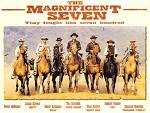
On Oct. 23, 1960 John Sturges' Western The Magnificent Seven (Mirisch Co.) (United Artists) debuts, based on Akira Kurosawa's 1954 film "Seven Samurai" set in a Mexican village, starring Russian-born Yul Brynner as Chris Adams, New York City-born Jewish actor Eli Wallach as bandit leader Calvera, Steve McQueen as Vin, Charles Bronson as Bernardo O'Reilly, Robert Vaughan as Lee, James Coburn as knife-throwing Britt, Brad Dexter as Harry Luck, German-Am. actor Horst Buchholz as Chico, and Rosenda Monteros as Petra; Robert J. Wilke fights Britt in a knife-vs.-gun battle; Chris and Vin charge to the cemetery in a hearse; Russian-born Vladimir Sokoloff plays the wise old man; musical score by Elmer Bernstein; remade in 2016.

On Oct. 24, 1960 John Wayne's The Alamo debuts, produced by his Batjac Productions for $12M, about the 1836 white-is-right Battle of the Alamo, starring Wayne as Col. Davy Crockett, Laurence Harvey as Col. William Travis, Richard Widmark as Jim Bowie, and Frankie Avalon as Smitty, who sings Ballad of the Alamo; the Mexican army has 7K extras; John Ford helps Wayne direct the finale; Wayne's son Michael Wayne is assoc. producer, launching his career; the film is full of historical moose hockey, slanted toward Wayne's right-wing views, trying to compare Gen. Santa Anna to Khrushchev and Hitler; Chill Wills plays Beekeeper, then conducts an embarrassing self-promotion campaign for best actor Oscar, comparing voters to his "Alamo Cousins", to which Groucho Marx replies "I am delighted to be your cousin, but I voted for Sal Mineo" losing the award and costing the film even more; ddoes $7.2M box office on a $12M budget, hitting Wayne's pocketbook hard; "The mission that become a fortress. The fortress that became a shrine."
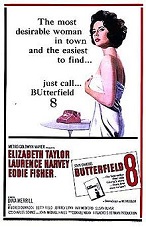
On Nov. 2, 1960 Daniel Mann's BUtterfield 8 (MGM) debuts, based on the dirty parts of John O'Hara's 1935 novel, starring a reluctant Elizabeth Taylor (who didn't want to make the movie, and hops on a plane for London as soon as it wraps to star in "Cleopatra") as glorious wandering New York City ho Gloria Wandrous, who is trying to go straight, along with her hubby Steve Carpenter (Eddie Fisher); she gets an Oscar for it because such a queen could never really be a ho so she's a great actress?; does $10M box office on a $2.8M budget; "The most desirable woman in town and the easiest to find... just call BUtterfield 8".
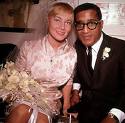
On Nov. 13, 1960 Harlem, N.Y.-born black entertainer Samuel George "Sammy" Davis Jr. (1925-90) (who lost his left eye in an automobile accident on Nov. 19, 1954 in San Bernardino, Calif. during a trip from Las Vegas to Los Angeles, and converted to Judaism after Eddie Cantor introduced him to it in the hospital) shocks white racists sheetless by marrying blonde Swedish actress May Britt (Maybritt Wilkens) (1933-) (star of The Young Lions" with Marlon Brando and "Murder Inc." with Peter Falk), who retires to manufacture mulattoes after converting to Judaism to get married to him; after having one daughter they divorce in 1968 after she catches him hooking up with dancer Lola Falana, and she returns to acting - welcome to the 1960s?



On Nov. 16, 1960 Am. "Rhett Butler in Gone With the Wind" actor Clark Gable (b. 1901) dies in Hollywood, Calif. of a heart attack a few days after the film "The Misfits" wraps; "He was as masculine as any man I've ever known, and as much a little boy as a grown man could be; it was this combination that had such a devastating effect on women" (Doris Day); on Feb. 1, 1961 John Huston's The Misfits (Seven Arts Productions), written by Arthur Miller for his wife Marilyn Monroe debuts on the birthday of dead star Clark Gable (as Gay Langland), who woos Marilyn Monroe (as Roslyn Taber) and tries to catch wild mustangs near Reno along with rodeo rider Montgomery Clift (as Perce Howland) while she pussy-whips them into letting them go so they won't end up as dog food; Eli Wallach plays Guido, and Thelma Ritter plays Isabelle Steers: Gable wears a snap-style Western shirt manufactured in Denver, Colo. by Rockmount Ranch Wear, founded by future centenarian Jack A. Weil (1901-2008), which has been marketing them since the 1950s; they are later worn by Elvis, Bob Dylan, Ronald Reagan, Nicolas Cage et al.; Monroe's drug and pill habit and cheating ways finally cause Miller to divorce her after the filming, and marry Austrian-born photographer Inge Morath (1923-2002) on Feb. 17, 1962. On July 23, 1966 Am. actor Montgomery Clift (b. 1920) dies in New York City of heart failure after uttering his last words: "Absolutely not" when asked if he wants to watch "The Misfits".

On Dec. 1, 1960 Am. "Dream lovers", box office star Sandra Dee (Alexandra Zuck) (1942-2005) and ultracool pop singer Bobby Darin (Walden Robert Cassotto) (1936-73) get very publicly married at the home of music publisher Don Kirshner in Camden, N.J. after meeting on his first film Come September (1961) in Italy and eloping; they have one son, Dodd, in 1961, and divorce in 1967; on Dec. 20, 1973 Darin dies in Los Angeles, Calif. of a heart condition caused by dental work - the cool die young? - Dodd Dee Darin?
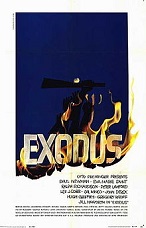
On Dec. 16, 1960 Otto Preminger's Exodus (United Artists) debuts, written by Dalton Trumbo based on the 1958 Leon Uris novel and filmed in Cyprus and Israel, starring Paul Newman, Sal Mineo, Eva Marie Saint, Lee J. Cobb, Gregory Ratoff et al. as heroic good-guy Jews trying to ram their way into British-run Palestine after WWII, while the native Muslims are treated like prejudiced throwbacks who should wake up and become their friends?; costs a phenomenal $4.5M to make, and lasts 220 min., doing $20M worldwide box office, causing comedian Mort Sahl to issue the review "Otto, let my people go"; "I will never divulge the name of a fellow member of the Irgun"; watch trailer.
In 1960 Back Stage (Backstage) weekly mag., ed. by Ira Eaker (1921-2002) and Allen Zwerdling (1922-2009) begins pub. in New York City, becoming a must-read for stage and movie actors looking for work, zooming from 10K to 32K copies/week; in 1994 they found "Back Stage West" for readers in Los Angeles, Calif., reaching 24K copies/week; in 1986 it is acquired by Billboard Pubs.

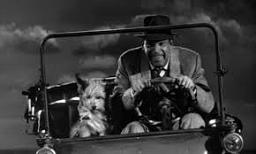
On Mar. 16, 1961 Robert Stevenson's The Absent-Minded Professor (Walt Disney) (B&W) debuts, based on a story by Samuel Woolley Taylor, and Princeton U. chem. prof. Hubert "Dr. Boom" Alyea, starring Fred MacMurray as Prof. Ned Brainard, who invents a gravity-defying goo called Flubber (flying rubber), makes a flying car, and turns white men into black, er, great jumping basketball players; Tommy Kirk plays Biff Hawk; does $25.4M box office; followed by "Son of Flubber" (1963), "Flubber" (1997); gives birth to a neverending retro dream for white Baby Boomers?
On Apr. 17, 1961 the 33rd Academy Awards awards the best picture Oscar for 1960 to United Artists' (Mirisch Co.) The Apartment, along with best dir. to Billy Wilder; Kirk Douglas is snubbed for best actor in Spartacus, which goes to Burt Lancaster for Elmer Gantry; best actress goes to Elizabeth Taylor for Butterfield 8, best supporting actor to Peter Ustinov for Spartacus, and best supporting actress to Shirley Jones for Elmer Gantry; James Stewart accepts an honorary Oscar for terminally-ill (cancer) Gary Cooper.

On June 6, 1961 Sam Peckinpah's Deadly Companions debuts, becoming the feature film debut of dir. David Samuel "Sam" Peckinpah (1925-84), a Western based on the Albert Sidney Fleischman novel, starring Brian Keith as ex-army officer Yellowleg, who accidentally kills the son of Kat Tilden (Maureen O'Hara), and redeems himself by escorting the funeral procession through Injun territory; shows Peckinpah's knack for screen violence.

On Aug. 9, 1961 Robert Mulligan's Come September debuts, starring Rock Hudson, Gina Lollobrigida, Sandra Dee. and Bobby Darin in a romantic comedy about the generation gap; Dee and Darin meet and get married on the set; Bobby Darin sings Multiplication ("Multiplication, that's the game, and each generation plays the same") (if only he knew about Rock sucking Hudson?) and The Come September Theme.


On Sept. 25, 1961 Robert Rossen's The Hustler debuts, starring Paul Newman as Fast Eddie Felsen, and Jackie Gleason as Minnesota Fats in a taste of what it takes to be a top green baize master pool shark; real pool hustler Rudolf Wanderone (Wanderon) Jr. (1913-96) claims the film is based on him, and adopts the nickname.
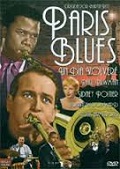
On Sept. 27, 1961 Martin Ritt's Paris Blues (United Artists) debuts, based on the 1957 novel by Harold Flender, starring Paul Newman as jazz trombonist Ram Bowen, and Sidney Poitier as jazz saxophonist Eddie Cook, who romance vacationing Am. tourists Connie Lampson (Diahann Carroll) and Lillian Corning (Joanne Woodward); features appearances by Louis Armstrong (as Wild Man Moore) and jazz pianist Aaron Bridgers.

On Oct. 5, 1961 Blake Edwards' Breakfast at Tiffany's (Paramount Pictures) debuts, based on the 1958 Truman Capote novel, starring introverted doll-like Audrey Hepburn (after Marilyn Monroe turns down the part) as extroverted poverty-stricken Tiffany's window-viewing socialite Holly Golightly, and pretty boy George Peppard as neighbor writer Paul "Fred" Varjak; does $14M box office on a $2.5M budget; features Hepburn singing Moon River by Henry Mancini, which wins the best song Oscar - would have been better in another film?

On Oct. 10, 1961 Elia Kazan's Splendor in the Grass (Oct. 10) (Warner Bros.), written by William Inge (who has a bit part as a Protestant minister, becoming his screen debut); title taken from William Wordsworth's 1807 "Ode: Intimations of Immortality"; the film debut of Warren Beatty (Henry Warren Beaty) (1937) (brother of Shirley MacLaine), who co-stars with Natalie Wood as a 1928 Kansas town's two most good-looking teenie lovers Bud Stamper and Deanie Loomis, who resist their sexual desires until he goes to Yale U. and has sex with some girl, causing Deanie to go insane; film debuts of Sandy Dennis, Marla Adams, and Phyllis Diller; does $4M box office on a ? budget; "Whether you live in a small town the way they do, or in a city, maybe this is happening to you right now. Maybe, if you're older, you remember when suddenly the kissing isn't a kid's game any more, suddenly it's wide-eyed scary and dangerous."

On Oct. 18, 1961 Robert Wise's and Jerome Robbins' West Side Story (United Artists) debuts, a musical based on Shakespeare's "Romeo and Juliet" about the Jets and the Sharks, New York City street gangs who like to break into song and dance; features the love story between Maria (Natalie Wood) (voice by Marni Nixon) and Tony, inactive co-founder of the Jets, who works at Doc's drugstore, played by Richard Beymer (voice by Jimmy Bryant) (after Elvis Presley turns down the part and Tab Hunter, Troy Donahue, Bobby Darin et al. are rejected); also stars Russ Tamblyn as Jets leader Riff, George Chakiris as Sharks leader Bernardo, Maria's older brother, Rita Moreno as Bernardo's girl Anita, Simon Oakland as Police Lt. Schrank, Ned Glass as drugstore owner Doc, and William Bramley as Officer Krupke; the Emeralds lose their turf to the Jets, and the Hawks fail to grab it, leaving the Sharks; does $43.7M box office on a $6M budget; incl. the songs Maria, America, Tonight, One Hand, One Heart, Officer Krupke.

On Nov. 22, 1961 Norman Taurog's musical comedy film Blue Hawaii (Paramount Pictures) debuts, written by Hal Kanter and starring Elvis Presley in his biggest hit movie ($4.2M box office) as ex-GI Chadwick Gates (a stretch?), who disobeys his mother Sarah Lee (Angela Lansbury) to work as a tour guide at the agency of his babe Maile Duval (Joan Blackman); features "Hawaiian Wedding Song" and "Can't Help Falling in Love", plus such jewels as "Song of the Shrimp", "Queenie Wahine's Papaya", and "Do the Clam"; watch trailer.

On Dec. 14, 1961 (in Berlin - Dec. 19 in the U.S.) Stanley Kramer's Judgment at Nuremberg debuts, starring Spencer Tracy as chief justice Dan Haywood, Richard Widmark as the prosecutor Col. Tad Lawson, Maximilian Schell as defense atty. Hans Rolfe, Burt Lancaster as accused Nazi Dr. Ernst Janning, Judy Garland as his suspected lover Irene Hoffman, Marlene Dietrich as German woman Mrs. Bertholt, and Montgomery Clift as Rudolph Petersen (his last Oscar nomination); "Over six million, according to reports from the Nazis' own figures, but the real figures nobody knows" (Widmark).



In 1961 Bombay-born N.Y.U. business student Ismail Merchant (1936-2005) meets U.S.-born James Ivory (1928-) at a New York City coffee shop, and they form a gay film partnership, adding German-born screenwriter Ruth Prawer Jhabvala (1927-) in 1963.
On Apr. 9, 1962 the 34th Academy Awards awards the best picture Oscar for 1961 to United Artists' (Mirisch Pictures, and B&P Enterprises) West Side Story, along with best dir. to Jerome Robbins and Robert Wise, best supporting actor to George Chakiris, and best supporting actress to Rita Moreno; best actor goes to Maximillian Schell for Judgment at Nuremberg, and best actress to Sophia Loren for Two Women.

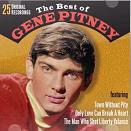
On Apr. 22, 1962 John Ford's The Man Who Shot Liberty Valance (Paramount Pictures) debuts, based on a 1953 short story by Dorothy M. Johnson, becoming the last of John Ford's B&W Westerns (the last great film of the Golden Age of Movies?), starring John Wayne as rancher Tom Doniphon of Shinbone, James Stewart as inept Eastern lawyer Ransom "Ranse" Stoddard, Vera Miles as his babe Hallie, and Lee Marvin as badass outlaw Liberty Valance, who Doniphon shoots and kills from a hidden position to make it look like Stoddard did it, causing him to become a hero and rise to state gov. and U.S. sen.; does $8M box office on a $3.2M budget; the hit Hal David-Burt Bacharach theme song The Man Who Shot Liberty Valance by Gene Pitney (1940-2006) is released after the film comes out; first movie where John Wayne uses the word "pilgrim", which becomes a standard for Wayne impersonators; "This is the West, sir. When the legend becomes a fact, print the legend"; offscreen Ford needles Wayne for not serving in WWII while Stewart was a war hero, with "How rich did you get while Jimmy was risking his life?"; "When Liberty Valance rode to town the womenfolk would hide, they'd hide/ When Liberty Valance walked around the men would step aside/ 'cause the point of a gun was the only law that Liberty understood/ When it came to shootin' straight and fast - he was mighty good/ From out of the East a stranger came, a law book in his hand, a man/ The kind of a man the West would need to tame a troubled land/ 'cause the point of a gun was the only law that Liberty understood/ When it came to shootin' straight and fast - he was mighty good./ Many a man would face his gun and many a man would fall/ The man who shot Liberty Valance, he shot Liberty Valance/ He was the bravest of them all" - gives Lee Harvey Oswald ideas, or LBJ?


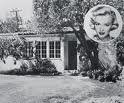
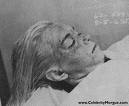

On May 19, 1962 (Sat.) Marilyn Monroe sings a sultry rendition of Happy Birthday, Mister President to her secret lover Pres. Kennedy at a Dem. fundraiser in Madison Square Garden attended by 17K incl. Jack Benny, Maria Callas, Ella Fitzgerald, Jimmy Durante, and Peggy Lee, while wearing a dress described as "skin and beads" by Adlai Stevenson (her last pubic, er, public appearance); the dress by Jean Louis is auctioned for $1.15M by Christie's auction house on Oct. 27, 1999; after hearing that Marilyn would be at the party, Jackie utters the soundbyte "Screw Jack" and refuses to attend; a photo of Marilyn and JFK taking after the song becomes the only one of the two to survive after the Secret Service confiscates all the others but misses this one because it was left in the negatives dryer; it is not pub. until June 1, 2010 - did she hum it for him again in private? On July 28-29, 1962 she is at the Cal-Neva Lodge in Lake Tahoe, owned by her former lover Frank Sinatra and Mafia boss Sam Giancana, where she mopes that Bobby had dumped her and fantasized that he might divorce his wife for her, then threatens to tell all to the press about her flings with him and JFK, and after she gets too drunk, Sinatra cuts her loose and quits protecting her? On Aug. 5, 1962 (Sun.) after telling Peter Lawford "Say goodbye to Pat, to the president, and to yourself, you're such a nice guy", Marilyn Monroe (b. 1926) is found dead in her Brentwood, Calif. deluxe hacienda-style cottage at 12305 Fifth Helena Dr. at the end of a cul-de-sac, with a telephone in one hand and bottle of sleeping pills in the other, according to AP; her pshrink Ralph Greenson finds her dead; neighbors allegedly reported seeing an ambulance in front of her cottage the evening before, along with a heli hovering overhead and loud voices and breaking glass inside; others allegedly hear a hysterical woman in the early a.m. screaming "Murderers, you murderers, are you satisfied now that she's dead?"; Bobby Kennedy visited her that night, and she told him that she had been "passed around like a piece of meat", and he smothered her with a pillow to stop her screams?; an ambulance took her away breathing and brought her back dead?; she spent her last night alive at Frank Sinatra's lodge with Mafia boss Sam Giancana after being picked up and dropped off by hair stylist George Masters?; a plastic yellow duck floated in her pool, beside which hung antique wind chimes donated by Carl Sandburg; Allan Abbot and Ron Hast, the two morticians who prepare her for burial find hairy legs, false teeth, and purple blotches all over her face; a few weeks earlier 20th Cent. Fox studio boss Peter G. Levathes fired her from Something's Got to Give (a remake of the 1940 film "My Favorite Wife", co-starring Dean Martin after Gardner McCay turns down the part); after she was fired from the film, Aristotle Onassis offered her the use of his yacht Christina for R&R; she wills 75% of her estate to her acting coach Lee Strasberg, and 35% to her pshrink Marianne Kris, which is contested by her business mgr. Inez Melson due to her being under their "undue influence"; "Over the Rainbow" was played at her funeral; she was buried in Westwood Village Memorial Park Cemetery in W Los Angeles, after which ex-hubby Joe DiMaggio sent a half-dozen red roses to her crypt three times a week for 20 years and never remarried; she is buried in Corridor of Memories #24, a pink marble crypt, which Hugh Hefner owns the rights to the crypt next to; after an autopsy by Los Angeles deputy coroner (1961-7) Thomas T. Noguchi (1927-) (who became chief coroner in 1967-82, and performed autopsies on RFK and Sharon Tate, becoming known as "Coroner to the Stars"), her death is ruled a probable suicide from an OD of sleeping pills because a concentration of Nembutal (Pentobarbital) equal to 90+ pills was found in her blood, although no pills are found in her stomach and no drinking glass in her room; in 1972 Veronica Hamel buys her Brentwood cottage, and finds sophisticating bugging equipment in every room, probably installed by the FBI, which costs her $100K to remove. Was it really a mob hit ordered by JFK for threatening to rat about their love affair by publishing her diary, which is never found? Or was it caused by her doctor prescribing a chloral hydrate suppository thinking she had been weaned off Nembutal and not knowing that another doctor had refilled her prescription? Her cottage is purchased in 1994 by film dir. Michael Ritchie for $995K. "Sex is part of nature, and I go along with nature"; "A professional amateur" (Laurence Olivier); "Directing her was like directing Lassie" (Otto Preminger); "Anyone can remember lines, but it takes a real artist to come on the set and not know her lines and give the performance she did" (Billy Wilder); "Yes, there was something special about me, and I knew what it was. I was the kind of girl they found dead in a hall bedroom with an empty bottle of sleeping pills in her hand" (Marilyn) - the good die young?
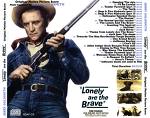
On May 24, 1962 David Miller's Western Lonely Are the Brave (Universal Pictures) debuts, written by Dalton Trumbo based on the 1956 Edward Abbey novel "The Brave Cowboy", starring Kirk Douglas (his favorite movie) as cowboy John W. "Jack" Burns, who arranges to get locked up in jail to escape with old friend Paul Bondi (Michael Kane), who doesn't want to escape, so Burns goes it alone on his horse Whisky while being chased by Sheriff Morey Johnson (Walter Mattthau); Gena Rowlands plays Bondi's wife Jerry.

On June 12, 1962 Stanley Kubrick's Lolita debuts, based on the 1955 Vladimir Nabokov novel, starring James Mason as Prof. Humbert Humbert, Shelly Winters as aging boarding room owner Charlotte Haze, and Sue Lyon (1946-) as her 14-y.-o. sex bombshell daughter Dolores Haze AKA Lolita, whom he hooks up with; Manhattan-born Kubrick stays permanently in England after filming it.


On June 19, 1962 Morton DaCosta's The Music Man debuts, based on the 1957 Meredith Willson play, starring Newton, Mass.-born Robert Preston (Robert Preston Meservey) (1918-87) as Prof. Harold Hill, who tries to sell River City, Iowa on a marching band as an antidote to gateway-to-hell pool halls, and cancels plans to run with the money after falling for librarian Shirley Jones; the ultimate fantasy about the Great White Am. Heartland; does $15M box office; songs incl. Seventy-Six Trombones, Till There Was You, Ya Got Trouble, Rock Island, and Goodnight, My Someone.

On June 20, 1962 Sam Peckinpah's Ride the High Country (Guns in the Afternoon) (MGM) debuts, starring Joel McCrea as Gil Westrum, an ex-lawman hired to transport gold through dangerous territory, only to find that out his partner Gil Westrum (Randolph Scott) is going to doublecross him.

On July 3, 1962 John Frankenheimer's Birdman of Alcatraz (United Artists) debuts, based on the 1955 book by Thomas E. Gaddis, starring Burt Lancaster as lifer IQ-134 ornithologist Robert Franklin Stroud (1890-1963), who is portrayed as an unjustly imprisoned mild-mannered scientist crushed by the cruelty of anti-scientific wardens like Harvey Shoemaker (Karl Malden) even though he killed two men, is not exactly mild mannered, and is a pedophile?; he had been kept in Alcatraz (prisoner #594) in 1942-59, when his failing health caused him to be moved to a federal prison hospital in Mo.; petitions are handed out in the theater lobbies for his release, and atty. Richard M. English takes up his cause, approaching the Kennedy admin., but he dies next Nov. 21 (one day before the assassination of JFK) in the Medical Center for Federal Prisoners in Springfield, Mo. still petting his files in priz and studying French.
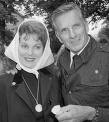
On July 4, 1962 "Tripoli" dir. Will Price (b. 1913), the alcoholic ex-hubby (1941-53) of Maureen O'Hara (1920-) dies in McComb, Miss., with O'Hara telling her stand-in Lucille House (1910-2008), "This is the happiest day of my life"; in 1968 she marries USAF brig. gen. Charles F. Blair Jr. (1909-78), known for making the first nonstop solo flight over the polar region in 1951.

On July 28, 1962 Arthur Penn's The Miracle Worker debuts, starring Anna Marie "Patty" Duke (1946-) as Hellen Keller, and Anne Bancroft as Anne Sullivan, who teaches her how to pump water and talk sign language.

On Sept. 25, 1962 Ken Annakin's, Andrew Marton's, and Bernhard Wicki's The Longest Day (20th Cent. Fox) debuts, based on the 1959 book by Cornelius Ryan is the first big budget all-star Hollywood WWII flick (in B&W), telling the story of the June 6, 1944 D-Day Normandy landings using 48 internat. stars incl. John Wayne (who beats Charlton Heston for the role, then makes Darryl Zanuck pay him $250K instead of $25K like everybody else to punish him for criticizing his film "The Alamo"), Henry Fonda, Robert Mitchum, Richard Burton, and Red Buttons, 3 dirs., and 2 years in production; written by Bernhard Wicki; its success rescues 20th Cent.-Fox Studios from looming bankruptcy after the Cleopatra fiasco; after Dwight D. Eisenhower tries to get the part of playing himself but is too old, it is given to lookalike set decorator Henry Grace (1907-83), becoming his only acting credit; Sean Connery's last film before being cast as James Bond 007, with his future nemeses Gert Frobe (Auric Goldfinger) and Karl Stromberg (Curt Jurgens) appearing in the same flick; does $50.1M box office on a $7.75M budget.

On Oct. 24, 1962 John Frankenheimer's The Manchurian Candidate (B&W) debuts, written by Frankenheimer and George Axelrod based on the 1959 Richard Condon novel set in 1952, starring Frank Sinatra as Maj. Bennett "Ben" Marco, Laurence Harvey as Medal of Honor winner Raymond Shaw, Angela Lansbury as his Commie agent mother Mrs. Iselin, James Gregory as her Commie agent hubby U.S. Sen. John "Johnny" Iselin ("there are exactly 207, er, 104, er, 275 card-carrying members of the Communist Party in the State Dept."), and Janet Leigh as Sinatra's babe Eugenie "Rosie" Rose (Eldorado 5-9970) in an eerie mix of the Korean War, the McCarthy years, brainwashing theory, and the JFK assassination, which hasn't occurred yet, pissing-off both leftist and rightist critics while pleasing conspiracy theorists; Oswald got the idea to assassinate JFK from it?; somebody else did?; Khigh Dhiegh plays Commie pshrink Yen Lo, Henry Silva plays Korean double agent Chunjin, John McGiver plays Sen. Thomas Jordan, Leslie Parrish plays his daughter Jocie; establishes TV dir. Frankenheimer as a film dir.; the Queen of Diamonds sets off Raymond Shaw's assassin programming mode; "Raymond Shaw is the bravest, kindest, warmest, most wonderful human being I've ever known in my life"; "Raymond Shaw, hell, hell" (ending); refilmed in 2004.
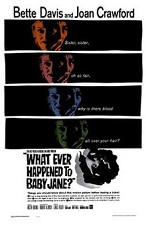
On Oct. 31, 1962 Robert Aldrich's B&W What Ever Happened to Baby Jane? (Seven Arts Productions) (Warner Bros. Pictures) debuts, based on the 1960 Henry Farrell novel, starring Bette Davis as former child star Baby Jane Hudson, who is now a scary old hag, and Joan Crawford as her cripped sister Blanche, who go through a terrific set of increasingly scary games culminating with a turnabout as Jane has to confront what she did to her long ago, becoming one of the best movies of the decade, and launching the psycho-biddy (hag horror) (hagsploitation) (Grand Dame Guignol) subgenre; film debut of Victor Charles Buono (1938-82); does $9.5M box office on a $1M budget; watch trailer; view clip; view clip; view clip.

On Nov. 21, 1962 Robert Wise's B&W Two for the Seesaw (United Artists) debuts, based on the 1958 William Gibson play stars Robert Mitchum as Jerry Ryan, an atty. from Neb. who separates from his wife and moves to a shabby New York City apt., meeting Gittel Mosca (Shirley MacLaine), a struggling dancer, and falling in luv; originally written for Paul Newman and Elizabeth Taylor, who split for "The Hustler" and "Cleopatra"; Wise's first film since "West Side Story" (1961); "It just didn't figure that they would... that they could... that they did"; on Apr. 11, 2011 MacLaine reveals on Oprah that she and Mitchum began a relationship during filming that lasted until his death; music by Andre Previn, featuring Second Chance; view trailer.

On Dec. 10, 1962 David Lean's Lawrence of Arabia (Columbia Pictures) (Horizon Pictures) debuts, making a star of Irish-born actor Peter Seamus Lorcan O'Toole (1932-) in his first major film as British soldier T.E. Lawrence going Arab during WWI, along with supporting actors Alec Guinness, Anthony Quinn, and Egyptian actor Omar Sharif (Arab. "noble") (Michel Demitri Chalhoub) (1932-2015) (first English language role), culminating in the capture of Damascus after Turkish pasha Jose Ferrer admires O'Toole's peter, er, tool, er, lovely white skin; written by Robert Bolt (1924-95), and Michael Wilson, who is on the Hollywood blacklist and doesn't get his screen credit restored until 1995; the 216-min. flick has no credited speaking roles for women; King Hussein I of Jordan offers David Lean camel-riders of his desert patrol as extras; NYT film critic Bosley Crowther (a big opponent of the Hollywood Blacklist) pans the movie, calling it a "thundering camel-opera that tends to run down rather badly as it rolls on into its third hour and gets involved with sullen disillusion and political deceit"; does $70M box office on a $15M budget; "There’s nothing further here for a warrior. We drive bargains. Old men’s work. Young men make wars, and the virtues of war are the virtues of young men. Courage and hope for the future. Then old men make the peace. And the vices of peace are the vices of old men. Mistrust and caution. It must be so." (Alec Guiness as King Faisal)


On Dec. 25, 1962 Robert Mulligan's To Kill a Mockingbird (Universal Pictures) debuts, by screenwriter Horton Foote based on the 1960 Harper Lee novel, taking on Southern racial prejudice in 1930s Ala. with a perfect performance by Gregory Peck as lawyer Atticus Finch, along with a boosting performance by Robert Selden Duvall (1931-) (a descendant of Confed. Gen. Robert E. Lee, who is roommates with Dustin Hoffman and Gene Hackman) as man-child Boo Radley; 10-y.-o. Mary Badham (1952-) (sister of film dir. John Badham, who retires from films in 1966) plays Peck's daughter Scout, whose innocence is almost destroyed; Phillip Alford (1948-) plays Scout's brother Jem; Brock Peters (1927-2005) plays coveralls-wearing black chifferobe mover Tom Robinson, who is framed for rape by white trash girl Mayella Violet Ewell, played by Collin Wilcox (Wilcox-Paxton) (1935-2009), whose white trash daddy Robert E. Lee "Bob" Ewell, played by James Anderson (1921-69) (AKA Kyle James), immortalizes Southern white racists; toothy John Megna (1952-95), brother of Connie Stevens plays Charles Baker "Dill" Harris, based on Harper Lee's childhood friend Truman Capote; odd-looking James Richard Hale (1892-1981) plays mean old man Nathan Radley; does $13.1M box office on a $2M budget; softens up the Baby Boom generation to support the U.S. civil rights movement?

On Feb. 20, 1963 John Ford's and Henry Hathaway's and George E. Marshall's How the West Was Won (Cinerama Releasing Corp.) (MGM) (164 min.) debuts, written by James R. Webb and John Gay, about three generations of a New England farm family heading West starting in 1839 thru 1889 incl. the Erie Canal, U.S. Civil War, frontier Colo., and transcontinental railroad, and finishing with aerial shots of freeways in modern L.A., featuring an impressive cast list, incl. John Wayne (as Gen. William Tecumseh Sherman), James Stewart, Henry Fonda, Gregory Peck, Debbie Reynolds, Walter Brennan, Robert Preston, Eli Wallach, and George Peppard; "This land has a name today, and is marked on maps, but the names and the marks and the maps all had to be won, won from Nature and from primitive man"; "24 great stars in the mightiest adventure ever filmed!"; does $50M box office on a $14.48M budget.
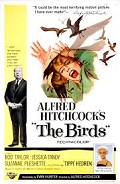
On Mar. 28, 1963 Alfred Hitchcock's The Birds (Universal Pictures) debuts, his first film with Universal Studios, and longest gap between films since "Psycho" 1960), based on the 1952 Daphne Du Maurier short story with screenplay by novelist Evan Hunter AKA Ed McBain, and no score other than screeching birds, starring Rod Taylor and Tippi Hedren (film debut) as Bodega Bay, Calif. losers Mitch Brenner and Melanie Daniels, who can't get along with fowls; there is no "The End" because Hitchcock wants to give an impression of unending terror, or does he want to leave it open for a sequel?; does $11.4M box office on a $3.3M budget; watch trailer; view clip.
On Apr. 8, 1963 the 35th Academy Awards awards the best picture Oscar for 1962 to Columbia's (Horizon Pictures) Lawrence of Arabia, along with best dir. to David Lean; best actor goes to Gregory Peck for To Kill a Mockingbird, best actress to Anne Bancroft for The Miracle Worker, best supporting actor to Ed Begley for Sweet Bird of Youth, and best supporting actress to Patty Duke for The Miracle Worker.
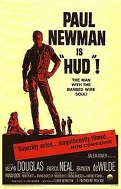
On May 29, 1963 Martin Ritt's B&W Hud (Paramount Pictures) debuts, filmed on location in the Tex. Panhandle incl. Claude, Tex., starring Paul Newman as alienated youth Hud Bannon, Melvyn Douglas as his stern daddy Homer Bannon, and Patricia Neal as neighbor Alma Brown, whom he assaults; does $10M box office on a $2.35M budget; "The man with the barbed wire soul"; "I always say the law was meant to be interpreted in a lenient manner."

On June 4, 1963 Jerry Lewis' The Nutty Professor (Paramount Pictures) debuts, a parody of Robert Louis Stevenson's "Strange Case of Dr. Jekyll and Mr. Hyde" stars Jerry Lewis as nerdy chemistry prof. Julius Kelp of A.S. Univ., who transforms into woman-killing Dean Martin clone Buddy Love after drinking a love potion, and romances Stella Stevens; Lewis later admits, er, denies that he's parodying his former buddy Martin; does $19M box office on a ? budget.
On June 5, 1963 Billy Wilder's Irma La Douce (Mirsch Corp.) (United Artists) debuts based on the 1956 French musical, starring Jack Lemmon as honest gendarme Nestor Patou, and Shirley MacLaine as the sweet hooker with the heart of gold that he tries to save by posing as a rich patron who buys her exclusive favors, until he pretends to kill him so he can have her, only to be charged with murder; she lived with real hos to learn the part?; does $25.2M box office U.S. on a $5M budget (5th highest grossing film of 1963); remade in 1990 as "Pretty Woman" starring Richard Gere and Julia Roberts.

On June 12, 1963 Joseph L. Mankiewicz's Cleopatra debuts, becoming an extravagant $44M, 2-year semi-flop (break-even) (most expensive film to date), based on "The Life and Times of Cleopatra" by C.M. Franzero, not Shakespeare (can't be proven in court); foul-mouthed glam babe Elizabeth Taylor becomes the first female actor to earn $1M for a film; Rex Harrison (first choice: Peter Finch) is the only decent lead actor, attempting to portray Julius Caesar, but coming off as Prof. Henry Higgins in armor?; Harrison's chicken legs are covered with togas and robes; Martin Landau plays Caesar's and Anthony's friend Rufio; Roddy McDowall plays Octavian; Carroll O'Connor plays Casca, the first to stab Caesar in the back; chicken-legged unathletic Richard Burton (who replaces athletic Stephen Boyd when production moves to Italy) bombs as he-man Mark Antony, but starts a torrid public affair with Liz, who dumps Eddie Fisher for him, marrying him nine days after the divorce with Fisher is final in 1964; Cesare Danova plays Cleopatra's head slave Apollodorus; Hume Cronyn plays Cleopatra's minister Sosigenes; six hours of film are created for two separate 3-hour movies (a Caesar movie and an Antony movie), but after 20th Cent. Fox nearly goes bankrupt, new studio head Darryl Zanuck orders it cut down for theaters to four hours, cutting most of the Harrison footage in favor of the celeb love affair of Liz and Burton, pissing-off Mankiewicz for life; during filming Taylor becomes seriously ill and needs an emergency tracheotomy, then two weeks later shows up at the Academy Awards sporting a pair of crutches and a visible scar on her throat; production begins in London but moves to Italy when the $5M mark is reached; the scenes in Rome are delayed for weeks because of heavy rains; several Euro heads of state visit the set; no amount of advertising saves it, but it later makes money with TV rights and home versions; does $26M box office on a $44M budget, becoming the first highest-grossing film of the year to run at a loss (until ?); it later makes $57.7M total; "This picture was conceived in a state of emergency, shot in confusion, and wound up in blind panic" (Joseph L. Mankiewicz); "The toughest three pictures I ever made" (ditto); "I only came to see the asp" (Charles Addams).

On June 19, 1963 Leslie H. Martinson's PT 109 debuts, based on the 1961 book by Robert J. Donovan, starring Clifford Parker "Cliff" Robertson III (1923-2011) as JFK, who has a personal 9/11 on Aug. 2, 1943; 5 mo. later JFK's coconut gets knocked off again?; he is later assigned PT 59; does $3.5M box office on a $4M budget.

On July 4, 1963 John Sturges' The Great Escape (United Artists) debuts, based on the 1950 book by been-there-for-real Paul Brickhill (1916-91) about the Mar. 1944 Stalug Luft III Great Escape of 76 Allied POWs in WWII stars a ton of stars incl. Steve McQueen ("Cooler King") (who does his own motorcycle stunts, becoming a superstar), James Garner ("Scrounger"), Charles Bronson ("Tunnel King"), Donald Pleasance ("Forger"), James Coburn ("Manufacturer"), and Richard Attenborough ("Big X"); NYT film critic Bosley Crowther pans it, becoming another nail in his coffin as he proves to be too old-fashioned for the new gen. of Hollywood flicks?
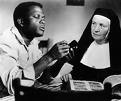
On July 5, 1963 Ralph Nelson's Lilies of the Field debuts, based on the William E. Barrett novel about some fillies, er, a charming inspirational movie starring Sidney Poitier as black construction foreman Homer Smith, who stops at a remote Western desert farm to get his car fixed and ends up building a "shapel" for some German Catholic nuns, led by Mother Maria (Lilia Skala); incl. the song Amen; the black-white sexual undertones make the whole situation a classic, although Poitier is forever constrained by Hollywood to be an asexual "good Negro" who always helps white people? - Hollywood original Barack Obama?

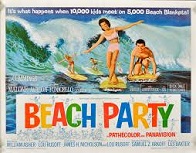
On July 14, 1963 William Asher's Beach Party (Am Internat. Pictures) debuts, staring teen pop idols Frankie Avalon (1939-) and Annette Funicello (1942-2013) as corny moral Roman Catholic Italian-Am. (but you're not supposed to notice) heteros playing with fire on the beaches of S Calif., while square Robert Cummings, er, Cummings plays a scientist studying teenage mating habits; Beach Boy Brian Wilson appears as an extra; although the other girls wear bikinis, Funicello wears a modest 1-piece swimsuit, but later loosens up to a bikini reaching to her navel; does $2.3M box office on a $300K budget; spawns six beach party sequels, incl. "Muscle Beach Party" (1964), "Bikini Beach" (1964), "Pajama Party" (1964), "Bikini Blanket Bingo" (1965), "How to Stuff a Wild Bikini" (1965), and "The Ghost in the Invisible Bikini (1966), finally becoming irrelevant when the real beachgoers get into heavy sex, drugs and rock & roll, along with VD, ODs and radicalism, while counting themselves lucky for not having been wasted in Vietnam?

On Nov. 7, 1963 Stanley Kramer's It's a Mad, Mad, Mad, Mad World debuts, starring a list of notables ("Everybody who's ever been funny is in it") incl. Sid Caesar, Milton Berle, Ethel Merman (1908-84), Jonathan Winters, Jimmy Durante, Buddy Hackett, Mickey Rooney, Phil Silvers, Dick Shawn, Edie Adams, Dorothy Provine, Buster Keaton, Terry Thomas, Moe Howard, Larry Fine, Joe DeRita, Jim Backus, William Demarest, Peter Falk, Leo Gorcey, Edward Everett Horton, Joe E. Brown, Carl Reiner, ZaSu Pitts, Eddie Anderson, Jack Benny, and Jerry Lewis seeking $350K in stolen money buried in a Calif. park by Smiler Grogan, who gave them the details of how he hid it below a giant "W" in Santa Rosita just before dying; Spencer Tracy plays police Capt. C.G. Culpepper.


On Dec. 19, 1963 Blake Edwards' The Pink Panther debuts, written by Blake Edwards and Maurice Richlin, making a star of English actor Richard Henry "Peter" Sellers (1925-80) as bumbling French inspector Jacques Clouseau, who tracks jewel thief the Phantom (not Pink Panther) AKA Sir Charles Lytton (David Niven), whose nephew George (Robert Wagner) is also trying to steal the jewel without knowing about his uncle, while trying to bed Simone; Capucine plays wife Simone Clouseau, who is secretly hooking up with Charles; Claudia Cardinale plays the jewel's owner Princess Dala (pet poodle Amber), who gets drunk on champagne on a tiger rug and seduces the audience while she is being dejeweled; Jacques ends up getting framed as the Phantom, and likes it since it makes him a sex idol and hero; spawns five sequels: A Shot in the Dark (1964) (co-starring Elke Sommer as Maria Gambrelli), Inspector Clouseau (1968) (without Sellers), The Return of the Pink Panther (?), The Pink Panther Strikes Again (1976), Revenge of the Pink Panther (1978), Trail of the Pink Panther (1982), Curse of the Pink Panther (1983), and Son of the Pink Panther (1993); remade in 2006 starring Steve Martin.
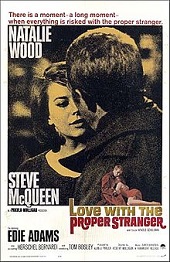
On Dec. 25, 1963 Robert Mulligan's B&W Love with the Proper Stranger (Paramount Pictures) debuts, starring Natalie Wood as Macy's clerk Angie Rossini, who has an affair with musician Rocky Papasano (Steve McQueen), and ends up pregnant, but after almost having a backroom abortion refuses to marry him because it wouldn't be with "bells and banjos", allowing cook Anthony (Tom Bosley in his film debut) to woo her until Rocky waits for her outside Macy's with you know what; moves Wood into the realm of adult roles after years of playing teenies and innocents; the title song by Elmer Bernstein and Johnny Mercer and sung by Jack Jones becomes a hit.
In 1965 Charles Keating's Perversion for Profit stars popular Los Angeles reporter George Putnam preaching against porno and homosexuality while chronicling it like a time capsule, becoming a cult hit.



On Jan. 29, 1964 Stanley Kubrick's Dr. Strangelove, Or, How I Learned to Stop Worrying and Love the Bomb (B&W) debuts, written by Lee Pfeiffer, Peter Sellers, Stanley Kubrick, and Terry Southern, based on the 1958 novel "Red Alert" by Peter George, and filmed in Shepperton Studios in England about the nuclear end of the world, starring Peter Sellers as U.S. Pres. Merkin Muffley, British Group Capt. Lionel Mandrake, and Muffley's advisor, the crypto-Nazi title char. (a caricature of Edward Teller, John von Neumann, Wernher von Braun, or Herman Kahn?), complete with pocket radioactivity calculator and a black glove borrowed from Kubrick; Sterling Hayden (coming out of retirement) plays crazed U.S. Brig. Gen. Jack D. Ripper, who worries about losing his vital juices and his "purity of essence"; George C. Scott plays gum-chewing war hawk U.S. Gen. Buck Turgidson (based on Curtis LeMay), who utters the soundbyte "Mr. President, I'm not saying we wouldn't get our hair mussed, but I do say no more than 10 to 20 million killed, tops"; the film debut of James Earl Jones (1931-) (coming with Scott from "Othello") as Lt. Lothar Zogg; Keenan Wynn plays Col. Bat Guano; after Sellers sprains his ankle in a cockpit mockup, retired rodeo prof. Slim Pickens (Louis Burton Lindley Jr.) (1919-83) (brother of Easy Pickens) is called in from the set of "One-Eyed Jacks" and plays Texas cowboy Maj. T.J. King Kong, the B-52 pilot who rides a phallic nuke from the bomb bay of a B-52 Stratofortress to hot dog glory in Russia; a final scene of a pie fight in the war room is cut; "A fellow can have a pretty good time in Vegas with all that stuff" (Kong); "Mein Fuhrer, I can walk!" (Dr. Strangelove); "The Hot-Line Suspense Comedy"; brings in $9.4M on a $1.8M budget.
On Mar. 15, 1964 (the Ides of March?) Welsh actor Richard Burton (1925-84) marries British superstar actress Elizabeth Taylor (1932-2011) in Montreal, Canada nine days after she divorces Am. singer Eddie Fisher (1928-2010), who in 1959 left Am. actress Debbie Reynolds (1932-2016) for her; it is her 5th marriage and his 2nd; the massive publicity boosts both of their careers.
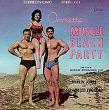
On Mar. 25, 1964 William Asher's Muscle Beach Party (Am. Internat. Pictures) debuts, starring Frankie, Annette, and foot-long muscleman "Rock Stevens" (Peter Lupus) as the sequel to "Beach Party", #2 of 7 Am. Internat. party flicks; features Dick Dale and The Del-Tones; the last screen appearance of Peter Lorre, and the screen debut of "Little" Stevie Wonder, who appears again in "Bikini Beach" (1964).
On Apr. 13, 1964 the 36th Academy Awards awards the best picture Oscar for 1963 to United Artists' (Lopert Pictures, Woodfall Productions) Tom Jones, along with best dir. to Tony Richardson; Sidney Poitier (1927-) becomes the first black to win a best actor Oscar for Lilies of the Field; best actress goes to Patricia Neal for Hud, best supporting actor to Melvyn Douglas for Hud, and best supporting actress to Margaret Rutherford for The V.I.P.'s.
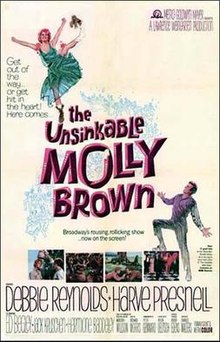
On June 11, 1964 Charles Walters' The Unsinkable Molly Brown (MGM) debuts, written by Helen Deutsch based on the 1960 Meredith Willson and Richard Morris musical, starring Debbie Reynolds (after Shirley MacLaine pulls out) as Molly Brown, and Harve Presnell as her wealthy hubby Johnny Brown; exteriors are filmed in the Black Canyon of the Gunnison Nat. Park in Colo.; does $11M box office.

On June 24, 1964 Gordon Douglas' Robin and the 7 Hoods debuts, set in 1930s Chicago, starring the Rat Pack (Frank Sinatra, Dean Martin, Sammy Davis Jr.); introduces the song My Kind of Town, written by Jimmy Van Heusen and Sammy Cahn.
On July 7, 1964 Donald Siegel's The Killers debuts, a remake of the 1946 Burt Lancaster debut film based on an Ernest Hemingway short story, starring Lee Marvin and Angie Dickinson, becoming Ronald Reagan's last film.

On Aug. 5, 1964 after an unhappy 3.5-year marriage (1953-7) to builder Martin May, actress Anne Bancroft (Anna Maria Louisa Italiano) (1932-2005) marries comedian Mel Brooks (Melvin Kaminsky) (1926-), whom she met in 1961 while rehearsing the musical number Married I Can Always Get for the Perry Como TV show, and a voice from offstage calls, "I'm Mel Brooks"; the next day she tells her psych: "Let's speed this process up. I've met the right man. See, I'd never had so much pleasure being with another human being. I wanted him to enjoy me, too. It was that simple."

On Aug. 6, 1964 John Huston's The Night of the Iguana (MGM) debuts, based on the 1961 Tennessee Williams play, starring Richard Burton (after James Garner turns it down as "too Tennessee Williams for me") as Pleasant Valley, Va. Episcopal Rev. Dr. T. Lawrence Shannon, who is defrocked for hanky-panky with a "very young Sunday school teacher" and ends up as a tour guide for seedy Blake's Tours on the Mexican coast, Ava Gardner as widowed beach hotel owner Maxine Faulk, and Deborah Kerr as wandering artiste Hannah Jelkes; Susan Lyon plays underage Baptist Lolita Charlotte Goodall, who tries to seduce Burton, getting him accused of seducing her by shrewish "butch" bus leader Miss Judith Fellowes (Grayson Hall); Liz Taylor attends the set in Puerto Vallarta, causing mucho gossip, with Allan Sherman in Mar. 1964 performing "The Streets of Laredo" with new lyrics: makes Puerto Vallarta popular with tourists; does $12M box office on a $3M budget (#10 highest-grossing film of 1964); "They were down there to film The Night of the Iguana/ With a star-studded cast and a technical crew./ They did things at night midst the flora and fauna/ That no self-respecting iguana would do."

On Aug. 27, 1964 Robert Stevenson's Mary Poppins debuts, based on the P.L. Travers books, a Disney musical about a magical English nanny (Julie Andrews) who takes care of the Banks children, and features Dick Van Dyke as Bert the chimney sweep, who dances with animated penguins, and Ed Wynn as Uncle Albert; Andrews got the role after being passed over by Jack Warner for Eliza Dolittle in "My Fair Lady"; the film becomes Disney's #1 moneymaker (until ?); Supercalifragilisticexpialidocious, A Spoonful of Sugar, and Chim Chim Cheree.
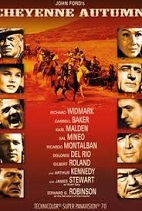
On Oct. 3, 1964 John Ford's Cheyenne Autumn (Warner Bros.) (Ford's 101st film of 102, and last Western) debuts, based on the 1941 Howard Fast novel "The Last Frontier" based on a true story by Mari Sandoz about 300 Cheyennes migrating from Okla. to Wyo. in 1878-9, a rare Ford Western sans Wayne, starring Richard Widmark as Capt. Thomas Archer, James Stewart as Wyatt Earp, Carroll Baker as pacifist Quaker schoolteacher (Archer's babe) Deborah Wright, Edward G. Robinson as U.S. interior secy. Carl Schurz, and Sal Mineo as Red Shirt; does $3.5M box office on a $4M budget.

On Oct. 7, 1964 Sidney Lumet's Fail-Safe (Columbia Pictures) debuts, based on the 1962 Eugene Burdick and John Harvey Wheeler novel showing the U.S.-Soviet Doomsday scenario with Henry Fonda as a U.S. pres. resigned to nuking New York City to pay for mistakenly nuking Moscow after a computer glitch; Larry Hagman plays his translator Buck; Walter Maathau plays maverick war hawk Prof. Groeteschele, based on Herman Kahn; Ed Binns plays bomber leader Col. Jack Grady, who completes his mission despite all enemy tricks (he thinks); Frank Overton plays Gen. Bogan, and Fritz Weaver plays Col. Cascio, who cracks under the pressure; Dan O'Herlihy plays Brig. Gen. Warren A. "Blackie" Black, who has a dream of a torreador before and after nuking his own country at the president's orders; too bad, "Dr. Strangelove", produced by the same studio was released first, numbing its shock value.

On Oct. 20, 1964 Sergio Leone's A Fistful of Dollars (Per un Pungo di Dollari) (United Artists) (a remake of Akira Kurosawa's 1961 "Yojimbo") debuts, launching the made-in-Spain Spaghetti Western genre where the good guy is no longer good, and makes a star of San Francisco, Calif.-born Clinton "Clint" Eastwood Jr. (1930-), who plays the cheeroot-chomping "Man with No Name", dealing death with his never-failing guns and doing that patented thing with his face and eyes that says steely rage as he plays the Baxters off against the Rojos in San Miguel with the help of coffin maker Piripero (Joseph Egger) and saloonkeeper Salvanito (Jose Calvo); Charles Bronson turned down Eastwood's part; does $14.5M box office on a $225K budget; the wistful rockish Fistful of Dollars Theme by Italian composer Ennio Morricone (1928-) is influenced by the guitar style of Dick Dale, and scores the sequels, incl. For a Few Dollars More (1965), The Good, the Bad, and the Ugly (GBE) (1966), comprising the Dollars Trilogy, and Once Upon a Time in the West (1968); the Ecstasy of Gold track from GBE is later used in Modelo beer commercials.

On Oct. 21, 1964 George Cukor's My Fair Lady (Warner Bros.) debuts, starring Audrey Hepburn (after Julie Andrews is passed over despite her success in the state version) as Eliza Doolittle, and Rex Harrison as Prof. Henry Higgins in the Lerner-Loewe musical version of G.B. Shaw's "Pygmalion" (1913); Marni Nixon's voice is dubbed for Hepburn's; Leslie Howard played Higgins in the 1938 film; does $72M box office on the record (for a musical) $17M budget; watch trailer; view clip.
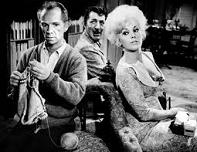
On Dec. 22, 1964 Billy Wilder's Kiss Me, Stupid (Lopert Pictures) debuts, written by Wilder and I.A.L. Diamond based on the play "The Dazzling Hour" by Anna Bonacci, starring Ray Walston (after Jack Lemmon has too many commitments, and Peter Sellers suffers 13 heart attacks) as piano teacher Orville J. Spooner, who gets lucky when pop singer Dino (Dean Martin) has a car breakdown in his town of Climax, Nev. (really Twentynine Palms, Calif.), and hopes to interest him in his songs by getting Belly Button waitress and ho Polly the Pistol (Kim Novak, after Marilyn Monroe dies and Jayne Mansfield gets pregnant) to pose as his wife and have sex with him, only to have him end up doing it with his real wife Zelda (Felicia Farr); features songs by George Gershwin incl. "Sophia", "I'm a Poached Egg", and "All the Livelong Day"; too bad, the Catholic Legion of Decency bans the film (first since "Baby Doll" in 1956).

On Dec. 24, 1964 R.G. Springsteen's Taggart (Universal) debuts, starring Tony Young as Kent Taggart, who is unjustly accused of murder, becoming the film debut of Hollywood, Calif.-born David (John Arthur) Carradine (1936-2009) (son of actor John Carradine) as Cal Dodge.

On Mar. 2, 1965 Robert Wise's The Sound of Music debuts at the Rivoli Theater, New York, starring Julie Andrews as Maria, and Christopher Plummer as Capt. Georg von Trapp in a jazzed-up Rodgers and Hammerstein's musical version of the story of the Trapp Family Singers, becoming a giant hit and making Andrews an instant superstar; "The happiest sound in all the world"; Gil Stuart plays Nazi sympathizer Franz the Butler; it incl. the songs The Sound of Music, Edelweiss, My Favorite Things, Climb Ev'ry Mountain, Do-Re-Mi; too bad, Julie Andrews is passed over for the best actress Oscar in favor of Julie Christie.
On Apr. 5, 1965 the 37th Academy Awards awards the best picture Oscar for 1964 to Warner Bros.' My Fair Lady, along with best actor to Rex Harrison and best dir. to George Cukor; best actress goes to Julie Andrews for supercalifragilisticexpialidocious Mary Poppins (beating Audrey Hepburn in My Fair Lady), best supporting actor to Peter Ustinov for Topkapi, and best supporting actress to Lila Kedrova for Zorba the Greek (Anthony Quinn is snubbed for best actor because he doesn't look white enough and is considered best supporting actor material?).
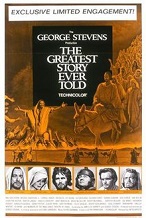
On Apr. 9, 1965 George Stevens' The Greatest Story Ever Told (United Artists) deubts, based on the 1949 Fulton Oursler novel, using an all-star cast to portray the Gospel story, with Max von Sydow playing a Viking Jesus, and Charlton Heston playing John the Baptist as if he were Moses?; Dorothy McGuire plays Virgin Mary, Claude Rains (final film role) plays King Herod, Telly Savalas plays Pontius Pilate, Martin Landau plays Caiaphas, David McCallum plays Judas Iscariot, Roddy McDowall plays Matthew, Joanna Dunham plays Mary Magdalene, Joseph Schildkraut plays Nicodemus, and Donald Pleasence plays Satan (Dark Hermit); 550 Navajos hired as Roman legionnaires go home for a tribal election, causing ROTC cadets to replace them; does $15.5M box office on a $20M budget; watch trailer; view clip; view clip.

On Apr. 20, 1965 Sidney Lumet's The Pawnbroker (Am. Internat. Pictures) debuts, based on the 1961 Edward Lewis Wallant novel, starring Rod Steiger as Jewish you know what Sol Nazerman losing his faith in man after the Holocaust; features a black woman exposing her breasts, challenging the 1934 Production Code.
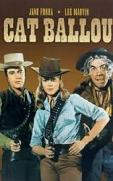
On May 7, 1965 Elliot Silverstein's Cat Ballou (Columbia Pictures) debuts, starring Lee Marvin (after Kirk Douglas turns it down) as gunfighter twins Kid Shelleen and Tim Strawn, Jane Fonda (after Ann-Margret's mgr. turns it down without her knowledge) as Catherine "Cat" Ballou, John Marley as her father Frankie Ballou, Michael Callan as cattle rustler Clay Boone, Dwayne Hickman as his uncle Jed, Nat King Cole (who dies of lung cancer 4 mo. before release) as Shouter, and Bruce Cabot as Sheriff Maledon; former vaudeville blackface Sheriff Cardigan actor Jay C. Flippen has a leg amputated after being scraped by a car door, complicated by diabetes; does $20.7M box office on a ? office.

On June 23, 1965 Vincente Minnelli's The Sandpiper (MGM) debuts, starring Elizabeth Taylor as Laura Reynolds, an unwed mother in Big Sur, Calif., who seduces Episcopalian priest Dr. Edward Hewitt (Richard Burton); a promo documentary The Big Sur is also released.
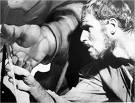

On Oct. 7, 1965 Sir Carol Reed's The Agony and the Ecstasy debuts, based on the 1961 Irving Stone novel, starring Charlton Heston as Michelangelo (1475-1564), and Rex Harrison as Pope Julius II (1487-1555), who makes him paint the Sistine Chapel.
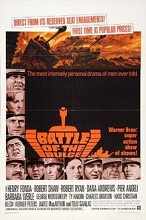
On Dec. 16, 1965 Ken Annakin's Battle of the Bulge (Warner Bros.) debuts, starring Henry Fonda as Lt. Col. Daniel Kiley, Robert Shaw as Panzer Col. Martin Hessler (based on SS Col. Jochen Peiper), Robert Ryan as Gen. Grey, Dana Andrews as Col. Pritchard, George Montgomery as Sgt. Duquesne, and Ty Hardin as Nazi fake U.S. Lt. Schumacher in a depiction of the Dec. 26, 1944 Battle of Celles; too bad, it has so many historical innacuracies despite the technical adviser being Battle of the Bulge veteran cmdr. German Col. Meinrad von Lauchert (incl. using U.S. M47 Patton tanks as German King Tiger tanks) that former Pres. Eisenhower comes out of retirement to slam it in a press conference, causing it to flop; does $4.5M box office on a $6.5M budget.
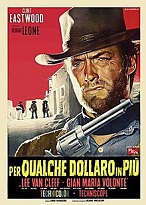
On Dec. 30, 1965 Sergio Leone's For a Few Dollars More ("Per qualche dollaro in piu") (United Artists) debuts, #2 in the Dollars Trilogy, starring Clint Eastwood ("the Man with No Name"), Lee Van Cleef ("the Man in Black), Gian Maria Volonte ("El Indio") (known for smoking weed and playing his musical pocketwatch when he wants to kill somebody), and Klaus Kinski; does $15M on a $600K budget; "Where life had no value, death, sometimes, had its price. That is why the bounty killers appeared".


In 1965 3-y.-o. Hollywood resident Alicia Christian "Jodie" Foster (1962-) begins her acting career as a toddler in a boat in Coppertone TV commercials, with her mom as her mgr.; sorry, she's not a butt-exposing Coppertone girl.
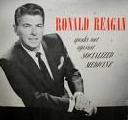
On Jan. 4, 1966 former "Bedtime for Bonzo" B-movie actor and "Death Valley Days" host Ronald Wilson Reagan (1911-2004) (who supported Barry Goldwater in 1964) announces his candidacy for Repub. gov. of Calif., promising to "clean up the mess in" Bonzo, er, "Berkeley"; his press secy. is Calif.-born journalist Franklyn C. "Lyn" Nofziger (1924-2006); on Jan. 9 he appears on Meet the Press and is asked why he has not disavowed the John Bonzo, er, Birch Society, replying that a committee had looked into the group and found Bonzo, er, "nothing of a subversive nature".

On Jan. 16, 1966 Daniel Mann's Our Man Flint debuts, a James Bond 007 spoof starring James Coburn as secret agent Derek Flint, and Lee J. Cobb as his chief Cramden; the sequel is In Like Flint (1967), dir. by Gordon Douglas.
On Apr. 18, 1966 the 38th Academy Awards in Los Angeles (the first to be broadcast in color), hosted by Bob Hope awards the best picture Oscar for 1965 to 20th Century-Fox's (Argyle Enterprises) The Sound of Music, along with best dir. to Robert Wise; best actor goes to Lee Marvin for playing good/bad twins Kid Shelleen and Tim Strawn in Cat Ballou, best actress to Julie Christie for Darling, best supporting actor to Martin Balsam for A Thousand Clowns, and best supporting actress to Shelley Winters for A Patch of Blue.

On May 25, 1966 Norman Jewison's The Russians Are Coming, the Russians Are Coming debuts, based on the 1961 Nathaniel Benchley novel about a Soviet sub running aground off New England, causing the villagers to get riled up, starring "The Banana Boat Song" co-composer Alan Wolf Arkin (1934-) as Lt. Rozanov, Brian Keith as police chief Link Mattocks, and Carl Reiner and Eva Marie Saint as Walt and Elspeth Whittaker.

On May 31, 1966 Fielder Cook's A Big Hand for the Little Lady (Big Deal at Dodge City) debuts, based on the TV play "Big Deal in Laredo" by Sidney Carroll, starring Joanne Woodward and Henry Fonda as married travellers Mary and Meredith, who happen into a high-stakes poker game in Sam's Saloon in 1880s Laredo, Tex., and get in over their heads, causing them to go to local banker C.P. Ballinger (Paul Ford) to back them with their hand as their only collateral, winning a fortune, after which it is revealed they're all in cahoots and are all prof. gamblers, even their little kid Jackie (Jean-Michel Michenaud), and the doctor Joseph "Doc" Scully (Burgess Meredith), who deals the final hand; Ballinger turns out to be Mary's beau.

On June 15, 1966 Bruce Brown's The Endless Summer debuts, starring Mike Hynson and Robert August as surfers going around the world to chase the summer, incl. Australia, New Zealand, Tahiti, Hawaii, Senegal, Ghana, Nigeria, and South Africa; cool surf rock soundtrack by The Sandals; does $5M U.S. and $20M worldwide box office on a $50K budget, causing the surf-and-travel craze, popularizing surfing in Calif. and Australia and sparking a series of surf movies; followed by the sequels "The Endless Summer II" (1994), showing the shortboard in use, and "The Endless Summer Revisited" (2000); view clip from The Endless Summer; view trailer of The Endless Summer II.

On June 21, 1966 John Guillermin's The Blue Max debuts, based on the 1964 novel by John D. Hunter, starring George Peppard as German WWI Lt. Bruno Stachel, who tries to win the Blue Max with 20 kills; also stars James Mason as Gen. Count von Klugermann, and Ursula Andress as Countess Kaeti von Klugermann.


On June 21, 1966 Mike Nichols' B&W black comedy Who's Afraid of Virginia Woolf? (Warner Bros.) debuts, based on the 1962 Edward Albee play about burned-out prof. George and his foul-mouthed wife Martha, becoming Richard Burton's and Elizabeth Taylor's best film together?; one of the first films dealt with by Jack Valenti as pres. of the MPAA, who decides to censor the word "screw" but keep the phrase "hump the hostess"; does $40M box office on a $7.5M budget; Liz proves she can act, but plays an overweight unglamorous foul-mouthed alcoholic to do it, and her next seven films bomb because she is overexposed? - released in the 666 year, they become more scary?

On July 17, 1966 singer-actor Frank Sinatra (1915-98) marries actress Mia Farrow (1945-) (daughter of Australian-born "Around the World in Eighty Days" dir. John Farrow and actress Maureen O'Sullivan), who later has Satan's baby in the movies in order to revive her screen hubby's career; they divorce in 1968 after the movie comes out - and really got married on June 6 and had the devil baby for real, and it has blue eyes and red hair and a great singing voice?

On Aug. 3, 1966 Sydney Pollack's This Property is Condemned debuts, based on the 1946 play by Tennessee Williams, co-written by Francis Ford Coppola, Fred Coe, and Edith Sommer, and set in Depression era Dodson, Miss. (filmed in Bay St. Louis, Miss.); stars Charles Robert Redford Jr. (1936-) as Owen Legate, who hooks up with town flirt Alva Starr (Natalie Wood); after release, Wood has a nervous breakdown, causing her to turn down the Faye Dunaway role in "Bonnie and Clyde" to be with her pshrink; Redford goes on to star in five of Pollack's first 11 films.

On Aug. 24, 1966 Richard O. Fleischer's Fantastic Voyage debuts, written by Harry Kleiner about a medical crew incl. Stephen Boyd and Raquel Welch, who are shrunk to microscopic size and injected into the bloodstream of a comatose diplomat to save him; remade in 2000; Welch becomes the last star to be created under the studio system.

On Sept. 18, 1966 John Huston's The Bible: In the Beginning debuts, 174 boring min. of 22 chapters of extravagantly-produced Genesis stories starring who-cares Michael Parks as Adam, who-cares Ulla Bergryd as Eve, well-cast Richard Harris as Cain, Stephen Boyd as Nimrod, George C. Scott as Abraham, Ava Gardner as Sarah, and Peter O'Toole as the Three Angels; one bright point, atheist Huston's great voiceovers as Noah, the Serpent, and God rule?

On Oct. 20, 1966 the 10th Annual San Francisco Film Festival begins; fading sex symbol ("the Working Man's Monroe") Jayne Mansfield (Vera Jayne Palmer) (1933-67) gets a free plane ticket to attend, and shows up in a hot pink dress with side vents sans bra and panties, pissing-off the Masonic Auditorium gen. mgr. David M. Sacks; former lion tamer Anton LaVey makes her the high priestess of his Church of Satan, but she ridicules his church and he pronounces her death within a year; actually it was her beau Sam Brody whom he cursed, but he visits her at her Pink Palace in Los Angeles in June 1967 two weeks before her death - more 666 vibes as his prediction comes true? She forgot all about the library like she told her own man now? On June 29, 1967 Bryne Mawr, Penn.-born "blonde bombshell" (platinum bleached blond) (signature color: pink) Jayne Mansfield (b. 1933) is killed in a 1966 Buick Electra 255 in Slidell, La. along with driver Ronnie Harrison and atty. Sam Brody en route to New Orleans, La. from Bixoxi, Miss. after it plows into a tractor-trailer and ploughs under it, nearly decapitating her, after which the Nat. Highway Traffic Safety Admin. begins mandating "Mansfield bars" on tractor-trailers; her children Miklos, Zoltan, and Mariska survive the crash sleeping in the back seat; her dog doesn't.

On Oct. 16, 1966 Henry Livings (1929-98) debuts his play Eh? in Circle in the Square Downtown, New York, starring Dustin Lee Hoffman (1937-) as Valentine Brose, who is spotted by Mike Nichols, launching his film career; filmed in 1967 as "Work is a Four-Letter Word" starring David Warner.

On Oct. 19, 1966 Billy Wilder's The Fortune Cookie debuts, about a crooked lawyer (oxymoron?) getting his brother-in-law to fake a serious injury, becoming the first of several Jack Lemmon-Walter Matthau comedies.

On Nov. 2, 1966 Woody Allen's What's Up, Tiger Lily? debuts, taking the Japanese film "International Secret Police: Key of Keys" and overdubbing it with a silly soundtrack, becoming the dir. debut of Woody Allen (Allan Stewart Konigsberg) (1935-).

On Nov. 24, 1966 Don Chaffey's One Million Years B.C. debuts, based on the 1940 Hal Roach flick, starring John Richardson as Tumak, and impossibly-proportioned sex bomb Raquel Welch (Tejada) (1940-) as Loana, who likes to wear a fur bikini to show she has killer looks, and delivers only 1 line, "Me Loana, you Tumak", making her an instant star; "Discover a savage world whose only law was lust" - clever way to get around 666 by putting the million-year grandfather clause before the B.C. part?

On Dec. 15, 1966 (9:30 a.m.) Am. family entertainment king Walt Disney (b. 1901) (big cigarette smoker) dies in Burbank, Calif. of lung cancer; he was nominated for 59 Oscars, winning 222 plus four honorary ones, incl. a record four in one year, more awards and nominations than anybody in history (until ?): "All our dreams can come true, if we have the courage to pursue them."

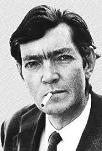
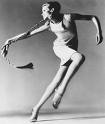
On Dec. 18, 1966 Michelangelo Antonioni's Blow-Up (Blowup) (MGM), based on the 1959 story "The Droolings of the Devil" by Argentine novelist Julio Cortazar (Cortázar) (1914-84), about mod London photographer David Royston Bailey (1938-) and featuring a score by Herbie Hancock stars Vanessa Redgrave as fashion model Jane, and David Hemmings as Thomas, a photographer who takes photos of a couple in Marylon Park in Charlton, SE London, and then does you know what to it to prove it's evidence of murder, raising the issue of photography as voyeurism; does $20M box office on a $1.8M budget, helping to "liberate Hollywood from its puritanical prurience" (Richard Corliss) after the film's success causes the MPAA Production Code to be revised; features a performance of Stroll On by the Yardbirds (after Eric Burdon turns it down and The Who are dropped), and a 5-min. photoshoot of leggy German Ford Modeling Agency supermodel Veruschka von Lehndorff (1939-) - how many paid for a ticket thinking they were going to see a beejay?
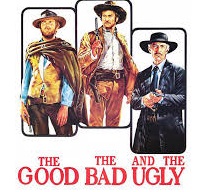
On Dec. 23, 1966 Sergio Leone's The Good, the Bad and the Ugly (Il Buono, il Brutto, il Cattivo) (cattivo means bad and brutto ugly) debuts, #3 in the made-in-Spain Dollars Trilogy, starring Clint Eastwood as the Man with No Name (Good), Elich Wallach as bandito Tuco Benedicto Pacifico Juan Maria Ramirez (who calls Eastwood "Blondie") (Ugly), and Eli Wallach as the Man in Black (whom Tuco calls "Angel Eyes") (Bad) (Bad and Ugly are mixed-up in the English vers. because the English title has the words reversed), who get in a struggle to find some stolen Confed. gold in a cemetery in a grave in Sad Hill marked Unknown next to Arch Stanton's, passing through Betterville POW Camp (based on Andersonville); the ensemble of Italian actors who play Union and Confed. soldiers and U.S. and Mexican citizens plus 1.5K Spanish militia members in a Spanish setting gives the whole movie an eerie unreality, adding to the effect of the futility of the U.S. Civil War; "the best-directed film of all time" (Quentin Tarantino); does $25.1M box office on a $1.2M budget; banned in Norway until 1982; Ennio Morricone's Theme from The Good, the Bad, and the Ugly is a hit; Leone, who is lax on safety at the set tops himself when Wallach drinks from a bottle of acid left accidentally next to his soda bottle by a studio technician, after which his horse runs away with him for a mi., and then he is almost decapitated by an iron step on a railroad car; the bridge that is blown up onscreen is first blown up by accident and has to be rebuilt.
On Apr. 10, 1967 the 39th Academy Awards awards the best picture Oscar for 1966 to Columbia's (Highland Films) A Man for All Seasons, along with best actor to Paul Scofield, and best dir. to Fred Zinnemann; best actress and best supporting actress go to Elizabeth Taylor and Sandy Dennis for Who's Afraid of Virginia Woolf? (Richard Burton is snubbed for best actor, because when it comes to Liz he ain't acting?), and best supporting actor goes to Walter Matthau for The Fortune Cookie.
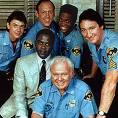
On Aug. 2, 1967 Norman Jewison's In the Heat of the Night debuts, based on the 1965 John Ball novel, starring Sidney Poitier as black Philly homicide detective Virgil Tibbs, who tries to get respect from white Southern crackers in Sparta, Miss., especially police chief Bill Gillespie (Rod Steiger) (a Jewish Am. actor playing a racist WASP like only they can?); spawns two sequels, They Call me Mister Tibbs (1970) and The Organization (1971); the biggest joke is that Norman Jewison isn't a Jewish American but a Protestant Canadian?


On Aug. 13, 1967 Arthur Penn's Bonnie and Clyde debuts, set in 1930s Okla. and written by David Newman and Robert Benton, starring producer Warren Beatty (Henry Warren Beaty) (1937-) (brother of Shirley MacLaine) and Dorothy Faye Dunaway (1941-) as bank robbers Clyde Barrow (1909-34) and Bonnie Parker (1910-34), making Dunaway a dun-deal run-away star while upclassing gangster movies from trashy to art house and making all movies more violent; Bonnie lovingly strokes Clyde's gun, breaking the 1934 Hollywood Production Code; studio head Jack Warner tries in vain to get production blocked because he hates it, after which he retires in 1969; NYT film critic (since 1940) Bosley Crowther (1905-81) trashes it, causing it to be pulled from circulation until Time and Newsweek pub. two rave reviews and it's released again and becomes a hit, after which he is replaced in 1968 by Stefan Kanfer, whose first article reverses Crowther's, launching the era of New Hollywood (Am. New Wave), with a new generation of young filmmakers coming to prominence, producing films incl. "The Graduate" and "Easy Rider", with a new gen. of younger more amoral film critics and film school-educated dirs. all into "Radical Chic", which makes the outlaws into the good guys; "They're young... they're in love... and they kill people"; #4 grossing film of 1967 ($50.7M U.S. and $70M worldwide box office on a $2.5M budget); watch trailer.
On Oct. 23, 1967 The Cannon Group Inc. is founded to produce low-budget films, going bankrupt in 1993 after releasing 12 films with the word "American" in their title.

On Oct. 25, 1967 Joshua Logan's Camelot (Warner Bros. - Seven Arts) (179 min., cut down to 150) debuts, based on the 1960 Alan Jay Lerner and Frederick Loewe musical, starring Richard Harris as King Arthur, Vanessa Redgrave as Guinevere, and Italian hunk actor Franco Nero as Lancelot, who hooks up with her on the set, resulting in son Carlo Nero in 1969; they finally get married in 2007; meanwhile fading Warner Bros. Studio head Jack Warner tries in vain to keep Richard Burton and Julie Andrews in the leading roles, and is proven right after the film flops; JFK admirers later apply the Camelot myth to the entire JFK era after Jackie Kennedy reveals to Life mag. that JFK loves the line: "Not might makes right, but might for right"; "Don't let it be forgot/ That once there was a spot/For one brief shining moment/that was known as Camelot"; does $31M box office on a $13M budget; watch trailer.
On Oct. 26, 1967 Terence Young's Wait Until Dark (Warner Bros.) debuts,, based on the 1966 play by Frederick Knott stars Audrey Hepburn as blind Suzy Hendrix, who is terrorized by three thugs (Alan Arkin, Richard Crenna, and Efrem Zimbalist Jr.) searching for a doll stuffed with heroin in her apt.; does $17.5M box office on a $3M budget.

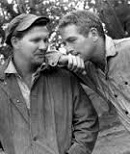
On Nov. 1, 1967 Stuart Rosenberg's Cool Hand Luke (Warner Bros.) debuts, based on the 1965 chain gang novel by Donn Pearce, featuring blue-eyed 50-hard-boiled-eggs-eating ever-smirking Paul Leonard Newman (1925-2008) in the title role, George Harris Kennedy Jr. (1925-2016) as his chain gang leader buddy Dragline, and Strother Martin as the oppressive warden, with the memorable soundbyte: "What we have here is a failure to communicate"; Pearce has a cameo as a convict named Sailor; "I'm shakin' the bush, boss"; "I got my mind right, boss"; "Sometimes nothing can be a real cool hand" (Newman).


On Nov. 13, 1967 after being labelld a Vietnam hawk, Repub. Mrs. Shirley Jane Temple Black (1928-) (child film star Shirley Temple), who claims that there is too much sex in 1960s films loses a bid for election to the Calif. 10th Congressional District to fellow Repub. (Korean War vet) Paul Norton "Pete" McCloskey Jr. (1927-), who runs as a dove, and who loses the Repub. pres. nomination to Richard Nixon in 1972, but stays in office until 1983, then switches to the Dem. Party in 2007.


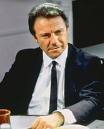
On Nov. 15, 1967 Martin Scorsese's Who's That Knocking at My Door (original title "I Call First") debuts, becoming the dir. debut of Martin Charles Scorsese (1942-), and the acting debut of fellow NYU film school student Harvey Keitel (1939-) as J.R., a Roman Catholic Italian-Am. who has an affair with Zina Bethune in New York City, and wants to keep her a virgin until marriage until he discovers she has been raped.
1967 - A good year for dolls in Hollyweird films? On Nov. 16, 1967 Mark Robson's Valley of the Dolls (20th Cent. Fox) debuts, based on the 1966 Jacqueline Susann novel, starring Patty Duke, Barbara Parkins, and Sharon Tate as Hollyweird starlets Neely O'Hara, Anne Welles, and Jennifer North, who get into sex, alcohol and barbituate pills (dolls); the Valley of the Dolls Theme Song by Dionne Warwick becomes a hit. Terence Young's Wait Until Dark (Oct. 26) (Warner Bros.), based on the 1966 play by Frederick Knott stars Audrey Hepburn as blind Suzy Hendrix, who is terrorized by three thugs (Alan Arkin, Richard Crenna, and Efrem Zimbalist Jr.) searching for a doll stuffed with heroin in her apt.; does $17.5M box office on a $3M budget.

On Dec. 12, 1967 Stanley Kramer's Guess Who's Coming to Dinner debuts, starring Katharine Hepburn and Spencer Tracy (his last film appearance) as Matt and Christina Drayton, the white parents of Joey Drayton (Katharine Houghton) (Hepburn's real-life niece), who brings black buck John Prentice (Sidney Poitier) home; Hepburn never watches the movie; Tracy dies 10 days after the film's completion; dir. Stanley Kramer gets labelled as the "message filmmaker" whose films are oversimplifed and maudlin? - showing white America its inevitable future?

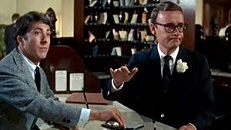
On Dec. 22, 1967 Mike Nichols' The Graduate debuts, based on the 1963 Charles Webb novel, making a star of Nichols and struggling actor Dustin Lee Hoffman (1937-), who plays Benjamin Braddock, a shy college boy who gets seduced by Mrs. Robinson (Anne Bancroft) (after Doris Day turns the part down because of the sex scenes) while pursuing her daughter Elaine (Katharine Ross), uttering the soundbyte "Mrs. Robinson, you're trying to seduce me, aren't you?"; the catchword for the era, "The future, my boy, is in plastics" comes from the film, and red convertible Alfa-Romeos get a huge plug; screenplay is by Buck Henry (Henry Zuckerman) (1930-2020), who plays a desk clerk; does $104.9M in North Am. on a $3M budget; the title song Mrs. Robinson by Simon and Garfunkel is inspired by Eleanor Roosevelt; #2 grossing film of 1967 ($104.3M).

On Dec. 21, 1967 Theodore J. Flicker's The President's Analyst debuts, starring super-white-toothed James Coburn as Dr. Sidney Schaefer, who runs from his job at the White House and ends up being chased by the FBR (Walter Burke), the CEA (Godfrey Cambridge) and the Russkies (Severn Darden), finally finding out that his true enemy is TPC (The Phone Co.); Jill Banner plays his patient-babe Snow White.
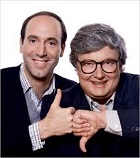
In 1967 Urbana, Ill.-born film critic Roger Joseph Ebert (1942-2013) becomes reviewing films for the Chicago Sun-Times, going on to receive the 1975 Pulitzer Prize for Criticism, and hook up in 1975 with Eugene Kal "Gene" Siskel (1946-99), hosting the weekly TV show Sneak Previews on WTTW-TV Chicago, which is syndicated by PBS.

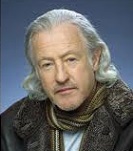
In 1967 Helmdale Film Corp. is founded in London, England by actor David Edward Leslie Hemmings (1941-2003) (who sells-out in 1971) and his mgr. John Daly (1937-2008) as a tax haven for British actors, going on to found a talent agency that launches the careers of Black Sabbath and Yes, distributes cable TV to hotels, and finances the stage production of "Grease" (1971) and "The Rumble in the Jungle" Ali-Foreman boxing match (Oct. 30, 1974), relocating to Hollywood in 1980 and producing genre films starting with ""Cattle Annie and Little Britches" (1981), "Strange Behavior" (1981), "Yellowbeard" (1983), "Escape from the Bronx" (1983), "Treasure of the Yankee Zephyr" (1984), "A Breed Apart" (1984), "Irreconcilable Differences" (1984), "The Terminator" (1984), "Special Effects" (1984), "Perfect Strangers" (1984), "The Falcon and the Snowman" (1985), "A Killing Affair" (1986), "The Return of the Living Dead" 91985), "Howling II" (1986), "At Close Range" (1986), "Salvador" (1986), "Inside Out" (1986), "Hoosiers" (1986), "Body Slam" (198), "Defense of the Realm" (1986), "Platoon" (1986), "River's Edge" (1987), "Made in U.S.A." (1987), "My Little Girl" (1987), "Burke & Wills" (1987), "The Whistle Blower" (1987), "High Tide" (1987), "Love at Stake" (1987), "Hotel Colonial" (1987), "Best Seller" (1987), "The Last Emperor" (1988), "Little Nemo" (1992) et al., changing their name in 1993 to Hemdale Communications, and concluding with "Grizzly Mountain" (1995).


In 1967 New Line Cinema (New Line Film Productions Inc.) is founded in Los Angeles, Calif. by Robert Kenneth "Bob" Shaye (1939-) to distribute foreign and art films to U.S. college campuses; in 1976 it releases its first full-length film "Stunts", dir. by Mark Lester; in 1984 it releases "A Nightmare on Elm Street", becoming a big hit and launching a successful series, making the studio into "the House that Freddy Built"; in 1994 it is acquired by Turner Broadcasting System, then Time Warner in 1996, merging with Warner Bros. 2008.


On Feb. 8, 1968 Franklin J. Schaffner's Planet of the Apes (20th Cent. Fox) debuts, co-written by Rod Serling based on the 1963 novel by Pierre Boulle, starring Charlton Heston as human astronaut George Taylor, who crash-lands on future Earth in 2673 C.E. and meets talking apes, incl. good chimps Cornelius (Roddy McDowall) and Zira (Kim Hunter), and bad baboon Dr. Zaius (Maurice Evans), finally escaping with mute human babe Nova (Linda Harrison) and encountering the half-buried Statue of Liberty; the apes represent whites, and the humans blacks, and modern whites are supposed to see the light and lose their racist attitudes?; does $33.4M box office on a $5.8M budget.
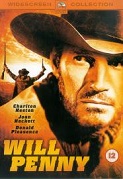
On Feb. 16, 1968 Tom Gries' Will Penny (Paramount Pictures) debuts, starring Charlton Heston as an aging loner bad penny cowboy who gets hooked by love-hungry Catherine Allen (Joan Hackett) while fighting off the Quint family led by Preacher Quint (Donald Pleasence); a box office flop, although Heston considers it his best work?; also features Ben Johnson, Lee Majors, Bruce Dern, Slim Pickens, and Anthony Zerbe; does $1.8M box office on a $1.4M budget.
On Apr. 10, 1968 the 40th Academy Awards awards the best picture Oscar for 1967 to United Artists's (Mirisch Corp.) In the Heat of the Night, along with best actor to Rod Steiger, and best dir. to Mike Nichols; best actress goes to Katharine Hepburn for Guess Who's Coming to Dinner, best supporting actor to George Kennedy for Cool Hand Luke, and best supporting actress to Estelle Parsons for Bonnie and Clyde.

On May 2, 1968 Gene Saks' The Odd Couple debuts, based on the Neil Simon play, starring Jack Lemmon as Felix Ungar, and Walter Matthau as Oscar Madison; #3 grossing film of 1968 ($44.5M).

On May 28, 1968 Gordon Douglas' The Detective debuts, based on the 1968 novel by Roderick Thorp, starring Frank Sinatra as detective Joe Leland, and is the producing debut of New York-born Jew Robert Evans (1930-), the first actor to run a studio, who goes on to become production head of Paramount in 1966-74, bringing it from #9 largest to #1 with giant hits incl. "Barefoot in the Park", "The Odd Couple", "True Grit", "Rosemary's Baby", "The Great Gatsby", and "The Godfather", while living like Croesus and going through seven increasingly glamorous wives, starting with #3 Ali MacGraw next year (1969-72).


Hollyweird cashes in on Millennium Fever bigtime? On June 12, 1968 Roman Polanski's Rosemary's Baby (June 12 = 6, 6+6) (Paramount) debuts, based on the 1967 Ira Levin novel and Goethe's "Faust", becoming the first U.S. film for Polish dir. Roman Polanski (Rajmund Roman Thierry Polanski) (Liebling) (1933-); stars Mia Farrow as Rosemary Woodhouse, mother of baby 666, John Cassavetes as her Faustian actor hubby Guy Woodhouse, Sidney Blackmer and Ruth Gordon as their warlock-witch neighbors Roman Castevet (really Steven Marcato, son of warlock Adrian Marcato) and Minnie Castevet, Charles Grodin as Dr. Hill, Ralph Bellamy as Dr. Abraham Sapirstein, and Tony Curtis as the voice of actor Donald Baumgart, who is blinded so that Guy can get his big break to seal the deal; the film debut of Charles Grodin (1935-); does $33.4M box office on a $3.2M budget; Vidal Sassoon does Farrow's hair for $5K; filmed in the Dakota Apts. in New York City's Upper West Side on W 72nd St. and Central Park West (later made famous by John Lennon and Yoko Ono, who rent the Woodhouse apt.) and called the "Black Bramford"; "He has his father's eyes"; "Satan is his father, not Guy. He came up from Hell and begat a son of mortal woman. Satan is his father and his name is Adrian. He shall overthrow the mighty and lay waste their temples. He shall redeem the despised and wreak vengeance in the name of the burned and the tortured. Hail, Adrian! Hail, Satan!"; "God is dead! Satan lives! The year is One! The year is one! God is dead!"; the name Adrian comes from the Latin "man from Hadria", a town in N Italy that gave us 2nd cent. C.E. Roman emperor Hadrian, but could be Hades?; part of a trilogy by Polanski on the horrors of apt.-dwelling incl. "Repulsion" (1965), and "The Tenant" (1976); "Look What's Happened to Rosemary's Baby" (1976) is made for TV; "Son of Rosemary" is written in 1997, and filmed in ?

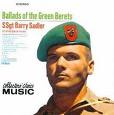
On June 19, 1968 John Wayne's The Green Berets (Batjac Productions), based on the 1965 Robin Moore novel stars Wayne as a you know what, and David Janssen as a skeptical journalist who follows him around and comes to realize that the Vietnam War is good; the only major Hollywood film to support the war?; shocks Wayne worshipper Phil Ochs, and spawns the hit song Ballad of the Green Berets by Green Beret SSgt. Barry Allen Sadler (1940-89); watch trailer - if they were only fighting Apaches instead?

On June 19, 1968 Norman Jewison's The Thomas Crown Affair (United Artists) debuts, written by Alan R. Trustman, starring ever-cool Steve McQueen as a wealthy sharp-dressing bank robber, later inspiring New York Knicks coach Isiah Thomas to dress up; Faye Dunaway is his insurance investigator opponent, who falls for him; does $14M box office on a $4.3M budget; features the song The Windmills of Your Mind by Michel Legrand, performed by Noel Harrison (#8 in the U.K.), which wins the best song Oscar; remade in 1999.

On Aug. 3, 1968 Ted Post's Hang 'Em High (United Artists) debuts, starring Clint Eastwood (the first production of his new Malpaso Co., named after a creek near his home of Carmel, Calif.) as ex-lawman Jed Cooper, who is wrongly lynched in 1889 Okla. Territory, then becomes a U.S. marshal and goes after the nine lynchers led by Capt. Wilson (Ed Begley), incl. Stone (Alan Hale Jr.), Charlie Blackfoot (Ned Romero), and weasly Miller (the real killer) (Bruce Dern); Inger Stevens plays widow Rachel Warren, who helps him, and Pat Hingle plays Eastwood's new boss, hanging judge Adam Fenton (based on Hanging Judge Isaac Parker of Ft. Smith, Ark.); Dennis Hopper plays the Prophet; a scene between Stevens and Eastwood where he kisses her and she doesn't seem to be turned on, then explains that she was raped by white men has an eerie meaning in the light of the fact that she secretly goes for black er, guys and ends up committing suicide?; does $6.8M box office on a $1.6M budget; watch trailer.


On Sept. 19, 1968 William Wyler's Funny Girl debuts, written by non-Jewish writer Isobel Lennart based on her 1964 play, starring super singer Barbara (Barbara Joan) "Babs" Streisand (1942-) in her film debut as Jewish comedian Fannie Brice, and Omar Sharif as gambler hubby Nick Arnstein, making Streisand a star; features the song People by Bob Merrill (1921-98); #1 grossing film of 1968 ($58.5M).

On Sept. 23, 1968 Ralph Nelson's Charly debuts, based on "Flowers for Algernon" by Daniel Keyes, starring Cliff Retarded Man, er, Cliff Robertson as retarded Charly Gordon, who wakes up a genius, only to go dumb again when it hurts the most.

On Oct. 1, 1968 George A. Romero's Night of the Living Dead (Walter Reade Org.) debuts at Fulton Theater in dreary Pittsburgh, Penn., a horror movie set in rural W Penn. that's so bad it's great, starring Duane Jones and Judith O'Dea as humans Ben and Barbra, who hole-up in a farmhouse fighting hordes of zombies brought back to life by radiation; #6 grossing film of 1968 ($12M U.S. and $18M worldwide box office on a $114K budget); spawns sequels "Dawn of the Dead" (1979), "Day of the Dead" (1985).
On Oct. 7, 1968 the Motion Picture Assoc. of America adopts its Film Rating System, designed by former LBJ advisor Jack Valenti, ranging from "G" for "general" audiences to "X" for adult patrons only; as of Nov. 1 theater owners beginning bar children under 17 from X-rated films, and from R-rated films unless accompanied by a parent or guardian; too bad, the industry polices itself, and money becomes the main motivation for ratings?

On Oct. 9, 1968 Francis Ford Coppola's Finian's Rainbow (Oct. 9) (Warner Bros. - Seven Arts) debuts, based on the 1947 E.Y. Harburg-Fred Saidy musical, starring Fred Astaire as Finian McLonergan, Petula Clark as his daughter Sharon McLonergan, who abscond from Ireland with a pot of gold hidden in a carpetbag and head to Rainbow Valley in Missitucky near Fort Knox, while pissed-off Og the Leprechaun (Tommy Steele) pursues him; Barbara Hancock plays Susan the Silent; Keenan Wynn plays Sen. Billboard Rawkins; does $11.6M box office on a $3.5M budget; features songs incl. Look to the Rainbow; How Are Things in Glocca Morra; watch trailer.

On Oct. 17, 1968 Peter Yates' Bullitt debuts, based on the Robert L. Fish (Pike) novel "Mute Witness", starring Steve McQueen as Lt. Frank Bullitt racing through the roller coaster streets of San Francisco in a 325 hp Mustang GT 390 chasing a 375 hp Dodge Charger (greatest car chase ever filmed?); #4 grossing film of 1968 ($42.3M).

On Oct. 18, 1968 Roger Vadim's Barbarella debuts, set in the year 40,000, starring bodacious Jane Seymour Fonda (1937-) as Barbarella, who is sent by Earth pres. Dianthus (Claude Dauphin) to rescue Dr. Durand Durand (Miles O'Shea), inventor of the Positronic Ray from the planet Tau Ceti, taking on the Black Queen of Sogo, the Great Tyrant (Anita Pallenberg), who puts her in the Excessive Machine that tries to orgasms her to death; John Phillip Law plays Pygar the Angel; David Hemmings plays resistance leader Dildano; "Meet the most beautiful creature of the future. Her name is Barbarella, and she makes science fiction something else.... Barbarella is a 5-star double-rated astro-navigatrix Earth girl, whose specialty is love."

On Oct. 30, 1968 Anthony Harvey's The Lion in Winter debuts, based on James Goldman's play with a score by John Barry, starring Peter O'Toole as Henry II (1133-89), and Katharine Hepburn as his wife Eleanor of Aquitaine (1122-1204) duking it out in a castle in Christmas 1183; the film debut of Welsh actor Anthony Philip Hopkins (1937-) as their son Richard I Lionheart; Nigel Terry plays their other son John; the film debut of Welsh actor Timothy Dalton (1946-) as scheming 18-y.-o. French king Philip II Augustus (1165-1223); Hopkins is thrown from a horse and breaks his arm, halting production for three weeks; Hepburn dazzles women with women's libber lines incl. "I rode bare-breasted halfway to Damascus. I damn near died of wind burn, but the troops were dazzled", and "I'd hang you from the nipples, but you'd shock the children."

On Nov. 24, 1968 John Cassavetes' Faces debuts, starring John Marley and Lynn Carlin as middle-aged couple Richard and Maria, who break up and fall into the arms of ho Jeannie (Gena Rowlands) and hippie Chet (Seymour Cassel), becoming the first indie hit of John Nicholas Cassavetes (1929-89), helping launch the New Hollywood in which a dir. doesn't need a studio.


On Dec. 15, 1968 Brian De Palma's Greetings debuts, about men avoiding the Vietnam war draft, becoming the film debut of Robert De Niro (1943-), who studied under Lee Strasberg and Stella Adler and appeared in several plays in New York City, becoming the first film to receive an X rating, although it is later reduced to R.


On Dec. 21, 1968 Sergio Leone's Once Upon A Time in the West (C'era una Volta il West) (Paramount Pictures) debuts, a Spaghetti Western about a band of ruthless gunmen trying to murder mysterious widow Jill McBain (Claudia Cardinale) in desert town Sweetwater, filmed in Italy, Spain, and Monument Valley, Ariz., casting Henry Fonda against type as villain Frank, while smiling harmonica-playing Charles Bronson is cast as leading man Harmonica (after Clint Eastwood turns it down, reversing the situation in "A Fistful of Dollars"); Jason Robards plays bandit Cheyenne; features some of the longest opening credits ever; musical score by Ennio Morricone; big hit in Europe, but a flop in the U.S.; Canadian actor Al Mulock (1925-68), who had a part in this movie and "The Good, the Bad and the Ugly" jumps from a hotel window in full movie costume and commits suicide in Guadix, Spain in May 1968.
In Mar. 1969 actor Richard Burton buys his wife Elizabeth Taylor the 69.42 carat white Taylor-Burton Diamond for an estimated $1M; it is sold for $3M in 1979; he also buys her the La Peregrina (The Pilgrim) pearl, which she loses then finds again.
On Apr. 14, 1969 the 41st Academy Awards, first held in the Dorothy Chandler Pavilion of the Los Angeles County Music Center awards the best picture Oscar for 1968 to Columbia Pictures' Oliver!, along with best dir. to Sir Carol Reed; best actor goes to Cliff Robertson for Charly; best actress is shared by Katharine Hepburn for The Lion in Winter (her 3rd, a record) and Barbra Streisand for Funny Girl; best supporting actor goes to Jack Albertson for The Subject Was Roses, and best supporting actress to Ruth Gordon for MF-exploiting Rosemary's Baby; brother-sister Jane Fonda and Peter Fonda are nominated for best screenplay ("Easy Rider") and best actress ("They Shoot Horses, Don't They?").

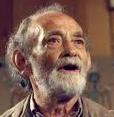

On May 25, 1969 John Schlesinger's X-rated Midnight Cowboy (United Artists) debuts, written by formerly blacklisted screenwriter Morton Salt, er, Waldo Miller Salt (1914-87) based on the 1965 novel by James Leo Herlihy (1927-93), starring Jonathan Vincent "Jon" Voight (1938-) as Tex. dishwasher Joe Buck, who dresses up as a cowboy, heads for New York City on a bus, and tries to hustle his flowing angelic jolly milk machine to lonely rich women, but ends up selling it to deadbeat teenie homos like Bob Balaban in theaters while sliding ever lower into the depths of the Big Apple with seedy crippled derelict Enrico "Ratso" Rizzo, played a little too well by Dustin Hoffman; Brenda Vaccaro plays his best $20 customer Shirley; first X-rated film to receive a best picture Oscar (until ?); #3 grossing film of 1969 ($44.8M box office on a $3.2M budget).

On June 11, 1969 (Chinese Year of the Rooster) Henry Hathaway's True Grit (Paramount Pictures) debuts, written by Marguerite Roberts based on the 1968 Charles Portis novel and filmed in Ridgway, Colo., starring John Wayne as cranky alcoholic U.S. deputy marshal Reuben J. "Rooster" Cogburn, and Kim Darby as 14-y.-o. ingenue Mattie Ross of Dardanelle, Yell County, Ark., who hires him to find her daddy's killer Tom Chaney (Jeff Corey), telling him "They tell me you are a man with true grit"; after a trek joined by Texas Ranger La Boef (Glen Campbell) (after Elvis turned down the part because they wouldn't give him top billing), she finds, shoots and wounds him in Indian Territory (Okla.), is taken prisoner by the Pepper gang, led by Lucky Ned Pepper (Robert Duvall), and Cogburn takes them on single-handed in the movie's climax: "I call that bold talk for a one-eyed fat man" (Ned Pepper); "Fill your hand, you son of a bitch!" (Cogburn); spawns 1975 sequel "Rooster Cogburn"; refilmed in 2010 by the Coen Brothers.
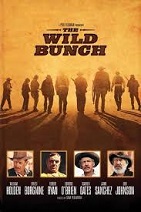
On June 18, 1969 Sam Peckinpah's The Wild Bunch (Warner Bros.) debuts, written by Walon Green and Roy N. Sickner stars William Holden, Robert Ryan, Ernest Borgnine, Warren Oats, Strother Martin et al. in a Western masterpiece (greatest of all time?) about aging outlaws with a sense of justice on a final rampage against time itself, using lyrical slo-mo ballet-like photography of violence; does $11.1M box office on a $6M budget.

All roads lead to Hollyweird? On July 14, 1969 Dennis Hopper's Am. hippie-biker film Easy Rider (Raybert Productions) (Columbia Pictures) debuts, celebrating while ironically presaging the end of the hippie culture, becoming a $100M+ box office hit, opening up Hollyweird for awhile to young low-budget filmmakers, who launch New Hollywood; written by Hopper, Fonda, and Terry Southern and made for $360K-$400K, it stars Dennis Lee Hopper (1936-2010) as hippie Billy (dressed in buckskin with a bushman hat), and Peter Henry Fonda (1940-2019) (son of Henry Fonda) as hippie Wyatt (Captain America) (dressed in U.S. flag-draped leather) (based on David Crosby and Roger McGuinn of The Byrds), who smuggle coke from Mexico to LA, sell it to the Rolls-Royce-riding Connection (Phil Spector), then stuff the money in the fuel tank of their Harley and head east for the New Orleans Mardi Gras, meeting up with alcoholic lawyer Jack Nicholson, who turns down marijuana because "It leads to harder stuff" and "I don't want to get hooked", then changes his mind, and is later killed by crackers with a machete; after reaching New Orleans, they shack up with hos Karen (Karen Black) and Mary (Toni Basil), and have a bad LSD trip in a cemetery before getting bushwacked by two rednecks in a pickup truck, who kill them with a shotgun before they can reach their long-awaited retirement in Fla.; the Holy Model Rarities play in the film, incl. drummer Sam Shepard; Dan "Grizzly Adams" Haggerty builds the tricked-up motorcycles for it; "You know, Billy, we blew it"; "This used to be a fine country - what went wrong?" (Nicholson); #4 grossing film of 1969 ($41.7M).

On July 23, 1969 Sydney Pollack's Castle Keep (Filmways) debuts, based on the 1965 William Eastlake novel about eight U.S. soldiers deciding to save artwork-filled Maldorais Castle in Belgium (filmed in Novi Sad, Serbia in a castle made of styrofoam) during the 1942 Battle of the Bulge, starring eyepatch-wearing Burt Lancaster as Maj. Abraham Falconer, Patrick O'Neal as art expert Capt. Lionel Beckman, Jean-Pierre Aumont as the Count, and Peter Falk as Sgt. Rossi; Al Freeman Jr. plays African-Am. Pvt. Allistair Piersall Benjamin; Caterina Boratto plays local madame the Red Queen; "Firmly pro and anti-war".










On Aug. 8, 1969 (eve.) 8-mo.-pregnant actress Sharon Marie Tate (Polanski) (b. 1943) (wife of movie dir. Roman Polanski) and four other people, Hollywood hair stylist Jay Sebring (b. 1931), coffee heiress Abigail Folger (b. 1943), her common-law hubby Vojciech "Voytek" Frykowski (b. 1936), and delivery boy Steven Parent (b. 1951) are brutally murdered (Parent is shot and the rest stabbed a total of 100 times) in her Bel-Air, Los Angeles home in Benedict Canyon at 10050 Cielo Dr. (formerly owned by record exec Terry Melcher (1942-2004), son of Doris Day (1924-), who had refused to record an album for Cincinnati, Ohio-born self-described Flower Power singer-songwriter (hey-hey-I'm-a-Monkee-wannabe) Charles Milles "Charlie" Manson (1934-) (who has done plenty of hard time, but was let out, allowing him to portray himself as a guru in San Fran's Haight-Ashbury district during the 1967 Summer of Love, while he picked up hippie women then used his study of Scientology and its psycho-babble to hypnotize them, helped by his super sexual stamina that turned them into sexual slaves), and saw him there when he was shacking up with girlfriend Candice Bergen) during a party by uninvited Manson Family members Charles Denton "Tex" Watson (1945-) (a religiously-raised boy who was picked up hitchhiking by Dennis Wilson of the Beach Boys and taken home, where he meets Manson), Susan Atkins (1948-2009) (who starred in "Witches Sabbath" by Anton Szandor LaVey), Patricia Dianne Krenwinkel (1947-), and Leslie Van Houten (1949-); Atkins writes "Pig" on the front door in blood; novelist Jerzy Kosinski (1933-91) (invited by Frykowski) misses his plane (and the party), later writing the novel Blind Date about the close call; on Aug. 10 wealthy married business people Leno LaBianca (b. 1925) and Rosemary LaBianca (b. 1931) are murdered in their Los Angeles home; this time "Death to Pigs" (Pigz) is written in blood on a wall, and "Helter Skelter" on the refrigerator door, referring to a song in the Beatles' White Album which Charlie Manson thinks prophesies a race war in which the blacks will kill all whites; on Oct. 12 the Tate-La Bianca Murders are traced to Charles Manson and three female members of his Manson Family, who are arrested while holing up in the Barker Ranch house in the Panamint Mts. of Calif. W of Death Valley, and who are later given death sentences (later reduced to life imprisonment); after the arrests hippies in the Los Angeles area can no longer count on hitchhiking. Sharon Tate's mother Doris Gwendolyn Tate Willett (1924-92) gets the first victim impact statement law passed in Calif. in 1982 to prevent the parole of Tex Watson.
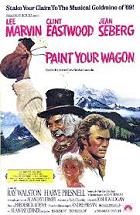
On Oct. 15, 1969 Joshua Logan's Western musical Paint Your Wagon (Paramount Pictures) debuts, based on the 1951 Lerner-Loewe musical, starring singing Lee Marvin and singing Clint Eastwood, who share Mormon wife Jean Seberg, whose singing is dubbed; does $31.7M box office on a $20M budget; features the songs They Call the Wind Maria, and I Was Born Under a Wandering Star.

On Oct. 24, 1969 George Roy Hill's Butch Cassidy and the Sundance Kid (20th Cent. Fox) debuts, written by William Goldman, starring Paul Newman (Butch) and Robert Redford as Am. Wild West outlaws going on the lam in Bolivia with school teacher Etta Place (Katharine Ross), while the hit song "Raindrops Keep Falling on My Head" plays; Redford has a fistfight with "Lurch" actor Ted Cassidy; #1 grossing film of 1969 ($102.3M box office in the U.S. on a $6M budget).


On Dec. 15, 1969 Daniel Mann's A Dream of Kings debuts, starring Anthony Quinn, becoming the last film appearance of Swedish-born blonde actress Inger Stevens (1934-70) before committing suicide next Apr. 30 at age 36 and letting her little secret of a black hubby (since 1961), NFL football player, actor, and producer Isaac Lolette "Ike" Jones (1929-) (first black grad from UCLA Film School in 1952) leak out of a bottle; she attempted suicide in 1959 when Bing Crosby dumped her, followed by Anthony Quinn, Dean Martin, Clint Eastwood, Harry Belafonte, Mario Lanza, and shortly before her suicide, Burt Reynolds - going my way?

On Dec. 16, 1969 Gene Saks' Cactus Flower (Columbia) debuts, based on the 1965 play by Abe Burrows, starring Walter Matthau, Ingrid Bergman, and "Laugh-In" star Goldie Jeanne Hawn (1945-), making her a star; does $26M box office on a $3M budget.

In 1969 Am. Jewish Christian convert Tony Alamo (Bernie LaZar Hoffman) (1934-) and his wife Susan (d. 1982) found the Alamo Christian Foundation in Hollywood, Calif., going on to predict impending Armageddon and call Pope John Paul II and Ronald Reagan "Anti-Christ Devils" while gathering a cult of runaways and addicts that become his sexual slaves, with "marriages" to girls as young as eight; they support themselves by selling rhinestone-studded denim jackets; in 1976 they move to Alma, Ark.; in 1994 Alamo is convicted of federal tax evasion; on July 24, 2009 he is convicted of 10 counts of transportation of minor girls across state lines for sex, and put away for life - Jesus saves?
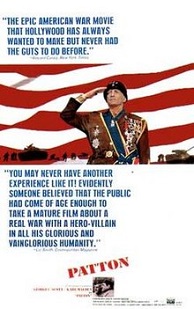
On Feb. 4, 1970 Franklin J. Schaffner's Patton (20th Cent. Fox) stars vain, grumpy George C. Scott (after Rod Steiger turns it down) as grumpy, vain bitch-slapping Old Blood and Guts, an 18th-cent. general living in the wrong era, giving war and patriotism a good name by blaming it all on him?; Karl Malden plays sane reserved Gen. Omar N. Bradley; "Ten hut! Be seated" (opening); #4 grossing film of 1970 ($61.8 U.S. box office on a $12.6M budget).

On Mar. 5, 1970 George Seaton's Airport debuts, based on the Arthur Hailey novel, starring Dean Martin, Burt Lancaster et al. in a trend-setting ticket-selling disaster flick that spawns three sequels, all of which star George Kennedy as Joe Patroni, who gets a promotion each time; #2 grossing film of 1970 ($100.4M).
On Apr. 7, 1970 the 42nd Academy Awards awards the best picture Oscar for 1969 to United Artists' (Jerome Hellman and John Schlesinger) Midnight Cowboy (first X-rated film to win best picture), along with best dir. to John Schlesinger; best actor goes to John Wayne for True Grit, best actress to Maggie Smith for The Prime of Miss Jean Brodie, best supporting actor to Gig Young for They Shoot Horses Don't They? (after which his career begins to tank), and best supporting actress to Goldie Hawn for Cactus Flower.
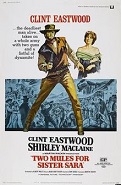
On June 16, 1970 Don Siegel's Two Mules for Sister Sara (The Malpaso Co.) (Universal Pictures) debuts, starring Clint Eastwood as ex-Civil War soldier Hogan, and Shirley MacLaine (who replaced Elizabeth Taylor) as a nun, who get in an adventure over a French fort in Mexioo and then hook up; does $4.7M box office on a $2.5M budget.

On June 24, 1970 Mike Nichols' Catch-22 (Filmways) (Paramount Pictures) debuts, an adaptation by Buck Henry of the 1961 Joseph Heller anti-war satire novel about USAF fliers in the Mediterranean in 1944, starring Alan Arkin as Yossarian, and Bob Newhart as squadron cmdr. Maj. Major, who never flew in a plane; also features Martin Balsam as Col. Cathcart ("Atheism is against the law, isn't it?"), Jon Voight as Lt. Milo Minderbinder ("Cotton made me sick"), Richard Benjamin as Maj. Danby ("Take him out and shoot him"), Buck Henry, Paula Prentiss, Martin Sheen, Charles Grodin, Anthony Perkins as Anabaptist chaplain Capt. Fr. A.T. Tappman, Orson Welles as Gen. Dreedle ("Get back in the car you smirking slut"), and Jack Gilford; the film debut of singer Art Garfunkel as Lt. Nately; does $24.9M box office on an $18M budget.


On June 24, 1970 Michael Sarne's Myra Breckinridge debuts, a woof version of the 1968 Gore Vidal novel, starring Raquel Welch as Myra (who started out as Myron before the sex change operation by a stoned surgeon), John Huston as Uncle Buck Loner, and Mae West as nympho Leticia Van Allen, who runs a talent agency for "leading men" only; "As funny as a child molester" (Time mag.); so bad it's withdrawn by the studio; the unmemorable film debut of Thomas William "Tom" Selleck (1945-) and Farrah (Ferrah Leni) Fawcett (1947-2009).

On Sept. 23, 1970 Richard O. Fleischer's Tora! Tora! Tora! (20th Cent. Fox) debuts, starring Martin Balsam as Adm. Husband E. Kimmel, Joseph Cotten as U.S. secy. of war Henry L. Stimson, E.G. Marshall as Col. Rufus S. Bratton, James Whitmore as Vice-Adm. William F. Halsey, and Japanese actors Takahiro Tamura as Cmdr. Mitsuo Fuchida and Eijiro Tono as Vice-Adm. Chuichi Nagumo in a retelling of the Dec. 7, 1941 Pearl Harbor attack; Japanese dirs. Toshio Masuda and Kinji Fukasaku are given a crack at the film to make it balanced?; does $29.5M box office on a $25.5M budget; watch trailer.


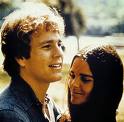
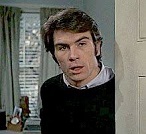
On Dec. 16, 1970 Arthur Hiller's Love Story (Paramount) debuts, written by Erich Wolf Segal (1937-), starring Romeo, er, Charles Patrick Ryan O'Neal (1941-) as rich Harvard student Oliver Barrett IV, and Alice "Ali" McGraw (1938-) as poor Juliet, er, Jenny Cavilleri, jerking big tears with her pathetic death, woo-woo-woo; the novel is later written from the script; the film debut of San Saba, Tex.-born real Harvard U. student (roommate of Al Gore) Tommy Lee Jones (1946-) as Hank Simpson; features the song Where Do I Begin? (Love Story); #1 grossing film of 1970 ($106.3M); the word cancer is never mentioned in the film; using bubblebrain McGraw to portray a brainy Radcliffe babe is outrageous miscasting, but perfect for the crowds who only want to see her bod? - brilliant?
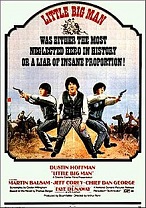
On Dec. 23, 1970 Arthur Penn's Little Big Man (Nat. Gen. Pictures), based on the 1964 Thomas Berger novel stars Dustin Hoffman as 121-y.-o. Jack Crabb, who reminisces about his life starting at age 17, ending with his days with vainglorious golden haired Gen. George Armstrong Custer (Richard Mulligan); Chief Dan George plays Old Lodge Skins, and Faye Dunaway plays Mrs. Louise Pendrake AKA Lulu Kane; takes the Native Am. side against the U.S. Cavalry, indirectly protesting the Vietnam War; Hoffman sets a record for portraying a 104-year age span (until ?); does $31.6M box office on a $15M budget; "Little Big Man was either the most negelected hero in history or a liar of insane proportion!"

In 1970 Leonard Horn's The Magic Garden of Stanley Sweetheart (MGM) debuts, becoming the film debut of Hopewell, Mo.-born Donny Wayne "Don" Johnson (1949-); too bad, it's a flop, causing Johnson to utter the soundbyte: "It damn near sent me back to Missouri."

In 1970 Robert Downey Sr.'s Pound, (United Artists) debuts, based on his 1961 play "The Comeuppance" about animals waiting to be put to sleep, becoming the film debut of Downey's 5-y.-o. son Robert John Downey Jr. (1965-) as Puppy.


In 1970 Am. blonde white actress Jean Seberg (1938-79), who became an outspoken supporter of the NAACP and Native Am. groups, and also supports the Black Panther Party is framed by FBI dir. J. Edgar Hoover with Pres. Nixon's approval when she becomes 7 mo. pregnant, leaking a false story that the father is not her 2nd hubby, Russian-born white French film dir. Romain Gary (1914-80) but big black buck Bobby Seale from the Panthers; after the girl is born premature on Aug. 23 and dies on Aug. 25, she shows her photo to the press to prove that it ain't a mule ah toe, blaming the infant's death on the trauma of the publicity; the baby is later revealed to have been fathered by Carlos Navarra; she turns into a suicidal alcoholic and prescription drug addict, and doesn't last the decade before turning up dead in the back seat of her car in Paris.

On Mar. 11, 1971 George Lucas' THX 1138 debuts (Lucas' feature film debut), starring Robert Duvall as the title char., who lives in an underground city in the 25th cent. sans sex and worships OMM 0910 in Unichapels, then discovers love with his computer-matched roommate LUH 3417 (Maggie McOmie) and tries to escape; the first film from Lucas' buddy Francis Ford Coppola's American Zoetrope Studio.
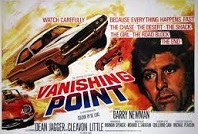
On Mar. 13, 1971 Richard C. Sarafian's Vanishing Point (20th Cent. Fox) debuts, starring Barry Newman as Vietnam Vet race car driver Kowalski, who tries to deliver a white 1970 Dodge Challenger R/T Magnum 440 from Denver, Colo. to San Francisco, Calif. a lot too fast, ending up being chased by police all the way while blind black disk jockey Super Soul (Cleavon Little) provides play-by-play commentary, calling him "the last American hero"; becomes a cult film; does $12.4M box office on a $1.58M budget; refilmed in 1997.

On Apr. 9, 1971 Robert Mulligan's Summer of '42 (Warner Bros.) debuts, based on the memoirs of screenwriter Herman Raucher about his vacation on Nantuck Island, starring Gary Grimes as Hermie, and Jennifer O'Neill as his mysterious love babe; does $32M box office on a $1M budget; the novelization becomes a bestseller; followed by "Class of '44" (1973).
On Apr. 10, 1971 the 43rd Academy Awards awards the best picture Oscar for 1970 to 20th Century-Fox's Patton, along with best dir. to Franklin J. Schaffner and Frank McCarthy, and best actor to George C. Scott (who refuses it; 2nd time ever; first time was in 1936); best actress goes to Glenda Jackson for Women in Love, best supporting actor to John Mills for Ryan's Daughter, and best supporting actress to Helen Hayes for Airport.

On May 1, 1971 Tom Laughlin's Billy Jack debuts, a sequel to "The Born Losers" (1967), starring Tom Laughlin (1931-) as a half-Cherokee ex-Green Beret hapkido expert who tries to save wild horses and a desert hippie freedom school for runaways (based on Prescott College), while the evil govt. bad guys come down on him; co-writer and wife (since 1954) Delores Taylor (1939-) plays his babe Jean Roberts; Clark Howat plays Sheriff Cole; features the song One Tin Soldier by Jinx Dawson of Coven, originally released in 1969 by Canadian group Original Caste; after Am. Internat. Pictures and 20th Cent. Fox dump it, Warner Bros. ends up with a surprise hit that costs $800K and rakes in $40M (#1 grossing film of 1971, later grossing $58M more), and spawns three sequels; Laughlin, who started the Montessori Preschool in Santa Monica, Calif. in the 1960s runs for U.S. pres. in 1992, 2004, and 2008.
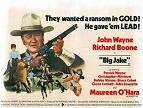
On May 26, 1971 George Sherman's Big Jake (Batjac Productions) (Nat. Gen. Pictures) debuts, written by Harry Julian Fink and Rita M. Fink, filmed in Durango, Mexico, starring John Wayne as Jacob McCandles, Maureen O'Hara as his estranged wife Martha, and Richard Boone as John Fain, leader of a gang of outlaws who wound Big Jake's son Jeff (Bobby Vinton) and kidnap his grandson Little Jake (Ethan Wayne), causing him to go after them along with his sons James (Patrick Wayne) and Michael (Christopher Mitchum, son of Robert Mitchum), and old injun Sam Sharpnose (Bruce Cabot); debuts at the John Wayne Theater at Knott's Berry Farm; Laddie plays Wayne's dog; the last of five films pairing Wayne and O'Hara (first in 1950); "They wanted a ransom in gold. He gave them lead"; does $7.5M on a $4.8M budget.
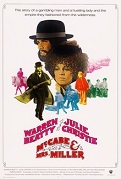
On June 24, 1971 Robert Altman's McCabe & Mrs. Miller (June 24) (Warner Bros.), based on the 1959 Edmund Naughton novel stars Warren Beatty as whorehouse owner John McCabe in the mining town of Presbyterian Church, Wash. in the Old Am. West, and Julie Christie as the opium-addicted British cockney madame Constance Miller, who fight the Harrison Shaughnessy Mining Co. in Bearpaw in a film that's better than it sounds?; does $8.2M box office.

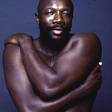
On July 2, 1971 Gordon Parks' Shaft debuts, based on an Ernest Tidyman novel and starring Richard Roundtree as badass black New York city detective John Shaft, launching the Blaxploitation genre, and wins Isaac Hayes (1942-2008) the first music Oscar ever given to an African-Am. composer; Parks also directs the 1972 sequel Shaft's Big Score.

On Aug. 1, 1971 Boris Sagal's The Omega Man debuts, based on the 1954 Richard Matheson novel "I Am Legend", starring Charlton Heston as Army Col. Robert Neville, the last survivor of the Mar. 1975 biological war between China and the Soviet Union that turns everybody else in LA into crazed nocturnal albino mutants.

On Sept. 12, 1971 Bob Rafelson's Five Easy Pieces debuts, starring Jack Nicholson as a failed pianist working on oil rigs, who steers a dense waitress into giving him toast by ordering a chicken salad sandwich on toast without the chicken salad; the easy pieces are piano music not sandwiches or waitresses; Ralph Waite plays Jack's brother Carl; also stars Karen Black, Susan Anspach, and Billy Green Bush (1935-), father of the Greenbush twins Lindsay and Sidney (b. 1970), who star as Carrie in "Little House on the Prairie" under the alias Lindsay Sidney Greenbush.

On Oct. 9, 1971 William Friedkin's The French Connection, based on the 1969 true story book by Robin Moore debuts, starring Eugene Allen "Gene" Hackman (1930-) as porkpie-hat-wearing New York City detective Jimmy "Popeye" Doyle (based on real-life New York City detective Eddie Egan), and Roy Scheider as his partner Buddy Russo, who break a Marseille heroin ring run by Alain Charnier (Fernando Rey) by stripping down his brown 2-door Lincoln Continental mule car (license plate 18 LU 13); French TV performer Jacques Angelvin plays the cop-killing courier; features one of the best car chase scenes in Hollywood history; #4 grossing film of 1971 ($41.1M); "I'm going to nail you for picking your feet in Poughkeepsie" (Doyle); "I'd sooner be a lamp post in New York than the president of France" (Doyle).

On Oct. 22, 1971 Peter Bogdanovich's B&W The Last Picture Show debuts, based on the 1966 Larry McMurtry novel, starring Cybill Lynne Shepherd (1950-) as hot promiscuous virgin Jacy Farrow, Jeff Bridges as her impotent beau Duane Jackson, Ben Johnson as business owner Sam the Lion, Timothy Bottoms as Duane's friend Sonny Crawford, Cloris Leachman as his ever-crying older lover Ruth Popper, and Ellyn Burstyn as Jacy's mother Lois Farrow in the dying early 1950s rural Tex. town of Anarene (based on Abilene in Howard Hawks' 1948 film "Red River") where the teenies like to go skinny-dipping and the males like getting a piece of ass, drawing Bogdanovich comparisons with "Citizen Kane"; Shepherd (who hooks up offscreen with Bogdanovich?) is built-up as the ultimate piece by showing other women nude, but her only topless; the theater's name is the Royal; does $29.1M box office on a $1.3M budget.

On Dec. 12, 1971 Am. major Hollywood actor Jon Voight marries minor Am. actress Marcia Lynne "Marcheline" Bertrand (1950-2007) (until 1978); they have one daughter, Angelina Jolie (1975-), and one son, James Haven (1973-); they divorce in 1980 after she leaves him for adultery in 1976 and hooks up with partner Bill Day in 1978.

On Dec. 23, 1971 Donald Siegel's Dirty Harry (Dec. 23) (Warner Bros.) stars Clint Eastwood as grimacing rule-breaking macho white San Francisco cop Harry Callahan, who packs a 6-shot Smith & Wesson Model 29 .44 Magnum revolver ("the most powerful handgun in the world" that'll "blow your head clean off"), and can't restrain himself with psycho Scorpio Killer Andy Robinson, uttering the immortal soundbyte: "Do you feel lucky, punk?" before blowing him away in a signature movie moment of the 1970s; does $36M box office on a $4M budget; sequels incl. "Magnum Force" (1973), "The Enforcer" (1976), "Sudden Impact" (1983), and "The Dead Pool" (1988); Eastwood later claims that the Hollyweird obsession with political correctness began about the time of this film's release.

In 1971 the Jim Nabors-Rock Hudson Rumor is spread by gays in S Calif. as a joke, to the effect that they're going to get married and be called Rock Pyle; meanwhile the real Nabors hooks up with Stan Cadwallader, and in 1976 they move to Maui, Hawaii and live happily ever after together, getting married on Jan. 15, 2013.

On Jan. 13, 1972 Mark Rydell's The Cowboys (Warner Bros.) debuts, based on the novel by William Dale Jennings, starring John Wayne as aging Mont. rancher Wil Andersen, who loses his regular cowboys to a gold rush and takes a bunch of adolescent cowboys on a 400-mi. cattle drive to Belle Fourche while being pursued by rustlers led by snakey dern ornery ex-con Asa "Long Hair" Watts (Bruce Dern), who gets the delicious unique movie thrill of shooting and killing John Wayne, after which the teenies turn hero-worshipper and get revenge; also stars Roscoe Lee Brown as cook Jebediah Nightslinger, and Colleen Dewhurst as Kate; does $7.5M box office on a $6M budget; "America will hate you for this" (Wayne); "Yeah, but they'll love me in Berkeley" (Dern); the source of the eternal fight between Agent Smith and Mr. Anderson in "The Matrix"?


On Feb. 13, 1972 Bob Fosse's Cabaret debuts, written by Jay Presson Allen based on the book by Joe Masteroff and the hit John Kander musical, starring Liza Minnelli (1946-), Joel Grey (1932-), and Michael York (1942-) in an exploration of the quintessential differences kinky liberal Jews have with even kinkier Herr Hitler; #6 grossing film of 1972 ($42.7M) - and why there's so many Jews behind the exploding porno biz in Nazi-free America?

On Mar. 10, 1972 Douglas Trumbull's Silent Running (Universal) debuts, a sci-film starring Bruce Dern as the keeper of the space greenhouse Valley Forge, who is told to nuke it and decides to save it, with help from service drones Huey, Dewey, and Louie; features the Joan Baez songs Rejoice in the Sun and Silent Running.


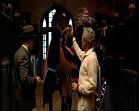

On Mar. 15, 1972 Francis Ford Coppola's The Godfather (Paramount Pictures) debuts, made for $6.5M based on the 1969 Mario Puzo novel, portraying Italian-Ams. as organized crime maggots feeding on the Am. body politic while making the audience root for them stars cotton-balls-in-cheeks Marlon Brando as the Godfather Don Vito Corleone (1891-1957) (basing his accent on real gangster Frank Costello), Al Pacino, James Caan, and John Cazale as his sons Michael, Santino "Sonny", and Fredo, Robert Duvall as his non-Italian atty. Tom Hagen, Diane Keaton as Michael's non-Italian wife Kay Adams, Talia Shire as Vito's daughter Connie, Gianni Russo as her abusive husband Carlo Rizzi, Abe Vigoda as Sal Tessio, Lenny Montana as Luca Brasi, Sterling Hayden as corrupt police capt. McCluskey, Richard Conte as rival Don Emilio Barzini, Al Lettieri as Virgil "the Turk" Sollozzo, Alex Rocco as Moe Greene (based on Bugsy Siegel), Victor Rendina as Philip Tattaglia, Simonetta Stefanelli as Michael's Sicilian babe Apollonia, and Al Martino as singer Johnny Fontane; Salvatore Corsitto plays Amerigo Bonasera, a mortician who asks for Don Corleone's aid in the opening scene; Orson Welles wanted the Godfather part but got turned down; New York City Mafia don Joe Colombo Sr. uses his Italian Am. Anti-Defamation League to shut down early production of the film in Manhattan, N.Y. until mob-connected Russo is hired; to get into this cast is to get famous?; music by Italian composer Nino Rota (1911-79); too bad, the Oscar nomination for best score is revoked when they find out that Rota lifted music from 1958 Italian film "Fortunella", but later give him the Oscar for "The Godfather: Part II"; cinematographer Gordon Hugh Willis Jr. (1931-2014) becomes known as "the Prince of Darkness" for his dark scenes; the crowd-pleasing horse head scene of decapitated $600K racehorse Khartoum, owned by pedophile Jewish movie producer J ack Woltz (John Marley) is filmed in the H-shaped 29-bedroom 40-bathroom Hearst Mansion in Beverly Hills, Calif., most expensive private home in the U.S., in which JFK and Jackie honeymooned; #1 grossing film of 1972 ($245M-$286M worldwide box office incl. $134.9M in the U.S. on a $6.5M budget) ( first successful film about the Mafia); Italian-Ams. protest it in vain; Coppola, who directs the epic slam on his own ethnicity receives wealth and fame from Hollywood for selling tickets, becoming a self-fulfilling prophecy as his family members go into the film business; the Godfather Film Trilogy incl. "The Godfather Part II" 1974), and "The Godfather Part III" (1990) does $429 worldwide box office, and garners 29 Oscar nominations; a fourth film is shelves after Puzo's July 2, 1999 death; "Luca Brasi sleeps with the fishes"; "Leave the gun and take the cannoli"; "I'll make him an offer he can't refuse." Watch video; watch video; watch video; watch video.
On Apr. 3, 1972 Charlie Chaplin returns to the U.S. after being chased out for 20 years by the feds (J. Edgar Hoover and his FBI).
On Apr. 10, 1972 the 44th Academy Awards awards the best picture Oscar for 1971 to 20th Century-Fox's (D'Antoni Productions) The French Connection, along with best dir. to William Friedkin, and best actor to Gene Hackman; best actress goes to Jane Fonda for Klute, best supporting actor to Ben Johnson, and best supporting actress to Cloris Leachman for The Last Picture Show.

In Apr. 1972 hairy actor Burt Reynolds (1936-) advances his career by posing nude but unexposed on a bearskin rug for a Cosmopolitan mag. centerfold, becoming an icon of the Sexual Rev.

On July 1, 1972 Gordon Parks Jr.'s Super Fly (black slang for excellent) (Universal) debuts, a cool blaxploitation film starring able black actor Ron O'Neal (1937-2004) as New York cocaine dealer Youngblood Priest, who tries to quit in one piece after one last score; the soundtrack by Curtis Mayfield makes it a classic; too bad, its portrayal of black communities as controlled by drug lords pisses-off civil rights activists; "That honkey's using me, so what? I'm glad he's using me, because I'm gonna make a piss pot full a money, and I'm going to live like a prince, a fucking black prince. Yah, this is the life, I could be nothing nowhere else, and about his killing me, shit I don't care, as long as he lets me live to be an old motherfucker"; "You gonna give all this up, 8-track stereo, color TV in every room, and you can snort half a piece every day. That's the American Dream ain't it, nigger, well ain't it, ain't it, come on in man."
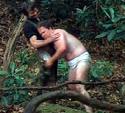
On July 30, 1972 John Boorman's Deliverance debuts, based on the 1970 James Dickey novel, starring Burt Reynolds, Jon Voight, Ronny Cox, and Ned Beatty as Atlanta businessmen Lewis Medlock, Ed Gentry, Drew Ballinger, and Bobby Trippe, who make a big mistake one weekend canoing down the Cahulawassee River in Ga. before the er, erection of a dam, and get captured by two hillbillies with er, small game guns, played by Bill McKinney (1931-) and Herbert "Cowboy" Coward (complete with Billy Bob teeth), after which Bill sodomizes Drew while making him squeal like a pig, then Billy Bob mouth utters the immortal soundbyte "He got a real purdy mouth, ain't he?" to Ed after he is forced to his knees, but are interrupted before he can stick it in by an arrow through the body of Bill by Lewis, after which their trip turns into a flight back to civilization while trying to hide the body, er, bodies; the subliminal message is that Christian men don't know what they're missing with other men?; the film debuts for er, Beatty and Cox; er, Dickey plays a sheriff, as does "Married: With Children" Ed O'Neill; Boorman's son Charley plays Voight's son; the Dueling Banjos Scene, which was copied from an episode of "The Andy Griffith Show" featuring the fictional bluegrass band The Darlings, played by The Dillards, starring inbred albino Lonnie (Billy Redden) on banjo and Ronny Cox on guitar spawns a hit record; "This is the weekend they didn't play golf"; #4 grossing film of 1972 ($46.1M).
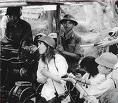
On Aug. 22, 1972 Oscar-winning Am. actress Jane Seymour Fonda (1937-) gives a bad performance for once when she gives an antiwar radio address in English on Radio Hanoi from a hotel room in Hanoi, then sits behind an anti-aircraft gun emplacement as if she's ready to shoot down all Yankees in sight, causing her to be branded as a traitor by Americans, "Hanoi Jane"; after years of denial, she finally apologizes in 1988 in a 20/20 TV interview with Barbara Walters; she had gone to Hanoi because the U.S. govt. was bombing dikes in the Red River Delta, threatening 200K Vietnamese civilians with drowning, and claims the Communists tricked her into the AA gun photo op by singing a song with the lyrics "We hold these truths to be self-evident"; false rumors circulate that her visit causes U.S. POWs to be killed.
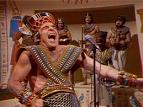
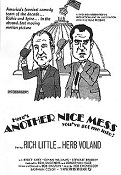
On Sept. 22, 1972 Bob Einstein's Another Nice Mess debuts, starring Rich Little as Richard Nixon, and Herb Voland as Spiro Agnew, who are portrayed as Laurel and Hardy; the film debut of Waco, Tex.-born Stephen Glenn "Steve" Martin (1945-) as Hippy.

On Nov. 3, 1972 Clint Eastwood's Play Misty for Me debuts (Eastwood's dir. debut), filmed in his home area of Carmel-by-the-Sea, Calif. and the Sept. 1970 Monterey Jazz Festival, starring Eastwood as disc jockey David "Dave" Garver, who is stalked by female fan Evelyn Draper (Jessica Walter), who keeps calling in to ask him to play the 1954 jazz tune Misty by Erroll Garner (1921-77).

On Dec. 12, 1972 Ronald Neame's The Poseidon Adventure (20th Cent. Fox) debuts, based on the 1969 Paul Gallico novel, featuring a star-studded cast incl. Gene Hackman, Ernest Borgnine, Shelley Winters, Red Buttons, Jack Albertson, and Stella Stevens (Jan. 1960 Playboy Playmate of the Month) as passengers on cruise ship SS Poseidon that gets capsized on New Year's Eve en route from New York to Athens, causing its 10 survivors (out of 1.4K) to have to climb up inside the upside-down boat to the hull; creates the new film genre of big cast disaster flick; orcalike Winters' swimming feats in a submerged boiler room becomes a classic (her 3rd drowning victim role); The Morning After by Maureen McGovern wins a best song Oscar; #2 grossing film of 1972 ($93.3M U.S. and $127.3M worldwide box office on a $4.7M budet); refilmed in 2005 and 2006.
On Mar. 27, 1973 the 45th Academy Awards, held in Los Angeles at the Dorothy Chandler Pavilion awards the best picture Oscar for 1972 to Paramount's (Alfred S. Ruddy) The Godfather, along with best actor to Marlon Brando, who refuses to appear, sending Calif.-born AIM activist (1970 Miss Am. Vampire) Sacheen Littlefeather (Marie or Maria Cruz) (1947-), dressed in Native Am. garb with a 15-page speech he wrote to explain that he is refusing the Oscar to protest the treatment of Native Ams. at Wounded Knee, the movies and TV, after which she poses for the Oct. 1973 issue of Playboy and appears in several films, incl. "The Trial of Billy Jack" (1974); best dir. goes to Bob Fosse, best actress to Liza Minnelli, and best supporting actor to Joel Grey for Cabaret; best supporting actress goes to Eileen Heckart for Butterflies Are Free.

On Apr. 10, 1973 Paul Bogart's Class of '44 (Warner Bros.) debuts, the sequel to "Summer of '42" (1971), becoming the film debut of Newmarket, Ont., Canada-born actor-comedian John Franklin Candy (1950-94).

On Apr. 19, 1973 Michael Winner's Scorpio (United Artists) debuts, starring Burt Lancaster as retiring CIA agent Cross, who must train French agent Scorpio (Alain Delon) to replace him, until the later is ordered to kill Cross; Joanne Linville plays Cross' wife Sarah; "When Scorpio wants you... there is no place to hide."
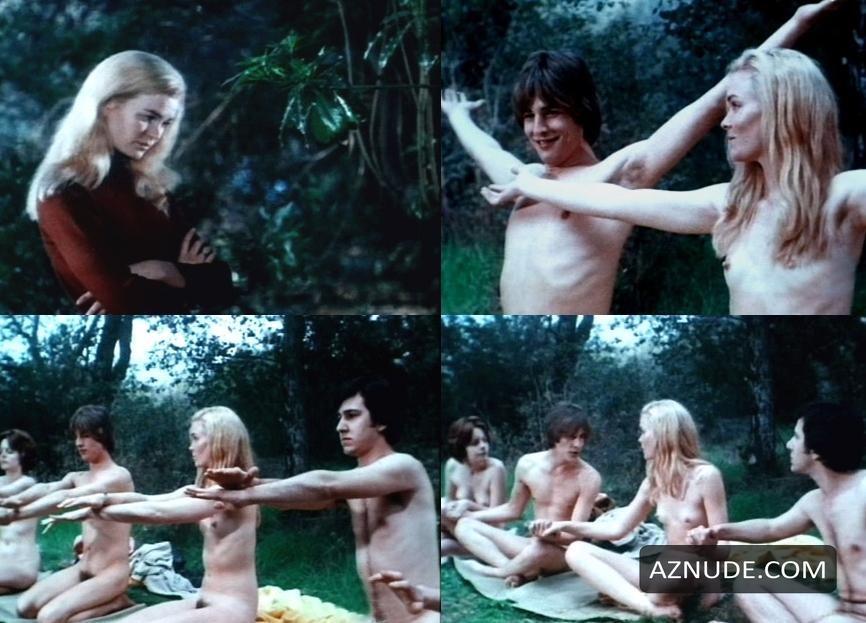
On May 11, 1973 Ted Post's The Harrad Experiment debuts, based on the 1968 Robert H. Rimmer bestseller about students
of guess-what Harrad College experimenting with polyamory; stars James Whitmore and Tippi Hedren as school principals Philip and Margaret Tenhausen, who encourage them to frolic nude
on campus; Don Johnson plays student Stanley Cole;
"The Harrad Experiment can probably be summed up by its opening and closing sequences - it begins with one of the girls wandering around the new campus and hugging a tree, and ends
with the two couples whose relationships are the heart of the film clasping hands, repeating some inane contact exercise, and finally falling into a four-way embrace" (Steve Vineberg);
does $3M box office on a $400K budget.
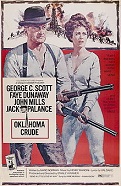
On July 3, 1973 Stanley Kramer's Oklahoma Crude (Columbia Pictures) debuts, set in the early 1900s, starring Faye Dunaway as landowner Lana Doyle, who fights to keep her shares of crude oil with her father Cleon Doyle (John Mills) and hired gun Noble Mason (George C. Scott); features the song "Send a Little Love My Way", sung by Anne Murray; does $2.5M box office; watch trailer.
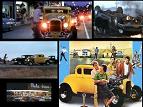
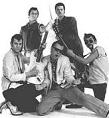
Three films gross $100M at the box office this year, "The Exorcist", "The Sting", and "American Graffiti"? On Aug. 1, 1973 George Lucas' American Graffiti debuts, a coming-of-age flick set in pre-JFK assassination 1962 in Modesto, Calif. and centered around graduation, Mel's Drive-In, a sock hop, and a drag race, rocketing dir. George Walton Lucas Jr. (1944-) to stardom, along with Ronald William "Ron" Howard (1954-) (as Steve Bolander), Richard Dreyfuss (1947-) (as Curt Henderson), Harrison Ford (1942-) (as Bob Falfa), Suzanne Somers (Suzanne Marie Mahoney) (1946-) (as blonde in white T-Bird), Cynthia Jane "Cindy" Williams (1947-) (as Laurie Henderson), Candace June "Candy" Clark (1947-) (as Old Harper and '58 Impala-loving Debbie "Deb" Dunham), Paul Le Mat (1945-) (as John Milner), and even nerdy Charles Martin Smith (1953-) (as Terry "the Toad" Fields), to the cool voice of radio disc jockey Wolfman Jack; features a sock hop with the band Flash Cadillac and the Continental Kids from the U. of Colo. at Boulder, who perform At the Hop, She's So Fine, and er, Louie, Louie; the original film was 210 min. long, cut down to 112; #3 grossing film of 1973 ($115M).
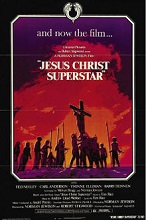
On Aug. 15, 1973 Norman Jewison's Jesus Christ Superstar (Universal Pictures) debuts, based on the 1971 Andrew Lloyd Webber/Tim Rice rock opera, starring Ted Neeley as Jesus Christ, Yvonne Elliman as Mary Magdalene, Barry Dennen as Pontius Pilate, Carl Anderson as Judas Iscariot, Bob Bingham as Caiaphas, Kurt Yaghijan as Annas, Josh Mostel as King Herod, Philip Toubus as Peter, Larry Marshall as Simon Zealotes, Richard Orbach as John, and Robert LuPone as James; does $24.5M box office on a $3.5M budget; features the songs Jesus Christ Superstar, I Don't Know How to Love Him, Simon's Song, Heaven on Their Minds; watch trailer;


On Aug. 19, 1973 Robert Clouse's Enter the Dragon (Warner Bros.) (Concord Productions) (Golden Harvest) debuts, the first U.S.-produced Kung Fu movie starring San Francisco, Calif.-born martial arts expert Bruce Lee (Lee Jun-fan) (1940-73), making him a big star after his premature death on July 20; also stars John Saxon as Roper, and Jim Kelly as Williams; does $90M box office on an $850K budget; his rooster-screeching fight scenes are keepers; on July 20, 1973 Chinatown, San Francisco, Calif.-born "Enter the Dragon" chopsockey actor Bruce Lee (b. 1940) dies in Kowloon Tong, Hong Kong, officially of brain edema; his early death (aided by all the blows he took?) shocks his fans; it was really murder?; watch trailer; view clip; view clip; view clip.
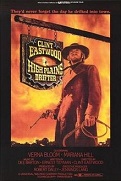
On Aug. 22, 1973 Clint Eastwood's High Plains Drifter (The Malpaso Co.) (Universal Studios) debuts, written by Ernest Tidyman and filmed in Mono Lake, Calif., starring Eastwood as the Drifter, who avenges a sheriff's death in Lago by turning it into Hell; does $15.7M box office on a $5.5M budget.

On Oct. 15, 1973 Terrence Malick's Badlands (Warner Bros.) debuts, starring Martin Sheen as Kit Carruthers, making a star of Quitman, Tex.-born Mary Elizabeth "Sissy" Spacek (1949-) as Holly Sargis, who go on a crime spree together.

On Oct. 16, 1973 James Bridges' The Paper Chase debuts, based on the 1970 John Jay Osborn novel, starring John Houseman as bow-tie-wearing Harvard Law School prof. Charles W. Kingsfield Jr., whose stringent contracts course turns mushbrain recruits into lawyers, starting with James T. Hart (Timothy Bottoms), who discovers he's hooking up with his daughter Susan (Lindsay Wagner); also stars Edward Herrmann and James Naughton as students; a script blooper portrays Mr. Brooks asking the prof. to repeat a question then stating that he has a photographic memory; "Loudly, Mr. Hart. Fill this room with your intelligence."
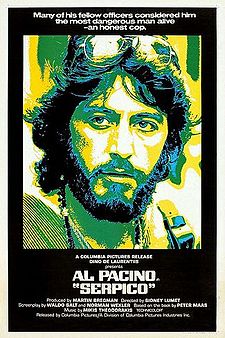
On Dec. 5, 1973 Sidney Lumet's Serpico (Paramount Pictures) debuts, based on the 1973 Peter Maas book, starring Al Pacino as honest New York City cop Frank Serpico, whose comrades turn on him and get him shot point-blank in the face; does $29.8M box office on a $3M budget.
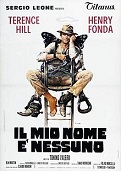
On Dec. 13, 1973 Tonino Valerii's and Sergio Leone's My Name Is Nobody (Il Mio Nome E Nessuno) (Titanus) debuts, a Spaghetti Western set in 1899 New Orleans, La., starring Terence Hill as Nobody, and Henry Fonda as Jack Beauregard; "Jack Beauregard 1848-1899 Nobody was faster on the draw."
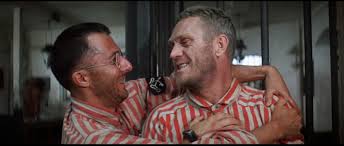
On Dec. 16, 1973 Franklin J. Schaffner's Papillon debuts, written by Dalton Trumbo and Lorenzo Semple Jr. based on the autobio. by Henri Charriere, starring Steve McQueen as safecracker Henri "Papillon" Charriere, and Dustin Hoffman as forger Louis Dega, who do the impossible and escape from Devil's Island; #4 grossing film of 1972 ($53.2M box office on a $13.5M budget).



On Dec. 17, 1973 Woody Allen's Sleeper debuts, starring Woody Allen as Happy Carrot health food store owner Miles Monroe, who is hospitalized in St. Vincent's Hospital in Manhattan for an ulcer and ends up in liquid nitrogen tanks; after being revived in 2173, and finding that "Albert Shanker got hold of a nuclear device", he ends up living on the run from the govt. with Luna Schlosser (Diane Keaton), trying to stop the Hitler-like leader's nose from being used to clone him; robots are programmed to be Jewish tailors and gay butlers; Ph.D's are given in oral sex; the McDonald's sign has 51 zeroes (795 sexdecillion); does $18M office on a $2M budget; features the 1963 3-story 7K-sq.-ft. 5-bedroom 5-bathroom curvilinear clamshell Sleeper (Sculptured) House perched above I-70 in Genesee, Colo., housing the 5-level tubular elevator called the orgasmatron, designed by Clayton, N.M.-born architect Charles Utter Deaton (1921-96) (designer of Arrowhead Stadium in Kansas City, Mo.), which is purchased by Denver Johnson-Grace software entrepreneur John Huggins for $1.33M in 1999, which he puts on the market for $10M after adding 5K more sq. ft., and sells for $3.43M in 2006.

On Dec. 25, 1973 George Roy Hill's The Sting debuts, based on a book by David W. Maurer about real life grifters Fred and Charley Gondorf, starring Paul Newman and Robert Redford in 1936 Chicago, who pull an elaborate you know what to fleece racketeer Robert Shaw, all to Scott Joplin ragtime music incl. "The Entertainer"; #2 grossing film of 1974 ($159.6M).

On Dec. 26, 1973 William Friedkin's The Exorcist debuts, based on the 1971 William Peter Blatty novel, starring Linda Denise Blair (1959-) as devil-possessed, green-pea-soup-puking girl Regan Teresa MacNeil, and is given an R-rating, becoming the Jesuits' Deep Throat, causing mass hysteria in some theaters as it draws on all 2K years of Catholic superstition, incl. the ancient god Pazuzu (voiced by Mercedes McCambridge, with the face of Eileen Dietz), aided by special effects by Dick Smith, and spooky music by Mike Oldfield; #1 film of 1973, grossing $232.6M domestic and $402.5M worldwide by 2010, passing "The Godfather" standing still; Ellen Burstyn plays actress mommy Chris MacNeil, Jason Miller plays Father Damien Karras (whose body double tumbles down the Exorcist Steps at the end of M St. in Georgetown, Washington, D.C.), Max von Sydow (who once played Jesus) plays Father Lankester Merrin; an avg. of 3 men and 2 women faint during each showing; six people die during the making of the film, causing rumors that it's cursed; "The power of Christ compels you."
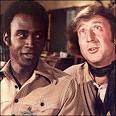
On Feb. 7, 1974 Mel Brooks' Blazing Saddles (Warner Bros.) debuts, a lampoon of Hollywood Westerns, starring Gene Wilder as Jim the Waco Kid, Madeline Kahn as Lili von Shtupp the Teutonic Titwillow, Harvey Korman as Hedley Lamarr (causing Hedy Lamarr to successfully sue), Mel Brooks as Gov. William J. Le Petomane (named after French prof. flatulist Le Petomane), Slim Pickens as Taggart, David Huddleston as Olson Johnson, John Hillerman as Howard Johnson, and Cleavon Little as Sheriff Bart, who likes whippin' it out on white women in an all- white Old West town; dumb strong Mongo (Alex Karras) knocks a horse out with one punch; "Mongo only pawn in game of life"; incl. the Famous Farting Scene ("How about some more beans, Mr. Taggart? I'd say you had enough"); #1 grossing film of 1974 ($119.5M box office on a $2.6M budget).

On Mar. 29, 1974 Jack Clayton's The Great Gatsby debuts, written by Francis Ford Coppola based on the 1925 F. Scott Fitzgerald novel, starring Robert Redford as Jay Gatsby AKA James Gatz, Mia Farrow as Daisy Bucahanan, and Sam Waterson as the viewpoint char. Nick Carraway; Bruce Dern plays Tom Buchanan, Karen Black plays Myrtle Wilson, and Lois Chiles plays Jordan Baker; Robert Evans purchased the rights to the novel in 1971 for his wife Ali MacGraw, who left him for Steve McQueen, causing Farrow to get the part after Natalie Wood, Faye Dunaway et al. turn it down.
On Apr. 2, 1974 the 46th Academy Awards in Los Angeles, Calif. are graced by unscheduled streaker Robert Opel (1979-) of San Francisco; the best picture Oscar for 1973 goes to Universal's (Bill Phillips and George Roy Hill) The Sting, along with best dir. to George Roy Hill; best actor goes to Jack Lemmon for Save the Tiger, best actress to Glenda Jackson for A Touch of Class, best supporting actor to John Houseman for The Paper Chase, and best supporting actress to Tatum O'Neal for Paper Moon (her jealous daddy Ryan O'Neal fails to show up at the awards ceremony?).
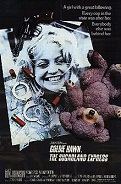
On Apr. 5, 1974 Steven Spielberg's The Sugarland Express (Universal Pictures) (first feature film by Spielberg) debuts, filmed in Sugar Land, Tex., based on the true 1969 story of Robert "Bobby" Dent (1947-69) and Ila Fae Holiday (1948-92) starring Goldie Hawn as Lou Jean Poplin, William Atherton as Clovis Michael Poplin, and Ben Johnson as Capt. Harlin Tanner; does $12.8M box office on a $3M budget.

On June 20, 1974 Roman Polanski's Chinatown (Paramount) debuts, starring ack Nicholson as LA detective J.J. "Jake" Gittes, who tries to solve the mystery of who killed the hubby of rich Evelyn Cross Mulwray (Faye Dunaway) (faint dead away?), the business partner of her richer father Noah Cross (Walter Huston), and the problem of having a daughter who is also your sister, along with who is trying to corner LA's water supply; Nicholson (b. 1937) at age 37 finds out about his real sister/mother before/after shooting the film; Polanski plays the gangster who slits Nicholson's nostril; a pair of glasses in a goldfish pond is the key clue to the plot; "Forget it, Jake. It's Chinatown"; does $29.2M box office on a $6M budget; followed by "The Two Jakes" (1990).

On July 24, 1974 Michael Winner's Death Wish (Paramount Pictures) (Dino De Laurentiis) debuts, starring Charles Bronson as Manhattan engineer Paul Kersey, whose wife Joanna (Hope Lange) is raped and killed by thugs, incl. Jeffrey Lynn "Jeff" Goldblum (1952-) in his film debut, causing him to turn vigilante using a nickel-plated .32 Colt Police Positive revolver, becoming a folk hero, paralyzing the police; does $22M on a $3M budget; spawns sequels "Death Wish II" (1982), "Death Wish 3" (1985), "Death Wish 4: The Crackdown" (1987), "Death Wish V: The Face of Death" (1994).
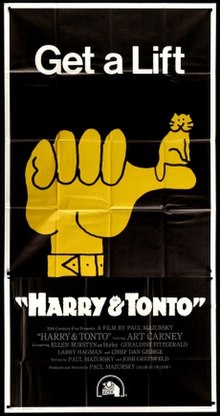
On Aug. 12, 1974 Paul Mazursky's Harry and Tonto (Aug. 12) (20th Cent. Fox) debuts, starring Art Carney (after James Cagney, Laurence Olivier, and Cary Grant turn the part down) as elderly widower Hazrry Coombes, who is evicted from his Upper West Side NYC apt. along with his cat Tonto, and goes on a car journey to Los Angeles, visiting his old sweetheart Jessie Stone (Geraldine Fitzgerald), daughter Shirley Mallard (Ellen Burstyn), and son Eddie (Larry Hagman); does $4.8M box office on a ? budget; Carney wins a best actor Oscar in the face of stiff competition; Get a lift."

On Oct. 1, 1974 Tobe Hooper's The Texas Chainsaw Massacre (Bryanston Pictures) debuts, loosely based on the true story of necrophiliac murderer Ed Gein (1906-84), thrilling movie audiences with its new anti-hero Leatherface (played by Gunnar Hansen), pioneering the use of power tools in the slasher gentre; so gross it's good, getting banned in the U.K. and Germany, making it more popular?; #10 grossing film of 1974 ($30.8M) - fear of the German sausage-making lobby?

On Oct. 2, 1974 Joseph Sargent's The Taking of Pelham 123 (Palomar Pictures) debuts, based on the 1973 John Godey novel about the hijacking of the Lexington Ave. subway line in New York City stars Walter Matthau as Lt. Zachary Garber, Robert Shaw as Mr. Blue, Martin Balsam as Mr. Green, Hector Elizondo as Mr. Grey, and Earl Hindman as Mr. Brown; "We are going to kill one passenger a minute until New York City pays us 1 million dollars"; the soundtrack album by David Shire (1937-) becomes the first CD release by "Film Score Monthly"; refilmed in 2009.

On Oct. 18, 1974 Jack Smight's Airport 1975 ('75) (Universal Pictures) debuts, a sequel to the 1970 film based on the Arthur Hailey novel, starring Charlton Heston as Columbia Airlines Flight 409 (Boeing 747) Capt. Alan Murdock, Efrem Zimbalist Jr. as Capt. Stacy, Karen Black as flight attendant Nancy Pryor, who has to land the plane, and George Kennedy as ground controller Joe Patroni; Helen Reddy plays Sister Ruth, and Gloria Swanson plays herself; #8 grossing film of 1974 ($47.2M on a $3M budget).
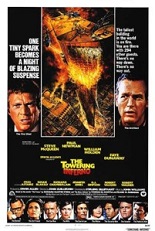
On Dec. 14, 1974 John Guillermin's The Towering Inferno (20th Cent. Fox) (Warner Bros.) (first major Hollywood studio joint feature) debuts, based on the novels "The Tower" by Richard Martin Stern and "The Glass Inferno" by Thomas N. Scortia and Frank M. Robinson about a San Fran skyscraper on fire, starring Paul Newman and Steve McQueen leading an all-star cast incl. William Holden, Faye Dunaway, Fred Astaire, Richard Chamberlain, O.J. Simpson, Robert Vaughn, Robert Wagner, Dabney Coleman, and Jennifer Jones (last film appearance); does $139.7M box office on a $14.3M budget (highest-grossing film of 1974).

On Dec. 15, 1974 Mel Brooks' Young Frankenstein debuts, a comic sendup of the 1818 Mary Shelley novel, starring Gene Wilder as Dr. Baron Friedrich von Frankenstein (that's pronounced "frankensteen"), Marty Feldman as his pop-eyed asst. Igor, Teri Garr as his babe Inga, Cloris Leachman as Frau Blucher, Kenneth Mars as Inspector Kemp, and Peter Boyle as the Creature, who helps Wilder do a great rendition of the Irving Berlin classic Puttin' on the Ritz; #4 grossing film of 1974 ($86.3M).

On Dec. 20, 1974 Francis Ford Coppola's The Godfather: Part II debuts, starring Al Pacino as Michael Corleone, Richard Duvall as Tom Hagen, Diane Keaton as Kay Adams-Corleone, John Cazale as Fredo Corleone, Talie Shire as Connie Corleone, Lee Strasberg as Hyman Roth, Michael V. Gazzo as Frank Pentangeli, Gastone Moschin as Don Fanucci, and G.D. Spradlin as Sen. Pat Geary; one of those rare sequels that are as good as the original; the press material debuts the word "prequel"; #7 grossing film of 1974 ($57.3M); Troy Donahue plays Connie's boyfriend Merle Johnson (his real name); Fredo is murdered in the Fleur Du Lac Mansion on Lake Tahoe, built in 1938 by Henry J. Kaiser to host parties for the grand opening of the Hoover Damn, er, Dam; Gazzo loses the best supporting actor Oscar to De Niro.

In 1974 former Hollywood child star Shirley Temple Black (1928-) is appointed U.S. ambassador to Ghana until 1976, when she becomes the first female U.S. chief of protocol from July 1, 1976 to Jan. 21, 1977, after which in 1984 she becomes the first honorary foreign service officer in U.S. history - after going black with Bo Jangles as a child, she's finally ghana get all the black she wants?

On Feb. 11, 1975 Hal Ashby's Shampoo (Feb. 11) (Columbia Pictures), written by Robert Towne based on hairdresser Jay Sebring (who was murdered by the Manson Family in 1969), set on the eve of the 1968 pres. election stars Warren Beatty as Beverly Hills hairdresser George Roundy, who jumps in every girl's pants in Southern Calif. incl. Jackie Shawn (Julie Christie), Jill (Goldie Hawn), and Felicia Karpf (Lee Grant); the film debut of Debbie Reynolds' daughter Carrie Frances Fisher (1956-2016), making her famous a year before Star Wars; "Now that's what I call fucking" (Jack Warden); "Most of all, I'd like to suck his cock" (Julie Christie); #4 grossing film of 1975 ($49.4M on a $9M budget).
On Apr. 8, 1975 the 47th Academy Awards awards the best picture Oscar for 1974 to Paramount's (Coppola Productions) The Godfather, Part II, along with best dir. to Francis Ford Coppola, and best supporting actor to Robert De Niro (his first Oscar); best actor goes to Art Carney for Harry and Tonto, best actress to Ellen Burstyn for Alice Doesn't Live Here Anymore, and best supporting actress to former black sheep Ingrid Bergman for Murder on the Orient Express.

On May 7, 1975 John Schlesinger's The Day of the Locust (Paramount) debuts, based on the 1939 Nathaniel West novel about amoral pre-WWII Hollyweird, starring Donald Sutherland as accountant Homer Simpson, who lusts after trashy aspiring actress Faye Greener (Karen Black) in the San Bernardino Arms; Burgess Meredith plays washed-up vaudevillian Harry Greener, and William Atherton plays aspiring artist Tod Hackett; does $17.8M box office.

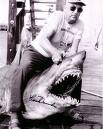
On June 20, 1975 Steven Spielberg's horror-thriller film Jaws (Universal Pictures) debuts, based on the 1974 Peter Benchley novel, starring Roy Scheider as Police Chief Martin Brody, Robert Shaw as shark hunter Quint, and Richard Dreyfuss as oceanographer Matt Hooper, with an ominous shark theme composed by John Williams, becoming Hollywood's first $100M blockbuster ($133.4M U.S. and $470.7M worldwide box office on a $9M budget), and highest-grossing film until "Star Wars" (1977); spawns three sequels, all flops; the robot shark is named Bruce after Spielberg's atty.; "You're gonna need a bigger boat" (Brody); the book and the movie are based on real-life shark fisherman Frank Mundus (1925-2008), skipper of Cricket II; Universal Studios sets up a Jaws exhibit featuring a mechanical shark that menaces the tour bus; watch trailer; watch video.
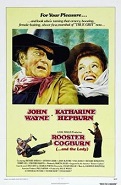
On Oct. 17, 1975 Stuart Millar's Rooster Cogburn (Universal Pictures) debuts, starring John Wayne as an aging 1-eyed U.S. marshal Reuben J. Cogburn in Fort Smith, Indian Territory (Okla.), who has been stripped of his badge by Judge Parker (John McIntire) because he's "gone to seed", and is given one last chance to track some outlaws incl. Hawk (Richard Jordan) and Breed (Anthony Zerbe) while hooking up with spinster Miss Eula Goodnight (Katharine Hepburn); does $17.6M box office on a $10M budget.

On Nov. 6, 1975 Herb Ross' The Sunshine Boys (MGM) debuts, written by Neil Simon based on his 1972 play, launching ageless 79-y.-o. comedian George Burns' solo movie career (after his closest friend Jack Benny is diagnosed with pancreatic cancer), playing Jewish vaudevillian Al Lewis opposite Walter Matthau, who plays his estranged Jewish partner Willie Clark, reuniting for a TV show on the history of comedy; Burns' last film appearance was in 1939; Burns has triple bypass surgery six weeks before filming starts.


On Nov. 19, 1975 Milos Forman's One Flew Over the Cuckoo's Nest (United Artists) debuts, produced by Michael Kirk Douglas (1944-) based on the 1962 Ken Kesey novel and filmed at Oregon State Hospital in Salem, starring Jack Nicholson as two-bit crook Randle Patrick McMurphy, who fakes insanity to get sentenced to a cushy nuthouse, and meets up with mean head nurse (Big Nurse) Mildred Ratched (Louise Fletcher), who gets in a war of wills and finally turns him into a drugged, shocked-out, lobotomized mush-head, after which Big Chief Bromden (Will Simpson) smothers him with a pillow to put him out of his misery, and escapes to Canada; Danny DeVito's breakthrough role as Martini; film debuts of Simpson, Brad Dourif as suicidal Billy Bibbit, and Christopher Lloyd as Jim Taber; wins five Academy Awards (most since "It Happened One Night" in 1934); Kirk Douglas is hurt when his son Michael, the producer, passes him over for Nicholson as too old, since he originated the role onstage; #3 grossing film of 1975 ($46.6M U.S. and $108.98M worldwide on a $3M budget).

On Nov. 24, 1975 L.Q. Jones' A Boy and His Dog, debuts, based on the 1969 Harlan Ellison story, starring Vic (Don Johnson) and his well-read misanthropic telepathic dog Blood in post-apocalyptic SW U.S.

On Feb. 8, 1976 Martin Scorsese's Taxi Driver debuts, written by Paul Schrader, starring mohawk-wearing Robert De Niro as lonely insomniac porn-watching Vietnam vet borderline-psycho New York City taxi driver Travis Bickle, who strikes out with angel babe Betsy (Cybill Shepherd), and tries to save 12-y.-o. runaway child prostitute Iris Steensman from Pittsburgh, played by Alicia Christian "Jodie" Foster (1962-) from a city filled with human scum; becomes a classic for its You Talking to Me Mirror Monologue; shows scenes from Fred Donaldson's 1975 porno flick Sometime Sweet Susan featuring Harry Reems and Shawn Harris; also stars Leonard Harris as pres. candidate Sen. Palpatine, er, Charles Palantine, Albert Brooks in his acting debut as Tom, Peter Boyle as Wizard, and Harvey Keitel as pimp Sport; this is Foster's breakout year, with roles in Bugsy Malone, Freaky Friday, Echoes of a Summer, and The Little Girl Who Lives Down the Lane.
On Mar. 29, 1976 the 48th Academy Awards awards the best picture Oscar for 1975 to United Artists' (Fantasy Films) One Flew Over the Cuckoo's Nest, along with best dir. to Milos Forman, best actor to Jack Nicholson, and best actress to Louise Fletcher; best supporting actor goes to George Burns for The Sunshine Boys, and best supporting actress to Lee Grant for Shampoo; "America's Sweetheart" (first Hollywood movie star) Mary Pickford (1892-1979) receives an honorary award for life achievements after not appearing in a film since 1933 and drinking ever since in her bedroom in her Pickfair mansion, her frail appearance and weak voice at her home-taped interview shocking viewers.
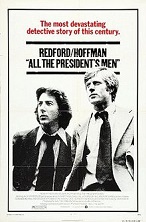
On Apr. 9, 1976 Alan J. Pakula's All the President's Men (Warner Bros.) debuts, based on the 1974 book by Carl Bernstein and Bob Woodward about the Watergate Scandal, starring Robert Redford as Woodward, Dustin Hoffman as Bernstein, and Jason Robards as their boss Ben Bradlee; Hal Holbrook plays Deep Throat; #3 grossing film of 1976 ($70.6M on a $8.5M budget).

On May 18, 1976 Arthur Penn's The Missouri Breaks (United Artists) debuts, starring Marlon Brando as Creedmoor rifle regulator Robert E. Lee Clayton, who is hired by land baron David Braxton (John McLiam) to hunt down bandit Tom Logan (Jack Nicholson) in the Missouri Breaks of NC Mont.; Kathleen Lloyd (film debut) plays daughter Jane Braxton; too bad, too many horses are injured during filming, causing the Am. Humane Assoc. to blacklist it; does $14M box office.

On June 6, 1976 Richard Donner's The Omen (20th Cent. Fox) debuts, based on the David Seltzer novel, starring Harvey Stephens as young 666-birthmarked kid Damien the Antichrist, and Gregory Peck and Lee Remick as his clueless adoptive parents Ambassador Robert and Katherine Thorn; features the theme song Ave Satani by Jerry Goldsmith; #5 grossing film of 1976 ($54.6M U.S. and $60.9M worldwide box office on a $2.8M budget); spawns sequels "Damien: Omen 2" (1978), "The Final Conflict" (1981), and made-for-TV "Omen 4: The Awakening" (1991); remade in 2006 starring Liev Schreiber.

On June 18, 1976 Jack Smight's Midway, debuts, about the Apr. 18, 1942 Doolittle Raid and the June 4-7, 1942 Battle of Midway, featuring a score by John Williams, starring Charlton Heston, Henry Fonda, James Coburn, Glenn Ford, Hal Holbrook, Robert Mitchum, Cliff Robertson, Robert Wagner, Pat Morita, and Toshiro Mifune, whose voice is dubbed by Paul Frees; #9 grossing film of 1976 ($43.2M).

On June 30, 1976 Clint Eastwood's The Outlaw Josie Wales (The Malpaso Co.) (Warner Bros.), based on the 1972 Forrest Carter novel stars Eastwood as Josey, Chief Dan George as Lone Watie, Sondra Locke as Laura Lee, John Russell as Bloody Bill Anderson, and Will Sampson as Ten Bears; does $31.8M box office on a $3.7M budget.

On Aug. 20, 1976 Don Siegel's The Shootist (Paramount Pictures) debuts, based on the 1975 Glendon Swarthout novel, starring John Wayne as aging cancer-stricken gunfighter John Bernard "J.B." Brooks, "the most celebrated shootist extant", who arrives in Carson City, Nev. on Jan. 22, 1901 and laments that the Old West is dying and that he has to have one more gunfight; Lauren Bacall plays widow Bond Rogers, and Ron Howard plays his worshipful son Gillom Rogers; does $13.4M box office; "He's got to face a gunfight once more to live up to his legend once more. To win just one more time."

On Nov. 3, 1976 Brian De Palma's Carrie (United Artists) debuts, based on the 1974 Stephen King novel, starring Sissy Spacek as teenie Carrie White with abusive mother Piper Laurie, who uses her telekinetic powers to get even with everybody at the prom incl. John Travolta, Amy Irving, and Nancy Allen; does $33.8M box office on a $1.8M budget; "It has nothing to do with Satan, Mama. It's me. Me. If I concentrate hard enough, I can move things."

On Nov. 13, 1976 Alfred Sole's Alice, Sweet Alice debuts, starring Mildred Clinton as Mrs. Tredoni and Rudolph Willrich as Father Tom, becoming the film debut of Brooke Shields (1965-) as Karen Spages, who is scared in the warehouse by Alice Spages (Paula E. Sheppard) wearing a grinning mask in the one of the big screen's scariest moments.

On Nov. 20, 1976 John G. Avildsen's Rocky (United Artists) debuts, f ilmed in 28 days with a $1M budget, a corny-but-uplifting rags-to-riches story of an underdog boxing champ in Philly, based on Bayonne, N.J. boxer ("the Bayonne Brawler") Chuck Wepner (1939-) (who went the distance with Muhammad Ali in 1975), and written and starred in by Sylvester "Sly" Stallone (1946-), who also goes from rags to riches when it becomes a blockbuster hit, doing $225M box office on a $1.1M budget; after becoming homeless for three days and selling his dog for $25 because he couldn't afford to feed it, he stands in front of the liquor store for three days waiting for the man to come along, and ends up Gonna Fly Now is nominated for an Oscar; Stallone wrote the script in three days after watching the Ali-Wepner fight, and sells the rights to make the film on the condition that he is cast as the lead, then turns down a $150K offer to let Ryan O'Neal play his part; Stallone loses but nobody remembers?; "His whole life was a million-to-one shot"; "Women weaken legs"; "Yo, Adrian"; "I sat through Rocky at least 40 times, and every time I saw it, I got emotional" (Stallone); the first scene is a fight between Rocky and Spider Rico on Nov. 25, 1975; the pet turtles are Cuff and Link; #1 grossing film of 1976 ($117.2M U.S. and $225M box officed on an $860K budgt).

On Nov. 27, 1976 Sidney Lumet's Network debuts, a satire written by Paddy Chayefsky (1923-81) about the fictional UBS-TV network and the saga of anchor Howard Beale (Peter Finch), a realistic treatment of the post-Winchell profit-motivated TV industry that holds up for decades despite its preposterous moments such as "The Mao Tse-tung Hour" proposal; also stars Faye Dunaway, William Holden, and Robert Duvall; "What's wrong with denouncing the hypocrisies of our times?"; "I'm as mad as hell, and I'm not going to take this anymore!"; "Right now, there is a whole, an entire generation that never knew anything that didn't come out of this tube! This tube is the Gospel, the ultimate revelation. This tube can make or break presidents, popes, prime ministers... This tube is the most awesome God-damned force in the whole godless world, and woe is us if it ever falls into the hands of the wrong people."

On Dec. 17, 1976 John Guillermin's King Kong debuts, a Dino De Laurentiis production starring Jeff Bridges as Jack Prescott, and Charles Grodin as Fred S. Wilson, becoming the film debut of Jessica Phyllis Lange (1949-) as Dwan; #6 grossing film of 1976 ($52.6M U.S., $90M worldwide on a $24M budget).
On Dec. 22, 1976 James Fargo's The Enforcer debuts Clint Eastwood as rules-stretching sexist San Francisco detective Dirty Harry, who fights a group of disgruntled Vietnam vets with his unwelcome new female partner Insp. Kate Moore (Tyne Daly); #8 grossing film of 1976 ($46.2M).
In 1976 the first Toronto Internat. Film Festival (originally the Festival of Festivals until 1994) in Canada is held at the Windsor Arms Hotel by William Marshall, Henk van der Kolk, and Dusty Cohl, with an attendance of 35K; too bad, Hollywood studios withdraw their submissions, then later change their minds, choosing to premiere films there incl. "Chariots of Fire", "The Big Chill", "The King's Speech", "Argo", "Moneyball", "The King's Speech", "Ray", "American Beauty", "Black Swan", and "The Wrestler"; lacking a jury, it only awards the People's Choice Awards each year, starting with "Bad Timing" in 1980, and "Chariots of Fire" in 1982.

On Mar. 12, 1977 French film dir. Roman Polanski (1933-) is indicted by a grand jury in Los Angeles on statutory rape charges over an affair with a 13-y.-o. girl at the home of actor Jack "you can't handle the truth" Nicholson, whom he had directed (and acted with in a cameo) in "Chinatown"; he flees the U.S. in Feb. 1978 after pleading guilty, gets a Calif. judge to arrange a plea bargain, who then reneges on it, and is finally arrested at the Zurich Airport on Sept. 27, 2009 as he flies in for an award at the Zurich Film Festival.
On Mar. 28, 1977 the 49th Academy Awards awards the best picture Oscar for 1976 to Sylvester Stallone's breakthrough United Artists (Robert Chartoff and Irwin Winkler) hit Rocky, along with best dir. to John G. Avildsen; best actor goes to mad-as-hell Peter Finch (b. 1916) (who dies from a heart attack 2 mo. before the ceremony) (first Australian to win for best actor, and first posth. winner, followed by Heath Ledger in 2009), best actress to Faye Dunaway, and best supporting actress to Beatrice Straight for Network (shortest performance ever, 4.5 min.); best supporting actor to Jason Robards for All the President's Men (Robert Redford and Dustin Hoffman are snubbed).

On Apr. 20, 1977 Woody Allen's Annie Hall debuts, co-written by Marshall Brickman, becoming his breakthrough film, chronicling the love affair of Manhattan comedian Alvy Singer (Allen) with nightclub singer Annie Hall (Diane Keaton), who answers a personals ad in the New York Review of Books saying "Thirtyish academic wishes to meet woman who's interested in Mozart, James Joyce, and sodomy"; her wardrobe starts a major fashion trend; Tony Roberts plays Woody's best friend Rob; Annie breaks it off and heads for Los Angeles and new lover Paul Simon; "I think that what we have on our hands is a dead shark" (Woody); although it's not a Hollywood film, it launches the careers of future Hollywood stars Jeff Goldblum, Shelley Duvall, Christopher Walken, and Sigourney Weaver; originally written as a murder mystery?; #9 grossing film of 1977 ($38.3M).
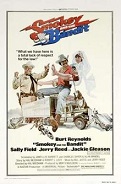
On May 19, 1977 Hal Needham's Smokey and the Bandit (Universal Pictures) debuts, starring Burt Reynolds and Jerry Reed as beer runners Bo "Bandit" Darville and Cledus "Snowman" Snow, along with Sally Field as cute hitchhiker Carrie ("Frog"), who are chased by Sheriff Buford T. Justice of Portague County (Jackie Gleason); the theme song East Bound and Down is by Jerry Reed; #3 film of 1977, grossing $126.7M in the U.S. and $300M worldwide on a $4.3M budget.



Can a new Ruling Fairy Tale save the world, why not try it? On May 25, 1977 the blockbuster film Star Wars by dir.-writer George "the Maker" Lucas (1944-) debuts; ticket price is $2.25; "May the Force be with you" joins the lexicon; the Western world gets a new uber-myth called the Force, which neatly bypasses the Bible and other organized religions without directly dissing them and even paying homage to their common grounding in ancient myths, while enshrining Science and Technology firmly above all possible Inquisitions; $4.5B of Star Wars merchandise is eventually sold (about what the U.S. spends each year on its real Star Wars program by the 21st cent.); Star Wars (Episode 4 of 6: A New Hope) (with 60 SFX shots) morphs sci-fi into the comic book realm, with dime-store philosophy added for emphasis to create a near-religious consumer cult (if only they can find a power source for all those gizmos and ships?); Luke Skywalker, Princess Leia, Obi-Wan Kenobi, Han Solo, the Wookie, the Millennium Falcon ("make it look like a hamburger" - Lucas), Darth Vader, Storm Troopers; Carrie Fisher gets the part of Princess Leia after first choice Jodie Fisher can't get out of her Disney contract; Sir Alec Guinness plays Obi-Wan Kenobe, and talks Lucas into killing him off because he hates the psychobabble lines, but makes a mint, allowing him to pick and choose roles; James Earl Jones makes $7K for his voiceover role as Darth Vader after Orson Welles is turned down for having a voice that is too recognizable; Lucas has to beg 20th Cent. Fox for more money for special effects, but he scores big by retaining ownership of the 6-film series and merchandising; #1 grossing film of 1977, with $460.9M at the domestic box office and $798M worldwide, becoming the most popular film series in history (until ?); spawns 300M Star Wars action figures made by Kenner in 1978-85; "The Force is what gives the Jedi his power. It's an energy field created by all living things. It surrounds us and penetrates us. It binds the galaxy together"; Lucas later utters the soundbyte; "How do democracies get turned into dictatorships? The democracies aren't overthrown; they're given away... Star Wars was really about the Vietnam War."

On June 15, 1977 Richard Attenborough's A Bridge Too Far (United Artists) debuts, based on the 1974 book by Cornelius Ryan about ill-fated WWII Operation Market Garden and filmed in Deventer, Netherlands, starring Dirk Bogarde as Lt. Gen. Frederick "Boy" Browning, Michael Caine as Lt. Col. J.O.E. Vandeleur, James Caan as Staff Sgt. Eddie Dohun, Edward Fox as Lt. Gen. Brian Horrocks, Elliott Gould as Col Robert Stout, Gene Hackman as Maj. Gen. Stanislaw Sosabowski, Anthony Hopkins as Lt. Col. John Frost, Sean Connery as Maj. Gen. Roy Urquhart, Ryan O'Neal as Brig. Gen. James Gavin, and Robert Redford as Maj. Julian Cook; #6 grossing film of 1977 ($50.8M box office on a $25M budget); "Well, as you know, I always felt we tried to go a bridge too far." (Dirk Bogarde)

On Oct. 2, 1977 Fred Zinnemann's Julia debuts, based on Lillian Hellman's 1973 book "Pentimento", starring Jane Fonda as Hellman, whose Jewish friend Julia (Vanessa Redgrave) goes on a dangerous mission to smuggle funds into Nazi Germany; Jason Robards plays Helmman's beau Dashiell Hammett, and Rosemary Murphy plays Dorothy Parker; the film debut of Meryl (Mary Louise) Streep (1949-); does $20.7M box office on a $7.8M budget.


On Nov. 16, 1977 Steven Spielberg's Close Encounters of the Third Kind is a quantum leap in sci-fi, starring Richard Dreyfuss as Roy Neary, Teri Garr as his wife, Melinda Dillon as a fellow believer, and French-speaking dir. Francois Truffaut as the govt. scientist investigating visiting ETs, who talk in lights and music; makes Devil's Tower Nat. Monument famous; #2 grossing film of 1977 ($128.2M); first in a string of blockbusters by Steven Allan Spielberg (1946-); now aliens are intelligent, friendly, and just wanting to communicate and make friends.
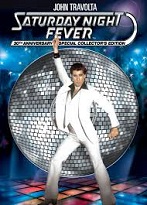


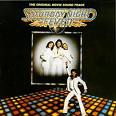
On Dec. 14, 1977 John Badham's Saturday Night Fever (Paramount Pictures) debuts, (a dancical, with nobody singing?) taking the Disco Craze mainstream, starring John Travolta (1954-) as Brooklyn Bridge-loving "You know I'm a ladies' man by the way I use my walk" Brooklyn 2001 Odyssey disco king Tony Manero, and Karen Gorney as his dancing partner-babe Stephanie, dancing to the definitive disco tunes of the Aussie falsetto "I'm a man, can't you see what I am?" Bee Gees, plus the 1976 instrumental A Fifth of Beethoven by Walter Murphy and the Big Apple Band; based on a New York Mag. story by Nik Cohn; does $? on a $3.5M budget; they practice at the Phillips Dance Studio; the Galaxy 2000 contest awards a $500 first prize; Francine Joy "Fran" Drescher (1957-) in her film debut plays disco bunny Connie ("Are you as good in bed as you are on the dance floor?"); does $237.1M box office on a $3.5M budget; the sequel is Sylvester Stallone's 1983 stink bomb Staying Alive, which proves that disco is dead? which proves that disco is dead?
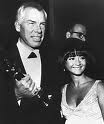
In 1977 Hollywood minor actress Michelle Triola Marvin (1932-2009) sues Hollywood major actor Lee Marvin (1924-87) for "palimony" (a term claimed by her atty. marvin Mitchelson), claiming that she gave up her singing career to shack up with him in 1965-70, and asking for half his $3.6M earnings during that period despite no marriage certificate; on Apr. 18, 1979 Lee is ordered to pay her $104K, and in Aug. 1981 the Calif. appeals court overturns it, leaving her with nada.
On Apr. 3, 1978 the 50th Academy Awards awards the best picture Oscar for 1977 to United Artists' (Jack Rollins and Charles H. Joffe) Annie Hall, along with best dir. to Woody Allen, and best actress to Diane Keaton; best actor goes to Richard Dreyfuss for The Goodbye Girl, best supporting actor and actress to Jason Robards and Vanessa Redgrave for Julia; Margaret Booth (1898-2002) receives an honorary Oscar for film editing, becoming the oldest person to receive one (until ?).

On Apr. 5, 1978 Louis Malle's Pretty Baby debuts, inspired by the Tonny Jackson song and set in 1917 in the Storyville red-light district of New Orleans, starring Keith Carradine as photographer Ernest J. Bellocq, Susan Sarandon as ho Hattie, and 13-y.-o. Brooke Shields in her breakthrough role as her 12-y.-o. daughter Violet, whose virginity she auctions off; does $5.8M box office.

On May 18, 1978 Steve Rash's The Buddy Holly Story debuts, based on the bio. by John Goldrosen, becoming the breakthrough role for William Gareth Jacob "Gary" Busey Sr. (1944-).

On June 16, 1978 Randal Kleiser's Grease (June 16) (Paramount Pictures) debuts, about high school greaser summer love in the 1950s at Rydell High among the T-Birds (Barry Pearl as Doody, Michael Tucci as Sonny LaTierri, Kelly Ward as Putzie) and the Pink Ladies (Stockard Channing as Betty Rizzo, Didi Conn as Frenchy, Jamie Donnelly as Jan, Dinah Manoff as Marty Maraschino) is greased up by John Travolta as Danny Zuko (leader of the T-Birds), and Olivia Newton-John as Sandy Olsson; Eve Arden plays Principal McGee, Sid Caesar plays Coach Calhoun (after Harry Reems is signed and dumped), and Frankie Avalon plays Teen Angel; Sha-Na-Na plays Johnny Casino and the Gamblers; "Fonzie" Henry Winkler declined the role for fear of being typecast, and Marie Osmond declined because she didn't want to turn bad to get the boy; Hoplessly Devoted to You gets nominated for best song Oscar; Frankie Valli sings the Theme Song from Grease (Grease is the Word); You're the One That I Want proves that Travolta can't sing?; #1 grossing film of 1978 ($181.3M U.S. and $396M worldwide on a $6M budget), and highest grossing movie musical until ?; Patricia Birch's lame sequel Grease 2 (1982) substitutes Maxwell Caulfield and Michelle Pfeiffer.



On July 28, 1978 John Landis' National Lampoon's Animal House debuts, about wild Delta House in 1962, becoming a landmark for U.S. baby boomers, making a star of John Belushi (1949-82) as John "Bluto" Blutarsky; the film debut of Kevin Bacon (1958-) as Chip Diller; also stars Stephen Furst as Kent "Flounder" Dorfman, Bruce McGill as Daniel Simpson "D-Day" Day, Tim Matheson as Eric "Otter" Stratton, Tom Hulce as Larry "Pinto" Kroger, Pieter Riegert as Donald "Boon" Schoenstein, and John Vernon as Dean Vernon Wormer; launches Otis Day and the Knights; best ever cinematic food fight?; "Guess what I am now... a zit"; "Knowledge is good"; "Was it over when the Germans bombed Pearl Harbor?"; "Seven years of college down the drain"; #2 grossing film of 1978 ($141.6M).

On Oct. 6, 1978 Alan Parker's Midnight Express (Casablanca Filmworks) (Columbia Pictures) debuts, written by Oliver Stone based on the 1977 book by Billy Hayes and filmed in Malta, starring Brad Davis as young Am. student Billy Hayes, who on Oct. 6, 1970 is caught smuggling hashish out of Turkey, and gets 30 years, ending up in one of their hellhole prisons, finally escaping on Oct. 4, 1975; does $35M box office on a $2.3M budget; goes too far in portraying the Turkish culture as subhuman?; the range-rumping warden is played by Paul L. Smith, and in real life Hayes didn't kill him; the cool Chase: The Midnight Express Theme is by Giorgio Moroder.

On Oct. 25, 1978 John Carpenter's Halloween (Compass Internat.) debuts, a scare flick featuring screaming Jamie Lee "the Body" Curtis as Laurie Strode, and an apocalyptic Donald Pleasance as Dr. Sam Loomis taking on white-masked Michael Myers (b. 1957) (Will Sandin/Tony Moran/Nick Castle) in the most successful independent motion picture to date, costing only $325K to make and becoming the #9 grossing film of 1978 ($47M box office in the U.S. and $70M worldwide).



On Dec. 8, 1978 Michael Cimino's The Deer Hunter (Universal Pictures) debuts, produced by Barry Spikings (1939-), about Russian Orthodox Catholic steel workers from Clairton, Penn. who go to the Vietnam War in 1967 and come back totally messed-up; stars Robert De Niro as S/Sgt. Michael "Mike" Vronsky, John Savage as Steven Pushkov, and Christopher Walken as Cpl. Nikanor "Nick" Chevotarevich, who leave behind friends Stanley "Stosh", played by John Holland Cazale (1935-78) (who has bone cancer), John Welch (George Dzundza), Peter "Axel" Axelrod (Chuck Aspegren), and Linda (Meryl Streep) (who is cast because she was Cazale's babe living with him in New York City, and "They needed a girl between the two guys and I was it"); redefines the Vietnam War in human terms, and makes a star out of ever-wacked-out Ronald Christopher "Ronnie" Walken (1943-), who goes nuts after a controversial Russian roulette scene in a tiger cage prison, playing it for money in Saigon; music by Stanley Myers and John Williams; does $49M box office on a $15M budget.

On Dec. 10, 1978 Richard Donner's Superman: The Movie debuts, starring "Ben Harper in Love of Life" TV soap opera actor (1974-6) Christopher D'Olier Reeve (1952-2004) (who was insured for a record $20M) as the S-Man Clark Kent (who bases his personality on the early Cary Grant), and Margot Ruth Kidder (1948-2018) as his girlfriend Lois Lane; Gene Hackman plays Lex Luthor, and Marlon Brando plays Superman's father Jor-El; #3 grossing film of 1978 ($134.2M U.S. and $300.5M worldwide box office on a $55M budget, most expensive film made to date); sequels incl. "Superman II" (1980), "Superman III" (1983), "Superman IV: The Quest for Peace" (1987), and "Superman Returns" (2006).
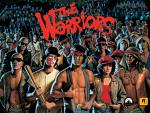
On Feb. 9, 1979 Walter Hill's The Warriors (Paramount Pictures) debuts, based on the 1965 novel by Sol Yurick, a cult film about the street gangs of New York City that is really a remake of Xenophon's "Anabasis" and the 401 B.C. March of the Ten Thousand after their leader Cyrus the Younger was killed in the Battle of Cunaxa, featuring the Warriors gang of Coney Island (known for wearing cool maroon leather vests) on the night of June 21, 1979; stars Michael Beck as warchief Swan, James Remar as Ajax (fingerless gloves), Dorsey Wright as leopard skin do-rag-wearing Cleon (black), Brian Tyler as Snow (black), David Harris as Cochise (black), Tom McKitterick as Cowboy, Thomas G. Waites as Fox (who is thrown underneath a subway train by a cop), Marcelino Sanchez as Rembrandt, Terry Michos as Vermin, Ephraim Benton as Ash (black), and temptingly dirty "don't call me no whore" Deborah Van Valkenburgh as Mercy; Mercedes Ruehl plays a plainclothes cop on a park bench; the Warriors gang is framed for killing gang messiah Cyrus (Roger Hill) of the Gramercy Riffs in Van Cortlandt Park in the Bronx by rival Rogues gang leader Luther (David Patrick Kelly), and forced to fight their way back home through 27 mi. of cops and color-wearing gangs, incl. the bat-swinging Baseball Furies, Hi-Hats, Turnbull AC's, Hurricanes, Saracens, Jones Street Boys, Orphans, Electric Eliminators, Rogues, Destroyers, Panzers, Satan's Mothers, and gun-toting lezzie Lizzies; Lynne Thigpen plays the DJ; Cyrus makes a good point about how the 60K total gang members could rule Gotham if they could work together against the paltry 20K cops; "Warriors, come out to play"; "Maybe you're all just goin' faggot"; "I'm going to shove that bat up your ass and turn you into a popsicle"; does $22.5M box office on a $4M budget; the Warriors Theme (Night Run) is by Philip Marshall; the Furies Chase Theme is by Barry de Vorzon.
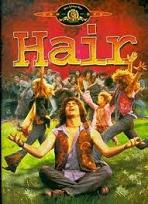
On Mar. 14, 1979 Milos Forman's Hair (United Artists) debuts, written by Michael Weller based on the 1968 Broadway musical by Gerome Ragni and James Rado stars John Savage as Claude Hooper Bukowski, an Okie who arrives in New York City and hooks up with some hippies, incl. Georger Berger (Treat Williams) and Sheila Franklin (Beverly D'Angelo), then has to go to fight in the Vietnam War; does $15.3M box office on a $11M budget.

On Mar. 16, 1979 James Bridges' The China Syndrome debuts, produced by Michael Douglas, starring Jack Lemmon as a nuclear power plant exec with a conscience Jack Godell, and Douglas and James Fonda as TV journalists Richard Adams and Kimberly Wells, who try to get the truth out against the powers that be; the movie that finally proves that the Son of Spartacus can act, and a lucky accident in coming out just a few months before Three Mile Island?; has no musical score except for the credits?; does on a $51.7M box office on a $5.9M budget.
On Apr. 9, 1979 the 51st Academy Awards in Los Angeles, hosted by Johnny Carson (first of 5x) awards the best picture Oscar for 1978 to Universal's (Michael Cimino Productions) The Deer Hunter, along with best dir. to Michael Cimino, and best supporting actor to Christopher Walken; best actor and best actress go to Jon Voight and Jane Fonda for Coming Home, and best supporting actress to Maggie Smith for California Suite.

On June 22, 1979 Don Siegel's Escape from Alcatraz (Paramount Pictures) debuts, based on the 1963 J. Campbell Bruce book about the 1962 Big Escape from Alcatraz, starring Clint Eastwood as Frank Morris, who duels with the warden (Patrick McGoohan) while planning his escape with fellow prisoners Clarence Anglin (Jack Thibeau) and John Angln (Fred Ward); film debut of Danny Glover; does $43M box office on an $8M budget.
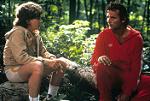
On June 28, 1979 Ivan Reitman's Meatballs debuts, becoming the film debut of Canadian actor-comedian William James "Bill" Murray (1950-), along with child actor Chris Makepeace (1964-) as Rudy "Rabbit" Gerner, in a comedy about low-budget Camp North Star and its rivalry with ritzy Camp Mohawk; "Attention, here' an update on tonight's dinner, it was veal, I repeat veal. Winner of tonight's mystery meat contest is Jeffrey Corvin, who guessed 'some kind of beef'"; the Meatballs Theme is by "Disco Duck" star Rick Dees; spawns several sequels, along with several Reitman-Murray hits incl. "Stripes" and "Ghostbusters".

On Aug. 15, 1979 Francis Ford Coppola's Apocalypse Now debuts, based on Joseph Conrad's 1902 novel "Heart of Darkness", making a star of Martin Sheen (Ramon Gerardo Antonio Estevez) (1940-) as disillusioned Army Capt. Benjamin Willard, who is sent on a mission to travel in a speed boat upriver to Cambodia to assassinate renegade Col. Kurtz (Marlon Brando); the film debut of Laurence "Larry" Fishburne III (1961-); Dennis Hopper plays a hopped-out photographer, with the soundbyte: "What are they going to say, that he was a kind man, that he was a wise man, that he had plans, man?"; Robert Duvall almost steals the show as a bulletproof major playing Wagner to the gooks from an attack heli and shouting, "I love the smell of napalm in the morning"; #3 grossing film of 1979 ($78.8M).
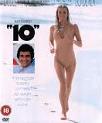
On Oct. 5, 1979 Blake Edwards' 10 debuts, starring cute cuddly English actor Dudley Stuart John Moore (1935-2002) as songwriter George Webber, whose success requires a "10" girl of his dreams (instead of house-garden-kitchen variety Samantha Taylor, played by Julie Andrews), and who just happens to walk by, wearing plaited blonde cornrows, in the form of Jenny Hanley (Bo Derek); too bad, she's a newlwed; "A temptingly tasteful comedy for adults who can count"; #5 grossing film of 1979 ($74.8M) - a hidden interracial sex message is its secret mojo?
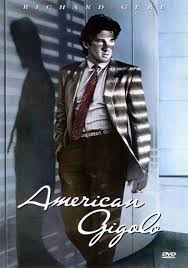
On Feb. 8, 1980 Paul Schrader's American Gigolo (Paramount Pictures) debuts, starring Richard Gere as Beverly Hills boyface midnight cowboy milkshake machine Julian Kaye, who really gets babes instead of male porno theater BJs like Jon Voight in "Midnight Cowboy", but does it for money with old bags, only to get framed for murder; first major Hollywood actor to appear frontally nude in a film; Gere takes the role because of its gay subtext; co-stars gap-toothed Lauren Hutton as politican's wife Michelle Stratton (after Julie Christie and Meryl Streep turn it down); Nina van Pallandt plays client Anne; Hector Elizondo plays LAPD Det. Sunday; does $22.7M box office on a $4.8M budget; makes a hit of Giorgio Armani designer clothes; features the song Call Me by Blondie, with help from songwriter Giorgio Moroder.


On Mar. 7, 1980 Michael Apted's Coal Miner's Daughter (Universal) debuts, based on the 1976 autobio., starring Sissy Spacek as country music star Loretta Lynn, and Tommy Lee Jones as her hubby "Mooney" Lynn, becoming the first in a string of movie hits by English dir. Michael Apted (1941-); "The Band" lead singer-drummer Levon Helm plays Loretta's father; Beverly D'Angelo plays Patsy Cline; does $67M box office on a $15M budget.
On Apr. 14, 1980 the 52nd Academy Awards in Los Angeles are hosted by Johnny Carson and Miss Piggy; best picture Oscar for 1979 goes to Columbia Pictures' Kramer vs. Kramer, along with best actor to Dustin Hoffman, best supporting actress to Meryl Streep (who leaves her Oscar in the waiting room?), and best dir. to Robert Benton; best actress goes to Sally Field for Norma Rae, and best supporting actor goes to Melvyn Douglas for Being There.

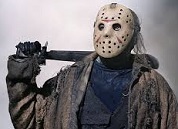
On May 9, 1980 Sean S. Cunningham's Friday the 13th (Paramount Pictures) (Warner Bros.) debuts, introducing undead hockey-masked slasher Jason Vorhees (Ari Lehman) having fun at Camp Crystal Lake in N.J. with six counselors trying to open reopen it 20 years after "accidental" deaths close it; SFX by Tom Savini; does $59.8M box office on a $550K budget; spawns a seemingly endless series of sequels, incl. Part 9: "Jason Goes to Hell: The Final Friday" (1993).



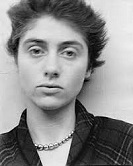

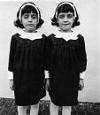
On May 23, 1980 Stanley Kubrick's The Shining (Peregrine Productions) (Hawk Films) (Warner Bros.) debuts, filmed at EMI Elstree Studios in England using the new Steadicam, based on the 1977 Stephen King novel about failed writer Jack Torrance (Jack Nicholson) getting cabin fever at the secluded Overlook Hotel in Colo., really the Timberline Lodge on Mount Hood in Ore. 60 mi. E of Portland during the winter features the great climax where he goes after his family with an axe, crying, "Here's Johnny!"; title is inspired by John Lennon's "Instant Karma" and its line "We all shine on"; Joe Turkel plays creepy Joe the Bartender; the disturbing 1967 photograph Identical Twins, Roselle, N.J. of Lisa and Louise Burns (1968-) by Diane Arbus is used for effect; Danny Lloyd plays the psychic kid who talks with his finger and spouts "Redrum!"; bizarrely skinny scarecrow Shelley Duvall plays his freaked wife, and Scatman Crothers plays psychic vacationing chef Dick Hallorann, who returns to get axed; the photo at the end shows the hotel on July 4, 1921 as "Midnight, the Stars, and You" is being played; "All work and no play make Jack a dull boy"; the film contains numerous codes revealing that Kubrick directed a govt.-backed fake Apollo 11 moon landing based on his experience filming "Doctor Strangelove" (1964) and "2001: A Space Odyssey" (1968)?; it's no surprise that the record for altitude was 853.8 mi. (1,374.1km) for Gemini 11 on Sept. 14, 1966?

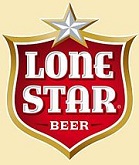
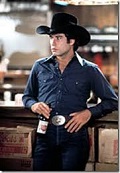
On June 6, 1980 James Bridges' Urban Cowboy (Paramount Pictures) debuts, starring John Travolta as W Tex. hunk Buford Uan "Bud" Davis, who moves in with Uncle Bob (Barry Corbin) in Pasadena (in E Tex. near Houston) for a better job, and spends his spare time at Gilley's (a real-life honky tonk bar on Spencer Hwy. in Pasadena, Tex. founded in 1971 by country singer Mickey Gilley, with the world's largest indoor bar; closes in 1989), hooking up with Sissy (Debra Winger) and fighting with Wes Hightower (Scott Glenn) when he's not riding the mechanical bull El Toro; "Hard hat days and honky-tonk nights"; features country singers Mickey Gilley, Johnny Lee, Charlie Daniels, and Bonnie Raitt; does $53.3M box office; the Urban Cowboy Soundtrack album (#3 U.S., #3 country) features Lookin' for Love by Johnny Lee, Stand by Me by Mickey Gilley, The Devil Went Down to Georgia by the Charlie Daniels Band, Look What You've Done to Me by Boz Scaggs, Could I Have This Dance by Anne Murray, and Love the World Away by Kenny Rogers, launching the Urban Cowboy (Neo-Country) (Hill Boogie) Movement in pop-country music; the beers of the Lone Star Brewing Co. of San Antonio, Tex. (founded 1884) are prominently featured; in 1979 Gilley's Beer was introduced to capitalize on the movie, but it flops in the 1980s.
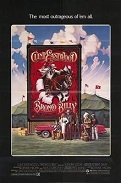
On June 11, 1980 Clint Eastwood's Bronco Billy (Warner Bros.) debuts, starring Eastwood as seedy traveling circus star Bronco Billy McCoy, "the fastest gun in the West", who hires runaway heiress Antoinette Lily (Sondra Locke), who is being chased by wannabe hubby John Arlington (Geoffrey Lewis); does $24.2M box office on a $6.5M budget.

On June 20, 1980 Randal Kleiser's The Blue Lagoon (Columbia Pictures) debuts, based on the 1908 Henry De Vere Stacpoole novel about two children marooned on a tropical South Sea island and falling in organ, er, love, starring hot young teenies Brooke Shields and Christopher Atkins, with a musical score by Basil Poledouris; does $58.8M box office on a $4.5M budget.
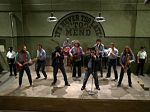
On June 20, 1980 John Landis' The Blues Brothers (Universal Pictures) debuts, starring John Belushi as Joliet Jake Blues, who gets out of Joliet Prison in Ill. and decides to put together his old blues band to save the Roman Catholic home where he and his brother Elwood Blues (Dan Aykroyd) were raised; features a ton of great blues numbers by Cab Calloway (as Curtis), who sings Minnie the Moocher, John Lee Hooker, who sings Boom Boom, James Brown (as Rev. Cleophus James), who sings The Old Landmark, Ray Charles (of Ray's Music Exchange in Calumet City), who sings Shake your Tail Feather, and Aretha Franklin (as Mrs. Murphy), who sings Think, and Respect; Carrie Fisher plays a mystery woman; the Blues Brothers Band incl. Steve "the Colonel" Cropper, Donald "Duck" Dunn, Murphy "Murph" Dunne, Willie "Too Big" Hall, Tom "Bones" Malone, "Blue Lou" Marini, Matt "Guitar" Murphy, and Alan "Mr. Fabulous" Rubin, who perform Rawhide, Stand By Your Man, Sweet Home Chicago, Everybody Needs Somebody to Love, and Jailhouse Rock; does $115M box office on a $30M budget; followed by "Blues Brothers 2000" (1998); on June 18, 2010 the Vatican anoints it as a film with a true Catholic message.
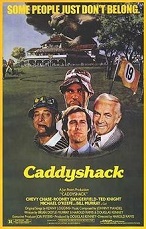
On July 25, 1980 Harold Ramis' Caddyshack (July 25) (Orion Pictures) (Warner Bros.) debuts written by Ramis (his dir. debut), Brian Doyle-Murray (brother of Bill Murray), and "National Lampoon" co-founder Douglas C. Kenney based on the Indian Hill Club in Winnetka, Ill., starring Chevy Chase as Ty Webb, Bill Murray as Carl Spackler, Rodney Dangerfield as Al Czervik, Michael O'Keefe as Danny Noonan, Brian Doyle-Murray as Lou Loomis, and Ted Knight as Judge Elihu Smalls; Murray and Chase had a longstanding feud going back to their days on "Saturday Night Live", and never appear in a film together again; "Some people just don't belong"; filmed at the Boca Raton Hotel and Club in Boca Raton, Fla. and the Rolling Hills Club in Davie, Fla., which doubles for the Midwest because it doesn't have palm trees; the gopher is a puppet operated by John Dykstra; a Baby Ruth candy bar thrown into the swimming pool; Czervik hits Judge Smalls in the groin with a golf ball; on-set cocaine usage is "the fuel that kept the film running" (Peter Berkrot); after opening to poor reviews, becoming a hit only in Denmark, causing Ramis to call it "a $6M scholarship ' to film school", it grosses $39.8M in the U.S. on a $6M budget, spawning the 1988 sequel "Caddyshack II"; Tiger Woods later becomes a fan; too bad, Kenney takes it hard, and commits suicide in Hawaii by jumping off a cliff.

On Aug. 1, 1980 Don Taylor's The Final Countdown debuts, starring Kirk Douglas, Martin Sheen, and James Farentino in a sci-fi flick about a U.S. aircraft carrier that time-travels back one day before the Dec. 7, 1941 Pearl Harbor attack and takes on the Japs; filmed aboard USS Nimitz; brings in $16.6M on a $12M budget.

On Aug. 29, 1980 Armand Mastroianni's He Knows You're Alone (Blood Wedding) debuts, a clone of "Halloween" (1978), starring Caitlin O'Heaney, Don Scardino, and Paul Gleason, becoming the film debut of Thomas Jeffrey "Tom" Hanks (1956-); does $4.88M box office on a $250K budget.

On Sept. 19, 1980 Robert Redford's Ordinary People (Paramount Pictures) debuts, written by Alvin Sargent based on the 1976 Judith Guest novel about an upper-middle-class Lake Forest, Ill. family going down the tubes after eldest brother Buck dies in a boating accident, starring Donald Sutherland as as father Calvin Jarrett, Mary Toothy, er, Tyler Moore as Beth Jarrett, Judd Hirsch Timothy Hutton (acting debut) as suicidal Conrad Jarrett, and Judd Hirsch as pshrink Tyrone C. Berger; Elizabeth McGovern plays Conrad's babe Jeannine Pratt; Redford's dir. debut, winning him his first Oscar; does $54.8M box office on a $6M budget.

On Sept. 26, 1980 Woody Allen's Stardust Memories debuts, starring Woody Allen as famous filmmaker Sandy Bates, whose fans don't like his recent artistic efforts, preferring his "earlier funner movies", chasing intellectual Daisy (Jessica Harper) and maternal Isobel (Marie-Christine Barrault); the film debut of Sharon Yvonne Stone (1958-) as a pretty girl on a train who blows a kiss to the window.
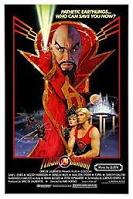
On Dec. 5, 1980 Mike Hodges' Flash Gordon (Universal Pictures) debuts, based on the Alex Raymond comic starring Sam J. Jones (who beats Kurt Russell and Arnold Schwarzenegger for the role) as Flash, Melody Anderson as Dale Arden, Topol as Dr. Hans Zarkov, and Max von Sydow as Emperor Ming the Merciless; features a great soundtrack by Queen; does $27.1M box office in North Am. and $22M box office in the U.K. on a $20M budget.

On Dec. 19, 1980 Colin Higgins' 9 to 5 (Nine to Five) (20th Cent. Fox) debuts, written by Patricia Resnick and Colin Higgins, starring Dolly Parton, Lily Tomlin, and Jane Fonda as secys. whose sexist boss Dabney Coleman lets them humorously enact the women's libber dream of ganging up and 'getting' him; does $103M box office on a $10M budget, incl. $3M on the opening weekend; features Dolly's hit song 9 to 5 (#1 in the U.S.), which she allegedly writes on the set by typing on her fingernails.
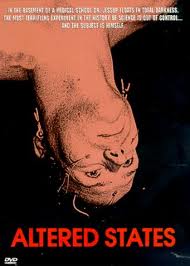
On Dec. 25, 1980 Ken Russell's Altered States (Warner Bros.) debuts, based on the 1978 Paddy Chayefsky novel about the work of LSD/ketamine isolation tank research of John Cunningham Lilly (1915-2001) stirs, er, stars William Hurt (1950-) in his film debut as acid-zonked isolation tank psychoresearcher Edward "Eddie" Jessup, who undergoes an Ayahuasca ceremony in Mexico with Banisteriopsis caapi root, reverses his own evolution, and has cosmic sex with wife Emily Jessup (Blair Brown); also stars Bob Balaban; also the film debut of Drew Barrymore; score by John Corigliano, who loses the Oscar for sound to "The Empire Strikes Back"; dir. William Penn, SFX man John Dykstra, and screenwriter Paddy C. all end up leaving the project; does $19.9M box office on a $15M budget - must have gone outta their minds?



It's Hinckley Day at the Washington Zoo? On Mar. 30, 1981 (Mon.)(2:30 p.m.) after attending a labor event, the Reagan Assassination Attempt sees 69-day U.S. pres. Ronald Reagan shot in the left lung along with three others outside the Washington, D.C. Hilton Hotel by Colo.-based Jodie Foster fetishist John Hinckley Jr. (1955-) using a Rohm RG-14 6-shot .22 blue steel revolver loaded with Devastator brand exploding cartridges (all shots fired); shot #1 hits Reagan's White House press secy. James Scott "Jim" Brady (1940-) in the head, causing permanent brain damage and partially paralyzing him, after which he becomes a er, half-wit, er lobbyist for gun control legislation, getting the 1993 U.S. Brady Handgun Control Act passed, providing for a 5-day waiting period before purchasing handguns to kill politicians with (expires 1998); D.C. police officer Thomas K. Delhanty (1934-) is hit with shot #2 in the back; shot #3 misses and hits a window; shot #4 hits Secret Service agent Timothy J. McCarthy (1949-) in the abdomen after he leaps in front of POTUS, after which he becomes police chief of Orlando Park, Ill.; shot #5 hits the window of the pres. limo; shot #6 hinkleys off the limo into Reagan's left underarm, stopping 1 in. from his heart; Nancy Reagan is at first told he wasn't hit, until Michael Deaver breaks it to her at the hospital, where the glib movie cowboy pres. tells his wife, "Honey, I forgot to duck"; White House campaign strategist Franklyn C. "Lyn" Nofziger (1924-2006) is the first to announce it to the press; all three major U.S. TV networks provide day-long coverage of the incident; U.S. Gen. Alexander Meigs Haig Jr. (1924-2010) stinks himself up by telling reporters "As for now I'm in control here in the White House" (Heil Haig?), then claims "There are absolutely no alert measures that are necessary at this time or contemplated", while in reality defense secy. Cap Weinberger is ordering an alert in case it's a Soviet plot?; Reagan leaves the hospital after 12 days, and addresses Congress to a rousing ovation, helping him get his economics program passed by 238-195 (like Zangara's bad shooting helped FDR in 1933?), with many Dem. defections, which he calls the greatest political win in half a cent.; he fires Haig for being "power-hungry", causing Haig to say that he "isn't a mean man, he's just stupid"; on Aug. 28 Hinckley pleads innocent to charges of attempting to kill Reagan, and is later acquitted by reason of insanity; the shooting turns causes Reagan to lose half his blood and turn white before he can get to the operating room, after which his mental decline begins?
On Mar. 31, 1981 the 53rd Academy Awards awards the best picture Oscar for 1980 to Paramount's (Wildwood Enterprises) Ordinary People, along with best dir. to Robert Redford, and best supporting actor to Timothy Hutton; best actor goes to Robert De Niro for Raging Bull, best actress to Sissy Spacek for Coal Miner's Daughter, and best supporting actress to Mary Steenburgen for Melvin and Howard.
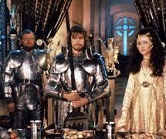
On Apr. 10, 1981 John Boorman's Excalibur (Orion Pictures) (Warner Bros.) debuts, retelling the King Arthur legend in style, starring Nigel Terry as Arthur, Nicol Williamson as Merlin, Cherie Lunghi as Guenevere, Nicholas Clay as Lancelot, Helen Mirren as Morgana Le Fay, Patrick Stewart as King Leondegrance, and Liam Neeson as Sir Gawain; film debut of Irish actor Ciaran (Ciarán) Hinds (1953-) as King Lot; does $35M box office on an $11M budget; features Richard Wagner's Funeral March from "Gotterdämmerung", Act III.


On June 12, 1981 Steven Spielberg's Raiders of the Lost Ark (Paramount Pictures) debuts, becoming a quantum leap in action movies, making Chicago, Ill.-born Harrison Ford (1942-), who plays ophidiophobic (snake-loathing) Indiana Jones (after Tom Selleck turns it down) a household name as he and his colleague Marcus Brody (Denholm Elliott) and Egyptian sidekick Sallah (John Rhys-Davies) (after Danny DeVito turn it down) and feisty jilted girlfriend Marian Ravenwood (Karen Allen) battle rival French archeologist Rene Belloq (Paul Freeman) and a nasty bunch of Nazis incl. Wolf Kahler as sadistic Col. Dietrich, and Ronald Lacy as Maj. Arnold Toht in the 1930s to gain control of the fabled Jewish Ark of the Covenant; Alfred Molina plays Satipo; the first 3 min. has more action than most other movies, and it ramps up from there, exhausting every plot trick and never suffering from a boring moment where people just stand around or walk or talk; George Harris plays Katanga; Terry Richards plays the swordsman whom Indy shoots; the booby-trapped Peruvian temple and Amazonian jungle are portrayed by Kipu Ranch and the Anahola Mts. in Kauai, Hawaii; shot in 73 days for $18M; #1 film of the year, grossing $242M in the U.S. and $389.9M worldwide on an $18M budget; watch trailer.

On June 26, 1981 Ivan Reitman's Stripes (Columbia) debuts, starring Bill Murray, Harold Ramis, John Candy, and Warren Oates in a comedy about boot camp at Ft. Arnold; does $85M box office on a $10M budget.

On July 17, 1981 Steve Gordon's Arthur debuts, starring Dudley Moore as spoiled alcoholic "world's richest playboy" Arthur Bach, who stands to lose everything if he scorns his planned marriage to heiress Susan Johnson (Jill Eikenberry) for poor waitress Linda Marolla (Liza Minnelli), while his butler Hobson (John Gielgud) tries to hold him together; score by Burt Bacharach incl. Arthur's Theme, sung by Christopher Cross; "I race cars. I play tennis. I fondle women, but I have the weekends off and I am my own boss."


On July 17, 1981 Franco Zeffirelli's Endless Love debuts, based on the 1979 novel by Scott Spencer, starring hot Brooke Shields as Jade Buttefield, and Martin Hewitt as David Axelrod, who fall in love after being introduced by Jade's brother Keith (James Spader), becoming the film debut of Tom Cruise (Thomas Cruise Mapother IV) (1962-); does $32.5M box office; the Endless Love Theme by Diana Ross and Lionel Richie is a #1 hit in the U.S., and Ross' best-selling single of her career.
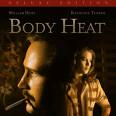
On Aug. 28, 1981 Lawrence Kasdan's Body Heat (The Ladd Co.) (Warner Bros.) debuts, making stars of still-straight-in-Hollyweird William McChord Hurt (1950-) (as Ned Racine) and raspy-voiced Kathleen Turner (1954-) (as Matty Walker) (film debut); Mary Ann Simpson assumes the identity of Matty Tyler to marry a rich man, kill him, get the money, and frame incompetent lawyer Racine after seducing him; Mickey Rourke is an arsonist, and Ted Danson does a soft shoe; Turner, tired of being a vamp on the TV soap "The Doctors" wows Kasdan by staging an impromptu drunk scene and hurling an ashtray?; does $24M box office on a $9M budget; Turner is paid only $27.5K and has to wait tables in New York City for 8 mo. until the movie opens?

On Aug. 21, 1981 John Landis' An American Werewolf in London (PolyGram Pictures) (Gruber-Peters Co.) (Universal Pictures) debuts,, filmed in Wales and Surrey, England, starring David Naughton as David Kessler, and Griffin Dunne as Jack Goodman, two Yank college students who decide to go on a hike in the Yorkshire Moors and get mixed up with werewolves, who kill Jack and turn David into one, after which he is taken to a London hospital where he hooks up with hot Nurse Alex Price (Jenny Agutter); does $62M box office on a $10M budget; followed by "An American Werewolf in Paris" (1997).

On Nov. 28, 1981 (night) 43-y.-o. actress Natalie Wood (b. 1938) (Robert Wagner's wife twice) drowns in a mysterious boating accident off Santa Catalina Island, Calif. after she goes to keep a dinghy from banging against the hull of their yacht Splendour anchored in Isthmus Cove and falls overboard wearing a heavy down-filled coat and wool sweater, drunk on wine; Wagner and Christopher Walken are on board; she dies the day after Thanksgiving during a filming hiatus for the 1983 sci-flick Brainstorm; co-star Christopher Walken and hubby Robert Wagner are aboard the yacht with her.

On Dec. 4, 1981 Warren Beatty's Reds debuts, portraying the life of "Ten Days that Shook the World" author John Reed, his girlfriend Louise Bryant (Diane Keaton), his efforts to start a U.S. Communist Party, and his reporting of the Russian Rev.; Maureen Stapleton plays Emma Goldman; George Jessel (d. 1981) appears as himself in his last screen appearance; Jack Nicholson plays Eugene O'Neill (1888-1953), causing his estranged daughter (since 1943) Oona O'Neill Chaplin to write him a letter saying "Thanks to you, I now can love my father."

On Dec. 18, 1981 Harold Becker's Taps deubts, based on the 1979 Devery Freeman novel "Father Sky" about Bunker Hill Military Academy's war with the Nat. Guard, starring George C. Scott as Brig Gen. Harlan Bache, Timothy Hutton as Cadet Maj. Brian Moreland, Ronny Cox as Col. Kerby, and Tom Cruise as Cadet Capt. David Shawn, and is the film debut of Sean Justin Penn (1960) as Cadet Capt. Alex Dwyer; does $35M box office on a $14M budget.

On Mar. 5, 1982 Barry Levinson's Diner debuts, about a group of Baltimore high school chums meeting at their old Baltimore Fells Point diner in 1959 is a casting coup, with many unknowns who later become stars incl. Kevin Bacon, Mickey Rourke, Steve Guttenberg, and Ellen Barkin; one character obsessively quotes from the 1957 Burt Lancaster-Tony Curtis film "Sweet Smell of Success".


On Mar. 5, 1982 33-y.-o. actor-comedian John Belushi (b. 1949) is found dead of a heroin-cocaine OD at a rented bungalow at the Chateau Marmont on Sunset Strip in Hollywood, Calif.; on Sept. 2, 1986 his babe, backup singer slash groupie Cathy Evelyn Smith (1948-) is sentenced to three years for involuntary manslaughter for injecting him.

On Mar. 16, 1982 Blake Edwards' Victor/Victoria debuts, based on a 1933 script by German dir. Reinhold Schunzel, starring Julie Andrews as a woman impersonating a man impersonating a woman in Depression-era Paris, fooling gay mentor Robert Preston and hetero James Garner, who falls for the woman in her; meanwhile the whole episode causes Alex Karras to realize he's gay - along with half the audience?
On Mar. 29, 1982 the 54th Academy Awards are held in the Dorothy Chandler Pavilion in Los Angeles, Calif., and hosted by Johnny Carson; the best picture Oscar for 1981 is awarded to Enigma Productions' (Ladd Co./Warner Bros.) Chariots of Fire, which beats Raiders of the Lost Ark; best actor and best actress go to aging Henry Fonda and Katharine Hepburn for On Golden Pond (Fonda dies 8 mo. after the film's release) (her 4th best actress Oscar, with the longest time elapsed since the first, for Morning Glory in 1933); best dir. goes to Warren Beatty, and best supporting actress to Maureen Stapleton for Reds, and best supporting actor to Sir John Gielgud for Arthur (who was also in "Chariots of Fire").

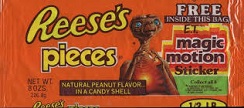
On May 26, 1982 Steven Spielberg's E.T.: The Extra-Terrestrial (Universal Pictures) debuts, written by Melissa Mathison, taking the fright out of aliens from outer space (and, by Hollyweird logic, illegal aliens coming into the U.S.?), and making a star of cute young babe Drew Barrymore (Gertie), along with Dee Wallace (Mary), Henry Thomas (Elliott), and Peter Coyote (NASA man "Keys"); the short cute lovable alien male E.T. is made of brown Play-Do and chicken wire; his voice is produced by elderly Marin County, Calif. heavy smoker Pat Welsh along with Spielberg's sleeping wife with a cold, Debra Winger et al.,; his face is a composite of Carl Sandburg, Ernest Hemingway, and Albert Einstein, and looks like a giant penis, the kind both girls and boys like to kiss?; physicians from the USC Medical Center play the doctors who try to save E.T. after govt. agents take over Elliot's house; a scene starring Harrison Ford as Elliott's elementary school principal is cut; after Mars rejects an offer to use M&Ms, Hershey's Reese's Pieces (introduced 1977) are used, causing sales to zoom by 300%; does $792.9M box office on a $10.5M budget; watch trailer; view clip.

On June 4, 1982 Tobe Harper's Poltergeist (MGM) debuts, co-written by producer Steven Spielberg, starring Heather O'Rourke (1975-88) as 5-y.-o. as Carol Anne Freeling, who begins communicating with a group of spirits led by the Beast via the static on her TV, allowing them to kidnap her, after which parents Steven and Diane Freeling (Craig T. Nelson and JoBeth Williams) call in spiritual medium Tangina Barrons (Zelda Rubinstein) to help rescue her; does $76.6M U.S. and $121.7M worldwide on a $10.7M budget; spawns sequels "Poltergeist II: The Other Side" (1986), and "Poltergeist III" (1988); real human skeletons are used in the swimming pool scene, causing rumors of the Poltergeist Curse on the actors; Heather O'Rourke dies on Feb. 1, 1988 in San Diego, Calif. of heart failure from congenital bowel obstruction and/or Crohn's Disease; watch trailer; view clip.

On June 4, 1982 Nicholas Meyer's Star Trek 2: The Wrath of Khan (Paramount Pictures) debuts, written by Harve Bennett makes up for the disappointing first one with an episode taking off from the popular TV episode "Space Seed", starring Ricardo Montalban as a 20th cent. genetically-engineered superman taking on Capt. Kirk (William Shatner); the ending is made into a cliffhanger when the immortally logical Mr. Spock (Leonard Nimoy) dies because of an overuse of his own logic; does $97M box office on a $11.2M budget.


On June 25, 1982 Ridley Scott's Blade Runner debuts, the first sci-fi film noir, based on the 1968 Philip K. Dick story "Do Androids Dream of Electric Sheep", starring Harrison Ford and Edward James Olmos as 2019 cops Rick Deckard and Gaff, who must track down pesky "replicants", humanoid robots Daryl Hannah ("Pris"), Joanna Cassidy ("Zhora"), Brion James ("Leon Kowalski"), led by Rutger Hauer ("Roy Batty"), who are programmed to die in days and are searching for their maker Eldon Tyrell (Joe Turkel), finally getting to him through his asst. J.F. Sebastian (William Sanderson), only to discover he's a replicant too; meanwhile Deckard falls for replicant Rachael (Sean Young), and has to decide between eloping or terminating her; Deckard is a replicant?; score by Vangelis features Rachel's Song, End Theme.
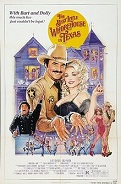
On July 23, 1982 Colin Higgins' The Best Little Whorehouse in Texas (RKO Pictures) (Universal Pictures) debuts, based on the 1978 musical by Larry L. King, starring Dolly Parton as Mona Stangley, madame of the Chicken Ranch in Gilbert, Tex., Burt Reynolds as Sheriff Ed Earl Dodd, Jim Nabors as Deputy Fred, and Charles Durning as the governor; does $69.69M box office on a $20.5M budget.

On July 23, 1982 George Roy Hill's The World According to Garp debuts, based on the 1978 John Irving novel (adapted by Steve Tesich), starring Robin McLaurim Williams (1951-2014) as T.S. Garp, Glenn Close (1947-) (2nd cousin once removed of Brooke Shields) as his extreme feminist mother Jenny Fields (author of "A Sexual Suspect"), and John Arthur Lithgow (pr. LITH-go) (1945-) as Yeti transsexual ex-football player Roberta Muldoon.

On July 28, 1982 Taylor Hackford's An Officer and a Gentleman debuts, a Romeo-Juliet takeoff written by Douglas Day Stewart, starring pretty boy Richard Tiffany Gere (1949-) as U.S. Navy Aviation Officer Candidate Zack Mayo, who meets "Puget Sound Deb" factory worker trailer trash Paula Pokrifki, played by Mary Debra Winger (1953-), and gets what he wants after uttering the soundbyte "I've got nowhere else to go", while she wants more than she can get until she proves she's a hooker with a heart of gold?; makes a star of Louis Cameron Gossett Jr. (1936-) as drill instructor with a heart of gold Marine Gunnery Sgt. Emil Foley; David Keith and Lisa Blount play Gere-Winger duals Sid Worley and Lynette Pomeroy, with the latter being the only one in the flick without a heart of gold?; David Caruso plays whimpy candidate Topper Daniels; despite Gere's reluctance to film it, the final scene, a takeoff on the white knight in shining armor rescuing the princess is a keeper; features the song Up Where We Belong by Buffy Sainte-Marie and Jack Nitzsche, sung by Joe Cocker and Jennifer Warnes.
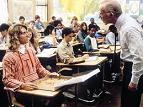

On Aug. 13, 1982 Amy Heckerling's Fast Times at Ridgemont High debuts, based on the Cameron Crowe novel, starring Sean Penn as Calif. surfer dude Jeff Spicoli, who butts heads with teacher "Aloha Mr. Hand" Ray Walston while coping with teen problems in S Calif.; Forest Whitaker's screen debut as Charles Jefferson, a football player whose car gets wrecked; wet dream Phoebe Cates (Phoebe Belle Katz) (1963-) (as Linda Barrett) bares her breasts at a pool; best teen exploitation movie ever?; "When it comes to making out, play side 1 of Led Zeppelin 4"; the dir. debut of Amy Heckerling (1954-).

On Oct. 8, 1982 Hal Ashby's Lookin' to Get Out debuts, starring Jon Voight as Alex Kovac, Ann-Margaret as Patti Warner, and Burt Young as Jerry; the film debut of 7-y.-o. Angelina Jolie Voight (1975-) as Tosh; "What they're doing is insane, immoral, and working."

On Oct. 22, 1982 Ted Kotcheff's First Blood (Oct. 22) (Orion), based on the 1972 novel by David Morrell stars Sylvester Stallone as super badass decorated Vietnam Green Beret vet John Rambo, who is persecuted by Sheriff Will Teasle (Brian Dennehy) of Hope, Wash., and fights back, taking on da world while Col. Sam Trautman (Richard Crenna after Kirk Douglas resigns and Rock Hudson has to pass to undergo heart surgery) tries to reel him in; does $125M box office on a $14M budget; spawns sequels "Rambo: First Blood Part II" (1985), "Rambo III" (1988), and "Rambo" (2008).

On Dec. 8, 1982 Walter Hill's 48 Hrs. (Paramount) debuts, becoming the film debut of Edward Regan "Eddie" Murphy (1961-) as Reggie Hammond, a convict who knows he's black and smart and uses it as a tool and weapon to jerk white San Fran cop Jack Cates (Nick Nolte) and other whiteys around while trying to catch a cop-killer; does $79M box office on a $12M budget.

On Dec. 8, 1982 Alan J. Pakula's Sophie's Choice debuts, based on the 1979 William Styron novel, starring Meryl Streep as 1947 Auschwitz suvivor Sophie Zawistowski, who quietly cracks up from her terrible choice while commiserating with sensitive virgin Southern writer Stingo (Peter MacNicol) and doing it with crazy possessive lover Nathan Landau, played by Kevin Delaney Kline (1947-) (in his film debut) in the Pink Castle in Brooklyn; does $30M box office on a $9M budget; in 1989 Kline marries actress Phoebe Cates (until ?).


On Dec. 17, 1982 Sydney Pollack's Tootsie debuts, starring Dustin Hoffman as an unemployed actor who finds success on a soap opera by pretending to be a woman, getting in love trouble wih Jessica Lange, Teri Garr, and Virginia Elizabeth "Geena" Davis (1956-) (film debut); "What do you get when you cross a hopelessly straight, starving actor with a dynamite red-sequined dress?"

In 1982 TriStar Pictures (originally Tri-Star) is founded by Columbia Pictures exec Victor Kaufman to pool resources with HBO and CBS to lower costs; in 1989 it is acquired by Sony; its logo is Pegasus the flying horse.

On Mar. 4, 1983 Bruce Beresford's Tender Mercies debuts, written by Horton Foote, starring Robert Duvall as alcoholic country singer Mac Sledge, who hooks up with young widow Rosa Lee (Tess Harper in her screen debut); initially underpromoted, it flops until the critics give it rave reviews and it is nominated for five Oscars, winning best screenplay and best actor (his first win).

On Mar. 23, 1983 Jeff Kanew's Eddie Macon's Run (Universal) debuts, based on the 1980 novel by James McLendon, starring Kirk Douglas as cop Marzack, who chases escaped con Eddie Macon (John Schneider), who is helped by bored rich girl Jilly Buck (Lee Purcell); the film debut of St. Louis, Mo.-born John Stephen Goodman (1952-) as Herbert.

On Mar. 25, 1983 Herbert Ross' Max Dugan Returns debuts, based on a Neil Simon comedy, starring Marsha Mason as Nora McPhee, Jason Robards as Max Dugan, and Donald Sutherland as Brian Costello, and is the film debut of his son Kiefer Sutherland (1966-).

On Mar. 25, 1983 Francis Ford Coppola's The Outsiders (Zoetrope Studios) (Warner Bros.) debuts, based on the 1967 coming-of-age Socs-Greasers teen gang novel set in Tulsa, Okla. by teenie author S.E. Hinton, featuring a bevy of outsider future stars incl. Matt Dillon (Dallas "Dally" Winston), Rob Lowe (Sodapop Curtis), Diane Lane (Sherri "Cherry" Valance), Patrick Swayze (Darrel "Darry" Curtis), Tom Cruise (with bad teeth) (Steve Randle), C. Thomas Howell (Ponyboy Curtis), Ralph Maccio (Johnny Cade), and Emilio Estevez (Two-Bit Matthews); does $33.7M box office on a $10M budget.


On Apr. 15, 1983 Adrian Lyne's Flashdance (R-rated) debuts, written by Thomas Heldey Jr. and Joe Eszterhas, starring Jennifer Beals (1963-) as 18-y.-o. welder Alex Owens, who dances at a bar at night and romances her boss Nick Hurley (Michael Nouri) while trying to get into the School of Ballet (by having Marine Jahan, Sharon Shapiro, and Richard Colon do her dancing?); the title song Flashdance (What a Feeling) is sung by Irene Cara (1959-); also incl. hit songs Maniac by Michael Sembello, Gloria by Laura Branigan, and Lady, Lady, Lady by Joe Esposito (songwriter for Donna Summer); first big hit ($93M) for Jewish-Am. producer Jerome Leon "Jerry" Bruckheimer (1945-), who follows it with "Beverly Hills Cop", "Top Gun", "The Rock", "Con Air", "Crimson Tide", "Armageddon" et al.
On Apr. 22, 1983 the 55th Academy Awards in Los Angeles are hosted by Walter Matthau, Liza Minnelli, Dudley Moore, and Richard Pryor; the best picture Oscar for 1982 goes to Columbia's (Indo-British Film Productions) Gandhi, along with best actor to Ben Kingsley, and best dir. to Richard Attenborough; best actress goes to Meryl Streep for Sophie's Choice, best supporting actor to Louis Gossett Jr. for An Officer and a Gentleman (which also wins best tune), and best supporting actress to Jessica Lange for Tootsie.
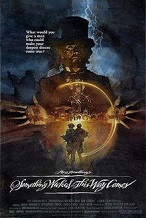
On Apr. 29, 1983 Jack Clayton's Something Wicked This Way Comes (Apr. 29) (Walt Disney Productions) based on the the 1962 Ray Bradbury novel with title taken from Shakespeare's "Macbeth" Act 4 is about two young boys Will Halloway (Vidal Peterson) and Jim Nightshade (Shawn Carson) in Green Town, Ill. who attend Mr. Dark's Pandemonium Carnival, run by Mr. Dark the Illustrated Man (Jonathan Pryce), and meet a collection of freaks intent on taking control of the town and sending innocent souls do Hell; Pam Grier plays the Dust Witch; does $19M box office on an $8.4M budget.

On May 7, 1983 John Badham's WarGames (United Artists) (MGM/UA Entertainment co.) debuts, starring Matthew Broderick (1963-) as Am. teenie computer game hacker David Lightman, who war-dials into the secret U.S. military WOPR supercomputer and almost starts WWII; Ally Sheedy plays his babe Jennifer Mack; Dabney Coleman plays NORAD mgr. John McKittrick, and John Wood plays pterosaur-loving Dr. Stephen Falken; spawns the term "war dialing", causing a mini-scare over the absence of computer security; grosses $80M on a $12M budget (#5); the final launch code is "CPE1704TKS"; does $79.6M box office on a $12M budget watch trailer.
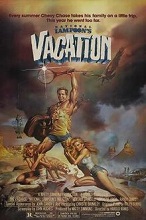
On July 29, 1983 Harold Ramis' National Lampoon's Vacation (Warner Bros.) debuts, starring Chevy Chase as Clark W. Griswold of Chicago, Beverly D'Angelo as his wife Ellen, Anthony Michael Hall as their son Russell "Rusty", and Dana Barron as their daughter Audrey, who set out on a 2,640-mi. automobile trip to Wally World in Calif., "America's Favorite Family Fun Park"; Eddie Bracken plays owner Roy Walley; the film debut of Christie Brinkley as the Girl in the Red Ferrari; does $61.4M box office on a $15M budget, becoming a cult film of the vanishing days of pure white America; spawns "European Vacation" (1985), "Christmas Vacation" (1989), "Las Vegas Vacation" (1997), and "Vacation" (2015).
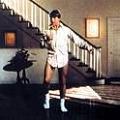

On Aug. 5, 1983 Paul Brickman's Risky Business (Geffen Film Co.) (Warner Bros.) debuts (Brickman's dir. debut), launching the superstar career of Tom Cruise (Thomas Cruise Mapother IV) (1962-), who karaokes in his stain-free jockeys as home-alone teenie Joel Goodsen while wearing Ray-Ban Wayfarer sunglasses, causing a sales boom; about a Porsche, Princeton, Lana (Rebecca De Mornay). and Guido the Killer Pimp (Joe Pantoliano); features the landmark jockey shorts dance scene; does $63.5M box office on a $6.2M budget; watch trailer; watch opening; view clip.

On Sept. 28, 1983 Lawrence Kasdan's The Big Chill debuts, starring Kevin Costner as a never-seen dead man (suicide) whose seven middle-aged 1960s radical friends reunite to remember, finding they've sold out to the system and lost their dreams, incl. Tom Berenger, Glenn Close, Jeff Goldblum, William Hart, Kevin Kline, Mary Kay Place, JoBeth Williams; also stars Meg Tilly.

On Sept. 30, 1983 Douglas Trumbull's Brainstorm debuts, a sci-fi flick starring Christopher Walken as Michael Brace, and Natalie Wood (who dies during filming, causing the production to go into limbo for two years, after which body doubles are used to finish) as his estranged wife Karen, who use the Hat, a device that can record brain sensations, which ends up becoming a freak machine giving visions of Heaven and Hell.
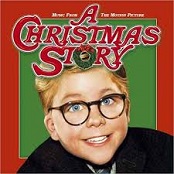


On Nov. 18, 1983 Bob Clark's A Christmas Story (MGM) debuts, based on the 1967 autobio. novel "In God We Trust, All Others Pay Cash" by radio personality Jean Parker "Shep" Shepherd (1921-99) (the narrator), immortalizing B-actor Darren McGavin (1922-2006) in a nostalgic story about the single-minded obsession of 9-y.-o. Am. white boy Ralphie Parker (Peter Billingsley) of Cleveland, Ohio to acquire a Daisy Red Ryder BB gun (Red Ryder Carbine Action 200-Shot Range Model Air Rifle) from Higbee's Dept. Store for Xmas in the boring 1950s despite everybody warning him "You'll shoot your eye out"; Melinda Dillon plays the mommy; he uses his decoder ring to decode the message "Drink your Ovaltine"; does $20.6M box office on a $3.3M budget; features the tongue stuck to pole scene; watch trailer.
+
On Nov. 23, 1983 James L. Brooks' Terms of Endearment debuts, a manipulative tear-jerker based on the 1975 Larry McMurtry novel, starring Shirley MacLaine as Aurora Greenway, Debra Winger as her daughter Emma, Jeff Daniels as Winger's unfaithful college prof. hubby Flap Horton, John Lithgow as bank employee Sam Burns, and Jack Nicholson as brow-cocking playboy Houston neighbor and astronaut Garrett Breedlove; Brooks' debut as screenwriter and dir.; "Come to laugh, come to cry, come to care, come to terms"; followed by "The Evening Star" (1996).

On Dec. 1, 1983 Brian DePalma's Scarface (Universal Pictures) is a remake of the classic 1932 film about Al Capone changing the characters and scenery, starring Al Pacino as human trash Cuban refugee Tony Montana, who "loved the American with a vengeance", and rises to become a mob boss in Miami so he can get white bimbo Elvira Hancock (Michelle Pfeiffer) and all the toys and lifestyle, until he crashes in cocaine-sniffing flames after killing his boss Frank Lopez (Robert Loggia) and partner Manny Ray (Steven Bauer); the film debut of Mary Elizabeth Mastrantonio (1958-) as Tony's sister Gina Montana; the 1906 El Fureidis (Little Paradise) Estate in Montecito, Calif. is used as his home; does $65.9M box office on a $25M budget; "Say hello to my little friend"; watch trailer; view clip.
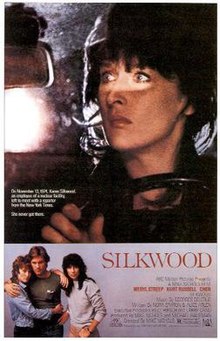
On Dec. 14, 1983 Mike Nichols' Silkwood (20th Cent. Fox) debuts, starring Meryl Streep as Kerr-McGee plutonium plant (Crescent, Okla.) whistleblower Karen Silkwood; does $35.6M box office on a $10M budget; watch trailer.
In 1983 Hal Roach Studios in Calif. pioneers Film Colorization, digitally coloring several Laurel & Hardy features, Frank Capra's "It's a Wonderful Life", and other popular B&W films.
In 1983 Working Title Films is founded in London, England by Tim Bevan and Sarah Radclyffe to produce Am-British TV shows incl. "About a Boy" and "The Tudors", and feature films incl. "Drop Dead Fred" (1991), "Barton Fink" (1991), "Four Weddings and a Funeral" (1994), "The Hudsucker Proxy" (1994), "Dead Man Walking" (1995), "Fargo" (1996), "Bean" (1997), "The Big Lebowski" (1998), "Elizabeth" (1998), "Notting Hill" (1999), "Billy Elliot" (2000), "O Brother, Where Are Thou?" (2000), "40 Days and 40 Nights" (2002), "About a Boy" (2002), "Johnny English" (2003), "Ned Kelly" (2004), "Bridget Jones: The Edge of Reason" (2994), "The Interpreter" (2005), "Pride & Prejudice" (2005), "Nanny McPhee" (2006), "United 93" (2006), "Mr. Bean's Holiday" (2007), "Elizabeth: The Golden Age" (2007), "Atonement" (2008), "Burn After Reading" (2008), "Frost/Nixon" (2008), "Rush" (2013), "Theory of Everything" (2014), "Legend" (2015), "The Danish Girl" (2015), and "Bridget Jones's Baby" (2016).

On Feb. 3, 1984 James Foley's Reckless (MGM/UA) debuts, starring Daryl Hannah as a girl who falls for wrong-side rebel Aidan Quinn; the debut of film composer Thomas Montgomery Newman (1955-), who goes on to a stellar career incl. "Revenge of the Nerds" (1984), "Desperately Seeking Susan" (1985), "Gung Ho" (1985), "Less Than Zero" (1987), "Fried Green Tomatoes" (1991), "Scent of a Woman" (1992), "The Shawshank Redemption" (1994), "Phenomenon" 1995), "American Buffalo" (199), "The Horse Whisperer" (1998), "American Beauty" (1999), "The Green Mile" (1999), "Erin Brockovich" (2000), "Road to Perdition" (2002), "Finding Nemo" (2003), "Cinderella Man" (2005), "Jarhead" (2005), "Revolutionary Road" (2008), "Spectre" (2015), "Passengers" (2016), "Victoria & Abdul" (2017), and "The 15:17 to Paris" (2018); features a weird but memorable dance to "Never Say Never" by Romeo Void.

On Mar. 9, 1984 Ron Howard's Splash (Touchstone Pictures) debuts, starring Tom Hanks as Allen Bauer, who falls in love with a mermaid (Daryl Hannah), who comes out of the water with legs and a female beaver; John Candy plays his older brother Freddie; does $69.8M box office on a $8M budget.

On Mar. 23, 1984 Hugh Wilson's Police Academy debuts, a comedy spoof about a city whose new mayor requires the police academy to admit anybody who applies, starring Steve Guttenberg as Carey Mahoney, Kim Cattrall as Karen Thompson, Bubba Smith as Moses Hightower, G.W. Bailey as Lt. Harris, and Michael Winslow as Larvell Jones; spawns six sequels through 1994.
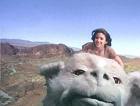
On Apr. 6, 1984 Wolfgang Petersen's The Neverending (NeverEnding) Story (Warner Bros.) debuts, based on the 1979 children's book by Michael Ende, starring Barret Oliver as Bastian Bux, a boy who likes to read, Thomas Hill as bookstore owner Mr. Koreander, who reads from you know what to him, Noah Hathaway as Atreyu, and Tami Stronach as the Childlike Empress, ruler of Fantasia, who is dying because of the Nothing; the most expensive film produced outside the U.S. or Soviet Union (until ?); does $100M box office on a 60DM ($27M) budget.
On Apr. 8, 1984 the 56th Academy Awards are held in the Dorothy Chandler Pavilion, and hosted by Jack Lemmon; the best picture Oscar for 1983 is awarded to the Paramount tear-jerker Terms of Endearment, along with best actress to Shirley MacLaine, best supporting actor to Jack Nicholson, and best dir. to James L. Brooks; best actor goes to Robert Duvall for Tender Mercies, and best supporting actress to cross-dressing Linda Cu, er, Hunt for The Year of Living Dangerously.


On May 4, 1984 John Hughes' Sixteen Candles debuts, starring Molly Ringwald and Anthony Michael Hall achieves cult status among Gen-Xers; the dir. debut of John Hughes Jr. (1950-2009), who goes on to make movies defining the 1980s and 1990s for U.S. teenies.

On June 1, 1984 Leonard Nimoy's Star Trek III: The Search for Spock (Paramount) debuts, featuring the return of Spock's katra to his body; Christopher Lloyd plays Klingon Capt. Kruge; grosses $76M in the U.S. and $87M worldwide on a $16M budget.

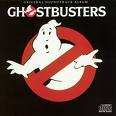
On June 8, 1984 Ivan Reitman's Ghostbusters debuts, starring Bill Murray as Dr. Peter Venkman (after Steven Guttenberg turned down the part to star in "Police Academy"), Dan Aykroyd as Dr. Raymond Stantz, and Harold Ramis as Dr. Egon Spengler, three parapsychologists who save New York City from evil spirit Zuul, who inhabits the body of Dana Barrett (Signourney Weaver), and leads them to ancient Sumerian god Gozer the Gozerian; followed by Ghostbusters II in 1989, and Ghostbusters III in 2012; the Ghostbusters Theme by Ray Parker Jr. becomes a hit, and is successfully sued by Huey Lewis for similarities to his 1983 hit "I Want a New Drug".

On June 22, 1984 John G. Avildsen's The Karate Kid (Columbia) debuts, starring Ralph Macchio as Daniel-san, a boy seito being taught martial arts mastery through household chores by his wise sensei Mr. Kesuke Miyagi, played by Noriyuki (Pat) Morita, who catches flies with chopsticks and teaches "wax on right hand, wax off left hand"; Morita's "crane kick" in the finale turns on a generation of young fans, and the film grosses $91M on a $8M budget, leading to three sequels, The Karate Kid, Part II (1986), The Karate Kid, Part III (1989), and The Next Karate Kid (1994).

On Aug. 10, 1984 John Milius' Red Dawn (MGM/UA) debuts, starring Patrick Swayze, C. Thomas Howell, Charlie Sheen, Lea Thompson, and Jennifer Grey as the Wolverines, Am. teenie freedom fighters taking to the mountains and resisting Russian-Cuban Commies after they invade Colo.; the first film rated PG-13, most likely for its jingoistic pro-Americanism (proof that the Hollywood Blacklist was right?); mini-muscleman William Smith, the B-actor with the most generic name in Hollywood is good as a Russian officer, proving he can out-act Ahnuld; does $38M box office on a $17M budget; refilmed in 2012.

On Sept. 21, 1984 Robert Benton's Places in the Heart (TriStar Pictures) debuts, starring Sally Field as 1935 Waxahachie, Tex. widow Edna Spalding, who tries to save the family farm with the help of blind white man Mr. Will, played by John Gavin Malkovich (1953-) (feature film debut) and black drifter Moze (Danny Glover); features a performance by Western Swing fiddler Cliff Bruner; does $34.9M box office on a $9.5M budget.



On Oct. 26, 1984 James Cameron's The Terminator (Orion Pictures) debuts, twisting the Orwell 1984 theme into a vision of machines becoming Big Brother, launching the action movie career of Austrian-born speech-challenged steroid-soaked model-stretching-to-be-actor Arnold Schwarzenegger (Ahnuld) (1947-) (after first choice Lance Henriksen is passed-over), who plays an over-the-top cyborg (robot Frankenstein?), with a total of only 21 lines and 133 words, incl. the one-liner "I'll be baaack"; co-stars Michael Biehn as time-traveling hero Kyle Reese, and Linda Hamilton as innocent LA waitress Sarah Connor, mother of the future savior of humanity; Paul Winfield and Lance Henriksen play doomed cops Ed Traxler and Hal Vukovich; does $78.3M box office on a $6.5M budget, and spawns sequels T2 (1991) and T3 (2003); makes a star of actor Ahnuld and Ont., Canada-born dir. James Francis Cameron (1954-); another original choice for the Terminator was O.J. Simpson, but Cameron thought nobody would buy this loveable football hero as a killer?; a big moneymaker for Hemdale Film Corp., owned by British-born John Daly (1937-2008), who tried to get the movie stopped with the exploding truck, but fortunately lost?

On Nov. 8, 1984 Wes Craven's A Nightmare on Elm Street (New Line Cinema) debuts, set in fictional Springwood, Ohio, starring Robert Englund as fedora-wearing razor-fingered-glove nightmare slasher Freddy Krueger, becoming a big hit for New Line Cinema, spawning six sequels; does $25.5M box office on a $1.8M budget; the feature film debut of Owensburg, Ky.-born John Christopher "Johnny" Depp II (1963-); "If Nancy doesn't wake up screaming, she won't wake up at all."

On Dec. 5, 1984 Martin Brest's Beverly Hills Cop debuts, making a star of Eddie Murphy, who plays Detroit cop Axel Foley; features the Axel Foley Theme.

On Dec. 14, 1984 Francis Ford Coppola's The Cotton Club (Orion Pictures)debuts, starring Richard Gere as jazz musician Dixie Dwyer, who falls for Vera Cicero (Diane Lane), moll of gang boss Dutch Schultz (James Remar), while his younger brother Vincent Dwyer (Nicolas Cage) joins his mob; Gregory Hines plays dancer Delbert "Sandman" Williams; Bob Hoskins plays Cotton Club owner er, Owney Madden; flops, doing $25.9M box office on a $58M budget.

On Dec. 14, 1984 David Lynch's Dune debuts, based on the 1965 Frank Herbert novel set in 10191, starring Kyle MacLachlan as messiah (Kwisatz Haderach) Paul Atreides, who leads the Fremen of the desert planet Dune to victory over the evil House Harkonnen; stars Jose Ferrer as Padishah Emperor Shaddam Corrino IV, Jurgen Prochnow as Duke Leto Atreides, Sian Phillips as Bene Gesserit Rev. Mother Gaius Helen Mohiam, Richard Jordan as Duncan Idaho, Dean Stockwell as Dr. Wellington Yueh, Max von Sydow as Dr. Kynes, Freddie Jones as Thufir Hawat, Linda Hunt as the Shadout Mapes, Alicia Witt as Alia, and Sting as Feyd-Rautha; features a soundtrack by Toto; a cerebral movie with a gross-out scene that is taken as homophobic, it gets panned by Roger Ebert as "the worst movie of the year", grossing $31M worldwide on a $40M budget, causing plans for sequels to be canceled.



On Feb. 8, 1985 Peter Weir's Witness (Paramount Pictures) debuts, starring Harrison Ford as hunky Philly Det. Capt. John Book, who hides out from his own force on an Amish farm in Penn. with sexy but inhibited Rachel Lapp (Kelly McGillis) and her brat Samuel Lapp (Lukas Haas), rubbing up against her hunky beau Daniel (Alexander Godunov the defected Russian ballet dancer); McGillis gets hot after the release (if not in the film), allowing her to get her big part with Tom Cruise in the this-is-gonna-sound-like-a-bad-joke "Top Gun"; in 2009 she announces that she's turned lez; does $68.7M box office on a $12M budget.

On Feb. 15, 1985 John Hughes' The Breakfast Club debuts, about a weekend detention class in a suburban high school library (really a super-library, way bigger than any real one) which causes the rich and spoiled to mix with the poor, abused, and scruffy along with Carl the janitor and an elephant lamp, although none still personally see much black skin, although all are basically sorry they're too white?; stars Judd Nelson, Molly Ringwald, Emilio Estevez, Ally Sheedy, and Anthony Michael Hall, who become known as the Brat Pack, a new crop of Gen-X acting stars, many of whom are recycled in "St. Elmo's Fire" (1985) and "Young Guns" (1988); "They only met once but it changed their lives forever."

On Mar. 8, 1985 Peter Bogdanovich's Mask (Universal Pictures) debuts, starring Eric Stoltz as Roy L. "Rocky" Dennis, a boy with elephantiasis (craniodiaphyseal dysplasia), who takes to the Azusa, Calif. biker community; Cher plays his borderline maudlin mother Florence "Rusty" Dennis, Sam Elliott plays her biker beau Gar, and Richard Dysart and Estelle Getty play Rocky's maternal grandparents; does $48.2M box office on a $7.5M budget.
On Mar. 25, 1985 the 57th Academy Awards awards the best picture Oscar for 1984 to Orion's Amadeus, along with best actor to F. Murray Abraham, and best dir. to Milos Forman; best actress goes to Sally Field for Places in the Heart ("I can't deny the fact that you like me, right now, you like me"), best supporting actor to Haing Somnang Ngor for The Killing Fields (1st Asian-Am. and 2nd non-prof. actor to win), and best supporting actress to Dame Peggy Ashcroft for A Passage to India; Stevie Wonder accepts an award in the name of imprisoned South African leader Nelson Mandela, pissing-off the South African govt., which announces on Mar. 26 that the South African Broadcasting Corp. will no longer air Wonder's music.

On May 10, 1985 Hugh Wilson's Rustlers' Rhapsody (Paramount Pictures) debuts, a parody of Western singing cowboy films, starring Tom Berenger as Rex O'Herlihan, who comes alive out of a B&W film; co-stars John Wayne's son Patrick Wayne, Andy Griffith, Fernando Rey, Marilu Henner, and Sela Ward; features Lasso the Moon by Gary Morris (#9 country); does $6M box office on a $15M budget.

On June 14, 1985 John Huston's Prizzi's Honor debuts, based on the 1982 Richard Condon novel, starring Jack Nicholson and Kathleen Turner as mob hitmen who fall in love and are given contracts on each other; Anjelica Huston plays the horny daughter of Mafia Don William Hickey.
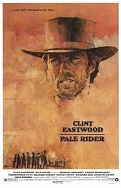
On June 26, 1985 Clint Eastwood's Pale Rider (The Malpaso Co.) (Warner Bros.) stars Clint Eastwood as The Preacher, who rides into the snowy mountain town of Lahood, Calif. and defends a group of prospectors from the thugs of miner Coy LaHood (Richard Dysart) after a prayer by 14-y.-o. Megan Wheeler (Sydney Penny); Carrie Snodgress plays her mother Sarah, and Michael Moriarty plays her beau Hull Baret; does $41.4M box office on a $6.9M budget.
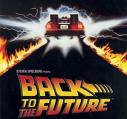
On July 3, 1985 Robert Zemeckis' Back to the Future (July 3) (Amblin Entertainment) (Universal Pictures) debuts, the first of three totally interrelated flicks starring Michael J. Fox as 17-y.-o. Calvin Klein underwear-wearing Marty McFly, Lea Thompson as his mother Lorraine Banes, Crispin Glover as his dad, Thomas F. Wilson as his oafish bullying rival, and Christopher Lloyd as a wacky time travel scientist who invented the flux capacitor and uses it in a nuclear-powered DeLorean, with a great soundtrack by Huey Lewis and The News; Marty travels back from 1985 to 1955 and meets his mom, who falls for him, forcing him to lamely try to get his nerd dad to steal her from him so he can be born; does $381.1M box office on a $19M budget; followed by Back to the Future Part II (Nov. 22, 1989) and Back to the Future Part III (May 25, 1990).
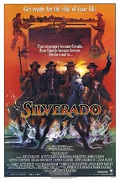
On July 9, 1985 Lawrence Kasdan's Silverado (Columbia Pictures) debuts, about the Wild West town of you know what, starring Kevin Kline as Paden, Scott Glenn as Emmett, Kevin Costner as Jake, Danny Glove as Mal Johnson, and Brian Dennehy as Sheriff Cobb; the score by Bruce Broughton wins a best original score Oscar; does $32.1M box office on a $23M budget.

On July 12, 1985 Joe Dante's Explorers debuts, starring Ethan Green Hawke (1970-) in his film debut as teenie Ben Crandall, who inspires teenie genius Wolfgang Muller, played by River Jude Phoenix (Bottom) (1970-93) in his film debut to invent a spacecraft named Thunder Road out of a Tilt-A-Whirl car, and take off to another galaxy, where they meet some alien kids; also stars Jason Presson as Darren Woods, and Bobby Fite as Steve Jackson.

Everybody wants a piece of the Rock? On July 15, 1985 gaunt, sick-looking, once-hunky Hollywood actor and pretty boy lover Rock Hudson (1925-85) appears at a news conference with actress Doris Day to promote her cable TV program, stirring rumors that he is a h--o with AIDS; on July 21 after treatment with the French drug HPA-23, Hudson collapses at the Paris Ritz; on July 25 a spokeswoman announces that he has AIDS, and is being hospitalized in Paris; the reaction starts a worldwide search for a cure, esp. when he dies on Oct. 2 at his home in Beverly Hills, Calif. at age 59; close friend Elizabeth Taylor rises to the forefront of anti-AIDS fundraising, eventually raising $100M; by 1995 the number of new HIV infections in the U.S. declines from 140K to 40K per year; meanwhile on May 11 the U.S. FDA approves trials of the AIDS drug Isoprinosine, which proves to be a dud.

On Aug. 2, 1985 John Hughes' Weird Science (Universal Pictures) debuts, based on the 1950s EC Comics series, starring Anthony Michael Hall and Ilan Mitchell-Smith as h.s nerds Gary Wallace and Wyatt Donnelly, who create "perfect woman" Lisa ("don't hate me because I'm beautiful" Kelly LeBrock); also stars Robert Downey Jr. and Robert Rusler as bullies Ian and Max; does $38.9M box office; the theme song Weird Science is by Oingo Boingo.
On Oct. 9/10, 1985 Russian-born Am. "The Magnificent Seven" actor Yul Brynner (b. 1920) dies in New York City of lung cancer after smoking his way through 4,625 performances of "The King and I" over 35 years (since 1951); he disinherits his five children, giving his estate to his young 4th wife; "People don't know my real self and they're not about to find out."

On Dec. 13, 1985 Ridley Scott's Legend debuts, starring Tom Cruise as Jack o' the Green, who takes on the Lord of Darkness (Tim Curry) over his babe Princess Lily (Mia Sara), with the magic of the unicorns being the key to the balance between light and darkness; Alice Playten plays evil goblin Blix; cool music by Tangerine Dream; becomes a cult film.
On Dec. 15, 1985 "Rocky" actor Sylvester Stallone (b. 1946) marries "Cobra" co-star Brigitte Nielson (b. 1963); too bad, after everybody tasks her for being a gold digger and she is virtually blacklisted as an actress, they bitterly divorce after 19 mo. in July 1987 before/after she has an affair with Tony Scott; she goes on to have five hubbies and four sons along with an affair with Arnold Schwarzenegger and Sean Penn.

On Dec. 18, 1985 Steven Spielberg's The Color Purple debuts, based on the 1982 Alice Walker novel, starring Danny Glover and Adolph Caesar; the film debut of Oprah Winfrey; the first time that three African-Am. women are nominated for the same film (Whoopi Goldberg, Margaret Avery); score by Quincy Jones.

On Feb. 7, 1986 Woody Allen's Hannah and Her Sisters (Orion Pictures) (his best film?) debuts, beginning and ending with Manhattan Thanksgiving parties two years apart, hosted by actress Hannah (Mia Farrow) and her husband Elliot (Michael Caine), who hooks up with her sister Lee (Barbara Hershey), who lives with old fart Frederick (Max von Sydow); Allen plays Hannah's neurotic hypochondriac TV exec ex-hubby Mickey Sachs, who hooks up with neurotic 3rd sister Holly (Dianne Wiest); Lloyd Nolan and Maureen O'Sullivan play Hannah's show biz parents Evan and Norma; does $59M box office on a $6.4M budget.
On Mar. 24, 1986 the 58th Academy Awards awards the best picture Oscar for 1985 to Universal's Out of Africa, along with best dir. to Sydney Pollack; best actor goes to William Hurt for Kiss of the Spider Woman, best actress to Geraldine Page for The Trip to Bountiful, best supporting actor to Don Ameche for Cocoon, and best supporting actress to Anjelica Houston for Prizzi's Honor, which co-stars her then boyfriend Jack Nicholson; she is so dazed that she forgets to go backstage, and returns to the audience, to find Nicholson crying, along with her father, while she remains "dry as a bone - it was very funny"; Steven Spielberg's The Color Purple gets 11 nominations and 0 wins.

On May 12, 1986 Tony Scott's Top Gun (Paramount Pictures) debuts, based on a mag. article about the U.S. Navy Fighter Weapons (Top Gun) School in Miramar, Calif. is a rock-enhanced jingoistic irresistible ad for the U.S. Navy, starring Ray Ban-wearing Tom Cruise (Thomas Cruise Mapother IV (1962-) as F-14 Tomcat pilot Maverick (Pete Mitchell), Anthony Edwards as his co-pilot Goose, Val Kilmer as rival Ice Man, Tom Skerritt as tough but understanding instructor Viper,and Kelly McGillis as female civilian contractor Charlotte "Charlie" Blackwood, who refuses it in the bathroom but loses it in the elevator and back seat of Cruise's motorcycle; also stars Michael Ironside as instructor Jester; the Kenny Loggins songs Take My Breath Away and Danger Zone make the soundtrack #1 on the Billboard top pop albums chart for five weeks; too bad, acrobatic pilot Art Scholl (b. 1933) dies while doing a flat spin near Carlsbad, Calif.; tagline: "Up there with the best of the best"; "I feel the need, the need for speed."

On June 11, 1986 John Hughes' Ferris Bueller's Day Off (Paramount Pictures) debuts, starring Matthew Broderick as cool cocky hooky-loving 4th wall-breaking Chicago area h.s. senior Ferris Bueller, Cindy Pickett and Lyman Ward as his doting parents, Jennifer Grey as his sister Jeanie, Mia Sara as his hooky-playing babe Sloane Peterson, Alan Ruck as his hooky-playing buddy Cameron Frye, Jeffrey Jones as paranoid principal Edward R. Rooney, and Edie McCloy as his secy. Grace; features the June 5, 1985 game between the Cubs and Braves, a visit to the Art Inst. of Chicago, and the Von Steuben Day Parade, where Broderick lip-syncs Wane Newton's "Danke Schoen" and the Beatles' "Twist and Shout"; features the technopop song Oh Yeah by the Swiss band Yello; listen; Pres. Bill Clinton's favorite movie after "High Noon"; does $70.1M box office on a $5.8M budget; "One man's struggle to take it easy"; "You're still here? It's over. Go home. Go."

On July 25, 1986 Mike Nichols' Heartburn (Paramount Pictures) debuts, based on the 1983 semi-autobio. novel by Nora Ephron about her 2nd marriage to Carl Bernstein and his affair with British PM James Callaghan's daughter Margaret Jay, starring Jack Nicholson (who replaced Mandy Patinkin before filming began) as Washington, D.C. political columnist Mark Forman, and Meryl Streep as his New York City food writer wife Rachel Samstat, who catches him playing around and leaves him while pregnant, then gives him a second chance, only to find out he hasn't changed, leaving him for good; the film debut of South Orange, N.J.-born Kevin Spacey (Fowler) (1959-) as a street thug; the theme song is Coming Around Again by Carly Simon (#18 in the U.S.), along with Itsy Bitsy Spider; does $25M box office on a $15M budget.

On Aug. 8, 1986 Rob Reiner's Stand By Me debuts, a coming-of-age flick based on Stephen King's novella "The Body" about a 1959 Labor Day weekend hike from Castle Rock, Ore. to find dead kid Ray Brower (who was hit by a train), which was originally rejected by all the major studios, starring up-and-coming boy actors River Jude Phoenix (Bottoms) (1970-93) as Chris Chambers, storytelling champ Richard William "Wil" Wheaton III (1972-) as Gordie Lachance (whose football star brother Denny, played by John Cusack was killed in a car accident), Jeremiah "Jerry" O'Connell (1974-) as overweight picked-on Vern Tessio, Corey Scott Feldman (1971-) as Teddy Duchamp, whose daddy burned his ear on a stove, Kiefer Sutherland (1966-) as bully Ace Merrill, and adult narrator Richard Dreyfuss as freelance writer-hence-the-winner Gordie Lachance; features Revenge of Davey "Lardass" Hogan.
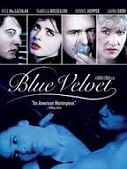
On Sept. 12, 1986 David Lynch's Blue Velvet (Dino De Laurentiis), a weird Lynchian twilight zone flick with an Angelo Badalamenti soundtrack debuts, starring Kyle MachLachlan as Jeffrey Beaumont, who returns from Oak Lake College to his logging hometown of Lumberton, N.C. and finds a severed ear, suspecting Dorothy Vallens (Isabella Rosselini), who sings Bobby Vinton's 1963 hit song you know what at a nightclub; George Dickerson plays detective John Williams, and Laura Dern his daughter Sandy, who hooks up with Jeffrey; Dennis Hopper plays unusually sadistic sexual nutcase Frank Booth, who swears by Pabst Blue Ribbon; Dean Stockwell plays Dorothy's husband Ben; Fred Pickler plays the Yellow Man AKA Det. Tom Gordon; "Do it for van Gogh"; does $8.6M box office on a $6M budget; initially panned by critics, they later call it one of the best films of all time, and it becomes a cult hit.
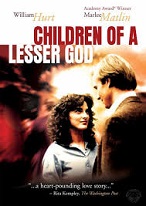
On Oct. 3, 1986 Randa Haines' Children of a Lesser God (Oct. 3) (Paramount Pictues)), based on the 1980 play by Mark Medoff stars Marlee Matlin (film debut) as deaf custodian Sarah Norman, and William Hurt as hearing speech teacher James Leeds at a school for the deaf in New England, who hook up; title comes from Alfred Lord Tennyson's "Idylls of the King", ch. 12: "As if some lesser god had made the world"; does $31.8M box office on a $2M budget.


On Oct. 17, 1986 Martin Scorsese's The Color of Money debuts, a sequel to "The Hustler" (1961) written by Richard Price based on the novel by Walter Tevis, starring Paul Newman as Fast Eddie Felson, who teaches cocky Vincent Lauria (Tom Cruise) the ropes of pool hustling, but he keeps blowing it by showing off, causing Felson to make a comeback; finally wins Newman a best actor Oscar; makes a star of actress Mary Elizabeth Mastrantonio (1958-), who plays Carmen, and Russian-born custom pool cue maker George (Grigory) Balabushka (1912-75).
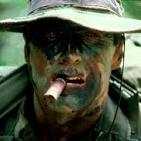
On Dec. 5, 1986 Clint Eastwood's Heartbreak Ridge (Warner Bros.) debuts, written by James Carabatsos, starring Eastwood as aging Marine Gunnery Sgt. Tom Highway, a Korean War Medal of Honor winner who trains recruits at a boot camp for the 1983 invasion of Grenada while courting his ex-wife Aggie (Marsha Mason) and fending off his cmdr. Maj. Malcolm A. Powers (Everett McGill); Mario Van Peebles plays versatile Cpl. Stitch Jones; Peter Koch (film debut) plays Sgt. Swede Johanson; does $121.7M box office on a $15M budget; 1000th film to be released in Dolby Stereo; "My name's Gunnery Sergeant Highway and I've drunk more beer and banged more quiff and pissed more blood and stomped more ass that all of you numbnuts put together"; "Drop your cocks and grab your socks. Off your ass and on your feet. Let's move. Knees to the breeze in 5 minutes"; "You improvise. You adapt. You overcome."
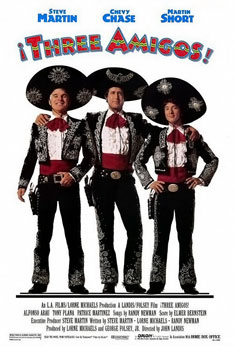
On Dec. 12, 1986 John Landis' Three Amigos! (Orion Pictures) debuts, a spoof starring Chevy Chase, Steve Martin, and Martin Short as unemployed gringo actors Dusty Bottoms, Lucky Day, and Ned Nederlander, who play the Magnificent Seven for laughs, and end up tangling with mean Mexican bandit El Guapo (Alfonso Arau); does $39.2M box office on a $25M budget; features the What Is A Plethora Scene, the Singing Bush Scene, and the Invisible Swordsman Scene.

On Dec. 19, 1986 Oliver Stone's Platoon debuts, starring Charlie Sheen as college-educated Vietnam volunteer Chris Taylor, who joins Bravo Co. 3rd Battalion 22nd Infantry Regiment 25th Div. and learns the facts of life from scarfaced Sgt. Barnes (Tom Berenger) and Sgt. Elias (Willem Dafoe), a G.I. Joe killer Christ complete with crucifixion, recreating the 1968 photo by Art Greenspoon, all to Samuel Barber's "Adagio for Strings"; "The last casualty of war is innocence"; does $138.5M at the box office.

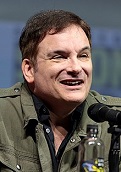
On Mar. 6, 1987 Richard Donner's Lethal Weapon (Mar. 6) (Silver Pictures) (Warner Bros.) debuts, set at Christmastime, starring Danny Glover as "I'm too old for this shit" LAPD homicide sgt. Roger Murtaugh, and Mel Gibson (after Bruce Willis turns it down) as 50-y.-o. LAPD narcotics sgt. Martin Riggs, who lost his wife in a car accident three years earlier and went suicidal, keeping a hollow-point bullet with him to do the job, getting him transferred to homicide, where they soon trade barbs and discover that they're both Vietnam vets; Gary Busey plays bad guy Mr. Joshua; Tom Atkins plays Vietnam vet Michael Hunsaker; does $120.2M box office on a $15M budget; spawns sequels incl. "Lethal Weapon 2" (1989), "Lethal Weapon 3" (1992), and "Lethal Weapon 4" (1998); written by Pittsburgh, Penn.-born UCLA grad Shane Black (1961-), known for stories featuring two main chars. who become friends and trade witty dialogue ("Shane Blackisms"), usually set during Christmas time, going on to write the screenplays for "The Last Boy Scout", "Last Action Hero", and "The Long Kiss Goodnight"; watch trailer; view clip; view clip.
On Mar. 31, 1987 the 59th Academy Awards in Los Angeles are hosted by Goldie Hawn, Chevy Chase, and Paul Hogan; best picture Oscar for 1986 goes to Orion's Platoon, along with best dir. to Oliver Stone; best actor goes to Paul Newman for The Color of Money, best actress to Marlee Matlin for Children of a Lesser God, and best supporting actor and actress to Michael Caine and Diane Wiest for Hannah and Her Sisters.

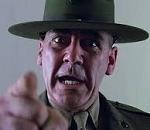
On June 17, 1987 Stanley Kubrick's Full Metal Jacket (Warner Bros.) debuts, based on the 1979 Gustav Hasford novel "The Short-Timers" about USMC recruits at Parris Island and their experience in the Vietnam War Tet Offensive, starring Matthew Modine as Pvt. J.T. "Joker" Davis, who wears a peace sign on his uniform and the words "Born to Kill" on his M1 helmet, and goes on to cover the Tet Offensive for Stars and Stripes; after gaining a record 70 lbs. for the role, Vincent D'Onofrio plays overweight Pvt. Leonard "Gomer Pyle" Lawrence; makes a star of real-life Vietnam War USMC drill instructor R. (Ronald) Lee Ermey (1944-) as Marine Corps Gny. Sgt. Hartman, who punishes raw recruits until they crack or become Marines; does $46.4M box office on a $30M budget.

On June 24, 1987 Mel Brooks' Spaceballs (MGM) debuts, a Star Wars spoof that comes out a decade late, falling a little flat?; stars Rick Moranis as Lord Dark Helmet, Bill Pullman as Lone Star, John Candy as Barfolomew "Barf", and Daphne Zuniga as Princess Vespa; "I bet she gives great helmet"; "Druish princesses are often attracted to money and power, and I have both"; "Oh my God, it's Mega Maid. She's gone from suck to blow"; does $38M box office on a $22.7M budget; watch trailer; view clip.


On Aug. 21, 1987 Emile Ardolino's Dirty Dancing debuts, dir. by openly gay dir.-producer Emile Ardolino (1943-93), written by Eleanor Bergstein, and choreographed by Kenny Ortega lets Patrick Swayze (as Johnny Castle) show off his ballet training with Jennifer Grey (as 17-y.-o. Jewish princess Frances "Baby" Houseman) (who starred with him in survival flick "Red Dawn") at a summer resort in 1963 in the Catskill Mts. of N.Y., making Swayze a star as it becomes one of the #1 chick flicks of all time, earning $300M worldwide; like "An Officer and a Gentleman", it wins a best song Oscar, for (I've Had) The Time of My Life by Bill Medley and Jennifer Warnes; the dancing finale features Johnny holding Frances up high after rescuing her from her daddy Jerry Orbach with the soundbyte "Nobody puts Baby in a corner."

On Sept. 18, 1987 Adrian Lyne's Fatal Attraction debuts, scaring millions with its portrayal of scorned lover Alex Forrest (Glenn Close) stalking married New York City atty. Dan Gallagher (Michael Douglas), and boiling pet bunny Whitey, with his wife Beth (Anne Archer) caught in the middle; "I'm not going to be ignored, Dan."
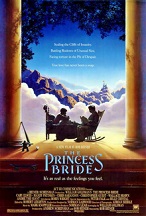
On Sept. 25, 1987 Rob Reiner's The Princess Bride (Sept. 25) (20th Cent. Fox) debuts, based on the 1973 William Goldman novel, starring Fred Savage, who is sick in bed, and Peter Falk as his grandfather, who reads to him from a fairy tale book the story of Buttercup (Robin Wright) of Florin, whose farmhand Westley (Cary Elwes), who likes to say "As you wish", and ends up engaged to Prince Humperdinck (Chris Sarandon) while he is out seeking his fortune to become worthy of her, and gets kidnapped by Sicilian criminal genius Vizzini (Wallace Shawn), who likes to say "Inconceivable!", Spanish fencing master Inigo Montoya (Mandy Patinkin), who likes to say "My name is Inigo Montoya, you killed my father, prepare to die!", and giant Turkish wrestler Fezzik (Andre the Giant); does $30.9M box office on a $16M budget, going on to become a cult film; the script is full of great quotes, incl.: "Life isn't fair, it's just fairer than death, that's all"; "Inconceivable - You keep using that word. I do not think it means what you think it means"; "Do I love you? My God, if your love were a grain of sand, mine would be a universe of beaches"; watch trailer; watch video.

On Nov. 25, 1987 John Hughes' Planes, Trains and Automobiles (Paramount Pictures) debuts, starring Steve Martin as marketing exec Neal Page, who meets shower curtain ring salesman Del Griffith (John Candy) and gets into a 3-day odyssey trying to get home from New York City to Chicago in time for Thanksgiving dinner; does $49.5M box office on a $30M budget.
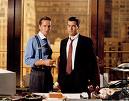
On Dec. 11, 1987 Oliver Stone's Wall Street (20th Cent. Fox) debuts, starring Charlie Sheen as young stockbroker Bud Fox, who hooks up with "Greed is Good" advocate Gordon Gekko (Michael Douglas), and goes down the tubes; hot Daryl Hannah plays Fox's trophy bed partner Darien Taylor; Richard Gere later kicks himself for turning down the part, like John Travolta did for passing up his parts in "An Officer and a Gentleman" and "American Gigolo"; does $43.8M box office on a $15M budget.

On Jan. 15, 1988 Barry Levinson's Good Morning, Vietnam (Buena Vista Pictures) debuts, starring Robin Williams as Saigon DJ Adrian Cronauer (1938-), who delivers high wit ad-libs while questioning the war at the expense of flack from the brass, and chases a Vietnamese girl whose brother is a Viet Cong; "Time to rock it from the Delta to the DMZ"; also features J.T. Walsh and Bruno Kirby; does $123.9M box office on a $13M budget; "You don't know whether you've been shot, fucked, powder-burned, or snakebit."

On Feb. 5, 1988 Philip Kaufman's The Unbearable Lightness of Being debuts, based on the 1984 Milan Kundera novel, starring Daniel Day-Lewis Daniel Michael Blake Day-Lewis (1957-) (son of British poet laureate Cecil Day-Lewis) as horny Czech brain surgeon Tomas in 1968, who gets it on with artist Sabina (Lena Olin) and waitress Tereza (Juliette Binoche) at the same time, after which they suffer through the Soviet invasion of Prague and end up in Switzerland, where the babes strip each other to take pictures without going lez.


On Feb. 13, 1988 Ramon Menendez's Stand and Deliver (Warner Bros.) debuts, based on a true story, starring Edward James Olmos as Bolivian-born teacher Jaime Alfonso Escalante Gutierrez (1930-2010), who makes it cool for Hispanic kids to study calculus in East L.A. barrio Garfield H.S. until they get high marks on the AP exam, only to be treated with white supremacist suspicion and accused of cheating; does $13.9M box office on a $1.6M budget.

On Feb. 16, 1988 John Waters' Hairspray (Palace Pictures) (New Line Cinema) debuts, starring Divine (his last film) as tubby mother Edna Turnblad, Ricki Lake as Edna's daughter Tracy, and Colleen Fitzpatrick as Velma Von Tussle in a zany barely mainstream musical about racism in a TV dance show in 1962 Baltimore, where 60s music is "the only remedy to today's Hit Parade of Hell"; stars Debbie Harry as Velma Von Tussle, Sonny Bono as Franklin Von Tussle, Jerry Stiller as Wilbur Turnblad, Leslie Ann Powers as Penelope "Penny" Pingleton, and John Waters as pshrink Dr. Frederickson; does $8.3M box office on a $2M budget; refilmed in 2007; watch trailer.

On Mar. 30, 1988 Tim Burton's Beetlejuice (Geffen Film Co.) (Warner Bros.) debuts, starring Michael Keaton (Michael John Douglas) (1951-) as poltergeist Betelgeuse, who has fun with recently deceased couple Barbara and Adam Maitland (Geena Davis and Alec Baldwin), who haunt their former home and its new inhabitants Delia, Charles, and Lydia Deetz (Catherine O'Hara, Jeffrey Jones, and Winona Ryder); does $73.7M box office on a $15M box office; "The name in laughter from the hereafter." Watch trailer.
On Apr. 11, 1988 the 60th Academy Awards awards the best picture Oscar for 1987 to Columbia Pictures' The Last Emperor, along with best dir. to Bernardo Bertolucci; best actor goes to Michael Douglas for Wall Street, best actress to Cher, and best supporting actress to Olympia Dukakis for Moonstruck, and best supporting actor to Sean Connery for The Untouchables.
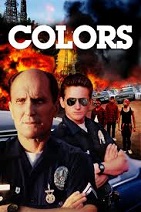
On Apr. 15, 1988 Dennis Hopper's Colors (Orion Pictures) debuts, starring Sean Penn as rookie LAPD CRASH Officer Danny "Pac-Man" McGavin of the LAPD Rampart Div. in gang-ridden South Central Los Angeles and East Los Angeles, Robert Duvall as his veteran partner Officer Bob Hodges, and Maria Conchita Alsonso as Penn's babe Louisa Gomez, showing how the cops are above the law as they take on the Bloods, Crips, and Hispanic street gangs; "Two bulls are up on the hill staring down upon their herd. The young bull says to the old bull, 'Hey let's run down there real quick and fuck one of those cows!' The old bull says 'Nah, lets walk down... and fuck em all'"; $46.6M box office on a $10M budget.


On June 3, 1988 Penny Marshall's Big (Gracie Films) (20th Cent. Fox) debuts, starring Tom Hanks as 13-y.-o. boy Josh Baskin, who is turned by the Zoltar Machine into a man, and has to deal with his boss Mr. MacMillan (Robert Loggia) and girlfriend Susan Lawrence (Elizabeth Perkins); David Moscow plays young Josh; Jared Rushton plays his boy pal Billy Kopecki; Carole Penny Marshall (1943-2018) becomes the first film dir. by a woman to gross $100M at the box Office; Hanks got the role after Steven Guttenberg turned it down; features the big piano playing scene; watch trailer - this Rod Serling clone flick took till the end of the 1980s?

On June 15, 1988 Ron Shelton's Bull Durham (Orion Pictures) debuts, starring Kevin Costner as over-the-hill minor league pitcher Crash Davis, Timothy Francis "Tim" Robbins (1958-) in his breakthrough role as tall dumb promising rookie pitcher Ebby Calvin "Nuke" LaLoosh ("A million dollar arm and a 5-cent head"), and Susan Sarandon as aging baseball groupie Annie Savoy, who beds one lucky plucker each season, and tries her poetry out on Robbins (her real-life partner) while looking over her shoulder at Crash; does $51M box office on a $7M budget; "There's never been a ballplayer who slept with me who didn't have the best year of his career"; "A romantic comedy about America's other favorite pastime."

On June 22, 1988 Robert Zemeckis' Who Framed Roger Rabbit (Touchstone Pictures) (Amblin Entertainment) (Buena Vista Pictures) ("It's the story of a man, a woman and a rabbit in a triangle of trouble") debuts, adapted from "Who Censored Roger Rabbit?" by Gary K. Wold, combining live stars Bob Hoskins, Christopher Lloyd et al. with "toons" in a film noir; the answer is Judge Doom; Roger is a crazed bug-eyed stuttering toon married to a sultry, voluptuous lounge singer in 1940s Los Angeles; "I'm not bad, I'm just drawn that way"; "Listen, my philosophy is this: If you don't have a good sense of humor, you're better off dead"; does $329.8M box office on a $50.6M budget.

On July 12, 1988 John McTiernan's Die Hard (20th Cent. Fox) debuts, based on the 1979 novel "Nothing Lasts Forever" by Roderick Thorp, the sequel to his 1966 novel "The Detective", set on Christmas Eve at the Nakatomi Corp. HQ in Los Angeles, Calif., starring Bruce Willis (after Frank Sinatra, Arnold Schwarzenegger et al. turn it down) as NYPD officer John McClane, who fights a gang of 12 criminals led by Hans Gruber (Alan Rickman) and his henchman Karl (Alexander Godunov) after they take the skyscraper and attempt to steal $640M in bonds then fake their deaths and earn 20%; Bonnie Bedelia plays McClane's wife Holly; Reginald VelJohnson plays Sgt. A. Powell; "Yipee-kai-yay muthafucka"; when Pres. Regan leaves office he gets an office in the same skyscraper; spawns "Die Hard 2" (1990), "Die Hard with a Vengeance" (1995), "Live Free or Die Hard" (2007), and "A Good Day to Die Hard" (2013); "40 stories of sheer adventure"; "Twelve terrorists. One cop. The odds are against John McClane... That's just the way he likes it"; makes Willis an A-lister; does $140.7M on a $28M budget; spawns sequels incl. "Die Hard 2" (1990), "Die Hard with a Vengeance" (1995), "Live Free or Die Hard" (2007), and "A Good Day to Die Hard (2013); view trailer; view clip; view clip; view clip; view clip;

On Aug. 12, 1988 Martin Scorsese's The Last Temptation of Christ (Cineplex Odeon Films) (Universal Pictures) debuts, based on the 1955 Nikos Kazantzakis novel, starring Willem Dafoe as Jesus of Nazareth, who begs to be let off the cross so he can go back to a normal life and have a babe and kids, while a Peter Gabriel score rocks the background?; voice of the Devil by English playwright Leo Marks (1920-2001); its debut stirs bitter protests from humorless Christians - by 2006 Dan Brown's flick only gets minor protests? Watch trailer; view clip; view clip; view clip; view clip; view clip.
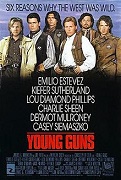
On Aug. 12, 1988 Christopher Cain's Young Guns (Morgan Creek Productions) (20th Cent. Fox), a ripoff of "The Wild Bunch" written by John Fusco and set during the 1877-8 Lincoln County War in N.M. recycles young handsome Brat Packers Emilio Estevez as Billy the Kid, Kiefer Sutherland as Josiah Gordon "Doc" Scurlock, Charlie Sheen as Richard "Dick" Brewer, Lou Diamond Phillips as Jose Chavez y Chavez, and Dermot Mulroney as Dirty Steve Stephens; Terence Stamp plays cattle rancher John Tunstall; does $45.6M box office on an $11M budget; followed by "Young Guns II" (1990).

On Sept. 23, 1988 Michael Apted's Gorillas in the Mist: The Story of Dian Fossey debuts, starring Sigourney Weaver as Am. primatologist Dian Fossey (1932-85), who was brutally murdered in Rwanda while trying to save the gorillas.
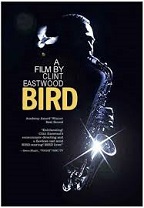
On Sept. 30, 1988 Clint Eastwood's Bird (Warner Bros.), debuts, written by Joel Oliansky and starring Forest Whitaker as Charlie "Bird" Parker, Samuel E. Wright as Dizzy Gillespie, and Diane Venora as Parker's wife Chan; does $2.2M box office on a $14.4M budget.

On Oct. 21, 1988 Donald Petrie's Mystic Pizza debuts, about a pizza parlor in Mystic, Conn. staffed by Julia Roberts, Annabeth Gish, and Lili Taylor as sisters Daisy, Kat, and Jojo Arujo; makes Julia Fiona Roberts (1967-) (sister of Eric Roberts) a star.
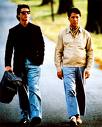
On Dec. 16, 1988 Barry Levinson's Rain Man (United Artists) (MGM) debuts, starring Tom Cruise as self-centered Charlie Babbit, and Dustin Hoffman as his older autistic brother Raymond, based on real-life autistic savant ("living Google") Kim Peek (1951-); it becomes a big hit, taking autism from a virtually unknown ailment to a million diagnoses in 10 years; does $354.8M box office on a $25M budget; "Ten minutes to Wapner"; "K-Mart sucks".

On Dec. 21, 1988 Mike Nichols' Working Girl (20th Cent. Fox), debuts, written by Kevin Wade, a New York City business world Cinderella story starring Melanie Griffith (1957-) (daughter of Tippie Hedren) as Tess McGill, whose scheming faux high-class boss Katharine Parker (Sigourney Weaver) breaks a leg skiing, giving her a free pass to impersonate her and move on up while stealing her boyfriend Jack Trainer (Harrison Ford) and dumping tattooed tomcat boyfriend Mick Dugan (Alec Baldwin); Joan Cusack (as Cyn) plays the sidelines office cheerleader; Philip Bosco plays savior boss Oren Trask, who gives "boney ass" Parker the boot, and a promotion to Tess for the happiest ending for women in the working world ever, albeit the message is that men are still the big boss; "I have a head for business and a bod for sin, is there anything wrong with that?"; "I can't believe it, she's out, she made it out, she got out!"; does $102M box office on a $28.6M budget.

On Dec. 23, 1988 Lawrence Kasdan's The Accidental Tourist (Warner Bros.) debuts, based on the 1985 Anne Tyler novel, starring William Hurt as travel writer Macon Leary, who loses his 12-y.-o. son to a shooter in a fast food restaurant, causing his wife Sarah (Kathleen Turner) to leave him, allowing him to court animal hospital owner Muriel Pritchett (Geena Davis), until she gets jealous and tries to reconcile; Bill Pullman plays his publisher Julian, who falls for Rose Leary (Amy Wyatt).
In 1989 the Disney Renaissance begins (ends 1999), seeing Walt Disney Animation Studios return to blockbuster musical animated films incl. "The Little Mermaid" (1989), "The Rescuers Down Under" (1990), "Beauty and the Beast" (1991), "Aladdin" (1992), "The Lion King" (1994), "Pocahontas" (1995), "The Hunchback of Notre Dame" (1996), "Hercules" (1997), "Mulan" (1998), and "Tarzan" (1999).

On Jan. 26, 1989 Bruce Bereford's Driving Miss Daisy debuts, based on the 1987 Alfred Uhry play, starring Jessica Tandy as old Ga. Jewish woman Daisy Werthan, and Morgan Freeman as her black chaffeur Hoke Colburn.

On Feb. 17, 1989 Stephen Herek's Bill & Ted's Excellent Adventure debuts, starring Keanu Reeves and Alex Winter as S Calif. teenagers Ted Logan and Bill S. Preston, Esq., who travel through time to avoid flunking history, meeting Napoleon (Terry Camilleri), Billy the Kid (Dan Shor), Socrates (Tony Steedman), Sigmund Freud (Rod Loomis), Genghis Khan (Al Leong), Joan of Arc (Jane Wiedlin), Abraham Lincoln (Robert V. Barron), and Ludwig van Beethoven (Clifford David); soundtrack features tracks by Extreme, Tora Tora, Shark Island, and Big Pig; followed by "Bill & Ted's Bogus Journey" (1991).
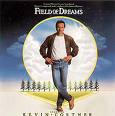
On Apr. 21, 1989 Phil Alden Robinson's Field of Dreams (Universal Pictures) debuts, based on W.P. Kinsella 1982 novel "Shoeless Joe", starring Kevin Costner and Amy Madigan as Iowa corn farmers Ray and Annie Kinsella, who go lala and build a baseball diamond in their corn field to attract the ghost of Shoeless Joe (Ray Liotta) and his 1919 Black Sox team, while black 60s hippy reject Terence Mann (James Earl Jones) (who coined the phrase "Make love nor war", not) helps them find true redemption through baseball; Burt Lancaster plays Dr. Archibald "Moonlight" Graham; a lot of politicians' favorite movie?; does $84.4M box office on a $15M budget.
On Apr. 29, 1989 the 61st Academy Awards awards the best picture Oscar for 1988 to United Artists' Rain Man, along with best actor to Dustin Hoffman, and best dir. to Barry Levinson; best actress goes to Jodie Foster for The Accused, best supporting actor to Kevin Kline for A Fish Called Wanda, and best supporting actress to Geena Davis for The Accidental Tourist.

On June 9, 1989 Peter Weir's Dead Poets Society debuts, starring Robin Williams as 1950s prep school English teacher John Keating, who carps daily to the boys in an extraordinarily lively way, "Carpe Diem, boys, make your life extraordinary."

On June 14, 1989 Spike Lee's Do the Right Thing debuts, starring Lee and Danny Aiello in a comedy about racial tensions in a white-owned pizzeria in Brooklyn's Bed-Stuy section in the hot summer; the feature film debut of Martin Fitzgerald Lawrence (1965) and Rosa Maria "Rosie" Perez (1964-); Barack Obama takes Michelle to see it on their first date; in Aug. 2015 Stuyvesant Ave. between Lexington Ave. and Quincy St. in Bedford-Stuy is official renamed Do the Right Thing Way.

On June 23, 1989 Tim Burton's Batman debuts, starring Michael Keaton as Batman and Jack Nicholson as the Joker in a blockbuster that marks the start of the big budget comic book movie era.
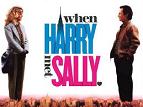
On July 21, 1989 Rob Reiner's When Harry Met Sally debuts, written by Nora Ephron, starring William Edward "Billy" Crystal (1948-) as Harry Burns, and Meg Ryan (Margaret Mary Emily Anne Hyra) (1961-) as Sally Albright, New York City friends who take 12 years to turn into lovers and 3 more mo. to get married; theme song is "It Had to Be You" by Isham Jones (1924); New York Giants fan Harry reads the last page of a novel first; a big hit with white Baby Boomer women for a scene where Ryan fakes an orgasm in a restaurant, after which Rob Reiner's mom utters the soundbyte "I'll have what she's having"; "Men and women can never be friends because the sex part gets in the way" (Harry).

On July ?, 1989 Rospo Pallenberg's Cutting Class debuts, starring Donovan Leitch Jr. (son of Scottish singer Donovan) as problem teen Brian Woods, who gets out of a mental hospital and falls in love with h.s. classmate Paula Carson (Jill Schoelen), babe of Dwight Ingalls (Brad Pitt), after which a string of murders begins; the first major film role for Shawnee, Okla.-born William Bradford "Brad" Pitt (1963-).
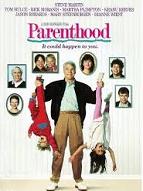
On Aug. 2, 1989 Ron Howard's Parenthood (Universal Pictures) debuts, starring Steve Martin, Tom Hulce, Rick Moranis, Martha Plimpton, Joaquin Phoenix, Keanu Reeves, Jason Robards, Mary Steenburgen, and Dianne Wiest; does $126M box office on a $31M budget.
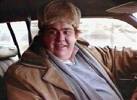
On Aug. 16, 1989 John Hughes' Uncle Buck (Universal Pictures) debuts, starring John Candy as ever-unemployed bachelor slob Buck Russell, who babysits his brother's children Tia (Jean Louisa Kelly), Maizy (Gaby Hoffmann), and Miles (Macaulay Culkin), while juggling his car repair owner girlfriend Chanice Kobolowski (Amy Madigan); does $79M box office on a $15M budget - one of TLW's favorite movies, why?
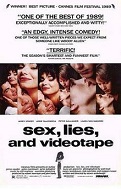
On Aug. 18, 1989 Steven Soderbergh's Sex, Lies, and Videotape (Outlaw Productions) (Miramax Films) debuts, starring Peter Gallagher (after Tim Daly drops out) as Baton Rouge, La. atty. John Mullany, Andie MacDowell (after Elizabeth McGovern's agent turns it down) as his frigid wife Ann Bishop Mullany, James Spader as impotent drifter Graham Dalton, who likes to videotape women telling about their sex fantasies, and Laura San Giacomo as Ann's nympho bartender sister Cynthia Patrice Bishop, who is having an affair with John, causing him to neglect his clients; does $36.7M box office on a $1.2M budget; the debut of Atlanta, Ga.-born dir. Steven Andrew Soderbergh (1963-), who helps found the Independent Cinema Movement; watch trailer.
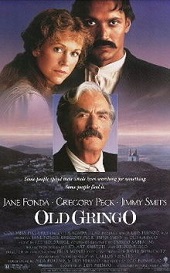
On Oct. 6, 1989 Luis Puenzo's Old Gringo (Columbia Pictures)) debuts, based on the 1985 novel by Carlos Fuentes, starring Gregory Peck as Ambrose Bierce, Jane Fonda as Am. spinster Harriet Winslow, and Jimmy Smits as Pancho Villa's gen. Tomas Arroyo in the 1910 Mexican Rev.; after it is booed in Cannes and Jane Fonda receives a Razzie nominaton for worst actress, it flops, doing $3.5M box office on a $27M budget.

On Nov. 15, 1989 Herbert Ross' Steel Magnolias (Tri-Star Pictures) debuts, based on a 1987 tear-jerker play by Robert Harling (1951-) (who wrote it after his younger sister died) ; it centers around Truvy's Beauty Parlor in NW La., run by Truvy Jones (Dolly Parton), and its customers, incl. Louisa "Ouiser" Boudreaux (Shirley MacLaine), M'Lynn Eatenton (Sally Field), Annelle Dupuy Desoto (Daryl Hannah), Clairee Belcher (Olympia Dukakis), and Shelby Eatenton Latcherie (Julia Roberts) (M'Lynn's daughter); Roberts got the part after Meg Ryan passed it for "When Harry Met Sally"; grosses $96.8M worldwide on a $15M budget.


On Dec. 14, 1989 Edward Zwick's Glory (TriStar Pictures) debuts, based on the book by Lincoln Kirstein and letters by U.S. Civil War Union Col. Robert Gould Shaw, cmdr. of the first all-black Union army co., starring Matthew Brockerick as Shaw, Denzel Washington as Pvt. Trip, and Morgan Freeman as Sgt. Maj. John Rawlins; launches the dir. career of Edward Zwick (1952-), who becomes known for action flicks with a cerebral dimension; does $27M box office on an $18M budget.

On Dec. 20, 1989 Oliver Stone's Born on the Fourth of July debuts, based on his 1976 autobio., starring Tom Cruise as Ron Kovic, who goes from a gung-ho Vietnam War recruit to a paraplegic anti-war protester pissed-off about losing his dream girl Kyra Sedgwick to Kevin Bacon; "A story of innocence lost and courage found."
In the 1990s movie theaters begin using stadium seating, becoming the biggest improvement since color in the 1940s.
In 1990 the U.S. govt.-run Arpanet is decommissioned, and the Internet takes over and goes commercial, immediately being swamped with pornography Web sites, which make big bucks while driving millions of men crazy and ruining marriages and families?; by the late 1990s San Fernando Valley N of the Hollywood Hills in Calif. becomes San Pornando Valley as the porno industry moves in bigtime, generating billions in sales each year (until ?).

On Mar. 2, 1990 John McTiernan's The Hunt for Red October debuts, based on the 1984 Tom Clancy novel, starring Sean Connery as Soviet Capt. Marko Ramius (after he steals the part from Klaus Maria Brandauer), who leads a mutiny to deliver a super sub to the U.S. to forestall WWIII, while CIA analyst Jack Ryan (Alec Baldwin) tries to keep the U.S. from blowing it up; the bizarre non-Russian accents of the lead actors actually make it more gripping?; Scott Glenn plays U.S. sub cmdr. Bart Manucso, Sam Neil plays Soviet Capt. Vasily Borodin, Tim Curry plays chief medical officer Lt. Yevgeniy Petrov, James Earl Jones plays U.S. Adm. James Greer, Richard Jordan plays jellybean-loving U.S. ambassador Jeffrey Pelt, and Joss Ackland plays Soviet ambassador Andrei Lysenko; #6 movie of 1990 ($121M).

On Mar. 23, 1990 Garry Marshall's Pretty Woman (Touchstone Pictures) (Buena Vista Pictures), written by J.F. Lawton debuts, making Smyrna, Ga.-born Julia Fiona Roberts (1967-) (after Molly Ringwald turns it down) into a superstar in the role of Vivian Ward, a pretty Hollywood hooker with a heart of gold, who gets rich dream hunk Edward Lewis (Richard Gere) to give her the fairy tale and let him kiss her on the mouth, despite already naming her price (it's true what they say, opposites attract?); Hector Elizondo continues his habit of showing up in Garry Marshall movies, playing capable Beverly Hills Hotel mgr. Barney Thompson; Jason Alexander plays Gere's schmucky friend Philip Stuckey, and Laura San Giacomo plays Roberts' ho friend Kit De Luca; #4 movie of 1990 ($121M U.S. and $463.4M worldwide box office on a $14M budget).
On Mar. 26, 1990 the 62nd Academy Awards awards the best picture Oscar for 1989 to Warner Bros.' Driving Miss Daisy, along with best actress to Jessica Tandy; best dir. goes to Oliver Stone for Born on the Fourth of July; best actor goes to Daniel Day-Lewis. and best supporting actress to Brenda Fricker for My Left Foot; best supporting actor goes to Denzel Washington for Glory.
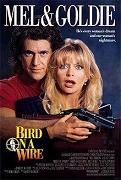
On May 18, 1990 John Badham's Bird on a Wire (Universal Pictures) debuts, a romantic comedy starring Mel Gibson as hunk Rick Jarmin, who has been on the FBI witness protection program for 15 years until his former fiancee Marianne Graves (Goldie Hawn) blows his cover, causing them to go on the run as he hides behind a string of ex-lovers and she chases him; does $138.7M box office on a $20M budget; "He's every woman's dream and one woman's nightmare."
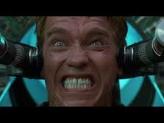
On June 1, 1990 Paul Verhoeven's Total Recall (TriStar Pictures) debuts, based on the 1966 Philip K. Dick story "We Can Remember It For You Wholesale", becoming memorable as one of the few films in which Ahnuld (Arnold Schwarzenegger) can actually almost act (like a comic book char.); his big one-liner here is "Consider that a divorce" as he shoots his double-agent pretend wife, played by Sharon Yvonne Stone (1958-), who steals every scene from him, and makes directors realize that the phony action movie sequences can be done by a beautiful babe instead of a muscular hunk and get higher ratings, spelling the end to Ahnuld's career?; #7 movie of 1990 ($119M U.S. and $261M global box office on a $60M budget); refilmed in 2012.
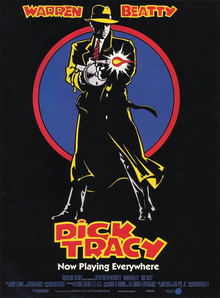
On June 14, 1990 Warren Beatty's Dick Tracy (Touchstone Pictures) (Buena Vista Pictures) debuts, based on the Chester Gould comic strip, starring Beatty as Dick Tracy, Madonna as Breathless Mahoney, 'Glenne Headly as Tess Truehart, William Forsythe as Flattop, Mandy Patinkin as 88 Keys, Paul Sorvino as Lips Manlis, Al Pacino as Big Boy Caprice, R.G. Armstrong as Pruneface, and Dustin Hoffman as Mumbles; #9 movie of 1990 ($104M domestic and $162.7M worldwide box office on a $46M budget).

On July 11, 1990 Renny Harlin's The Adventures of Ford Fairlane debuts, starring Andrew Dice Clay (Andrew Clay Silverstein) (1957-) in his first starring role as a crude-rude-cool "rock & roll detective" in LA; too bad, he becomes a target for the fledgling PC police for sexism, and is banned from MTV, and boycotted by Sinead O'Connor when hosting "Saturday Night Live", after which his career tanks.
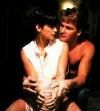
On July 13, 1990 Jerry Zucker's Ghost debuts, written by Bruce Joel Rubin, starring Patrick Swayze as Sam Wheat, a murdered investment consultant coming back in ghost form to protect his lover Molly Jensen (Demi Moore) from a hit; Whoopi Goldberg is medium Oda Mae Brown; the ghost-human love scene at the potters wheel makes the movie the #2 grosser of 1990 ($218M).
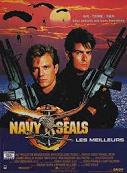
On July 20, 1990 Lewis Teague's Navy SEALs (Orion Pictures), a vague clone of jingoistic "Top Gun" debuts, showing off the macho acts of "Terminator" recycles Michael Biehn and Bill Paxton, plus Charlie Sheen; Joanne Whalley-Kilmer plays a reporter; does $25M box office on a $21M budget; mentioned in Kevin Smith's "Clerks" as the most rented video in the store's history ("most intellectually devoid movies on the rack").

On Sept. 19, 1990 Martin Scorsese's Goodfellas (Warner Bros.) debuts, based on the life of mobster Henry Hill and the 1986 book "Wiseguy" by Nicholas Pileggi, the quintessential flick about the sleazy Italian "wiseguys" of the Lucchese crime family in the 1950s-1980s, who stink up the East coast but are fun to watch from the safety of your anonymous seat; makes a star of Newark, N.J.-born Raymond Allen "Ray" Liotta (1954-) as Henry Hill; also stars Robert De Niro as James "Jimmy the Gent" Conway, Joe Pesci as Tommy DeVito, Paul Sorvino as Paul "Paulie" Cicero, and Lorraine Bracco as Karen Hill; does $47M box office on a $25M budget; "As far back as I can remember, I always wanted to be a gangster" (Liotta); "Never rat on your friends, and always keep your mouth shut" (Liotta); "I'm funny how... I'm funny like a clown, do I amuse you?" (Joe Pesci).
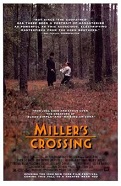
On Sept. 21, 1990 Ethan and Joel Coen's Miller's Crossing (original title: The Bighead) (20th Cent. Fox) debuts, a Prohibition era neor-noir gangster film starring Albert Finney and "Jesus, Tom" Gabriel Byrne as Irish gangsters Liam "Leo" O'Bannon and Tom Reagan, and Marcia Gay Harden as hot moll Verna Bernbaum, who sleeps with them both to protect her small-time bookie brother Bernie (John Turturro), causing Tom to fake executing him, only to get blackmailed and have to finish the job; Jon Polito plays Leo's Italian rival Johnny Caspar; "Nothing is what it seems at Miller's Crossing"; does $5M box office on a $14M budget, flopping but making it up in video and DVD sales after the critics praise it to the skies for its style and tributes to past gangster and noir films, calling it one of the top gangster films of all time; "What's the rumpus?"; "Whatsa matter, somebody hit you?"; "Tell Leo he's not God on the throne, he's just a cheap political boss with more hair tonic than brains"; "It's like I tell all of my boys, always put one in the brain"; Bernie: "Look in your heart" - Tom: "What heart?"; "Nothing more foolish than a man chasin' his hat".
On Sept. 26, 1990 the Motion Picture Assoc. of Am. (MPAA) announces a new NC-17 rating, designed to bar moviegoers under the age of 17 from certain films without the commercial stigma of the old "X" rating; Henry and June becomes the first film to receive the rating.
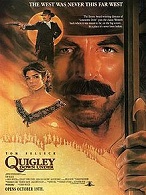
On Oct. 17, 1990 Simon Wincer's Quigley Down Under (MGM) debuts, starring Tom Selleck as Am. cowboy marksman Matthew Quigley, who is hired in Australia by Elliott Marson (Alan Rickman) to eradicate Aborigines but balks and joins them instead, along with Crazy Cora (Laura San Giacomo) from Tex., who calls him Roy; does $21.4M box office on an $18M budget.

On Nov. 16, 1990 Chris Columbus' Home Alone debuts, Macaulay Carson Culkin (1980-) as Kevin McCallister, a 8-y.-o. left behind at home and sieged by burglars Joe Pesci and Daniel Stern, turning him into a slapstick mini-Rambo; meanwhile John Candy plays the leader of a polka band travelling cross-country with his mom Catherine O'Hara; #1 movie of 1990 ($286M); "A family comedy without the family"; followed by "Home Alone 2" (1992).


On Nov. 21, 1990 Kevin Costner's Dances with Wolves (Majestic Films) (Orion Pictures) debuts, based on the 1988 Michael Blake novel about why palefaces shoulda loved rather than hated the injuns, starring Costner as Civil War Union Lt. John Dunbar, who exiles himself to a remote outpost in Sioux country, and goes injun with white babe Stands With a Fist (Mary McDonnell), Kicking Bird (Graham Greene), Wind In His Hair (Rodney A. Grant), Ten Bears (Floyd "Red Crow" Westerman) et al.; the most pro-Indian Western ever, incl. Sioux language lessons; film score by James Bond Theme man John Barry; #3 movie of 1990 ($185M U.S. and $424M worldwide box office on a $22M budget).

On Dec. 7, 1990 Tim Burton's Edward Scissorhands (20th Cent. Fox) debuts, a revisioning of the Frankenstein story, starring Johnny Depp as a freak with you know whats for hands, who finds sympathy from Kim (Winona Ryder) and Peg (Dianne Wiest) before the Am. suburban mob comes with torches; O-Lan Jones plays Esmeralda; does $86M box office on a $20M budget; "The story of an uncommonly gentle man."

On Dec. 19, 1990 Franco Zeffirelli's Hamlet (Nelson Entertainment) (Icon Productions) (Warner Bros.) debuts, based on the Shakespeare play (first film from Gibson's Icon Productions), starring Mel Gibson as Hamlet, Glenn Close as Queen Gertrude, Stephen Dillane as Horatio, and Helena Bonham Carter as Ophelia; does $20.7M box office.


In 1990 British HP computer programmer Colin "Col" Needham (1967-) launches the Internet Movie Database (IMDb) Web site; in 1998 it is acquired by Amazon.com; by 2014 it has 6M personalities, 2.95M titles, and 54M registered users.
On Jan. 11, 1991 Peter Weir's Green Card debuts, starring innocent Am. horticulturist Andie MacDowell, who falls in love with cultured and experienced French composer Gerard Depardieu (who forgets to tell her that she looks like the Mona Lisa?) as they attempt to fool the INS; Depardieu's English-language debut.
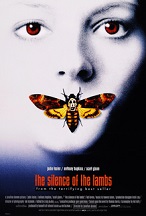

On Jan. 30, 1991 Jonathan Demme's The Silence of the Lambs (Orion Pictures) debuts, a horror-thriller based on the 1988 Thomas Harris novel, featuring a duel of wits between FBI cadet Clarice Starling (Jodie Foster) (Michelle Pfeiffer was originally cast?) and serial killer, psychiatrist, and Renaissance man "Hannibal the Cannibal" Lecter (Anthony Hopkins), who tries to mimic a wildcat with his eyes and body language, models his voice after Truman Capote, Katharine Hepburn, and HAL 9000, and is transported wearing a hockey mask so he can't bite off your face; Ted Levine is perfectly cast as the sexually mixed-up serial murderer Buffalo Bill, which Hannibal helps Clarice catch only after she reveals her inner self to him so he can mess with her mind; #3 movie of 1991 ($131M U.S. and $272.7M worldwide box office on a $19M budget); first horror film to win a Best Picture Oscar, and 3rd to be nominated after "The Exorcist" (1973) and "Jaws" (1975); followed by the sequel "Hannibal" (2001) and the prequels "Red Dragon" (2002) and "Hannibal Rising" (2007); features the Buffalo Bill Dance to the 1988 song "Goodbye Horses" by Q Lazzarus; "A census taker once tried to test me. I ate his liver with some fava beans and a nice Chianti [slurp slurp slurp]" (Hannibal) - the con bites male flesh?

On Feb. 15, 1991 David S. Ward's King Ralph (Universal) debuts, based on the novel "Headlong" by Emlyn Williams, starring TLW, er, John Goodman as a Las Vegas lounge lizard who suddenly becomes king of England, going on to romance low-born Miranda Greene (Camille Coduri) while rejecting high-born Princess Anna (Joely Richardson); meanwhile royal secy. Sir Cedric Charles Willingham (Peter O'Toole) tries to tutor the Yank, and snide Lord Percival Graves (John Hurt) tries to get him ousted so he can restore his Stuart clan; does $52.5M box office on a $23M budget - one of TLW's top 100 comedies of all time for pure wish fulfillment?
On Mar. 25, 1991 the 63rd Academy Awards are held in Los Angeles, and hosted by Billy Crystal; the best picture Oscar for 1990 goes to Orion's Dances With Wolves (2nd Western to win after Cimarron), along with best dir. to Kevin Costner; best actor goes to Jeremy Irons for Reversal of Fortune, best actress to Kathy Bates for Misery, best supporting actor to Joe Pesci for Goodfellas, and best supporting actress to Whoopi Goldberg for Ghost; "The first thing I ever did at White Station High School was to play one of Simon Legree's dogs in the ballet 'The King and I'" (Bates to Memphis Commercial-Appeal).
On Apr. 19, 1991 Ate de Jong's Drop Dead Fred debuts, starring Phoebe Cates as repressed Lizzie Cronin, who loses everything during lunch hour and moves in with her domineering mother Polly (Marsha Mason), and releases her childhood imaginary friend Rik Mayall, who sets her life back on track.

On May 24, 1991 Ridley Scott's Thelma and Louise debuts, making stars of Virginia Elizabeth "Geena" Davis (1956-) as Thelma Yvonne Dickinson, and Susan Abigail Sarandon (nee Tomalin) (1946-) as Louise Elizabeth Sawyer, two Okla. women who start out in Louise's 1966 Ford Thunderbird convertible for a 2-way vacation that turns into a vengeful anti-male crime spree after an attempted rape; Harvey Keitel plays sympathetic detective Hal Slocumb; Brad Pitt plays J.D.; the film is criticized for male bashing, turning it into a cult hit; does $45.4M box office on a $16.5M budget.

On June 7, 1991 Ron Underwood's City Slickers debuts, starring Billy Crystal, Daniel Stern, Bruno Kirby et al. as midlife-crisis businessmen who go to a dude ranch, where they meet up with trail boss Curly Washburn (Jack Palance), who teaches them about the open air life on a cattle drive from N.M. to Colo.; #4 movie of 1991 ($124M U.S. and $180M worldwide box office on a $26M budget); watch trailer.

On July 2, 1991 John Singleton's Boyz n the Hood (Columbia Pictures) debuts, filmed in South Central Los Angeles, Calif., starring Cuba Gooding Jr. as Tre Styles, Angela Bassett as Reva Styles, Laurence Fishburne as Jason "Furious" Styles Jr., and Ice Cuba (acting debut) as Darrin "Doughboy" Baker; the dir. debut of LA-born John Daniel Singleton (1968-2019); does $57.5M box office on a $6.5M budget; gets Singleton nominations for best dir. (youngest, and first African-Am.) and best original screenplay; watch trailer.

On July 1, 1991 James Cameron's Terminator 2: Judgment Day (Carolco Pictures) (TriStar Pictures) debuts ("same make, same model, new mission"), becoming a quantum leap in sci-fi and a super hit, well-spending the $100M budget and $15M paycheck ($21,429 per word for 700 words of dialogue) to Ahnuld ($12M in the form of a jet); Robert Patrick kicks Ahnuld's hydraulically-suspended ass as the advanced T-1000 liquid metal man; Edward Furlong plays Linda Hamilton's love child from T1; #1 movie of 1991 ($205M U.S. and $523.7M box office on a $102M budget); watch trailer; watch clip.
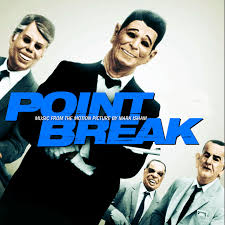
On July 12, 1991 Kathryn Bigelow's Point Break (20th Cent. Fox) debuts, starring Keanu Reeves as rookie FBI agent Johnny Utah (former Ohio State U. QB), who infiltrates a gang of surfers called the Ex-Presidents who rob banks wearing rubber president masks (Reagan, Nixon, LBJ, Carter) to pay for their surfing habit, led by extreme sports nut Bodhi (Patrick Swayze); also stars Gary Busey as Utah's partner Angelo Pappas, and Lori Petty as surfer girl Tyler Endicott; does $83.5M box office on a $24M budget.
On Aug. 2, 1991 Michael Caton-Jones' Doc Hollywood debuts, based on the book "What? Dead Again?" by Dr. Neil Shulman is a romantic comedy starring Michael J. Fox as newly-minted plastic surgeon Dr. Benjamin Stone, who crashes in his 1956 Porsche 356 Speedster en route to Beverly Hills in rural Grady, S.C., and ends up falling for smalltown candy pants girl Vailula (Julie Warner), while Nancy Lee Nicholson (Bridget Fonda) tries to get her hooks in him; Woody Harrelson plays rival Hank Gordon; David Ogden Stiers plays mayor Nick Nicholson; does $54.8M box office on a $17M budget.
On Sept. 20, 1991 Terry Gilliam's The Fisher King debuts, starring Robin Williams as a crazed bum in search of the Holy Grail in Manhattan; co-stars Jeff Bridges, Amanda Plummer, and Mercedes Ruehl, along with real street people; "A Modern Day Tale About the Search for Love, Sanity, Ethel Merman and the Holy Grail".
On Nov. 13, 1991 Martin Scorsese's Cape Fear debuts, a remake of the 1962 Robert Mitchum-Gregory Peck film based on the 1957 John D. MacDonald novel "The Executioners", starring Robert De Niro as convicted rapist Max Cady, who returns to get even with Sam Bowden, the atty. who defended him, along with his wife Leigh (Jessica Lange) and daughter Danielle (Juliette).
On Nov. 22, 1991 Barry Sonnenfeld's The Addams Family debuts, a remake of the 1960s TV show based on the chars. by Charles Addams, starring Raul Julia and Anjelica Huston as Gomez and Morticia Addams, Christopher Lloyd as Uncle Fester, Christina Ricci and Jimmy Workman as siblings Wendy and Pugsley, Carel Struycken as Lurch, and Judith Malina as Grandma; #6 movie of 1991 ($114M).
On Dec. 11, 1991 Steven Spielberg's Hook debuts, based on the J.M. Barrie play, starring Robert Williams as Peter Pan (Banning), Dustin Hoffman as Capt. Hook, Julia Roberts as Tinkerbell, and Bob Hoskins as Smee; #5 movie of 1991 ($120M).
On Dec. 13, 1991 Barry Levinson's Bugsy (TriStar Pictures) debuts, starring Warren Beatty as Las Vegas founder Benjamin "Bugsy" Siegel, Annette Bening as his moll Virginia Hill, Ben Kingsley as mob boss Meyer Lansky, Harvey Keitel as mobster Mickey Cohen, Elliott Gould as mobster Harry Greenberg, and Joe Mantegna as mob-connected actor George Raft; does $49M box office on a $30M budget; "Twenty dwarves took turns doing handstands on the carpet."
On Dec. 20, 1991 Charles Shyer's Father of the Bride debuts, a remake of the 1950 Spencer Tracy flick, starring Steve Martin and Diane Keaton as George and Nina Banks, and Kimberly Williams-Paisley as their daughter Kimberly; #8 movie of 1991 ($89M).
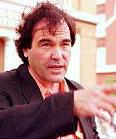

On Dec. 22, 1991 Oliver Stone's JFK debuts, changing the public's perception of the JFK assassination even more to the side of the conspiracy theorists; stars Kevin Costner as New Orleans DA Jim Garrison, Sissy Spacek as his wife Liz, Gary Oldman as lone gunman Lee Harvey Oswald, Edward Asner as bad guy Guy Bannister, Brian Doyle-Murray as Jack Ruby, Joe Pesci as David Ferrie, Tommy Lee Jones as Clay Shaw, John Candy as Dean Andrews, and Kevin Bacon as Willie O'Keefe; Steve Reed and Jodie Forber star as JFK and Jackie.
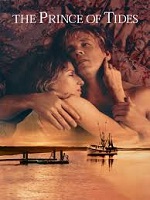
On Dec. 25, 1991 Barbra Streisand's The Prince of Tides (Columbia Pictures) debuts, based on the 1986 Pat Conroy novel, starring Nick Nolte and Blythe Danner as the Wingo twins Tom and Savannah of Sowth Cayrohlayna, who have their personal demons exorcized by New York pshrink Susan Lowenstein (Streisand); does $110M box office on a $30M budget.

On Dec. 27, 1991 Jon Avnet's Fried Green Tomatoes (Universal Pictures) debuts, based on the novel "Fried Green Tomatoes at the Whistle Stop Cafe" by "Match Game" panelist Fannie Flagg, starring Jessica Tandy as 83-y.-o. Ninny Threadgoode, who reminisces to Evelyn (Kathy Bates) about her Ala. childhood as Idgie (Mary Stuart Masterson), whose friend Ruth (Mary-Louise Parker) has a bad marriage; #10 movie of 1991 ($80M U.S. and $119.4M worldwide box office on a $11M budget).

On Jan. 10, 1992 Curtis Hanson's The Hand that Rocks the Cradle (Buena Vista Pictures) debuts, starring Rebecca DeMornay as Peyton Flanders, the Jekyll-Hyde nanny from Hell, and Annabella Sciorra as the naive pregnant Claire Bartel; does $88M box office on an $11.7M budget; "Trust is her weapon, innocence is her opportunity, and revenge is her only desire."

On Feb. 14, 1992 Penelope Spheeris' Wayne's World debuts, based on their Saturday Night Live comedy sketch, becoming the film debut of Canadian-born Michael John "Mike" Myers (1963-) and Dana Thomas Carvey (1955-) as Wayne Campbell and Garth Algar, hosts of a public access TV show in Aurora, Ill., who try to go commercial and grovel before Alice Cooper; features a sing-along to Queen's "Bohemian Rhapsody" in their Mirthobile (baby blue 1976 AMC Pacer with flames and non-matching wheels); popularizes the use of the phrases "Party on!", "Schwing" (the sound of popping a boner when seeing a hot chick), and "...Not!"; #8 movie of 1992 ($122M); Stephen Surjik's Wayne's World 2 (Dec. 10, 1993) sees them go to an Aerosmith concert, have a dream about Jim Morrison and a "weird naked Indian" (Larry Sellers) commanding them to stage Waynestock, and rock with the Village People while Wayne's babe Cassandra (Tia Carrere) flirts with producer Bobby Cahn (Christopher Walken), causing Wayne to go after Honey Hornee (Kim Basinger).

On Mar. 13, 1992 Jonathan Lynn's My Cousin Vinny (20th Cent. Fox) debuts, written by Dale Launer, starring Ralph Maccio as Billy Gambino, and Mitchell Whitfield as Stan Rothenstein, two New Yorkers who are mistaken for murderers while on vacation in crackerland Ala., and end up in front of snooty judge Chamberlain Haller (Fred Gwynne in his last film appearance), causing Billy's atty. cousin Vinny Gambini (Joe Pesci) and his auto repair babe Mona Lisa Vito (Marisa Tomei) to come to the rescue; Lane Smith plays cracker DA Jim Trotter III; does $64M box office on a $11M budget; the breakthrough role for Brooklyn, N.Y.-born Marisa Tomei (1964-); "There have been many courtroom dramas that have glorified the Great American Legal System. This isn't one of them."

On Mar. 20, 1992 Paul Verhoeven's Basic Instinct (Carolco Pictures) (TriStar Pictures) debuts, written by Joe Eszterhas, becoming the breakthrough role for Meadville, Penn.-born former model Sharon Yvonne Stone (1958-) for her beaver-glimpsing leg-crossing scene during a police interrogation (shot without her knowledge?), in the role of Calif. crime novelist and serial killer Catherine Davis Tramell, who likes to tie up her johns incl. Det. Nick Curran (Michael Douglas), knife them, then tell about it in her bestselling novels, then beg to be taken in sansa panties to show she's got nothing to hide; Jeanne Tripplehorn plays bi murderer Dr. Beth Garner, pissing-off the LGBT crowd; #9 movie of 1992 ($118M U.S. and $352.9M worldwide box office on a $49M budget).
On Mar. 30, 1992 the 64th Academy Awards in Los Angeles, Calif. are hosted by Billy Crystal (2nd time), who is wheeled in on a stretcher wearing a ski mask a la Hannibal Lecter; 100-y.-o. Hal Roach Sr. rises from the audience for a standing ovation and decides to give a speech without a a microphone, causing Crystal to comment "I think that's appropriate because Mr. Roach started in silent films"; the best picture Oscar for 1991 goes to Orion's The Silence of the Lambs, along with best dir. to Jonathan Demme, and best actor and actress to Anthony Hopkins and Jodie Foster; best supporting actor goes to Jack Palance for City Slickers, and best supporting actress to Mercedes Ruehl for The Fisher King; Jack Palance shows that he's still spry by doing 1-handed pushups on stage; Elizabeth Taylor receives the Jean Hersholt Humanitarian Ward for supporting AIDS research.

On May 22, 1992 Ron Howard's Far and Away (Imagine Entertainment) (Universal Pictures) debuts, starring Tom Cruise as Joseph Donnelly, a W Irish bare-knuckle boxer who flees to the U.S. after threatening his landlord, and Nicole Kidman as Shannon Christie, the landlord's daughter, who follows him to Boston and the 1893 Okla. Land Rush after sneaking a peak under his bowl; music by John Williams; also stars Colm Meaney; "What they needed was a country big enough for their dreams"; does $137.8M box office on a $60M budget; watch trailer; watch clip of Okla. Land Rush.
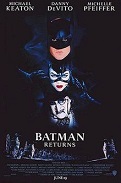
On June 16, 1992 Tim Burton's Batman Returns (Warner Bros.) ("The Bat, the Cat, the Penguin") debuts, starring Michael Keaton as Batman, Danny DeVito as the Penguin, Michelle Pfeiffer (cool lips) as Catwoman/Selina Kyle, and Christopher Walken as maniacal tycoon (big stretch?) Max Shreck; #3 movie of 1992 ($163M U.S. and $2668M worldwide box office on an $80M budget).
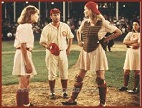
On July 1, 1992 Penny Marshall's A League of Their Own (Columbia Pictures) debuts, starring Tom Hanks as WWII women's league baseball mgr. Jimmy Dugan, who has to handle crying cu, er, women players Geena Davis (Dottie Hinson) (after Debra Winger refuses to act with Madonna and drops out), Lori Petty (Kit Keller), Madonna (Mae Mordabito), Doris Murphy (Rosie O'Donnell) et al.; #10 movie of 1992 ($107M U.S. and $132.4M worldwide box office on a $40M budget); "There's no crying in baseball" (Hanks).

On Aug. 7, 1992 Clint Eastwood's Unforgiven (Warner Bros.) debuts, written by David Webb Peoples, starring Eastwood as aging outlaw William Munny, who takes on one more job along with partner Ned Logan (Morgan Freeman) to avenge a disfigured ho in Big Whiskey, Wyo., and comes up against cruel sheriff Little Bill Daggett (Gene Hackman); Richard Harris plays gunfighter Richard Harris, and Saul Rubinek plays pulp fiction writer W.W. Beauchamp; grosses $159M on a $14.4M budget.

On Sept. 25, 1992 Michael Mann's The Last of the Mohicans debuts, based on the 1826 James Fenimore Cooper novel, starring Daniel Day-Lewis as Hawkeye, Russell Means as his sidekick Chingachgook (father of the last of the Mohicans Uncas), Madeleine Stowe as Hawkeye's babe Cora Munro, Maurice Roeves as her daddy Col. Edmund Munro, and Wes Studi as studly bad Indian Magua, who leads his lusty Indians in bushwhacking a British army column in a keeper cinematic moment.

On Oct. 2, 1992 James Foley's Glengarry Glen Ross (New Line Cinema) debuts, adapted from the 1984 David Mamet play and filmed in New York City, starring Al Pacino as Richard Roma, Jack Lemmon as Shelly "the Machine" Levene, Alan Arkin as George Aaronow, and Ed Harris as Dave Moss, four high-pressure real estate salesmen in Chicago working for Premiere Properties, who are threatened by Blake (Alec Baldwin) with firing if they don't produce; Kevin Spacey plays office mgr. John Williamson; does $10.7M box office in North Am. on a $12.5M budget; "Only one thing counts in this life - get them to sign on the line which is dotted." (Blake)
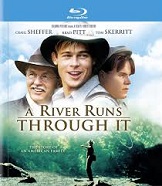
On Oct. 9, 1992 Robert Redford's A River Runs Through It (Columbia Pictures) debuts, written by Richard Friedenberg based on the 1976 novel by Norman Maclean (1902-90) set near Missoula, Mont., starring Brad Pitt and Craig Sheffer as brothers Paul and Norman Maclean, Tom Skerritt as their Presbyeterian father Rev. John Maclean, Brenda Blethyn as Clara Maclean, and Emily Lloyd as Jessie Burns, becoming a hit with fly fishing lovers, and the breakthrough role for Brad Pitt; does $43.4M box office; "Like many fly fishermen in western Montana where the summer days are almost Arctic in length, I often do not start fishing until the cool of the evening. Then in the Arctic half-light of the canyon, all existence fades to a being with my soul and memories and the sounds of the Big Blackfoot River and a four-count rhythm and the hope that a fish will rise. Eventually, all things merge into one, and a river runs through it. The river was cut by the world's great flood and runs over rocks from the basement of time. On some of those rocks are timeless raindrops. Under the rocks are the words, and some of the words are theirs. I am haunted by waters"; "Chicken in the car, car won't go. That's how you spell Chicago"; "My candle burns at both ends; it will not last the night. But ah my foes, and oh my friends, it gives a lovely light."

On Oct. 23, 1992 Quentin Tarantino's Reservoir Dogs (based on the letters in "Au Revoir, Les Enfants") debuts, a super-violent cops-and-robbers flick about Misters Pink (Steve Buscemi), White (Harvey Keitel), Orange (Tim Roth), Blonde (Michael Madsen), Blue (Edward Bunker) ("What's special, take you in the back and suck your dick?"), and Brown (Tarantino), who face a traitor in their midst (Roth); the dir. debut of former video store clerk Quentin Jerome Tarantino (1963-); after Timothy Carey is turned down, but gets the screenplay dedicated to him, tough guy actor Lawrence Tierney plays mob boss Joe Cabot, who gives them their names; Chris Penn plays nice guy Eddie Cabot, who believes waitresses should be automatically tipped; the scene where police officer Marvin Nash, played by William Kirk Baltz (1959-) is tortured and burned alive with gasoline by Mr. Blonde to the 1972 Stealers Wheel hit tune Stuck in the Middle with You is a keeper; does $22M box office on a $1.2M budget.
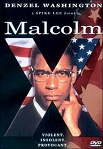
On Nov. 18, 1992 Spike Lee's Malcolm X debuts, starring Denzel Washington.

On Nov. 25, 1992 Mick Jackson's The Bodyguard (Nov. 25) (Tig Productions) (Kasdan Productions) (Warner Bros.) deubts, written by Lawrence Kasdan, starring Kevin Costner as a white ex-Secret Service agent who guards the body of black singer Whitney Houston and ends up you know what (while in actuality going out with Angie Everhart, Courteney Cox, Joan Lunden et al.); the film's soundtrack, which incl. "I Will Always Love You" (written by Dolly Parton) becomes the #1 selling of all time (until ?); #7 movie of 1992 ($122M U.S. and $411M worldwide box office on a $25M budget); "Never let her out of your sight. Never let your guard down. Never fall in love."
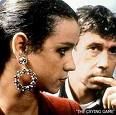

On Sept. 18, 1992 Neil Jordan's The Crying Game (Channel Four Films) debuts, based on the 1931 short story "Guests of the Nation" by Frank O'Connor, and whose title is based on a top-5 British hit of 1964 (played in 3 versions, incl. one by Boy George), starring Stephen Rea as IRA gunman Fergus, who kidnaps black British soldier Jody (Forest Whitaker) and befriends him, then lets him go after being ordered to kill him, only to see him get run over by his own troops, then sets out to find his girlfriend Dil, played by U.S.-born Jaye Davidson (Alfred Amey) (1968-), whom he falls in love with until she wipes off her mouth, takes off her clothes, and shows him her dick, never mind the white-black thang?; one of the seminal movie experiences of the dickade?; does $62.5M box office U.S. and £2M U.K. on a £2.3M budget; watch trailer.
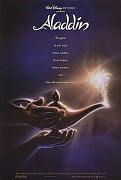
On Nov. 25, 1992 Ron Clements' and John Musker's Aladdin (Buena Vista Pictures) debuts, an animated Disney flick about Aladdin (voice of Scott Weinger) and Princess Jasmine (Linda Larkin); Robin Williams voices the Genie for $75K; #1 movie of 1992 ($217M U.S. and $504.1M worldwide box office on a $28M budget).

On Dec. 9, 1992 Rob Reiner's A Few Good Men (Castle Rock Entertainment) (Columbia Pictures) debuts, based on the play by Aaron Sorkin is about U.S. Marines Lance Cpl. Harold W. Dawson (Wolfgang Bodison) and Pfc. Louden Downey (James Marshall) at Gitmo and their infamous "Code Red" discipline, which results in the death of Pfc. William T. Santiago (Michael DeLorenzo) and a chain-of-command coverup, ending in a great courtroom cross-examination of Marine Corps Col. Nathan R. Jessup (Jack Nicholson) by smart young Lt. Daniel Kaffee (Tom Cruise), who maneuvers the arrogant prick into blowing his own coverup, while Tom's boss (it would have to be female even though it's only JAG?) Lt. Cdr. Joanne Galloway (Demi Moore) holds his hand but never his johnson; Kevin Bacon plays straight arrow govt. prosecutor Capt. Jack Ross; Kiefer Sutherland plays Jessup's boy Lt. Jonathan Kendrick; Kevin Pollak plays Moore's aide Lt. Sam Weinberg; J.T. Walsh plays Jessup's regretful 2nd Lt. Col. Matthew Andrew Markinson, as everybody in the cast smells Oscars, even here cum da Judge Julius Alexander Randolph, played by J.A. Preston; #5 movie of 1992 ($141M U.S. and $243.2M worldwide box office on a $40M budget); first of five consecutive $100M box office hits for Cruise (a first); "You can't handle the truth"; "I'm gonna rip the eyes out of your head and puke in your dead skull. You've fucked with the wrong Marine" - the movie adds the missing trial to the JFK coverup? Watch trailer; view clip; view clip.
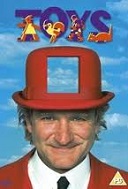
On Dec. 18, 1992 Barry Levinson's Toys (20th Cent. Fox) debuts, featuring sumptuous sets by Ferdinando Scarfiotti and outdoor scenes in SW Wash. and NC Idaho; stars Robin Williams as Leslie Zevo, who is passed over by his father Kenneth Zevo (Donald O'Connor) for ownership of the Zevo Toys factory in Moscow, Idaho for his brother Lt. Gen. Leland Zevo (Michael Gambon); also stars Joan Cusack as Alsatia Zevo; does $23.3M box office on a $43M budget.

On Dec. 23, 1992 Martin Brest's Scent of a Woman (Universal) debuts, a remake of the 1975 Italian film "Profumo di Donna", based on the Giovanni Arpino novel, starring Al Pacino as blind alcoholic retired army Lt. Col. Frank Slade, who has to be watched over by prep school student Charlie Simms (Chris O'Donnell), and ends up dancing the tango with much younger Donna (Gabrielle Anwar) and daring death to catch him while his nose is full of the you know what of a you know what; does $134M box office on a $31M budget.

In 1992 after becoming the first female pres. of 20th Cent. Fox in 1980, producing "Fatal Attraction" (1987) and "The Accused" (1988), Sherry Lansing (Sherry Lee Duhl) (1944-) becomes the first female CEO of a major studio, Paramount (until 2004), going on to release its most successful string of hits since the 1930s, incl. "Forrest Gump" (1994), "Braveheart" (1995), and "Titanic" (1997).
In 1992 famous English 'Alfie" stud and lead actor Michael Caine is offered only a minor role in a new film, shocking him into retiring and opening a restaurant in gay South Beach, Miami, Fla., until fellow star Jack Nicholson offers him a co-starring role in "Blood & Wine" (1996); "I began to play more varied, more interesting, more difficult roles than the ones I had when I was the protagonist. I retired more than 20 years ago and since then I have acted in more than 40 films! It may not be me who stays anymore with the girl, but I'll keep the papers!" ( 2018 memoir "Blowing the Bloody Doors Off").
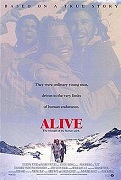
On Jan. 15, 1993 Frank Marshall's Alive (Touchstone Pictures) debuts, based on the 1974 book by Piers Paul Read about Uruguayan rugby players whose plane crashes in the Andes on Friday the 13th, 1972, forcing them to turn to yummy cannibalism to survive; stars Ethan Hawke; does $36.7M box office on a $32M budget.

On Feb. 12, 1993 (should be Feb. 2?) Harold Ramis' Groundhog Day (Columbia Pictures) debuts, starring Bill Murray as Pittsburgh TV meteorologist Phil Connors, who goes to Punxsutawney, Penn. to cover the Groundhog Day festivities, and ends up in a nightmare where he wakes up in the same time loop each morning, and can only get out by bedding hot hard-to-get news producer Rita Hanson (Andie MacDowell); does $71M box office on a $14.6M budget.
On Mar. 29, 1993 the 65th Academy Awards in Los Angeles are hosted by Billy Crystal (3rd time), who rides in on a giant Oscar pulled by Jack Palance; the best picture Oscar for 1992 goes to the myth-destroying Warner Bros. Western Unforgiven (3rd Western to win after "Dances With Wolves" in 1990 and "Cimarron" in 1930), along with best dir. to Clint Eastwood, and best supporting actor to Gene Hackman; best actor goes to Al Pacino for Scent of a Woman (his first Oscar), best actress to Emma Thompson for Howard's End, and best supporting actress to Marisa Tomei for My Cousin Vinny (rumors circulate that she got it by mistake and it was supposed to go to Vanessa Redgrave); Elizabeth Taylor receives the Am. Film Inst. Lifetime Achievement Award; Elton John throws his first Oscar party.

On May 28, 1993 Rocky Morton's and Annabel Jankel's Super Mario Brothers debuts, based on the 1985 Nintendo game, starring Bob Hoskins as Mario, Dennis Hopper as King Loopa, and Samantha Mathis as Princess Daisy, becoming the first major film role for Colombian-born John Alberto Leguizamo (1964-) as Luigi; too bad, it bombs, doing $20.9M box office on a $48M budget.

On June 11, 1993 Steven Spielberg's Jurassic Park (Universal Pictures) debuts, based on the 1990 Michael Crichton novel, starring Sam Neill as paleontologist Dr. Alan Gant, who takes hotpants asst. Dr. Ellie Sattler (Laura Dern) and horny ever-divorced chaos theory mathematician Dr. Ian Malcolm (Jeff Goldblum) to see a crazy theme park with cloned dinosaurs run by John Hammond (Richard Atenborough), only to see on-the-take computer nerd Dennis Nedry (Wayne Knight) let the dinos out; Bob Peck plays big gamehunter Robert Muldoon; BD Wong plays scientist Dr. Henry Wu; #1 movie of 1993 ($350M U.S. and $914.6M worldwide box office on a $63M budget); spawns the Jurassic Park series incl. "The Lost World" (1997), "Jurassic Park III" (2001), "Jurassic World" (2015), "Fallen Kingdom" (2018), "Jurassic World 3" (2021).
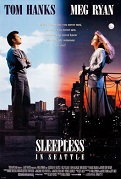
On June 25, 1993 Nora Ephron's Sleepless in Seattle (TriStar Pictures) debuts, a remake of 1957's romantic comedy "An Affair to Remember" written by Nora Ephron of "When Harry Met Sally" (1989) fame stars Tom Hanks as Sam Baldwin and Meg Ryan as Annie Reed; after it goes out of its way to plug the 1957 movie and compare itself to "The Dirty Dozen", video rentals soar; cinematograpy by Sven Nykvist; #5 movie of 1993 ($127M U.S. and $227.9M worldwide box office on a $21M budget); "What if someone you never met, someone you never saw, someone you never knew was the only someone for you?"
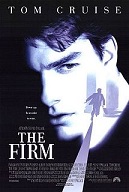
On June 30, 1993 Sydney Pollack's The Firm (Paramount Pictures) debuts, written by David Rabe based on the 1991 John Grisham novel, starring Tom Cruise as new atty. Mitch McDeere, who gets a plum job in Atlanta, Ga. and brings his wife Abby (Jeanne Tripplehorn), then discovers they work for the mob from FBI agent Wayne Tarrance (Ed Harris); Gene Hackman plays atty. Avery Tolar; Wilford Brimley plays bad security chief William Devasher, and Tobin Bell plays albino bad guy Nordic Man; "Power can be murder to resist"; #4 movie of 1993 ($158M U.S. and $270.2M worldwide box office in a $42M budget).
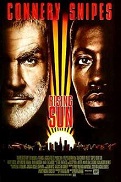
On July 30, 1993 Philip Kaufman's Rising Sun (20th Cent. Fox) debuts, based on the 1992 Michael Crichton novel, starring Sean Connery and Wesley Snipes as Yankee cops Capt. John Connor and Lt. Web Smith in a murder mystery in the offices of sinister Japanese corp. (keiretsu) Nakamoto; does $107.2M box office on a $50M budget.

On Aug. 6, 1993 Andrew Davis' The Fugitive (Warner Bros.) debuts, based on the TV series, starring Harrison Ford as framed rabbiting convicted wife murderer Dr. Richard David Kimble, Tommy Lee Jones as the I-don't-care-if-you're-innocent U.S. marshal Samuel Gerard, and Andreas Katsulas as the 1-armed bad guy Sykes; #3 movie of 1993 ($184M U.S. and $368.9M worldwide box office on a $44M budget).

On Sept. 3, 1993 Dominic Sena's Kalifornia (PolyGram) (Gramercy Pictures) debuts (Sena's dir. debut), starring Brad Pitt as serial killer Early Grayce, who gives an unforgettable ride to reporters Brian Kessler (David Duchovny) and Carrie Laughlin (Michelle Forbs); Juliette Lewis plays Pitt's babe Adele Corners; does $2.395M box office on an $8.5M budget.
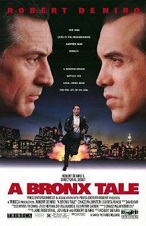
On Sept. 14, 1993 Robert De Niro's A Bronx Tale (TriBeCa Productions) (Savoy Pictures) debuts, adapted from Chazz Palminteri's 1989 play, starring De Niro as Italian-Am. bus driver Lorenzo Anello in 1960, whose 6-y.-o. son Calogero (Francis Capra) witnesses a murder by local mobster Sonny LoSpecchio (Chazz Palminteri) and covers for him to the police, growing up to a 17-y.-o. teenie (Lilo Brancato Jr.) who works for Sonny against his straight-arrow father's wishes, then hooks up with local black girl Jane Williams (Tara Hicks), causing a racial war; Joe Pesci plays Carmine, Louis Vanaria plays Crazy Mario, and Domenick Lombardozzi plays Nicky Zero; does $17.3M box office on a $10M budget.

On Sept. 24, 1993 Richard Linklater's Dazed and Confused (Gramercy Pictures) debuts (title from the Led Zeppelin song),a a coming of age flick introducing a new generation of stars, incl. Jason London as Randall "Pink" Floyd, Matthew McConaughey as David Wooderson, Ben Affleck as Fred O'Bannion, Milla Jovovich as Michelle Burroush, Adam Goldberg as Mike Newhouse, and Parker Posy as Darla Marks, all on the beer-filled last day of school in 1976; after only grossing $8M at the box office on a $6.9M budget, it becomes a cult hit.

On Oct. 1, 1993 Jon Turteltaub's Cool Runnings (Walt Disney) debuts, based on a true story, starring John Candy as the coach of the first bobsled team in snow-free Jamaica, who show the whiteys at the 1988 Calgary Winter Olympics; sledders incl. Leon, and Doug E. Doug; does $154.9M box office on a $14M budget; "One Dream. Four Jamaicans. Twenty Below Zero."

On Oct. 8, 1993 Marco Brambilla's Demolition Man (Warner Bros.) debuts, a sci-fi action flick set in Taco Bell-filled 2032 San Angeles based loosely on Aldous Huxley's 1932 novel "Brave New World", starring Sylvester Stallone as 1996 LAPD Sgt. John Spartan (after Jackie Chan turns the part down), who must catch criminal Simon Phoenix (Wesley Snipes) with the help of Lt. Lenina Huxley (Sandra Bullock); grosses $159M worldwide on a $57M budget; Brambilla's dir. debut; does $159.1M box office on a $77M budet; Hungarian sci-fi novelist Istvan Nemere claims that they stole the script from his 1986 novel "Fight of the Dead"; View trailer.

On Oct. 8, 1993 Ronald F. Maxwell's Gettysburg debuts, based on the 1974 Michael Shaara novel "The Killer Angels", a 254-min. reenactment filmed on the Gettysburg Nat. Military Park battlefield (first-ever), becoming the largest period scale film filmed in North Am. since D.W. Griffith's 1915 "Birth of a Nation"; the all-male cast incl. Ted Turner (the moneybags behind it all), Jeff Daniels, Martin Sheen, Tom Berenger, Sam Elliott, Richard Jordan (last film role), Kevin Conway, C. Thomas Howell, even Ken Burns.
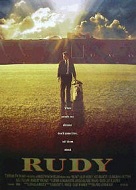
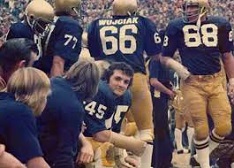
On Oct. 15, 1993 David Anspaugh's Rudy (TriStar Pictures) debuts, starring Sean Astin as Daniel Eugene "Rudy" Ruettiger (1948-), a 5'7" 165 lb. runt who overcame every obstacle to play football for the U. of Notre Dame as defensive end #45, scoring a sack against Georgia Tech on Nov. 8, 1975 and getting carried off the field; Jon Favreau plays D-Bob, Charles S. Dutton plays Fortune, and Ned Beatty plays daddy Daniel Ruettiger Sr.; does $22.8M box office on a $12M budget; View clip.
On Oct. 31, 1993 Am. "Aleka's Attic" actor River Jude Phoenix (b. 1970) dies in Hollywood, Calif. of an OD of heroine and cocaine in the Viper Room, a Hollywood nightclub owned by actor Johnny Depp and partner Anthony Fox; he dies while filming "Dark Blood", which does not debut until 2012: "I'd like to be reincarnated as a dolphin, just for their sonar capabilities."

On Nov. 24, 1993 Michael Schroder's Cyborg 2 debuts, starring Angelina Jolie in her first starring role as prototype cyborg Casella "Cash" Reese in the year 2074; "Future beware: the soul is in the software."

On Nov. 24, 1993 Chris Columbus' Mrs. Doubtfire (20th Cent. Fox) debuts, based on the 1987 Anne Fine novel "Madame (Alias) Doubtfire" stars Robin Williams as eccentric San Fran actor Daniel Hillard, whose marriage with Miranda (Sally Field) is on the rocks, causing him to don a fat bodysuit and impersonate Scottish nanny Mrs. Euphegenia Doubtfire to visit his kids Lydia, Chris, and Natalie; #2 movie of 1993 ($219M U.S. and $441.3M worldwide box office on a $25M budget); a planned sequel is scotched by Williams' 2014 suicide.

On Dec. 8, 1993 Fred Schepisi's Six Degrees of Separation (MGM) debuts, based on the 1990 John Guare play about con artist David Hampton, starring Willard Christopher "Will" Smith Jr. (1968-) as black gay con man Paul, who pretends to be Sidney Poitier's son to gain entrance to upper-mid white society couple Flan and Ouisa Kittredge (Donald Sutherland and Stockard Channing); Poitier's real son is Sydney Tamiia Poitier (1973-), er, he has six daughters and no sons; "I read somewhere that everybody on this planet is separated by only six other people. Six degrees of separation between us and everyone else on this planet. The president of the United States, a gondolier in Venice, just fill in the names. I find it A) extremely comforting that we're so close, and B) like Chinese water torture that we're so close because you have to find the right six people to make the right connection... I am bound to everyone on this planet by a trail of six people" - reminds me of Barack Obama?

On Nov. 30, 1993 Steven Spielberg's B&W Schindler's List (Amblin Entertainment) (Universal Pictures) debuts, about the horrors of the WWII Krakow Ghetto, starring Liam Neeson as Oskar Schindler, Ben Kingsley as Itzhak Stern, and Ralph Fiennes as barbaric Nazi concentration camp commandant Amon Goeth is Hollywood's ultimate slam on the Nazi regime, depicting it as pure evil; "Whoever saves one life saves the world entire"; #9 movie of 1993 ($96M U.S. and $322.1M worldwide box office on a $22M budget); Spielberg (a Jew) directs for free, saying to be paid would be "blood money"; Ford Motor Co., which has been boycotted by Jews since the 1920s because of the anti-Semitism of Henry Ford sponsors a TV showing of the film in 1997.
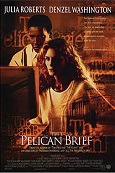
On Dec. 17, 1993 Alan J. Pakula's The Pelican Brief (Warner Bros.) debuts, based on the 1992 John Grisham novel, starring Julia Roberts as as Tulane U. law student Darby Shaw, who discovers the secret of why two U.S. Supreme Court justices were murdered, and involves Washington Herald reporter Gray Grantham (Denzel Washington), with both getting chased by hit-men incl. Khamel "Sam" (Stanley Tucci); Robert Culp plays the U.S. pres.; James B. Sikking plays FBI dir. F. Denton Voyles; the novel deviates from the book in having no romance between white Roberts and black Washington, even though in the novel they are both white and end up romancing on a beach; musical score by James Horner; #8 movie of 1993 ($101M U.S. and $195.3M worldwide box office on a $45M budget).

On Dec. 23, 1993 Jonathan Demme's Philadelphia (the city of brotherly love, get it?) debuts, starring Tom Hanks as able atty. Andrew Beckett, who happens to suck, er, be gay and gets AIDS, causing his firm's homophobic yogurt-joking boss Charles Wheeler (Jason Robards) to fire him, after which he hires married straight black atty. Joe Miller (Denzel Washington) to fight back in court and win one of the Gipper while his partner Miguel Alvarez (Antonio Banderas) cheers from the sidelines and manages to avoid contracting AIDS himself; "Explain it to me like I'm a four-year-old"; features the song Streets of Philadelphia by Bruce Springsteen; does $74M in the U.S. and $201M worldwide.

On Dec. 24, 1993 George P. Cosmatos' Tombstone (Hollywood Pictures) debuts, written by Kevin Jarre and shot in Ariz., starring Kurt Russell as Wyatt Earp, Val Kilmer as Doc Holliday, Sam Elliott as Vigil Earp, Bill Paxton as Morgan Earp, Powers Boothe as Curly Bill Brocius, Thomas Haden Church as Billy Clanton, Stephen Lang as Ike Clanton, Michael Biehn as Johnny Ringo, Charlton Heston as Henry Hooker, and John Philbin as Tom McLaury; a little too overdressed and stagy?; does $56.5M box office on a $25M budget; "Justice Is Coming."

On Dec. 27, 1993 Jim Sheridan's In the Name of the Father (Hell's Kitchen Films) (Universal Pictures) debuts, based on the Gerry Conlon autobio. "Proved Innocent: The Story of Gerry Conlon of the Guildford Four", starring Daniel Day-Lewis as falsely-imprisoned IRA terrorist Gerry Conlon, whose father Patrick "Giuseppe" Conlon is also framed for the 1974 Guildford Pub Bombings that killed four off-duty British soldiers and one civilian; does $65.8M box office on a $13M budget; watch trailer.
In Jan. 1994 an interview with Kevin Bacon about his film "The River Wild" is pub. in Premiere mag., in which he comments that he's worked with everybody in Hollywood, or someone who's worked with them; on Apr. 7 an Internet newsgroup called "Kevin Bacon is the Center of the Universe" is created; in Apr. the Six Degrees of Kevin Bacon Game is created by Albright students Craig Fass, Brian Turtle, and Mike Ginelli, who on Sept. 1, 1996 pub. Six Degrees of Kevin Bacon; Lydia Yeamans Titus was in "The Rag Man" (1925) with Ethel Wales, who was in "Smash-Up: the Story of a Woman" (1947) with Eddie Albert, who was in "The Big Picture" (1989) with Kevin Bacon.

On Feb. 4, 1994 Tom Shadyac's Ace Ventura: Pet Detective debuts, starring Jim Carrey, Courteney Cox, Sean Young, Ton Loc, and Miami Dolphins QB Dan Marino; does $107M box office on a $15M budget; followed by "Ace Ventura: When Nature Calls" (1995).
On Mar. 21, 1994 the 66th Academy Awards award the best picture Oscar for 1993 to Universal's Schindler's List (last B&W film to win until ?), along with best dir. to Steven Spielberg (his first Oscar); best actor goes to Tom Hanks for Philadelphia (his first), best actress to Holly Hunter, and best supporting actress to 11-y.-o. Anna Paquin for Jane Campion's The Piano (in which Harvey Keitel shows his danglies but comes up short in the awards?), and best supporting actor to Tommy Lee Jones for The Fugitive; Jane Campion becomes the 2nd woman dir. to be nominated for best dir. (first 1976).
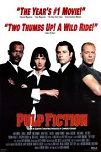
On May 12, 1994 Quentin Tarantino's Pulp Fiction (A Band Apart) (Jersey Films) (Miramax Filmes) debuts, making writer-dir. Quentin Jerome Tarantino (1963-) and his humor-laced violent ensemble material a mainstream hit, and revives the career of John Travolta, who plays pulp fiction-reading L.A. gangster Vincent Vega; Samuel Leroy Jackson (1948-) is great as Vega's partner, vicious-but-philosophical Ezekiel-misquoting black ghetto hit man Jules Winnfield, who decides to go straight; Bruce Willis plays boxer-on-the-run Butch Coolidge, Maria de Medeiros his potbelly-hating babe Fabienne; Eric Stoltz plays coke dealer Lance, and Rosanna Arquette his nose-ringed babe Jody; Tim Roth and Amanda Plummer play restaurant robbers Pumpkin and Honey Bunny; Ving Rhames plays black gangleader Marsellus Wallace, and Uma Thurman his white wife Mia, who never talk directly to each other; Harvey Keitel plays fast-driving fixer Winston "the Wolf" Wolfe; the code that unlocks the briefcase is 666?; #9 movie of 1994 ($108M); "You know what they call a Quarter Pounder with cheese in France? Royale with cheese" (Travolta); "You won't know the facts until you've seen the fiction" (ad); Jackson's killing speech: "And I will strike down upon thee with great vengeance and furious anger those who would attempt to poison and destroy my brothers. And you will know my name is the Lord when I lay my vengeance upon thee"; not really what Ezekiel 25:17 says, he got it from "Bodyguard Kiba" (1973) and "Karate Kiba" (1976); the novel that constipated heroin addict Vincent Vega is reading is Modesty Blaise by Peter O'Donnell (1965); Vega is killed with his own Mac-10 AKA Le Big Mac; does $213.9M box office on an $8.5M budget.

On May 20, 1994 Gus Van Sant's Even Cowgirls Get the Blues debuts, based on the 1976 Tom Robbins novel, starring Uma Thurman as Sissy "world's biggest thumbs" Hackshaw (a mutation not a defect), John Hurt as the gay Countess, Rain Phoenix as bi cowgirl Bonanza Jellybean, Keanu Reeves as Mohawk Julian Gitche, and an interesting musical score featuring lesbian singer k.d. lang.
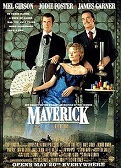
On May 20, 1994 Richard Donner's Maverick (Icon Productions) (Warner Bros.) debuts, starring Mel Gibson as Bret Maverick, the greatest gambler in the West, Jodie Foster as Annabelle Bransford, James Garner (TV's Maverick) as Marshal Zane Cooper, and Graham Greene as Indian Joseph; Mel Gibson's "Lethal Weapon" Danny Glover has a cameo part where he says he's getting too old for this; country singers Clint Black, Carlene Carter, Vince Gill, Waylon Jennings, and Kathy Mattea also cameo; #10 movie of 1994 ($102M box office U.S. and $183M worldwide on a $75M budget).

On June 10, 1994 Jan de Bont's Speed debuts, a gripping action flick about an L.A. bus rigged by disgruntled bomb expert Howard Payne (Dennis Hopper) to blow up if it slows below 50 mph, while SWAT cop Jack Traven (Keanu Reeves) tries to save it, and perky passenger Annie Porter (Sandra Bullock) steps up to help; Jeff Daniels plays Officer Harry Temple, Joe Morton plays Lt. Mac McMahon, Glenn Plummer plays a freaked Jaguar owner, and Alan Ruck plays bus passenger Stephens; makes a star of Sandra Annette Bullock (1964-); #7 movie of 1994 ($121M); does $350M box office worldwide on a $30M budget.



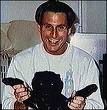
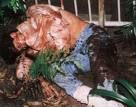

The actor figures out how to put the cops on trial and wins? On June 12-13, 1994 (night) the slasher-style murder of Nicole Brown Simpson (b. 1959) and friend Ron Goldman (b. 1968) leads to a great media circus as her hubby, former NFL football star O.J. (Orenthal James) Simpson (1947-) is arrested on June 17 after a 60-mi. nationally-televised low speed pursuit in his white Ford Bronco (which causes TV coverage Game 5 of the NBA Finals between the New York Knicks and Houston Rockets to be interrupted, along with the final round of the U.S. Open, a parade honoring the New York Rangers for winning the Stanley Cup, and the start of the World Cup match between Germany and Bolivia), and then in a televised media circus trial watched by 95MI tried and acquitted on Oct. 5 next year, with most blacks believing him innocent and cheering, while most Am. whites believe him to be guilty; the supermarket tabloid The National Enquirer "reminded us what good, basic journalism is about" (Ted Koppel) by breaking many authentic stories about the case; O.J.'s Wisc.-born bleached-blonde surfer boy "professional houseguest" Brian "Kato" Kaelin (1959-) (son of Gilligan and Ginger?) becomes a celeb, and ends up flip-flopping and saying he believes he's guilty. On Jan. 24, 1995 U.S. TV has its first unofficial reality show when the opening arguments for the ratings hit O.J. Simpson Murder Trial Series are aired; the I-know-I'm-guilty-but-I'm-O.J.-Simpson O.J. Simpson Defense Dream Team incl. Jewish Harvard prof. Alan Dershowitz (1938-), top black defense atty. Johnnie L. Cochran Jr. (1937-2005), famed white atty. F. Lee Bailey (1933-), and Armenian-Am. atty. Robert George Kardashian (1944-2003), who was seen leaving O.J.'s home the day after the murder with a bag (containing the murder weapon?); the inept prosecution team incl. outclassed-looking Hillary-wannabe Marcia Clark (1953-) and black beginner-looking Christopher Darden (1956-); Am. journalist Dominick John Dunne (1925-2009) covers the trial, gaining fame and later covering Simpson's 2008 kidnap-robbery trial in Las Vegas, Nev. before croaking in 2009; virtually every day until Oct. 3 the major networks cover the events at the trial, and on the big day over 100M viewers tune in as the handsome smiling German-looking trained actor with a deep dark tan and an air of an African prince presides over his subjects wearing a $1K brown suit with white shirt and yellow tie with a small blood stain from shaving, (which becomes a sought-after souvenir), putting on a "are you crazy" expression every time evidence proving his guilt is shown to the jury, as if to eclipse it with his beaming presence into irrelevacy, since a prince is above the law, and what a waste to make a jury tell the govt. so?

On June 15, 1994 Walt Disney Pictures' animated film The Lion King debuts, a loose adaptation of Shakespeare's "Hamlet" with lions and music, starring the voices of Matthew Broderick as Lion King Simba, James Earl Jones as his father Mufasa, Jeremy Irons as his scheming uncle Scar, Moira Kelly as his babe Nala, Nathan Lane as wisecracking meerkat Timon, Ernie Sabella as flatulent warthog Pumbaa, and Rowan Atkinson as Samba's majordodo hornbill Zazu; grosses $313M in the U.S. ($987M worldwide), extending Disney's winning streak of 1992's Aladdin, 1991's Beauty and the Beast, and 1989's The Little Mermaid; features the songs Hakuna Matata, and Circle of Life; refilmed in 2019; ; watch trailer.

On June 23, 1994 Robert Zemeckis' Forrest Gump (Paramount) debuts, based on the 1986 Winston Groom novel, starring Tom Hanks as an IQ-75 Rainman from Greenbow, Ala. with a heart of gold who can run fast and lucks into four decades of photo ops with everybody from Elvis to Pres. Nixon and reminisces at a bus stop in Savannah, Ga. while waiting for the No. 9 bus; Hanks was on the track team at Skyline High in Oakland, Calif.; also stars Robin Wright Penn as his girl interest Jenny, Gary Sinise as legless Lt. Dan Taylor, Sally Field as his momma, and Mykelti Williamson as "I know everything there is to know about the shrimpin' business" Benjamin "Bubba" Buford-Blue; "My mother tells me that life is like a box of chocolates; you never know what you'll get"; earns $330M in the U.S. (#1 of 1994) and $677.9M worldwide on a $55M budget, making 1994 the 1st year in which two films gross $300M in the U.S. domestic market ("The Lion King").
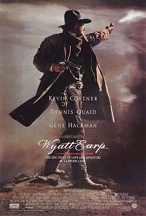
On June 24, 1994 Lawrence Kasdan's Wyatt Earp (Warner Bros.) debuts, starring miscast Kevin Costner as Wyatt Earp, Dennis Quaid as Doc Holliday, Tom Sizemore as Bat Masterson, Gene Hackman as Nicholas Porter Earp, Linden Ashby as Morgan Earp, Michael Madsen as Virgil Earp, Jim Caviezel as Warren Earp, Jeff Fahey as Ike Clanton, Adam Baldwin as Tom McLaury, Lewis Smith as Curly Bill Brocius, and Isabella Rossellini as Big Nose Kate; Annabeth Gish plays Wyatt's 1st wife Urilla Sutherland, and Joanna Going his 2nd wife Josie Marcus; does $25.1M box office on a $63M budget.
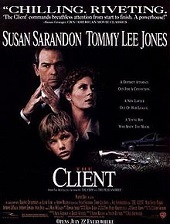
On July 20, 1994 Joel Schumacher's The Client (Warner Bros.) debuts, based on the 1993 John Grisham novel, starring Brad Renfro as 11-y.-o. Mark Sway, who witnesses a mob lawyer's suicide and hires atty. Regina "Reggie" Love (Susan Sarandon) for $1 to keep the mob and feds off; Tommy Lee Jones plays U.S. atty. Roy "Reverend" Foltrigg; does $117.6M box office on a $45M budget.

On July 29, 1994 Chuck Russell's The Mask debuts, starring Jim Carrey and Cameron Diaz in a breakthrough SFX movie powered by Industrial Light and Magic, revolving around a magic jungle mask that lets you be any cartoon superhero you want; #8 movie of 1994 ($120M).

On Aug. 3, 1994 Phillip Noyce's Clear and Present Danger debuts, based on the 1989 Tom Clancy novel about a clandestine U.S. op to punish Colombian drug lords, starring Harrison Ford as gun-free CIA man Jack Ryan, James Earl Jones as Vice Adm. Jim Greer, Willem Dafoe as John Clark ("Variable"), Miguel Sandoval as Cali cartel head Miguel Sandoval, Henry Czerny as CIA deputy dir. for operations Bob Ritter, Harris Yulin as Nat. Security Adviser James Cutter, and Donald Moffat as Pres. Bennett; does $215.9M box office on a $62M budget.

On Sept. 10, 1994 Frank Darabont's The Shawshank Redemption (Castle Rock Entertainment) (Columbia Pictures) debuts, based on Stephen King's 1982 novella "Rita Hayworth and the Shawshank Redemption", starring Tim Robbins as bank vice-pres. Andy Dufresne, who is framed for murder and sentenced to the "toughest prison in the Northeast", Shawshank State Penitentiary in Maine, where he meets new best friend Ellis Boyd "Red" Redding (Morgan Freeman) and cooks the books for corrupt Bible-thumping warden Samuel Norton (Bob Gunton) before escaping with the dough to a life of ease after almost 30 years of surviving brutality and homosexual rape while tunneling with a rockhound hammer in his cell behind a poster of Rita Hayworth; does $58M box office on a $25M budget; "Fear can hold you prisoner, hope can set you free."

On Sept. 30, 1994 Curtis Hanson's The River Wild (Universal Pictures) debuts, starring Meryl Streep and David Straithairn as Gail and Tom, who go on a whitewater rafting trip with son Roarke (Joseph Mazzello), and encounter violent criminals Wade (Kevin Bacon) and Terry (John C. Reilly); Benjamin Bratt plays a park ranger; does $94M box office on a $45M budget.

On Nov. 11, 1994 Neil Jordan's Interview with the Vampire: The Vampire Chronicles debuts, based on vol. 1 of Anne Rice's "Vampire Chronicles" (1976), starring (miscast?) Tom Cruise as 18th cent. New Orleans vampire Lestat, who recruits new blood Louis de Pointe du Lac (Brad Pitt) and Claudia (Kirsten Dunst) to create an unholy dysfunctional family, which proves that selling one's soul to the Devil in exchange for extended life has its Catch-22s; does $224M box office on a $60M budget; Christian Slater (who replaced the late River Phoenix) is the interviewer; "Drink from me and live forever" - you make me feel like I am young again?
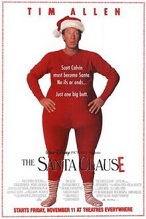
On Nov. 11, 1994 John Pasquin's The Santa Clause (Walt Disney Pictures) (Buena Vista Pictures) debuts, starring Tim Allen as divorced ad exec Scott Calvin, who becomes Santa Claus; #3 movie of 1994 ($145M U.S. and $189.8M worldwide box office on a $22M budget); followed by "The Santa Clause 2" (2002), and "The Santa Clause 3" (2006); watch trailer.
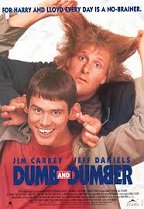

On Dec. 16, 1994 the Farrelly Brothers' Dumb and Dumber debuts, starring Jim Carrey as Lloyd Christmas and Jeff Daniels as Harry Dunne in a slapstick gross-out road movie crossing the U.S. all the way to ritzy Aspen, Colo.; Lauren Holly plays Harry's dream babe Mary Swanson, and Teri Garr her mother Helen; Victoria Rowell plays an athletic FBI agent; #5 movie of 1994 ($128M), launching the careers of R.I.-raised writer-dirs. (the Farrelly Brothers) Peter Farrelly (1956-) and Bobby Farrelly (1958-).
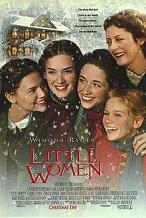
On Dec. 21, 1994 Gillian Armstrong's Little Women (Columbia Pictures) debuts, based on the 1868 Louisa May Alcott novel, starring Susan Sarandon as Marmee, Winona Ryder as Jo March, Trini Alvarado as Meg March, Claire Danes as Beth March, Kirsten Dunst and Samantha Mathis as Amy March, and Gabriel Byrne as Jo's philosopher suitor Friedrich Baer; does $50M box office on a $18M budget.

On Dec. 23, 1994 Edward Zwick's Legends of the Fall (TriStar Pictures) debuts, based on the 1979 novel by Jim Harrison about a Cornish immigrant family in the wilds of Montana in the early 20th cent., starring Brad Pitt, Henry Thomas, and Aidan Quinn as brothers Tristan, Samuel, and Alfred Ludlow, who vie for hot Susannah Fincannon (Julia Ormond) while their rancher father Col. William Ludlow (Anthony Hopkins) (who got sick of the atrocities perpetrated by the U.S. govt. during the Indian Wars) tries unsuccessfully to keep them from volunteering to fight for Britain in WWII; Gordon Tootoosis plays One Stab, and Bart the Bear plays a you know what; does $161M box office on a $30MI budget.
In 1994 Marlon Brando (1924-2004) and ghostwriter Robert Lindsey) pub. Brando: Songs My Mother Taught Me, containing the soundbyte: "Hollywood was always a Jewish community; it was started by Jews and to this day is run largely by Jews. But for a long time it was venomously anti-Semitic in a perverse way, especially before the war, when Jewish performers had to disguise their Jewishness if they wanted a job."

On Feb. 10, 1995 Sam Raimi's The Quick and the Dead (TriStar Pictures) debuts, starring Sharon Stone as the Lady Ellen, who rides to the frontier town of Redemption to kill its boss John Herod (Gene Hackman), and teams up with Cort (Russell Crowe) and Herod's son Fee "the Kid" (Leonardo DiCaprio); does $18.6M box office on a $35M budget.
On Mar. 27, 1995 the 67th Academy Awards in Los Angeles is hosted by David Letterman, who is panned by critics for stinking himself up with a bizarre running joke about Uma and Oprah, and using Tom Hanks for "Stupid Pet Tricks" (Oprah won't appear on his show until Dec. 1, 2005); the best picture Oscar for 1994 goes to Paramount's Forrest Gump, along with best dir. to Robert Zemeckis, and best actor to Tom Hanks (2nd actor to win back-to-back best actor Oscars after Spencer Tracy in 1937-8, and same age); Jessica Lange gets the best actress award for her housewife Marilyn Monroe performance in the little-seen anti-nuclear film Blue Sky; best supporting actor goes to Martin Landau of Mission: Impossible fame for playing Bela Lugosi in Ed Wood, and best supporting actress goes to Diane Wiest for Bullets over Broadway; 99-y.-o. George Burns is honored by the Screen Actors Guild with their first Life Achievement Award.

On Mar. 31, 1995 Rachel Talalay's Tank Girl (United Artists) debuts, based on the British comic strip set in 2033 by Alan Martin and Jamie Hewlett, starring Lori Petty, Ice-T, Malcolm McDowell, and Naomi Watts; does $4M box office on a $25M budget; incl. the song Let's Do It by Paul Westerburg and Joan Jett.

On May 12, 1995 Tony Scott's Crimson Tide (Buena Vista Pictures) debuts, starring Gene Hackman as Capt. Frank Ramsey, whose nuclear sub crew, led by Lt. Cmdr. Ron Hunter (Denzel Washington) mutinies rather than launch a nuke; #10 movie of 1995 ($91M U.S. and $157M worldwide on a $53M budget); features the underwatery Crimson Tide Theme.

On May 23, 1995 Mel Gibson's Braveheart debuts, starring Gibson as 13th cent. Gaelic-speaking Scottish Celtic hero Sir William Wallace (1272-1305), fighting for his free-ee-ee-dom against mean old Norman English king Edward I Longshanks (1239-1307) (Patrick McGoohan) while wooing two babes, local girl Murron MacClannough (Catherine McCormack) and French-born English supermodel of the 13th cent. Princess Isabelle (Isabella) of France (1295-1358) (Sophie Marceau), and trying to get half-Scottish half-Norman fence-sitter Robert the Bruce (1274-1329) (Angus MacFayden) to join him, only to have it happen too late, after he gets betrayed and martyred; manly Peter Hanly plays gay bud Prince Edward of Wales, who later becomes Edward II (1307-27), David O'Hara plays Mad Stephen of Ireland, and James Robinson II plays young William Wallace; the totally phony reenactment of the 9/11/1297 Battle of Stirling Bridge features 1.6K extras from the Irish Army Reserve; loosely based on the verse history of Blind Harry (1440-92); Gibson puts up $15M of his own money to make it, and it grosses $210M worldwide, sparking an interest in Scottish history among the audience along with a resurgence of Scottish nationalism and interest in Scottish independence among the Scots; "They may take our lives, but they'll never take our free-ee-ee-dom" - Sean Connery's back goes out again?
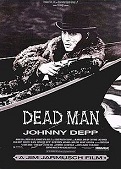
On May 26, 1995 Jim Jarmusch's B&W Dead Man (Miramax Films) debuts, a postmodern "Psychedelic Western" with soundtrack by Neil Young, starring Johnny Depp as meek Cleveland, Ohio accountant William Blake, who arrives in the Western frontier town of Machine to take a new job, only to be chased out by owner John Dickinson, waking up with a bullet lodged in his chest, hooking up with Native Am. Nobody (Gary Farmer); does $1M box office on a $9M budget.

On May 26, 1995 Robert Longo's Johnny Mnemonic (TriStar) debuts, based on a short story by William Gibson, starring Keanu Reeves as a mnemonic courier in East Asian-megacorp.-dominated 2021; does $19M box office on a $26M budget.

On May 27, 1995 Am. "Superman" actor Christopher Reeve (1952-2004) is paralyzed from the neck down in a horseback riding accident in Culpeper (Charlottesville), Va., going on to lead efforts to find a cure for spinal cord injury; his good friend Robin Williams pays for anything the insurance won't cover - don't spit on Superman's cape?

On June 9, 1995 Frank Marshall's Congo, (Paramount Pictures) debuts, based on the 1980 Michael Crichton novel, starring Laura Linney, Dylan Walsh, Ernie Hudson, and Tim Curry as Dr. Karen Ross, Dr. Peter Elliott, Capt. Munro Kelly, and Herkermer Homolka, who follow talking ape Amy to the fabled Lost City of Zinj; Delroy Lindo plays Capt. Wanta; does $152M box office on a $50M budget; "The myth of the killer ape is true"; "Stop eating my sesame cake."

On June 30, 1995 Ron Howard's Apollo 13 (Universal Pictures) debuts, based on the book "Lost Moon: The Perilous Voyage of Apollo 13" by Jim Lovell and Jeffrey Kluger, starring Tom Hanks as Jim Lovell, Kevin Bacon as Jack Swigert, Bill Paxton as Fred Haise, Gary Sinise as Ken Mattingly, and Ed Harris as flight dir. Gene Kranz; Ron's brother Clint Howard plays NASA engineer Sy Liebergot; does $355M box office on a $52M budget; "Houston, we have a problem."

On July 28, 1995 Kevin Reynolds' Waterworld (Universal Pictures) ("A man with a serious drinking problem") debuts, gobbling up $172M in production and causing star Costly Kevin, er, Kevin Costner to call in his chips, becoming known as Fishtar and Kevin's Gate; stars Costner as man-fish Mariner, who helps the good human survivors of global flooding, esp. his babe Jeanne Tripplehorn look for Dryland while fighting Dennis Hopper's mean Smokers on a floating set anchored off Hawaii that is once lost during a tropical storm; does $264.2M box office; it could be the best or the worst sci-flick yet made, wait till the secondary markets are milked?; view trailer; watch clip.

On Aug. 16, 1995 Bryan Singer's The Usual Suspects debuts, with title taken from a line by Claude Rains in "Casablanca", making a star of Kevin Spacey (Fowler) (1959-) as small-time gimp con man Roger "Verbal" Kint, who is questioned by customs agent Dave Kujan (Chazz Palminteri) about $93M worth of cocaine, 27 dead bodies, and a burning tanker in the San Pedro, Calif. harbor, spinning the yarn of yarns involving mysterious Hungarian devil incarnate Keyser Soze ("a spook story that criminals tell their kids at night"), bad ex-cop Keaton (Gabriel Byrne), explosives expert Hockney (Kevin Pollak), hot-headed crack-shot gunman Michael McManus (Stephen Baldwin) and his Spanglish-speaking partner Fred Fenster (Benicio Del Toro), plus mysterious lawyer Kobayashi (Peter Postlethwaite); the coolest plot twist ever?; Roger Ebert later coins the term "Keyser Soze Syndrome" for films with final scenes that redefine the reality of everything that went before; "Who is Keyser Soze?"; "Five criminals. One lineup. No coincidence"; "The greatest trick the Devil ever pulled was convincing the world that he didn't exist" (Kint, borrowing from Charles Baudelaire); "Keaton always said, I don't believe in God, but I'm afraid of him" (Kint).

On Sept. 15, 1995 Iain Softley's Hackers debuts, a cyberpunk thriller film about h.s. hackers, starring Jonny Lee Miller, Fisher Stevens, Matthew Lillard, Lorraine Bracco, Renoly Santiago, and Angelina Jolie as Kate "Acid Burn" Libby in her first Hollywood film; "Boot up or shut up."

On Sept. 15, 1995 David Fincher's Se7en (New Line Cinema) debuts, written by Andrew Kevin Walker, starring Brad Pitt and Morgan Freeman as homicide detectives David Mills and William Somerset, who chase incredibly sick serial killer John Doe (Kevin Spacey), who likes to punish each victim for being too much into one of the Seven Deadly Sins; Gwyneth Paltrow plays wife Tracy Mills, and R. Lee Ermey plays the police captain; #7 movie of 1995 ($100M in the U.S. and $327.3M worldwide on a $33M budget); watch trailer; view clip; view clip.

On Oct. 20, 1995 Barry Sonnenfeld's Get Shorty debuts, based on the 1990 novel by Elmore Leonard, starring John Tavolta as Miami loan shark Chili Palmer, who gets into a war with mobster Ray "Bones" Barboni (Dennis Farina), and ends up in the movie biz in Hollyweird; the sequel is "Be Cool" (2005).

On Nov. 19, 1995 John Lasseter's Toy Story (Pixar/Walt Disney) debuts, the first feature length 100% computer animated film, starring cowboy Woody (voice of Tom Hanks) as favorite toy, who has to deal with new toy Buzz Lightyear (Tim Allen); incl. Don Rickles berating a hockey puck; #1 movie of 1995 ($192M U.S. and $362M worldwide box office on a $30M budget); "The toys are back in town"; "That wasn't flying. That was... falling with style" (Woody).

On Nov. 22, 1995 Martin Scorsese's Casino, (Universal) debuts, based on the book by Nicholas Pileggi, starring Robert De Niro as Mafia sports handicapper Sam "Ace" Rothstein, who runs the Teamsters-funded Tangiers Casino in Las Vegas as a front for several Midwest mob families, and has to handle super-violent enforcer Nicholas "Nicky" Santoro (Joe Pesci) and ex-ho wife Ginger McKenna (Sharon Stone) while fighting Clark County gaming commissioners.
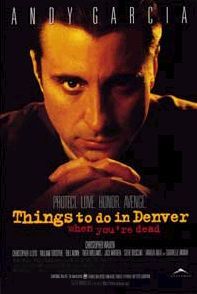
On Dec. 1, 1995 Gary Fleder's Things to Do in Denver When You're Dead (Miramax Films) debuts, written by Scott Rosenberg, becoming the dir. debut of Gary Fleder (1962-), starring Andy Garcia, Christopher Walken, Christopher Lloyd, Treat Williams, Steve Buscemi, Fairuza Balk, and Gabrielle Anwar in a so-so Quentin Tarantino ripoff, reviving the career of Treat Williams; tht title is taken from a 1991 Warren Zevon song; does $530K box office on an $8M budget.
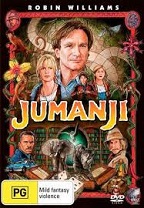
On Dec. 15, 1995 Joe Johnston's Jumanji (Interscope Communications) (TriStar Pictures) debuts, based on the 1981 children's book by Chris Van Allsburg, starring Robin Williams and Bonnie Hunt as kids Alan Parrish and Sarah Whittle, who find a secret attic in their spooky house and uncover a magic but sinister African jungle board game that causes Alan to disappear for 26 years and then reappear as a man, bringing the jungle with him, incl. manhunter Van Pelt (Jonathan Hyde); also stars Kirsten Dunst as Judy, and Bradley Pierce as Peter; #5 movie of 1995 ($100M U.S. and $262.8M worldwide box office on a $65M budget); watch trailer.

On Dec. 22, 1995 Renny Harlin's Cutthroat Island (MGM) debuts, a $98M boring adventure flick filmed in Malta, starring Matthew Modine as slave William Shaw, and Harlin's miscast wife (1993-8) Geena Davis as pirate Morgan Adams, becoming the biggest money-losing film of all time, grossing only $10M, causing Carolco Pictures to go bankrupt; Davis and Harlin make "The Long Kiss Goodnight" next year, which also flops, ending Davis' movie career along with the marriage to the Finn.

On Apr. 3, 1996 Gregory Hoblit's Primal Fear (Paramount Pictures) debuts, based on the 1993 William Diehl novel, making a star out of newbie Eh-Eh-Eh Edward Harrison Norton (1969-), who plays a kind, gentle altar boy accused of a brutal murder of a dirty archbishop, and who is about to be railroaded until suave publicity-loving defense atty. Martin Vail (Richard Gere) takes his case, and battles former girlfriend prosecutor Laura Linney to turn it around and get him off with courtroom tricks, only to find out that-that-that "sooner or later a man who wears two faces forgets which one is real"; "Hill Street Blues" Hoblit's dir. debut; does $102.6M box office on a $30M budget.
On Mar. 25, 1996 the 68th Academy Awards in Los Angeles awards the best picture Oscar for 1995 to Paramount's Braveheart, along with best dir. to Mel Gibson; best actor goes to Nicolas Cage for Leaving Las Vegas, and best actress to Susan Sarandon for Dead Man Walking; Kevin Spacey gets the best supporting actor award for The Usual Suspects, and Mira Sorvino the best supporting actress award for Mighty Aphrodite; actor Christopher Reeve appears in a wheelchair to appeal for support for his new cause of spinal cord research, then repeats the performance at the Dem. Nat. Convention in Aug.
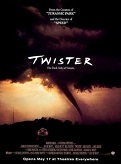
On May 17, 1996 Jan de Bont's Twister (Warner Bros.) debuts, starring Bill Paxton and Helen Hunt as Okla. Wizard of Oz tornado chasers Bill and Jo Harding, who are on the point of divorce until an extra-bad tornado brings them together in Aunt Meg's place in Wakita, Okla., incl. flying cows; #2 movie of 1996 ($242M U.S. and $494.4M worldwide box office on a $92M budget); watch trailer.

On June 6, 1996 Brian DePalma's Mission: Impossible debuts, bringing the 1960s TV series to the big screen with Jon Voight as IMF team leader Jim Phelps, Tom Cruise as Ethan Hunt, and Henry Czerny as agency boss Eugene Kitteridge in a convoluted plot where the impossible happens and Phelps becomes a traitor; Ving Rhames plays he-must-be-black computer expert Luther Stickell; #3 movie of 1996 ($180M).
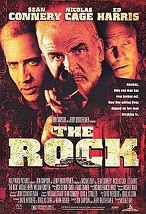
On June 7, 1996 Michael Bay's The Rock (June 7) (Hollywood Pictures) (Buena Vista Pictues) debuts, starring Sean Connery as SAS Capt. John Patrick Mason, the only man to escape from Alcatraz, who is let out to help break in and stop renegade Brig. Gen. Francis X. Hummel, USMC (Ed Harris) with the help of FBI special agent Dr. Stanley Goodspeed (Nicolas Cage, after ARnold Schwarzenegger turns it down; #7 movie of the year ($134M U.S. and $335.1M worldwide box office on a $75M budget).

On June 25, 1996 Roland Emmerich's Independence Day (20th Cent. Fox) debuts, starring Bill Pullman as U.S. pres. Thomas J. Whitmore, fighting aliens from outer space who arrive in 20-mi.-wide ships and zap the White House, eliciting a worldwide jingoistic human speciesist response; Jeff Goldblum plays Jewish genius David Levinson, who uploads a virus to the alien craft, which is neat since he doesn't speak their language well enough to pilot their ships; Will Smith steals half the show as fighter pilot Capt. Steve Hiller; #1 grossing movie of 1996 ($306M U.S. and $817.4M worldwide on a $75M budget); Emmerich wrote the script while promoting the 1994 film "Stargate" after a reporter asked him if he believes in aliens.
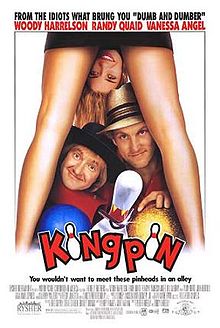
On July 4, 1996 Bobby Farrelly's and Peter Farrelly's Kingpin (MGM) debuts, filmed in Pittsburgh, Penn, starring Woody Harrelson as bowling prodigy Roy Munson, who got in trouble hustlng and ended up wearing a prosthetic hook and living in a seedy apt. bldg. in Scranton, Penn. before deciding to go pro at a $1M tournament in Reno, Nev. with Amish player Ishmael Boorg (Randy Quaid); Bill Murray plays Ernie "Big Ern" McCracken, and Vanessa Angel plays Claudia; features cameos by Steve Tyler, Chris Schenkel, pro bowler Nelson Burton Jr. et al.; "From the idiots what brung you Dumb and Dumber"; does $25M box office on a $27M budget.

On July 5, 1996 Jon Turteltaub's Phenomenon (Touchstone Pictures) debuts, written by Gerald Di Pego, starring John Travolta as average small town guy George Malley, who is visited on his 37th birthday by an ET and transformed into a genius with telekinetic powers, wowing his babe Lace Pennamin (Kyra Sedgwick) and friends Nate Pope (Forest Whitaker) and Doc Brunder (Robert Duvall), while causing the town to turn on him and the govt. to try to use him; brings in $152M on a $32M budget.

On Aug. 23, 1996 Annette Haywood-Carter's Foxfire (Samuel Goldwyn) debuts, based on the 1993 Joyce Carol Oates novel about a teenie girl gang in Hammond, N.Y., starring Hedy Burress as Maddie, Angelina Jolie as Legs, Jenny Lewis as Rita, and Calvin Klein and Donna Koran Jenny Shimizu as Goldie; Jolie and Shimizu begin a longtime lezzie affair after meeting on the set.
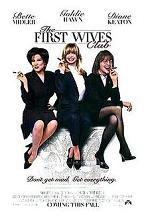
On Sept. 20, 1996 Hugh Wilson's The First Wives Club" (Paramount Pictures) debuts, based on the 1992 novel by Olivia Goldsmith, narrated by Diane Keaton and starring Keaton, Goldie Hawn, and Bette Midler as divorced women Annie MacDuggan Paradis, Elise Eliot Atchison, and Brenda Morelli Cushman, who are seeking revenge on their ex-hubbies who left them for younger women; features cameos by Gloria Steinem, Kathie Lee Gifford, and Ivana Trump, who utters the immortal soundbyte: "Don't get mad, get everything!"; does $181.5M box office on a $30M budget.
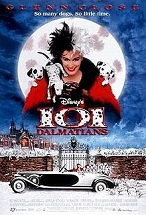
On Nov. 27, 1996 Stephen Herek's 101 Dalmatians (Walt Disney Pictures) (Great Oaks Entertainment) (Buena Vista Pictures) debuts, a live action remake of the 1961 Disney animated movie based on the 1956 Dodie Smith novel stars Glenn Close as Cruella De Vil, Jeff Daniels as Roger, Joely Richardson as Anita, Joan Plowright as Nanny, and Hugh Laurie as Jasper; does $320.6M box office on a $75M budget.

On Dec. 13, 1996 Cameron Crowe's Jerry Maguire debuts, starring Tom Cruise as shark-like sports agent Jerry Maguire, who suddenly sprouts a conscience and pub. "The Things We Think and Do Not Say", based on his mentor Dicky Fox, played by Sony Pictures exec Jared Jussim (1935-), which gets him fired by sharkier boss Bob Sugar (Jay Mohr), only to be rescued by client Rod Tidwell (Cuba Gooding Jr.), who utters the 1990s' new catch phrase (taken from Ariz. Cardinal Tim McDonald): "Show me the money!"; Renee Zellweger plays Cruise's worshipful babe Dorothy Boyd, who utters the soundbyte "You had me at hello"; Kelly Preston plays Cruise's fiancee Avery Bishop; Jerry O'Connell plays hot QB Frank "Cush" Cushman; Bonnie Hunt plays Dorothy's sister Laurel Boyd; Jonathan Lipnicki plays Dorothy's cute boy Ray; Regina King plays Tidwell's wife Marcee after Janet Jackson auditions for the role; "I had two slices of bad pizza, went to bed, and grew a conscience"; the breakthrough role for Cuba Gooding Jr. (1968-); #4 movie of 1996 ($154M); Cruise's 5th consecutive $100M movie after "A Few Good Men" (1992), "The Firm" (1993), "Interview with the Vampire" (1994), and "Mission: Impossible" (1996), making him the #1 box office star of the 1990s.

On Dec. 13, 1996 Tim Burton's Mars Attacks! (Warner Bros.) debuts, based on the trading card series parodying sci-fi B-movies, starring Jack Nicholson, Glenn Close, Annette Bening, Pierce Brosnan, Danny DeVito, and Sarah Jessica Parker, and features gawd-awful Slim Whitman "Indian Love Call" music along with Theremin SFX; Burton's model babe Lisa Marie Smith (1968-) plays the lethal Martian Girl; grosses $101M worldwide on a $100M budget.

On Mar. 21, 1997 Tom Shadyac's Liar Liar (Universal) debuts, starring Jim Carrey as LA atty. Fletcher Reede, who neglects his son Max (Justin Cooper) until a spell causes him to be unable to lie; Maura Tierney plays Fletcher's ex-wife Audrey; Jennifer Tilly plays his lying client Samantha Cole; Cary Elwes plays Audrey's new beau Jerry; does $302.7M box office on a $45M budget.
On Mar. 24, 1997 the 69th Academy Awards are held in Los Angeles, Calif.; the best picture Oscar for 1996 goes to Miramax's The English Patient, along with best dir. to Anthony Minghella, and best supporting actress to Juliette Binoche; best actor goes to Geoffrey Rush for Shine, best actress to Frances McDormand for Fargo, and best supporting actor to Cuba Gooding Jr. for Jerry Maguire ("show me the money").

On Apr. 11, 1997 George Armitage's Grosse Pointe Blank debuts, starring John Cusack as Grosse Pointe South h.s. grad turned assassin Martin Q Blank, who returns to his 10-year reunion to see his h.s. sweetheart Debi Newberry (Minnie Driver), while his rival Grocer (Dan Aykroyd) tries to kill him; also features Joan Cusack as Martin's secy. Marcella, and Alan Arkin as his pshrink.

On May 2, 1997 Jay Roach's Austin Powers: International Man of Mystery debuts, starring "Yeah, baby" Mike Myers as a dentally-challenged spoof of 007, as well as his own pinkie-raising enemy Dr. Evil; Seth Green plays Dr. Evil's Gen-X son Scott Evil; makes the word "shag" (the state dance of S.C.?) popular; "Double-O Behave!"; sequels incl.

On July 2, 1997 Barry Sonnenfeld's Men in Black (Columbia Pictures) debuts, based on the Marvel comic book series, starring Tommy Lee Jones as Agent K, and Will Smith as Agent J, who work for Chief Zed (Rip Torn) to fight renegade alien immigrants from outer space; brings in $589.4M on a $90M budget, causing Marvel to option Spider-Man et al. to Columbia Pictures; followed by the animated "Men in Black: The Series" (1997-2001) on The WB, "Men in Black II" (2002), and "Men in Black 3" (2012) - is that K for kracker and J for jigaboo?

On July 25, 1997 Wolfgang Petersen's Air Force One debuts, an action flick starring Harrison Ford as U.S. pres. James Marshall, whose plane is hijacked by terrorists led by Ivan Korshunov (Gary Oldman), after which he opts out of a golden parachute to stay on board and fight while his vice pres. Kathryn Bennett (Glenn Close) minds the store in the White House; also features Dean Stockwell and William H. Macy; "Das Boot" in the air?; "Liberty Two Four is now Air Force One."

On Sept. 19, 1997 Curtis Hanson's L.A. Confidential (Warner Bros.) debuts, based on the 1990 James Ellroy novel about cop corruption in 1953 Tinseltown being exposed by the scandal mag. "Hush-Hush", starring Kevin Spacey as Sgt. Jack Vincennes, Russell Crowe as officer Wendell "Bud" White, Guy Pearce as incorruptible det. Edmund Jennings "Ed" Exley, James Cromwell as super-corrupt police Capt. Dudley Liam Smith, Kim Basinger as Veronica Lake lookalike-for-hire Lynn Margaret Bracken, and Danny DeVito as reporter Sid Hudgens, whose byline is guess what?; does $126M box office on a $35M budget.

On Oct. 17, 1997 Taylor Hackford's The Devil's Advocate (Warner Bros.) debuts, based on the 1990 Andrew Neiderman novel, starring Keanu Reeves as never-lose Gainesville, Fla. atty. Kevin Lomax, who sells his soul to NYC law firm boss John Milton (Al Pacino), who turns out to be the cackling lecherous Devil, while virtuous wife Mary Ann (Charlize Theron) and evangelic but not 100% angelic mother Alice Lomax (Judith Ivey) try to save him; does $152.9M box office on a $57M budget; "Vanity, definitely my favorite sin."
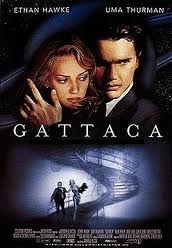
On Oct. 24, 1997 Andrew Niccol's Gattaca debuts, starring Ethan Hawke and Uma Thurman in a biopunk futurist film about a world where those born after preimplanation genetic diagnosis ("valids") are given preferential treatment over those conceived by traditional means ("invalids").

On Oct. 31, 1997 James Cameron's Titanic ("Collide with destiny") debuts, a 3-hour blockbuster written by James Cameron with help from "Night to Remember" author Walter Lord, starring Leonardo ("lion bold") Wilhelm DiCaprio (1974-) as happy-go-lucky itinerant artist Jack Dawson, and Kate Elizabeth Winslet (1975-) as "dish" debutante Rose DeWitt Bukater, who go down for the last time on the same bow where her lover boy DiCaprio earlier crowed "I'm the king of the world"; costs $285M (most expensive movie ever made until ?), becoming a titanic hit, breaking box office records set by "Star Wars" and "ET"; by the end of 1998 it makes $600M in the U.S. plus $1.2B overseas, and receives 14 Academy Award nominations, winning 11 of them, tying the record set by "Ben-Hur"; after "Polly Benedict in the Andy Hardy series" actress Ann Rutherford (b. 1920) turns it down, veteran actress Gloria Stuart (1910-2010) plays 100-y.-o. Rose Dawson Calvert DeWitt Bukater, and becomes the oldest person nominated for an acting Oscar (until ?); Suzan Elizabeth "Suzy" Amis (1962-) (ex-wife of Sam Robards, son of Jason Robards and Lauren Bacall) plays Rose's granddaughter Lizzy Calvert, and after Stuart gets them hooked up and he dumps 3rd wife (1997-9) Linda Hamilton, she and Cameron marry on June 4, 2000; the song My Heart Will Go On, by James Horner and Will Jennings, sung by Celine Dion becomes a titanic hit and wins an Oscar; Winslet's longtime (since age 15) beau Stephen Tredre (1963-97) comes down with bone cancer during the film's production, goes into remission, and she splits with him, then he gets ill again and dies on Dec. 8 during the opening week of the film; on the set she meets and marries James Threapleton (1974-) (3rd asst. dir.), and they have 8 lb. 9 oz. daughter Mia; they divorce in 2000, and she marries dir. Sam Mendes (1965-), who was born in the same Dellwood hospital in Reading as her - my heart will what? Watch trailer; view clip; view clip; view clip.

On Nov. 7, 1997 Paul Verhoeven's Starship Troopers debuts, loosely based on the 1959 Robert A. Heinlein novel with great SFX filmed in Hell's Half Acre in Wyo., starring Caspar Van Dien as young soldier Johnny Rico, who joins the Mobile Infantry to fight the Arachnid Bugs on planet Klendathu while courting babe Lt. Carmen Ibanez (Denise Richards) and being pursued by Dizzy Flores (Dina Meyer); Michael Ironside plays his civilian teacher Jean Rasczak, who becomes his lt.; grosses $121M worldwide on a $105M budget; watch trailer; view clip.

On Nov. 22, 1997 Robert Zemeckis' Contact debuts, based on the 1985 novel by Carl Sagan (who dies during production), starring "Freaky Friday" actress Jodie Foster as Seti astronomer Dr. Ellie Arroway, who receives signals from Vega containing a plan for a gravity-bending spaceship, and goes through the wormholes to meet her own dead daddy (David Morse) uttering the soundbyte "Small steps", and returns only to have the govt. cover it up; Matthew McConaughey plays a crazed preacher; brings in $171M on a $90M budget; "A journey to the heart of the Universe"; "The Universe is a pretty big place. It's bigger than anything anyone has ever dreamed of before. So if it's just us, seems like an awful waste of space, right?" - it would be funny if it weren't so tragic? Watch trailer; view clip.



On Dec. 5, 1997 Gus Van Sant's Good Will Hunting debuts, based on failed genius William James Sidis (1898-1944), becoming a breakthrough for Boston-raised screenwriter-actor buddies Matthew Paige "Matt" Damon (1970-) (Mad Demon?) and Ben Affleck (Benjamin Geza Affleck-Boldt) (1972-) (Son of Affliction?), who star as precious math genius orphan Will Hunting and his blue-collar buddy Chuckie Sullivan; also stars Robin Williams as pshrink Sean Maguire, Stellan Skarsgard as Fields Medal-winning MIT math prof. Gerald Lambeau, and Amelia Fiona J. "Minnie" Driver (1970-) as Will's Harvard pre-med student babe Skylar; makes Woody's L Street Tavern in South Boston famous; Will abandons his brain career for his wiener after curing his pshrink of the loss of his wife, then is cured of his childhood abuse problems in return; brings in $226M on a $10M budget; "If you're not thinking with your wiener then you're acting directly on its behalf" (Driver); "Sorry, guys, I gotta see about a girl" (Williams); "It's not about you, you mathematical dick" (Williams to Skarsgard); "It's not your fault" (Williams to Damon); "You wanna read a real history book? Read Howard Zinn's People's History of the United States. That book'll knock you on your ass" (Will); cops an article from the Dec. 1, 1994 New York Review of Books by Gordon S. Wood and James T. Lemon for a barroom debate about early Am. economics, stimulating interest in U.S. history and/or economics?; "You dropped $150K on an education you coulda got for a dollar fifty in late charges at the public library."

On Dec. 25, 1997 James L. Brooks' As Good As It Gets debuts, written by Mark Andrus (androgynous?), starring Jack Nicholson as misogynistic romance novelist Melvin Udall, who un-courts waitress Carol (Helen Hunt) while dealing with her kid and gay neighbor Greg Kinnear and his bacon-loving dog, finally getting pussy-whipped and admitting to being in love with a real woman who looks great in a bathtub; "I think of a man, then I eliminate all reason and responsibility"; "Go sell crazy somewhere else - we're all stocked up here."
On Feb. 19, 1998 Trinity first calls Neo in the 1999 Warner Bros. film The Matrix; at the end of the film the calling date is Sept. 18, 1999.
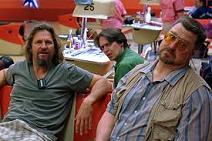
On Mar. 6, 1998 Joel Coen's The Big Lebowski (Gramercy Pictures) debuts, starring Jeff Bridges as Jeff "the Dude" Lebowski, an unemployed bowling-loving Venice, Calif. slacker caught up in the kidnapping of a girl named Bunny (Tara Reid) with a missing toe, who is married to elderly wheelchair-bound miliionaire Jeffrey "Big" Lebowski (David Huddleston); Steve Buscemi and John Goodman play the Dude's bowling buddies Donny and Walter Sobchak; Julianne Moore plays his daughter; Philip Seymour Hoffman plays Big Lebowski's personal asst.; Sam Elliott plays the narrator called The Stranger; contains the word "fuck" and variants 292x, "dude" 160x, and "man" 147x; does $46.2M box office on a $15M budget, and later gains a cult following; "Nothing is fucked here, man"; "The Dude Abides"; "Ever thus to deadbeats, Lebowski!"; "This is wht happens when you fuck a stranger in the ass, Larry"; "I don't like your jerk-off name, I don't like your jerk-off face, I don't like your jerk-off behavior, and I don't like you, jerk-off"; "I don't fucking roll on Shabbos"; "She's not my girlfriend, I'm just helping her conceive, man"; Nihilists! Fuck me. I mean, say what you like about the tenets of National Socialism, Dude, at least it's an ethos"; "Sometimes you eat the bar, and sometimes the bar eats you."
On Mar. 23, 1998 the 70th Academy Awards in Los Angeles are hosted by Billy Crystal (4th time), who makes his entrance on a mockup of the bow of the Titanic; he likes to carry a toothbrush in his pocket for luck; the best picture Oscar for 1997 goes to the 20th Cent.-Fox and Paramount blockbuster Titanic, along with best dir. to James Cameron, although leading man and lady Leonardo di Caprio and Kate Winslet are snubbed for best actor and actress in favor of Jack Nicholson and Helen Hunt in As Good as It Gets (Nicholson dedicates his Oscar to J.T. Walsh, who died from a heart attack on Feb. 27) (last film since "The Silence of the Lambs" (1991) to win both leading acting films until ?); funny guy Robin Williams gets serious and wins best supporting actor for Good Will Hunting, and Matt Damon and Ben Affleck win for best screenplay; the show lasts 3 hours and 46 min., 30 min. longer than the best picture winner.

On May 15, 1998 Robert Redford's The Horse Whisperer (Touchstone Pictures) debuts, based on the 1995 Nicholas Evans novel, starring Redford as you know what Tom Booker, Kristin Scott Thomas as Annie MacLean, Scarlett Johansson as her daughter Grace, Chris Cooper as Frank Booker, and Sam Neill as Robert MacLean; does $187M box office on a $60M budget.
In June 1998 the Am. Film Inst. releases its list of the 100 greatest U.S. films of all time in celebration of the 100th anniv. of U.S. cinema, the top 10 being "Citizen Kane" (1941), "Casablanca" (1942), "The Godfather" (1972), "Gone with the Wind" (1939), "Lawrence of Arabia" (1962), "The Wizard of Oz" (1939), "The Graduate" (1967), "On the Waterfront" (1954), "Schindler's List" (1993), and "Singin' in the Rain" (1952); none feature Greta Garbo, Fred Astaire or Ginger Rogers; only "Fargo" (1996) makes it on the 1995- list.

On July 1, 1998 Michael Bay's Armageddon (Touchstone Pictures) (Buena Vista Pictures) debuts, starring Bruce Willis, Ben Affleck, Steve Buscemi, Billy Bob Thornton, Will Patton, Michael Clarke Duncan, Owen Wilson, Peter Stormare, and Liv Tyler, attempting to cash in on Millennium Fever with a giant asteroid threatening to impact Earth and a special NASA expedition to deflect it with a nuke combined with silly love affairs and overblown heroism, powered by an Arrowsmith sound track; #2 movie of 1998 ($202M U.S. and $553.7M worldwide box office on a $140M budget); "It's time to kick some asteroid"; watch trailer.

On July 15, 1998 the Farrelly Brothers' There's Something About Mary (20th Cent. Fox) debuts, starring Ben Stiller and Matt Dillon, propelling super-big-smile-petite-butt Cameron Michelle Diaz (1972-) to the top with great word of mouth and a great hairdo made of cum; does $370M box office on a $23M budget.

On July 17, 1998 Martin Campbell's The Mask of Zorro (Amblin Entertainment) debuts, starring Anthony Hopkins as the aging masked swordsman, Antonio Banderas as his protege Alejandro, and Welsh-born Catherine Zeta-Jones (1969-) as Elena, causing her to become Hollywood's new It girl, attracting graverobber, er, great catch Michael Douglas, whose pickup line is "I want to father your children"; does $250M box office on a $96M budget - who can say no to the son of Spartacus?


On July 24, 1998 Steven Spielberg's Saving Private Ryan (Paramount Pictures) debuts, based on a Robert Rodat script about a search for paratrooper James Francis Ryan (Matt Damon, who was chosen for being an unknown, which backfires when "Saving Private Ryan" hits the theaters first) of the U.S. 101st Airborne Div., 1st Battalion, 506th Parachute Infantry Regiment after D-Day features weak screenplay and actors, except for Tom Hanks (as Capt. John H. Miller of the 2nd Ranger Battalion), but its opening D-Day invasion Omaha Beach sequence rocks the Ritz bigtime; top grossing flick of 1998 ($216M); last R-rated film to head the annual box office charts until "American Sniper" (2014); the film debut of Vin Diesel (Mark Sinclair Vincent) (1967-) as Pvt. Adrian Caparzo (paid $100K); in 1994 Rodat saw a monument in Putney Corners, N.Y. dedicated to eight real brothers who died in the U.S. Civil War.

On Dec. 3, 1998 John Madden's Shakespeare in Love (Universal Pictures) debuts, written by Tom Stoppard and Marc Norman, starring Joseph Fiennes as William Shakespeare, who falls for hot babe Viola De Lesseps (Gwyneth Paltrow), and writes "Romeo and Juliet" for her, while she dresses as a man to act in it, and rival theater owner Philip Henslow (Geoffrey Rush) closes in; Colin Firth plays Viola's fiance the Earl of Wessex, a title that went defunct in 1066, causing Prince Edward to ask Elizabeth II to give it to him; Judi Dench plays Queen Elizabeth I; does $289.3M box office on a $25M budget.
On Mar. 21, 1999 the 71st Academy Awards in Los Angeles are hosted by Whoopi Goldberg, who opens in full Elizabethan regalia and wears a total of nine different outfits; Cate Blanchett and Dame Judi Dench both receive Oscar nominations for playing Queen Elizabeth I in different films, with Dench's performance totalling 8 min.; the best picture Oscar for 1998 goes to Miramax's Shakespeare in Love, along with best actress to Gwyneth Paltrow and best actress to Judi Dench; best actor goes to Italian star Roberto Benigni for Life Is Beautiful, best supporting actor to James Coburn for Affliction, and best dir. to Steven Spielberg for Saving Private Ryan; 1950s "snitch" dir. Elia Kazan receives an honorary award, which many audience members protest.

On Mar. 31, 1999 Andy Wachowski's and Larry Wachowski's The Matrix (Warner Bros.) debuts, starring Keanu Reeves as trenchcoat-wearing hacker Neo, super-slick black-vinyl-and-hair dream babe Carrie-Ann Moss as Trinity, and pince-nez-wearing Samuel L. Jackson as Morpheus (Roman god of dreams) in a quantum leap in sci-fi flicks, where the Internet becomes a bad joke that can be bypassed with telephones, and all humans are really held in vats and fed virtual reality stimuli so that their bodies can be farmed for energy to feed computerized robots who have taken over the Earth; in the VR world the initiated can perform impossible feats and do neat Kung Fu with hidden wires; Hugo Weaving plays the ultimate villain Agent Smith; #5 movie of 1999 ($172M U.S. and $463.5M worldwide box office on a $63M budget), it spawns two sequels, "The Matrix: Reloaded" (2003) and "The Matrix: Revolutions" (2003); the flicks are full of cool psychobabble soundbytes, incl.: "I know you're out there. I can feel you now. I know that you're afraid. You're afraid of us. You're afraid of change. I don't know the future. I didn't come here to tell you how this is going to end. I came here to tell you how it's going to begin. I'm going to hang up this phone, and then I'm going to show these people what you don't want them to see. I'm going to show them a world without you. A world without rules and controls, without borders or boundaries; a world where anything is possible. Where we go from there is a choice I leave to you"; "I imagine that right now you're feeling a bit like Alice, tumbling down the rabbit hole"; "You have the look of a man who accepts what he sees because he is expecting to wake up. Ironically, that's not far from the truth"; "Unfortunately, no one can be told what The Matrix is. You have to see it for yourself"; "I'm trying to free your mind, Neo. But I can only show you the door. You're the one that has to walk through it"; "You take the blue pill, the story ends here, you wake up and believe whatever you want to believe. You take the red pill and I'll show you just how deep the rabbit hole goes"; "The Matrix is the world that has been pulled over your eyes to blind you from the truth"; "Have you ever had a dream, Neo, that you were so sure was real? What if you were unable to wake from that dream? How would you know the difference between the dream world and the real world?"; "Reality is a thing of the past"; "There is a difference between knowing the path and walking the path"; the little problem of where the liquid human food comes from, if not humans, raises a little problem with the Law of Energy Conservation?

On June 30, 1999 Barry Sonnenfeld's Wild Wild West, debuts, based on the 1965-9 TV series, starring Will Smith as Maj. James West, bringing in a funky steampunk slave thang dimension; also stars Kevin Kline as Artemus Gordon and Pres. Grant, Kenneth Branagh as bad guy Dr. Arliss Loveless, and Salma Hayek as Rita Escobar.
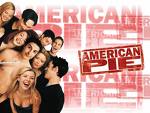
On July 9, 1999 Paul Weitz's and Chris Weitz's American Pie (Universal Pictures) debuts, starring Jason Biggs as Jim Levenstein, Chris Klein as Chris "Oz" Ostreicher, Thomas Ian Nicholas as Kevin Myers, Alyson Hannigan as Michelle Flaherty, and Shannon Elizabeth as Nadia, basically pulling all the stops of decency to expose the alley cat sexual degeneracy of its entire production co., becoming a hit, proving ditto about the end-of-the-millennium viewing public; the title is based on the song of the same name, and the protagonist masturbating with a warm apple pie after being told that's what 3rd base feels like; the theme song is Laid by James; does $235.4M box office on an $11M budget; spawns sequels "American Pie 2" (2001), "American Wedding" (2003), and "American Reunion" (2012); "There's something about your first piece."

On July 16, 1999 Stanley Kubrick's Eyes Wide Shut (Kubrick's last film) debuts, starring Tom Cruise and his wife Nicole Kidman as Dr. William "Bill" Harford and his wife Alice, who stumble into a Baal-worshipping cult in Jew York after she admits to almost cheating on him; the film breaks them up for real?

On Aug. 2, 1999 M. Night Shyamalan's The Sixth Sense (Aug. 2) (Hollywood Pictures) (Spyglass Entertainment) (Buena Vista Pictures) debuts, starring precocious boy actor Haley Joel Osment (1988-) as 9-y.-o. Cole Sear, who has the power to see dead people, and Bruce Willis as child pshrink Dr. Malcolm Crowe, who doesn't know he's dead and tries to cure him, creating a great revelation at the end the first time you see it; puts Shyamalan (the king of shamelessly shamming the audience until the end?) on the map; #2 movie of 1999 ($293.5M U.S. and $672.8M worldwide box office on a $40M budget); "There are ghosts walking among us, looking for help."
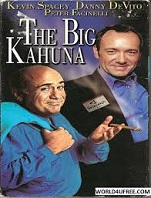
On Sept. 16, 1999 John Swanbeck's The Big Kahuna debuts, written by Roger Rueff based his play "Hospitality Suite", starring Kevin Spacey, Danny DeVito, and Peter Facinelli as industrial lubricant salesmen Larry Mann, Phil Cooper, and Bob Walker, who attend a trade show and are desperate to arrange a meeting with the head of a large co.; ends with a recitation of "Wear Sunscreen" by Mary Schmich; does $3.7M box office on a $7M budget.

On Sept. 8, 1999 Sam Mendes' American Beauty (DreamWorks Pictures) cheerleader friend; Annette Bening stars in an Oscar-nominated role as his real-estate broker wife Carolyn; does $356.3M box office on a $15M budget.
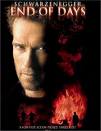
On Nov. 16, 1999 Peter Hyams' End of Days (Beacon Pictures) (Universal Pictures) debuts, starring Arnold Schwarzenegger as former NYPD detective Jericho Cane, who protects innocent young Christine York (Robin Tunney) from Satan (Gabriel Byrne) on the Millennium; Mark Margolis plays the pope, Rod Steiger plays Father Kovak, Derrick O'Connor plays Thomas Aquinas, and Kevin Pollak plays Bobby Chicago; does $212M box office on a $100M budget; "Lethal Weapon meets The Omen"; watch trailer; view clip.
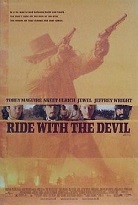
On Nov. 26, 1999 Ang Lee's Ride with the Devil (Universal Pictures) debuts, based on the novel "Woe to Live On" by Daniel Woodrell about the Confed. 1st Mo. Irregulars AKA Bushwackers and the Lawrence Kan. Massacre, starring Tobey Maguire as Jake "Dutch" Roedel, Skeet Ulrich as Jack Bull Chiles, Simon Baker as George Clyde, Jeffrey Wright as freed slave Daniel Holt, and Jewel as Sue Lee; does only $635K box office on a $38M budget.

On Dec. 10, 1999 Lasse Hallstrom's The Cider House Rules (Miramax) debuts, based on the 1985 John Irving novel, starring Tobey Maguire as St. Cloude, Maine orphan Homer Wells, who is training to be an obstetrician by Dr. Wilbur Larch (Michael Caine) and hooks up with pregnant babe Candy Kendall (Charlize Theron) whilew hile visiting to get an abortion; Delroy Lindo plays Arthur Rose; does $88.5M box office on a $24M Budget; "Goodnight you princes of Maine, you kings of New England."
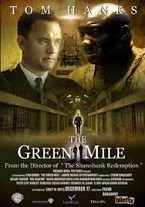
On Dec. 10, 1999 Frank Darabont's The Green Mile (Warner Bros.), based on the 1996 Stephen King novel debuts, starring Tom Hanks as Cold Mountain Penitentiary (Maine) death row guard Paul Edgecomb, who must guard big dumb black convicted rapist-murderer John Coffey (Michael Clarke Duncan) in 1935, who has amazing supernatural abilities, and he realizes is innocent; David Morse plays fellow guard Brutus "Brutal" Howell; Doug Hutchison plays sadistic guard Percy Wetmore, who doesn't wet the sponge on inmate Eduard "Del" Delacroix (Michael Jeter), who loves his pet mouse Mr. Jingles; Sam Rockwell plays crazy serial killer William "Wild Bill" Wharton; Dabbs Greer plays Old Paul Edgecomb; does $291M box office on a $60M budget.

On Dec. 17, 1999 Chris Columbus' Bicentennial Man, debuts, based on the 1992 novel "The Positronic Man" by Isaac Asimov and Robert Silverberg, starring Robin Williams as NDR series robot Andrew, who lives 200 years, and in 2205 is officially recognized as human.

On Dec. 21, 1999 James Mangold's Girl, Interrupted (Columbia) debuts, based on the 1993 memoir by Susanna Kaysen about her 18-mo. stay at Claymoore mental hospital in 1967-8, starring Winona Ryder as Kaysen, Brittany Murphy as Daisy, Elisabeth Moss as Torch, Angela Bettis as Janet, and Jillian Armenante as Cynthia, making a star of Angelina Jolie as sociopath Lisa Rowe; does $48.4M box office on a $24M budget.

On Mar. 10, 2000 Brian De Palma's Mission to Mars debuts, starring Gary Sinise, Tom Robbins, Don Cheadle, Jerry O'Connell, and Connie Nielsen, who have a bad trip there followed by an alien-boosted one back.
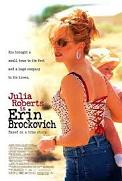
On Mar. 17, 2000 Steven Soderbergh's Erin Brockovich (Universal Pictures) debuts, starring Julia Roberts as a govt. whistleblower who "brought a small town to its feet and a huge corporation to its knees" by helping atty. Edward L. Masry (Albert Finney) sue Pacific Gas and Electric Co. (PG&E) (Poison the Ground and Evade Justice?) in Hinkley, Calif. and win a record judgment; does $256M box office on a $51M budget; her first Oscar nod was for "Steel Magnolias", but who remembers?; "I just went out there and performed sexual favors. Six hundred and thirty-four blow jobs in five days. I'm really quite tired."
On Mar. 26, 2000 the 72nd Academy Awards in Los Angeles awards the best picture Oscar for 1999 to American Beauty, along with best dir. to Sam Mendes, and best actor to Kevin Spacey; best actress goes to Hilary Swank for Boys Don't Cry, best supporting actor to Michael Caine for The Cider House Rules, and best supporting actress to Angelina Jolie for Girl Interrupted.

On May 5, 2000 Ridley Scott's Gladiator debuts, starring Russell Crowe as Roman Gen. Maximus Decimus Meridius, who is on the wrong side after Marcus Arelius dies, ends up a lowly gladiator, and overcomes his chicken limbs to outfight every gladiator in Rome incl. a chained tiger, while emperor Commodus (Joaquin Phoenix) quakes in his purple toga, waiting for the inevitable overthrow attempt while doing what emperors do; #4 movie of 2000 ($216M); Connie Nielsen plays Commodus' scheming sister Lucilla, whom he has the hots for; animal trainer Randy Miller (1965-) wins the first-ever World Stunt Academy Award for his work with the "ferocious tigers" as Crowe's stunt double; too bad, on Apr. 22, 2008 his cousin Stephan Miller (1969-2008) is mauled to death by 700-lb. grizzly bear Rocky.
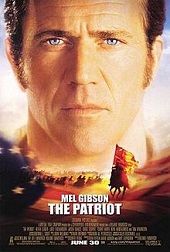
On June 28, 2000 Roland Emmerich's The Patriot (Columbia Pictures) debuts, starring Mel Gibson as S.C. farmer Benjamin Martin, who votes against S.C. joining the Am. Rev. only to see his son Gabriel (Heath Ledger) join the Am. rebels, bringing mean British Col. William Tavington (Jason Isaacs) down on him hard enough to turn rebel himself, becoming known as the Ghost; Heath Ledger plays Martin's eldest son Gabriel; Joely Richardson plays his sister-in-law Charlotte; Tom Wilkinson plays Lord Cornwallis; Adam plays loyalist Capt. James Wilkins; Rene Auberjonois plays Rev. Oliver; does $215.3M box office on a $110M budget; watch trailer.

On July 29, 2000 Hollywood star Brad Pitt marries Hollywood star Jennifer Joanna Aniston (1969-), becoming known as Branifer; Jeff Buckley's music is used at their wedding; the public thinks they're the ideal married couple and should live happily together forever, but it only lasts until 2005.
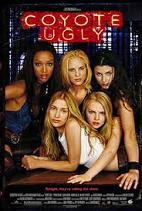
On Aug. 4, 2000 David McNally's Coyote Ugly (Touchstone Pictures) debuts,, produced by Jerry Bruckheimer based on the 1997 Elizabeth M. Gilbert story, starring Piper Perabo as cute innocent struggling songwriter Violet "Jersey" Sanford, who makes ends meet at the Coyote Ugly stripper saloon while trying to fool her daddy Billene (John Goodman) and courting Aussie hunk Kevin O'Donnell (Adam Garcia); Tyra Banks plays Zoe; Maria Bello plays owner Lil; Izabello Miko plays Cammie; does $114M box office on a $45M budget.

On Aug. 4, 2000 Clint Eastwood's Space Cowboys debuts, starring Eastwood, Tommy Lee Jones, Donald Sutherland, and James Garner as old fart NASA engineers called back for one last space mission to rescue an obsolete Russian satellite that only they can understand, after which it is revealed that they really don't but just want to go into space after their original astronaut hopes as part of the Air Force project DAEDALUS were ruined in 1958 by the creation of NASA.

On Aug. 11, 2000 Howard Deutch's The Replacements (Warner Bros.) debuts, about replacement players during an NFL strike who only have to win 3 of 4 to go to the playoffs stars Keanu Reeves as QB Shane Falco, Gene Hackman as the coach Jimmy McGinty, and Brooke Langton (real-life cheerleader for the Washington Sentinels) as Falco's cheerleader babe Annabelle Farrell.; does $50.1M box office on a $50M budget; watch trailer.
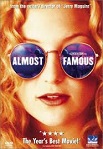
On Sept. 13, 2000 Cameron Crowe's Almost Famous (Columbia Pictures) debuts, starring Patrick Fugit (1982-) as 15-y.-o. William Miller, who gets to accompany rock band Stllwater and write a story for Rolling Stone mag.; also stars Billy Crudup (as Russell Hammond), Frances McDormand (as Elaine Miller), and Kate Hudson (as Penny Lane), who marries almost-famous Chris Robinson of the Black Crowes; first drama to have an authorized Led Zeppelin tune on its soundtrack after comedy "Fast Times at Ridgemont High" (1982); best film of 2000 according to Roger Ebert; does $47M box office on a $60M budget.
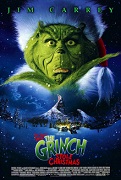
On Nov. 8, 2000 Ron Howard's How the Grinch Stole Christmas (Imagine Entertainment) (Universal Pictures) debuts, based on the 1957 Dr. Seuss children's book and narrated by Anthony Hopkins, starring Jim Carrey as the Grinch, Taylor Momsen as Cindy Lou Who, and Jeffrey Tambor as Mayor Augustus May Who; Josh Ryan Evans plays the boy Grinch; does $345.1M box office on a $123M budget (#6 film of 2000); watch trailer.

On Nov. 10, 2000 Anthony Hoffman's Red Planet (Village Roadshow Pictures) (Warner Bros.) debuts, starring Carrie-Anne Moss as sex tease astronaut Cmdr. Kate Bowman going to terraforming Mars with Robby Gallagher (Val Kilmer), Lt. Ted Santen (Benjamin Bratt), Dr. Quinn Burchenal (Tom Sizemore), Dr. Bud Chantilas (Terence Stamp), and Chip Pettengil (Simon Baker), where a robot named AMEE goes badass on them and the lunatics take over the asylum; does $33.5M box office on an $80M budget; watch trailer.
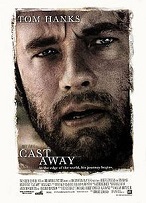
On Dec. 22, 2000 Robert Zemeckis' Cast Away (ImageMovers) (Playtone) (20th Cent. Fox) (DreamWorks Pictures), filmed on Monuriki Island in the Mamanuca Islands of Fiji stars Tom Hanks as marooned FedEx employee Chuck Noland, who plays Robinson Crusoe with a volleyball named Wilson for 1.5K days, then returns to the civilized world to find his wife Kelly Frears (Helen Hunt) married to another man; brings in $429.6M worldwide on a $90M budget; #2 movie of 2000 ($234M U.S. and $429.6M worldwide box office on a $90M budget); watch trailer; view clip.

On Dec. 22, 2000 Joel Coen's and Ethan Coen's O Brother, Where Art Thou? (Touchstone Pictures) debuts, based on Homer's poem "The Odyssey", set in 1937 Mississippi and satirizing the 1941 Preston Sturges flick "Sullivan's Travels", starring George Clooney, John Turturro, and Tim Blake Nelson as escaped chained cons Everett Ulysses McGill, Pete Hogwallop, and Delmar O'Donnell, who are looking for a buried $1.2M bank heist loot before a flood washes it away, while singing with the Soggy Bottom Boys; John Goodman plays 1-eyed Bible salesman Daniel "Big Dan" Teague (Polyphemus), and Holly Hunter plays Penny (Penelope); the hillbilly music soundtrack featuring Man of Constant Sorrow wins the 2001 Grammy album of the year.

In 2000 after vacationing in Tahiti in 1994 and reading Sidney Sheldon's "Doomsday Conspiracy", beginning "to suspect that maybe I could write a 'thriller' of this type one day", Exter, N.H.-born Daniel "Dan" Brown (1964-) son of Phillips Exeter Academy math prof. Richard G. Brown and musician Constance Brown), educated at Phillips Exeter Academy and Amherst College pub. Angels and Demons, about how the Illuminati are real and out ta getchya, introducing Harvard U. prof. Robert Langdon; filmed in 2009. Pass the cilice, Mother T? On Mar. 18, 2003 (two days after the U.S. invades Iraq) he pub. The Da Vinci Code; 10K advance copies and 230K initial press run; 23,578 sold the first week, making #1 on the NYT bestseller list ("the novel that ate the world"); "Renowned curator Jacques Sauniere staggered through the vaulted archway of the museum's Grand Gallery" (first line); "O, Draconian devil! Oh, lame saint!"; "So dark the con of man"; "In London lies a knight a pope interred/ His labor's fruit a Holy wrath incurred/ You seek the orb that ought be on his tomb/ It speaks of Rosy flesh and seeded womb"; "The Holy Grail 'neath ancient Roslin waits/ The blade and chalice guarding o'er Her gates/ She rests at last beneath the starry skies"; Harris Tweed-loving Harvard U. religious symbology prof. Robert Langdon (language don?), Capt. Bezu Fache (busy fish?) and Lt. Jerome Collet (roam around and collate his boss' microfiche?) of the DCPJ, Jacques Sauniere (saner?) of the Louvre, "Princess" Sophie (Sofia) Neveu (renovate?) alias St. Clair (not Plantard), monk Silas (Sauniere's Judas?) and Bishop Manuel Aringarosa (ring around the rosey?) of Opus Dei (which has only lay members?), Andre Vernet (wears vernier Rolex timepieces?) of the Depository Bank of Zurich, Sir Leigh Teabing (Sir Lipton tea bag?) alias the Teacher at Chateau Villette (1668) and his manservant Remy Legaludec (legal duke?) from Lyons and his Medusa revolver, the Da Vinci cryptex with password SOFIA, er, APPLE, fleur de lis, PHI, Amon L'Isa, 325 Council of Nicea, security warden Claude Grouard (guard?), Pamela Gettum (I'll get um for ya?) of King's College library, Church of Saint-Sulpice in Paris with the first Rose Line and Sister Sandrine Bieil (bee eye?), Vatican Biblioteca Astronomica, Gare Saint-Lazre train station, 24 Rue Haxo and the Bois de Boulogne ("garden of earthly delights"), Friday the 13th of Oct. 1307, Leonardo da Vinci (always called Leonardo, never da Vinci?) and his Vitruvian Man, Mona Lisa, Madonna of the Rocks and skitoma-filled Last Supper, Sofia, 1099 Priory of Sion and Godefroi de Bouillon, Pentacle of Venus and Hieros Gamos, Dead Sea Scrolls, Sang Real not San Greal, Mary Magdalene of the tribe of Benjamin and Jesus of the House of David equals unbelievable; Atbash cipher and Sheshach alias Babel, Sir Isaac Newton and Alexander Pope, 1185 London Temple Church and 1065 Westminster Abbey with College Garden and octagonal Chapter House, 1446 Rosslyn Chapel (Cathedral of Codes) with the Boaz and Jachin pillars, Fibonacci sequence 13-3-2-21-1-1-8-5; "Yo soy un espectro" (Silas) (p. 56); starting with Ch. 58 the book gets rather preachy?; "Leonardo was one of the keepers of the secret of the Holy Grail. And he hid clues in his art" (Teabing) (p. 230); "Almost everything our fathers taught us about Christ is false... More than eighty gospels were considered for the New Testament, and yet only a relative few were chosen for inclusion - Matthew, Mark, Luke, and John, among them... The Bible, as we know it today, was collated by the pagan Roman emperor Constantine the Great... a lifelong pagan who was baptized on his deathbed, too weak to protest" (Teabing) (pp. 230-1); "At this gathering many aspects of Christianity were debated and voted upon - the date of Easter, the role of the bishops, the administration of sacraments, and of course, the divinity of Jesus... Until that moment in history, Jesus was viewed by His followers as a mortal prophet... a great and powerful man, but a man nonetheless.... Jesus' establishment as 'the son of God' was officially proposed and voted on by the Council of Nicaea... A relatively close vote at that"; "It was all about power... Christ as Messiah was critical to the functioning of Church and state. Many scholars claim that the early Church literally stole Jesus from His original followers, hijacking His human message, shrouding it in an impenetrable cloak of divinity, and using it to expand their own power" (Teabing) (p. 233); "The twist is this... Because Constantine upgraded Jesus' status almost four centuries after Jesus' death, thousands of documents already existed chronicling His life as a mortal man. To rewrite the history books, Constantine knew he would need a bold stroke. From this sprang the most profound moment in Christian history... Constantine commissioned and financed a new Bible, which omitted those gospels that spoke of Christ's human traits and embellished those gospels that made Him godlike. The earlier gospels were outlawed, gathered up, and burned" (Teabing) (p. 234); "Fortunately for historians... some of the gospels that Constantine attempted to eradicate managed to survive... the Dead Sea Scrolls were found in the 1950s hidden in a cave near Qumran in the Judean desert. And, of course, the Coptic Scrolls in 1945 at Nag Hammadi. In addition to telling the true Grail story, these documents speak of Christ's ministry in very human terms. Of course, the Vatican, in keeping with their tradition of misinformation, tried very hard to suppress the release of these scrolls. And why wouldn't they? The scrolls highlight glaring historical discrepancies and fabrications, clearly confirming that the modern Bible was compiled and edited by men who possessed a political agenda - to promote the divinity of the man Jesus Christ and use His influence to solidify their own power base" (Teabing) (p. 234); "The Grail... is symbolic of the lost goddess. When Christianity came along, the old pagan religions did not die easily. Legends of chivalric quests for the lost Grail were in fact stories of forbidden quests to find the lost sacred feminine. Knights who claimed to be 'searching for the chalice' were seaking in code as a way to protect themselves from a Church that had subjugated women, banished the Goddess, burned nonbelievers, and forbidden the pagan reverence for the sacred feminine" (Langdon) (pp. 238-9); "It was not Peter to whom Christ gave directions with which to establish the Christian Church. It was Mary Magdalene... Jesus was the original feminist. He intended for the future of His Church to be in the hands of Mary Magdalene" (Teabing) (p. 248); "Behold the greatest cover-up in human history. Not only was Jesus Christ married, but He was a father. My dear, Mary Magdalene was the Holy Vessel. She was the chalice that bore the royal bloodline of Jesus Christ. She was the womb that bore the lineage, and the vine from which the sacred fruit sprang forth" (Teabing) (p. 249); becomes bestselling adult novel of all time (60M by 2006), spawning the new genre of fractured history written at the 8th grade level for the history-starved masses ("You don't hate history, you just hate your own history"?) spoon-fed during a ridiculous murder adventure; milks the fallacy of the evil albino, the fallacy of the talking killer, and the fallacy of the Bride of Christ not being his Church but his hot freckled red-haired bunkbunny Mary Magdalene, whose DNA (check out that melanocritia-1 receptor?) is more valuable than weapons-grade plutonium?; the best hook is the novel's opening: "FACT... All descriptions of artwork, architecture, documents, and secret rituals in this novel are accurate", spawning the Anti-Da Vinci Code Industry; "Do we not have the right to be accompanied by a wife, as the other apostles and the brothers of the Lord and Cephas?" (1 Cor. 9:5); watch trailer; watch video; watch video; watch video; watch video; watch video.
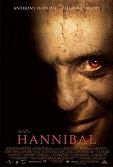
On Feb. 9, 2001 Ridley Scott's Hannibal (Dino De Laurentiis Co.) (Scott Free Productions) (MGM) (Universal Pictures) debuts, based on the 1999 Thomas Harris novel (sequel to the 1991 film "The Silence of the Lambs"), written by David Mamet and Steven Zaillian, starring Anthony Hopkins as big brain serial killer Hannibal Lecter, Jullian Moore as FBI agent Clarice Starling, unrecognizable Gary Oldman as self-disfigured millionaire Mason Verger, Ray Liotta as Justice Dept. official Paul Krendler, and Giancarlo Giannini as Italian cop Rinaldo Pazzi; features the song Vide Cor Meum (See My Heart) by Irish composer Patrick Cassidy; does $351.6M box office on a $87M budget; bon appetit?
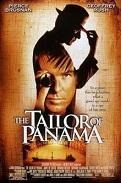
On Feb. 11, 2001 John Boorman's The Tailor of Panama (Columbia Pictures) debuts, based on the 1996 John Le Carre spy novel, starring Pierce Brosnan as MI6 spy Andrew "Andy" Osnard, Geoffrey Rush as tailor Harold "Harry" Pendel, and Jamie Lee Curtis as his wife Louisa in an absurd plot about the days when the Panama Canal changed hands, but not really, Pendel made it all up; does $28M box office on a $21M budget.
On Mar. 25, 2001 the 73rd Academy Awards are held in Los Angeles, and 242 films are eligible for consideration; the best picture Oscar for 2000 goes to DreamWorks and Universal for the much-computer-pumped Gladiator, along with the best actor award to Russell Crowe (as well-known Roman historical figure Maximus Decius Meridius, chicken legs and all?); best actress goes to Julia Roberts for Erin Brockovich, best dir. to Steven Soderbergh, and best supporting actor to Benicio Del Toro for Traffic, and best supporting actress to Marcia Gay Harden for Pollock.

On Apr. 6, 2001 Ted Demme's Blow debuts, based on a true story, starring Johnny Depp as George Jung, a Calif. surfer boy who founded the U.S. cocaine market in the 1970s without seemingly realizing how dangerous it was.
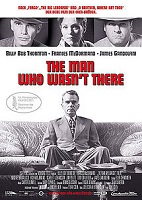
On May 13, 2001 Joel Coen's B&W The Man Who Wasn't There (Working Title Films) (Gramercy Pictures) debuts, a crime noir set in 1949 starring Billy Bob Thornton as barber Ed Crane, who gets sold on a screen to invest in the newfangled dry-cleaning biz and ends up losing his wife Doris (Frances McDormand) and going to death row after his expensive shyster lawyer Freddy Riedenschneider (Tony Shalhoub) leaves him defenseless; last film distributed by Gramercy Pictures until 2015; does $18.9M box office on a $20M budget.

On May 21, 2001 Michael Bay's Pearl Harbor (Touchstone Pictures), debuts, produced by Jerry Bruckheimer and written by Randall Wallace, intertwining a silly unbelievable love story a la Titanic between Ben Affleck (Capt. Rafe McCawley) and Kate Beckinsale (Nurse Lt. Evelyn Johnson McCawley) with the big sneak attack; Alec Baldwin almost saves it with critics as Lt. Col. James Doolittle, which doesn't stop it from being a box office smash; #7 movie of 2001 ($199M box office U.S. and $449.2M worldwide on a $140M budget);

On June 29, 2001 Steven Spielberg's A.I. Artificial Intelligence (Amblin Entertainment) (Stanley Kubrick Productions) (Waner Bros.) (DreamWorks Pictures) debuts, based on the story "Super-Toys Last All Summer Long" by Brian Aldiss, starring Haley Joel Osment as David, a boy android uniquely programmed with the ability to love; also stars Jude Law, Frances O'Connor, Brendan Gleeson, and William Hurt; dedicated to Stanley Kubrick; does $235.9M box office on a $100M budget.

On July 27, 2001 Tim Burton's Planet of the Apes (The Zanuck Co.) (20th Cent. Fox) debuts, a remake of the 1968 movie stars Mark Wahlberg as human Capt. Leo Davidson, Tim Roth as chimp Gen. Thade, Michael Clarke Duncan as gorilla Col. Attar, and Helena Bonham Carter as chimp Ari; does $362M box office on a $100M budget; #10 movie of 2001 ($180M); the ending actually precludes a sequel? Watch trailer.

On Aug. 3, 2001 Peter Bogdanovich's The Cat's Meow (Lionsgate) debuts, based on the book by Steven Peros about the mysterious death of film dir. Thomas H. Ince (Cary Elwes) in Nov. 1924 aboard the yacht of William Randolph Hearst (Edward Herrmann) featuring Kirsten Dunst as Hearst's babe Marion Davies, Eddie Izzard as Charlie Chaplin, and Jennifer Tilly as Louella Parsons, who witnesses Hearst do it and blackmails him into a lifetime syndication contract for her gossip column; does $3.6M box office on a $7M budget.
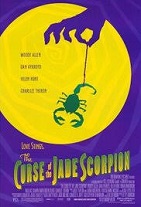
On Aug. 24, 2001 Woody Allen's The Curse of the Jade Scorpion (DreamWorks Pictures) debuts, a screwball comedy set in Oct. 1940 starring Allen (after Tom Hanks and Jack Nicholson turn it down) as aging nerdy New York City insurance investigator C.W. Biggs of North Coast Fidelity and Casualty Insurance Co., who is hypnotized at the Rainbow Room along with efficiency expert Betty Ann Fitzgerald (Helen Hunt) by Voltan (David Ogden Stiers), who implants codewords in their minds that allow him to use them to stage jewel robberies and not remember it; Charlize Theron plays Laura Kensington; Dan Aykroyd plays Briggs' boss and Betty's lover Chris Magruder; Wallace Shawn plays George Bond; Elizabeth Berkley plays Jill; a 1940s film noir in color instead of B&W?; the set bldg. was too expensive, making retakes too expensive?; Allen's worst movie?; features the song In a Persian Market by Wilbur de Paris; does $18.9M box office on a $33M budget.
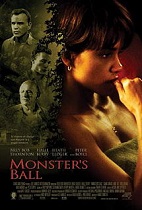
On Nov. 11, 2001 Marc Forster's Monster's Ball (Lions Gate Films) debuts, starring Billy Bob Thornton as prison guard Hank Grotowski, son of racist Buck (Peter Boyle), who falls in love with brown sugar Leticia Musgrove (Halle Berry), wife of death row inmate Lawrence (Sean "P. Diddy" Combs), and questions his upbringing; does $44.9M box office on a $4M budget.

On Dec. 21, 2001 Ron Howard's A Beautiful Mind (Imagine Entertainment) (Universal Pictures) debuts, based on the 1998 book by Sylvia Nasar, starring Russell Crowe as schizophrenic Princeton U. mathematician John Nash, who marries student Alicia (Jennifer Connelly) and fakes it for years until he is found out, which doesn't stop him from winning the 1994 Nobel Econ. Prize for helping invent game theory; features Ed Harris as imaginary secret agent William Parcher, Paul Bettany as imaginary friend Charles Herman; does $313M box office on a $58M budget; "Perhaps it is good to have a beautiful mind, but a greater gift is to discover a beautiful heart."


On Feb. 15, 2002 Tamra Davis' Crossroads debuts, written by Shonda Rhimes (1970-), starring pop singer Britney Spears in her film debut as Lucy Wagner, Zoe Saldana as Kit, and Taryn Manning as Mimi, three childhood friends who go on a cross-country trip with Ben Kimble (Anson Mount), a guy they just met; does $61M box office on a $10M budget; Mount is nominated for a Golden Raspberry Award for the performance, but not by name.
On Mar. 24, 2002 the 74th Academy Awards in Los Angeles are hosted by Whoopi Goldberg (2nd time), who opens dressed in feathers and dangling from the roof of the Kodiak Theatre on a gold swing; 248 films are eligible for consideration; the best picture Oscar for 2001 goes to A Beautiful Mind (starring the previous year's best actor winner Russell Crowe), along with best dir. to Ron Howard, and best supporting actress to Jennifer Connelly; Denzel Washington (1954-) and Halle Berry (1966-) make Oscar history by becoming the first blacks to win simultaneous best actor and actress awards for Training Day and Monster's Ball, respectively; Berry becomes the first African-Am. best actress winner (until ?), and knows it, breaking the 45-sec. speech limit, going for over 4 min.; best supporting actor goes to Jim Broadbent for Iris; a new category, best animated feature is added, and won by Shrek; efforts to lobby-in a best stunt coordinator award are still ineffective.
On Mar. 27, 2002 Am. entertainer "Mr. Television" Milton Berle (b. 1908) dies in Los Angeles, Calif. of cancer; Dudley Moore and Billy Wilder die the same day, causing Tony Randall to call it "the Day Comedy Died".

On June 15, 2002 Hollywood actors Charlie Sheen (1965-) and Denise Richards (1971-) marry; in Mar. 2005 after having son Sam J Sheen (2004-) she files for divorce while pregnant with his child Lola Rose Sheen (2005-), claiming he's still hot for hookers, then lures Richie Sambora of Bon Jovi away from Heather Locklear.

On June 19, 2002 Steven Speilberg's Minority Report (Amblin Entertainment) (20th Cent. Fox) (DreamWorks Pictures) debuts, based on a short story by Philip K. Dick about a society that arrests you before you commit the crime, set in 2054 Washington, D.C., starring Tom Cruise as PreCrime Capt. John Anderton, Colin Farrell as DOJ agent Danny Witwer, Samantha Morton as senior precog Agatha Lively, and Max von Sydow as her boss dir. Lamar Burgess; brings in $358.M worldwide box office on a $102M budget.
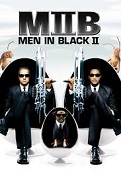
On July 3, 2002 Barry Sonnenfeld's Men in Black II (Columbia Pictures) debuts, continuing 1997 the saga of Agent J (James Darrell Edward III) (Will Smith), who must restore the memory of retired Agent K (Kevin Brown) (Tommy Lee Jones) to save the world again; co-stars Lara Flynn Boyle as alien queen Serleena, Rip Torn as Chief Zed, Tony Shalhoub as Jack Jeebs, Patrick Warburton as Agent T, and Paige Brooks as Princess Lauranna; features a cameo by Peter Graves; #8 movie of 2002 ($190M U.S. and $441.8M box office on a $140M budget).
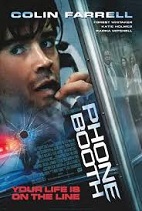
On Sept. 10, 2002 Joel Schumacher's Phone Booth (20th Cent. Fox) debuts (delayed until Apr. 4, 2003 due to the Beltway Sniper attacks), starring Colin Farrell as NYC publicist Stuart "Stu" Shepard, who cheats on his wife Kelly (Radha Mitchell) with Pamela McFadden (Katie Holmes), and gets trapped in a you know what by extortionist with a laser rifle Kiefer Sutherland, bringing the NYPD led by Capt. Ee Ramey (Forest Whitaker), and ending in an exciting conclusion with a twist; "A ringing phone has to be answered, doesn't it?"; does $97.8M box office on a $13M budget.
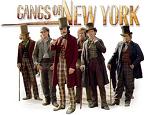

On Dec. 20, 2002 Martin Scorsese's Gangs of New York (Miramax) debuts based on the 1927 book by Herbert Asbury, starring Leonardo DiCaprio as Amsterdam Vallon, son of Priest Vallon (Liam Neeson), Daniel Day-Lewis as William "Bill the Butcher" Cutting, Jim Broadbent as Boss Tweed, John C. Reilly as Happy Jack Mulraney, and Cameron Diaz as pickpocket Jenny Everdeane in an attempted recreation of hellhole Five Points, Manhattan, New York City in 1862-3 incl. the Dead Rabbits and their bitter nativist gang enemies (the Bowery Boys?); does $193.8M box office on a $100M budget; watch trailer.
In 2002 This is That Productions is founded in New York City by Anne Caey, Ted Hope, and Diana Victor, going on to release 16 films in its first six years, incl. "Eternal Sunshine of the Spotless Mind" (2004).
In 2002 the first annual Tribeca Film Festival, founded in response to 9/11 by actor Robert De Niro, his producer Jane Rosenthal, and her hubby Craig Hatkoff opens in the neighborhood N of the WTC, featuring heartwarming comedies incl. About a Boy; by 2006 it takes on 9/11 itself, starting with United 93, then moves to post-9/11 issues incl. Iraq and Afghanistan; in 2009 it moves to Doha, Qatar.
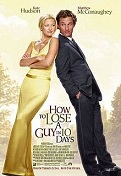
On Feb. 7, 2003 Donald Petrie's How to Lose a Guy in 10 Days (Feb. 7) (Paramount Pictures) stars Kate Hudson as Composure women's mag. writer Andie Anderson, who wants to write an article titled you know what, and meets ad exec Benjamin "Ben" Barry (Matthew McConaughey), who bets his boss that he can make any women fall in love with him in guess how many days, until they find each other out; does $177.4M box office on a $50M budget.
On Mar. 23, 2003 the 75th Academy Awards at the Kodak Theatre in Hollywood, Los Angeles, Calif. are hosted by Steve Martin (2nd time), and 279 films are eligible for consideration; the best picture Oscar for 2002 goes to Chicago along with best supporting actress to Catherine Zeta-Jones, best dir. to Roman Polanski for The Pianist, along with best actor to Adrien Brody (youngest ever, displacing Richard Dreyfuss), best actress to Nicole Kidman for The Hours, and best supporting actor to Chris Cooper for Adaptation; Michael Moore wins an Oscar for his documentary film Bowling for Columbine, then gets hooted off the stage during a speech calling Bush "a fictional president who won a fictional election."

On June 13, 2003 Ron Shelton's Hollywood Homicide (Columbia Pictures) debuts, based on the true experienced of LAPD dick Robert Souza, starring Harrison Ford as Sgt. Joe Gavilan, and Josh Hartnett as Det. K.C. Calden, two LAPD dicks who moonlight at real estate and acting; also features Martin Landau, Dwight Yoakam, and Frank Sinatra Jr., with cameos by Eric Idle and Smokey Robinson; Lena Olin plays Ford's babe Ruby; does $51M box office.
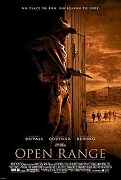
On Aug. 15, 2003 Kevin Costner's Open Range (Touchstone Pictures) (Buena Vista Pictures) debuts, based on the Lauran Paine novel set in 1882 Mont., starring Robert Duvall as Boss Spearman, Kevin Costner as Charley Waite, and Annette Bening as Sue Barlow in a film that tries hard not to look like "Lonesome Dove" and fails; does $68.3M box office on a $22M budget.
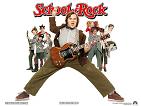
On Oct. 3, 2003 Richard Linklater's School of Rock debuts, starring Jack Black as rocker Dewey Finn, who is kicked out of his band No Vacancy, then disguises himself as a substitute teacher at a prep school to form a band out of 5th grade students to win the Battle of the Bands to pay his apt. rent.

On Oct. 10, 2003 Quentin Tarantino's Kill Bill Volume 1 (A Band Apart) (Miramax Films) debuts, based on the 1973 Japanese film "Lady Snowblood", starring Uma Thurman as Kung Fu fighting "the Bride" "Black Mamba" Beatrix Kiddo, whose hubby "Snake Charmer" Bill (David Carradine) and his Deadly Viper Assassination Squad pop a cap in her crown at her wedding in El Paso, Tex., causing her to vow revenge and obtain a genuine Hanzo samurai sword from swordsmith Hattori Hanzo in Okinawa; also stars Vivica A. Fox as "Copperhead" Vernita Green , Darryl Hannah as 1-eyed "Calif. Mountain Snake" Elle Driver, Lucy Liu as "Cottonmouth" "Queen of the Tokyo Underworld" O-Ren Ishii, Michael Madsen as Bill's brother "Sidewinder" Budd, Sonny Chiba as Samurai swordswmith Hattori Hanzo, Chiaki Kuriyama as 17-y.-o. Kung Fu fighter Gogo Yubari, and Gordon Liu as all-white Kung Fu master Pai Mei, who knows the secret 5-Pointed Palm Exploding Heart Technique; Ellie Driver whistles a song from the 1969 British horror film "Twisted Nerve", composed by talented Bernard Herrmann to indicate she's about to kill Kiddo; grosses $70M in the U.S. and $181M worldwide on a $30M budget; features cool music by the Japanese group The 5, 6, 7, 8s (5.6.7.8's), who perform I Walk Like Jayne Mansfield, I'm Blue, and Woo Hoo (used in Vonage commercials) in the House of Blue Leaves; the sequel Kill Bill Volume 2 (Apr. 16, 2004) features Perla Haney-Jardine as Beatrix's daughter B.B.
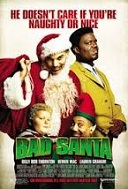
On Nov. 26, 2003 Terry Zwigoff's Bad Santa (Tryptich Pictures) (Dimension Films) debuts, starring Billy Bob Thornton as alcoholic sex-addicted dept. store Santa Claus Willie T. Soke, and Tony Cox as his midget Little Helper Marcus Skidmore, who end each season by robbing the store; Brett Kelly plays fat kid Thurman Merman; Lauren Graham plays Soke's babe Sue; Bernie Mac plays Gin Slagel; does $76.5M box office on a $23M budget; followed by "Bad Santa 2" (2016); watch trailer.
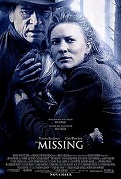
On Nov. 26, 2003 Ron Howard's The Missing (Revolution Studios) (Imagine Entertainment) (Columbia Pictures), based on the 1996 Thomas Edison novel "The Last Ride" stars Tommy Lee Jorenes as Samuel Jones in 1885 N.M., who goes Injun as Chaa-duu-ba-its-iidan then returns to his daughter, medicine woman Magdalena "Maggie" Gilkeson (Cate Blanchett), who doesn't want him back until her daughter Lilly Gilkeson (Evan Rachel Wood) is kidnapped by Apaches who start taking her to Mexico to become a white blonde ho; actors spend long hours studying to speak the Apache language; does $38.4M box office on a $60M budget.

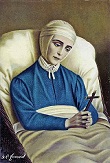


On Feb. 25, 2004 Mel Gibson's The Passion of the Christ (Icon Productions) (Newmarket Films) debuts, based on the visions of 19th cent. German mystic nun Anne Catherine Emmerich (1774-1824) (who is beatified by Pope John Paul II on Oct. 3), reenacting the Catholicized Gospel story of the Stations of the Cross with actors speaking the original languages (with subtitles) is a bloody lovefest for millions of Christians, bringing in $370M U.S. and $611.9M worldwide box office on a $30M budget (#3 movie of 2004), becoming the top-grossing R-rated film in history (until ?), and making Peekskill, N.Y.-born Sydney, Australia-raised Mel Colmcille Gerard Gibson (1956-) too rich to want to be Pope Mel I?; he gyps the screenwriter Benedict Fitzgerald, who later sues him; too bad, in Mar. 2003 Mel's ultra-conservative Roman Catholic daddy Hutton Peter "Red" Gibson (1918-) (the 1968 "Jeopardy!" grand champ, with a genius IQ) gave an interview to The New York Times Mag., saying that Vatican II was a "Masonic plot backed by the Jews", that the 9/11 attacks were perpetrated by remote control, and that the WWII Holocaust was impossible as stated because the Nazis couldn't have disposed of 6M corpses without a trace, and census figures prove there were more Jews in Europe after WWII than before, also adding that certain Jews want a OWG with a global religion, then reiterated these views a week before the film's release to radio talk show host Steve Feuerstein, after which charges of anti-Semitism are denied by Mel, who is defended by Focus on the Family and other anti-Semitic, er, Christian groups. Watch trailer; view clip; view clip; view clip; view clip; view clip; view clip.
On Feb. 29, 2004 the 76th Academy Awards at the Kodak Theatre in Hollywood, Los Angeles, Calif. are hosted by Billy Crystal (5th time), and 254 films are eligible for consideration; New Line's The Lord of the Rings: The Return of the King, the finale of the Tolkien trilogy, dir. by Peter Jackson sweeps the 2003 Oscars with 11 awards, incl. best picture and best dir.; Charlize Theron becomes the first South African to win an Oscar, best actress for Monster; Sean Penn wins best actor, and Tim Robbins wins best supporting actor for Mystic River; Rene Zellweger wins best supporting actress for Cold Mountain.

On Mar. 19, 2004 Michel Gondry's Eternal Sunshine of the Spotless Mind (Focus Features) debuts,, named after a line in Alexander Pope's poem "Eloisa to Abelard", starring Jim Carrey and Kate Winslet as separated lovers Joel Barish and Clementine Kruczynski, who had Lacuna Inc. of New York City erase their memories, and meet by accident on a train and fall in love over again; does $72.2M box office on a $20M budget.

On May 14, 2004 Wolgang Petersen's Troy (Warner Bros.) debuts, starring Brad Pitt as Achilles, Eric Bana as Hector, Orlando Bloom as Paris, and Diane Kruger as Helen, and features hi-tech battle scenes although the actors are too scrawny to look like real Greeks, SFX or not?; Pitt injures his Achilles heel during filming, delaying production for weeks?; does $497M box office on a $175M budget.

On July 15, 2004 Alex Proyas' I, Robot (20th Cent. Fox), debuts, written by Jeff Vintar (not based on the 1950 Isaac Asimov book) and set in robot-filled 2035, starring Will Smith as Chicago detective Del Spooner, who was saved from drowning by a robot who allowed a 12-y.-o. girl to drown in his place, making him hate all robots, investigating the suspicious suicide of U.S. Robotics founder Dr. Alfred Lanning (James Cromwell), tracing it to the AI called V.I.K.I. (Virtual Interactive Kinetic Intelligence) (Fiona Hogan) with the help of robopsychologist Susan Calvin (Bridget Moynahan); Bruce Greenwood plays USR CEO Lawrence Robertson; grosses $347M worldwide on a $120M budget.
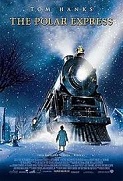
On Oct. 21, 2004 Robert Zemeckis' 3-D computer animated film The Polar Express (Castle Rock Entertainment) (Warner Bros. Pictures) debuts, based on the 1985 Chris van Allsburg children's novel, starring Tom Hanks in motion-capture mode, with Daryl Sabara doing the voice of Hero Boy; does $310.6M box office on a $165M budget; watch trailer.
In 2005 the term "mumblecore" is coined by Eric Masunaga for a quasi-genre of ultra-low budget films that explore relationships between mumbling characters; dir. Andrew Bujalski becomes the "Godfather of Mumblecore".

On Jan. 7, 2005 Hollywood dream couple (since July 29, 2000) Brad Pitt and Jennifer Aniston announce their separation, and in Mar. Aniston files for divorce, citing irreconcilable differences; in an Aug. interview for Vanity Fair she denies that the breakup is due to her not wanting children, saying "I did and I do and I will", attributing it instead to "when you stop growing together, that's when the problems happen"; she says "I was shocked" at published pictures of Pitt with actress Angelina Jolie and her 3-y.-o. son Maddox on a beach in Africa while filming Mr. and Mrs. Smith; on Dec. 2 the acting team of Brad Pitt (1963-) and Angelina Jolie (1975-) confirm rumors of having a serious affair since the filming of Mr. and Mrs. Smith when they file a legal petition in Los Angeles to change the names of Jolie's children Maddox (b. 2002) (adopted from Cambodia) and Zahara (b. 2005) (adopted from Ethiopia) to Jolie-Pitt, causing their acting duo to be called "Brangelina" (Bradgelina); she later claims that she refused to "be intimate" with him until he got a divorce, then has his baby Shiloh in May, 2007; in Mar. 2007 she adopts Pax Thien (b. 2004) in Vietnam; on Aug. 23, 2014 they finally wed in Chateau Miraval in Correns, Provence, France.
On Feb. 27, 2005 the 77th Academy Awards (moved up 1 mo.), hosted by Chris Rock are held in Los Angeles, and 267 films are eligible for consideration; best picture Oscar for 2004 goes to Million Dollar Baby, along with best dir. to Clint Eastwood, best actress to Hilary Swank, and best supporting actor to Morgan Freeman; Swank joins Vivien Leigh, Helen Hayes, Sally Field, and Luise Rainer as the only actresses with a perfect track record of two nominations and two wins; best actor goes to Jamie Foxx for Ray (he was also nominated for best supporting actor for Collateral, and had a Billboard #1 pop album, becoming #4 after Bing Crosby, Frank Sinatra, and Barbra Streisand); best supporting actor goes to Cate Blanchett for her portrayal of Katherine Hepburn in The Aviator; Al Otro Lado Del Rio, from The Motorcycle Diaries, the first Spanish language song ever nominated for an Oscar wins for best original song.

On Mar. 16, 2005 71-y.-o. actor Robert Blake (1933-) is acquitted of the murder of wife Bonny Lee Bakley by a Los Angeles jury after a 4-mo. trial; he claims to have spent $10M in his defense and to be broke and in need of a job; on Nov. 18 he is found liable for his wife's death by a civil jury in Burbank, Calif. and ordered to pay her children $30M (O.J.'s victims got $33.5M).

In Apr. 2005 Hollywood actors Tom Cruise (Thomas Cruise Mapother IV) (1962-) and Kate Noelle "Katie" Holmes (1978-) go public with their relationship, smooching and posing for photographers in Rome; since they both have major movies in the works, critics label it a publicity stunt, but on June 17 they announce their engagement at the Eiffel Tower, becoming known as Tomkat; on May 23 Cruise appears on the Oprah Winfrey Show to praise his new babe, making a clown of himself by having a jumping-on-the-couch moment; on June 29, 2012 Holmes files for divorce, stating that she fears intimidation by the Church of Scientology, which she is leaving, and that Tom will abduct their daughter Suri (b. Apr. 2006). On June 24 Hollyweird and Scientology superstar Tom Cruise gives an interview to ABC-TV's Matt Lauer, dissing Brooke Shields for using anti-depressant drugs instead of vitamins for post-partem depression, calling Cruise "glib" for disagreeing, uttering the soundbytes: "Psychiatry is a pseudo-science" and "You don't know the history of psychiatry. I do"; in 2008 Cruise apologizes for being "arrogant".
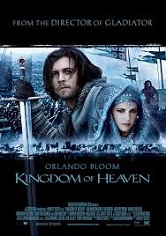
On May 2, 2005 Ridley Scott's Kingdom of Heaven (Scott Free Productions) (Studio Babelsberg) (20th Cent. Fox) debuts, filmed in Quarzazate, Morroco and filled with super-cool medieval battle scenes, starring Orlando Bloom as 12th cent. French knight Balian of Ibelin, who fights cool dressed-in-black chivalrous Ayyubid Muslim sultan Saladan (Ghassan Massoud) for Jerusalem in 1187 while romancing super-hot (those eyes, those eyes) Queen Sibylla (Eva Green) and fighting mean Guy de Lusignan (Marton Csokas) and crazy-as-a-fox Raynald de Chatillon (Brendan Gleeson) (master of Kerak Castle) with help from marshal Tiberias (Jeremy Irons); Liam Needson, er, Neeson plays Balian's father Godfrey; David Thewlis plays the Hospitaller; Alexander Siddig plays Saladin's Persian lt. Imad ad-Din al-Isfahani; Edward Norton plays leprous Jerusalem king Baldwin IV; Iain Glen plays Richard Lionheart; "What is Jerusalem worth?" (Balian); "Nothing... everything" (Saladin); "Nearly a thousand years later, peace in the Holy Land remains elusive"; does $211.7M box office on a $130M budget.

On June 3, 2005 Catherine Hardwicke's Lords of Dogtown (Columbia Pictures) (TriStar Pictures) debuts, written by Stacy Peralta, about the Z-Boys (Zephyr Boys) skateboarders (former surfers) in "Dogtown" Venice Beach, Los Angeles, Calif. ("kennel by the sea") in the late 1970s, who turned skateboarding from a safe to an extreme sport and launched a nat. craze; stars John Robinson as Peralta, Emile Hirsch as Jay Adams, Victor Rasuk as Tony Alva, Michael Angarano as rich kid Sid, and Heath Ledger as mgr. Skip Anglund; does $13.4M box office on a $25M budget.
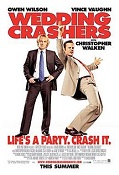
On July 25, 2005 David Dobkin's Wedding Crashers (New Line Cinema) debuts, starring Owen Wilson as John Beckwith, and Vince Vaughn as Jeremy Grey, bachelor divorce mediators in Washington, D.C. who you know what to bed women; co-stars Christopher Walken as U.S. treasury secy. William Cleary Jane Seymour as his wife Kathleen "Kitty Kat" Cleary, Rachel McAdams and Isla Fisher as his daughters Claire and Gloria, and Bradley Cooper as Claire's cheating boyfriend Sack Lodge; #6 movie of 2005 ($209M U.S. and $285.2M worldwide box office on a $40M budget).

On Sept. 2, 2005 Bennett Miller's Capote (United Artists) debuts, giving Philip Seymour Hoffman the role of his life as the New York goo-goo talking-walking literary sockhusking chief prickhead; Miller's first narrative feature; does $49.2M box office on a $7M budget; yet another film about the transforming power of dick? - now when you wake up with milk you wake up in paradise?
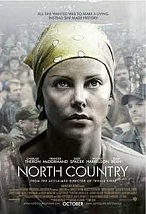
On Sept. 12, 2005 Niki Caro's North Country (Participant Productions) (Warner Bros.) debuts, based on the 2002 book "Class Action: The Story of Lois Jenson and the Landmark Case That Changed Sexual Harassment Law" by Clara Bingham and Laura Leedy Gansler stars Charlize Theron as Josey Aimes, a N Minn. miner who gets sexually harassed and starts a class action suit over it; does $25.2M box office on a $35M budget.

On Nov. 23, 2005 Stephen Gaghan's Syriana debuts, based on the Robert Baer memoir "See No Evil", starring George Clooney (after Harrison Ford turns down the role) as CIA operative Bob Barnes, Matt Damon as young oil analyst Bryan Woodman, and Jeffrey Wright as Washington, D.C. atty. Bennett Holiday, who is investigating a merger between oil cos. Connex and Killen, showing how the Western oil addiction has corrupted U.S. foreign policy; Alexander Siddig plays Prince Nasir Al-Subaai, eldest son of the emir, who his brother Prince Meshal (Akbar Kurtha) plots to assassinate; Pax Syriana is the necessary state of peace between Assyria (from the Mediterranean to the Euphrates, and from the Sinai to the Taurus Mts.) and the U.S. so that it can get oil; grosses $50.8M in North Am. and $93.9M worldwide; "You want to know what the business world thinks of you? We think that 100 years ago you were living out here in tents in the desert chopping each other's heads off, and that's exactly where you're gonna be in another 100."


Two big thumbs up? The Holy Grail of Social Engineering Pictures is launched by Hollyweird in Oh-nly-Six? On Dec. 9, 2005 Ang Lee's Brokeback Mountain debuts, written by Larry McMurtry and Diana Ossana based on an Oct. 13, 1997 New Yorker short story by Annie Proulx about two 1963 sheep cowboys, Ennis Del Mar (Heath Ledger) and Jack Twist (Jake Gyllenhaal) in Wyo., who go gay and do the bob-and-weave (and bareback?) in high altitude in secret, causing sperm to flow like champagne, after which they separate and marry straight women Alma (Mont.-born Michelle Williams) (Ennis) and Laureen (Anne Hathaway) (Jack); too bad, "this thing gets hold of them again" and they continue to meet once a year for 20 sperm-filled years, fighting the feelings of missed same-sex marital bliss (not just fast food that melts in your mouth?) to the hauntingly sterile "A Love That Will Never Grow Old" as yet more sperm flows, but not in chicks, because it's a dick flick, although not a single one is seen; grosses only $83M in the U.S. despite the ploy of using non-gay actors to keep audiences from getting the feeling they're in a gay movie house, where male-male marriage is a 4-letter word?; in real life Heath Ledger (1979-2008) falls in love on the set with Michelle Williams (1980-), and they marry and have daughter Matilda on Oct. 28, 2005 - one could substitute a man and a boy, two women, a woman and a girl, a father and his son, etc., and the values stay free-floating, welcome to the 21st century of sin is in?

On Dec. 23, 2005 Steven Spielberg's Munich (Universal), a remake of the 1986 TV movie "Sword of Gideon" based on George Jonas' 1984 book about the secret Israeli Mossad Operation Wrath of God formed to get even with 11 Black September terrorists for the 1972 Munich Massacre stars Eric Bana as Avner Kaufman, Daniel Craig as Steve, Hanns Zischler as Hans, Mathieu Kassovitz as Robert, Ciaran Hinds as Carl the Cleaner, and Moshe Ivgy as Michael Harari, leader of the team who killed innocent waiter Ahmed Bouchiki in Lillehammer, Norway after mistaking him for Black Sept. chief Ali Hassan Salameh, causing the govt. to go after his team; does $130M box office on a $77M budget.

On Feb. 3, 2006 Bennett Miller's Capote debuts, giving Philip Seymour Hoffman the role of his life as the New York goo-goo talking-walking literary sockhusking chief prickhead; Miller's first narrative feature; yet another film about the transforming power of dick? - now when you wake up with milk you wake up in paradise?
On Mar. 5, 2006 the 78th Academy Awards, hosted by Jon Stewart are held at the Kodak Theatre in Hollywood, Los Angeles, Calif.; 311 films are eligible for consideration; the best picture Oscar for 2005 goes to Lions Gate's Brokeback Mountain, er, Crash, best dir. to Ang Lee for Crash, er, Trash, er, Brokeback Mountain, best actor to Philip Seymour Hoffman for Capote, best actress to Reese Witherspoon for Walk the Line, best supporting actor to George Clooney for Syriana, and best supporting actress to Rachel Weisz for The Constant Gardener; best original song goes to It's Hard Out Here for a Pimp by Three 6 Mafia ("Juicy J" Jordan Houston, "Crunchy Black" Cedric Coleman, and "DJ Paul" Beauregard) from Hustle & Flow; dir. Robert Altman (1925-2006) (who looks like a cross between Jimmy Stewart, Peter Fonda, and Clint Eastwood?) receives a lifetime achievement award, and reveals that he received a heart transplant from a young woman 10 years earlier; Larry McMurtry wears jeans with his tuxedo jacket; Jon Stewart jokes that Walk the Line is "'Ray' for white people", and that "The Oscars is really the one night of the year where you can see all your favorite stars without giving money to the Democratic Party"; the actresses and actors mainly dress in penguin-like black and white, with Michelle Williams going for mustard (canary?) with bright red lipstick, Keira Knightley for eggplant (with heavy black eye makeup and a vintage Bulgari necklace), Amy Adams for chocolate brown, Jessica Alba for gold, and Reese Witherspoon for silver; Charlize Theron wears a deep emerald Dior dress with a freaky bridesmaid bow on her shoulder almost big enough to be a 2nd head, while Helena Bonham Carter (English name and Russian looks?) wears a short blue gown with white shoes and a freaky big stiff updo.
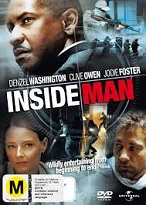
On Mar. 24, 2006 Spike Lee's Inside Man (Universal Pictures) debuts, witten by Russell Gewirtz, starring Clive Owen as bank robber Dalton Russell, who pulls off a perfect heist, not money but evidence against Manhattan Trust Bank chmn. Arthur Case (Christopher Plummer), ending in a hostage situation with Det. Keith Frazier (Denzel Washington) and power broker Madeleine White (Jodie Foster); does $184.4M box office on a $45M budget; "This time next week I'll be sucking down pina coladas in a hot tub with six girls named Amber and Tiffany" (Russell); "More like taking a shower with two guys named Jamal and Jesus, if you know what I mean. And here's the bad news. That thingy you're sucking on, it's not a pina colada." (Frazier)
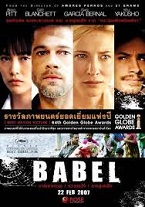
On May 23, 2006 Alejandro Gonzalez Inarritu's Babel debuts, written by Guillermo Arriaga stars Brad Pitt and Cate Blanchett as Richard and Susan Jones of San Diego, Calif., and deals with a series of events occurring in three continents after young goatherder Abdullah fires a shot in the mountains of Morocco at a bus carrying Western tourists, critically wounding Susan; receives seven Oscar nominations; Rinko Kikuchi receives a best supporting actress nomination, turning Japan on; some filmgoers report getting nausea and headaches from it?; does $135.3M box office on a $25M budget.

On May 17, 2006 Ron Howard's The Da Vinci Code (Imagine Entertainment) (Columbia Pictures) debuts, with screenplay by Akiva Goldman and the cool song Chevaliers de Sangreal by Hans Zimmer, starring Tom Hanks as Harris Tweed-loving Harvard religious symbology prof. Robert Langdon, Audrey Tautou (pr. "toe-TOO") as Sophie Neveu, Jean Reno as French dick Bezu Fache, and Ian McKellen as Sir Lipton Teabag, er, Sir Leigh Teabing in a fairly faithful reproduction of this insanely improbable action novel based on fractured feminist-freethinker history (they couldn't X-ray or disassemble the cryptex?); (Fache thinks Langdon did it because of all the writing in blood, none of which says Langdon did it?); (the tomb of Mary Magdalene will causes millions to worship her like a new saint, when nobody needed the tomb of the Virgin Mary to ditto?); (the secret documents proving everything are in an underground room open to the public which anybody could discover easily?); (Sophie is the real grail, yet all these mysterious Priory of Sion people leave her in harm's way throughout the flick?); Paul Bettany plays albino Opus Dei sulpice-loving monk-assassin Silas, and "'You give me the whip, I give you the idol' in Raiders of the Lost Ark" Alfred Molina plays Bishop Aringarosa; the 68th film since 1960 to feature the fallacy of the evil albino, according to the Nat. Org. for Albinism and Hypopigmentation; #5 movie of 2006 ($218M U.S. and $758.2M worldwide box office on a $125M budget).

On June 30, 2006 David Frankel's The Devil Wears Prada debuts, based on the 2003 Lauren Weisberger novel, starring Anne Hathaway as recent college grad Andy Sachs, who gets her first job as asst. to tyrannical fashion mag. ed. Mirandy Priestley (Meryl Streep, who gets her record 14th Oscar nod), pissing-off Vogue ed. Anna Wintour, who believes it's really her, later flopping and praising the film; Emily Blunt and Stanley Tucci play co-asst. Emily Charlton and art dir. Nigel; the most expensively costumed film in history (until ?); does $327M worldwide on a $35M budget.
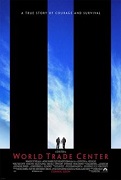
On Aug. 9, 2006 Oliver Stone's World Trade Center (Paramount Pictures) debuts, starring Nicolas Cage and Michael Pena as New York Port Authority policemen John McLoughlin and Will Jimeno, who are trapped under the ruins of the you-know-what, abandoning Stone's usual conspiracy theory mindset for a feel-good-America we-saved-them ring-the-cash-registers ending; Maria Bello and Maggie Gyllenhaal play wives Donna McLoughlin and Allison Jimeno; Michael Shannon plays USMC Sgt. Dave Karnes; does $163.2M box office on a $65M budget.

On Aug. 18, 2006 Neil Burger's The Illusionist (Yari Film Group) debuts, based on a short story by Steven Millhauser, starring Edward Norton as magician Eisenheim in 1889 Vienna, whose childhood sweetheart Sophie (Jessica Biel) is controlled by mean crown prince Leopold (Rufus Sewell), causing him to use all his powers to get her away from him, while Inspector Uhl (Paul Giamatti) tries to keep him from going to prison or worse; does $88M box office on a $16.5M budget.

On Nov. 3, 2006 Larry Charles' Borat: Cultural Learnings of America for Make Benefit Glorious Nation of Kazakhstan (20th Cent. Fox) debuts, starring British Jewish comedian Sacha Noam Baron Cohen (1971-) in a country-bumpkin-in-the-big-city satire as reporter Borat Sagdiyev, who goes to New York City with his fat producer Azamat Bagatov (Ken Davitian) and his pet chicken Buh-Kaw, then discovers Pam Anderson and decides to find and marry her by travelling cross-country in an ice cream truck, all while speaking heavily accented Hebrew and using Candid Camera techniques, becoming a box office smash, doint $261.6M box office on an $18M budget; banned in all Arab countries except Lebanon, also pissing-off Russia; "This C.J. was like no Kazakh woman I have ever seen. She had golden hair, teeth as white as pearls, and the asshole of a 7-year-old. For the first time in my lifes, I was in love"; "This is my country of Kazakhstan. It locate between Tajikistan, and Kyrgyzstan, and assholes Uzbekistan"; features the Kazakhstan Nat. Anthem; "Kazakhstan greatest country in the world. All other countries are run by little girls. Kazakhstan number one exporter of potassium, all other countries have inferior potassium. Kazakhstan home of Tinshein swimming pool, it's length thirty meter and width six meter. Filtration system a marvel to behold. It remove 83 percent of human solid waste. Kazakhstan, Kazakhstan you very nice place, from Plains of Tarashek to northern fence of Jewtown. Kazakhstan friend of all except Uzbekistan, they very nosey people with bone in their brain. Kazakhstan industry best in the world, we invented toffee and trouser belt. Kazakhstan's prostitutes cleanest in the region, except of course for Turkmenistan's.... Come grasp the mighty penis of our leader from junction with the testes to tip of its face!"; on Sept. 29, 2006 Borat gives a fake White House press conference one day before an official visit of Kazakhstan's real pres.; viewers relish dubious factoids about the Big K, incl. that it has the world's largest pop. of wolves, its people drink horse urine, shoot dogs, and view rape and incest as hobbies, causing the Big K govt. to hire two Western PR firms and run a 4-page ad in the New York Times setting the world straight, and rush through the big budget epic Nomad: The Warrior, starring Jason Scott Lee, Jay Hernandez and Kuno Becker, reminding us a zillion times how they're Genghis Khan's country; after Borat garners big bucks at the box office ($129M worldwide), some of the chumps, who all were suckered into signing releases, such as the villagers of Glod ("mud"), Romania attempt to sue; original dir. Todd Phillips quits after shooting the Star Spangled Banner Scene at a Texas rodeo.
On Dec. 8, 2006 Edward Zwick's Blood Diamond (Warner Bros.) debuts, starrng Leonardo DiCaprio as Rhodesian gem smuggler Danny Archer in 1999 Sierra Leone, Jennifer Connelly as Am. journalist Maddy Bowen ("In America it's bling-bling; here it's bling-bang"), and Djimon Hounsou as Solomon Vandy, a father searching for his son, who was nonscripted by the rebels in a semi-remake of "The Defiant Ones"; does $171M box office on a $101M budget.
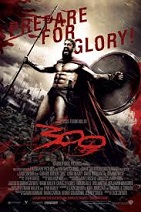
On Dec. 9, 2006 Zack Snyder's 300 (Warner Bros.) debuts, based on Frank Miller's comic book, er, graphic novel about the 480 B.C.E. Battle of Thermopylae where 300 Am. Cowboys, er, Greek Spartans kick the asses of 250K Iranians, er, Persians marks a new era in movie making with an almost totally computer-generated film, with the few actors such as Gerard Butler (Leonidas), Dominic West (Theron), Lena Headey (Queen Gorgo), and Rodrigo Santoro (Xerxes) working out of a locomotive factory in Montreal; "War's not ugly; ugly is ugly" (Xerxes); "Only Spartan women give birth to real men" (Gorgo); the $70.9M opening weekend sets a record, which only stands until "Spider-Man 3" opens on May 5; #6 movie of 206 ($211M U.S. and $456M worldwide box office on a $65M budget); followed by "300: Rise of an Empire" (2014).

On Jan. 15, 2007 Mark Steven Johnson's Ghost Rider (Columbia Pictures) (Sony Pictures Releasing) debuts, written by Mark Steven Johnson based on the Marvel Comics char., starring Nicolas Cage as stunt motorcyclist Johnny Blaze, who sells his soul to fight Blackheart (Wes Bentley), son of Mephistopheles (Peter Fonda), and turns into you know what at night, while his reporter babe Roxanne Simpson (Eva Mendes) waits in the wings; the Ghost Rider Theme (Ghost Riders in the Sky) by Spiderbait is a trip in itself; does $228.7M box office on a $110M budget; followed by "Ghost Rider: Spirit of Vengeance" (2012); watch trailer.
On Feb. 25, 2007 the 79th Academy Awards, hosted by Ellen Degeneres are held at the Kodak Theatre in Hollywood, Los Angeles, Calif.; 306 films are eligible for consideration; the Oscars officially go green; the best picture Oscar for 2006 goes to The Departed, along with best dir. to sentimental favorite Martin Scorsese on his 6th try (beating Paul Greengrass' better United 93?); best actor goes to Forest "Idi Amin" Whitaker for The Last King of Scotland, best actress goes to Helen "Liz II" Mirren for The Queen ("Our Leaders. Ourselves.") (10-y.-o. Abigail Breslin, who played Olive Hoover in Little Miss Sunshine is passed over, as is Meryl Streep, who played Miranda Priestly in The Devil Wears Prada, her 14th nomination, two more than Jack Nicholson and Kate Hepburn), best supporting actor goes to Alan Alda in Little Miss Sunshine (Eddie Murphy, who plays James Brown clone James "Thunder" Early is passed over, perhaps because of his crude toilet-humor world's fattest woman flick Norbit, which comes out just at the wrong time, causing him to storm out of the awards show), and best supporting actress goes to Jennifer Hudson for playing Effie White in Dreamgirls (proving that rejection by Simon Cowell on "American Idol" is the ticket to fame?); Al Gore wins for the global warming documentary An Inconvenient Truth (dir. by Davis Guggenheim) ("By far the most terrifying film you will ever see"), which also garners Lezzie Lezzeridge, er, Melissa Etheridge a best song Oscar for I Need to Wake Up; before going to the stage she gives her wife a big kiss, then dedicates the win to her and her four kids (the highlight of the evening?); Gore utters the soundbyte: "People all over the world, we need to solve the climate crisis. It's not a political issue, it's a moral issue"; sound engineer Kevin O'Connell of Apocalypto sets a record with 19 straight Oscar nominations and 0 wins, losing to Dreamgirls; Pilobolus Dance Theatre provides the briefest numbers yet seen, despite one of the longest Oscar ceremonies ever.

On June 28, 2007 Michael Bay's Transformers debuts, based on the U.S. TV show that aired from 1984-7 about the evil Decepticons, led by Megatron, vs. the good Autobots, led by Optimus Prime, starring Shia LaBeouf as nerd Sam Witwicky, who starts it all by buying a beat-up souped-up yellow 1976 Camaro that is actually the Transformer Bumblebee, and ends up on the run with his new jock babe Mikaela Banes (Megan Fox); well-nuanced plot and emphasis on the humans rises it above the TV series; hauls in a record $27.4M in its debut, beating the $15.7M set by "Dead Man's Chest" last year; #3 movie of 2007 ($319M) ($709M worldwide); followed by "Transformers: Revenge of the Fallen" (2009), which grosses $836M worldwide (#2 in 2009).
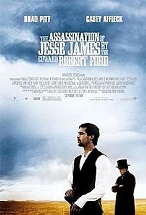
On Sept. 2, 2007 Andrew Dominik's The Assassination of Jesse James by the Coward Robert Ford (Virtual Studios) (Warner Bros.) debuts, based on the 1983 Ron Hansen novel, starring Brad Pitt as Jesse James (1847-82), Sam Shepard as Frank James (1843-1915), Cassey Affleck as "dirty little coward" Robert "Bob" Ford (1862-92), and Sam Rockwell as his brother Charley Ford (1857-84), who whack him on Apr. 3, 1882; coulda been an Oscar contender if it wasn't so long (160 min.)?; does $15M box office on a $30M budget.
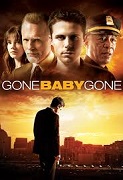
On Oct. 19, 2007 Ben Affleck's Gone Baby Gone (Miramax)) (his dir. debut) debuts, based on the 1998 Dennis Lehane novel, starring his brother Casey Affleck as P.I. Patrick Kenzie, Morgan Freeman as police capt. Jack Doyle, and Ed Harris as Det. Sgt. Remy Bressant in a story about Boston police code of silence that almost works for good for once as they try to get an abused girl away from her mother; does $34M box office on a $19M budget.

On Nov. 9, 2007 Ethan Coen's and Joel Coen's No Country for Old Men (Miramax Films) (Paramount Vantage) debuts, based on the 2005 Cormac McCarthy novel set in 1980 Sanderson, Tex., starring Josh Brolin as Vietnam vet and welder Llewelyn Moss, who comes upon a bad drug deal in the Tex. desert and steals a suitcase stuffed with $2M and a devilish transponder (which he is too dumb to find until it's way too late, yet seems to know about as he plays games with it in a motel air duct, one of many plot problems?); Spanish star Javier Bardem plays ultimate hired assassin Anton Chigurh, who wears a silly pageboy haircut and carries a bulky air gun (used in slaughterhouses) because it leaves no bullets behind (like nobody sees him carrying the equipment around?), and who channels the dark morality of the ancient Aztecs while ruthlessly hunting Moss, leaving a trail of corpses who called the coin flip wrong; Woody Harrelson stars as fallible white knight Carson Wells, and Tommy Lee Jones as old man sheriff Ed Tom Bell, who is caught in the middle and fails like an old man, while bad guy Bardem gets away with everything, modulo a few unlikely accidents?; Kelly Macdonald plays Brolin's innocent babe Carla Jean Moss, who is allowed to call heads or tails to save her life, and isn't resolved onscreen until Bardem leaves her and checks his boots for blood on her porch; Gene Jomes play gas station clerk Thomas Thayer, who calls it correctly; Beth Grant plays Carla's mother; the whole flick leaves an impression of an ancient morality play turned inside out?; does $171.6M box office on a $25M budget; "Some of the old-time sheriffs never even wore a gun, some folks find that hard to believe... You can't help but compare yourself against the old-timers"; "There are no laws left. You can't stop what's coming"; "There are no clean getaways"; watch trailer.
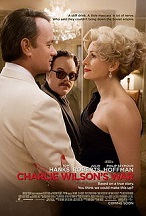
On Dec. 21, 2007 Mike Nichols' Charlie Wilson's War (Relativity Media) (Universal Pictures) debuts, based on the 2003 book by George Crile III, staring Tom Hanks as U.S. rep. (D-Tex.) (1973-96) Charles Nesbitt "Charlie" Wilson (1933-), who funneled arms to Afghan guerrillas in 1987-7 via Operation Cyclone and broke the Soviets' backs, leading to the downfall of the Soviet Union, then watched helplessly as Afghanistan was taken over by the Taliban; also stars Philip Seymour Hoffman as a rogue Greek-extraction CIA agent, plus believable aging sex goddess Julia Roberts to sell tickets?; does $119M box office on a $75M budget.
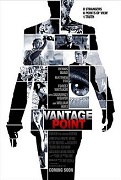
On Feb. 13, 2008 Pete Travis' Vantage Point (Relativity Media) (Columbia Pictures) debuts, written by Barry Levy, a hi-tech thriller about the assassination of U.S. pres. Ashton (William Hurt) in Plaza Mayor in Salamanca, Spain (really Mexico City, dressed up to look like i) as he is about to end the war on terrorism; luckily, he was tipped off and sent a double into the plaza, where Secret Service man Thomas Barnes (Dennis Quaid) (who took a bullet for the same pres. 6 mo. earlier, and isn't told it's a double because he's considered still too shaken up) can't stop it all, but views videos by Am. tourist Howard Lewis (Forest Whitaker) and begins chasing the lone gunman, only to be caught in a big bomb blast; the way cool plot then recycles the timeline over and over to show that the real pres. is holed-up in a nearby hotel, the assassins (as in conspiracy) know it, and hit him there and abduct him, but God Bless America, big cowboy hero Clint, er, Thomas Barnes survives superhuman odds and figures it out and saves him anyway; meanwhile subplots abound, involving actors Matthew Fox, Eduardo Noriega, Richard T. Jones, Holt McAllany, Ayelet Zurer, Said Taghmaoui et al.; too bad, it rocks until the ending, which has too many coincidences?; does $151.1M box office on a $40M budget.
On Feb. 24, 2008 the 80th Academy Awards, hosted by Jon Stewart are held at the Kodak Theatre in Hollywood, Los Angeles, Calif.; 306 films are eligible for consideration; the Coen brothers win the best dir. Oscar for 2007 for No Country for Old Men, which wins best picture, along with best adapted screenplay, and best supporting male actor for Javier Bardem, who says that the Coen brothers "put one of the most horrible haircuts in history on my head"; Daniel-Day Lewis wins best actor for There Will Be Blood, and first-time actress Marion Cotillard (wearing a fish-scale gown by Jean Paul Gaultier) wins best actress for La Vie en Rose (first winner for a French-language performance, first for a non-English language performance since Sophia Loren in 1960, and 2nd French actress to win best actress after Simone Signoret in 1959) (too bad, certain earlier statements about the Twin Towers of 9/11 being impossible to bring down with fire later haunt the voters; orange-haired Tilda Swinton (wearing a black draped velvet dress with one sleeve) wins best supporting actress for Michael Clayton, giving Euros a clean sweep of all four acting Oscars; Ratatouille wins for best animated feature; Falling Slowly from Once, by Glen Hansard and Czech-born Marketa Irglova (1988-) (youngest person to win an Oscar in a musical category until ?) wins for best song; The Bourne Ultimatum wins three Oscars, incl. film editing, robbing a record 4th Oscar chance for the Coen brothers; actresses Cate Blanchett, Nicole Kidman, and Jessica Alba are preggers, with Blanchett wearing a purple embroidered Dries Van Noten gown showing it off; Diablo Cody wins for best screenwriter for Juno.

On May 2, 2008 Jon Favreau's Iron Man debuts, based on the Marvel Comics char., starring Robert Downey Jr. as hi tech genius Tony Stark, who builds an advanced exoskeleton that makes him into a superhero; Gwyneth Paltrow plays his asst. Pepper Potts; Terrence Howard plays military liaison James Rhodes; Jeff Bridges plays Stark Industries exec Obadiah Stane; brings in $585M on a $140M budget; followed by "Iron Man 2" (2010), and "Iron Man 3" (2013).
On June 1, 2008 the 2008 Universal Studios Fire begins, destroying the "Back to the Future" courthouse square, a mechanical King Kong, and up to 175K master tapes belonging to the Universal Music Group (UMG), incl. recordings by artists Louis Armstrong, Chuck Berry, Ray Charles, Steely Dan, Ella Fitzgerald, Nirvana, R.E.M., the Roots et al.; at first they claim only 40K-50K; the real number is 500K?

On July 14, 2008 Christopher Nolan's Dark Knight debuts, starring Christian Bale as Batman, Gary Oldman as Lt. James Gordon, Heath Ledger as the Joker, Aaron Eckhart as district atty. Harvey Dent, and Maggie Gyllenhaal as his asst. Rachel Dawes; on July 18 it sets a 1-day box office record of $66.4M, then another record of $157M for opening weekend, going on to do $1B box office on a $185M budget; followed by "The Dark Knight Rises" (2012); "Some people just want to watch the world burn" (Michael Caine as Alfred Pennyworth); "Upset the established order and everything becomes chaos." (Ledger) On Jan. 22, 2008 Heath Ledger (b. 1979) is found dead in his New York City apt. of an accidental prescription drug OD, with six drugs in his system 4.5 mo. after breaking up with Michelle Williams (1980-) on Sept. 4, 2007, making him the new James Dean?

On Sept. 4, 2008 Kathryn Bigelow's The Hurt Locker debuts, written by producer Mark Boal, starring Ralph Fiennes, David Morse, Guy Pearce, Jeremy Renner, and Anthony Mackie in an action thriller about the U.S. Army's elite Explosive Ordnance Disposal (EOD) teams in Iraq.
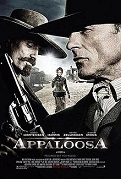
On Sept. 19, 2008 Ed Harris' Appaloosa (New Line Cinema) debuts, based on the 2005 novel by Robert B. Parker channeling Tombstone, Ariz., starring Harris as lawman Virgil Cole, who is hired along with deputy Everett Hitch (Viggo Mortensen) to protect the lawless town of 1882 Appaloosa, N.M. from rancher Randall Bragg (Jeremy Irons); Renee Zellweger plays Hitch's babe Allie French; does $27.7M box office on a $20M budget.
On Feb. 22, 2009 the 81st Academy Awards, hosted by Hugh Jackman are held in the Kodak Theater in Hollywood, Calif.; 281 films are eligible for consideration; Danny Boyle wins the best dir. Oscar for 2008 for Slumdog Millionaire, which also wins best picture, cinematography, sound mixing and four other Oscars; best actor goes to Sean Penn for Milk, best actress to Kate Winslet for The Reader, best supporting actor to Heath Ledger for The Dark Knight, best supporting actress to Penelope Cruz for Vicky Cristina Barcelona; Jai Ho from Slumdog Millionaire wins best original song.
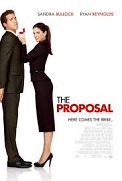
On June 1, 2009 Anne Fletcher's The Proposal (Touchstone Pictures) (Mandeville Films) (Walt Disney Studios) debuts, starring Sandra Bullock as bossy Canadian-born New York book editor Margaret Tate, who is pushed by the INS into marrying her secy. Andrew Paxton (Ryan Reynolds) to keep from being deported to Canada, finding out that he's as rich as the Kennedys out in Sitka, Alaska, and falling in luuuv; Mary Steenburgen plays Andrew's mother Grace Paxton, Craig T. Nelson plays his father Joe Paxton, and Betty White plays his grandma Annie; grosses $164M U.S. and $317.4M worldwide on a $40M budget (#16).

On Aug. 21, 2009 Quentin Tarantino's Inglourious Basterds (Universal) (2 hours 32 min.) (title taken from a 1978 Enzo Castellari film) debuts, the ultimate Jewish fantasy flick (anti-Schindler's List?) about a group of Jewish-Am. Nazi assassins in WWII who stop the Nazis and the Holocaust after starting their own bloody Holocaust of Germans and killing Hitler and his entire high command, starring Brad Pitt as Lt. Aldo Raine, and Austrian actor Christoph Waltz (1956-) as SS Col. Hans Landa "the Jew Hunter", who wins an Oscar for best supporting actor, the first acting Oscar for a Tarantino film and 2nd for playing a Nazi after Kate Winslet in "The Reader" (2008); does $321M box office on a $75M budget; garners eight Oscar nods; the inane lack of security for Hitler and his high command ruins the believability?; too bad, the so-called heroes are portrayed as sinking as low or lower than the Nazis in order to beat them, taking any moral high ground away?; proof that Hollyweird is run by Jews who are as savage and bloodthirsty as Nazis?; the Jews and Muslims are Siamese twins, so how did everybody else get in the middle?; why don't they follow with similar flicks for George Washington, Robert E. Lee, Mussolini, Stalin, Pol Pot, or is there no fun in it for da Jews?
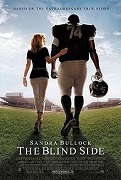
On Nov. 20, 2009 John Lee Hancock's The Blind Side (Warner Bros. Pictures) debuts, based on the 2006 book by Michael Lewis debuts, starring Sandra Bullock as wealthy white Memphis, Tenn. mother Leigh Anne Tuohy, who takes big black homeless Michael "Big Mike" Oher (Quinton Aaron) and adopts him, molding him into a pro football offensive left tackle and 2009 first round NFL draft pick for the Baltimore Ravens after conquering his academic problems with the help of tutor Miss Sue (Kathy Bates); Tim McGraw plays hubby Sean Tuohy, and Jae Head plays cute son Sean "S.J. Tuohy Jr.; grosses $256M in the U.S. (#8) and $309.2M worldwide on a $29M budget.
On Dec. 10, 2009 James Cameron's Avatar (Lightstorm Entertainment) (Dune Entertainment) (20th Cent. Fox) debuts, a 3-D sci-fi flick about the moon Pandora and its Na'vi pop. who get in a war with Earth in the 23rd cent., with Sam Worthington starring as paralyzed Marine vet Jake Skully, who inhabits a 10-ft.-tall blue alien avatar; Paul R. Frommer (1944-) invents the Na'vi language for the film; too bad, it costs $237M to make (most expensive in history to date) and $200M to market, and only takes in $73M at the U.S. box office in the first weekend, plus $159.2M overseas ($232.2M), benefiting from the $3-$5 extra added to each ticket for the 3-D fun, and coming in #1 for the year at $759.563M, later doing $2.788B box office worldwide.
In the 2010s the gaming industry begins passing Hollywood in revenues, reaching $180B in 2021, bigger than Hollywood and the music industry put together.
On Mar. 7, 2010 the 82nd Academy Awards are held in the Kodak Theatre in Hollywood, Calif.; The Hurt Locker wins best picture of 2009, and dir. Kathryn Bigelow wins best dir. (first female); the song "I Am Woman" is played as she exits the stage; Geoffrey Fletcher becomes the first African-Am. to win for best screenplay for Precious; Jeff Bridges wins best actor for Crazy Heart, and Sandra Bullock best actress for The Blind Side; Christoph Waltz wins best supporting actor for Inglourious Basterds, and Mo'Nique best supporting actress for Precious; meanwhile activist actor Sean Penn stinks himself up with statements that journalists who call his hero Hugo Chavez of Venezuela a dictator should be jailed; a week after the awards, Sandra Bullock's husband (since July 16, 2005) Jesse Gregory James (1969-) is caught cheating on her during the filming of "The Blind Side" with white supremacist ex-Amish tattoo artist Michelle "Bombshell" McGee, causing him to publicly apologize but ruining their relationship, becoming another example of the Oscar Curse.
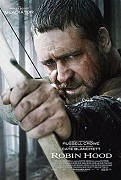
On May 12, 2010 Ridley Scott's Robin Hood (Imagine Entertainment) (Universal Pictures) debuts, starring Russell Crowe as Robin Longstride, Cate Blanchett as Marion Locksley, Max von Sydow as her father Sir Walter Locksley, Mark Addy as Friar Tuck, Oscar Isaac as nutso Prince John, and Danny Huston as his older brother Richard the Lionheart; does $321.7M box office on a $200M budget.
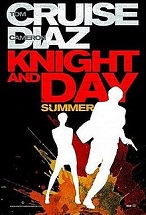
On June 16, 2010 James Mangold's Knight and Day (formerly "Wichita and Trouble Man") (June 16) (Regency Enterprises) (Dune Entertainment) (20th Cent. Fox) debuts, an action comedy starring Tom Cruise as crazy secret agent Roy Miller/Matthew Knight, who hooks up with classic car restorer June Havens (Cameron Diaz) and shanghais her on his run from the CIA; does $261.9M box office on a $117M budget.

On Aug. 13, 2010 Ryan Murphy's Eat Pray Love (Plan B Entertainment) (Columbia Pictures) debuts, based on the 2006 bestseller by Elizabeth Gilbert, starring Julie Roberts as Gilbert, and Javier Bardem as her lover Felipe; does $204.6M box office on a $60M budget.
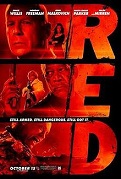
On Sept. 29, 2010 Robert Schwentke's Red (Di Bonaventura Pictures) (Summit Entertainment) debuts, an action comedy based on the DC Comics series by Warren Ellis and Cully Hamner, starring Bruce Willis as ex-CIA agent Frank Moses AKA Retired Extremely Dangerous, who lives in Cleveland, Ohio and shanghais pension clerk Sarah Ross (Mary-Louise Parker) while being chased by a CIA assassination squad; also stars Morgan Freeman as Joe Matheson, John Malkovich as Marvin Boggs, Helen Mirren as Victoria Winslow, and Karl Urban as William Cooper; does $199M box office on a $58M budget; followed by "Red 2" (2013).
On Feb. 27, 2011 the 83rd Academy Awards, presented at the Kodiak Theatre in Hollywood, hosted by James Franco and Anne Hathaway awards the best picture Oscar for 2010 to The King's Speech, along with best dir. to Tom Hooper, best actor to Colin Firth, and best original screenplay to David Seidler; Natalie Portman wins best actress for Black Swan; Christian Bale wins best supporting actor for The Fighter, and Melissa Leo wins best supporting actress for ditto; The Social Network wins best adapted screenplay and best original score; We Belong Together by Randy Newman from Toy Story 3 wins best original song.
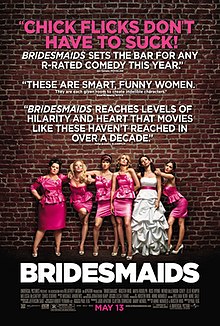
On Apr. 28, 2011 Paul Feig's Bridesmaids (Universal Pictures) debuts, starring Kristen Wiig as Annie Walker, Melissa McCarthy as Megan Price, Wendi McLendon-Covey as Rita, Elle Kemper as Becca, Rose Byrne as Helen Harris III, and Maya Rudolph as Lillian Donovan in a raunchy comedy for women that became a surprise box office hit; features Chis O'Dowd as Annie's beau Officer Rhodes; features an appearance by Wilson Phillips; final screen appearance of Jill Clayburgh as Judy Walker; "Chick flicks don't have to suck!"; does $306.4M box office on a $32.5M budget.

On Sept. 10, 2011 Alexander Payne's The Descendants (Fox Searchlight Pictures) debuts, based on the 2007 novel by Kaui Hart Hemmings, starring George Clooney as rich Honolulu atty. Matthew "Matt" King, whose dream life in Hawaii is ruined by the sickness of his comatose wife Elizabeth (Patricia Hastie) and rebellious daughters Scottie King (Amara) and Alexandra "Alex" King (Shailene Woodley); does $177.2M box office on a $20M budget.

On Oct. 28, 2011 Andrew Niccol's In Time debuts, starring Amanda Seyfried and Justin Timberlake in a dystopian 2026, where humans are genetically engineered to stop aging at 25 and can only live longer by earning it, allowing the rich to get rid of the poor; brings in $173.9M on a $40M budget.
On Feb. 26, 2012 the 84th Academy Awards, presented at the Hollywood and Highland Center Theatre (formerly the Kodak Center), hosted by Billy Crystal (9th time) awards the best picture Oscar for 2011 to The Artist, along with best dir. to Michel Hazanavicius and best actor to Jean Dujardin; best actress goes to Meryl Streep for The Iron Lady; best supporting actor goes to Christopher Plummer for The Beginners, and best supporting actress to Octavia Spencer for The Help; best original screenplay goes to Woody Allen for Midnight in Paris; Rango wins for best animated feature; A Separation wins best foreign language film; Man or Muppet from The Muppets, sung by Bret McKenzie wins best original song.
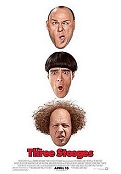
On Apr. 13, 2012 the Farrelly Brothers' The Three Stooges (20th Cent. Fox.) debuts, starring Chris Diamantopoulos as Moe, Sean Hayes as Larry, and Will Sasso as Curly; Jane Lynch plays Mother Superior, and Kirby Heyborne plays their orphanage friend Theodore J. "Teddy" Harter; does $54.8M box office on a $30M budget.
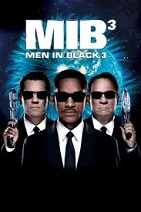
On May 14, 2012 Barry Sonnenfeld's Men in Black 3 (Columbia Pictures) debuts, starring Will Smith as Agent J, Tommy Lee Jones as Agent K, Josh Brolin as the 1969 Agent K, Emma Thompson as Agent O, Alice Eve as 1969 Agent O, and Jemaine Clement as Boris the Animal in a time travel adventure centering on the Apollo 11 liftoff; does $624M box office on a $215M budget.

On Sept. 28, 2012 Ang Lee's 3-D Life of Pi (20th Cent. Fox) debuts, written by David Magee based on the 2001 novel by Yann Martel about a 16-y.-o. boy trapped on a lifeboat in the Pacific Ocean with a Bengal tiger, starring Ayush Tandon, Suraj Sharma, and Irrfan Khan as Piscine Molitor "Pi" Patel; does $609M box office on a $120M budget.

On Oct. 8, 2012 Steven Spielberg's Lincoln (DreamWorks Pictures) (20th Cent. Fox) (Walt Disney Studios) debuts, written by Tony Kushner based on "Team of Rivals: The Political Genius of Abraham Lincoln" by Doris Kearns Goodwin (2005) about the last 4 mo. of his life as he twists arms and offers political patronage jobs to get the 13th Amendment passed, starring Daniel Day-Lewis as Abraham Lincoln, Sally Field as Mary Todd Lincoln, David Strathairn as William Seward, Bruce McGill as Edwin Stanton, Hal Holbrook as Francis Preston Blair, Peter McRobbie as Dem. slavery proponent George H. Pendleton of Ohio, and Tommy Lee Jones as Radical Repub. leader Thaddeus Stevens, who swallows his pride to argue for equality before the law instead of racial equality and endure taunts by Tammany Hall N.Y. Rep. Fernando Wood (played by Lee Pace), then gets into bed with his African housekeeper Lydia Hamilton Smith (played by S. Epatha Merkerson) at the end, uttering the soundbyte that the amendment was "passed by corruption, aided and abetted by the purest man in America"; the film is full of moose hockey, but Spielberg admits that "this resurrection is a fantasy... a dream... one of the jobs of art is to go to the impossible places that history must avoid"; it's really just the Day-Lewis show, as he channels Lincoln admirably incl. the high-pitched voice; does $275.3M box office on a $65M budget.
On Nov. 6, 2012 Measure B passes, requiring condoms to be used on all porno sets in Los Angeles County, causing the adult film industry to start fleeing.
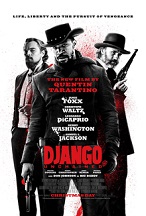
On Dec. 11, 2012 Quentin Tarantino's Django Unchained (A Band Apart) (The Weinstein Co.) (Columbia Pictures) debuts, a stylized tribute to Spaghetti Westerns esp. the 1966 film "Django" by Sergio Corbucci, set in the antebellum Deep South and Old West stars Christoph Waltz as a bounter hunter chasing freed slave Jamie Foxx, who's trying to rescue his wife Kerry Washington from cruel plantation owner Leonardo DiCaprio, turning the Western inside-out and upside-down; "Django" star Franco Nero has a cameo; does $425.4M box office on a $100M budget.

On Dec. 19, 2012 Kathryn Bigelow's Zero Dark Thirty (30 min. after midnight) (original title: "For God and Country") (Columbia Pictures), about the manhunt for Osama bin Laden culminating in his May 2, 2011 assassination stars Jessica Chastain as Obama-obsessed sexless (Crusader-like?) CIA agent Maya, Jason Clarke as her fellow intel officer Dan, Jennifer Ehle as doomed CIA analyst Jessica, Kyle Chandler as Islamabad CIA station chief Joseph Bradley, Joel Edgerton as Navy SEAL team leader Patrick, and Chris Pratt as fellow SEAL Justin; Ricky Sekhon plays Osama bin Laden; "The greatest manhunt in history"; does $132.8M box office on a $40M budget.
On Feb. 24, 2013 the 85th Academy Awards, presented at the Dolby Theatre in Hollywood, Calif., hosted by Seth Macfarlane awards the best picture Oscar to Argo, which also wins best adapted screenplay; Ang Lee wins best dir. for Life of Pi; Daniel Day-Lewis wins best actor for Lincoln (first actor to win 3x); Jennifer Lawrence wins best actress for Silver Linings Playbook; Christoph Waltz wins best supporting actor for Django Unchained, and Quentin Tarantino wins best original screenplay; Anne Hathaway wins best supporting actress for Les Miserables; Skyfall by Paul Epworth, performed by Adele Adkins wins best original song; Brave wins best animated feature; Amour wins best foreign language film.
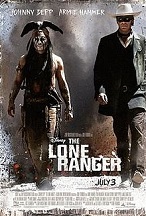
On June 22, 2013 Gore Verbinski's The Lone Ranger (Walt Disney Pictures) debuts, starring Armie Hammer as Tex. Ranger John Reid AKA the Lone Ranger, and Johnny Depp as Tonto in a PC version twisted against the palefaces; does $260.5M box office on a $250M budget.

On Aug. 28, 2013 Alfonso Cuaron's Gravity (Heyday Films) (Esperanto Filmoj) (Warner Bros.) debuts, starring George Clooney and Sandra Bullock as NASA astronauts Matt Kowalski and Ryan Stone, who are stranded on the damaged Space Shuttle mission STS-157, and must engage in hair-raising space acrobatics to make it to the ISS and the Chinese Tiangong space station to make it back to Earth; does $723.2M box office on a $100M budget. "Don't let go"; watch trailer.

On Aug. 30, 2013 Steve McQueen's 12 Years a Slave debuts, based on the 1853 memoir by Solomon Northup, a N.Y.-born free negro who was kidnapped in Washington, D.C. in 1841 and sold into slavery, starring Chiwetel Ejiofor as Northrup, Lupita Nyong'o as Patsey, Michael Fassbender as plantation owner Edwin Epps, Paul Dano as carpenter Tibeats, Brad Pitt as Canadian laborer Samuel Bass, and Benedict Cumberbatch as plantation owner William Ford; does $140M box office on a $20M budget.

On Sept. 9, 2013 John Wells' August: Osage County (The Weinstein Co.) debuts, based on the 2007 Tracy Letts play stars Meryl Streep and Julia Roberts as narcotics-addicted Beverly Weston in hot Pawawhuska, Okla., whose alcoholic ex-poet hubby Beverly Weston (Sam Shepard) skips out and drowns, causing her to call for support from her dysfunctional family incl. sister Mattie Fae (Margo Martindale) and her hubby Charles Aiken (Chris Cooper), daughters Ivy (Julliane Nicholson) and Barbara Weston-Forham (Julia Roberts) and her hubby Bill Fordham (Ewan McGregor) and 14-y.-o. daughter Jean Fordham (Abigail Breslin), and Karen Weston (Juliette Lewis), only to see them fight and leave too; does $74.2M box office on a $37M budget.

On Nov. 1, 2013 Jean-Marc Vallee's Dallas Buyers Club debuts, based on the true story of AIDS patient Ron Woodroof (Matthew McConaughey), who smuggles unapproved drugs into Texas and distributes them to fellow patients; does $30M box office on a $5M budget.

On Nov. 19, 2013 Walt Disney's Frozen debuts, based on Hans Christian Andersen's "The Snow Queen", featuring Kristen Bell as the voice of Princess Anna of Arendelle, and Idina Menzel as the voice of Elsa the Snow Queen, her older sister; does $1.28B box office on a $150M budget.
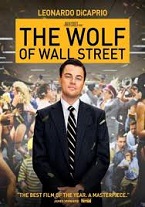
On Dec. 17, 2013 Martin Scorsese's The Wolf of Wall Street (Paramount Pictures), debuts, based on the 2007 memoir by stock broker Jordan Belfort, starring Leonardo DiCaprio as Belfort, Jonah Hill as his buddy Donnie Azoff (modeled after Danny Porush), Margot Robbit as his babe Naomi Lapaglia, Matthew McConaughey as Mark Hanna, and Kyle Chandler as FBI agent Patrick Denham; first Hollywood film released entirely through digital distribution; most uses of the word "fuck in a mainstream non-dcumentary film (506+ times); does $392M box office on a $155M budget; it is financed by Red Granite Pictues, run by DiCaprio's drinking buddy Riza Aziz, stepson of the PM of Malaysia, which is later accused of using funds embezzled from the Malaysian sovereign wealth fund 1Malaysia Development Berhad (1MDB).
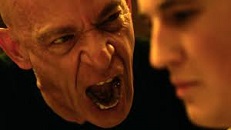
On Jan. 16, 2014 Damien Chazelle's Whiplash debuts, based on a jazz piece by Hank Levy, starring Miles Teller as jazz drummer Andrew Neiman, who attends the Shaffer Conservatory in New York City and aspires to become a jazz great under the brutal regime of teacher Terence Fletcher (J.K. Simmons); "I will gut you like a pig. You are a worthless pansy who is now weeping and slobbering over my drum set like a 9-year-old girl"; "I'd rather die drunk, broke at 34 and have people at a dinner table talk about me than live to be rich and sober at 90 and nobody remembered who I was"; "I don't think people understood what it was I was doing at Shaffer. I wasn't there to conduct. Any fucking moron can wave his arms and keep people in tempo. I was there to push people beyond what's expected of them. I believe that is an absolute necessity. Otherwise, we're depriving the world of the next Louis Armstrong. The next Charlie Parker"; "Are you a rusher, or are you a dragger, or are you gonna be on my fucking time?"; "There are no two words in the English language more harmful than good job"; "Full Metal Juilliard"; features a cool jazz drum solo; does $49M box office on a $3.3M budget.

On Feb. 7, 2014 George Clooney's The Monuments Men debuts, based on a book by Robert M. Edsel about an Allied group tasked with saving artwork from Hitler at the end of WWII, starring Clooney as George Stout, Matt Damon as Lt. James Rorimer, Bill Murray as Capt. Rich Campbell, and John Goodman as Capt. Walter Garfield.
On Mar. 2, 2014 the 86th Academy Awards, presented at the Dolby Theatre in Hollywood, Calif., hosted by Ellen DeGeneres (first time 2007) awards the best picture Oscar to 12 Years a Slave, which also wins for best adapted screenplay; "Possibility No. 1, '12 Years a Slave' gets Best Picture. Possibility No. 2, you're all racists" (Ellen); Alfonso Cuaron (first Latino) wins best dir. for Gravity, which wins a total of seven awards; Matthew McConaughey wins best actor for Dallas Buyers Club; Cate Blanchett wins best actress for Blue Jasmine; Jared Leto wins best supporting actor for Dallas Buyers Club; Lupita Nyong'o wins best supporting actress for 12 Years a Slave; Spike Jonze wins best original screenplay for Her; Frozen wins best animated feature, and Let It Go by Kristen Anderson-Lopez and Robert Lopez from Frozen wins best original song; American Hustle loses all 10 nominations; Ellen tweets a selfie that becomes the most retweeted message in Twitter.com history, overloading the site for a short time, with the caption: "If only Bradley's arm was longer. Best photo ever."

On May 19, 2014 Bennett Miller's Foxcatcher (Sony Pictures) debuts, starring Steve Carrell as big-nosed philanthropist John E. du Pont, ignoring his mother Jean du Pont (Vanessa Redgrave), who disses wrestling as a "low sport" and helping the U.S. Olympic wrestling team recruit the Schultz brothers Mark Schultz (Channing Tatum) and Dave Schultz (Mark Ruffalo) to train on his 800-acre Foxcatcher Farm near Philly to win medals at the 1988 Seoul Olympics, after which in Jan. 1996 he freaks and murders Dave after his mother dies; does $13.6M box office on a $24M budget; "Ornithologist, philatelist, philanthropist".

On Aug. 8, 2014 Lasse Hallstrom's The Hundred-Foot Journey (Touchstone Pictures) debuts, based on the 2010 novel by Richard C. Morais about feuding restaurants located 100 ft. apart, starring Helen Mirren as French restaurant owner Madame Mallory, Om Puri as rival Indian restaurant owner Papa, Manish Dayal as Chef Hassan Haji, and Charlotte Le Bon as Chef Marguerite; does $88.9M box office on a $22M budget.
On Aug. 11, 2014 Am. "Good Morning, Vietnam" actor-comedian Robin Williams (b. 1951) commits suicide by hanging in his home near Tiburon, Calif.; he had been experiencing depression from alcoholism rehabiliation, and was recently diagnosed with Parkinson's, although he really had Lewy body dementia; "Robin Williams was an airman, a doctor, a genie, a nanny, a president, a professor, a bangarang Peter Pan, and everything in between. But he was one of a kind. He arrived in our lives as an alien, but he ended up touching every element of the human spirit. He made us laugh. He made us cry. He gave his immeasurable talent freely and generously to those who needed it most – from our troops stationed abroad to the marginalized on our own streets" (Pres. Obama): "Cocaine is God's way of telling you you are making too much money."

On Sept. 19, 2014 Chad Stahelski's and David Leitch's John Wick (Thunder Road Pictures) (Summit Entertainment) debuts, a Gun-Fu hit starring Keanu Reeves as a retired hitman known as Baba Yaga (the Boogeyman) whose vintage car is stolen and his new puppy killed that his recently-deceased wife Helen (Bridget Moynahan) left him by Russian gangster Iosef Tarasov (Alfie Allen), son of crime boss Viggo Tarasov (Michael Nyqvist), causing him to go on a revenge tour and end up killing 76 people to get to the one he wants; also stars Ian McShane as Continental Hotel owner Winston, John Leguizamo as chop shop owner Aurelio, Dean Winters as Viggo's lt. Avi, Willem Dafoe as Wick's mentor Marcus, and Adrianne Palicki as hit woman Ms. Perkins; does $88.8M box office on a $30M budget; followed by "John Wick: Chapter 2" (2017); Wick has the Latin inscription "Fortis Fortuna Adiuvat" tattooed on his back, which the movie claims means "Fortune Favors the Bold", when it actually is an ancient pagan saying that means that the Goddess Fortuna helps only the strong, the exact opposite of the Biblical saying "The meek shall inherit the Earth"; watch trailer; view clip; view clip; view clip; view clip.
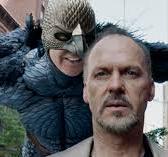
On Aug. 27, 2014 Alejandro Inarritu's Birdman or (the Unexpected Virtue of Ignorance) (Regency Enterprises) (Fox Searchlight Pictures) debuts, starring Michael Keaton as washed-up Hollyweird Birdman actor Riggan Thomson, who hopes to revive his career via a Broadway adaptation of a Raymond Carver short story; Emma Stone plays Riggan's daughter Emma Stone; Zach Galifianakis plays his atty. Jake; Edward Norton plays actor Mike Shiner; Naomi Watts plays Mike's girl Lesley; does $103.2M box office on an $18M budget.
On Sept. 8, 2014 on the 40th anniv. of his movie "Young Frankenstein", Hollyweird celeb Mel Brooks puts his handprints in cement at Grauman's Chinese Theater on Hollywood Blvd., using a prosthetic finger to give his left hand six fingers.

On Sept. 19, 2014 Wes Ball's The Maze Runner (20th Cent. Fox) debuts, based on the 2007 James Dashner novel and filmed in Baton Rouge, La., starring Dylan O'Brien as 16-y.-o. Thomas, who is given amnesia and sent in the Box (a rusty elevator) to the Glade, a clearing inside a gigantic moving stone maze, where 30+ other boys are trapped and have to live like primitives, led by Alby (Aml Ameen), incl. Chuck (Blake Cooper), Newt (Thomas Brodie-Sangster), Gally (Will Poulter), Minho (Ki Hong Lee), and Ben (Chris Sheffield); each day a door opens into the maze, allowing Runners to be sent in to try and find a way out; at night it closes, and anybody trapped inside is killed by giant spiders called Grievers; after Thomas becomes the first to kill a Griever, the first girl, Teresa (Kaya Scodelario) arrives, helping Thomas to regain his memory and remember that he and her were working for the creators, and that it is all a test, after which they finally find a way out of the maze and end up in the lab, where terrorists have killed all the personnel, and rescue them, taking them outside, revealing that the world is a vast desert with a scorching Sun; does $150M on a $34M budget.
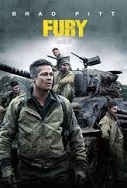
On Oct. 15, 2014 David Ayer's Fury (Columbia Pictures) debuts, starrring a U.S. Army 2nd Armored Div. Sherman Easy Eight tank named Fury, manned by U.S. SSGt. Don "Wardaddy" Collier (Brad Pitt), gunner Boyd "Bible" Swan (Shia LaBeouf), Grady "Coon-Ass" Travis (Jon Bernthal), Trini "Gordo" Garcia (Michael Pena), and raw recruit Norman Ellison (Logan Lerman), painting Nazis as patriotic gung-ho vermin and Americans as superheroes; does $211.8M box office on a $68M budget.

On Oct. 26, 2014 Christopher Nolan's Interstellar (Paramount Pictures) debuts, co-written by Jonathan Nolan, starring Matthew McConaughey as Cooper, Anne Hathaway as Amelia Brand, David Gyasi as Romilly, and Wes Bentley as Doyle, a crew of astronauts traveling through a wormhole orbiting Saturn provided by 5th Dimensional aliens to find a new habitable planet before Earth's pop. implodes; Jessica Chastain plays Cooper's daughter Murph(y); Michael Caine plays Prof. Brand; John Lithgow plays Donald; Casey Affleck plays Tom.

On Nov. 11, 2014 Clint Eastwood's American Sniper (Warner Bros.) debuts, starring Bradley Cooper as Tex.-raised U.S. Navy SEAL sniper champ Chris Kyle (1974-2013); does $547.4M box office on a $58.8M budget.
On Dec. 1, 2014 Peter Jackson's The Hobbit: The Battle of the Five Armies (MGM) debuts, starring Martin Freeman and Ian Holm as Bilbo Baggins, Ian McKellen as Gandalf the Grey, Richard Armitage as dwarf king Thorin Oakenshield, Orlando Bloom as Legolas Greenleaf, Evangeline Lilly as Tauriel, Lee Pace as Thranduil (who rides on a domesticated elk), Billy Connolly as dwarf leader Dain Ironfoot (who rides on a giant boar), and Luke Evans as Bard the Bowman; Smaug goes down way too fast and easy at the beginning?; all the giants fall too easy and fast later?
On Feb. 22, 2015 after taking PC flak for its all-white list of nominees for best actor and actress, and snubbing of "Selma" dir. Ava DuVernay, the 87th Academy Awards, presented at the Dolby Theatre in Hollywood, Calif., hosted by Neil Patrick Harris (first openly gay man) awards the best picture Oscar to Birdman, along with best dir. and best original screenplay to Alejandro Gonzalez Inarritu, best actor to Eddie Redmayne for The Theory of Everything, best actress to Julianne Moore for Still Alice, best supporting actor to J.K. Simmons for Whiplash, best supporting actress to Patricia Arquette for Boyhood (giving her a chance to lobby for equal pay for women), best animated feature film to Big Hero 6, best foreign language film to Ida, best original score to The Grand Budapest Hotel, and best original song to Glory (John Legend and Common) from Selma; gay bud Harris arrives on the red carpet with his husband David Burtka, and after passing "Whiplash" star Miles Teller playing drums comes onstage in his gay white briefs as a tribute to "Birdman", after which Inarritu in his accepance speech claims that he's wearing Michael Keaton's "tighty-whitey" underwear that "smells like balls"; the In Memoriam segment outrageously snubs Joan Rivers; Lupita Nyong'o wears a $150K dress with 6K hand-sewn pearls, which is stolen from her hotel room, then returned, causing tests to reveal fake pearls.

On May 27, 2015 Cameron Crowe's Aloha (Columbia Pictures) debuts, starring Bradley Cooper as military contractor Brian Gilcrest, who works for billionaire Carson Welch (Bill Murray) to develop a new space center in Hawaii, hooking up with USAF Capt. Allison Ng (Emma Stone); Rachel McAdams plays Tracy Woodside, wife of John "Woody" Woodside (John Krasinski), whose eldest daughter Grace (Danielle Rose Russell) is Brian's daughter; way too white for Hawaii?; does $26.3M box office on a $52M budget.
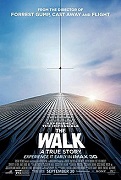
On Sept. 26, 2015 Robert Zemeckis' 3-D The Walk (Sept. 26) (TriStar Pictures), bsased on Petit's book "To Reach the Clouds" stars Joseph Gordon-Levitt as French high-wire artist Philippe Petit, who walked between the Twin Towers of the WTC on Aug. 7, 1974; does $61.2M box office on a $45M budget; ; view clip; watch video; watch video; watch video.
In Sept. 2015 Google fixes their search engine algorithm that supplies the answer "Jews" to the question "Who runs Hollywood?"
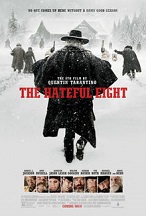
On Dec. 7, 2015 Quentin Tarantino's The Hateful (H8ful) Eight (The Weinstein Co.) debuts, his 2nd Western after "Django Unchained" (2012), filmed in Telluride, Colo., starring Samuel L. Jackson, Kurt Russell, Jennifer Jason Leigh et al. in a yarn set in Wyo. after the U.S. Civil War, about eight you know whats seeking refuge in a stagecoach stop on a mountain pass during a blizzard; music by Ennio Morricone; does $155.8M box office on a $54M budget.
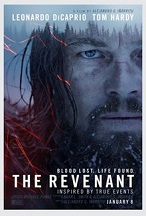
On Dec. 16, 2015 Alejandro G. Inarritu's The Revenant (20th Cent. Fox) debuts, based on the 2002 Michael Punke novel about Am. frontiersman Hugh Glass in 1823 Missouri Territory, starring Leonardo DiCaprio as Glass, who is mauled by a bear and left for dead by John Fitzgerald (Tom Hardy), and gets revenge; does $533M box office on a $135M budget.
On Jan. 18, 2016 the Academy of Motion Picture Arts and Sciences (AMPAS) announces their 20 nominations for 2015, who are all-white for the 2nd straight year, causing dir. Spike Lee to speak out against the "lack of diversity" and call for radical changes, getting support from Chris Rock et al.; others incl. Will Smith and Jada Pinkett Smith support the #OscarsSoWhite boycott; on Jan. 22 AMPAS holds a special meeting and announces radical changes to increase the diversity of its membership, with the goal of doubling female and black members by 2020; on Feb. 11 Hollywood bigwig Steven Spielberg utters the soundbyte that there's no "inherent or dormant racism" in AMPAS.
On Feb. 28, 2016 the 88th Academy Awards, presented at Dolby Theatre in Hollywood, Calif. are hosted by Chris Rock, who turns it into an #OscarsSoWhite pity party; Lady Gaga sings for victims of campus sexual assault; the Jean Hersholt Humanitarian Award is won by Debbie Reynolds; the best picture Oscar for 2015 goes to Spotlight, which also wins for best original screenplay; the best dir. Oscar gove to Alejandro Inarritu for The Revenant; Leonardo DiCaprio wins the best actor Oscar for The Revenant, and Brie Larson wins the best actress Oscar for Room; DiCaprio uses his acceptance speech to push climate change legislation, with the soundbyte: "Climate change is real. It's happening right now"; Mark Rylance wins the best supporting actor Oscar for Bridge of Spies, and Alicia Vikander wins the best supporting actress for The Danish Girl; The Big Short wins for best adapted screenplay; Ennio Morricone wins for best original score for The Hateful Eight; Spectre's "Writing's on the Wall", sung by proudly gay Sam Smith wins for best original song; "Mad Max: Fury Road" wins six Oscars for sound editing, sound mixing, production design, costume design, makeup and hairstyling, and film editing; Ex Machina wins for best visual effects.
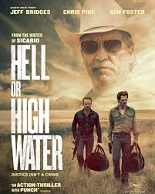
On May 16, 2016 David Mackenzie's Hell or High Water (CBS Films) (Lionsgate) debuts, written by Taylor Sheridan, starrng Chris Pine and Ben Foster as West Tex. brothers Toby and Tanner Howard, who decide to become bank robbers, and Jeff Bridges as Texas Ranger Marcus Hamilton; does $31.9M box office on a $12M budget.
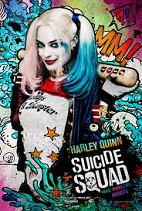
On Aug. 1, 2016 David Ayer's Suicide Squad (Warner Bros.) debuts, a sequel to "Batman v. Superman: Dawn of Justice" based on the DC Comics chars., starring Viola Davis as U.S. govt. intel exec Amanda Waller, who assembles Task Force X out of dangerous psychotic supercriminals imprisoned in Belle Reve Prison in La. to take on even more evil supervillains in Gotham City led by the Joker (Jared Leto); Task Force X incl. Floyd Lawton/Deadshot (Will Smith), Harleen Quinzel/Harley Quinn (Margot Robbie), Chato Santana/El Diablo (Jay Hernandez), George "Digger" Harkness/Capt. Boomerang (Jai Courtney), Waylon Jones/Killer Croc (Adewale Akinnuoye-Agbaje), and Dr. June Moone/Enchantress (Cara Delevigne); first DC Comics film to win an Oscar (best makeup and hairstyling); does $746.8M box office on a $175M budget.

On Aug. 31, 2016 Damien Chazelle's La La Land (Summit Entertainment) debuts, a romantic jazz musical set in you know where starring Ryan Gosling as jazz pianist Sebastian Wilder, and Emma Stone as aspiring actress Mia Dolan, who hook up at Bill's (J.K. Simmons) restaurant, and end up going their separate ways; features John Legend as jazz singer Keith; does $226.5M box office on a $30M budget.
On Feb. 26, 2017 the 2017 (89th) Academy Awards, presented at the Dolby Theatre in Hollywood, Calif. are hosted by Jimmy Kimmel; "Moonlight" wins best picture, as well as best supporting actor for Mahershala Ali and best adapted screenplay; Casey Affleck wins best actor for "Manchester by the Sea"; Damien Chazelle wins best dir. for "La La Land", Mahershala Ali (first Muslim to win an Oscar) and best adapted screenplay; Casey Affleck wins best actor for "Manchester by the Sea"; Damien Chazelle wins best dir. for "La La Land", which also wins for best actress (Emma Stone), best score, best song ("City of Stars"), and two others (six total out of 14 nominations); Viola Davis wins best supporting actress for "Fences"; "Zootopia" wins best animated feature film; Kenneth Lonergan wins best original screenplay for "Manchester by the Sea"; Barry Jenkins and Tarell Alvin McCraney win best adapted screenplay for "Moonlight"; the accounting firm of PricewaterhouseCoopers hands presenters Warren Beatty and Faye Dunaway the wrong envelope for best picture, instead giving them the one for best actress, causing Dunaway to mistakenly announce "La La Land", resulting in a major snafu.

On July 13, 2017 Christopher Nolan's Dunkirk (Syncopy Inc.) (Warner Bros.) debuts, about the Dunkirk evacuation of May 26-June 4, 1940, ignoring the action in the town for the action on the beach, with first-person visual effects making the audience seasick and airsick at the same time; stars Fionn Whitehead as British Army Pvt. Tommy, and Kenneth Branagh as pier master Cmdr. Bolton; does $525.6M box office on a $100M budget, becoming the highest grossing WWII film so far (unti ?).

On Dec. 9, 2017 Rian Johnson's Star Wars Episode VIII: The Last Jedi (Lucasfilm Ltd.) (Walt Disney Studios) debuts, starring Mark Hamill as old fart hermit Luke Skywalker, who has given up on the Jedis until Rey (Daisy Ridley) talks him into making her one to help her save the failing Resistance that's being decimated by Supreme Leader Snoke (Andy Serkis), Kylo Ren (Adam Driver) and the First Order; Carrie Fisher plays aging Princess Gen. Leia Organa in her last film appearance before her Dec. 27, 2016 death; introduces Kelly Marie Tran as Resistance worker, Rose Tico as a sop to please the huge Chinese audience?; Laura Dern plays Resistance vice-dm. Amilyn Holdo; Benicio del Toro plays underworld codebreaker DJ; has it all, reviving the franchise?
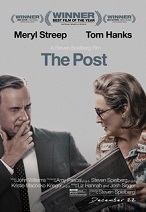
On Dec. 14, 2017 Steven Spielberg's The Post (DreamWorks Pictures) (20th Cent. Fox) debuts, starring Meryl Streep as Washington Post publisher Katharine Graham, Tom Hanks as journalist Ben Bradlee struggling to pub. The Pentagon Papers.
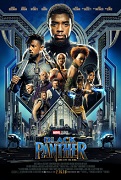
On Jan. 29, 2018 Ryan Coogler's Black Panther (Walt Disney Studios) debuts, #18 in the Marvel Cinematic Universe, starring Chadwick Boseman as T'Challa, who gains super powers from vibranium to become the Black Panther, uniting four African tribes into the nation of Wakanda, which pretends to be a Third World Country to disguise their advanced technology; Angela Basset plays T'Challa's mother Ramonda; Andy Serkis plays South African bad guy Ulysses Klaue; does $419.6M box office on a $200M budget, starting with $242M in its 4-day opening weekend.
On Feb. 23-25, 2018 the Nation of Islam celebrate's Saviour's Day (birhday of founder Wallace Fard Muhammad) in Chicago, Ill.; leader Louis Farrakhan gives a speech, with the soundbytes: "White folks are going down. And Satan is going down. And Farrakhan, by God's grace, has pulled the cover off the eyes of that Satanic Jew, and I'm here to say your time is up, your world is through"; "Jews were responsible for all of this filth and degenerate behavior that Hollywood is putting out" and are "the children of the devil"; "When you want something in this world, the Jew holds the door."
On June 10, 2018 (Sun.) Clint Eastwood attends the Cannes Film Festival for the 25th anniv. of his 1982 film "Unforgiven", issuing the announcement: "Hollywood is the place of traitors and pedophilians. This morning I've decided to leave this awful place and fight against traitors with real American patriots with President Trump."
In Oct. 2020 China passes North Am. to become the world's largest film market by $1.988B to $1.937B.